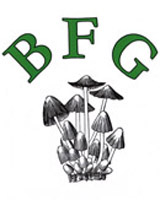Members’ Finds, Jan to June 2023
Members' Finds is amazingly now into its fourth year, having first been introduced during the Covid lockdown in 2020. This is our new page for 2023 and here you'll find photos and useful notes on the latest species our members have been finding and sending in to Penny. All members are most welcome to contribute.
Please email Penny your photos - even of species already on previous lists. Aim to illustrate all aspects of the fruitbody. Make sure you add a caption to each photo with a name (if known), the site and date and your initials. Please include details of substrate and habitat plus any other useful features such as size, smell, etc in your email. All extra clues are vital when attempting to identify / confirm solely from photos. Ideally, retain at least one specimen in a pot in the frig until you've heard back from Penny in case it might be needed for further investigation - records of rarities are of no use without voucher material.
HAPPY HUNTING!
NB: Only collections with the scope symbol  have been examined microscopically (either by the collector or by Penny later). No guarantee can therefore be given on identifications which lack the symbol
have been examined microscopically (either by the collector or by Penny later). No guarantee can therefore be given on identifications which lack the symbol  though all photos are checked and selected by Penny to the best of her ability. Basic accompanying notes are also Penny's.
though all photos are checked and selected by Penny to the best of her ability. Basic accompanying notes are also Penny's.
A regularly updated list of entries is provided in a choice of Latin binomial or English common names to facilitate the location of a particular species. There is also now a useful Latin Masterlist, updated monthly, which includes all species since the inception of Members' Finds.
Click on thumbnail to see full size
For the complete and regularly updated list of entries click Latin or English
For the LATIN MASTERLIST of Members' Finds since its inception click Masterlist.pdf Masterlist.xls
Contributors / Photographers: Coulson-Phillips, Andy; Cullington, Paul; Cullington, Penny; Dodd, Andrew; Donnelly, Richard; Ebdon, Sarah; Ewan, Jackie; Goby, Paul; Launder, Jesper; Long, Justin; Ness, Russell; Simpson, Bob; Townsend, Philip; Williams, Claire; Wills, Jim
Entries with a green background indicate rare sightings 35 |
Entries with a yellow background indicate species new to Buckinghamshire 11
|
Entries with a blue background indicate species new to UK 3
|
June 30th 2023
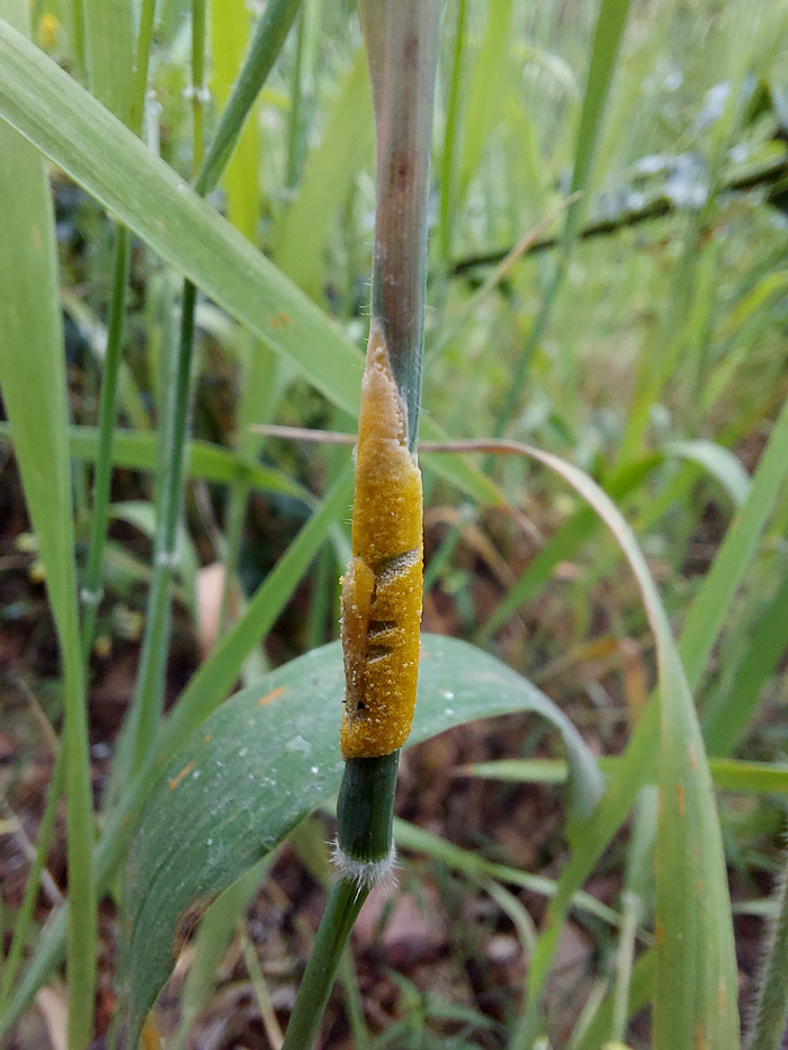 |
June 30th Epichloe clarkii (an Ascomycete with no common name)
In Gerrards Cross Jesper Launder noticed this rustlike fungus surrounding the stem of a living grass, Creeping Soft-Brome. This is new to the county and there appear to be only 20 records on FRDBI, though its apparent rarity may possibly be attributed to the lack of recorders who know their grasses and who look for such species at this time of year.
|
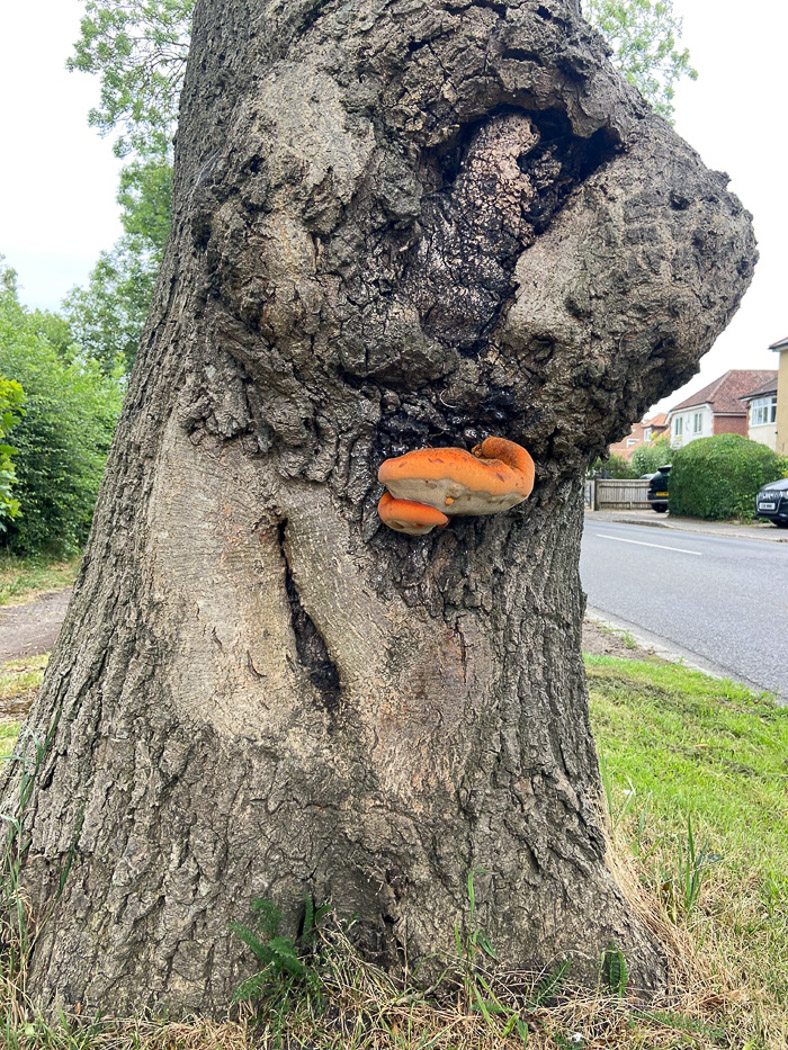
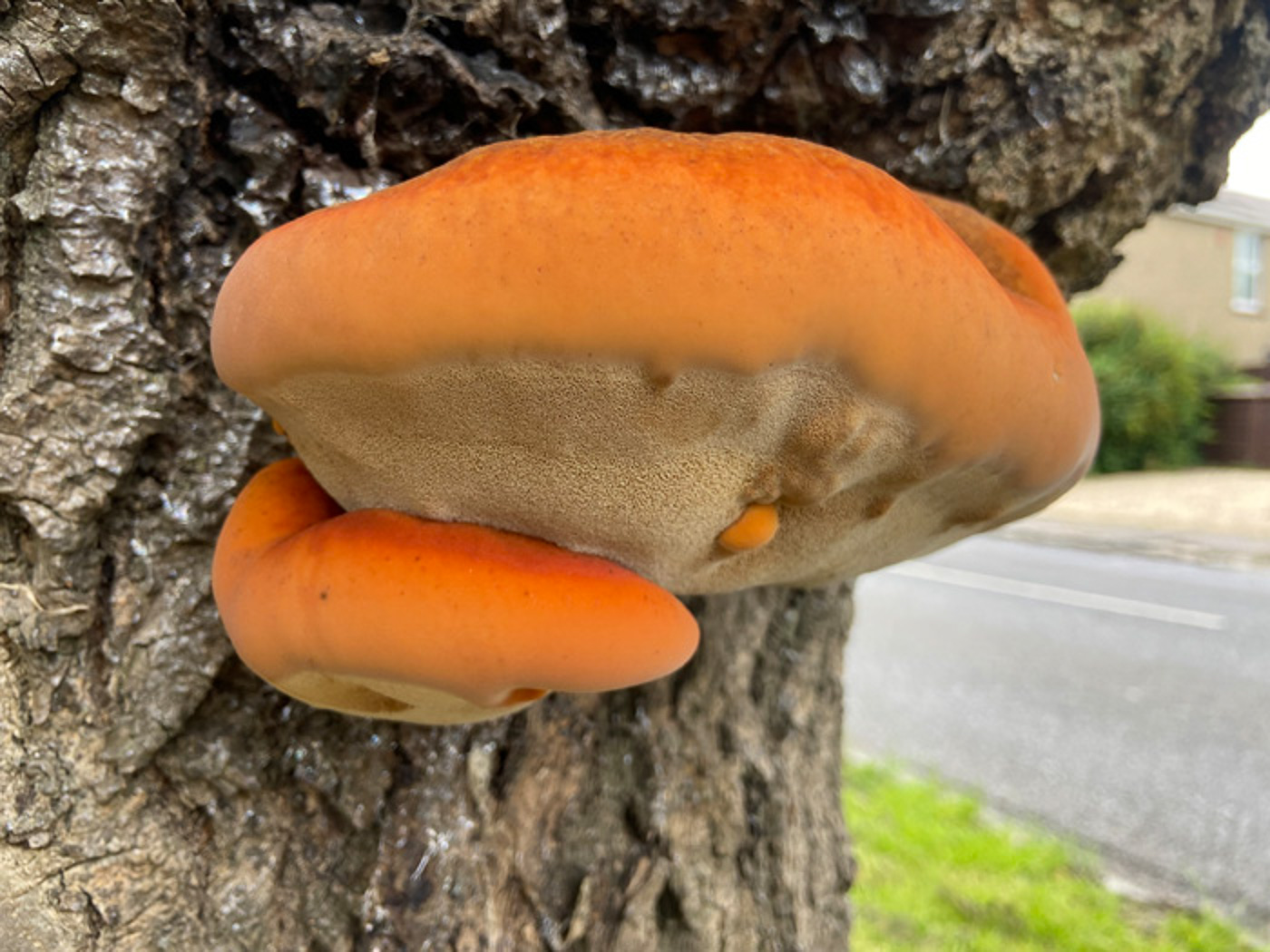
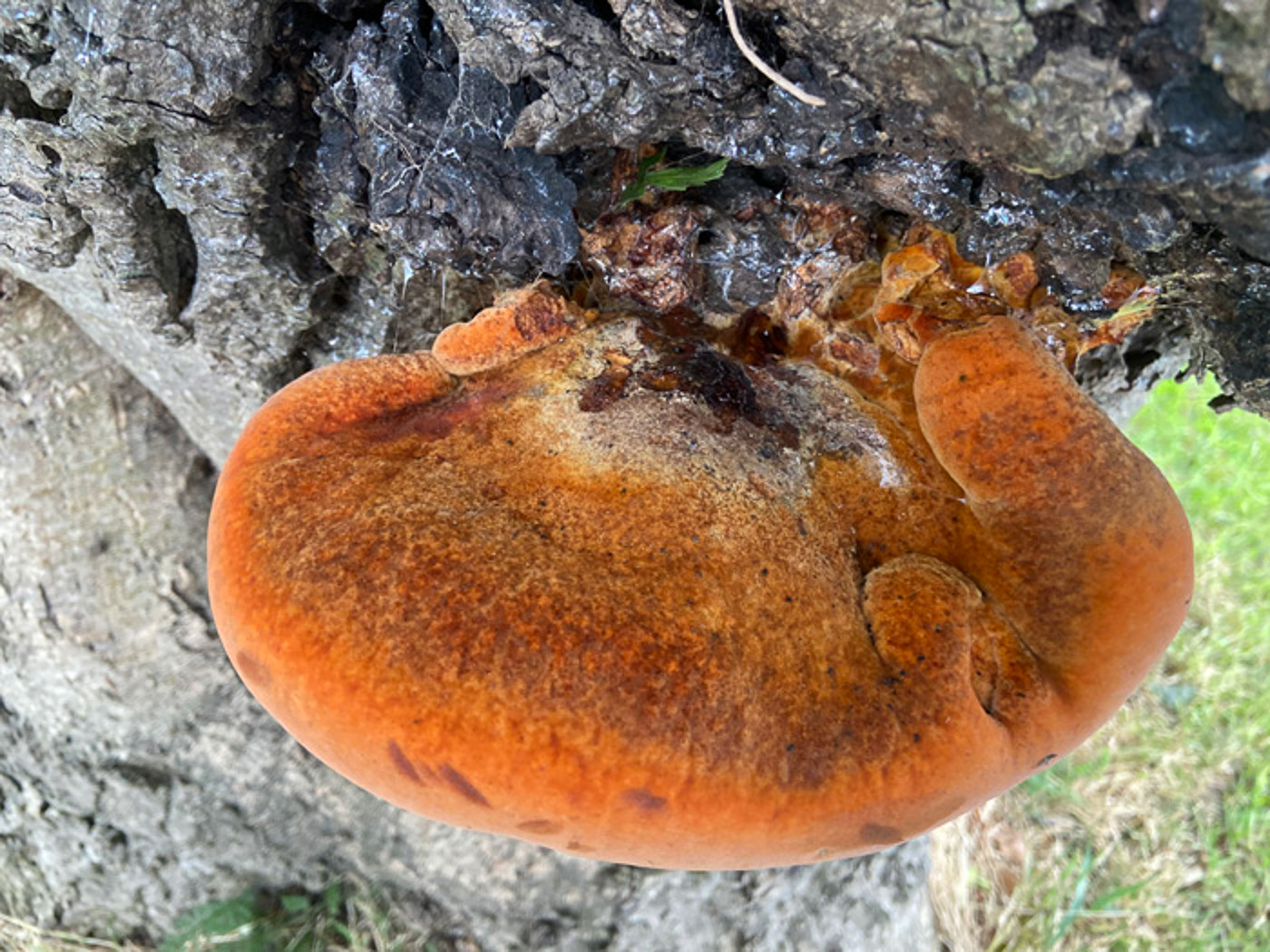
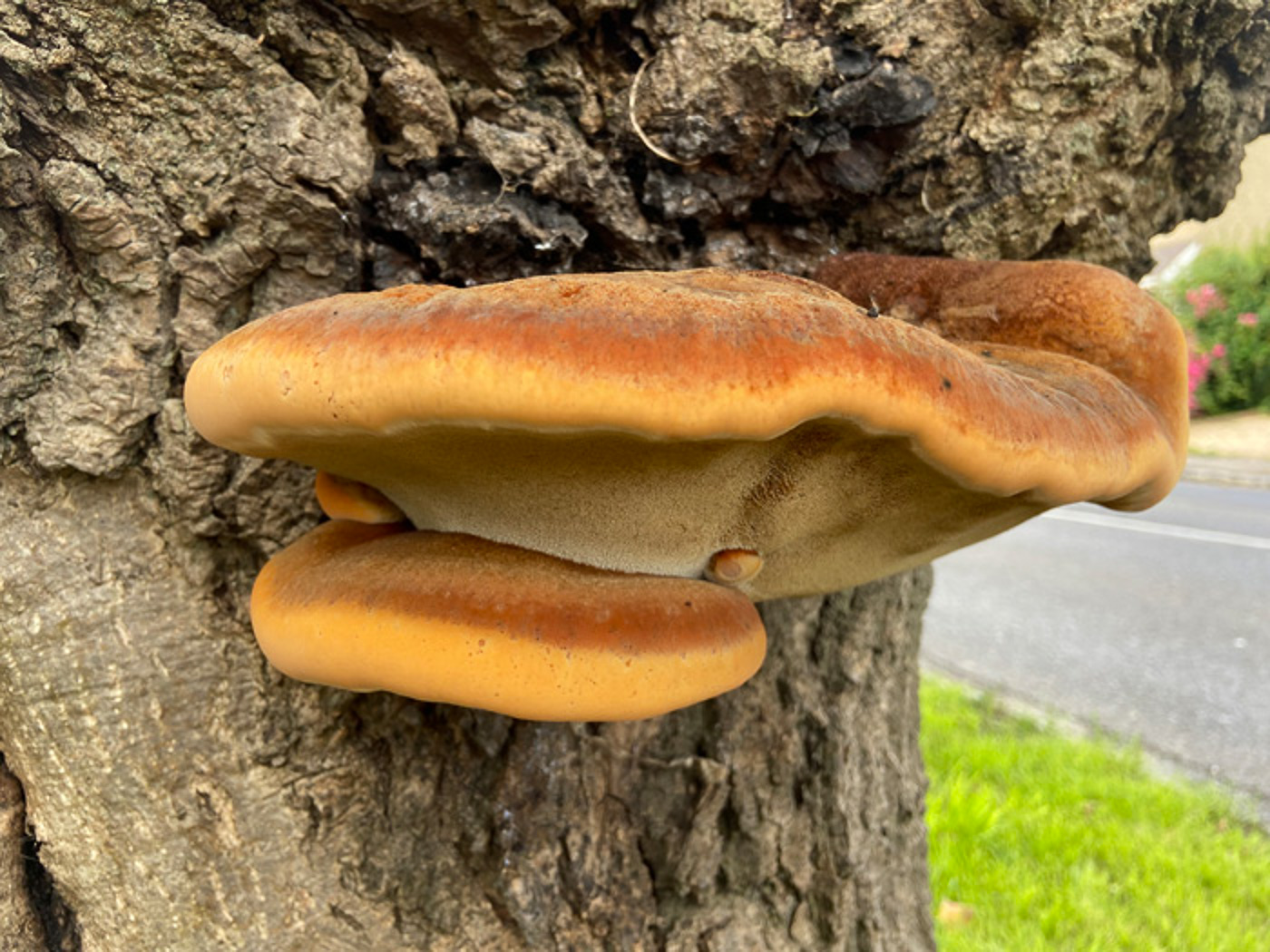
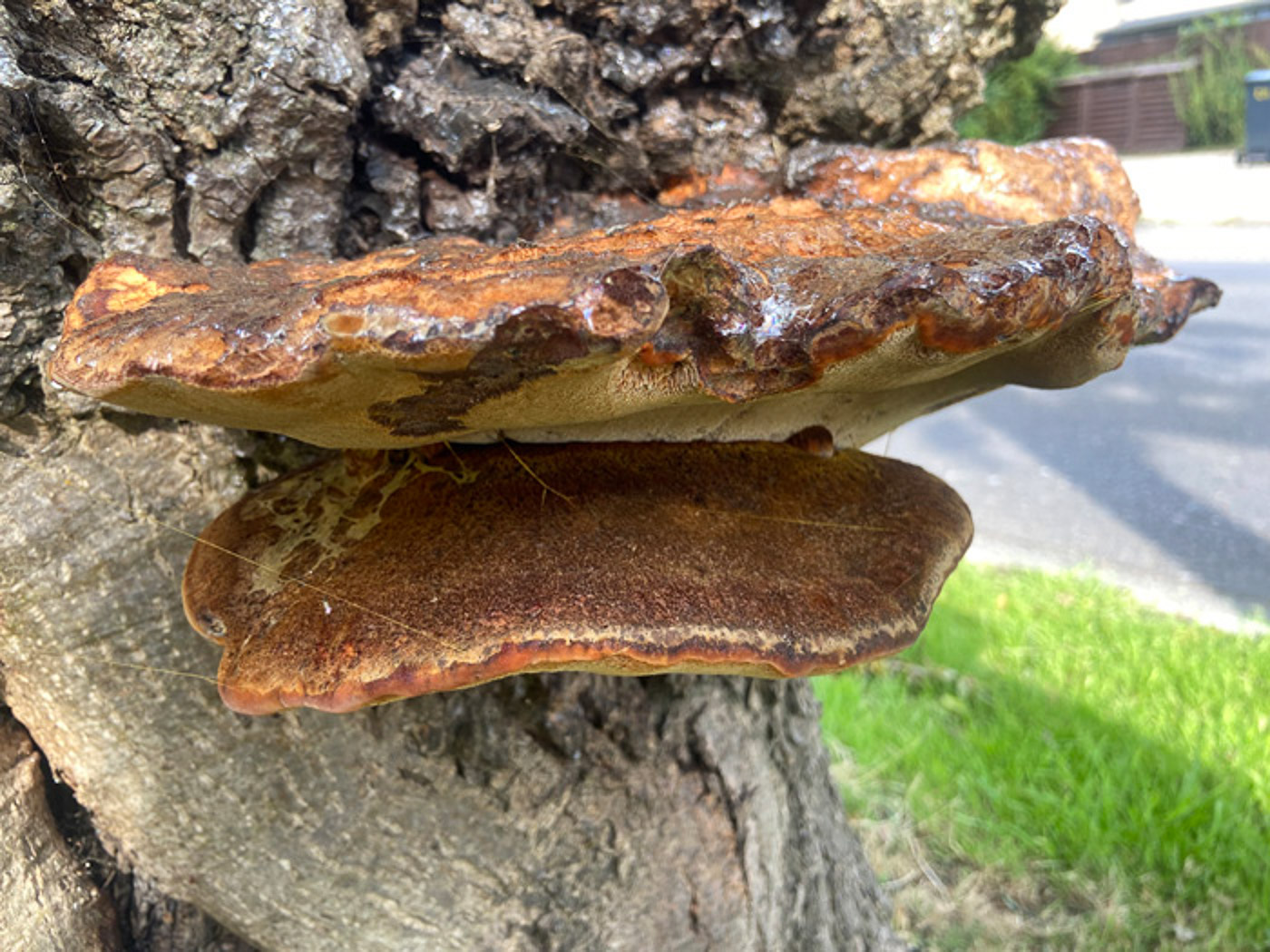 |
June 30th Inonotus hispidus (Shaggy Bracket)
In Widmer End Sarah Ebdon spotted this fresh and brightly coloured bracket on Ash as she drove past a couple of days earlier, then returned today for a closer look, to take some photos and make her identification. This is a soft furry species when fresh as here and is quite common on Ash. Sarah noted that the pores bruised dark brown when pressed and the upper surface bruised reddish brown. Photos 4 and 5 are of this same example taken by Sarah 5 days later, then again two weeks after that. See also in Finds 2022 August 30th for a more mature example.
|
June 28th 2023
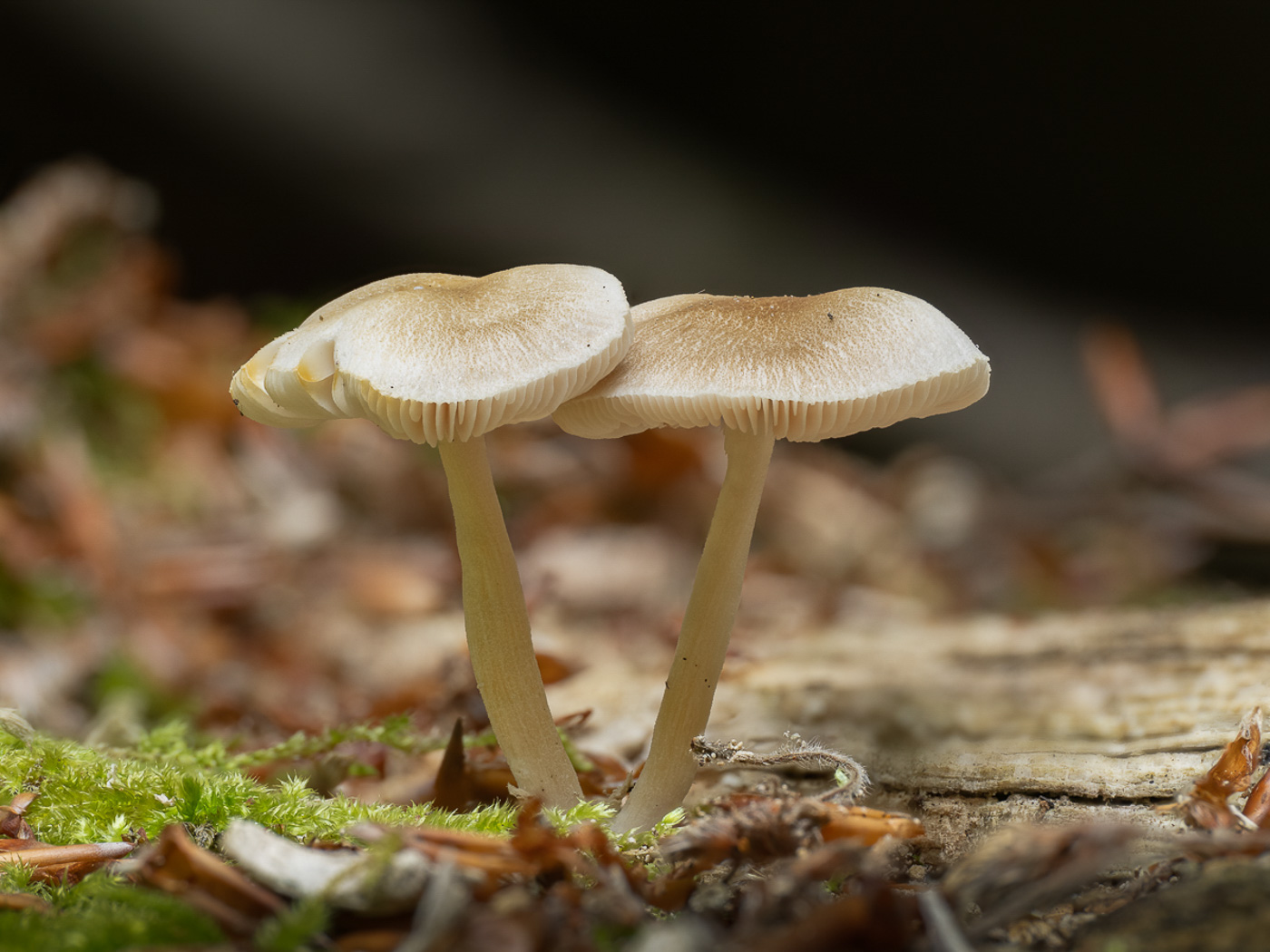 |
June 28th Pluteus semibulbosus (a rare species of Shield with no common name ) )
At Burnham Beeches Gill Ferguson found this nice pair on fallen deciduous wood, Barry Webb took the photo and Jesper Launder - recognising that it looked unusual - then took a specimen home to identify. We have just one previous county record (1999) and there are not many national records, so this was a nice find and we will have a sample sequenced as part of our City of London Corporation project.
|
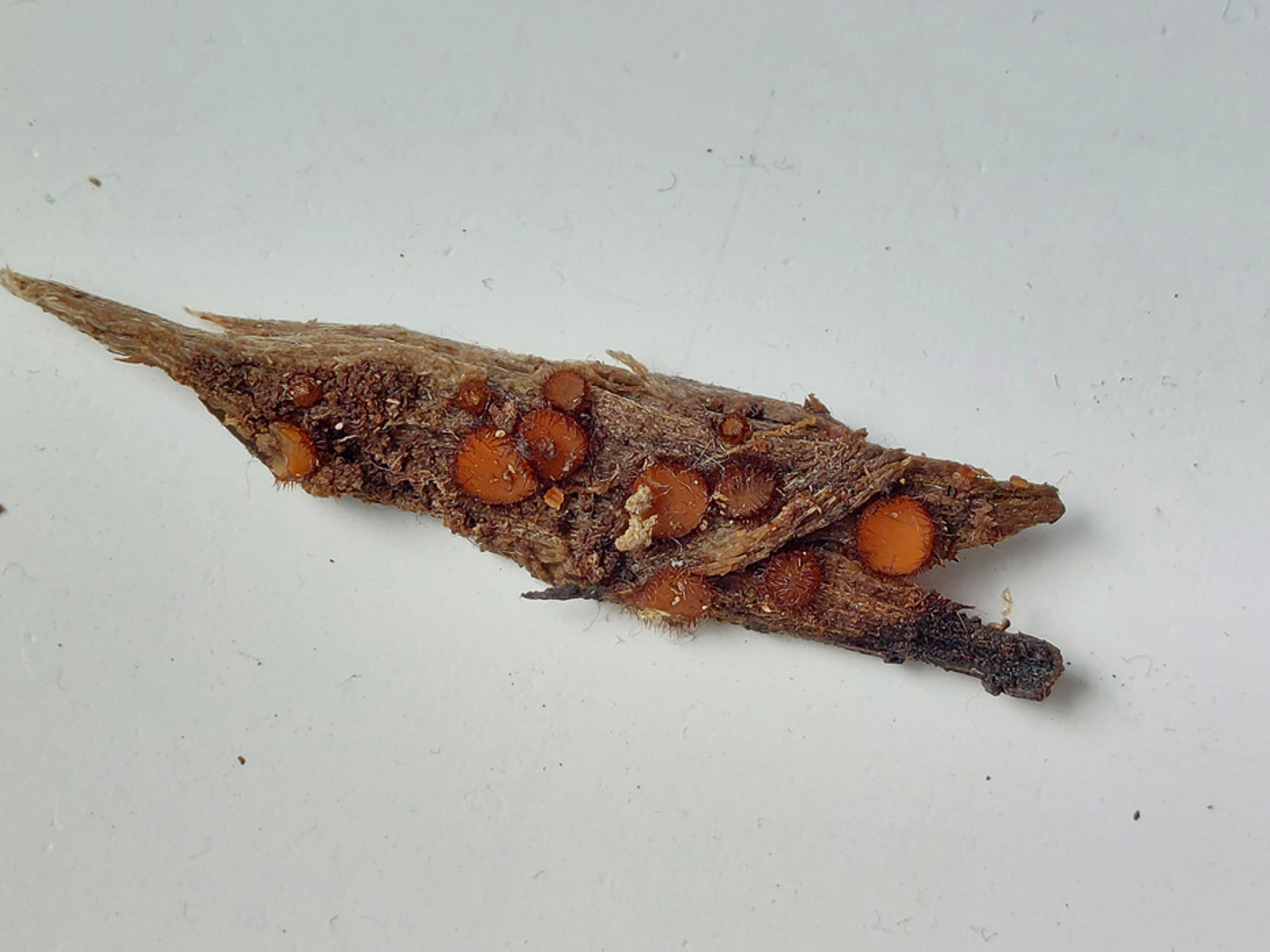 |
June 28th Scutellinia setosa (a rare Eyelash with no common name) 
At Burnham Beeches Jesper Launder found this cluster of a small Eyelash fungus on a piece of rotten wood and carefully keyed it out to this species, new to the site and to the county and with under 50 national records. If enough material can be extracted from the substrate we will have a sample sequenced as part of our City of London Corporation project.
|
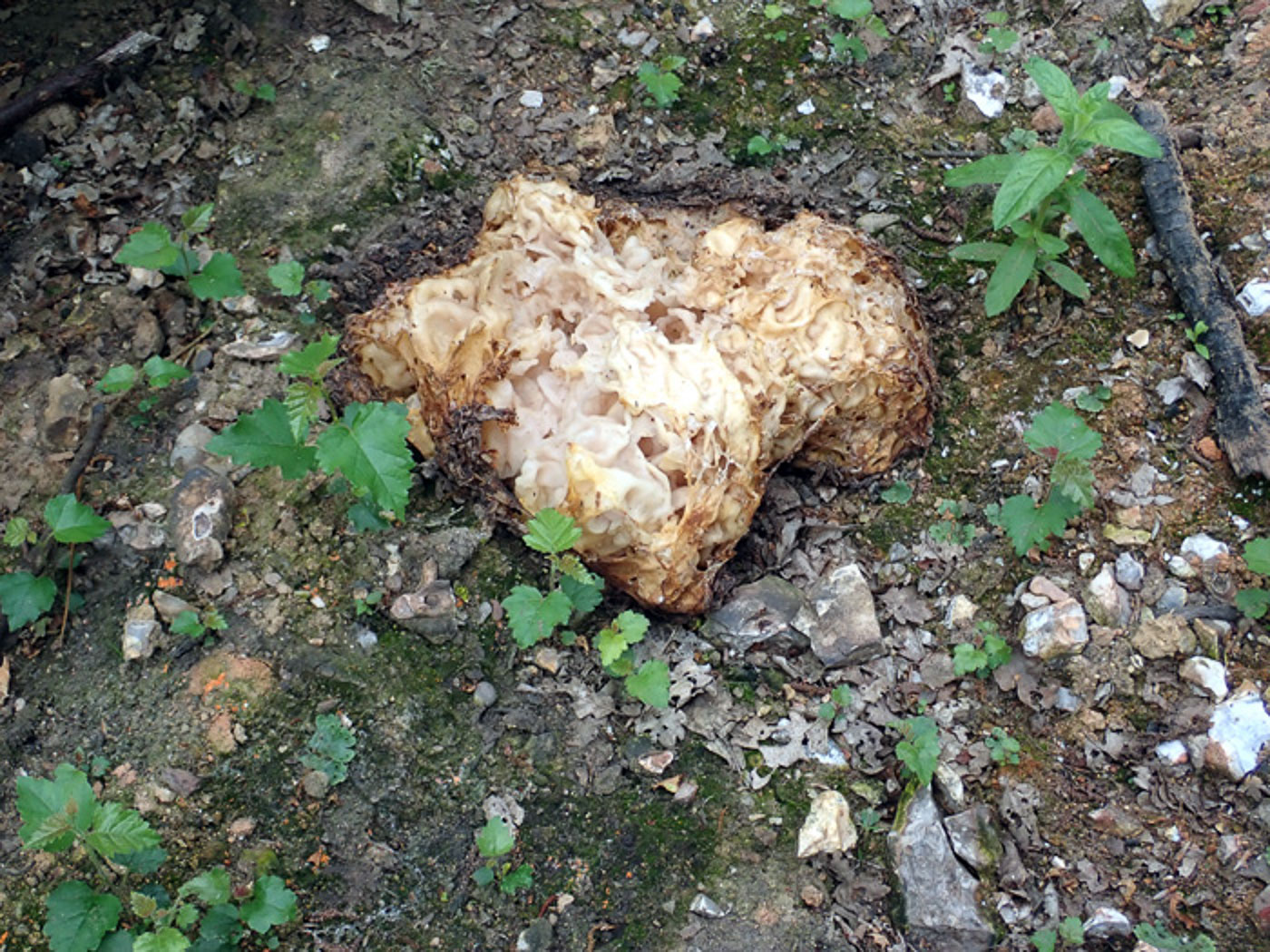
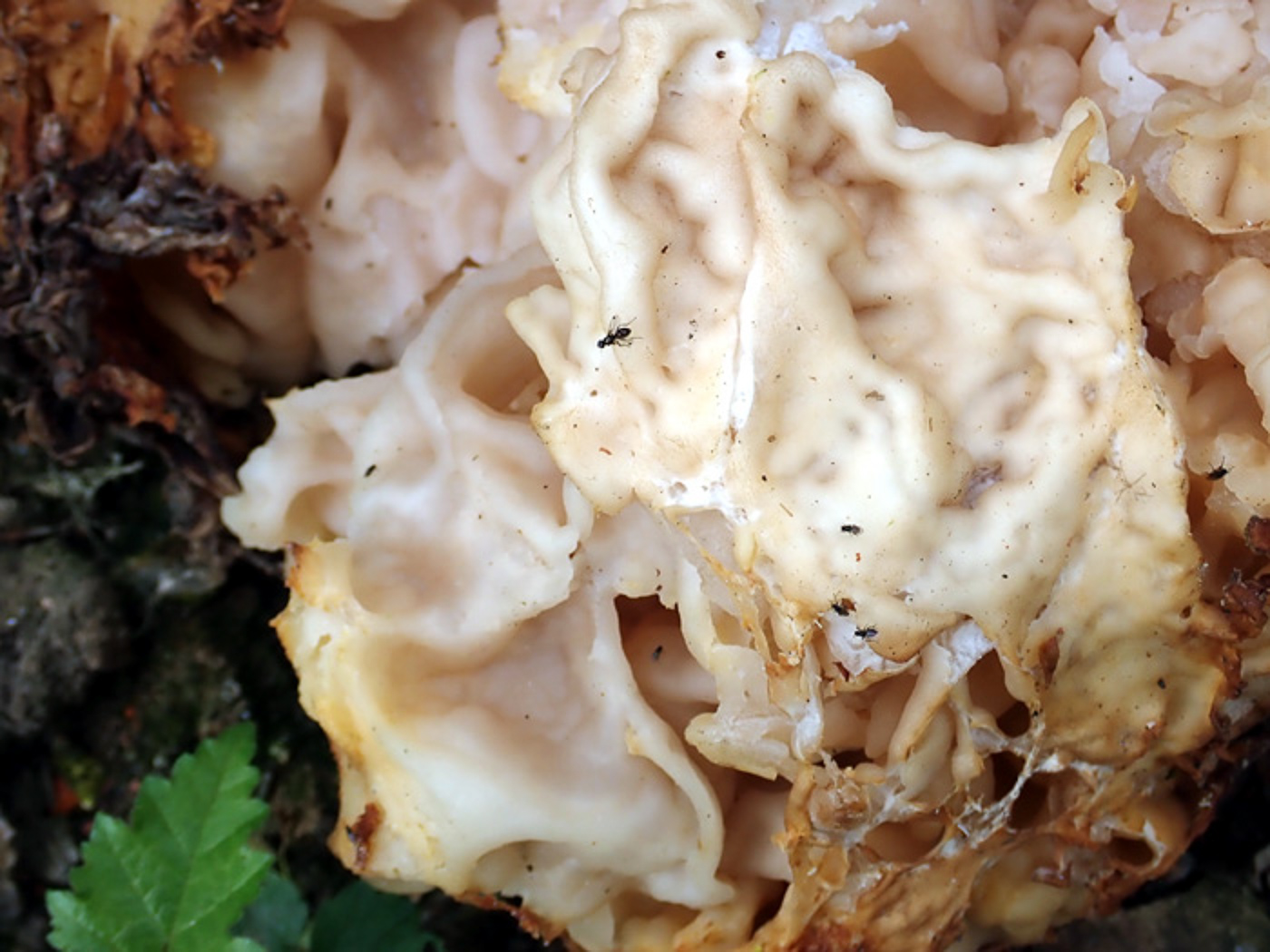 |
June 28th Daleomyces phillipsii (Bonfire Cauliflower) 
At Turville Heath Penny made sure she visited a particular bonfire site which has produced good numbers of interesting species in the past few months including three different Peziza species. One of them, Peziza petersii, was still in evidence today and has been fruiting here since April (see Finds 2023 April 15th), but she was even more thrilled to see a large expanse of what appears to be Sparassis crispa (Wood Cauliflower) but in fact is unrelated and is an Ascomycete until recently also attributed to the genus Peziza (P. proteana var. sparassoides) owing to its very similar microscopic characters though it looks nothing like any other member of that genus. The clump was well over a foot in diameter though clearly past its best and a bit shrivelled at the edges owing to its exposed position. It is considered rare, only occurs on burnt ground, and has now been moved to the genus Daleomyces together with P. petersii. Penny has found it only once before (2001 at College Lake), but it turned up at Wotton House Estate last year, found be Joanna Dodsworth on June 22nd (see Finds, that date for more).
|
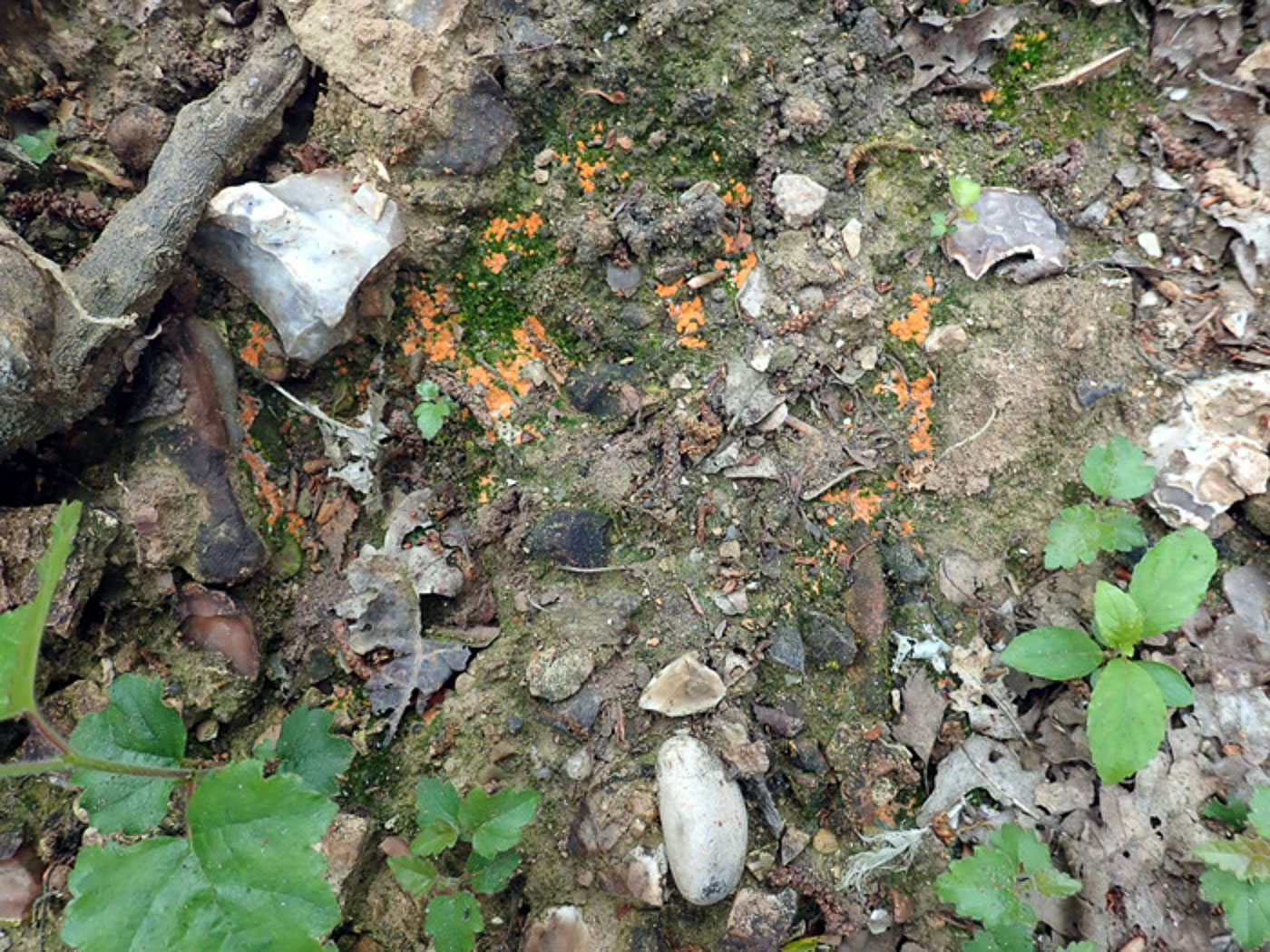
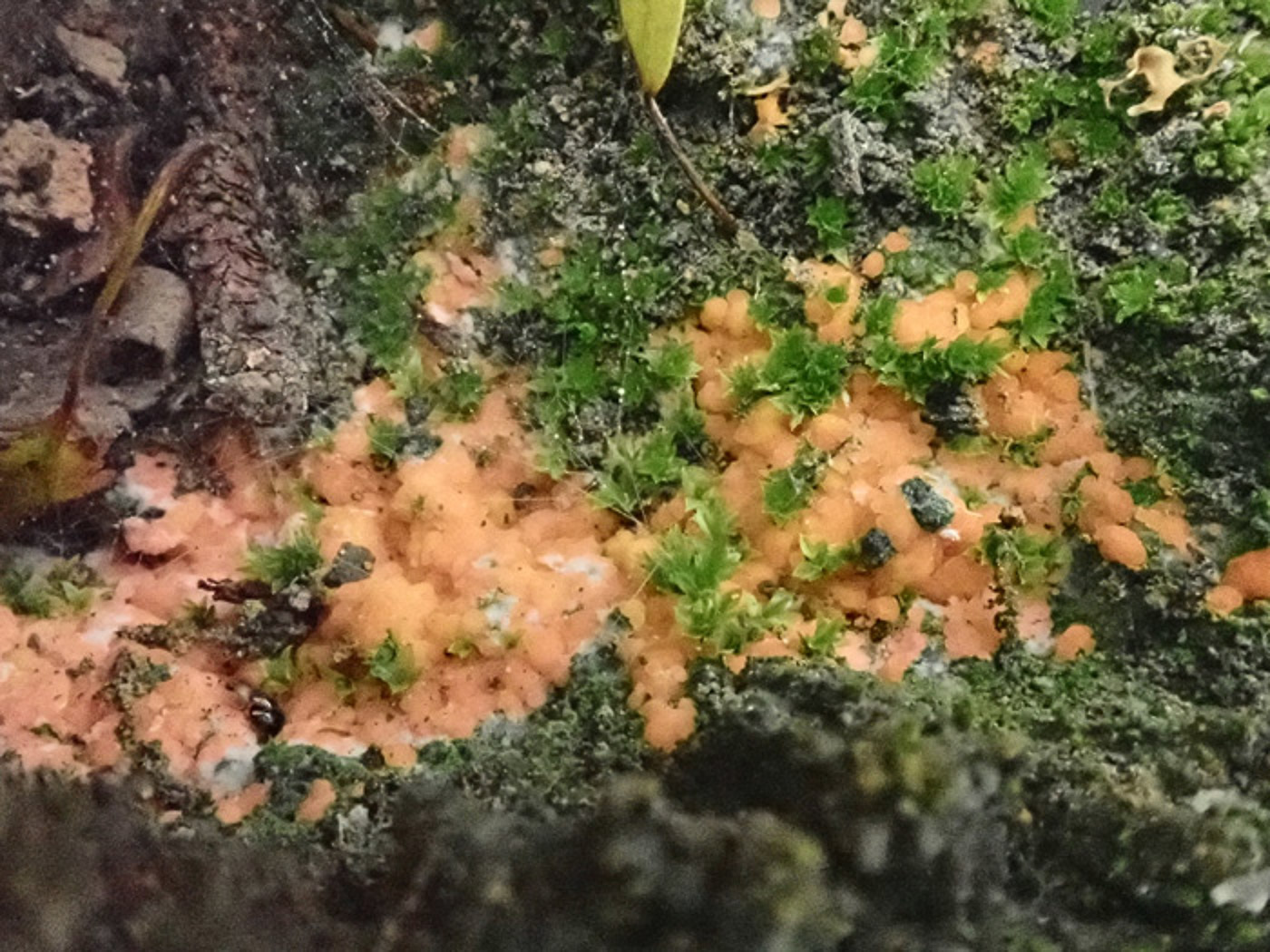 |
June 28th Pyronema omphalodes (an Ascomycete with no common name) 
At Turville Heath Penny found many pink-orange patches of this species together with several other interesting things on burnt soil on a surprisingly productive bonfire site. It was not a species she recognised but managed to work out from various sources using the microscopic characters. Though described as common we appear to have only three previous records, all from over 20 years ago, hence the green box. This is another new species for Finds.
|
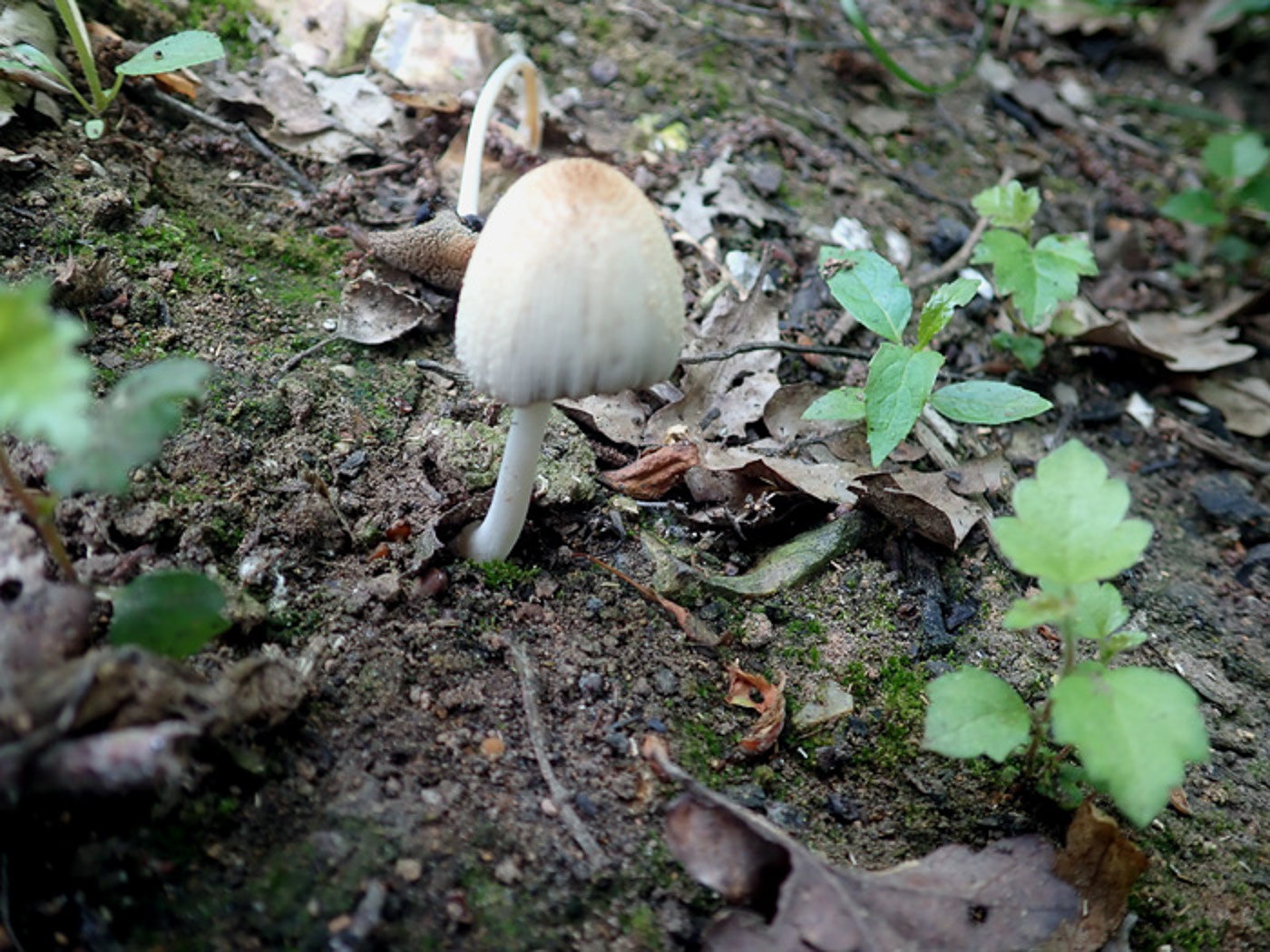
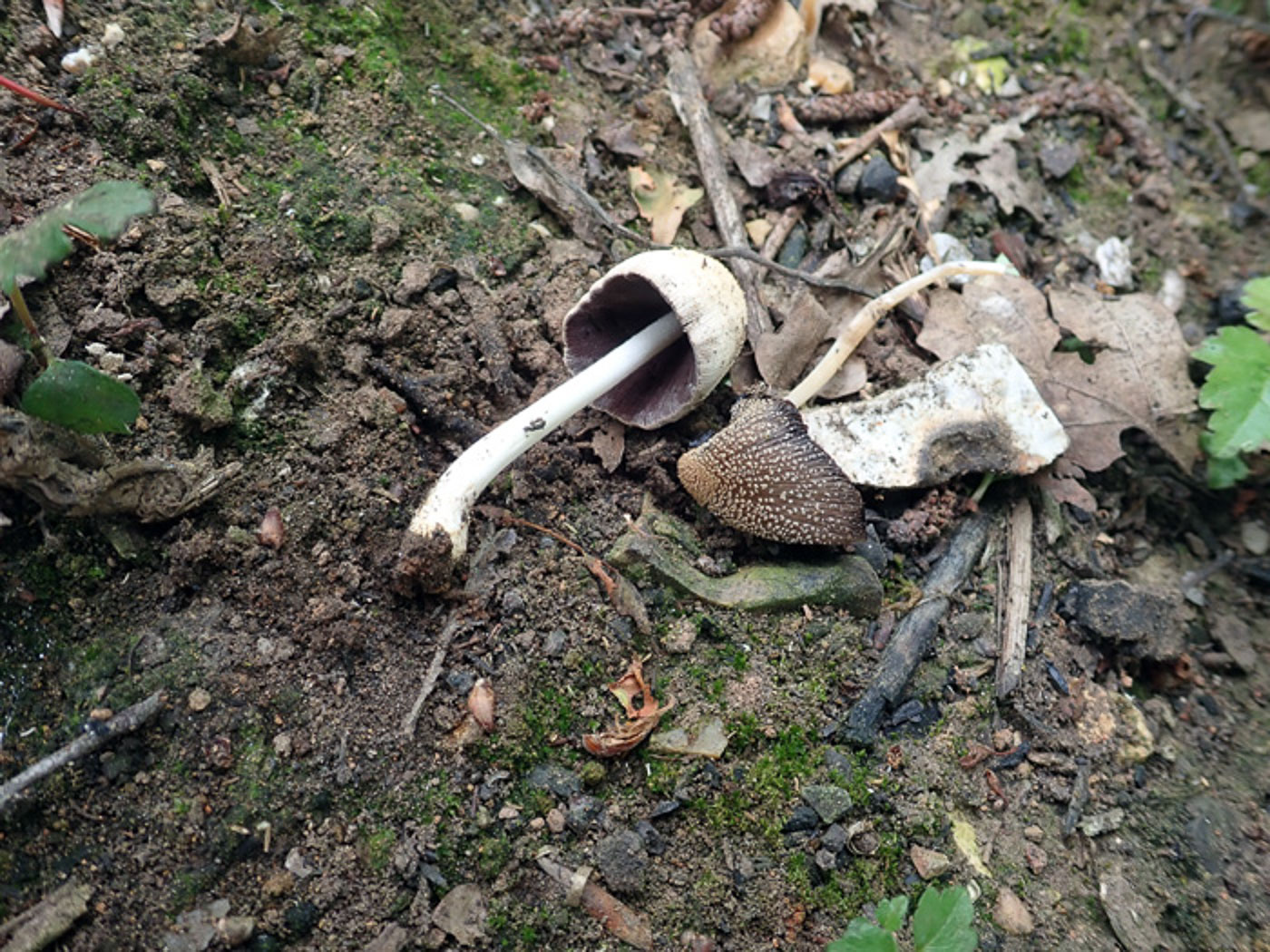 |
June 28th Coprinellus xanthothrix (an Inkcap with no common name) 
On an old bonfire site at Turville Heath Penny found several interesting species - the site has been amazingly productive for months. Still fruiting abundantly was Peziza petersii (see 2023 April 15th) and also this Inkcap which has been popping up here on and off there though there seems to be no reference to its occurrence on burnt sites in the literature. This is quite a common species - one that Derek often identifies for us, and has plenty of veil on the cap, seen particularly clearly on the old somewhat dried specimen in photo 2. Our only previous Finds entry is an earlier collection from this site (2023 April 15th).
|
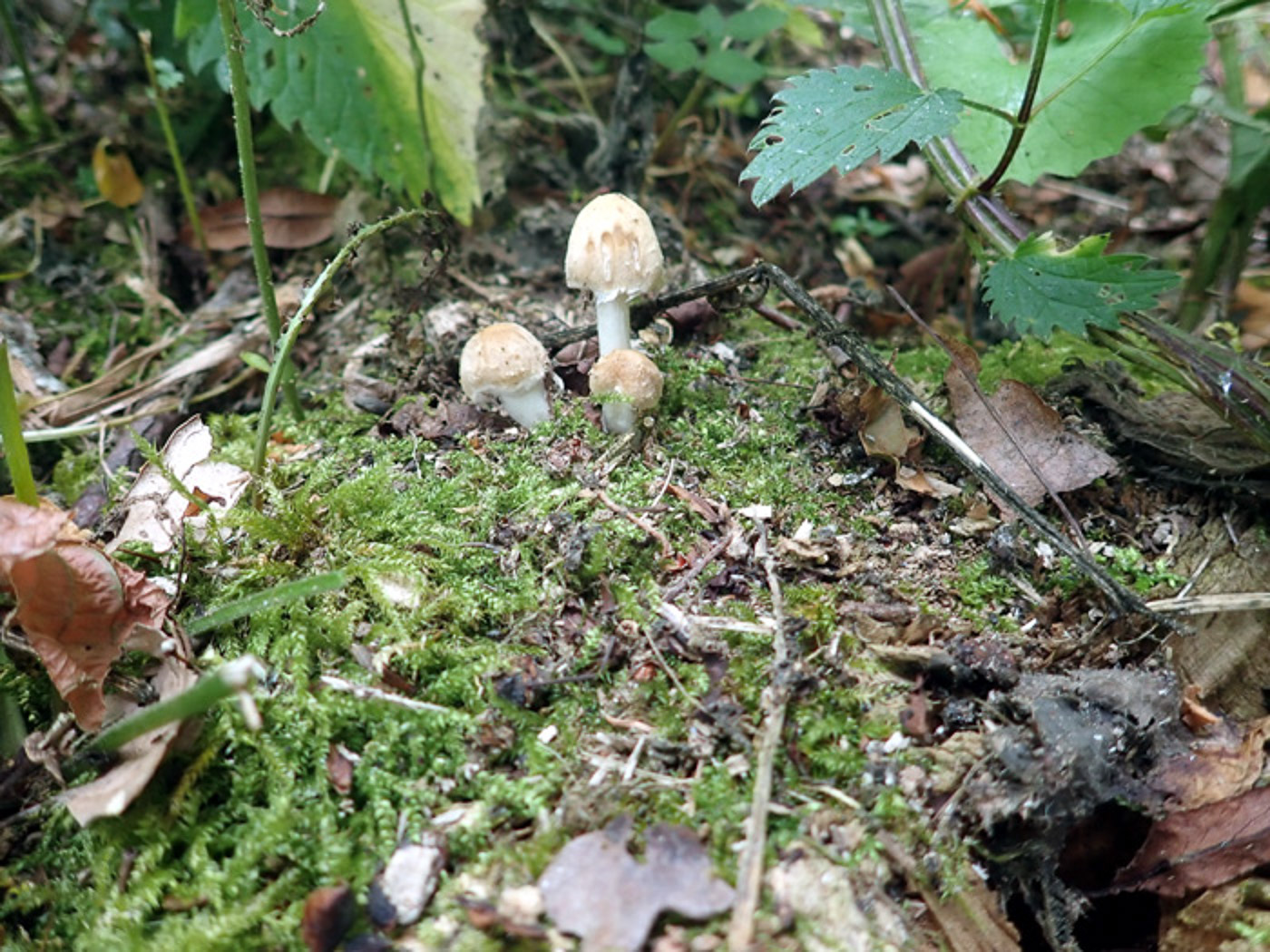
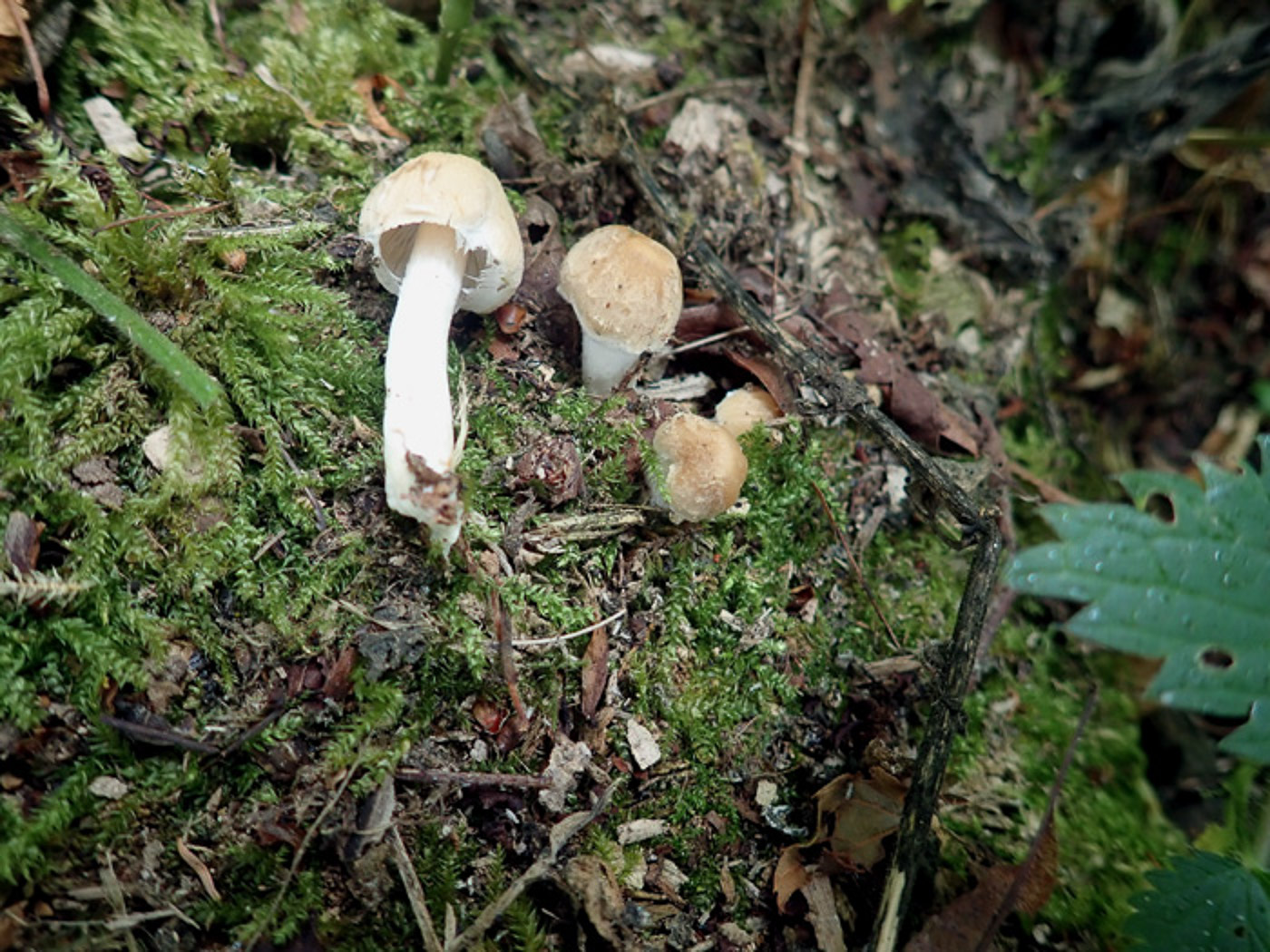 |
June 28th Psathyrella candolleana (Pale Brittlestem) 
Under the Limes at Turville Heath in woody debris Penny noticed this trio and at first glance thought they were Inkcaps but then noticed the ragged veil remnants attached to the cap edge, also the very pale gills - both typical of the species when immature. It is one which often fruits early in the season and is common along grassy path edges as well as on woody remains. We apparently now have to call this species Candolleomyces candolleanus! See the Masterlist for further examples (under its previous name!).
|
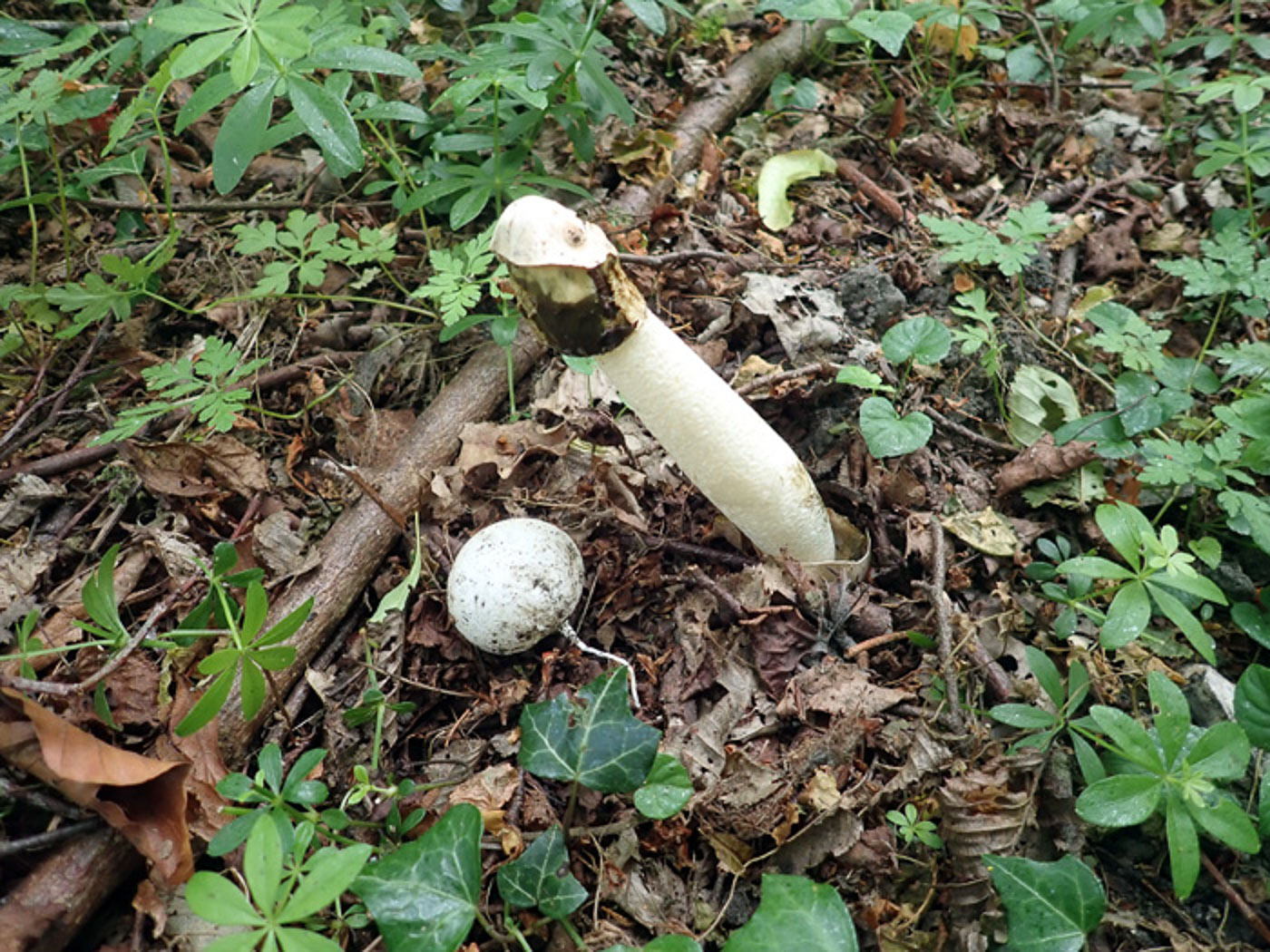
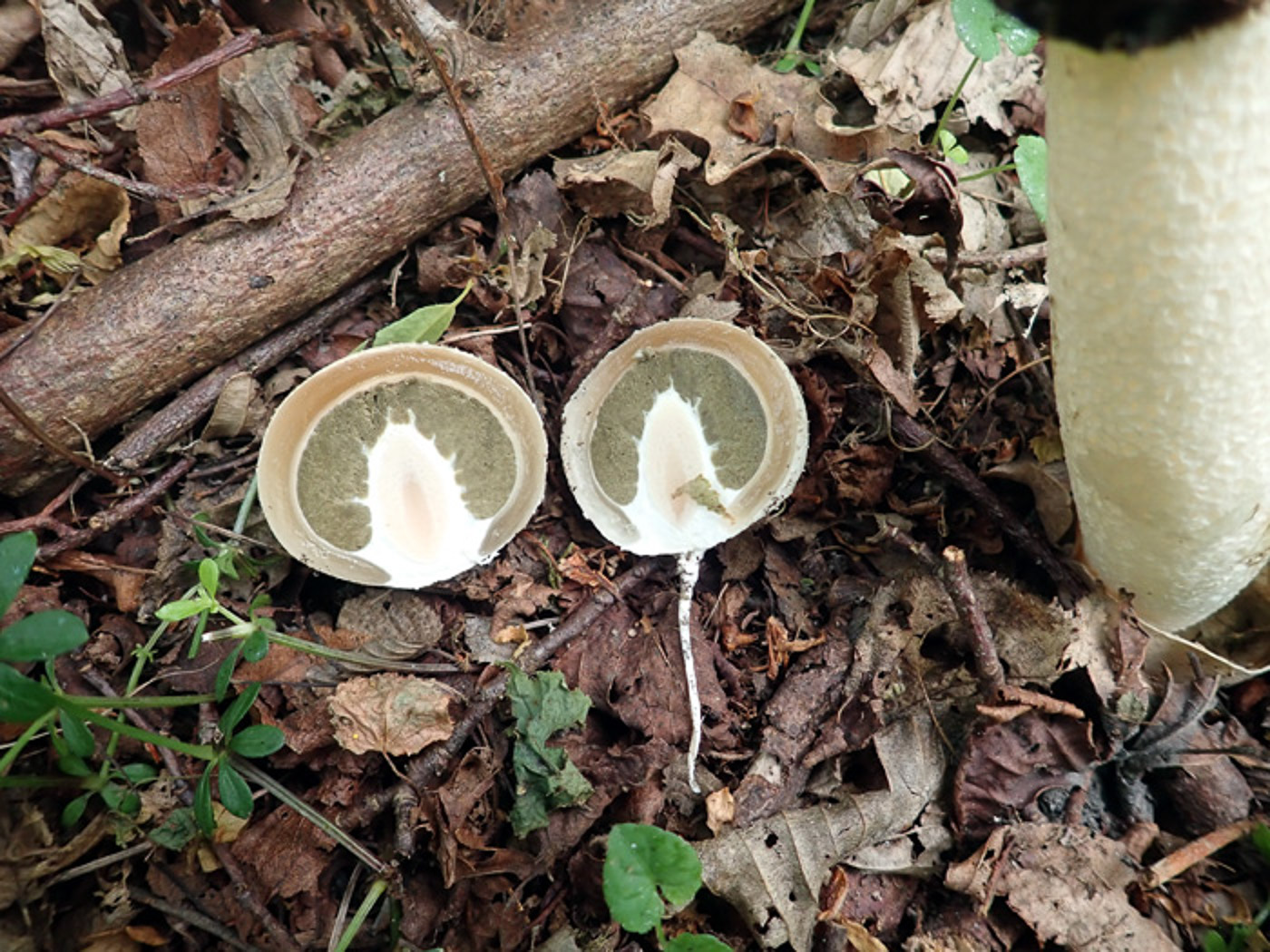 |
June 28th Phallus impudicus (Stinkhorn)
Under the Limes at Turville Heath Penny noticed this pair: one almost over with little olive green gunge left by the flies etc and the other still at the egg stage, so very little disgusting smell to give away their presence. This is quite an early fruiting but amongst our hundreds of records are a few from June, even the odd one from May, so not an exceptional find today. See the Masterlist for further examples.
|
June 26th 2023
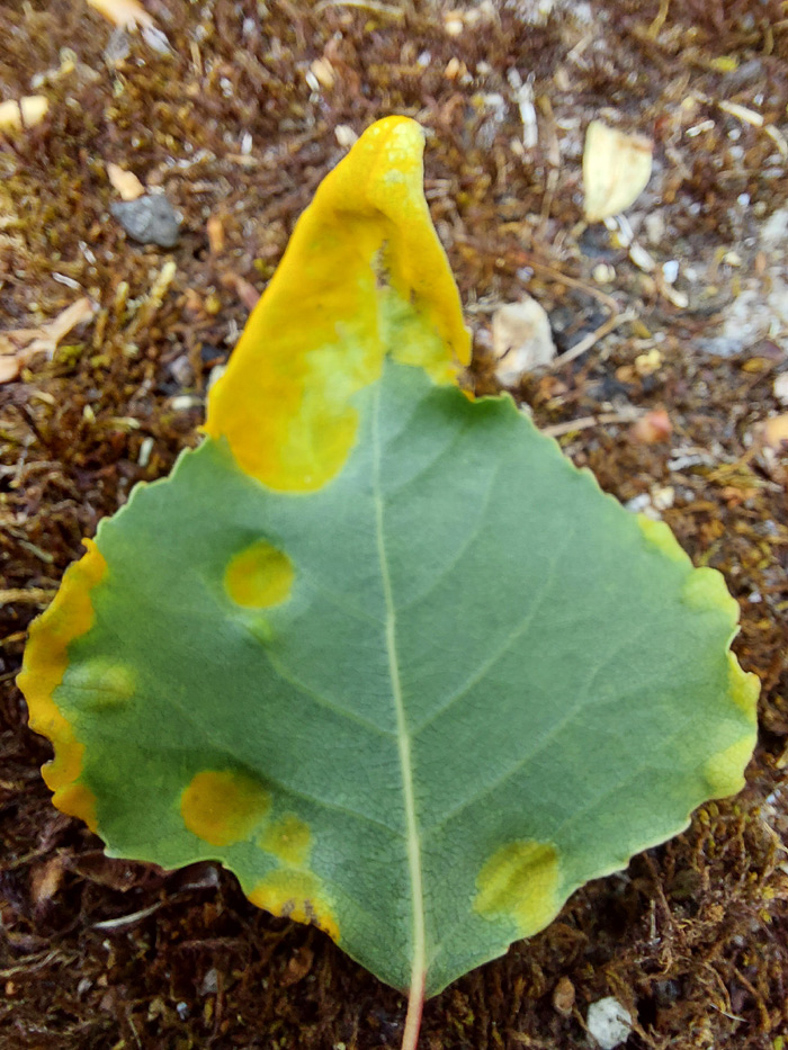
 |
June 26th Taphrina populina (Poplar Leaf Blister)
In Jordans Village, Jesper Launder noticed a few leaves on a sapling Black Poplar showing the telltale bright blisters of this species - not rare but with hardly any county records - none this century - no doubt due to the fact that few people look out for or would recognise such species at this time of year. This is therefore yet another new species for Finds.
|
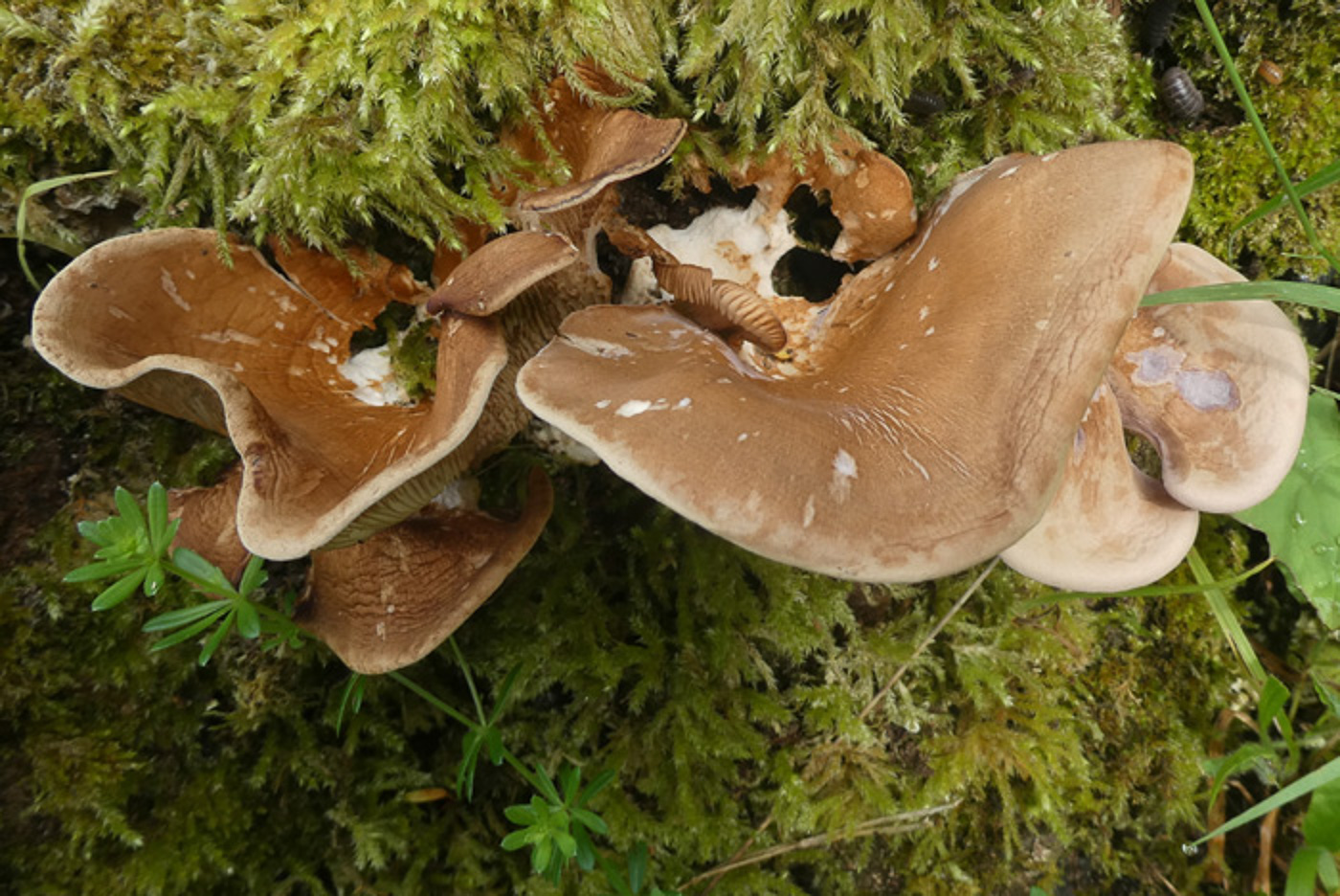
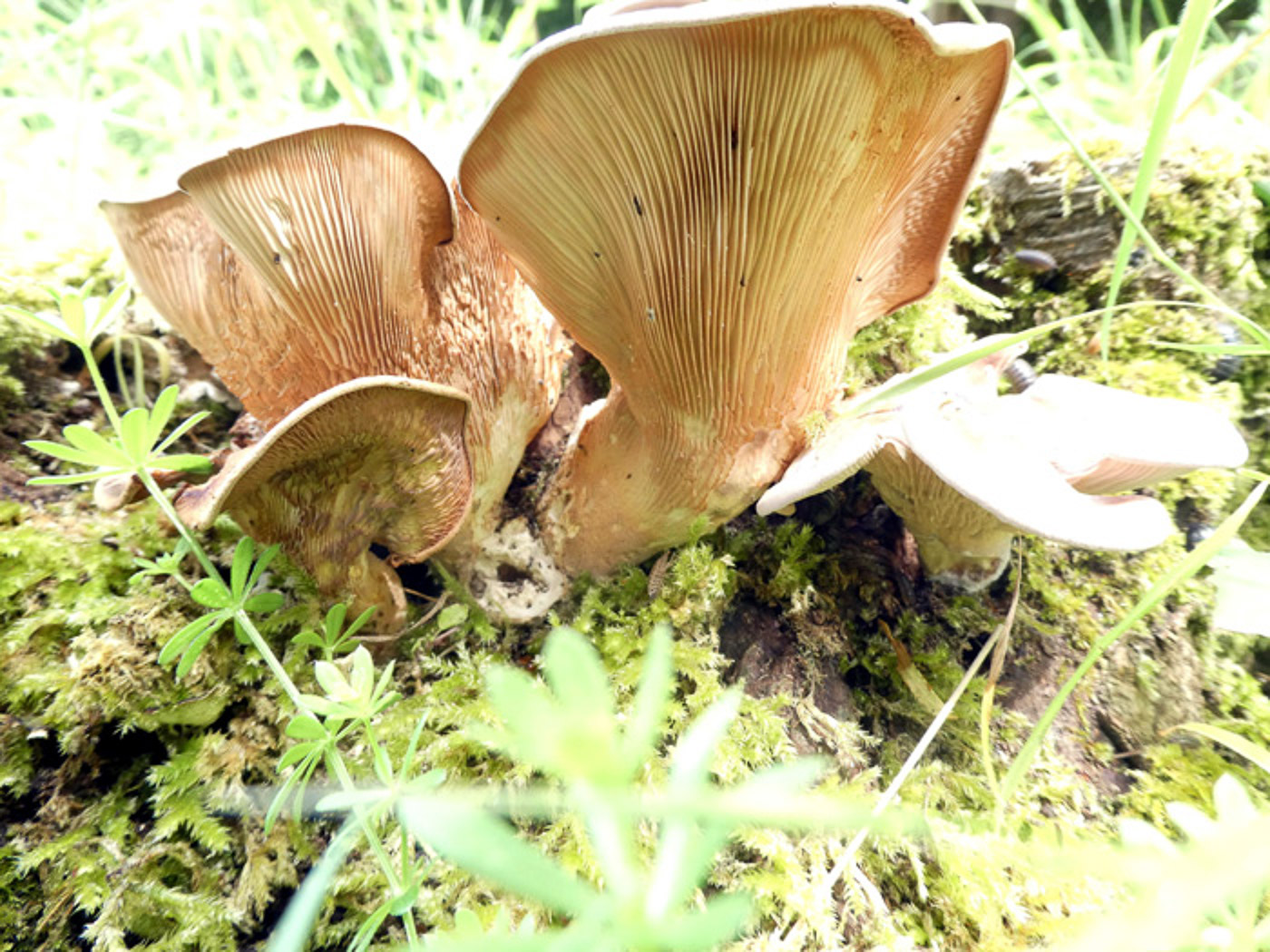
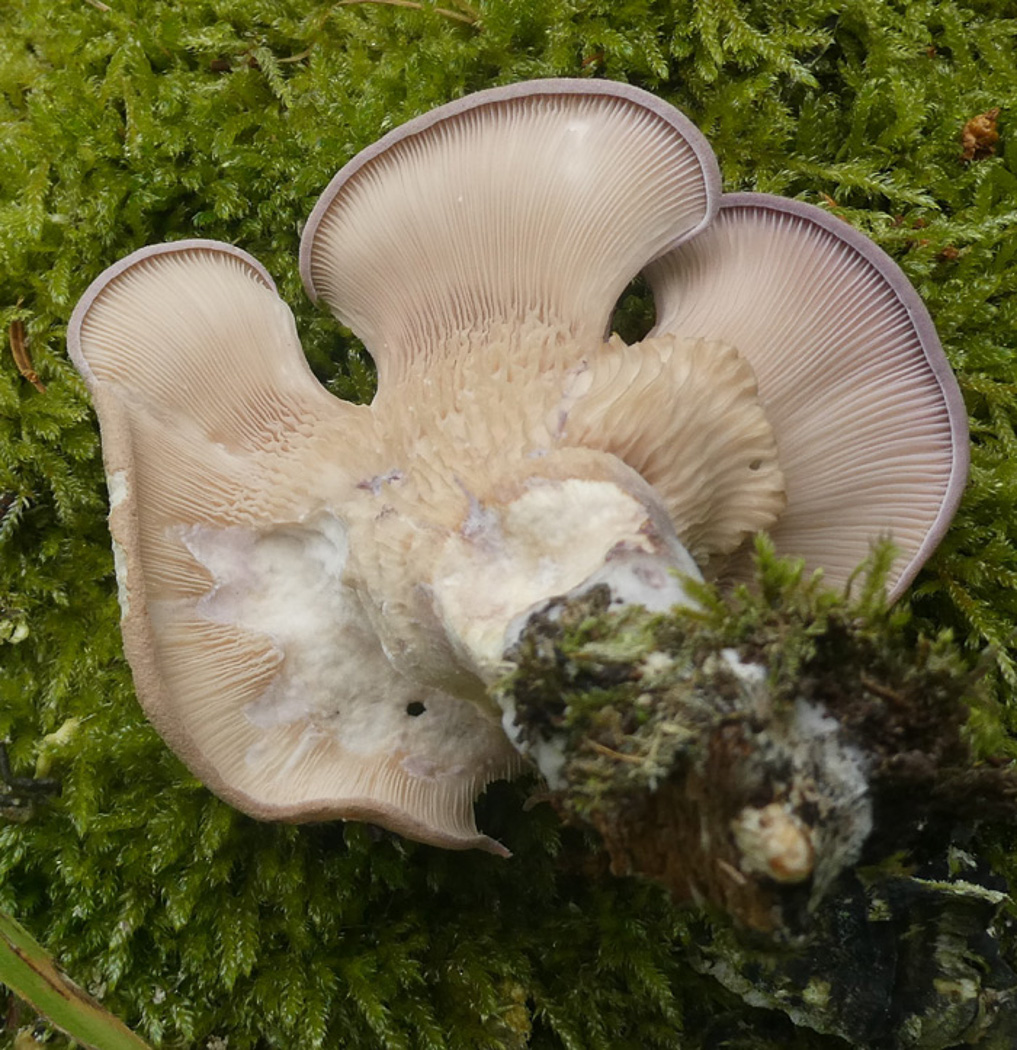
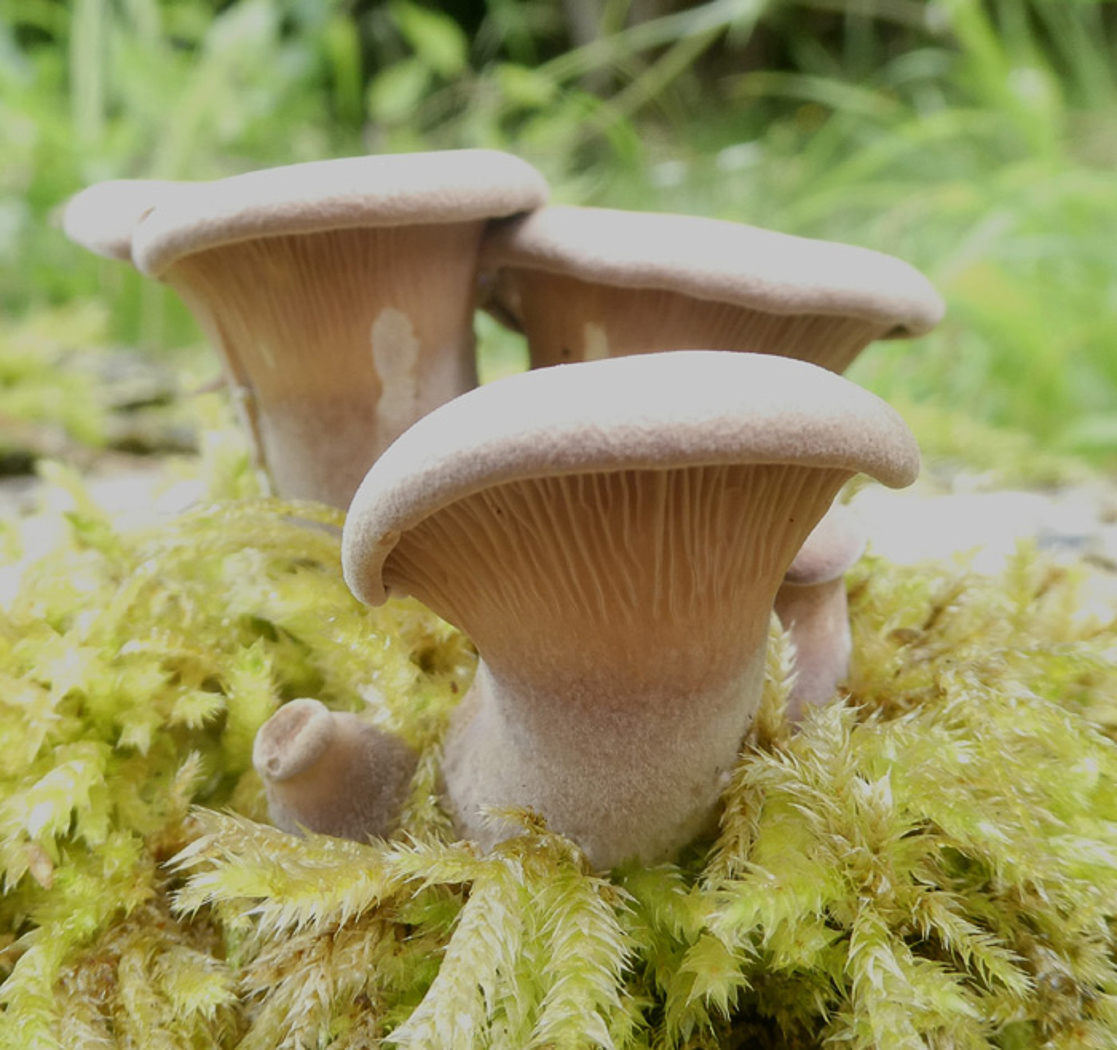
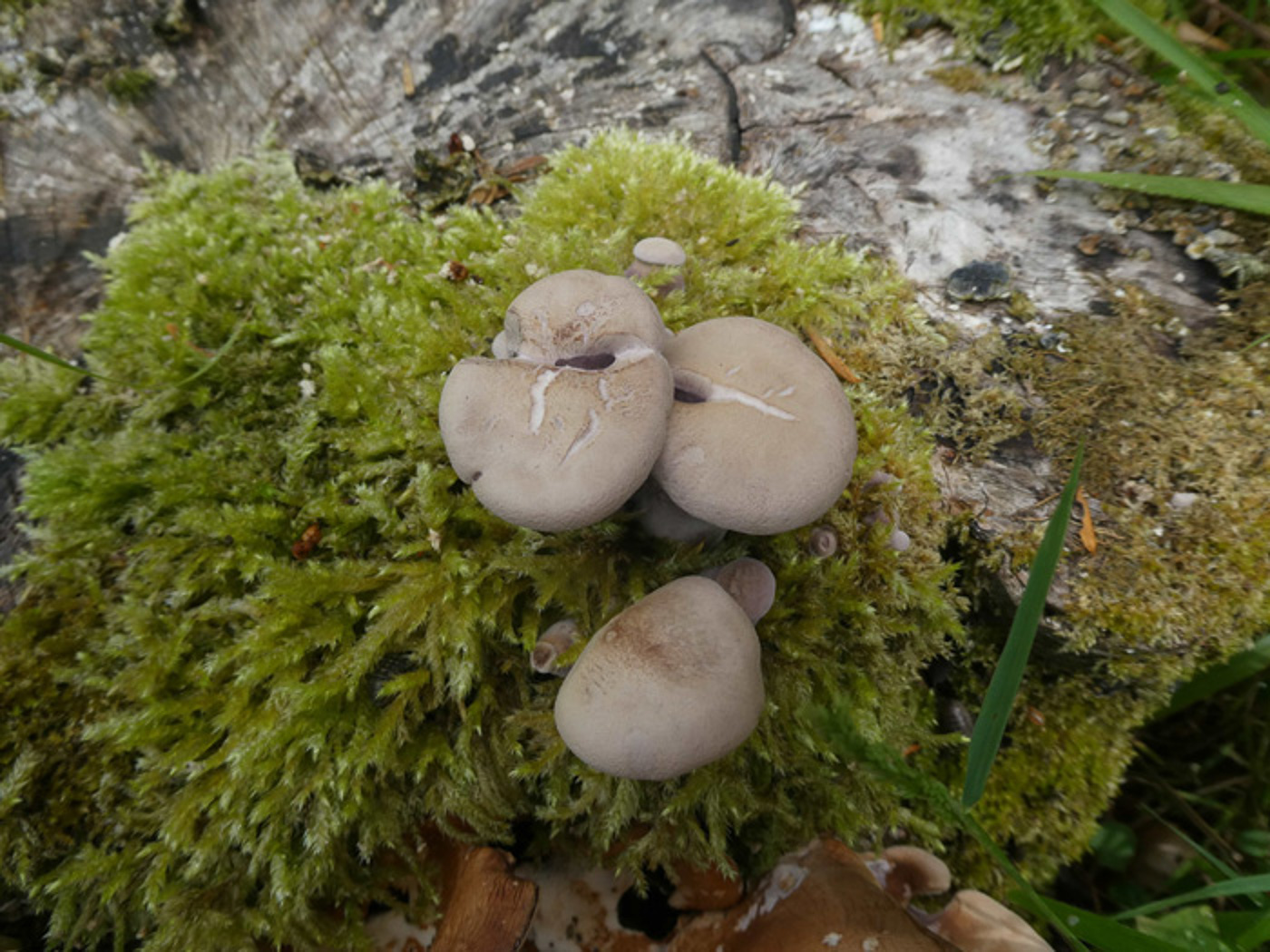 |
June 26th Panus conchatus (Lilac Oysterling) 
In Homefield Wood, near Hambleden, Jim Wills noticed this beautiful crop of pleurotoid fungi on an unidentified mossy stump, then noted the lilac tinge and strong fragrant smell, so at home checked the spore size and colour to confirm his ID. This lovely set of photos shows the species off at different stages of development including the lilac colours when fresh and young which then fade to tan as it matures. Though not a rarity we have very few records from only two other county sites and our only Finds entry (2020 September 25th) was of somewhat dried out material.
|
June 24th 2023
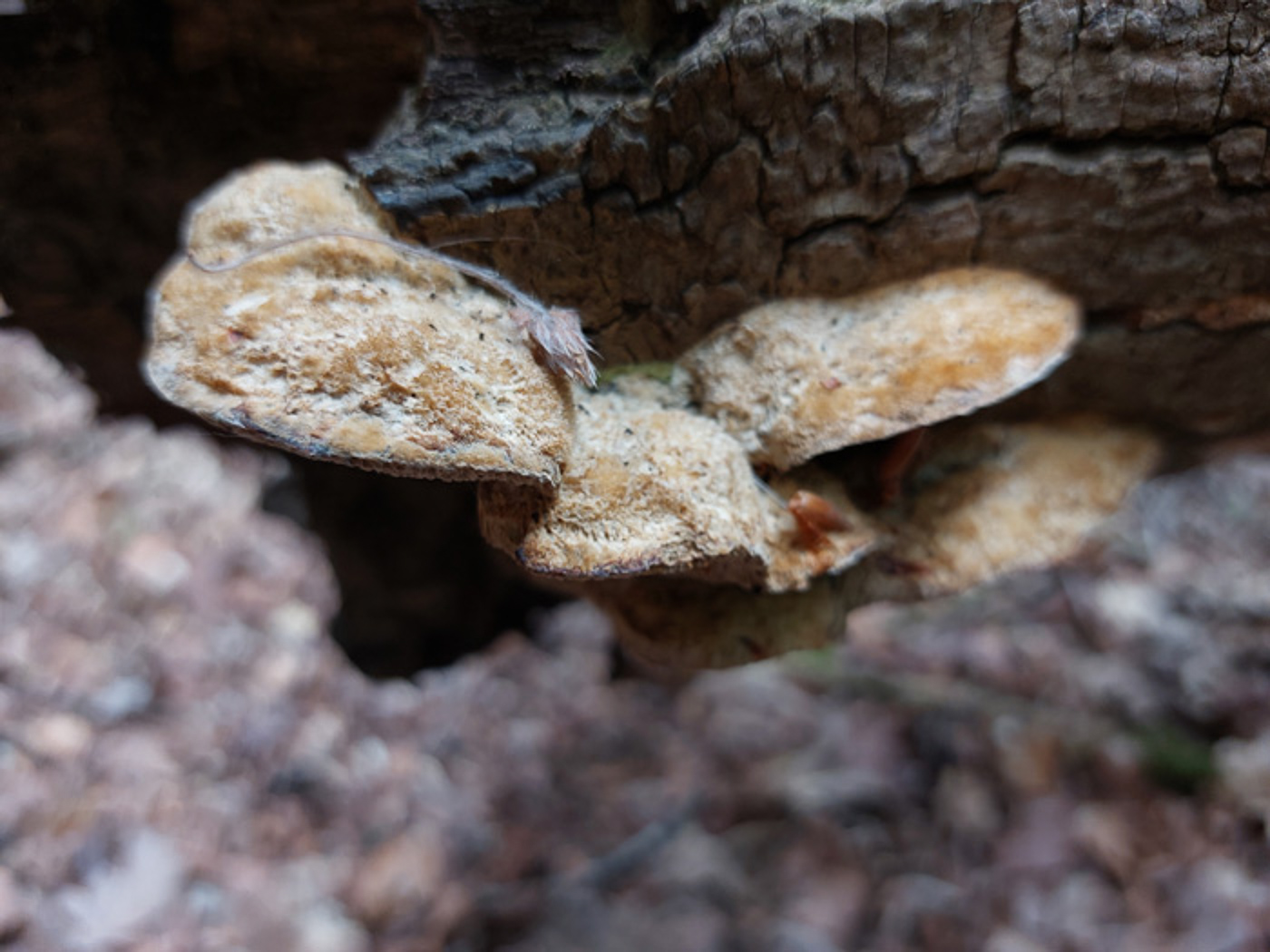
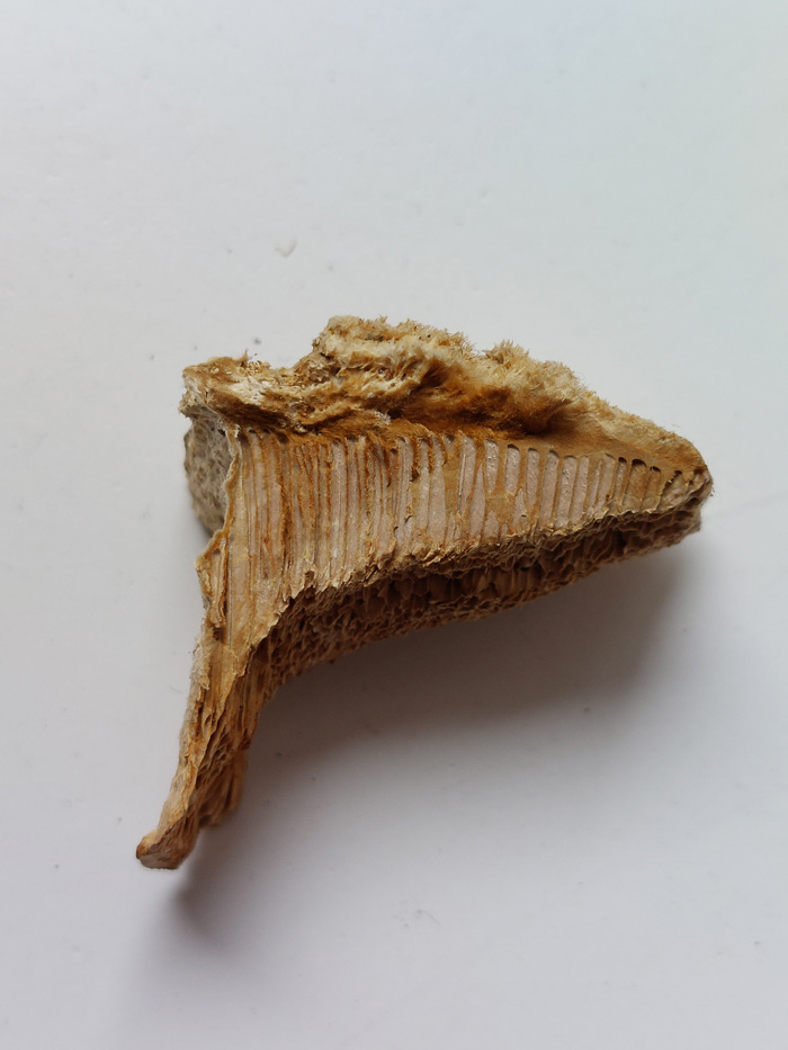
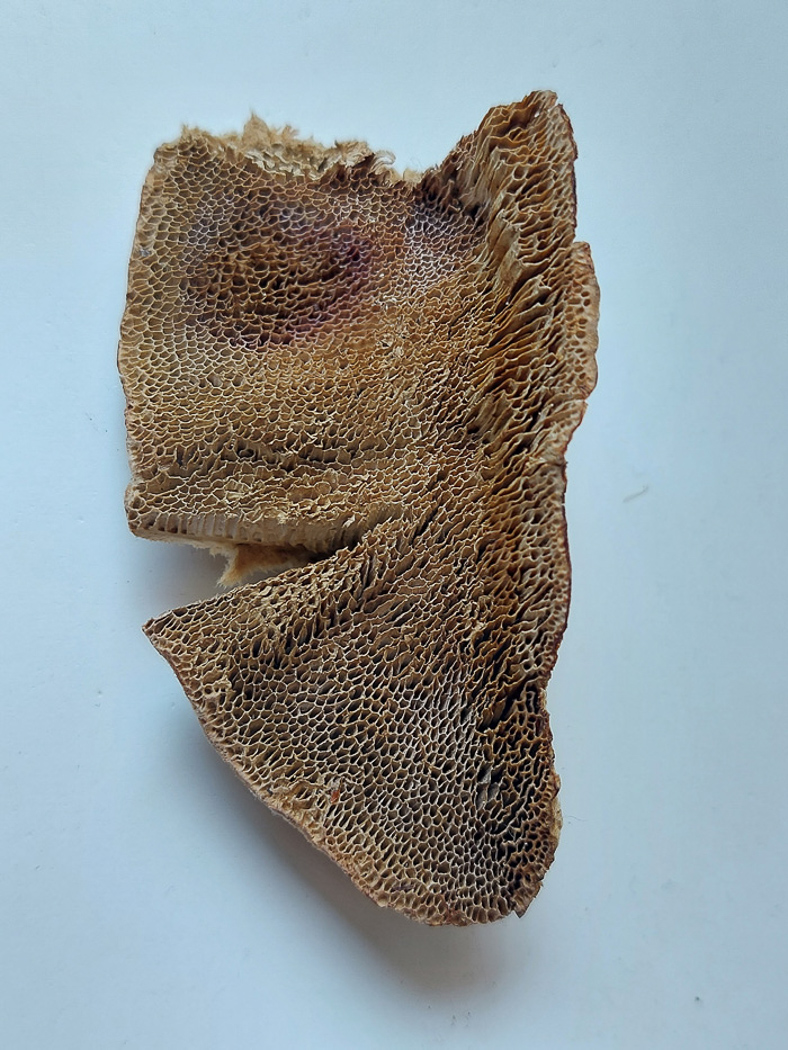 |
June 24th Coriolopsis gallica (an unusual bracket with no common name) 
In Gerrards Cross on an unidentified log Jesper Launder noticed two different brackets: one he was able to identify as Trametes hirsuta (see below) but the other he was unsure of though it was somewhat similar. It resembled T. gallica, now in genus Coriolopsis, but he knew of another species which also matched it closely though only recently added to the UK list: Trametes trogii. On consulting expert Martyn Ainsworth he learnt that a useful difference to separate the two is the white context above the pores when torn open in T. trogii but coloured context in C. gallica (see photo 2). We have only one previous county record, from Langley Park identified by Martyn back in 2008, so this is another new species for Finds.
|
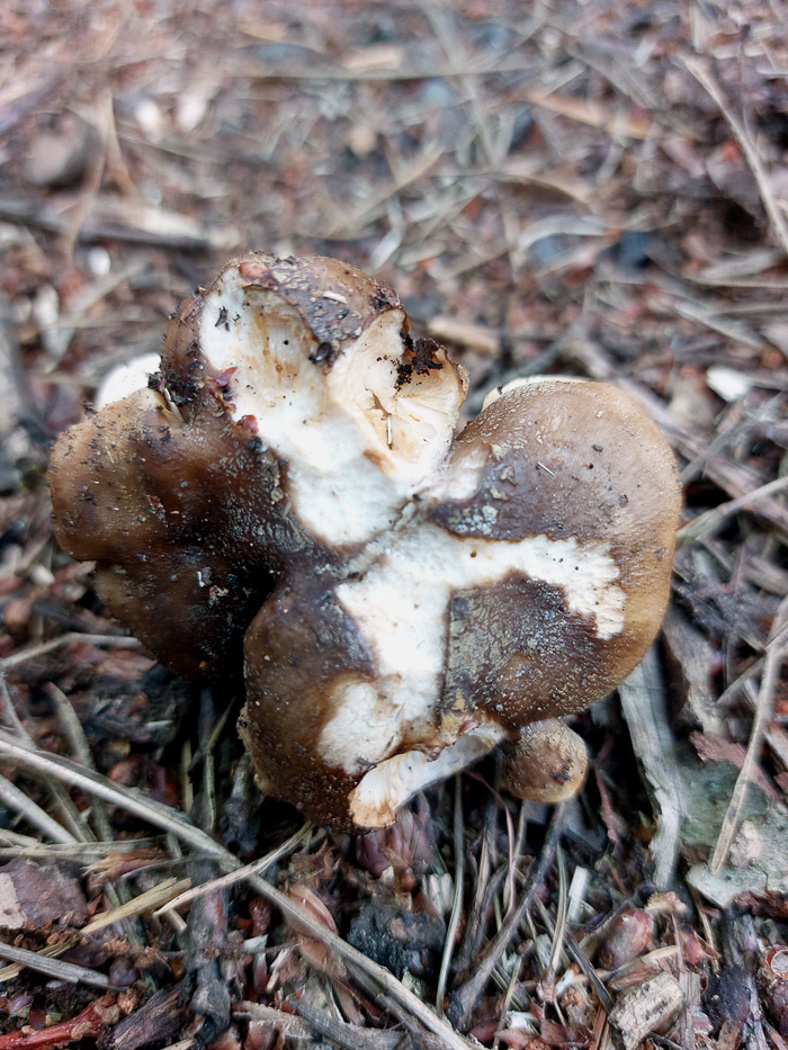

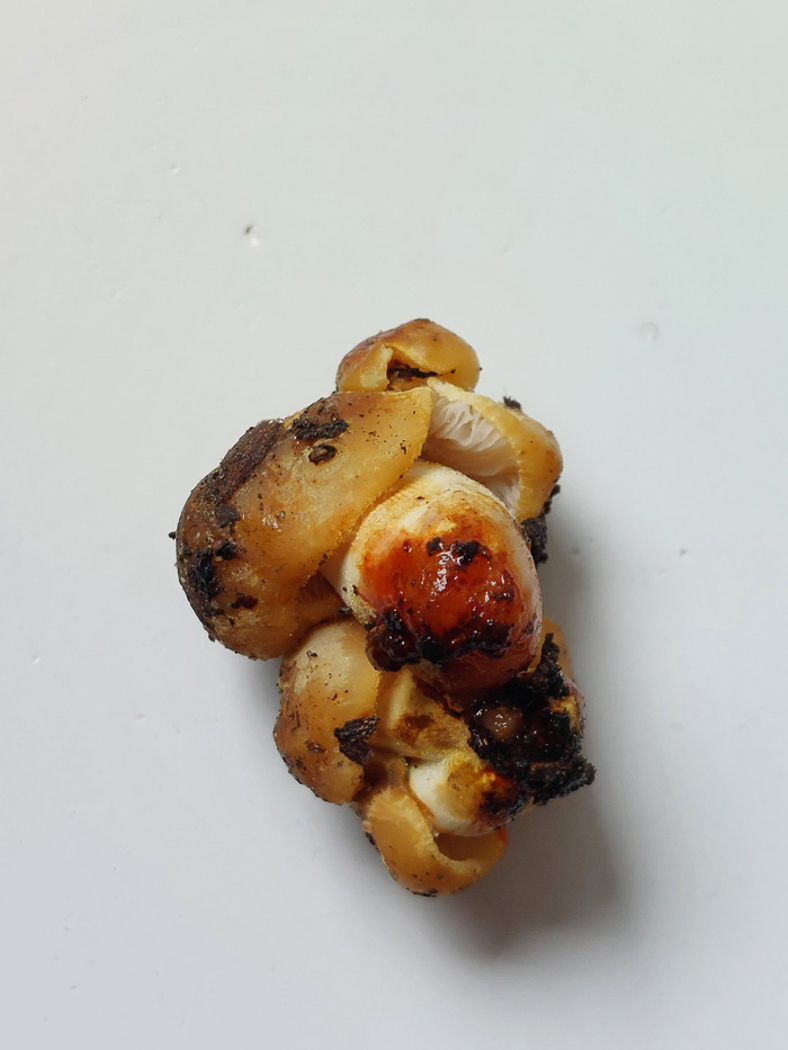 |
June 24th Russula insignis (a rare species of Brittlegill with no common name)
In Gerrards Cross under Oak with Beech and Aspen nearby, Jesper Launder found this cluster of Brittlegills, some just emerging through the somewhat dry soil. The mature specimen (photo 1) clearly was akin to either R. sororia or R. amoenolens - both very similar members of the 'Smellies' group which occur under Oak but are difficult to split without recourse to a drop of Guaiac on the stem (instant dark blue in amoenolens but only slowly pale blue in sororia). However, he noticed that the immature specimens in the cluster (photo 2) showed a distinct yellowish veil on the cap and also on the lower stem - a sure sign of the rare R. insignis. Testing with KOH later, however, at first failed to show the telltale and unique bright red reaction present at the stem base in this species - a good way to confirm ones ID. However, he had convincing success when applied to the immature specimen (photo 3). We have only three previous county records of this species which is a first for Finds.
|
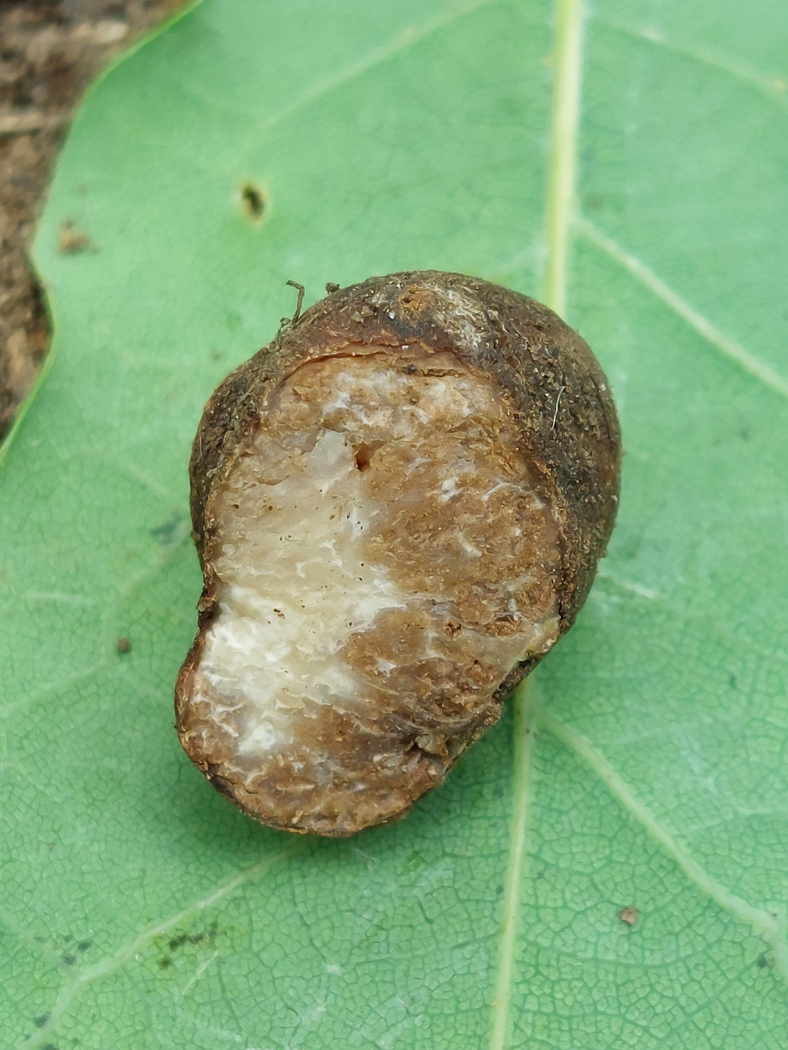 |
June 24th Tuber rapaeodorum (A rare species of Tuber with no common name) 
In Gerrards Cross Jesper Launder had a field day finding four different species of truffle including this one under Oak which is new to the county with only 15 national records on FRDBI. He informed Penny: 'Confirmed by its large, narrowly ellipsoid, and uniformly reticulated spores. One I've only encountered once previously, in Cheshire.' This was an exciting find.
|
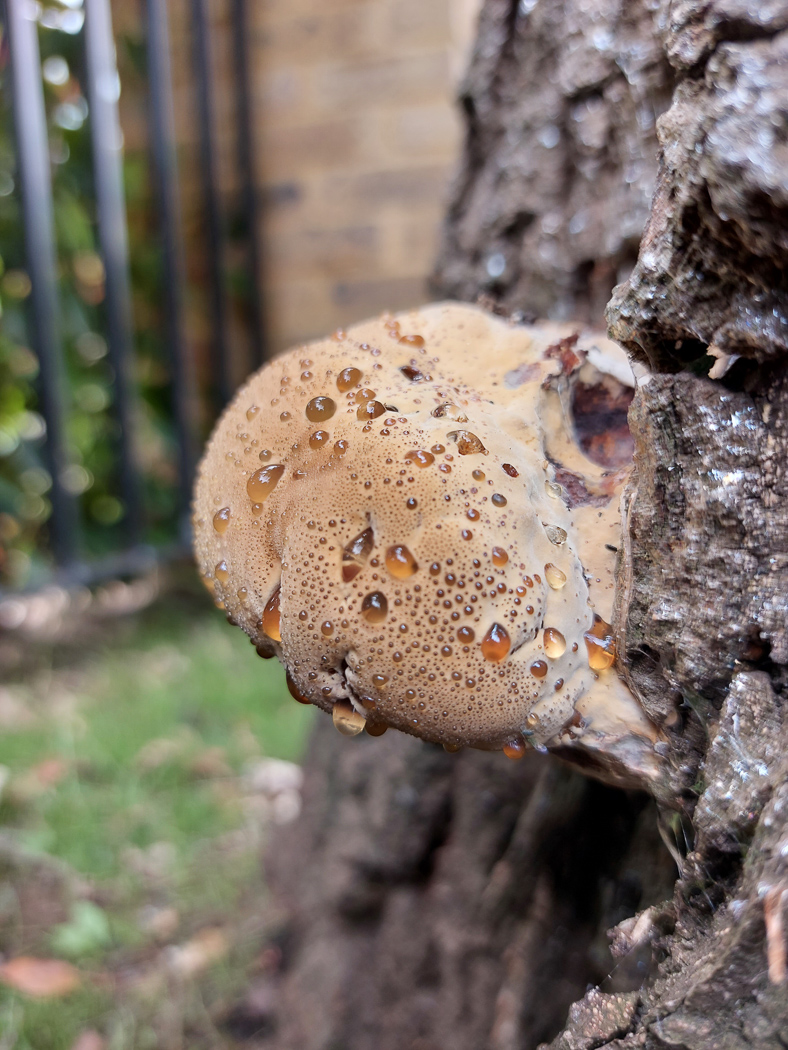 |
June 24th Pseudoinonotus dryadeus (Oak Bracket)
In Gerrards Cross under a mature Oak Jesper Launder noticed this typically weeping example of quite an uncommon bracket. Better known under its previous genus name of Inonotus, it occurs almost exclusively on Oak (occasionally on Sweet Chestnut) and is parasitic, living on the heartwood of mature trees and nearly always appearing low down on the trunk as here. See also in Finds 2020 September 24th and 2021 July 28th.
|
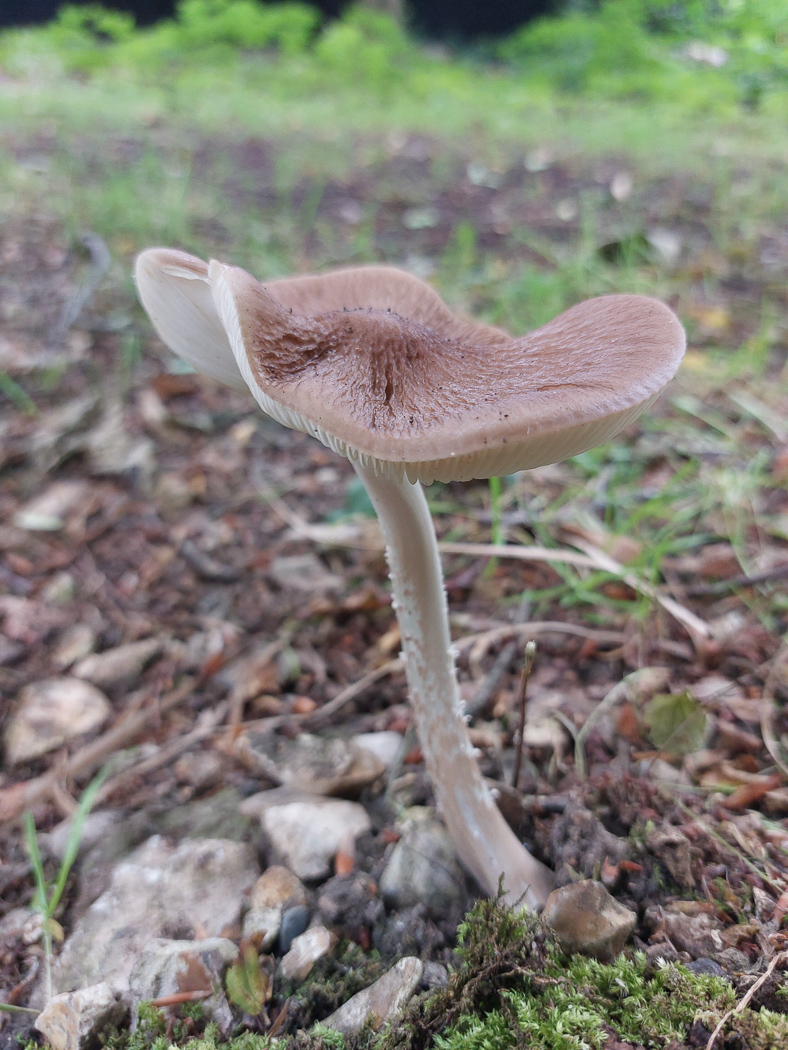 |
June 24th Hymenopellis radicata (Rooting Shank)
In Gerrards Cross under a deciduous tree Jesper Launder noticed this sizeable mushroom managing to fruit despite the warm dry conditions. Better known under its previous genus name of Xerula and before that Oudemansiella, this is a common species growing on tree roots, most commonly on Beech, hence getting moisture from those roots so probably less affected by drought conditions that some other genera. If its typically wrinkled cap surface (seen here) is not obvious, its thick white 'taproot' can often be dug up with care, proving its identity.
|
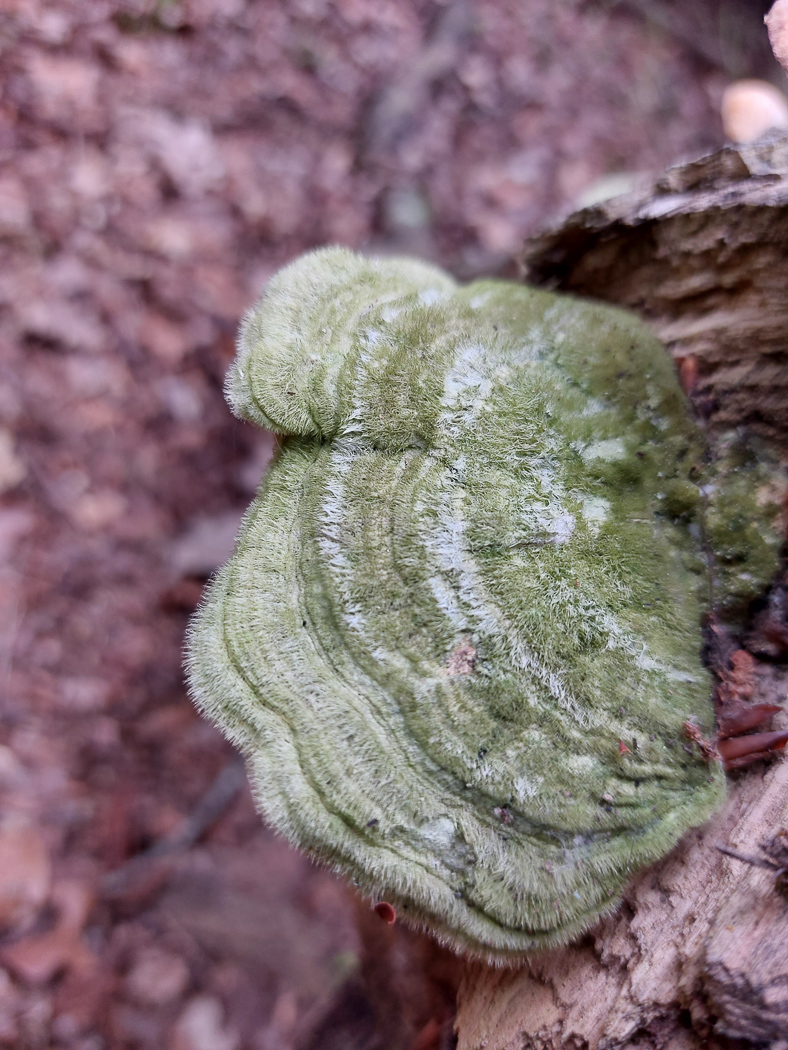 |
June 24th Trametes hirsuta (Hairy Bracket) 
On an unidentified log in Gerrards Cross, Jesper Launder found two different brackets, this being one - the other not yet identified satisfactorily. The species is typical of the genus having pale cream obvious pores underneath though is not nearly as common as T. versicolor (Turkeytail) or T. gibbosa (Lumpy Bracket). Very similar are T. ochracea and T. pubescens though the latter (also hairy!) can apparently (though not easily) be separated from today's species by observing the size of the pores and spores respectively: up to 3(4) pores per mm in T. hirsuta, spores 6-9 x 2-2.5 microns, but pores a bit smaller - up to 5 pores per mm in T. pubescens, spores 5-7 x 1.5-2 microns. See also Finds 2020 October 6th and 2023 January 15th.
|
June 19th 2023
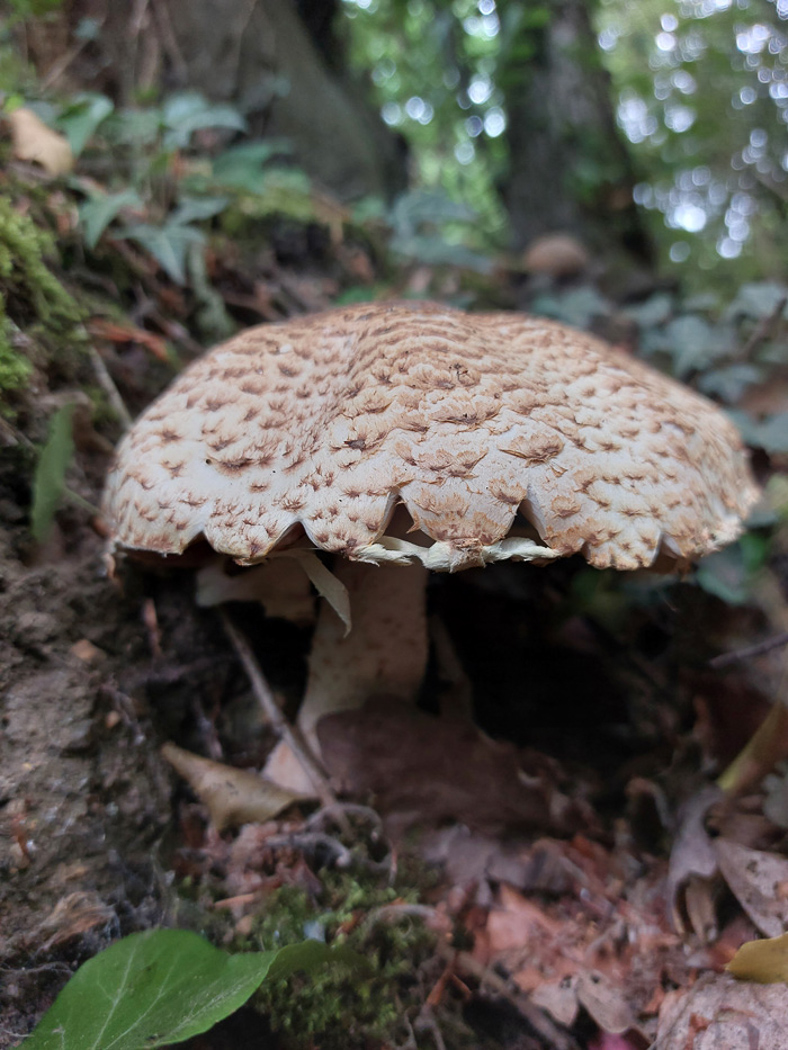 |
June 19th Agaricus augustus (The Prince)
In Jordans Village Jesper Launder was surprised to find this unusual and sizeable Mushroom managing to fruit successfully during one of our hottest driest Junes for some years. It seemed a shame to uproot it for the sake of a look at the gills and stem, so he left it in situ (probably for someone else to come along and knobble, seeing as it is renowned as one of the tastiest in the genus!). This is a new entry for Finds.
|
June 18th 2023
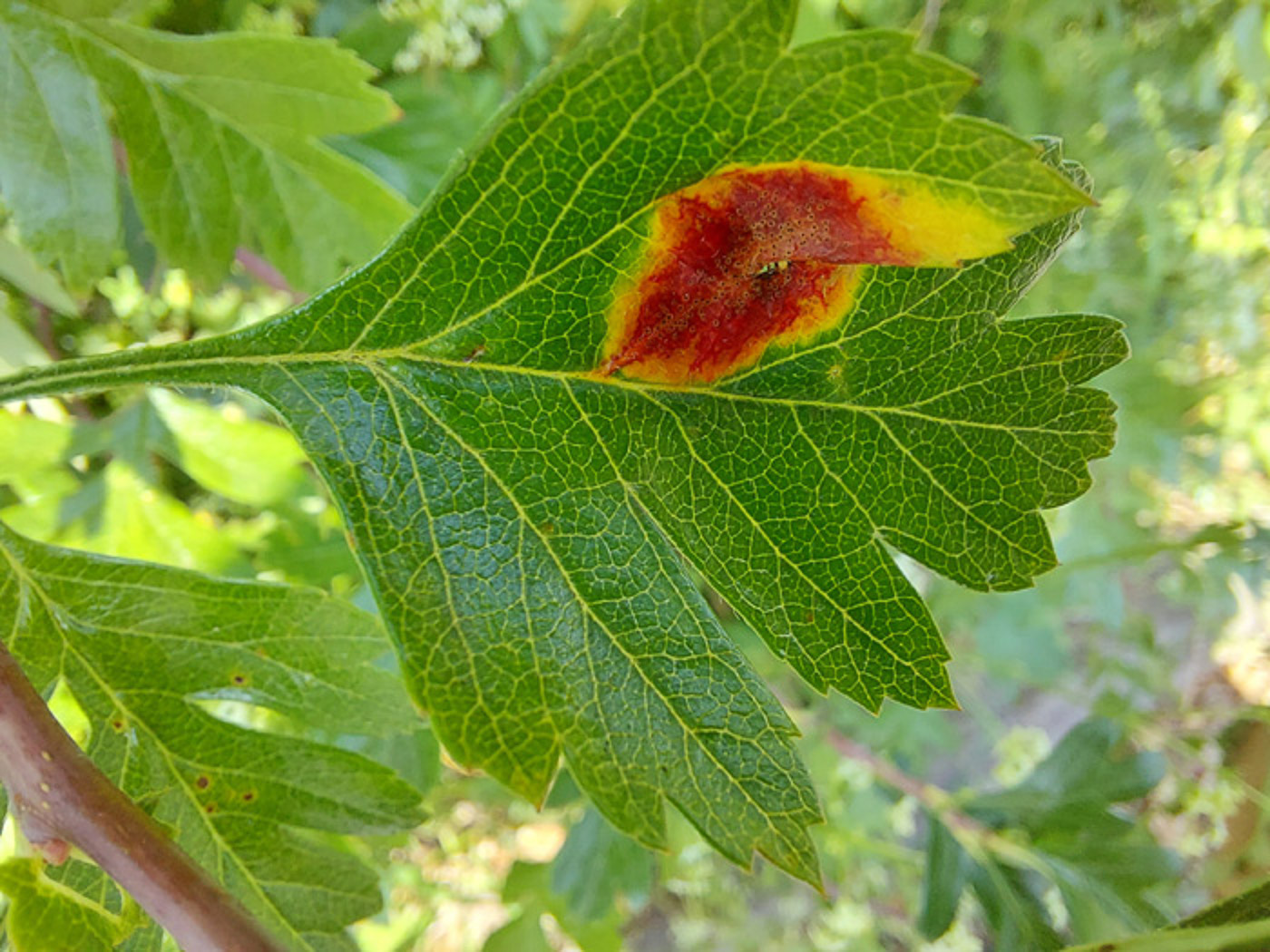
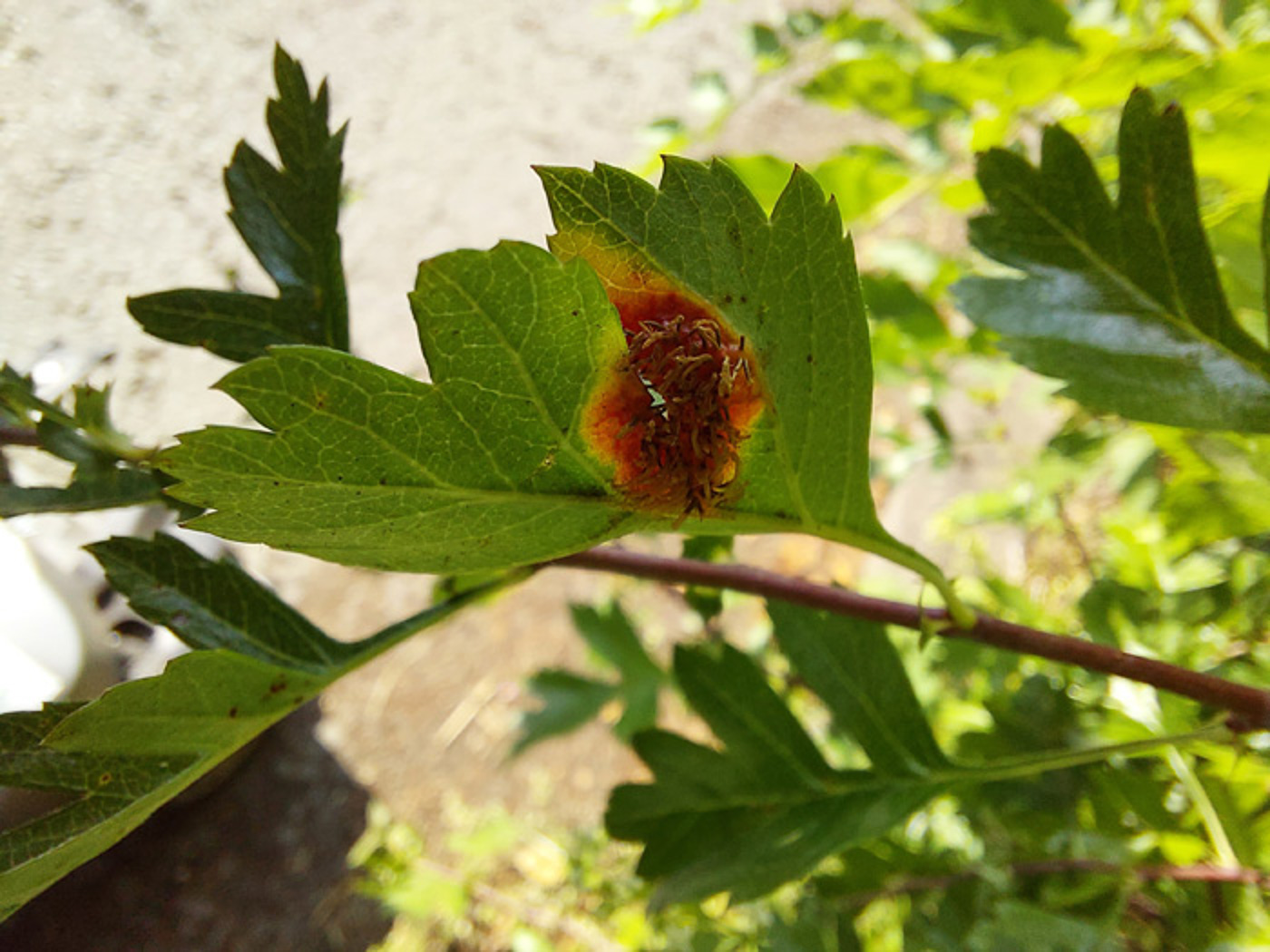 |
June 18th Gymnosporangium clavariiforme (Tongues of Fire)
In Seer Green Jesper Launder noticed a Hawthorn bush with a few leaves showing these rusty marks and recognised these as the second stage of this particular rust species which needs two different host trees in fairly close proximity to form its life cycle. In Spring the 'telia' stage is found on Juniper and forms orange to yellow jellylike spikes (from which comes its common name). Later it forms these rusty patches on leaves of nearby Hawthorn, the underside of which (photo 2) develops the horn-shaped spikes seen here and which later become finely hairy and brown. We have very few sites where either stage of this Rust has been recorded (one being Pulpit Hill, another Bradenham Estate) and despite searching the prolific Juniper at Burnham Beeches this April we failed to find it there. Any sites where both Juniper and Hawthorn grow together are likely spots, however. This is a new entry for Finds, but see 2022 September 30th for another species of this genus.
|
June 8th 2023
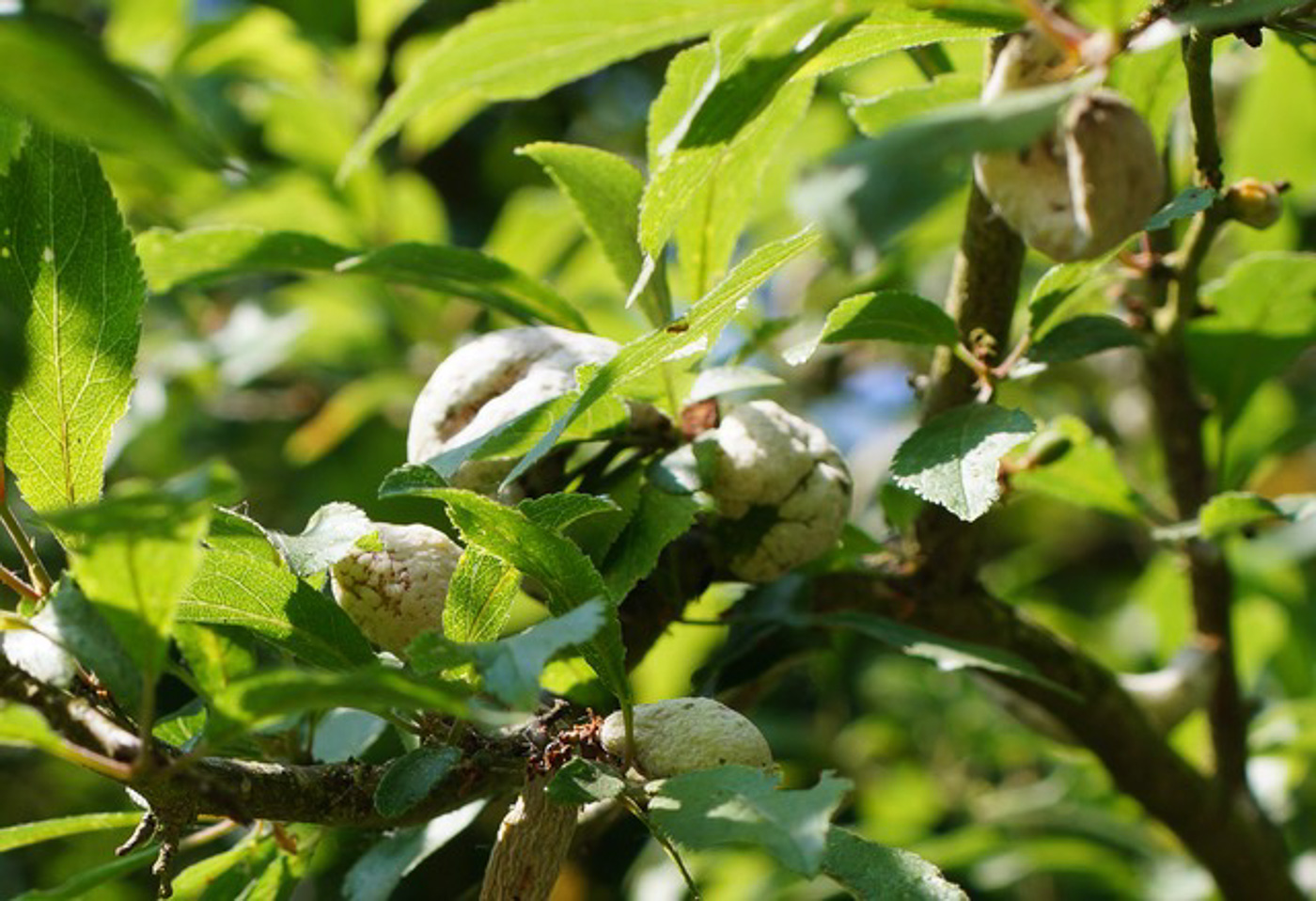
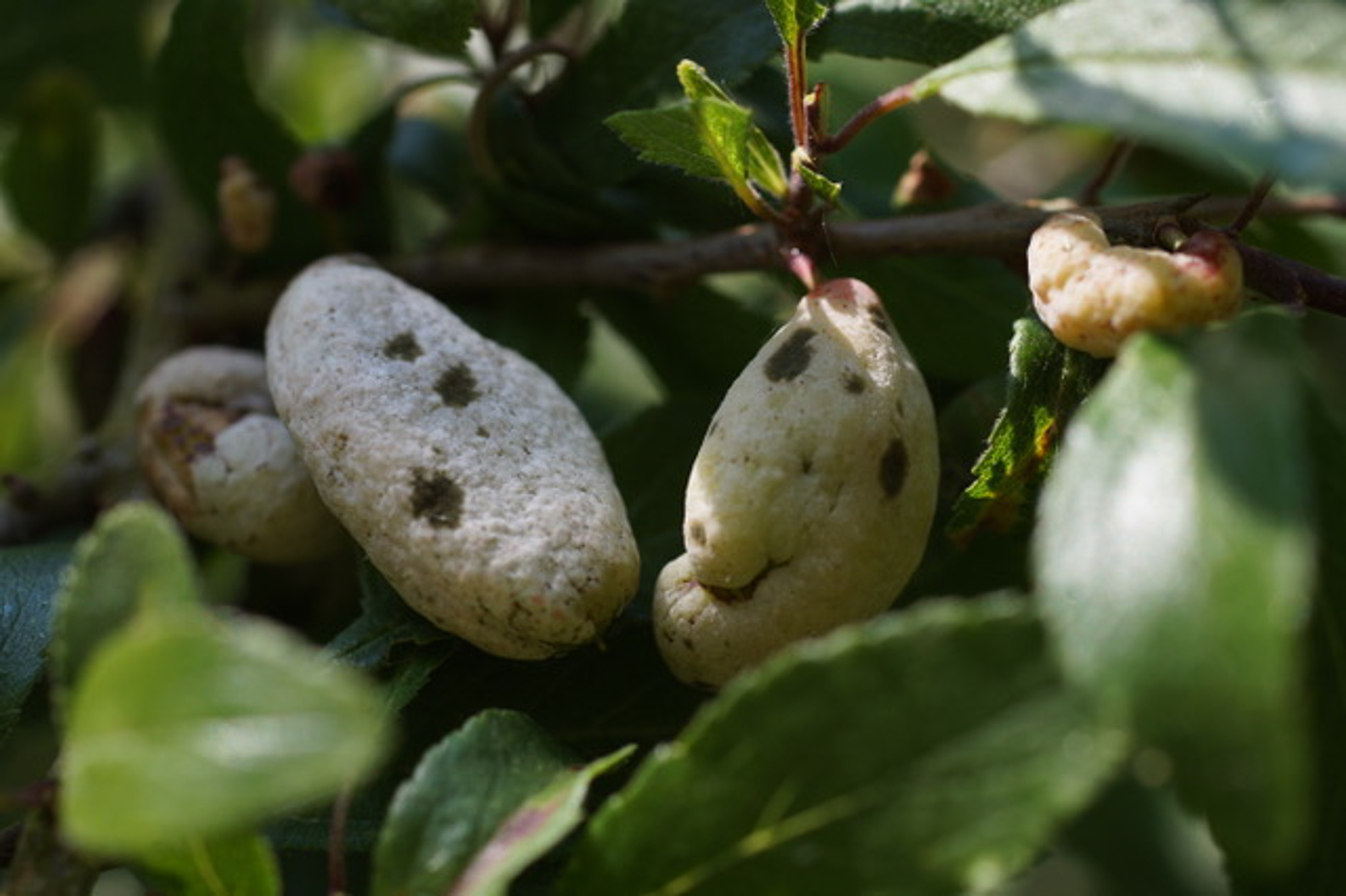
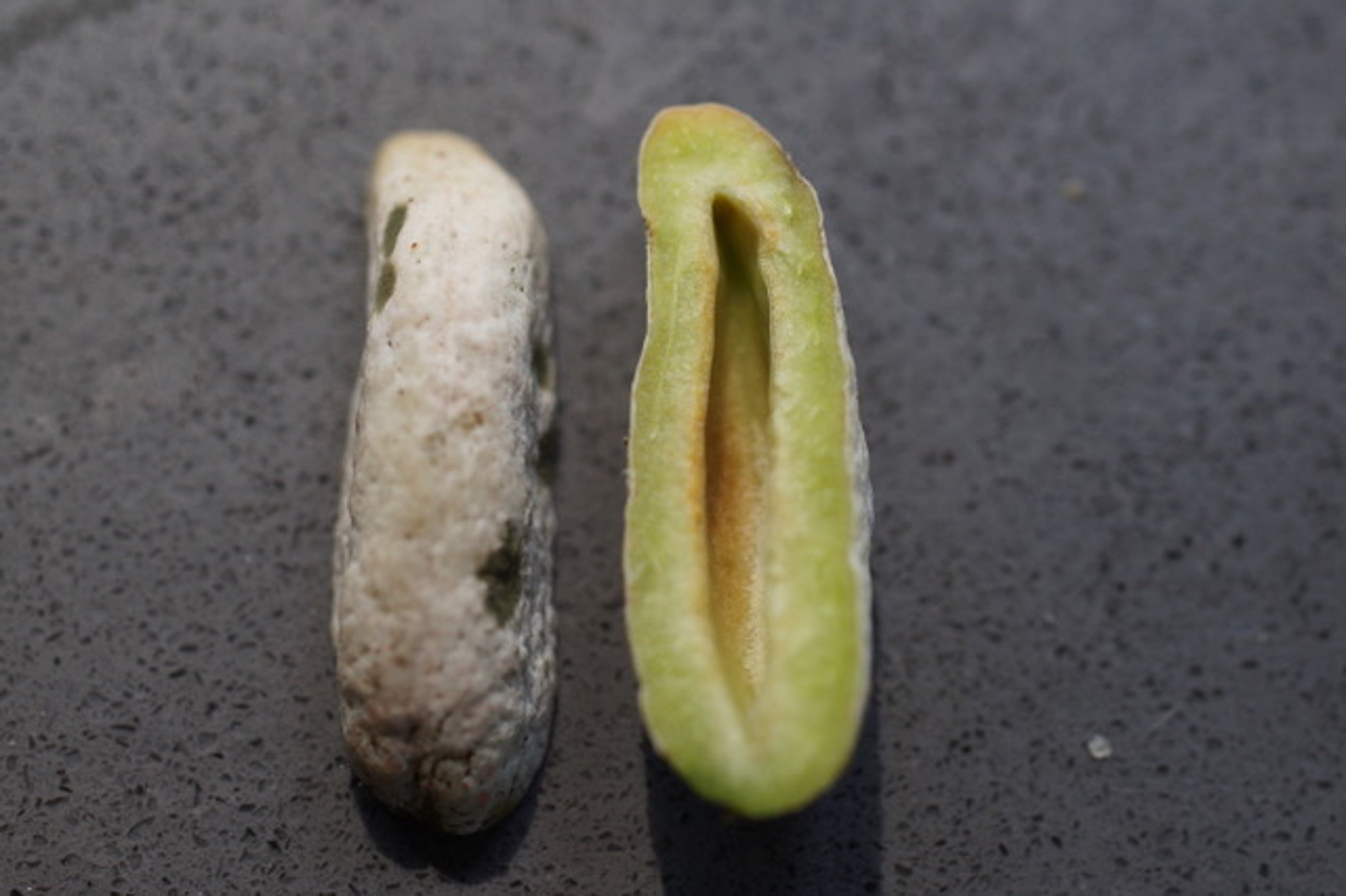
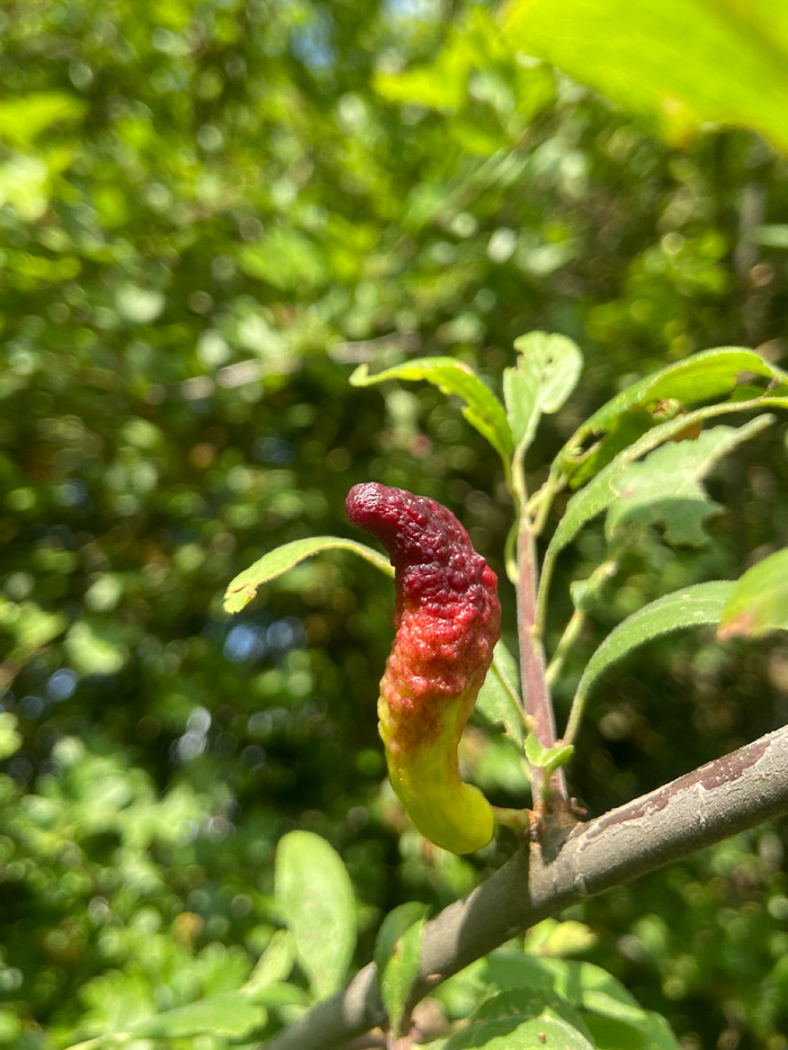 |
June 8th Taphrina pruni (Pocket Plum)
In Salden Wood Bob Simpson found what he at first thought were some insect galls forming on Blackthorn, but on checking in his gall book he realised that this was in fact not a gall but an Ascomycete which quite commonly affects various Prunus species, destroying the stone within the immature sloe thus leaving a hollow (seen in photo 3). The spores then infect the stem ready for next year's fruit. It is found in Spring to Summer and we have just one previous county record dating back to 1998. Photo 4 showing a slightly later stage of development was sent in by Sarah Ebdon two weeks later who reported the whole Blackthorn bush to be covered in infected berries. This is a new entry for Finds.
|
June 7th 2023
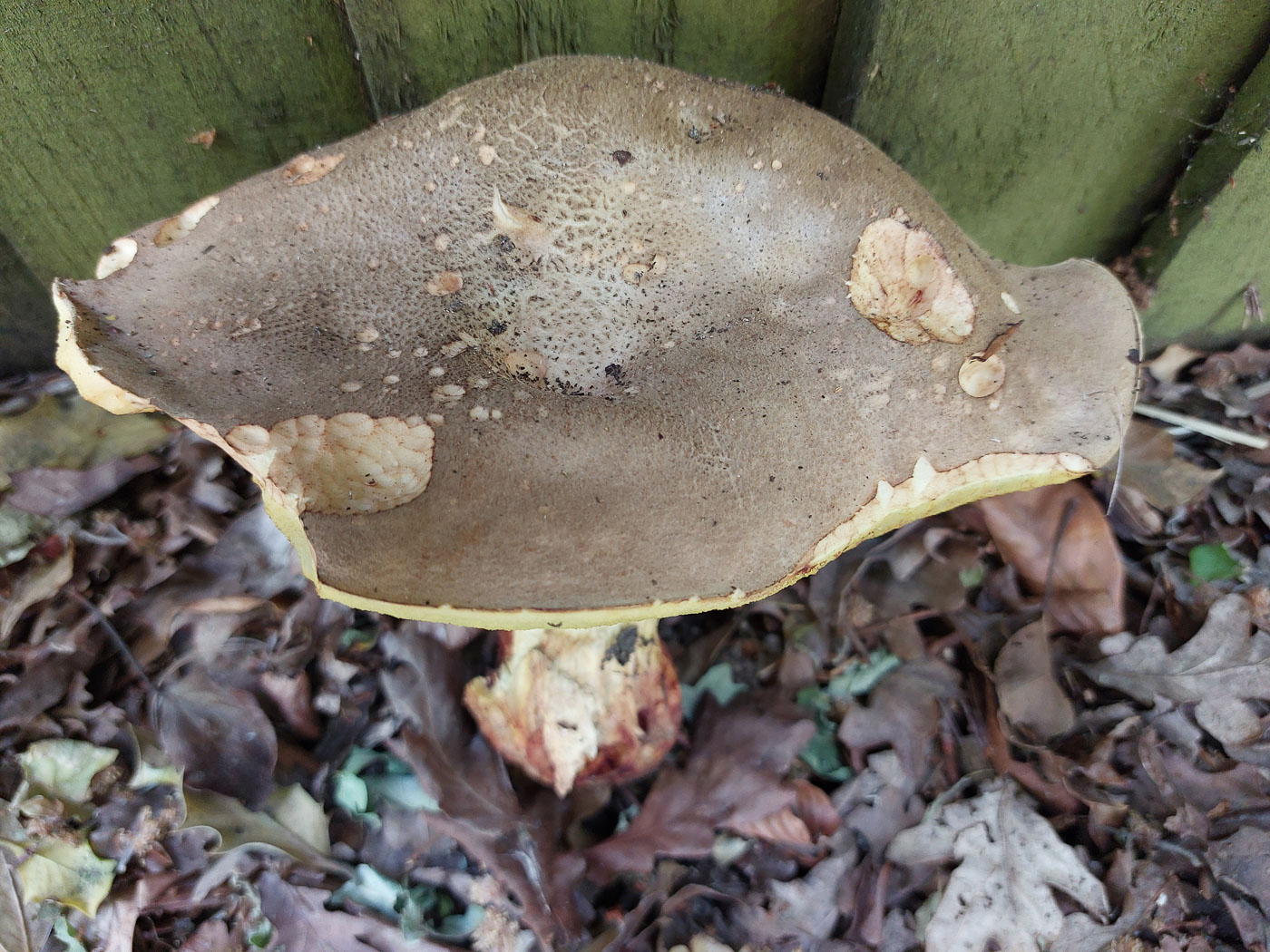
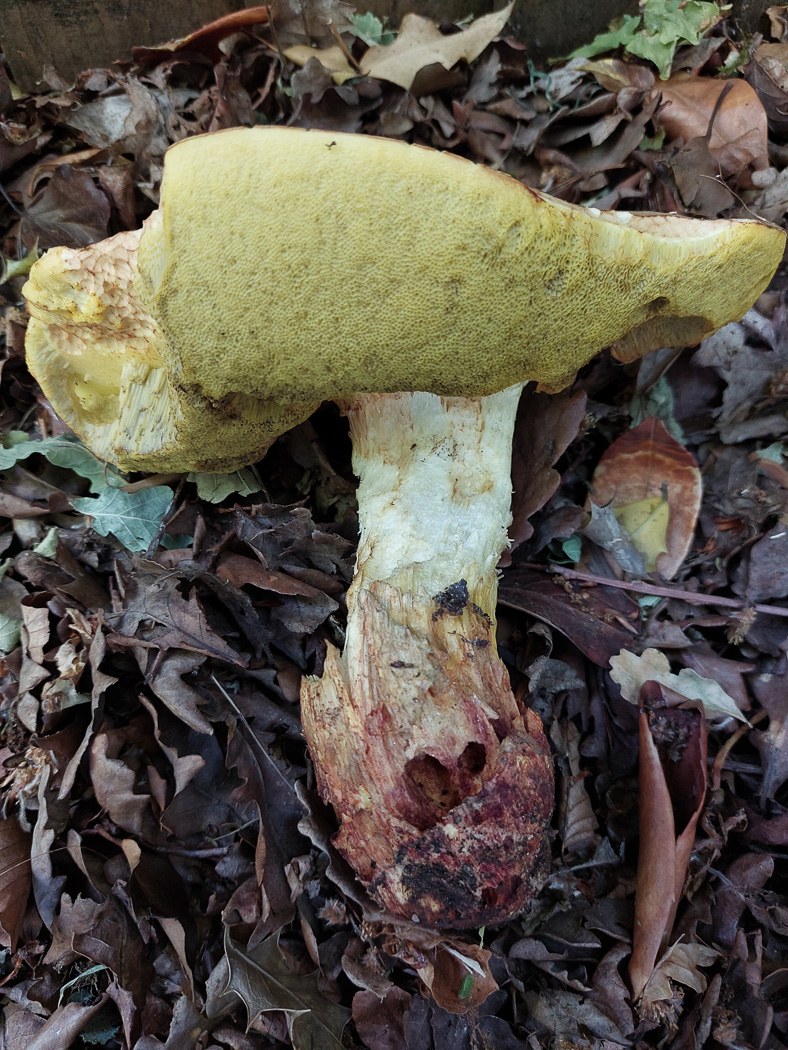
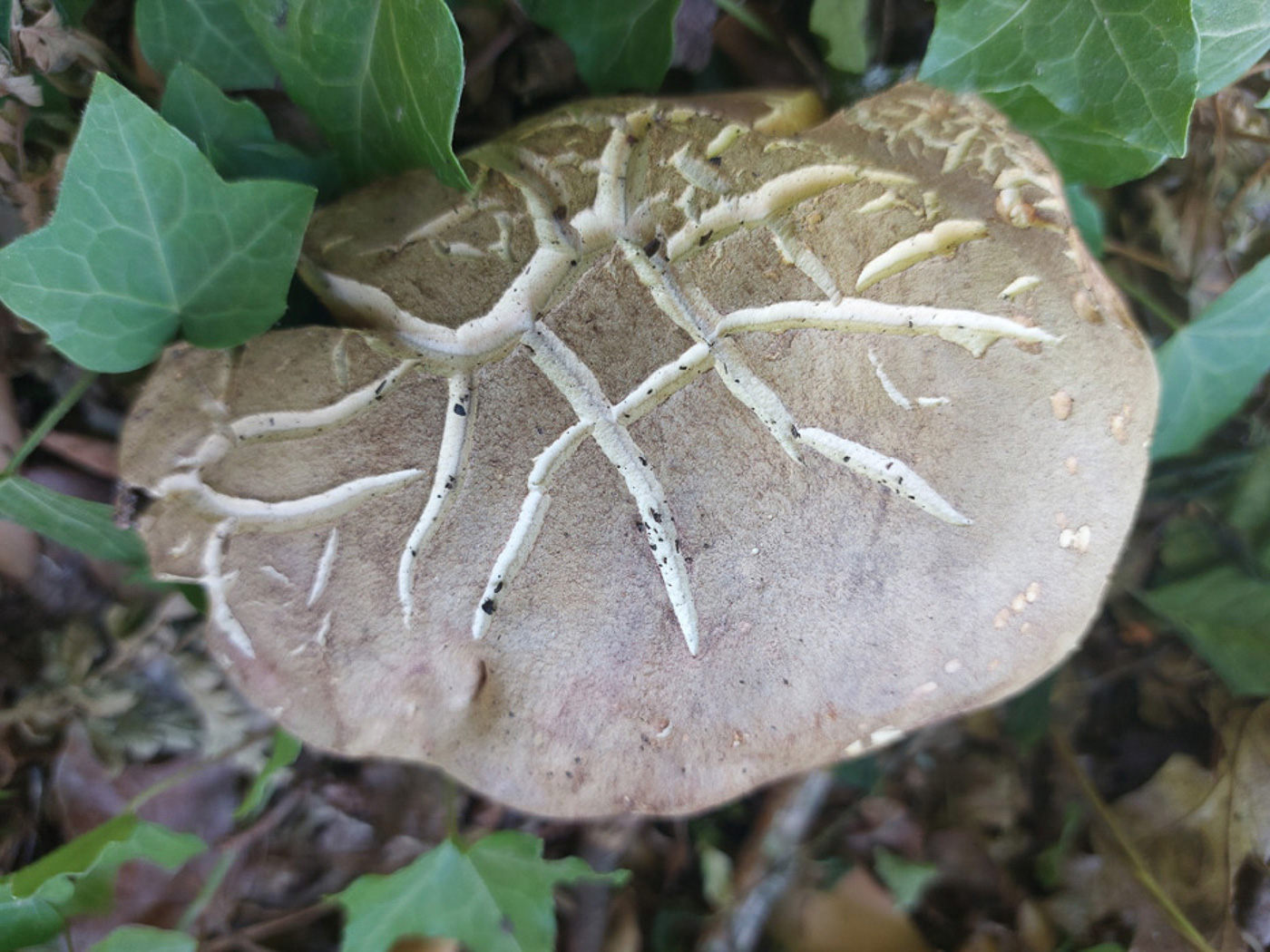
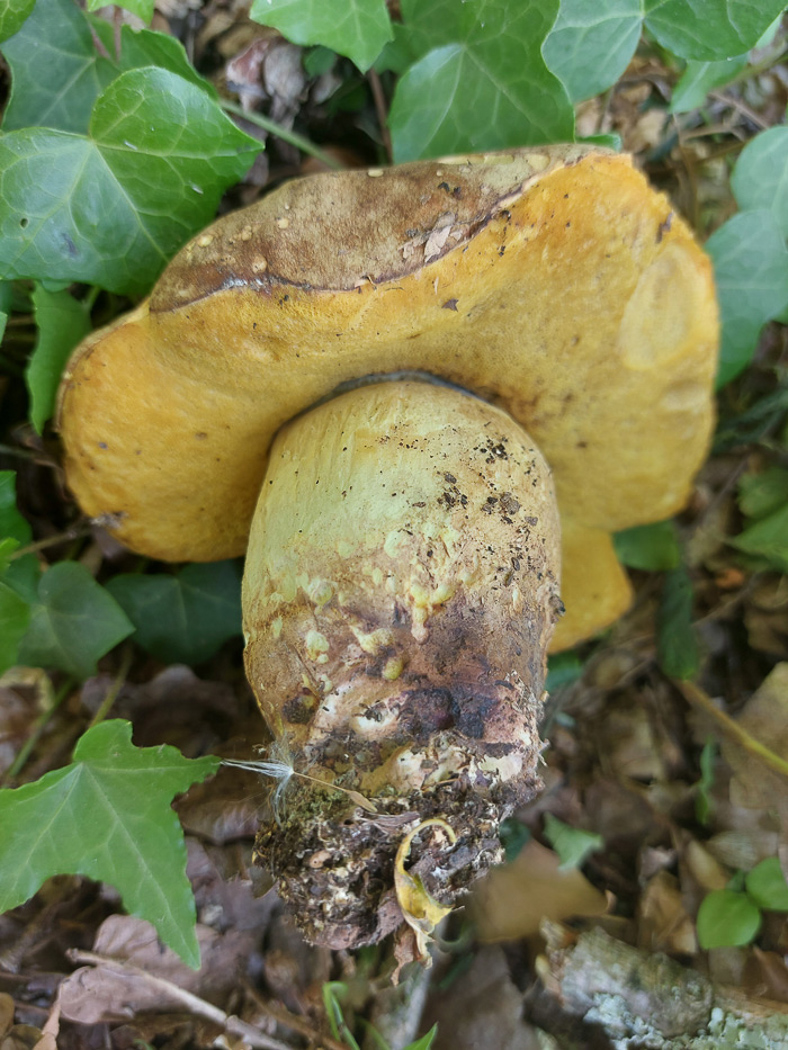 |
June 7th Hemileccinum impolitum (Iodine Bolete)
Under Oak in Gerrards Cross Jesper Launder found this 'whopper' (his description!) though badly nibbled - and no doubt much enjoyed - by slugs. This is a substantial Bolete with yellow pores which do not stain blue when pressed / damaged but its most distinctive feature is found at the rusty stem base which has a strong smell of iodine especially when cut. Today's specimen was apparently reeking of it on collection! Photos 3 and 4 were taken at the same spot three days later when a better specimen made an appearance - note the cracked cap presumably as a result of its exposed sunny position. (The species was moved from genus Boletus to the newly created Hemileccinum in recent years.) Boletes and Brittlegills (see also below) are both genera which tend to appear early in the season though June is considered pretty early. See the Masterlist for our three other examples.
|
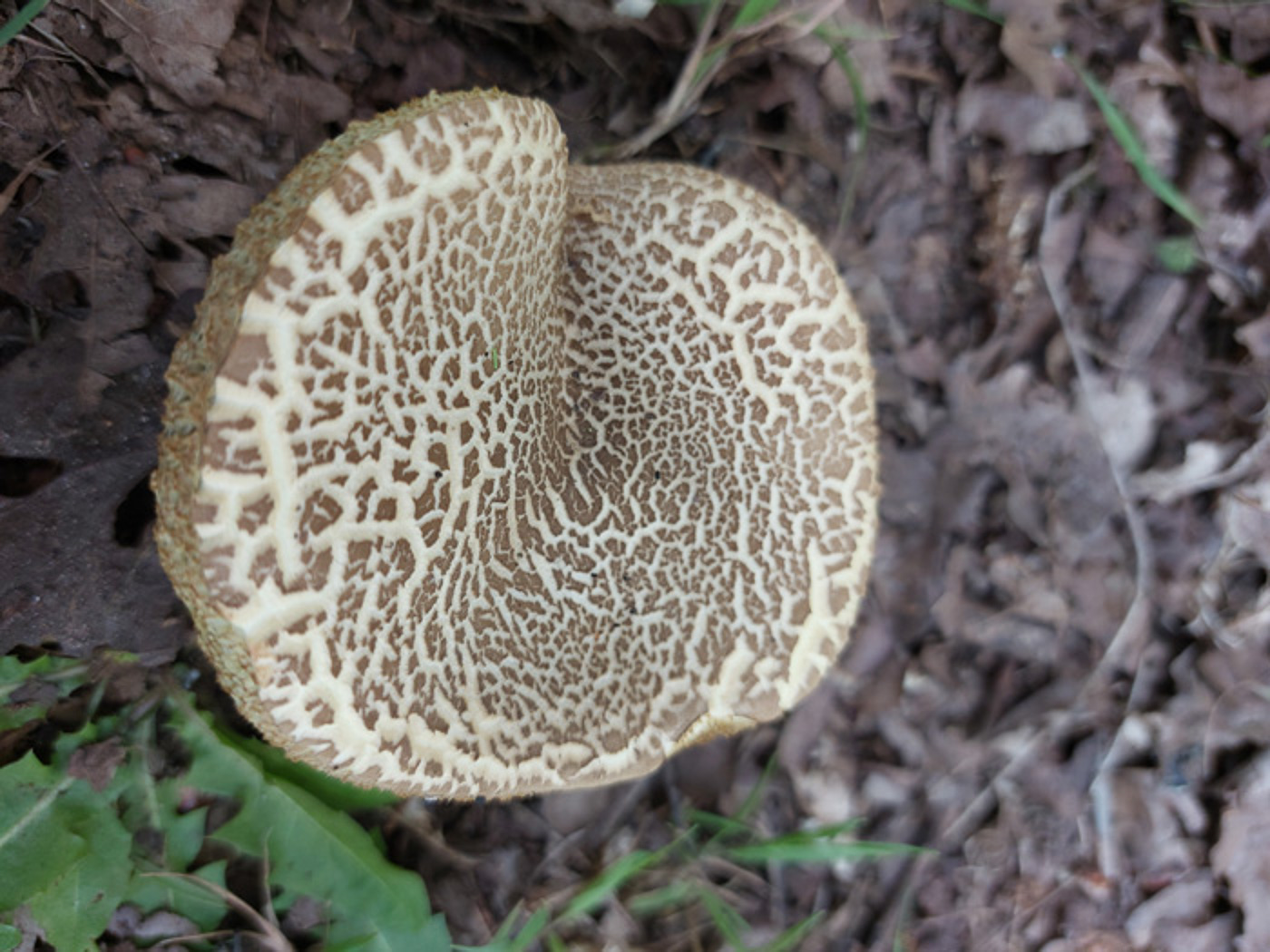
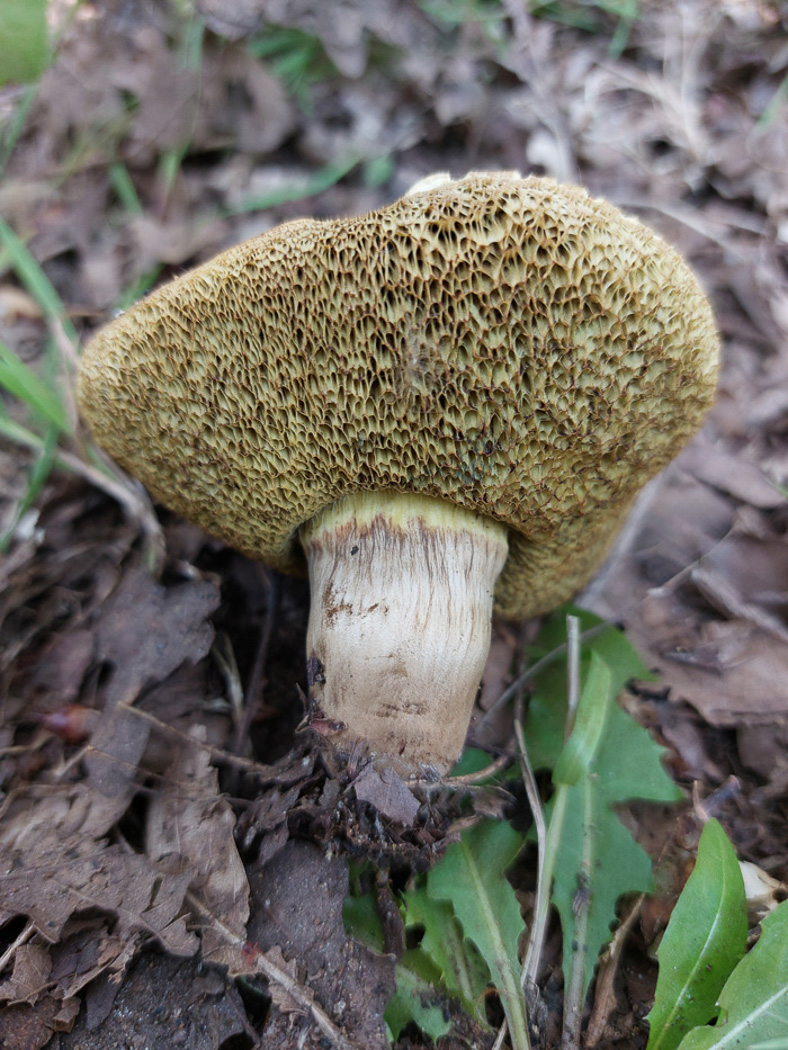 |
June 7th Xerocomellus porosporus (Sepia Bolete) 
On Gerrards Cross Common Jesper Launder found this common Bolete under Oak and recognised it from the typical yellow cracking cap and sepia stem having a red ring towards the apex with yellow above. He also later checked the spores, many if which have a 'truncate' end as if snipped off by scissors - a unique feature amongst the Boletes. Our life would be much easier if other similar species also had just one unique feature to help confirm their identity! See also in Finds 2022 September 15th.
|
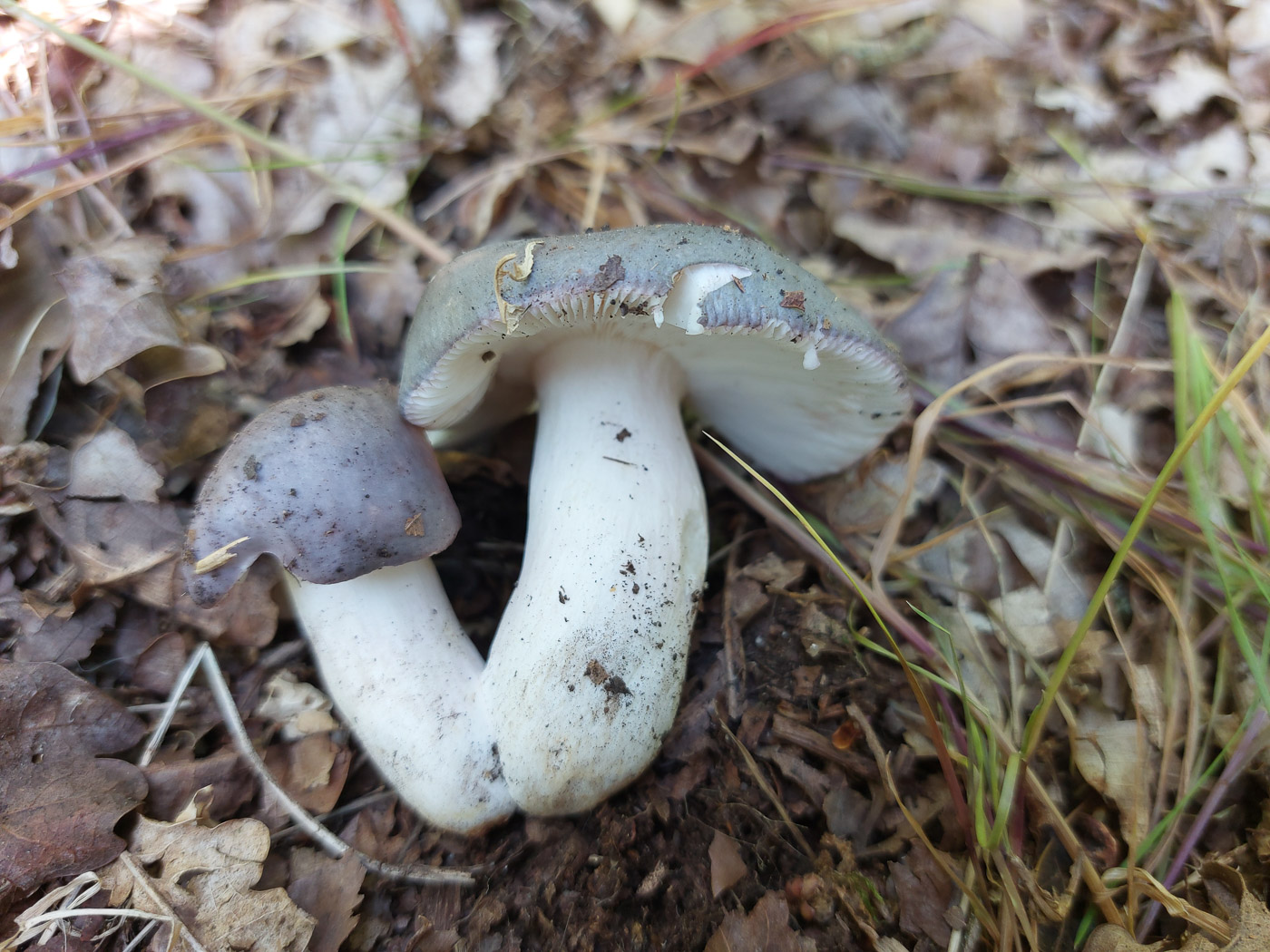
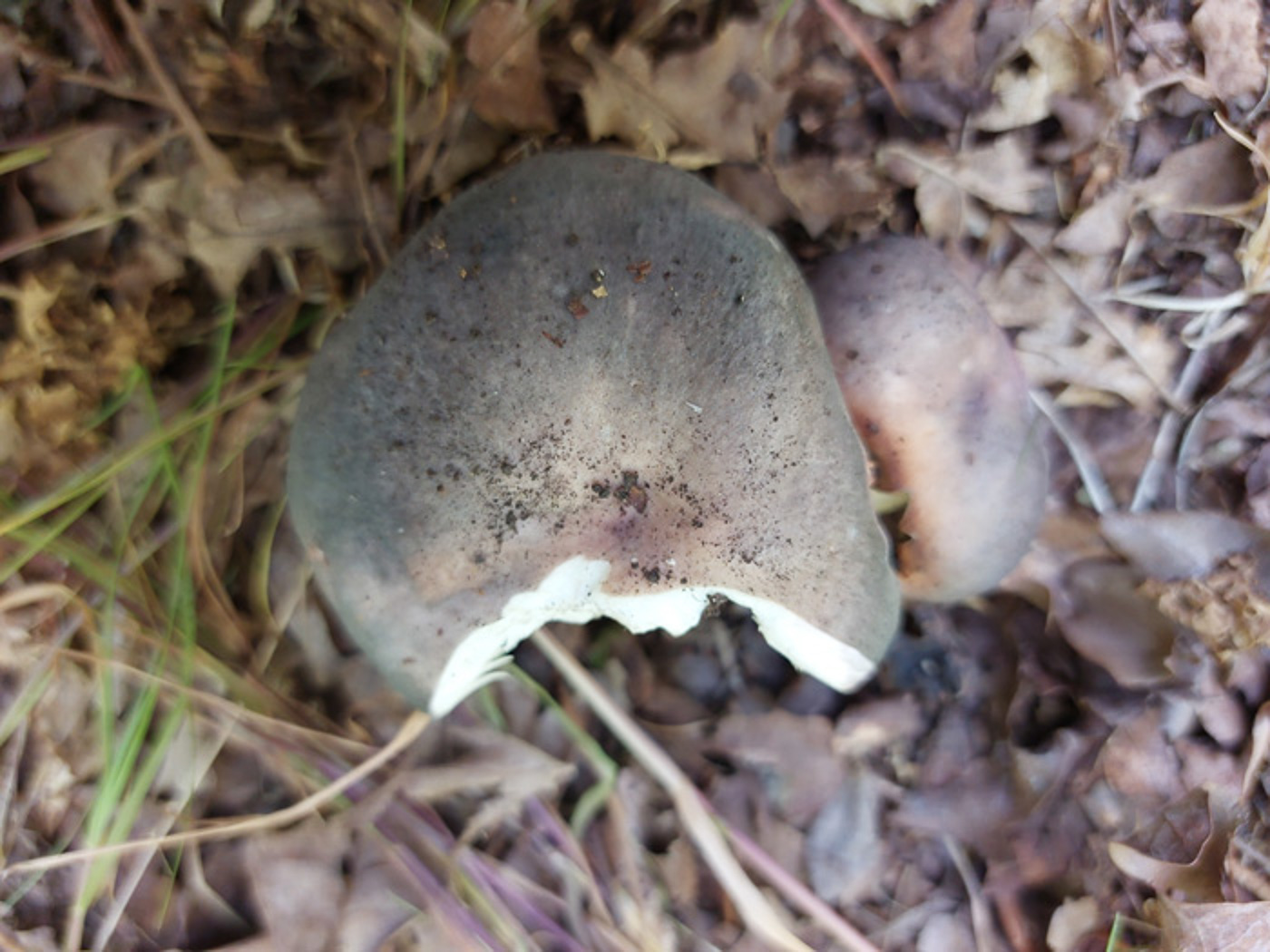 |
June 7th Russula grisea (False Charcoal Burner) 
On Gerrards Cross Common Jesper Launder found this Brittlegill under Oak though already knocked over. It was displaying the typical solid flesh and blue / green / violet tints of the species but he took it home to check. This is not the only Russula to sport these colours, R. cyanoxantha (Charcoal Burner), R. ionochlora (Oilslick Brittlegill) and even R. parazurea (Powdery Brittlegill) can be very similar, but its stem has the strongest pink rusty reaction when rubbed with an FE crystal and it has the firmest flesh also. The genus is often one of the earliest to start appearing in Summer / Autumn. See also in Finds 2020 September 16th.
|
May 31st 2023

 |
May 31st Ustilago striiformis (a species of Stripe Smut with no common name)
This is the second Smut Jesper species Jesper Launder found and recognised today in the grassy vegetation on Gerrards Cross Common though he was unable to specify the host plant as it was so affected by the fungus. See also on Finds 2021 June 6th.
|
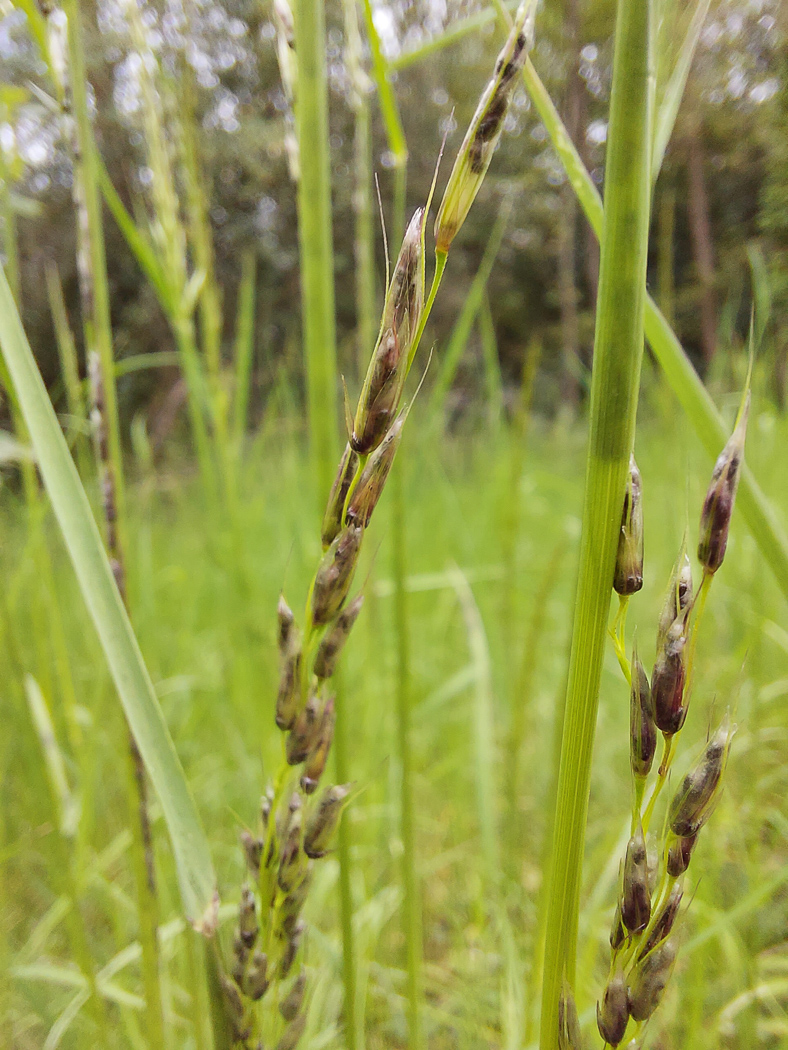
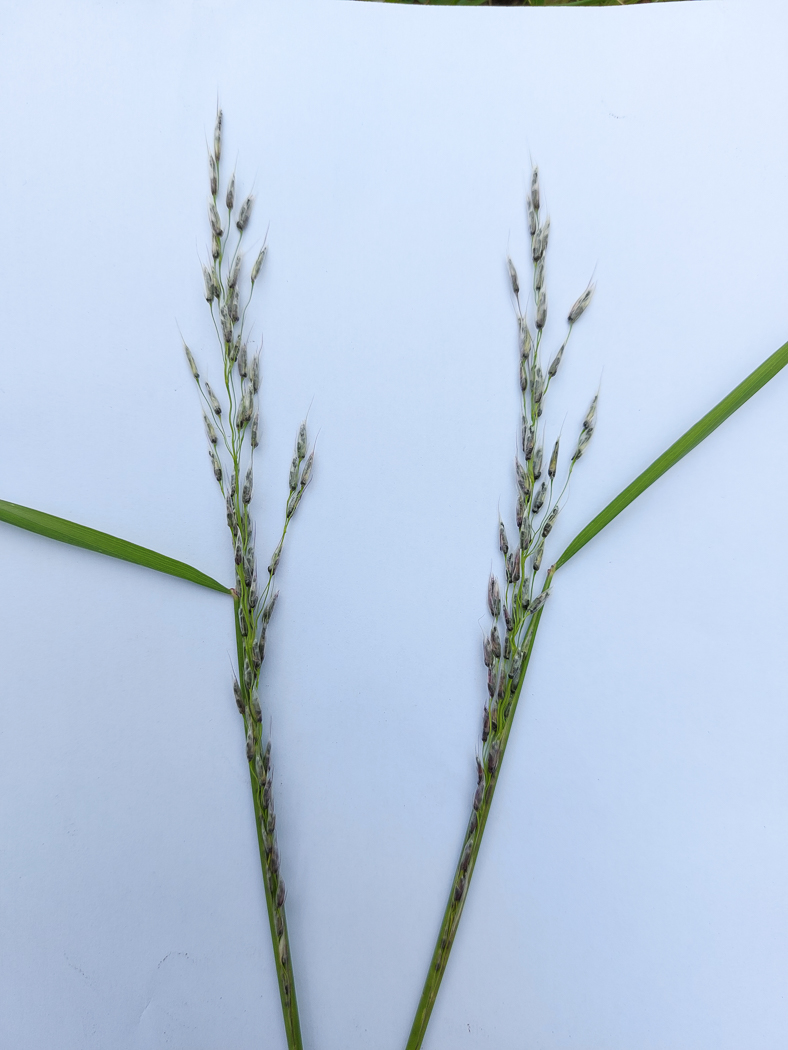 |
May 31st Ustilago avenae (False Oat Grass Smut)
On Gerrards Cross Common Jesper Launder was on the lookout for smuts on grassy vegetation and came across two species he recognised - both of which he found in June 2021 when they were new to the county though neither are at all rare, just easily overlooked. See his previous images on Finds 2021 June 28th as well.
|
May 26th 2023
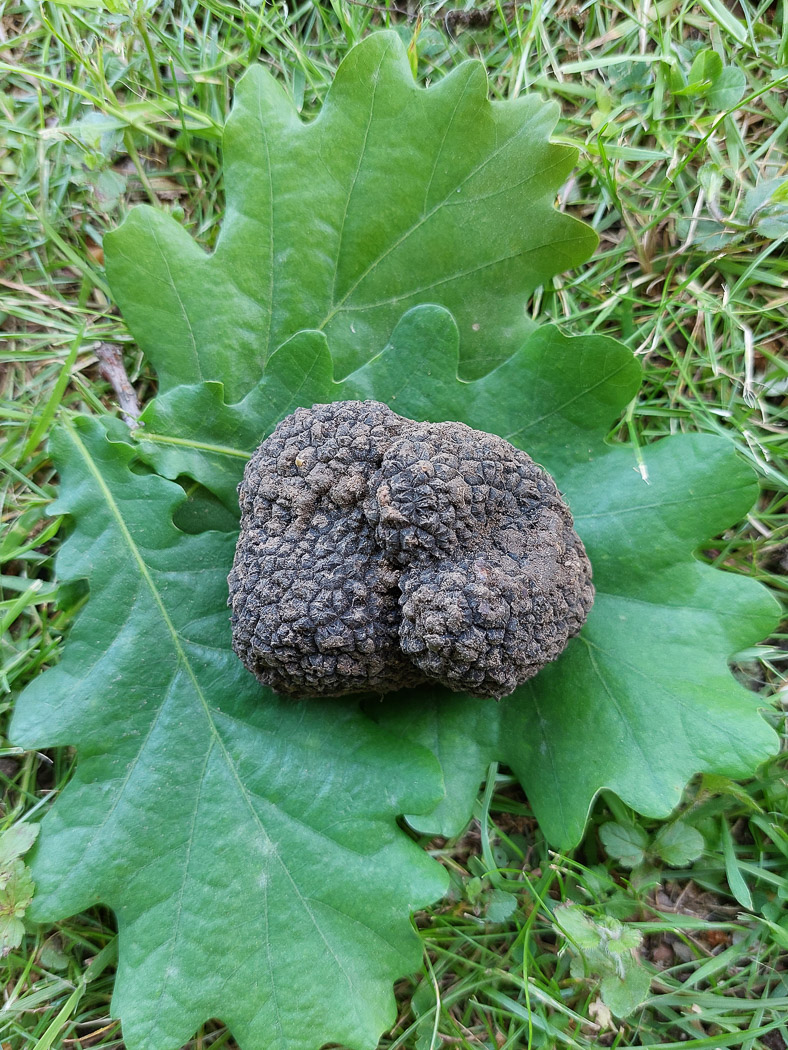
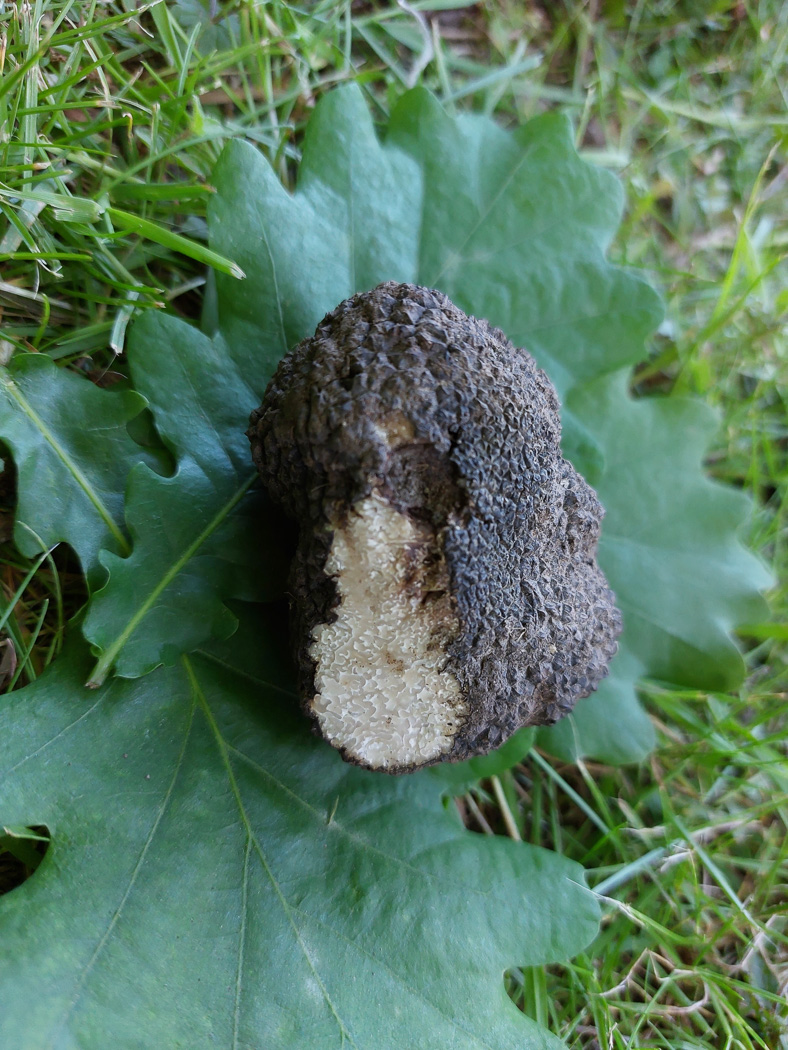
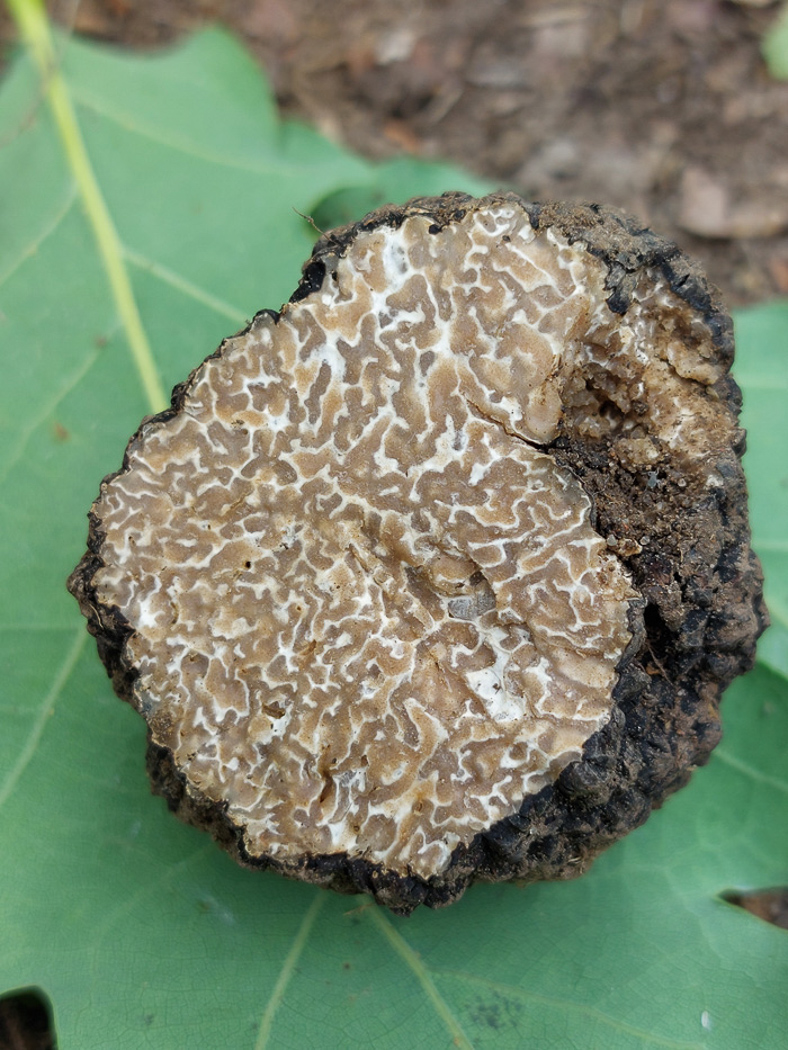 |
May 26th Tuber aestivum (Summer Truffle)
Under an Oak in Jordans where he has found this species before, Jesper Launder went looking as he's been finding several different Truffle species recently. Sure enough it was there though on the early side for it to be fruiting. The species is probably quite common, occurring in clayey calcareous soils under various deciduous trees, though goes unnoticed owing to its subterraneous habit. Its black strongly warty surface with pale marbled interior make it distinctive an easy to recognise, and when mature has a strong 'truffly' smell. Photo 2 is of another collection made by Jesper from Gerrards Cross on June 24th. We have three previous entries in Finds, the first two from the same Jordans spot as today's find: 2021 August 17th, 2022 June 24th and July 7th.
|
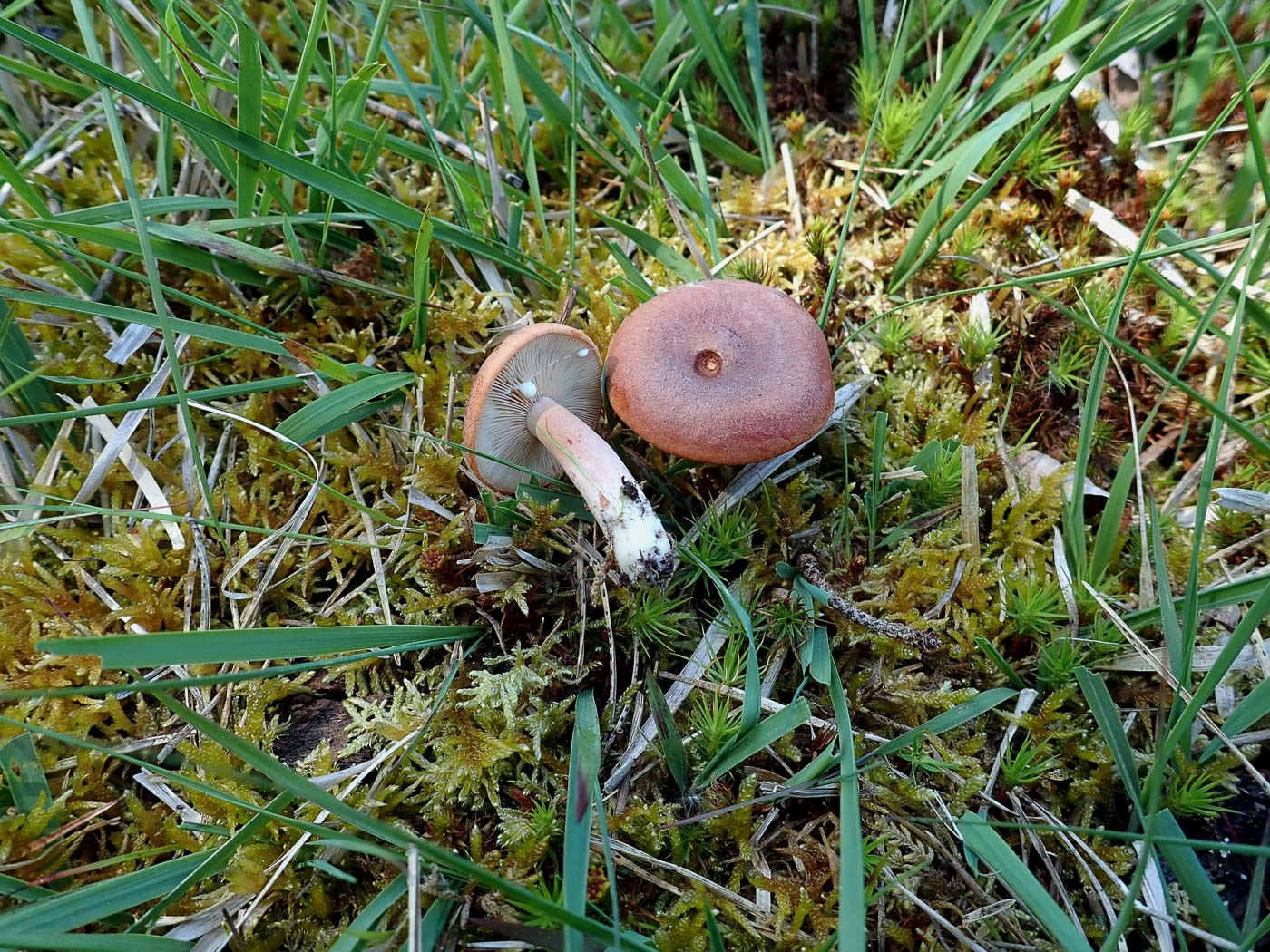 |
May 26th Lactarius quietus (Oak Bug Milkcap)
Whilst bird-watching at Stoke Common Penny was amazed to come across this pair fruiting alongside an old Oak stump. We have many county records of autumn fruiting, a few from August, just one or two from July but nothing earlier than that. Furthermore Milkcaps are not considered one of the early mycorrhizal genera and some years don't start appearing till October - hence Penny's surprise today. See also in Finds 2020 September 12th and 2022 November 29th.TEXT
|
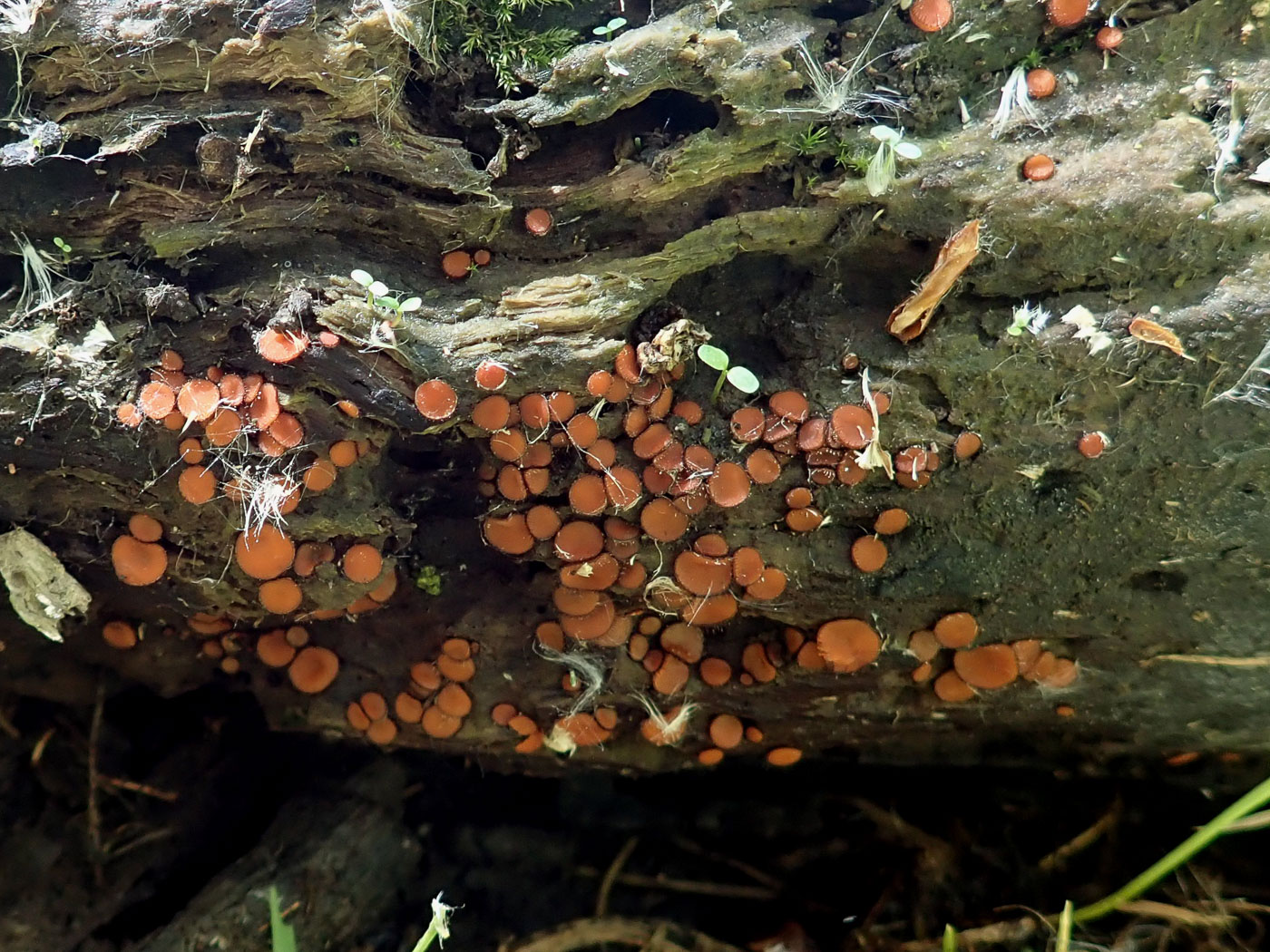 |
May 26th Scutellinia scutellata (Common Eyelash)
On a soggy deciduous log at Stoke Common Penny noticed this large colony of orange discs having very long 'eyelashes'. Despite a warm dry week this site was still underwater in places and clearly the log had previously been submerged making the perfect substrate for this damp loving species. Penny's camera skills are not up to good close-ups but see 2021 Jan 12th and, even better, June 9th for two of Barry's brilliant photos
|
May 23rd 2023
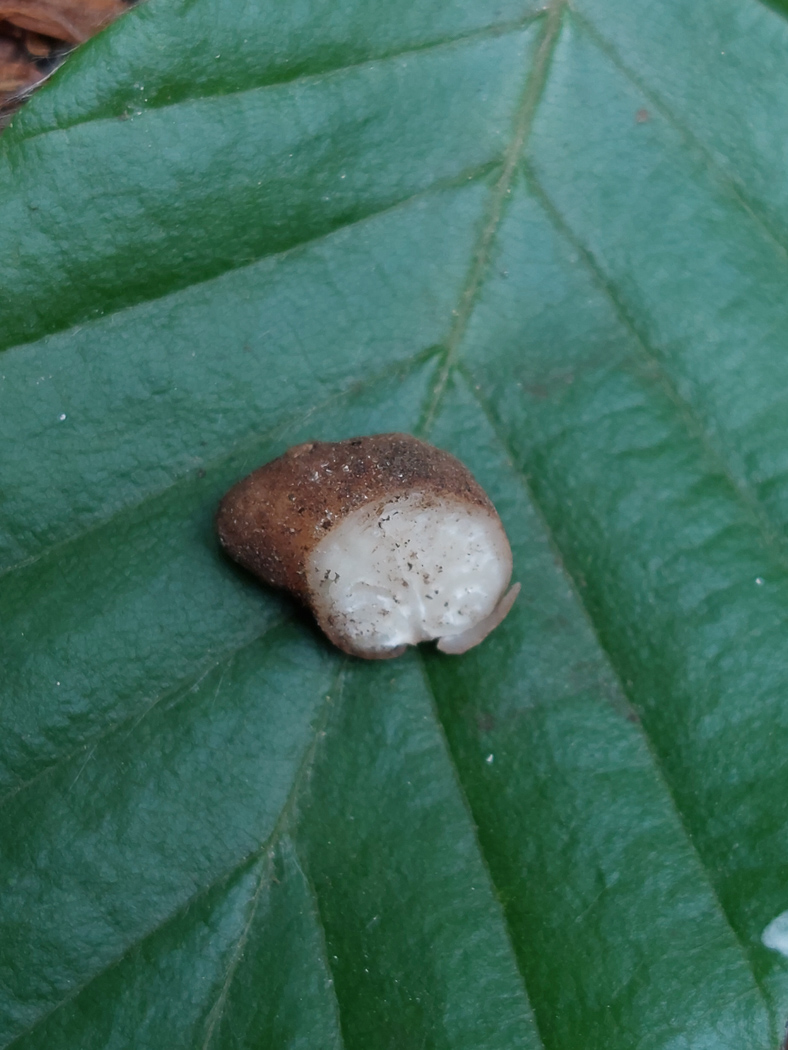
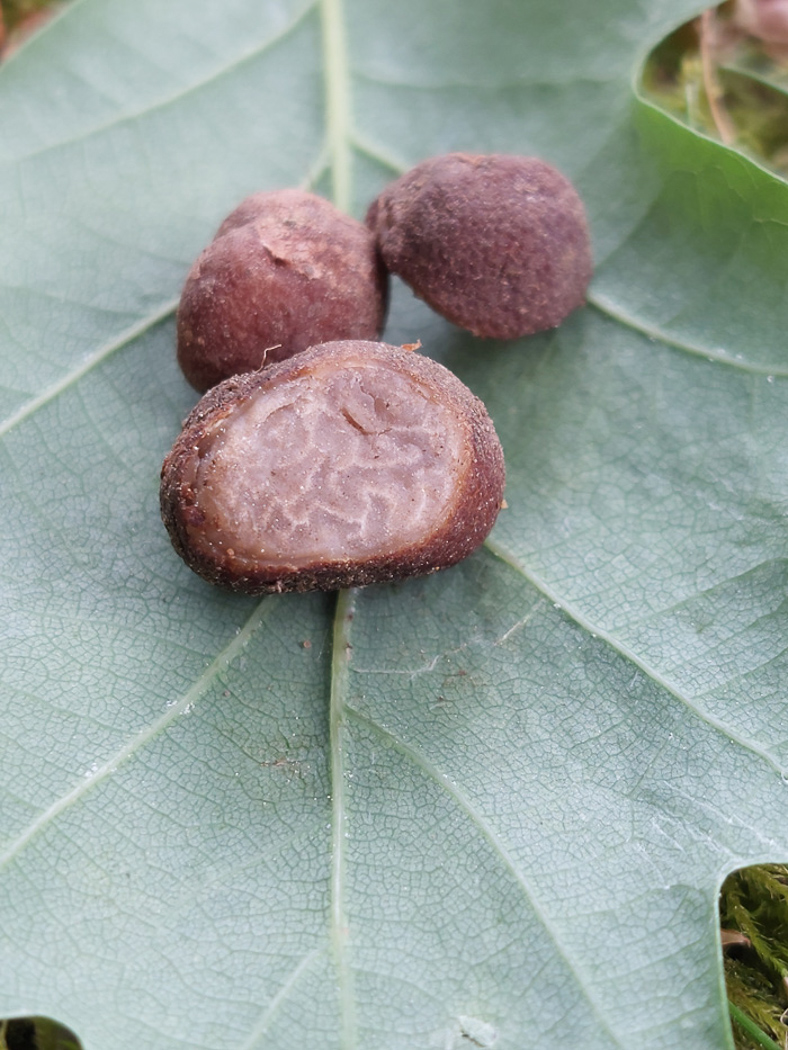 |
May 23rd Tuber rufum (an Ascomycete Truffle with no common name) 
In Jordans under a mature Beech hedge Jesper Launder dug about and came up with this rare Truffle - the only previous county record coming from Derek's Whitchurch garden (2011), found by Truffle specialist Carol Hobart when dog-sitting the Schafer's property! It is mycorrhizal with various deciduous trees, apparently favouring calcareous soils, therefore may be not that rare locally but goes undetected because of its habit of remaining just under the soil surface throughout life. Needless to say, this is a new entry for Finds. Photo 2 is of another collection made by Jesper from Gerrards Cross on June 24th
|
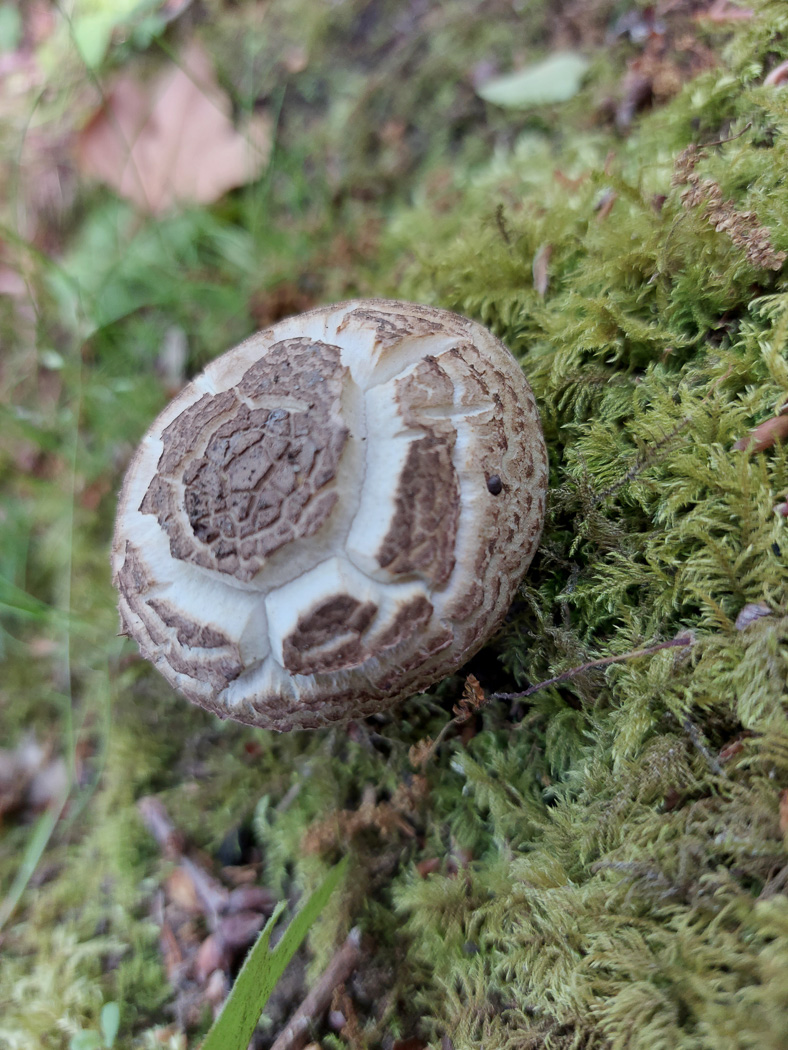
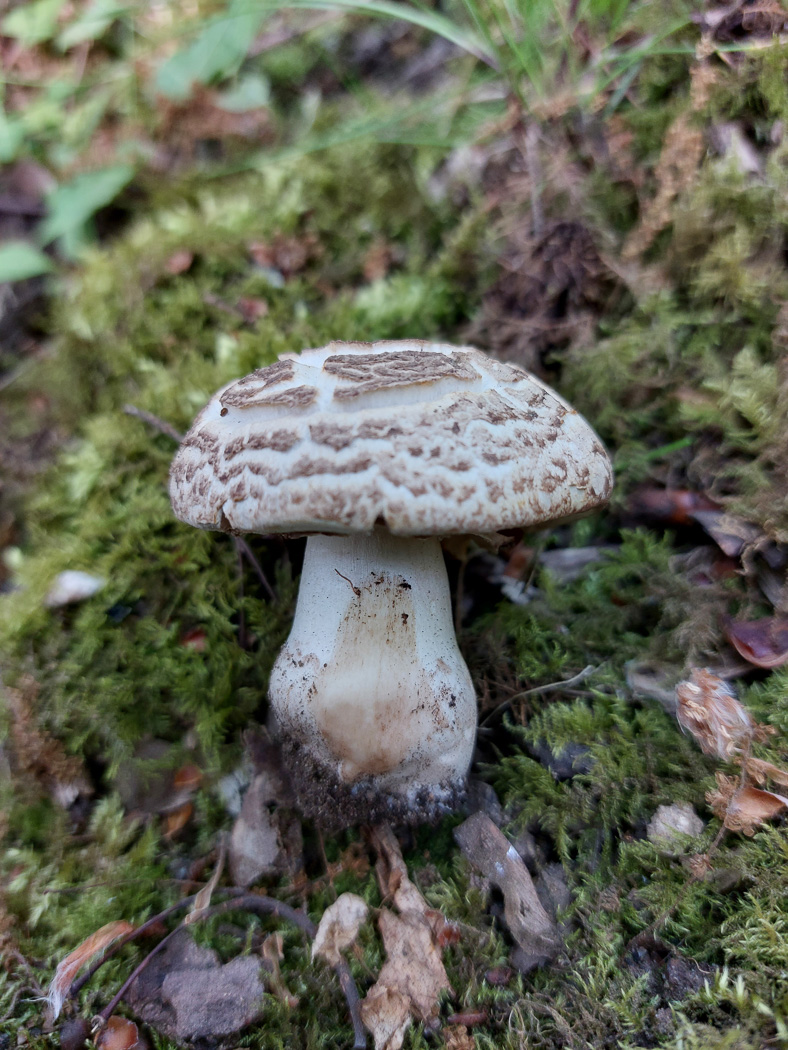 |
May 23rd Agaricus phaeolepidotus (a Mushroom with no common name)
In a mossy bank under Oak in Seer Green Jesper Launder found this quite unusual Agaricus - one that he is familiar with from this area though we have recorded it from only one other known Bucks site. Characters which are distinctive to separate it from others in a genus easy to recognise but often hard to name to species: a distinct smell of Phenol (ie of ink) rather than the sweet familiar 'mushroomy' smell of many in the genus, a cap with distinct darkish scales on a paler background and a flattish central disc, flesh which stains faintly orange-brown, finally a stem having a pendant ring (not visible here) and which is swollen at its base. See another example found by Jester in Finds 2021 July 2nd.
|
May 21st 2023
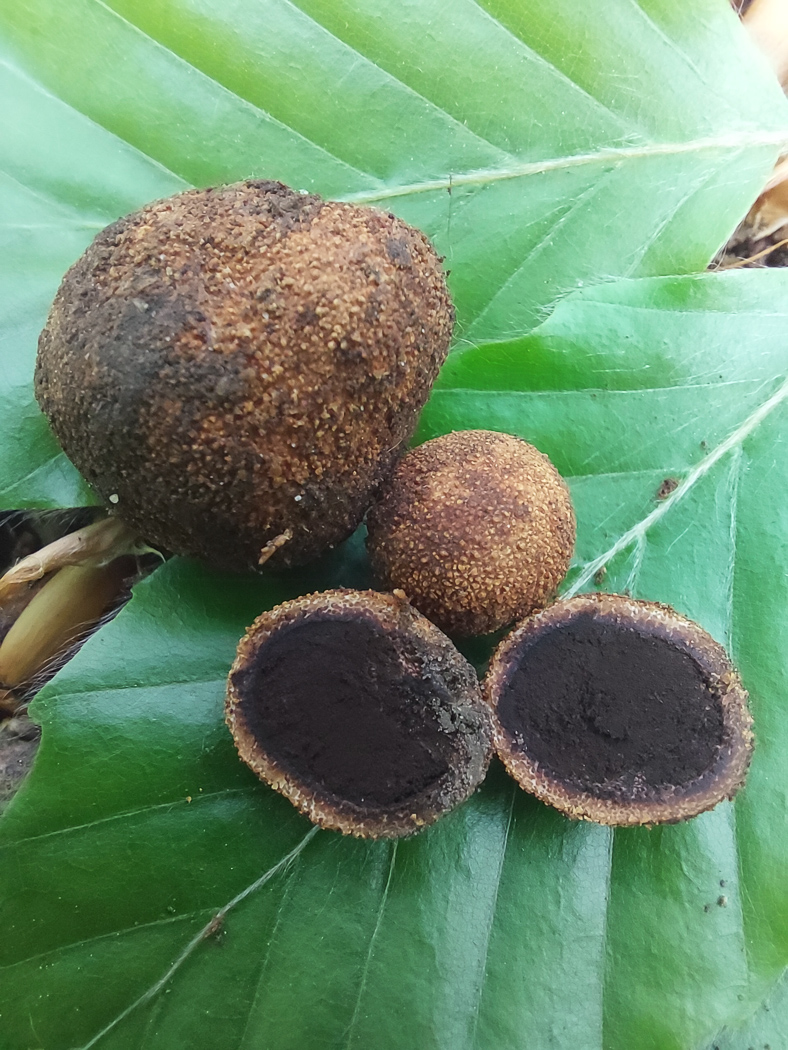
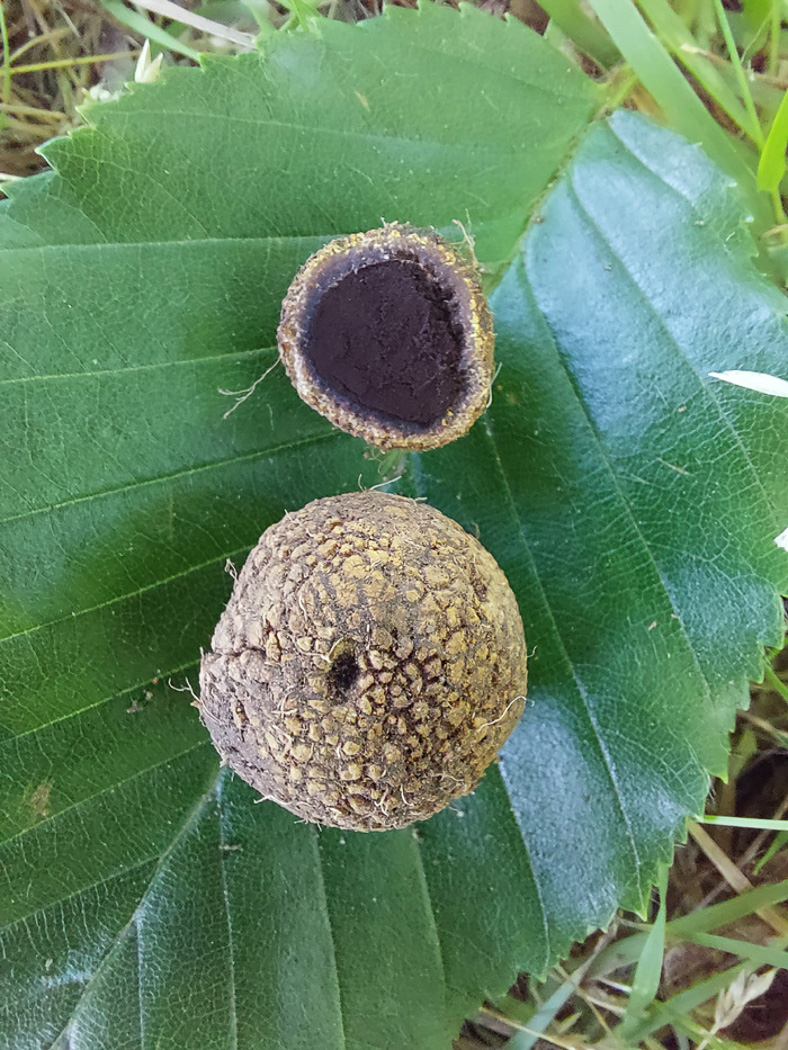 |
May 21st Elaphomyces muricatus (Marbled False Truffle) 
In Crutches Wood, Jordans, Jesper Launder went searching for truffles and was pleased to find several of these beauties - new to the county today. He described them as quite rough to the feel with raised warts and a marbled peridium (inner casing) compared to E. granulatus which he found also new to the county the previous day on our Stoke Common walk! (See Penny's report for images to compare.) Needless to say, this is a first for Finds. Photo 2 is of another collection made by Jesper from Stoke Poges Memorial Gardens on June 24th.
|
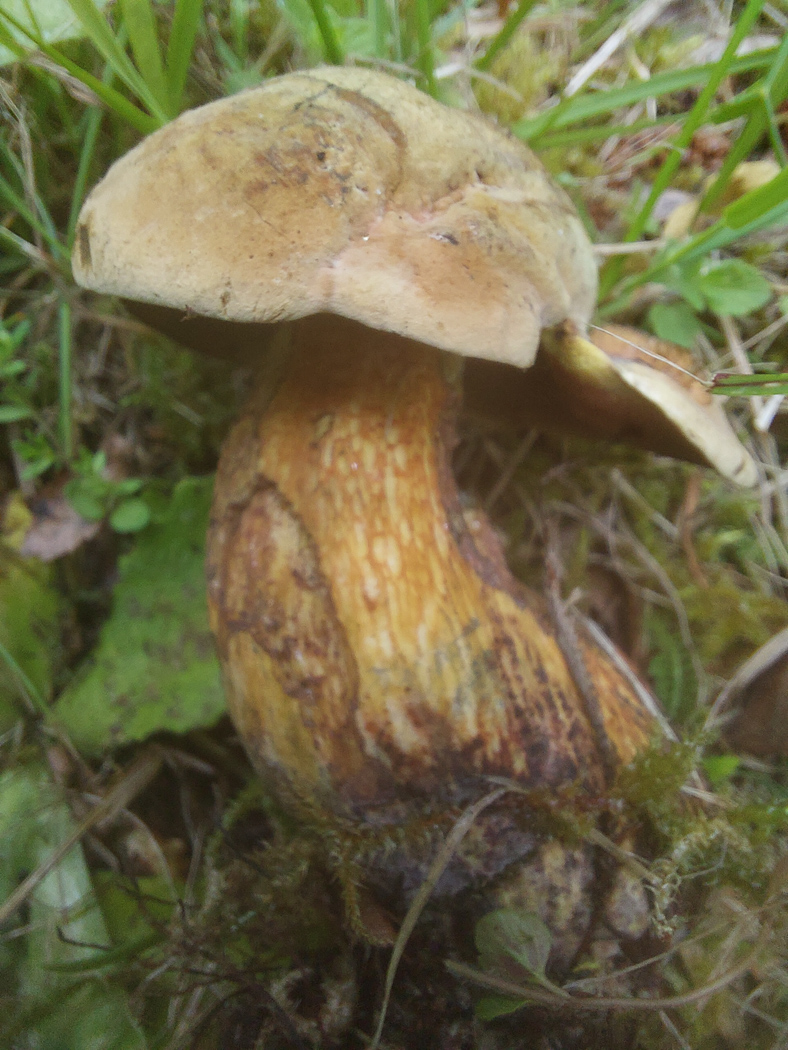
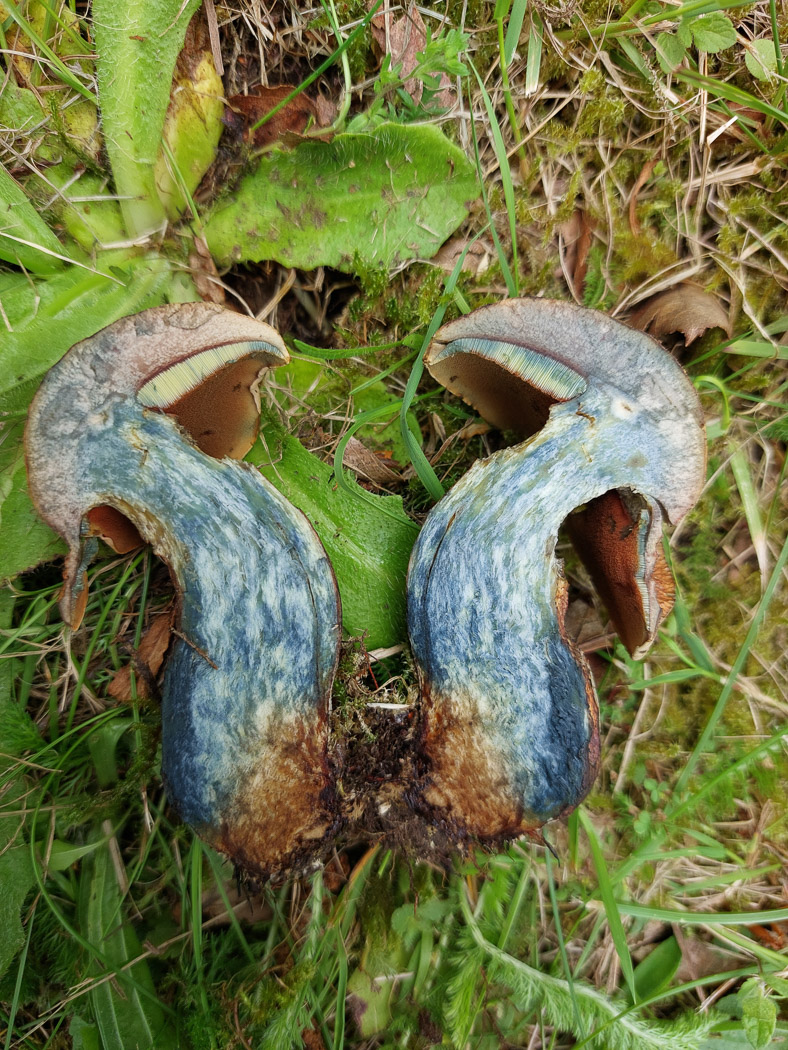 |
May 21st Suillellus luridus (Lurid Bolete)
In Seer Green under Birch and Willow Jesper Launder found this substantial Bolete, one with several revealing features including orange pores, a network on the stem and distinct blueing in the flesh when exposed to the air (photo 2). Previously in genus Boletus, it is not one of our commonest species though Boletes tend to fruit early in the season but not as early as this! See the Masterlist for other examples.
|
May 20th 2023
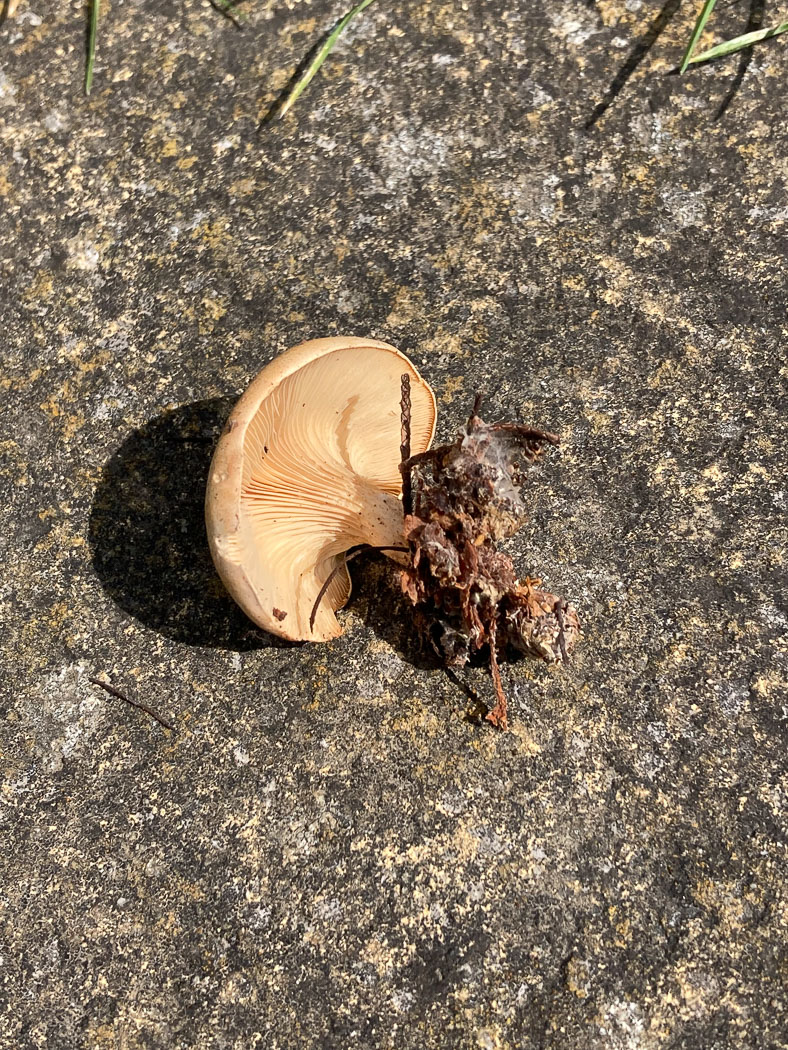
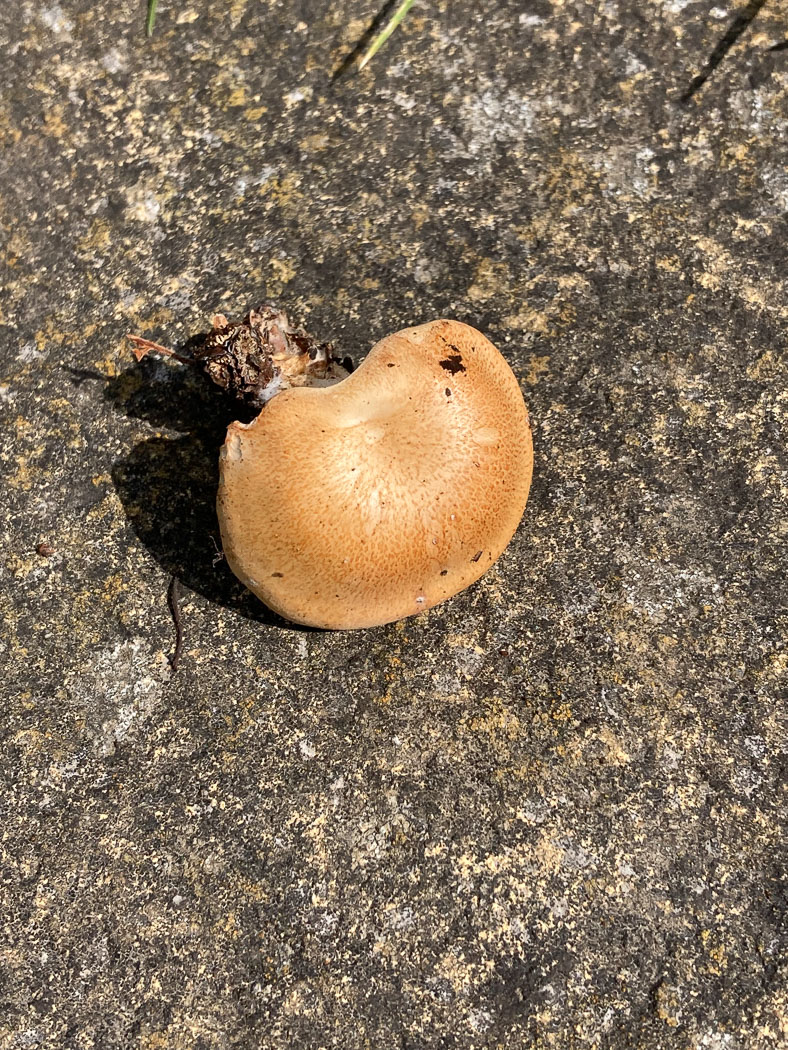 |
May 20th Paralepista flaccida (Tawny Funnel) 
Amongst some old leaf mould in his Bourne End garden Richard Donnelly found this singleton and worked out it was possibly this species but was unsure. On receiving his photos Penny was also unsure for several reasons, it being not only a somewhat unseasonal find but also on its own rather than clustered as usual, rather pale and the cap not as smooth as usual. It was difficult to think what else it might be, however! Checking the spores would at least help: the species was originally moved from genus Clitocybe to Lepista on account of its ornamented spores - Clitocybe species have smooth spores - then recently into Paralepista - ie similar to but different from Lepista. The spores of the dried sample she then received from Richard did indeed match those of Tawny Funnel, hence its inclusion here. September is the earliest month we've previously recorded this common though often late autumn species, proving yet again what a remarkable spring 2023 is proving for the unseasonal fruiting of fungi. See the Masterlist for more examples.
|
May 19th 2023
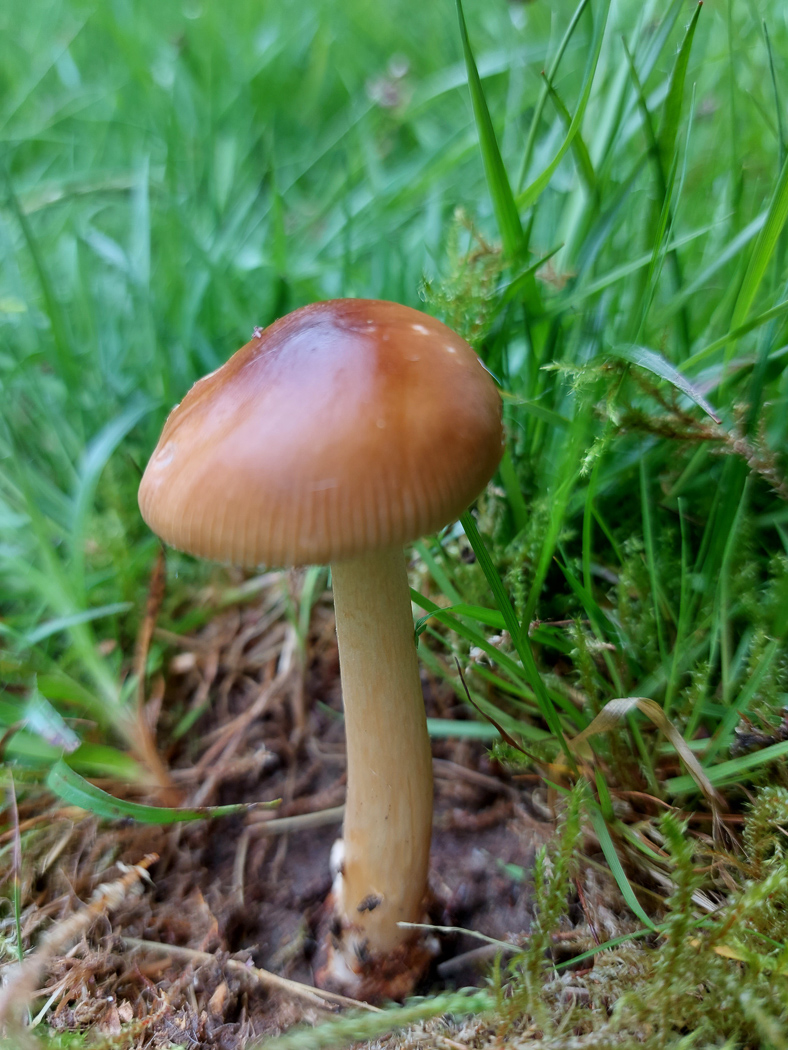 |
May 19th Amanita fulva (Tawny Grisette)
At Stoke Poges Memorial Gardens Jesper Launder and Sarah Ebdon found several early fruiting mushrooms of which this Amanita was one. It often occurs under Birch as it was here and is very common in late summer / early autumn but this is our earliest record by some weeks. See the Masterlist for other examples.
|
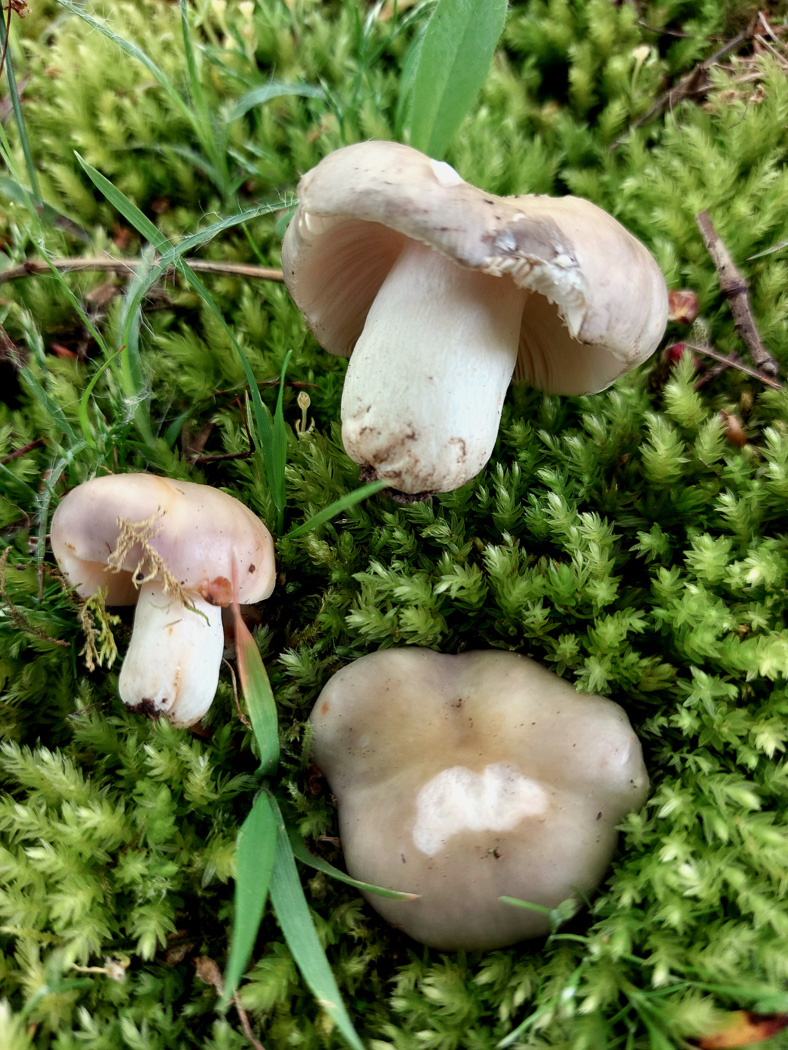 |
May 19th Russula ionochlora (Oilslick Brittlegill)
At Stoke Poges Memorial Gardens Jesper Launder and Sarah Ebdon found several early fruiting mushrooms of which this Brittlegill was one. To be 100% positive of the ID Penny would have liked to see the rusty orange reaction on the stem when rubbed with a crystal of iron salts as there are several very similar Brittlegills which display the same range of cap colours (a mix of pink, violet, green tones), but Jesper is a very experienced mycologist and was confident on this one.Though this is a common species, it seems to be a new entry for Finds. (The photo is Jesper's.)
|
May 17th 2023
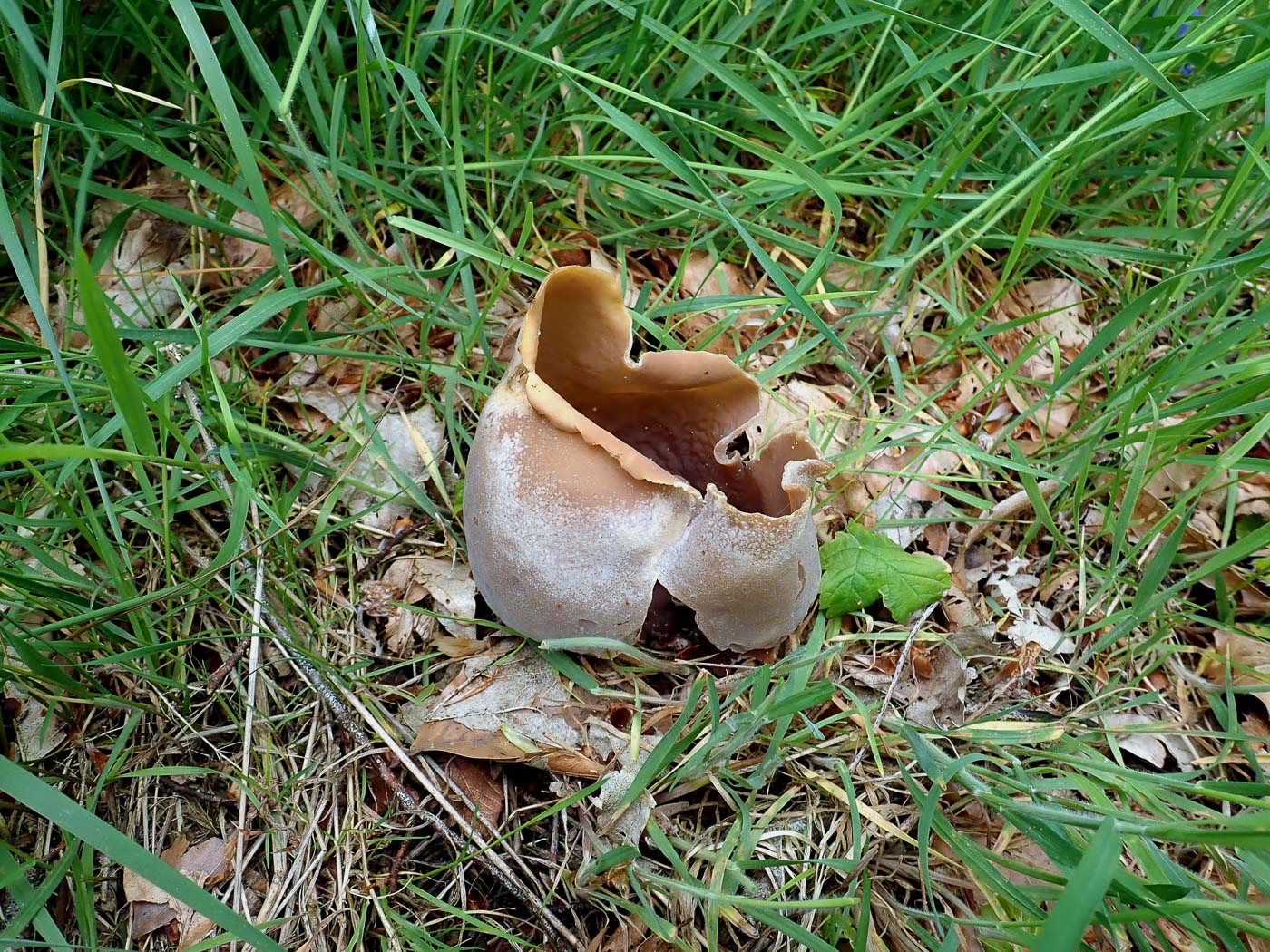
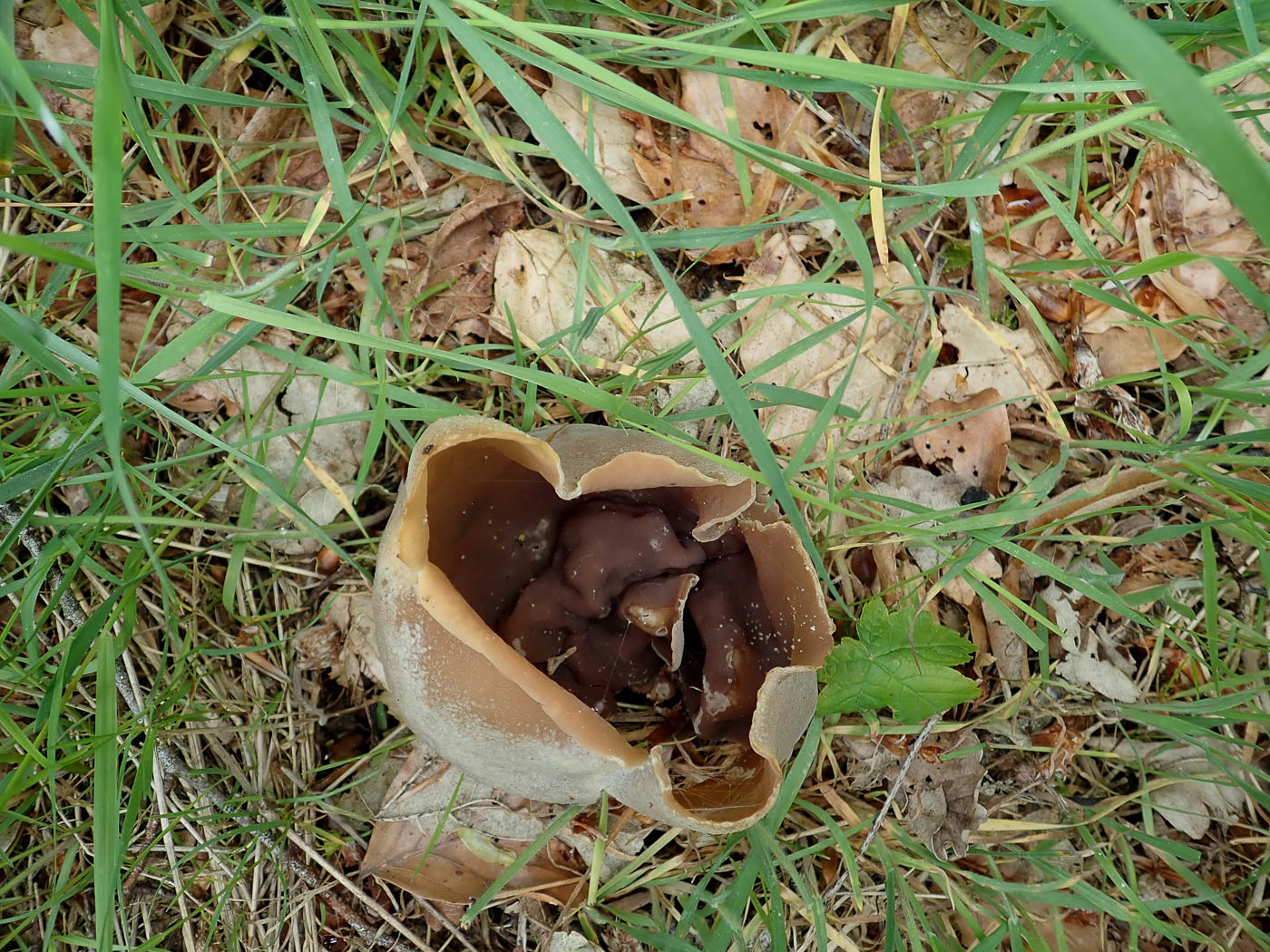
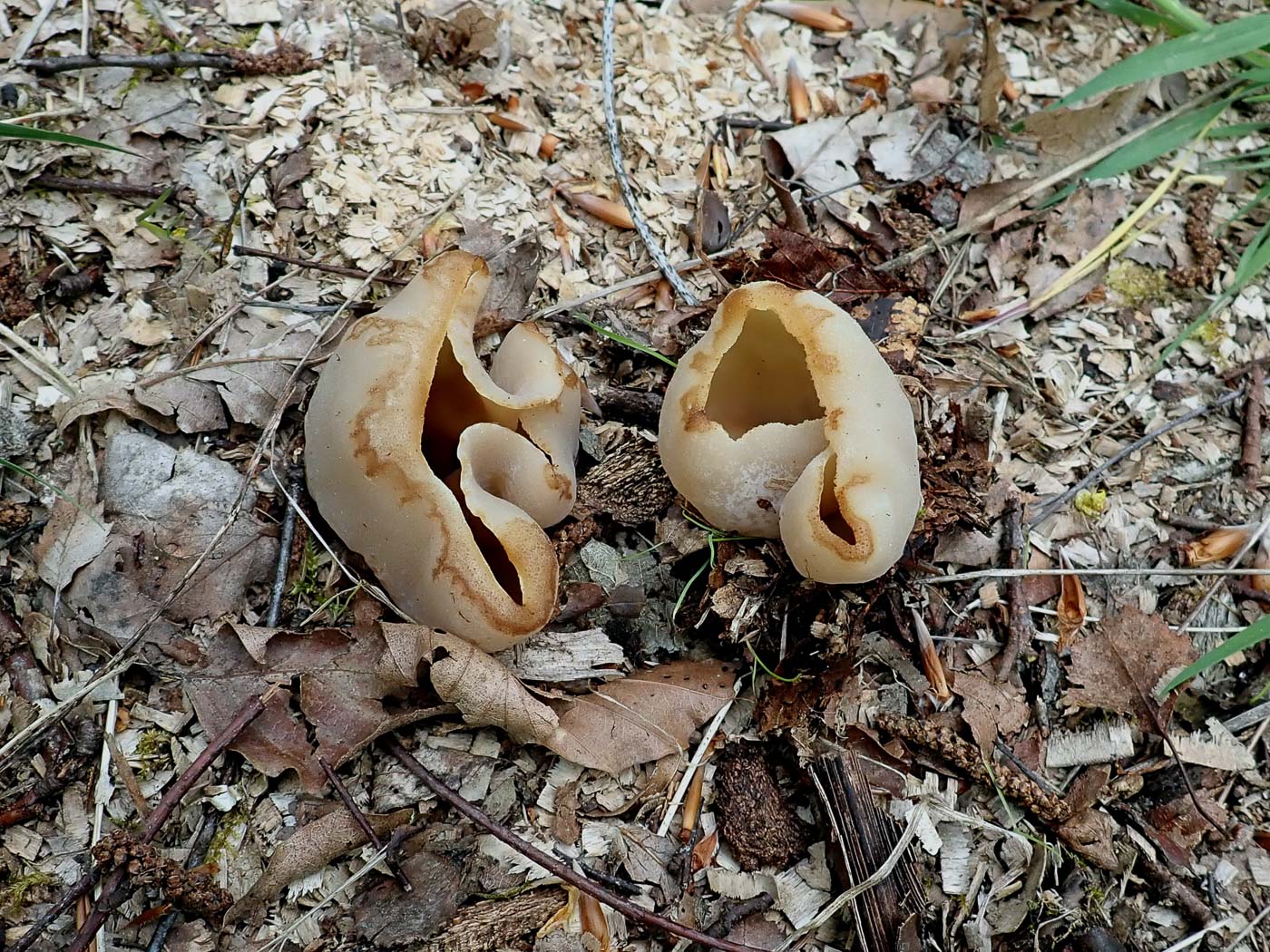
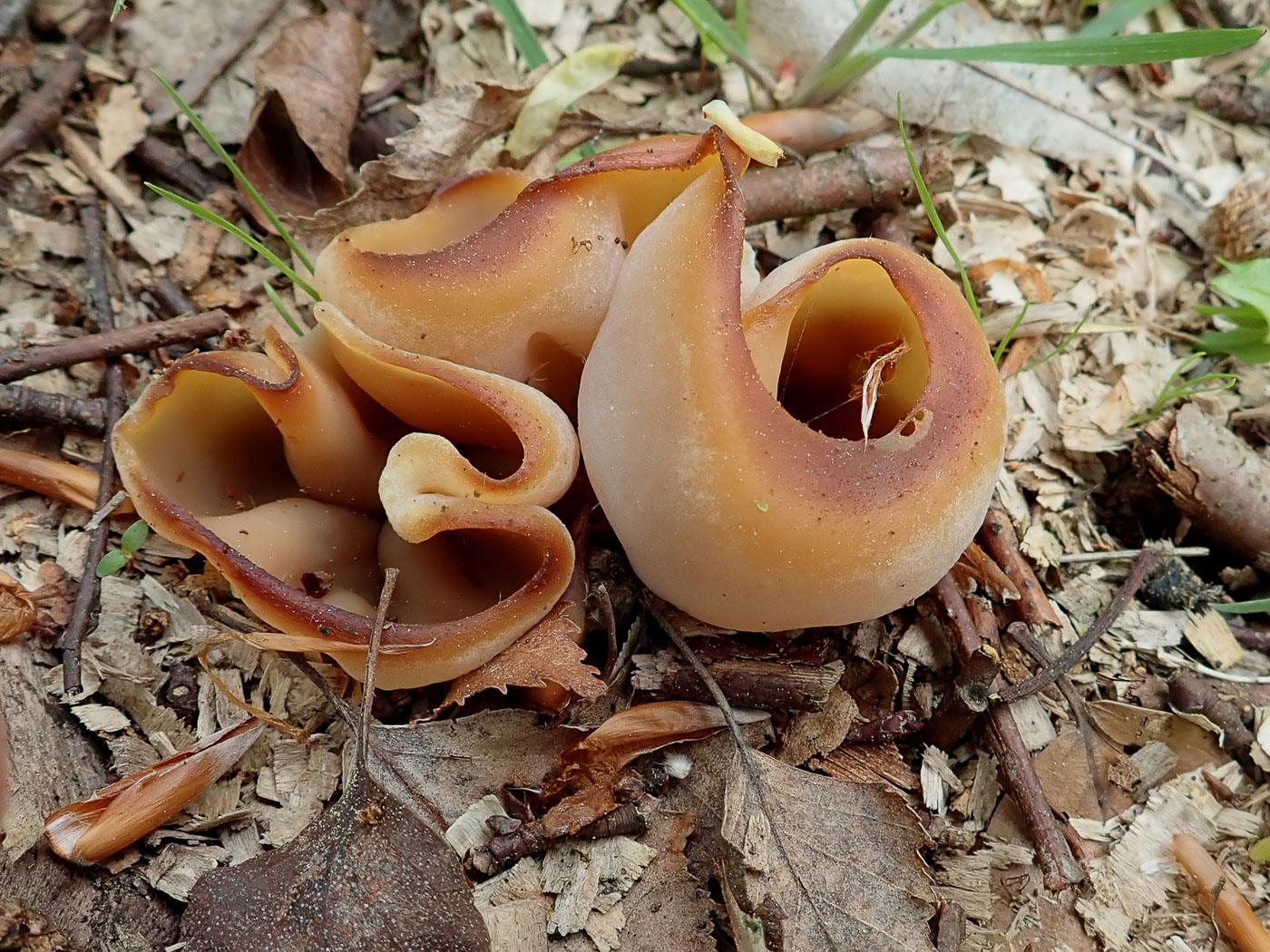 |
May 17th Peziza repanda (Palamino Cup) 
In some damp Beech sawdust at Turville Heath Penny found first this sizeable cup all of 7cms both across and deep (photos 1 and 2), then a few yards away found several more though much smaller and immature. The spore size and ornamentation together with the substrate led her to this species in several keys, though there are at least three other Peziza species which are this colour. We have an earlier entry (see April 15th) also found at this site but from a completely different area.
|
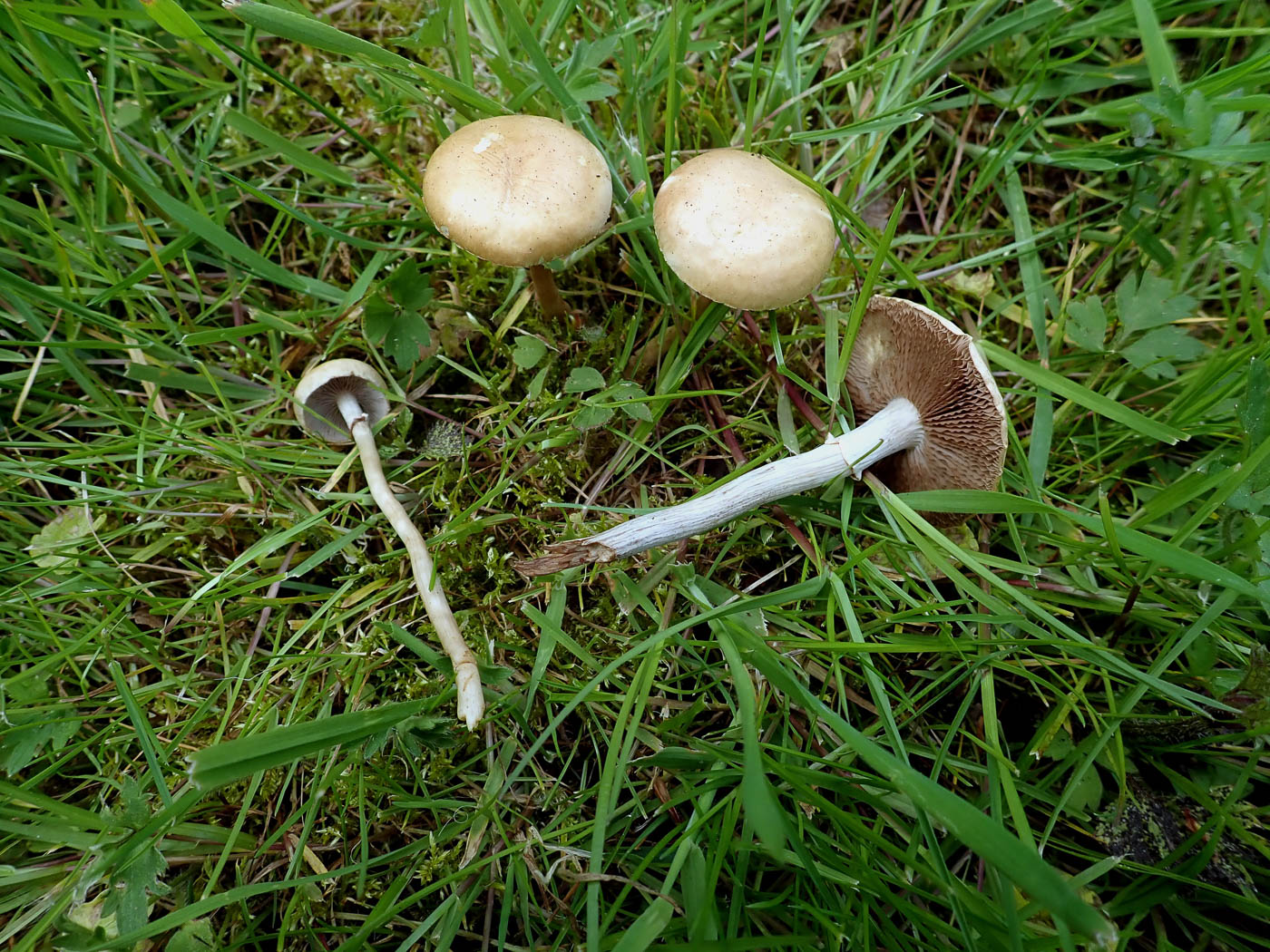
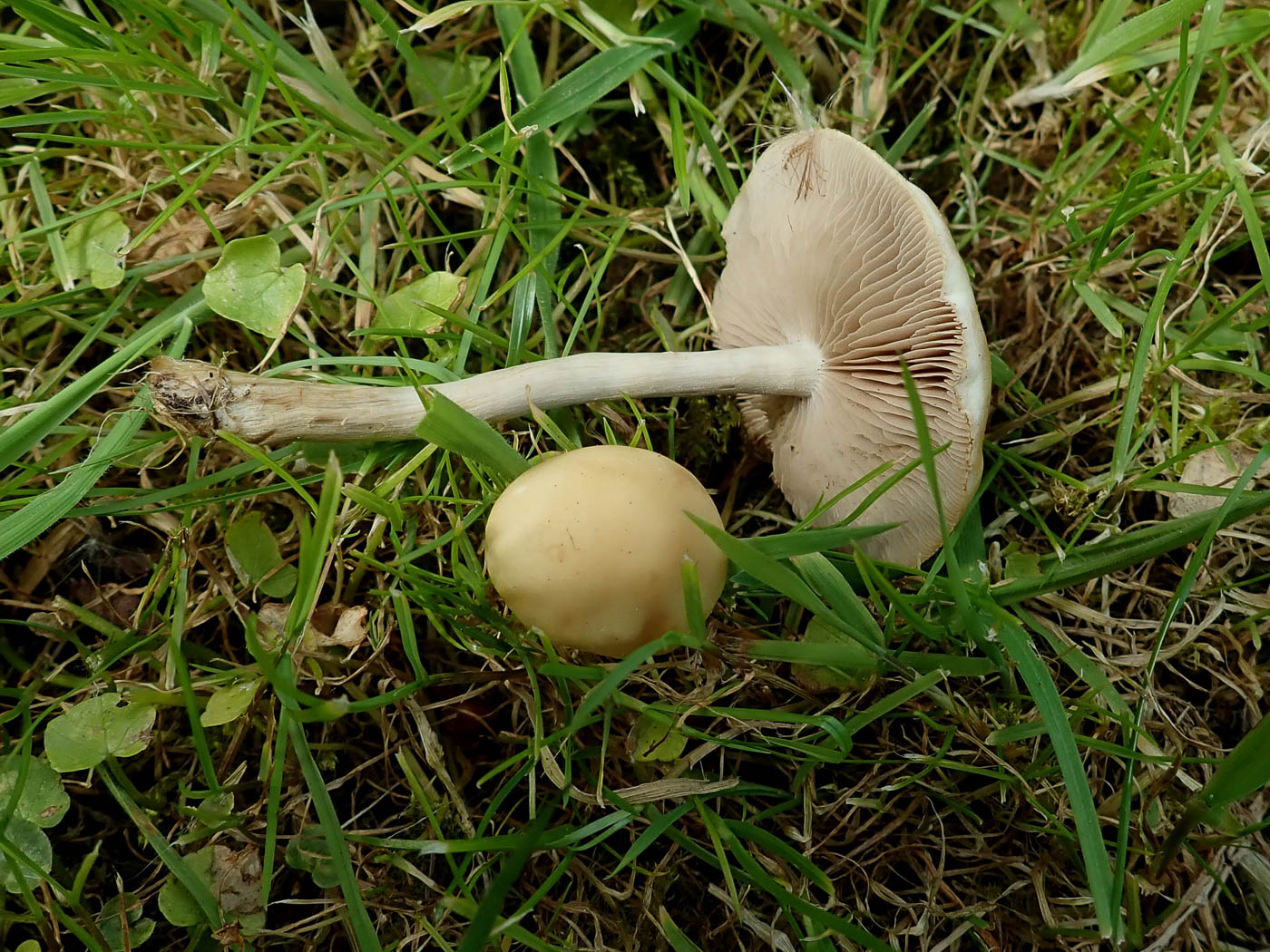 |
May 17th Agrocybe praecox (Spring Fieldcap) 
Along a grassy road verge at Turville Heath Penny was on the look out for this early Summer fruiting grassland genus so was not surprised to find these two clusters. The largest cap was about 2.5 cms across and the remnants of ring on the stem pointed to this species which the spores and gill cells then confirmed later at home. See the Masterlist for more examples.
|
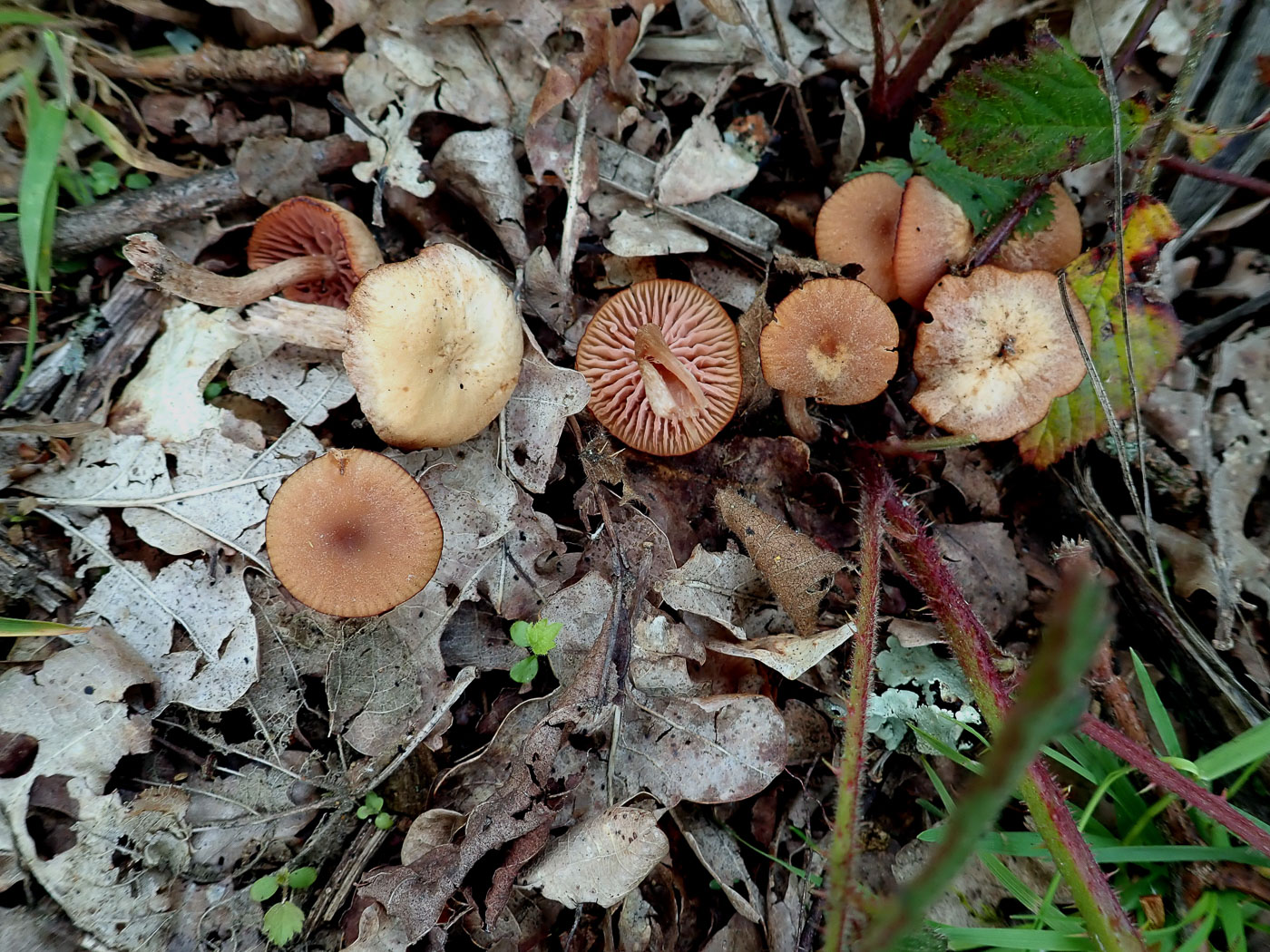 |
May 17th Laccaria laccata (Deceiver)
At Turville Heath Penny was quite surprised to come across this little collection of a very common late Summer / Autumn species. The area was open cleared woodland so both fresh rusty and faded almost white caps can be seen here - typical of the species. Note the widely spaced pink gills despite it having a white sporeprint. We also found the species recently at Burnham Beeches, April 29th - our earliest record. See the Masterlist for more examples.
|
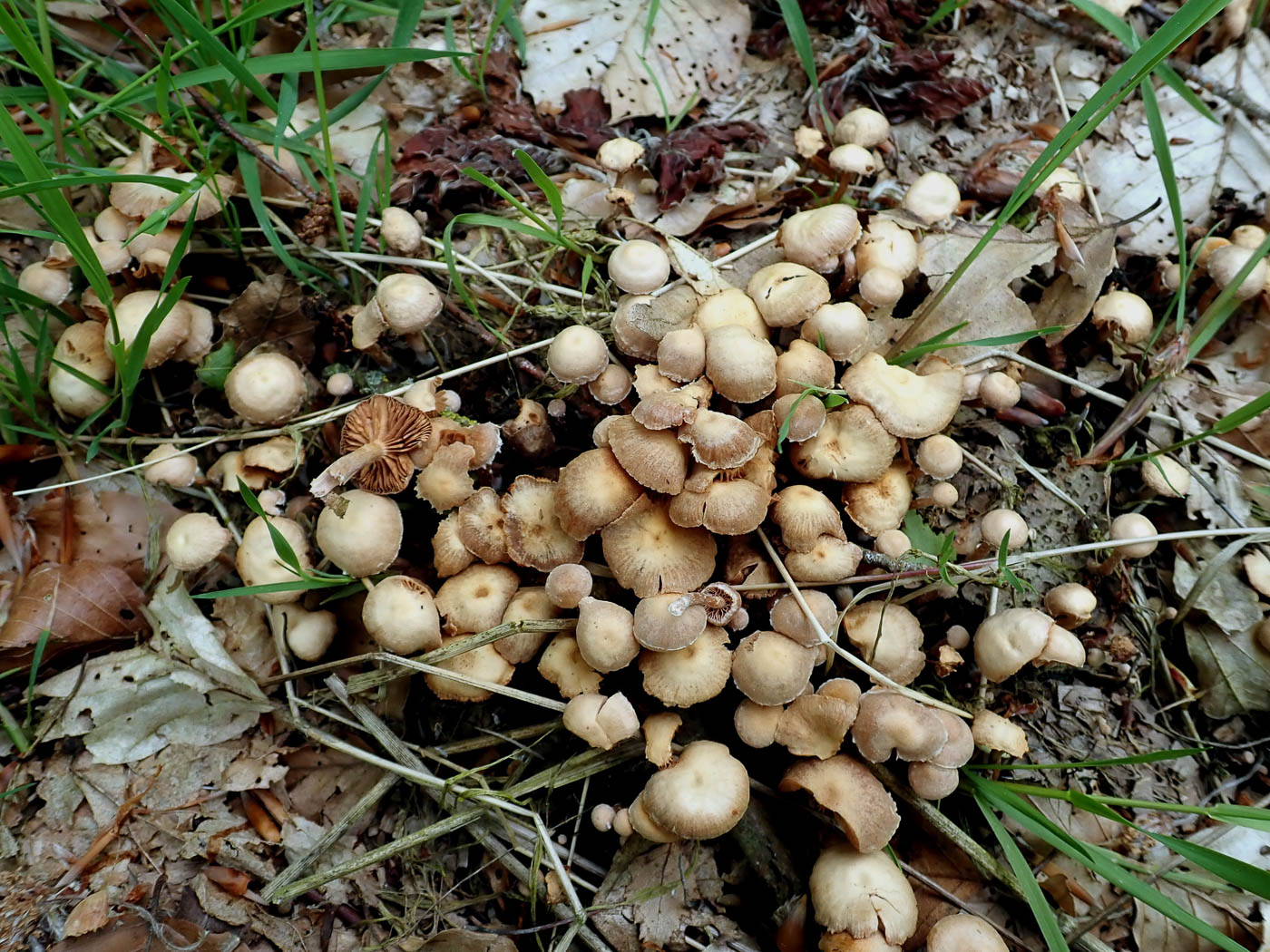
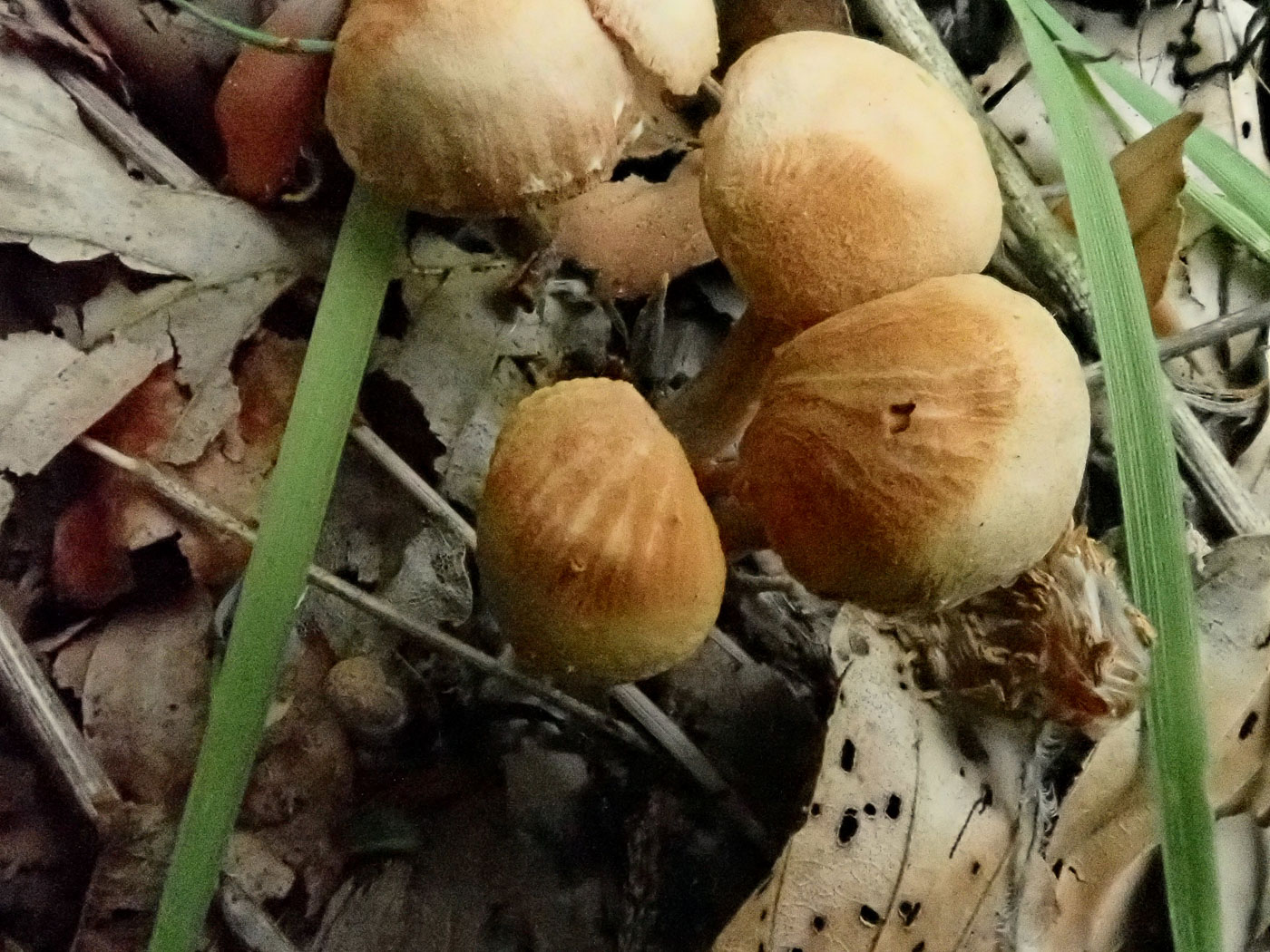
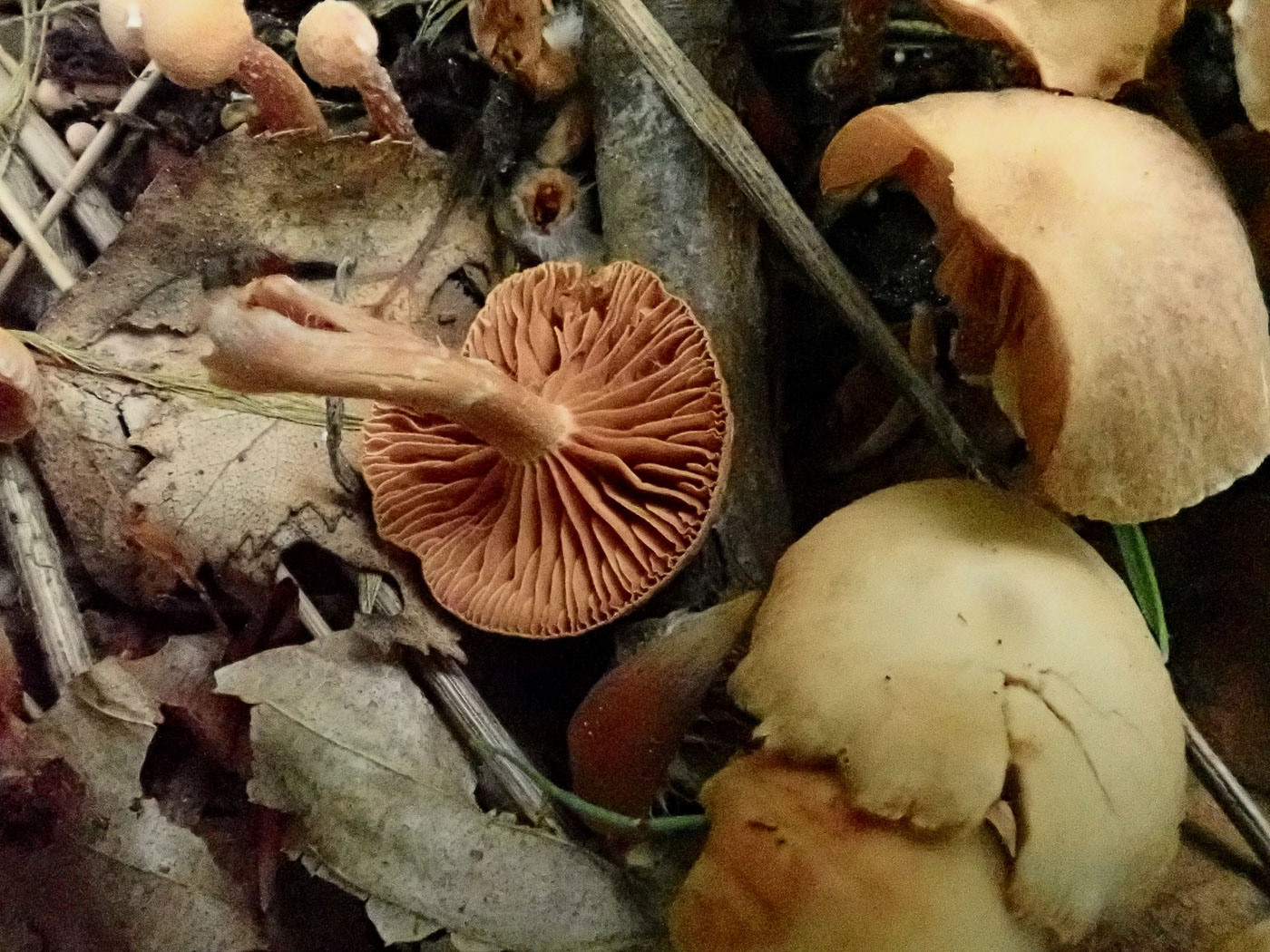 |
May 17th Tubaria furfuracea (Scurfy Twiglet) 
In some damp Beech sawdust at Turville Heath Penny found good numbers of this common LBJ coming up in troops. The area was open and sunny so many were somewhat dry, smooth and faded (hence the check later with a scope) and in photo 2 the pale rusty brown spore colour can be seen on the three caps uncovered when Penny picked a specimen which was covering them. Photo 3 shows the similarly coloured gills and also signs of ring zone right at the apex which often seems to be present in the species. See March 18th and 25th for earlier examples.
|
May 16th 2023

 |
May 16th Conocybe apala (Milky Conecap) 
In rotting straw in a dung heap at Stampwell Farm Jackie Ewan found this distinctive Conecap. This species - previously C. albipes, also C. lactea - can almost be named on sight owing to its markedly conical and pale cap, pale stem and relatively large size, though microscopic characters were also checked by Jackie. It is described as occurring in fertile soil, often in grass, but also with rotting straw as here and we have a good number of records - the majority from Derek's garden in Whitchurch where it was clearly a regular! Despite its distinctive characters there is much confusion over the correct name. Kibby, following Fungi of Temperate Europe, names it C. albipes, describing C. apala as rare and doubtfully British whereas C. albipes, described separately, is relatively common. Penny here follows FRDBI and Index Fungorum in naming it C. apala though personally favours C. lactea on the grounds that it well describes the milky coloured cap! Photo 2 shows another useful character of the species: it has a sizeable bulb at the stem base. See also in Finds 2021 June 10th - another collection from Stampwell Farm.
|
May 13th 2023
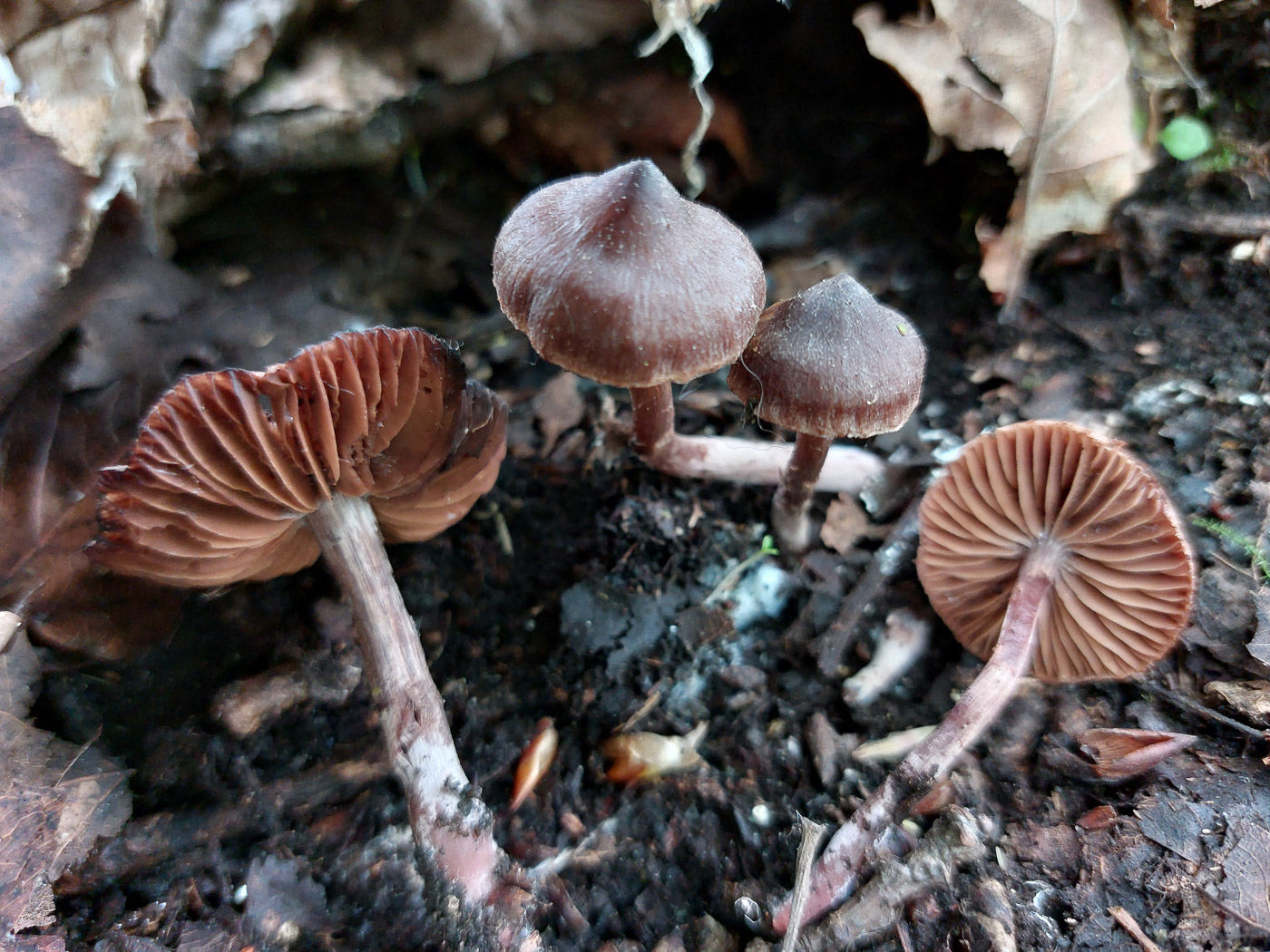
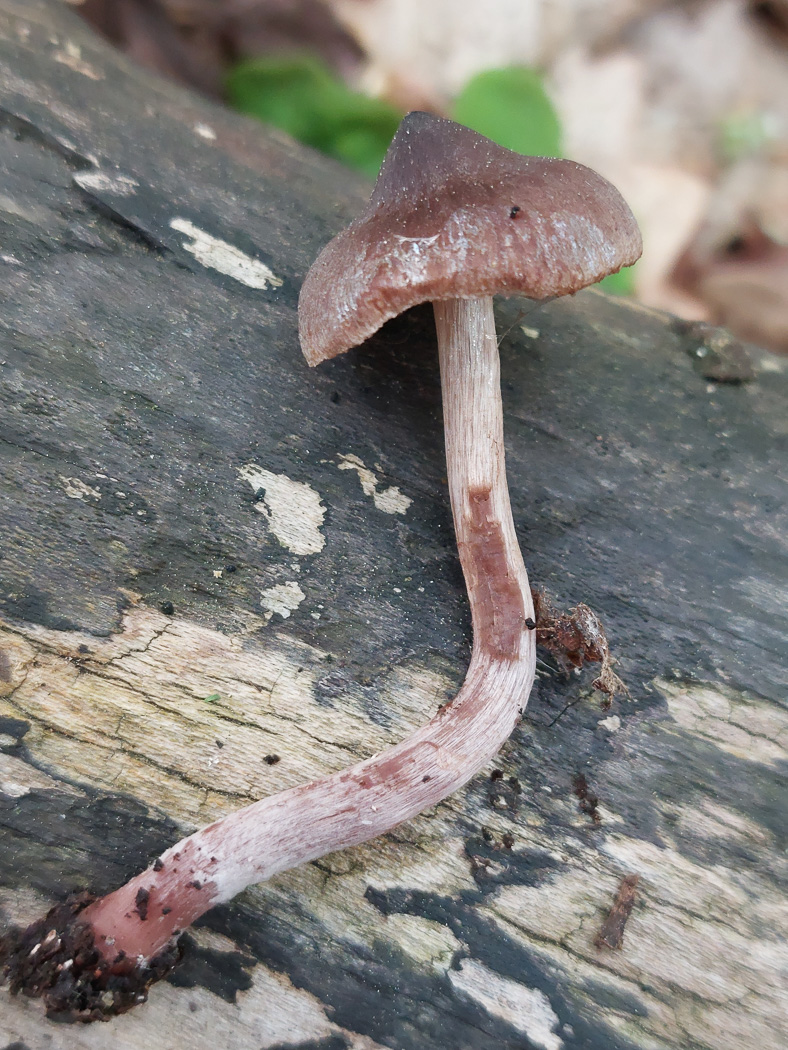 |
May 13th Cortinarius vernus (Spring Webcap) 
In Gerrards Cross Common Jesper Launder came across this little collection under a mix of deciduous trees and, knowing it was an unusual genus to be fruiting at this time, took it home to work on. This is one of the trickiest genera with literally hundreds of species and many which look pretty well like this one: typical LBJs! C. vernus (a member of Section Telamonia) seemed a likely candidate, however, and he sent the photos to expert Geoffrey Kibby who confirmed his ID. As well as fruiting in Spring, it is a small species, has an acutely conical reddish brown cap and the stem flesh tends to bruise reddish brown, seen clearly in photo 2. This is new not only to Finds but also to the county.
|
May 11th 2023
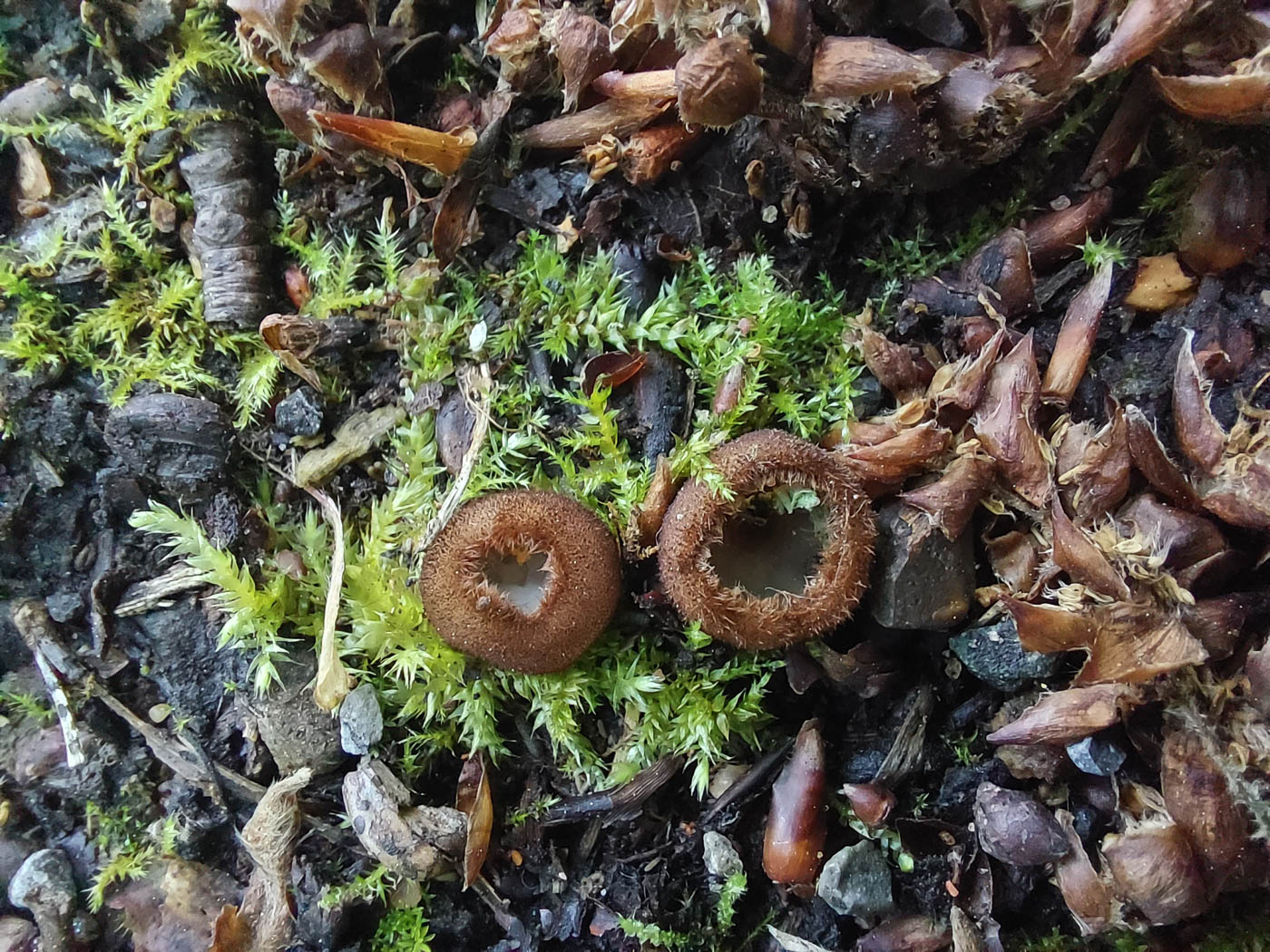 |
May 11th Humaria hemisphaerica (Glazed Cup)
In woody litter in Gerrards Crosss Jesper Launder spotted these two tiny brown hairy cups which were just opening out. The inside was suitably pale and shiny to confirm his ID on the spot. This is an occasional species and our 20 odd BFG records reflect fruiting on and off throughout the year though this is the first for May. See the Masterlist for three other entries.
|
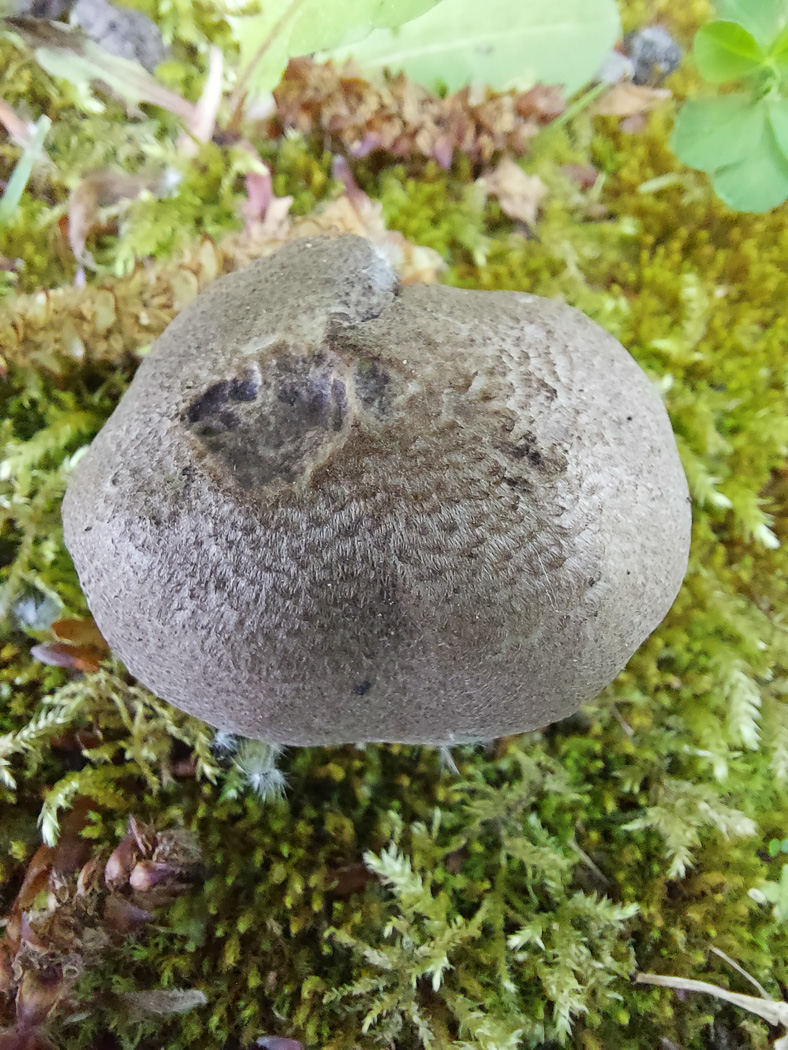
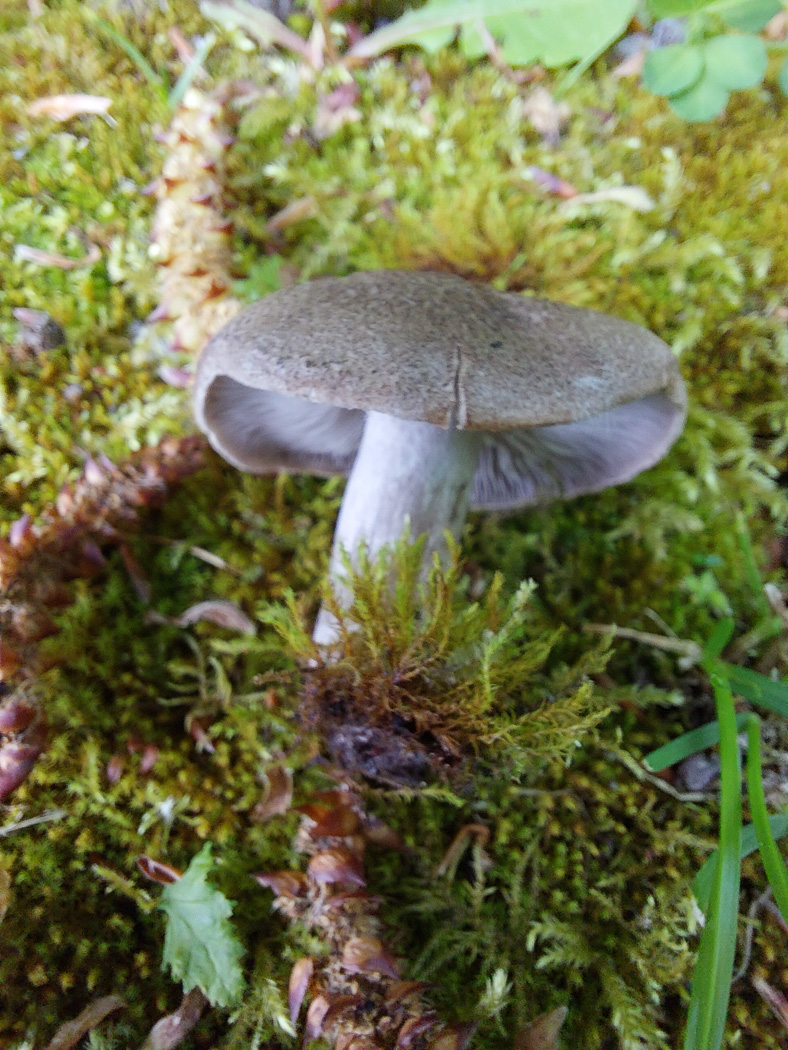 |
May 11th Tricholoma scalpturatum (Yellowing Knight)
In Gerrards Cross under mixed deciduous trees Jesper Launder found this species - one we associate with autumn fruiting. It is one of our commoner grey-capped Knights, having a mealy smell and a slightly scaly surface and when older tends to turn yellow where damaged - not seen here, however. We have many records, the vast majority from September - November but a smattering from earlier in the year. See the Masterlist for two further images.
|
May 9th 2023
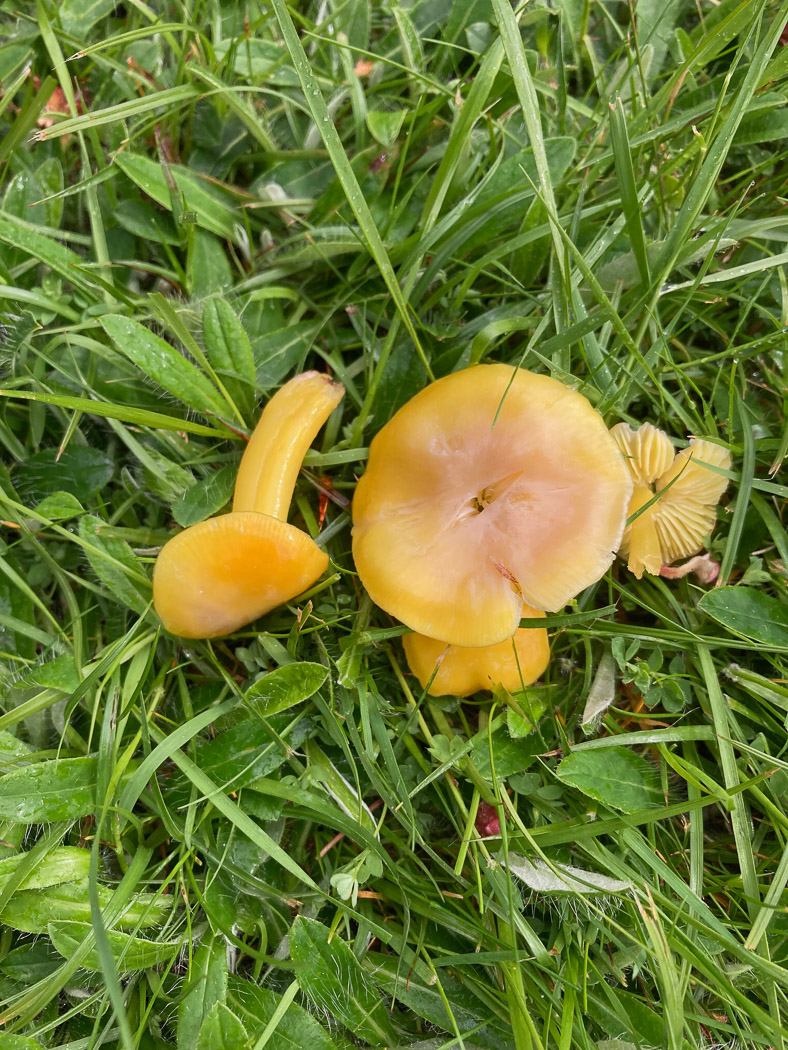 |
May 9th Hygrocybe chlorophana (Golden Waxcap)
Richard Donnelly was amazed to find this Waxcap on his lawn in Bourne End today which he correctly identified. This is a common late Autumn species, one for which we have many county records on our database - virtually all of them from October and November. Penny found two records of hers from May, however, from Penn St Cricket Pitch in 2003 so today's find was not quite unique! See the Masterlist for more images, but this is the only entry for May!
|
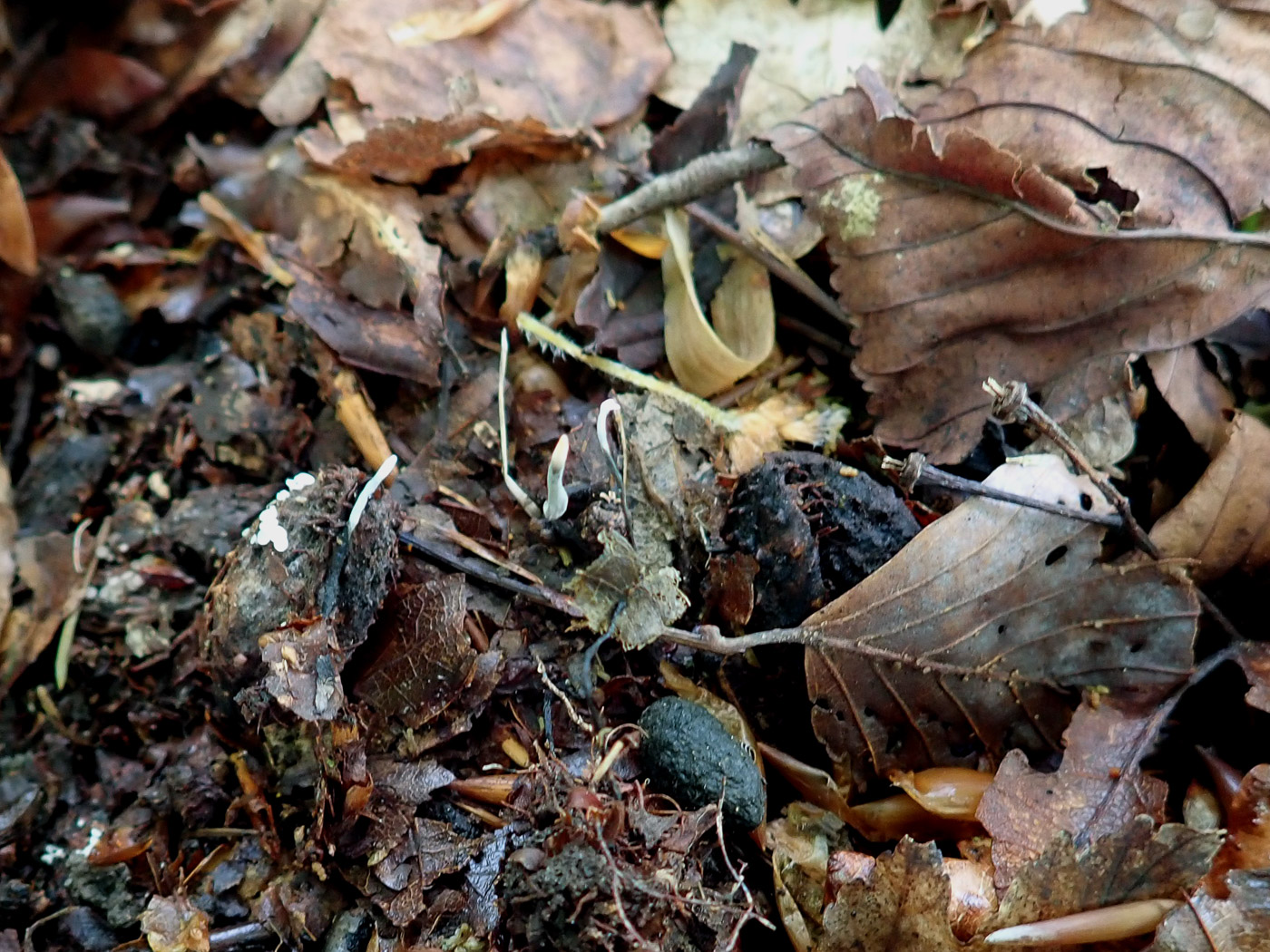 |
May 9th Xylaria carpophila (Beechmast Candlesnuff)
In the thick Beech litter at Turville Heath Penny searched around to find this tiny Candlesnuff species - one which is common at this time. It grows on the nut cupules and is clearly a miniature form of its 'big brother' seen below, ie a thin greyish furry spike with a peach pink tip. See also in Finds 2021 March 27th.
|
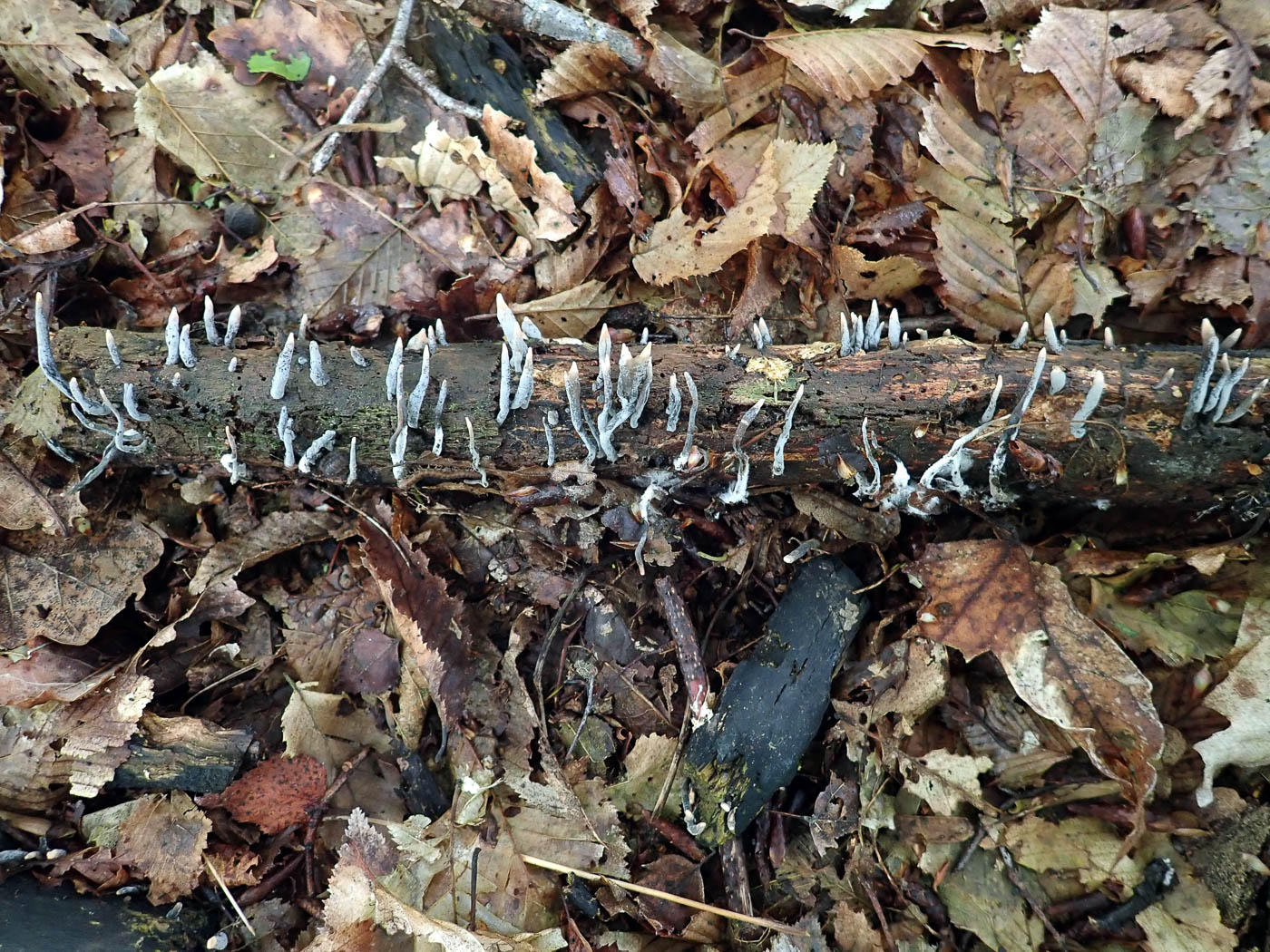
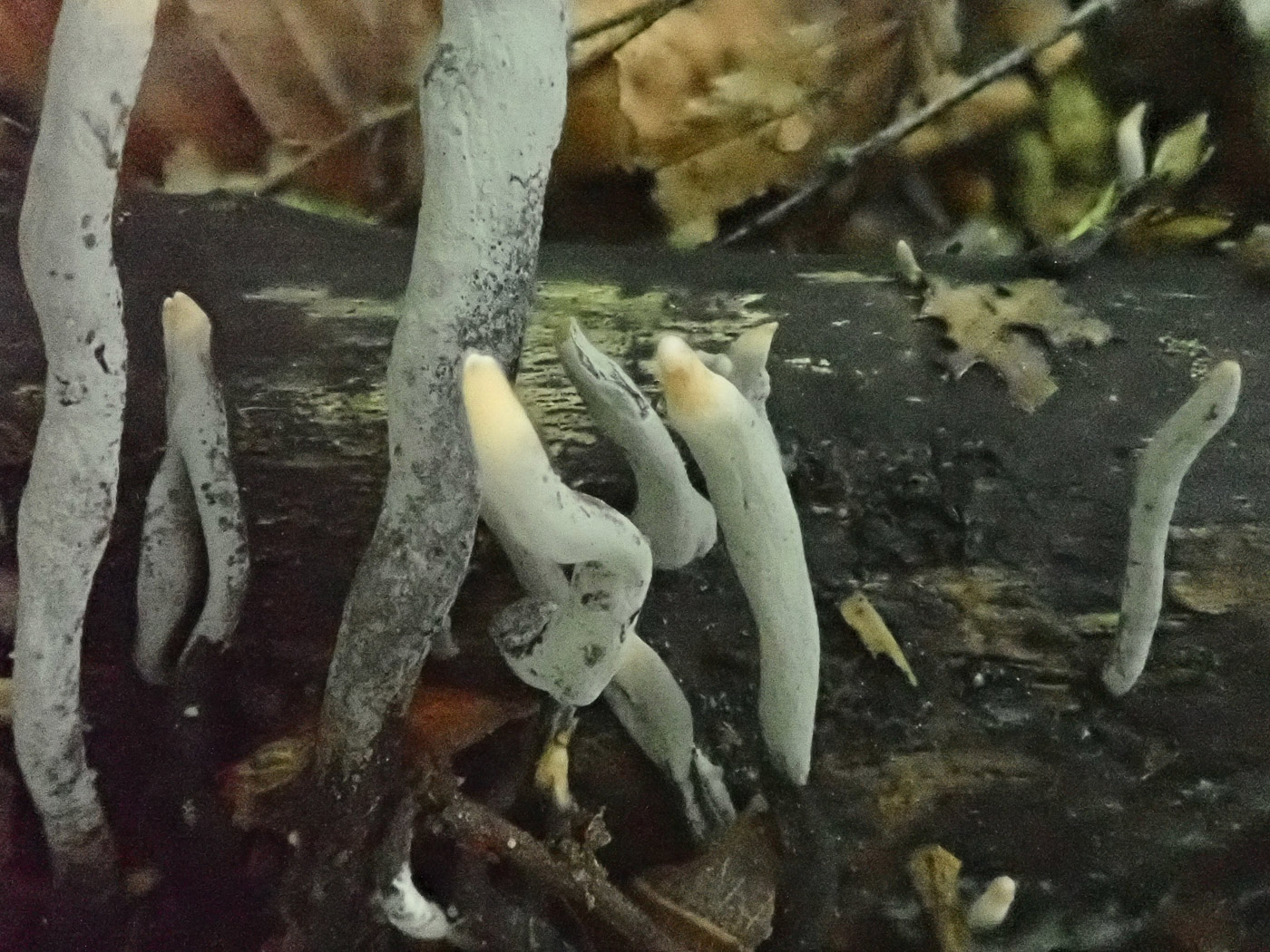 |
May 9th Xylaria hypoxylon (Candlesnuff Fungus)
At Turville Heath Penny found many examples of the early stages of this species on fallen deciduous wood - one of the most familiar when fully mature and shiny black but much less often illustrated in it present form. See the Masterlist for examples of its very different mature appearance.
|
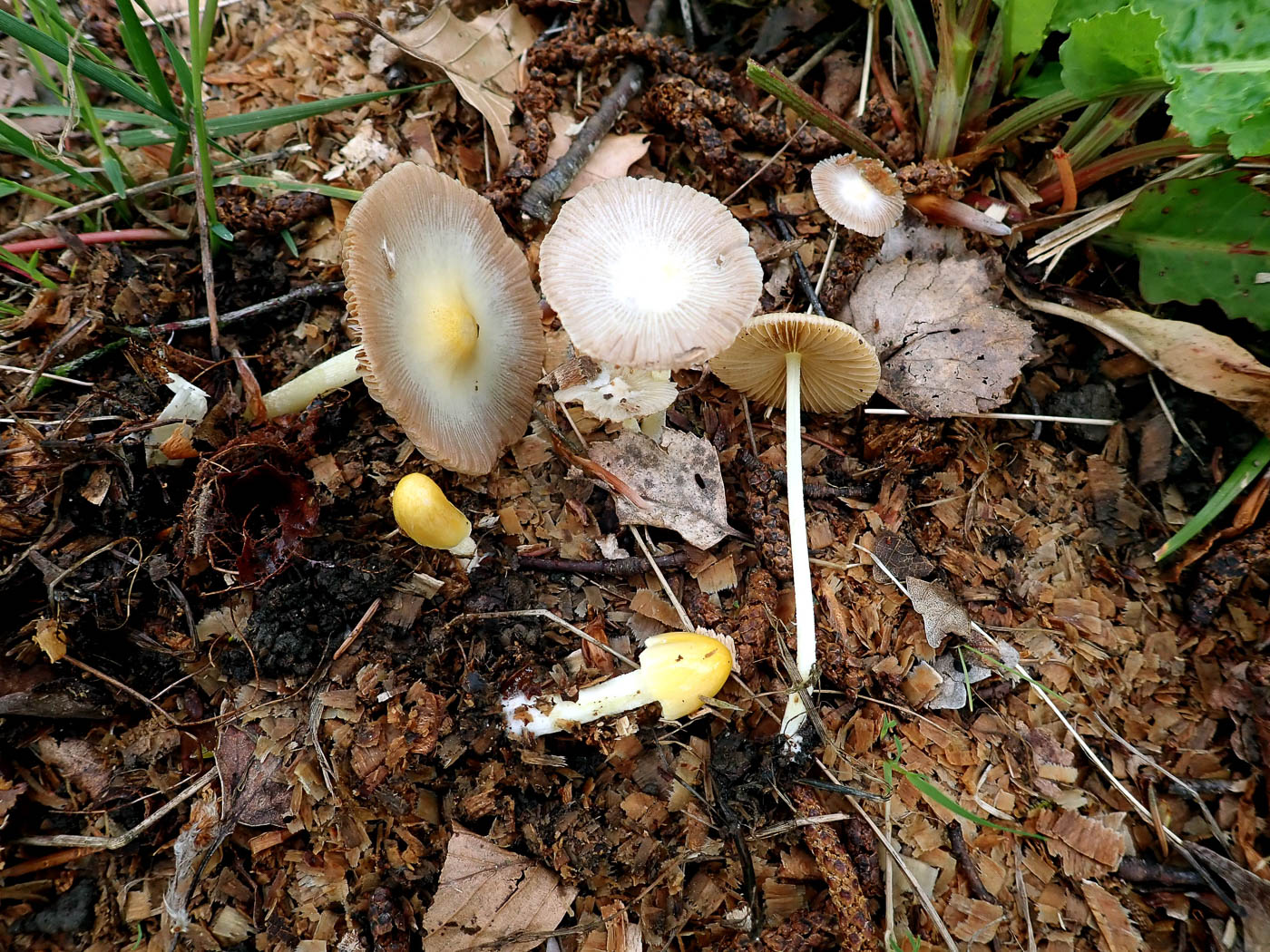 |
May 9th Bolbitius titubans (Yellow Fieldcap)
At Turville Heath in a patch of Beech sawdust Penny found several specimens of this species at different stages of development. The largest cap was 3 cm across and still retained a touch of the egg yellow at the centre, this colour predominant when immature but often lost completely as the caps expand as can be seen here. See the Masterlist for many other examples.
|
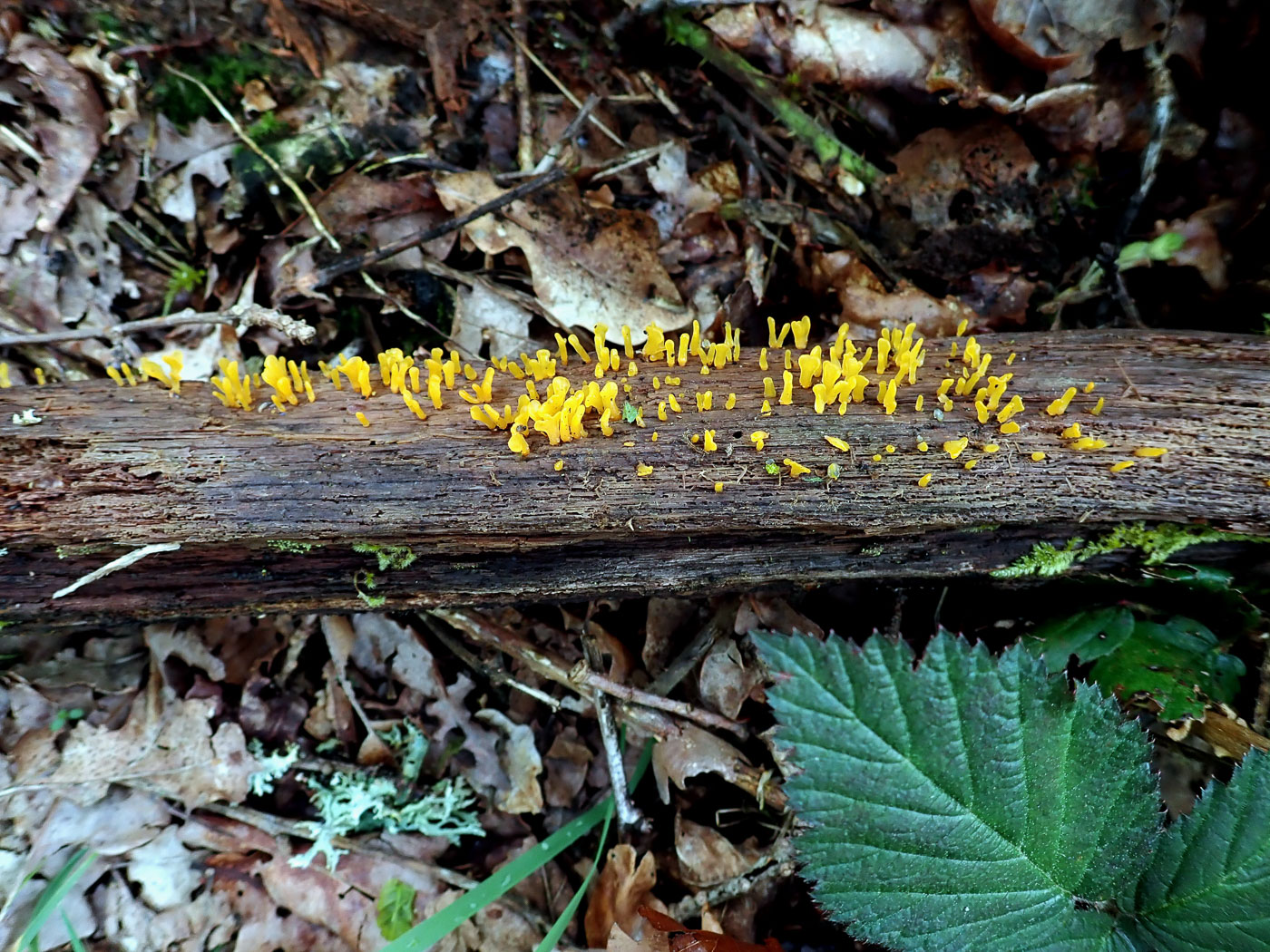
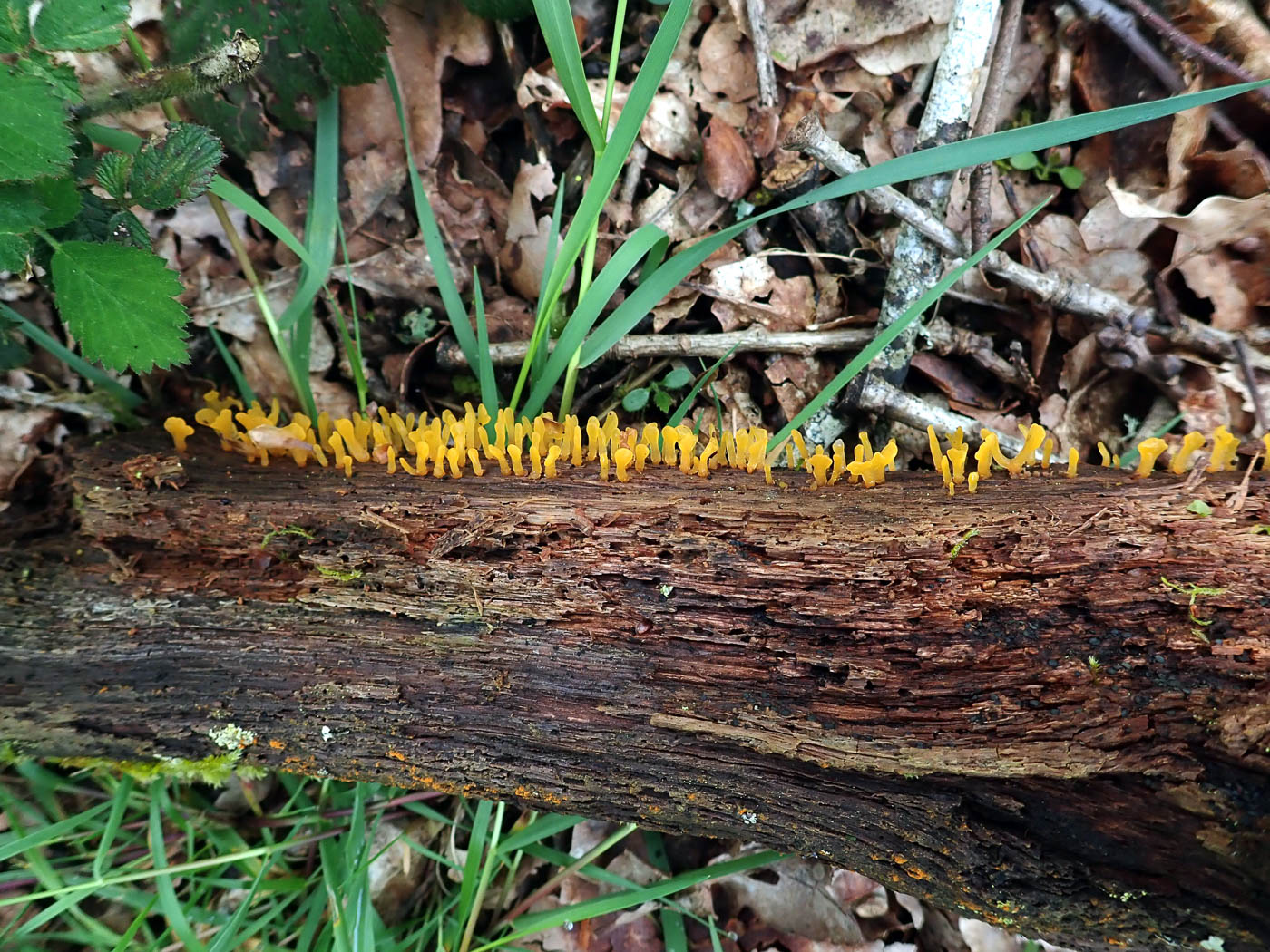
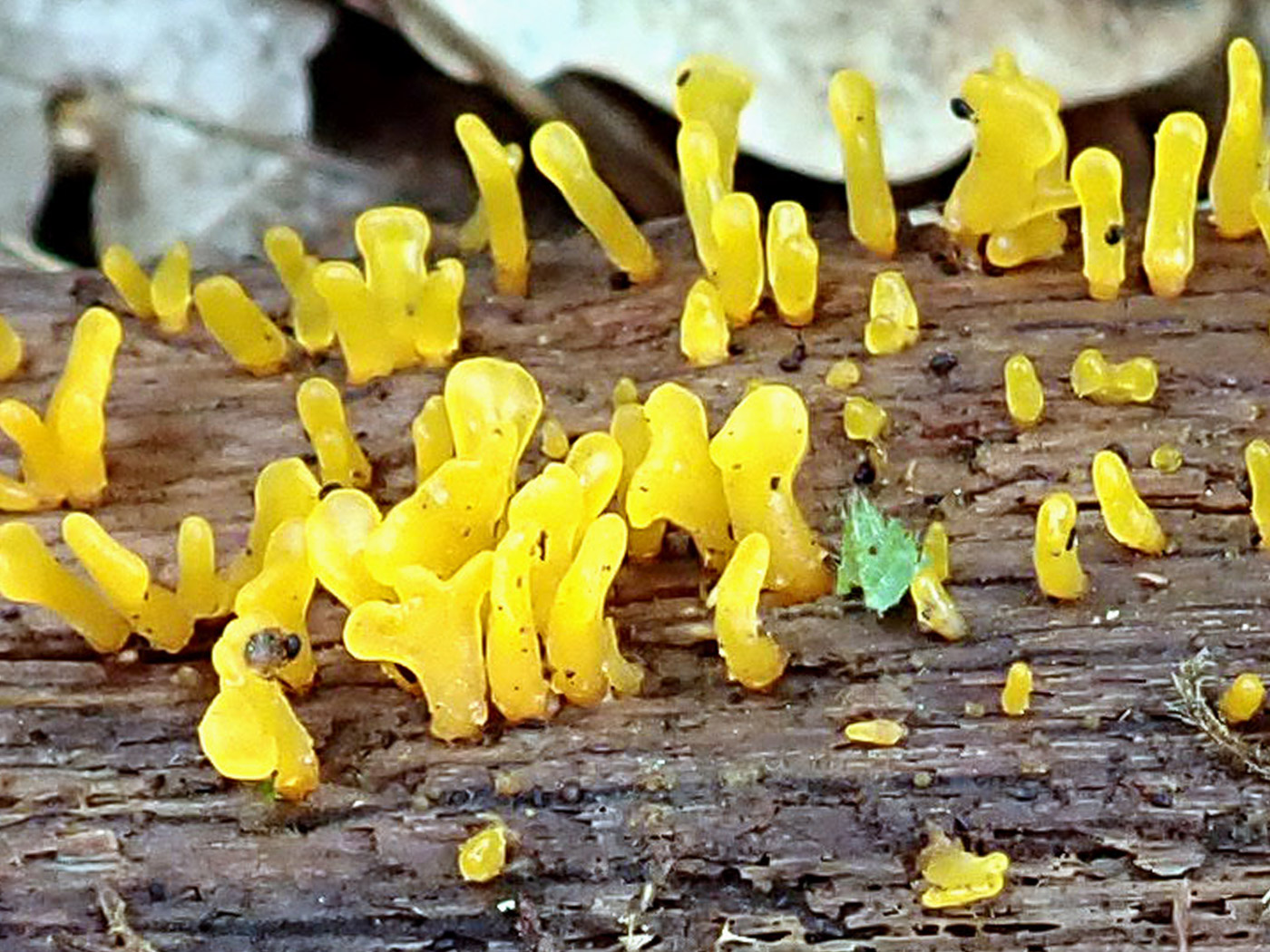 |
May 9th Calocera glossoides (a Stagshorn with no common name)
At Turville Heath Penny found some fallen bare Oak with a liberal covering of this bright orange jelly fungus. C. glossoides is a Stagshorn we've rarely recorded in recent years owing to the fact that the very similar but paler C. pallidospathulata - until the last 20 years or so known as a conifer associate - is now known to occur on both deciduous and coniferous fallen wood, hence we tend to name collections which are clearly not narrow and spiky (these being C. cornea) as C. pallidospathulata whatever wood they are found on, possibly in error. Today's collection were suitably spathulate in shape but bright orange, hence Penny feels justified in eliminating both C. cornea and C. pallidospathulata here. An interesting comparison can be made by checking the two Finds collections of C. pallidospathulata dated 2020 October 3rd and 2022 November 29th which are clearly considerably paler than today's collection, also both were on Pine which eliminates today's species.
|
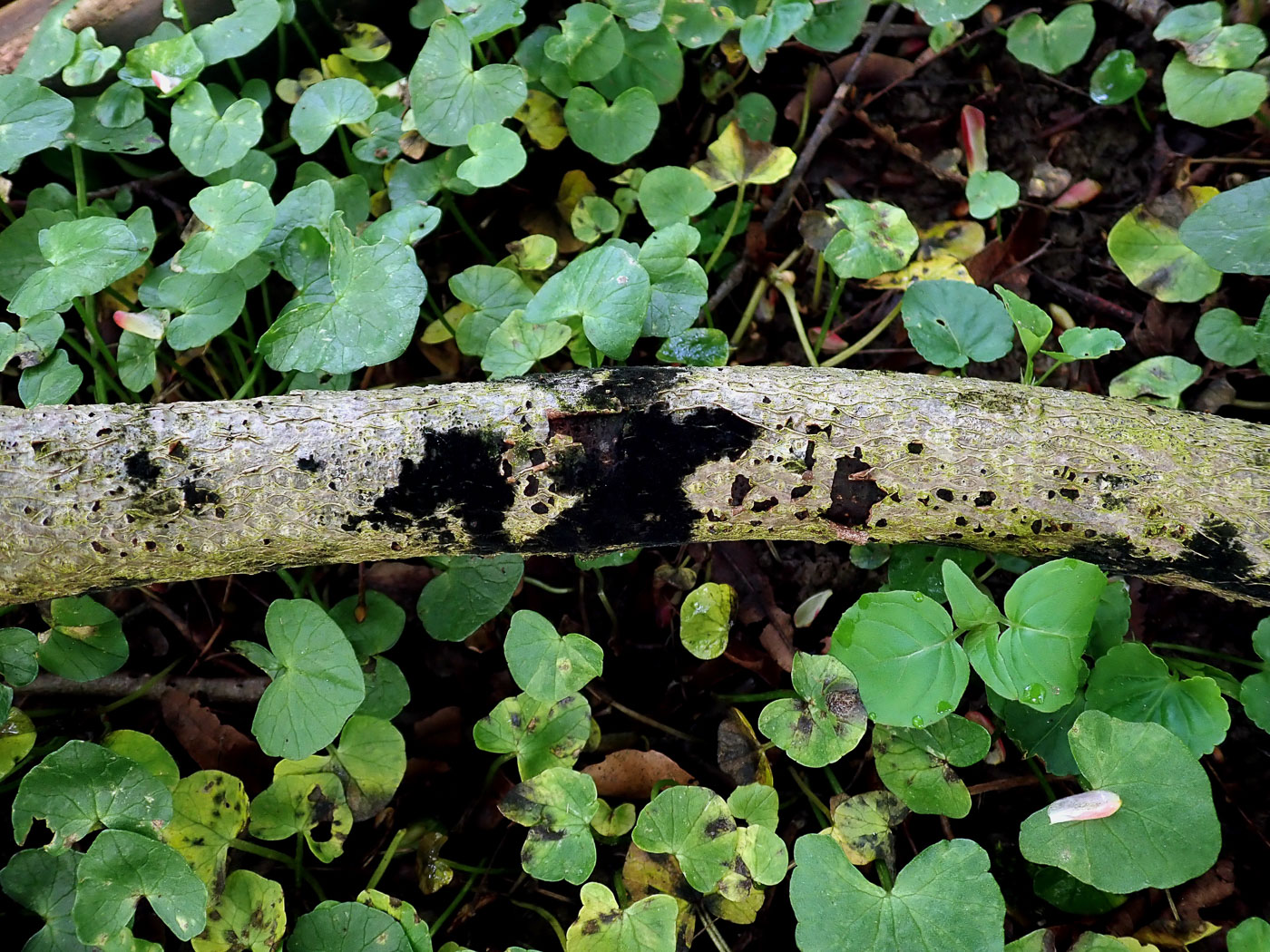
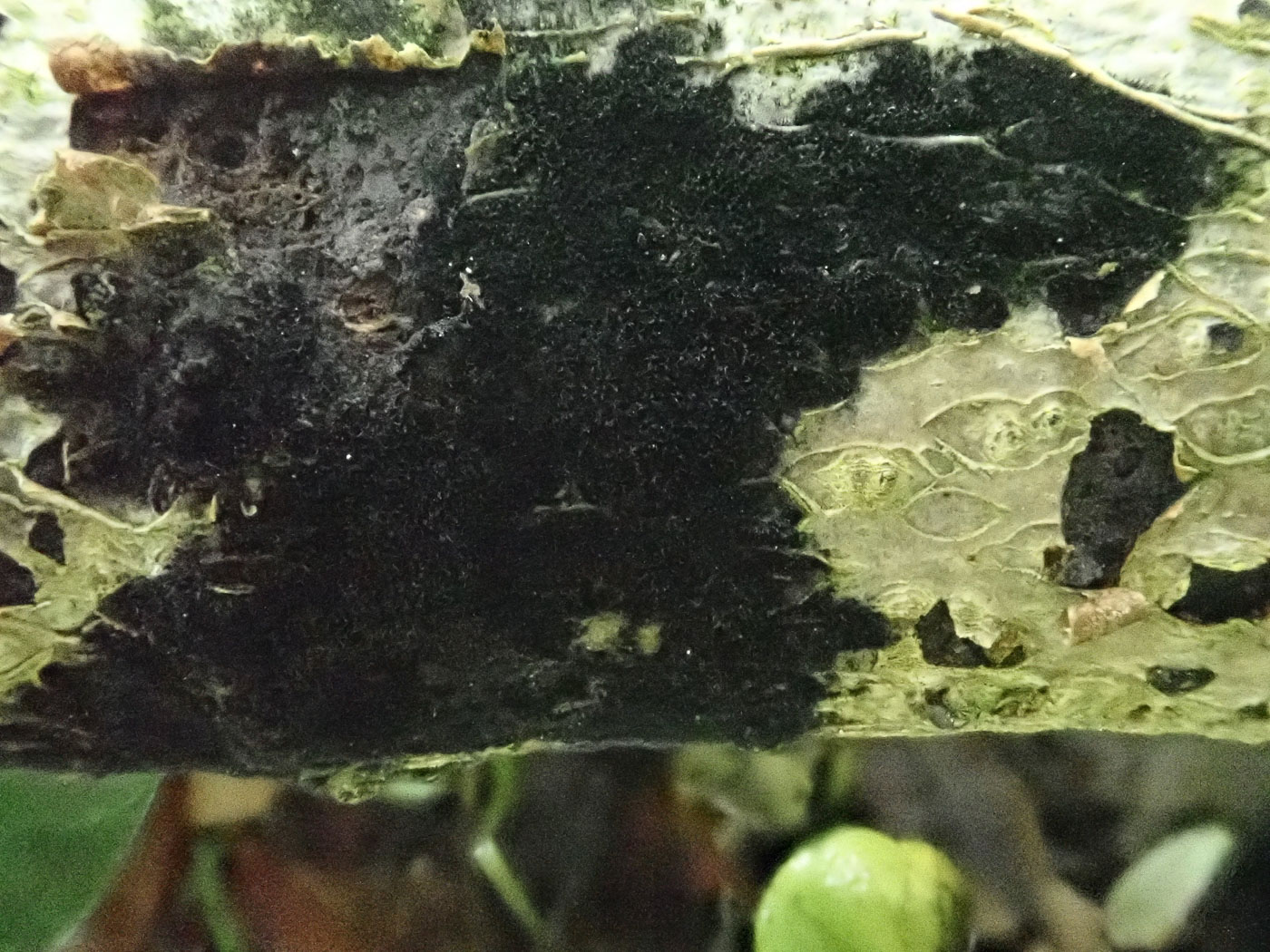
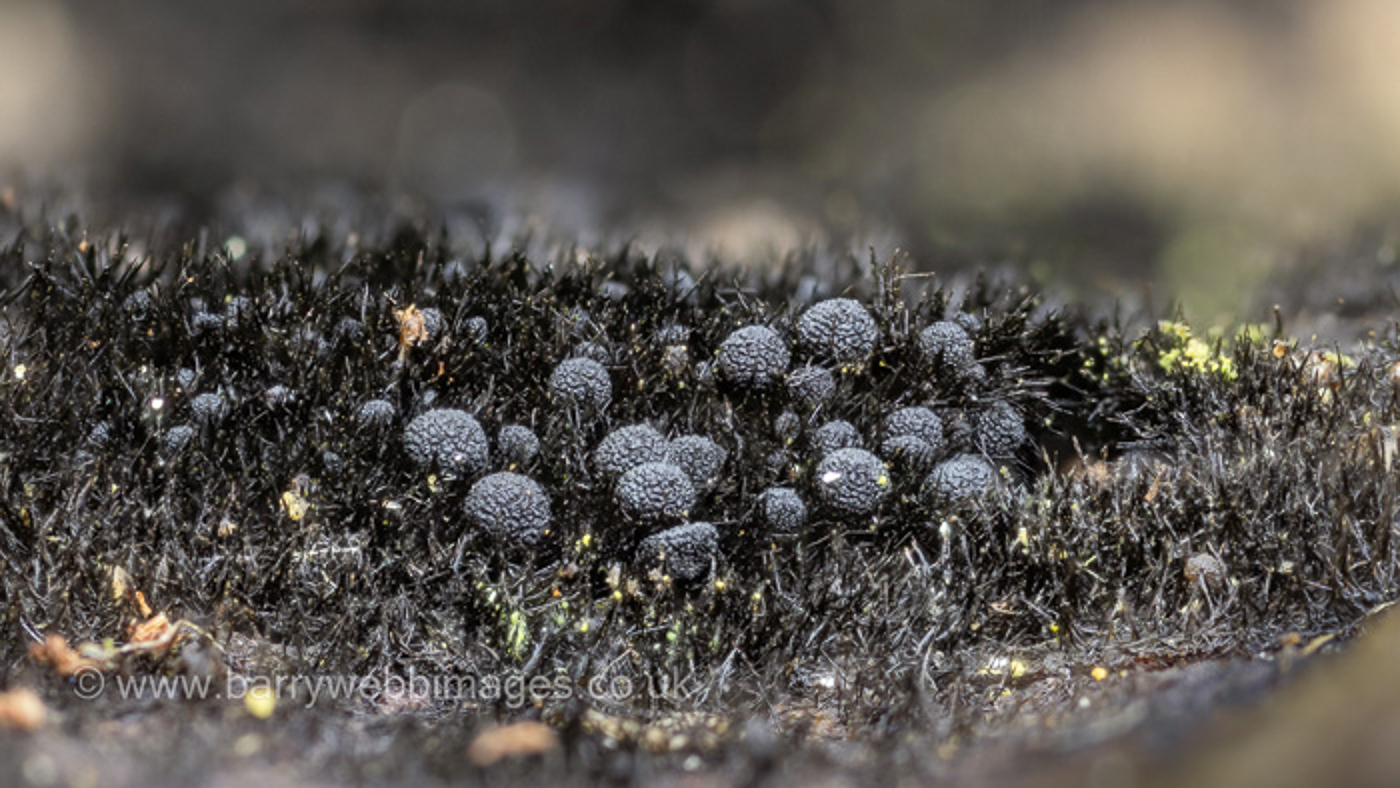 |
May 9th Chaetosphaerella phaeostroma (a Pyrenomycete with no common name)
At Turville Heath under the avenue of Limes Penny noticed a stick amongst the Celandine with a conspicuous velvety patch. Though it has no common name (Black Velvet would suit it well) it is quite a common species forming a flat densely finely hairy surface which later develops tiny black bobbles which burst open (like the top of a boiled egg) to release the spores. Photo 3 (by Barry Webb) is of a mature example from Stoke Common, May 20th, showing the bobbles to perfection. This is a first for Finds.
|
May 8th 2023
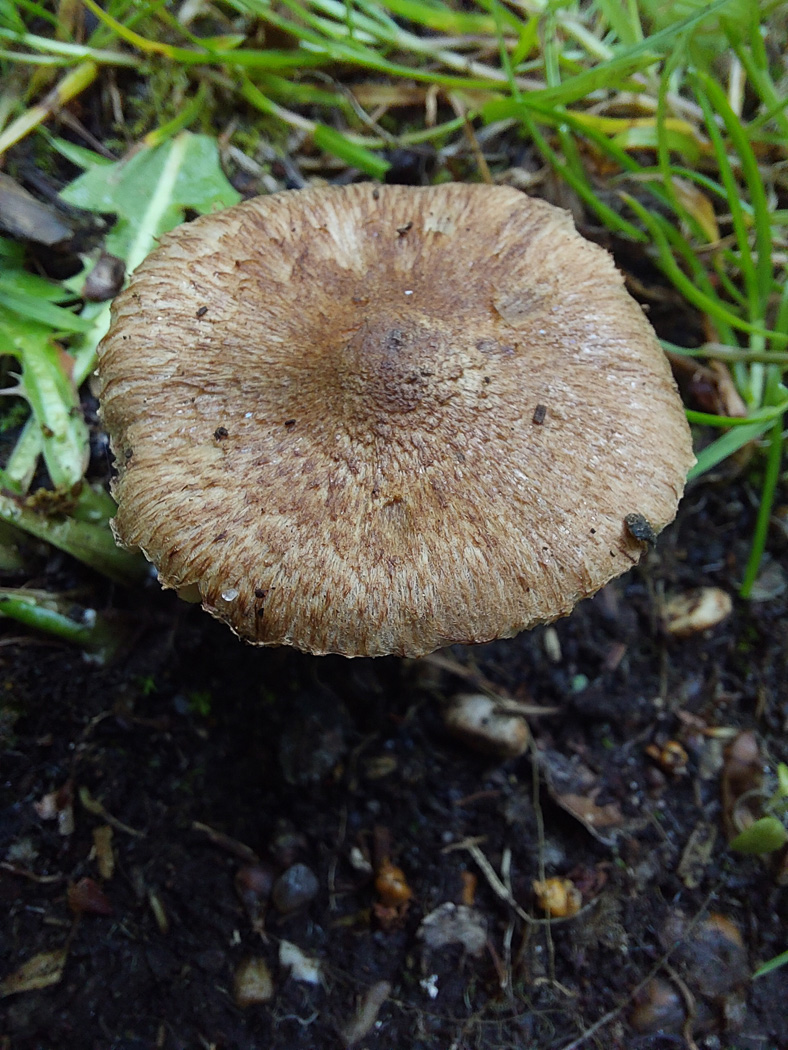
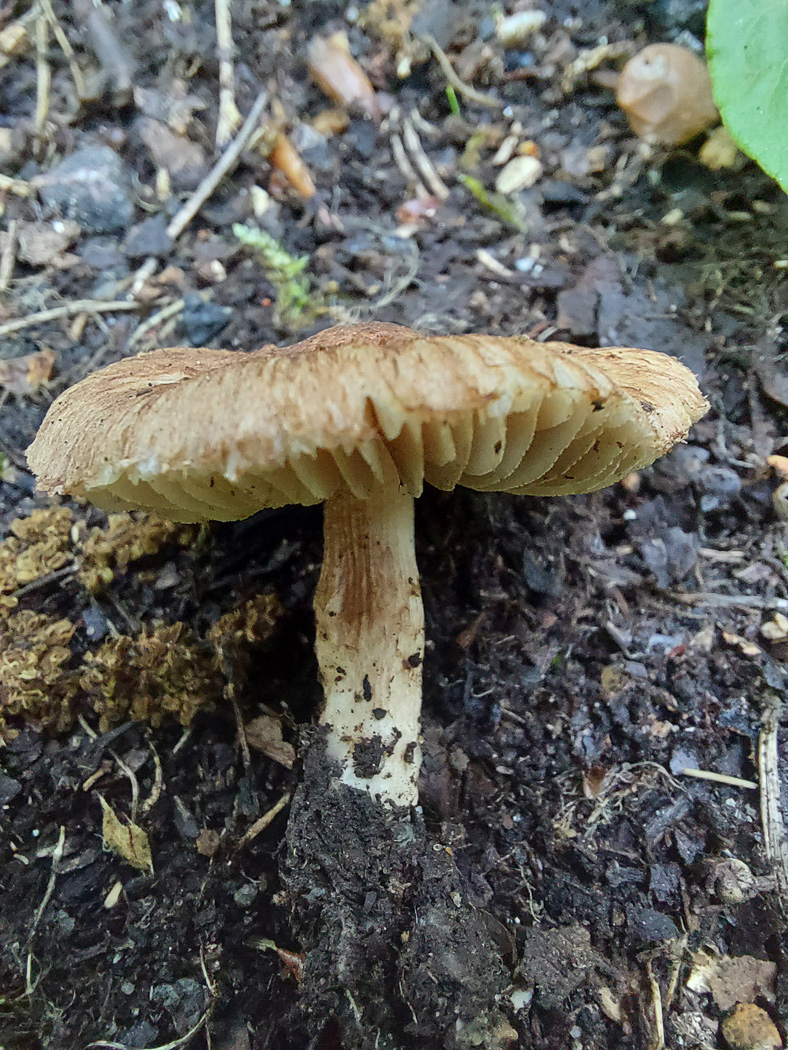 |
May 8th Inocybe glabripes (a Fibrecap with no common name) 
Under a mix of deciduous trees in Gerrards Cross Jesper Launder found this singleton Fibrecap - certainly a surprise to find this genus of LBJs fruiting in Spring. The material was then identified by Penny though the more appropriate name I. microspora is preferred by some authors (including Penny) and it does indeed have very small spores for the genus. This is an occasional species and a first for Finds, previously our earliest record being from August.
|
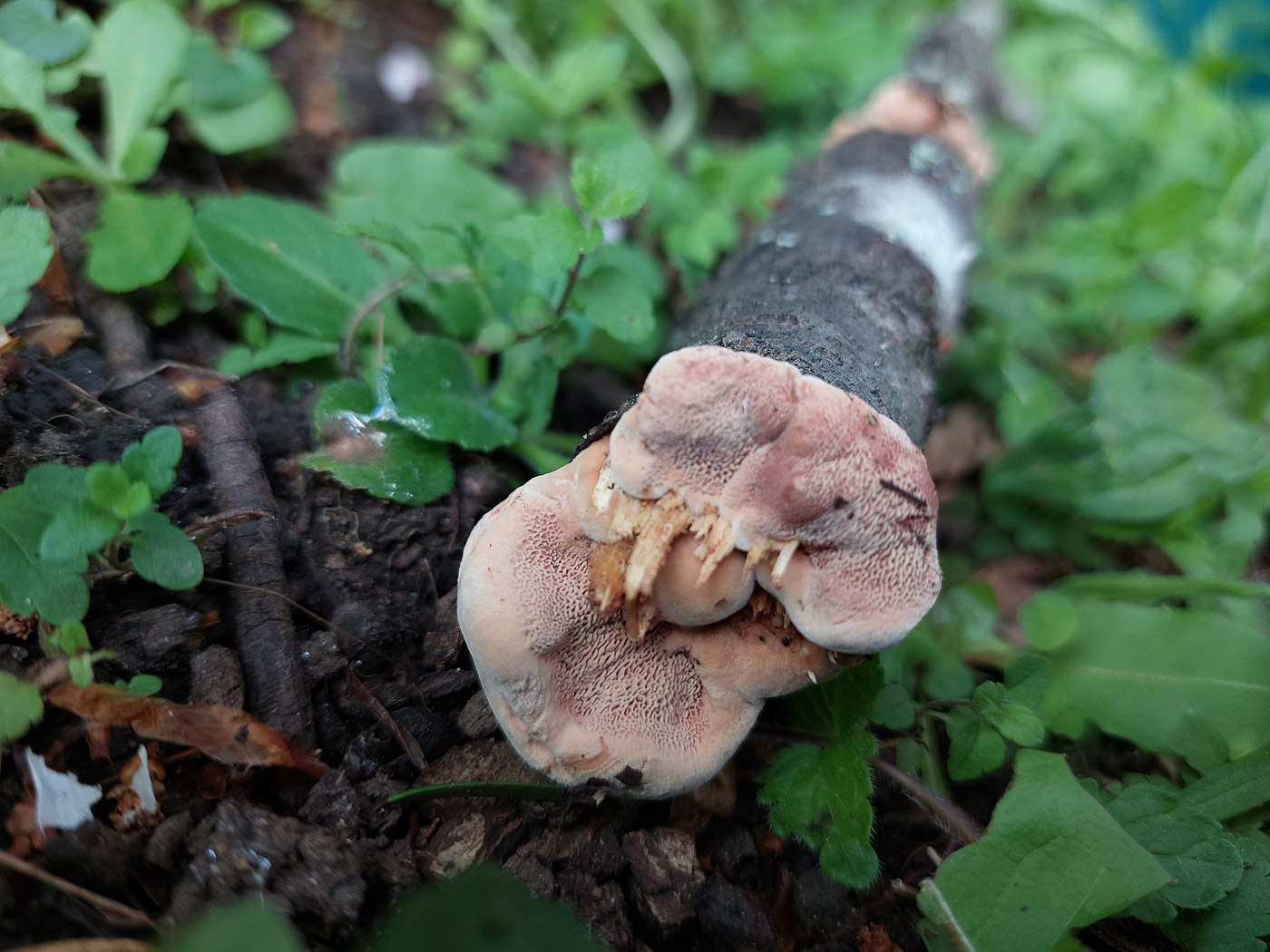
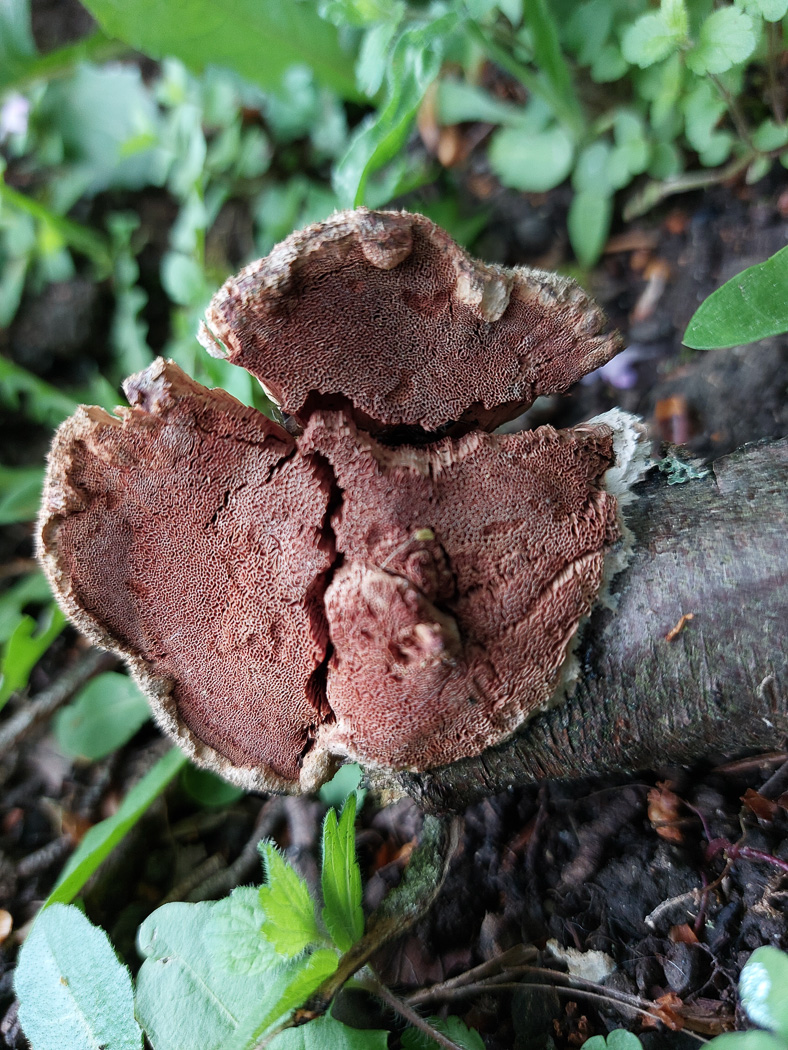
 |
May 8th Hapalopilus nidulans (Cinnamon Bracket)
In Gerrards Cross on some unidentified fallen wood Jesper Launder noticed two small brown brackets - one either end. Both were the same species, one immature (photo 1) and one mature (photo 2). In some books as H. rutilans (it being unclear which name should prevail) this pored small bracket in uncommon but if in doubt over its identity a drop of KOH obligingly turns bright purple in all parts! Jesper nobly returned the next day armed with his KOH - photo 3! See also in Finds 2021 July 12th, this being the first county find for quite a few years.
|
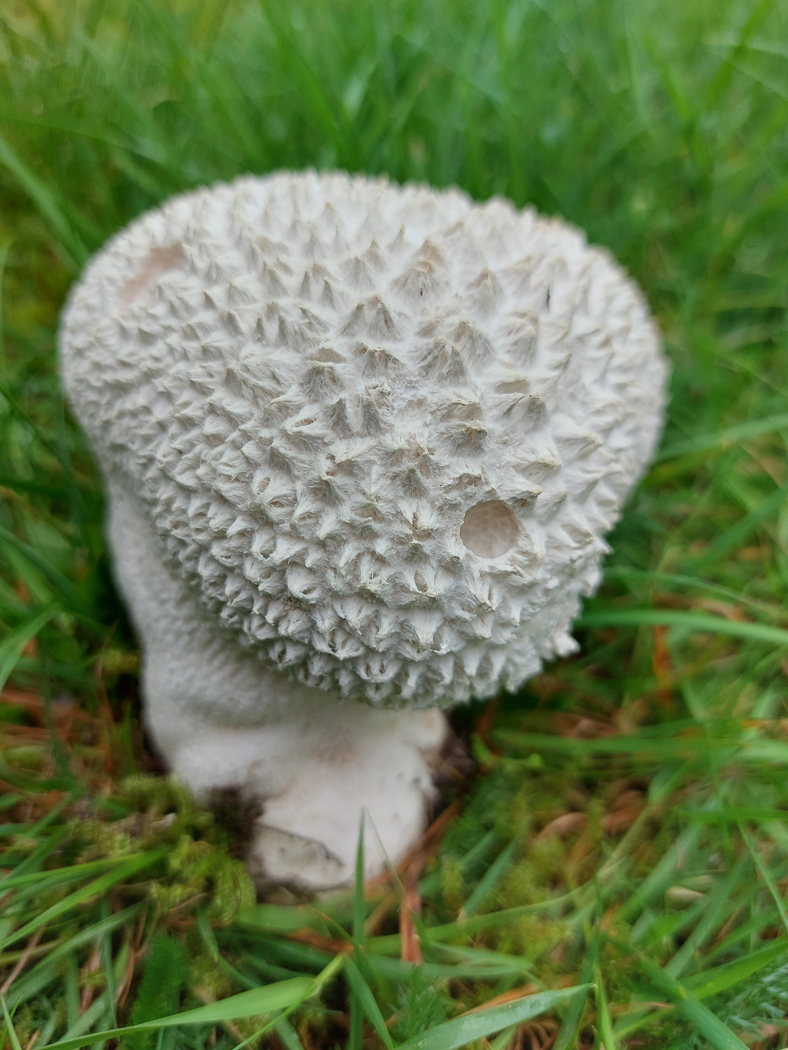
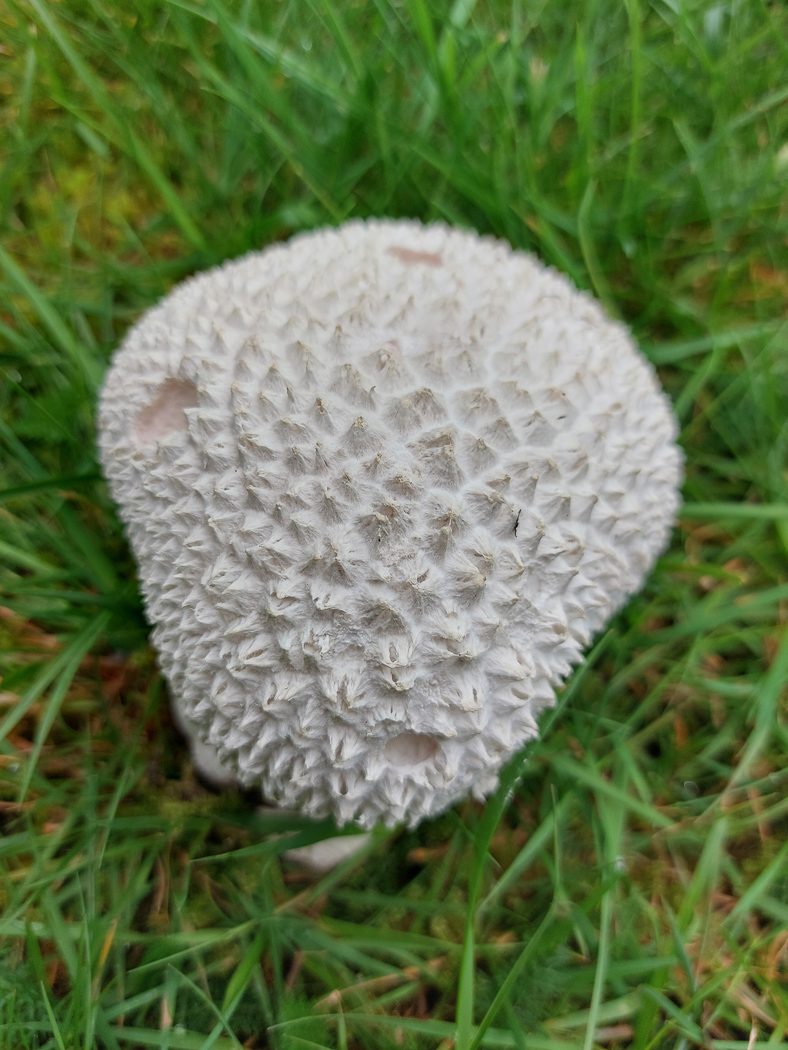 |
May 8th Bovistella utriformis (Mosaic Puffball)
Jesper Launder spotted this surprisingly early fruiting of a puffball on a grassy verge in Gerrards Cross. For some authors in genus Lycoperdon where it may be better placed (and before that in both Handkea and Calvatia!), this is a large puffball reaching up to 15 cm across when mature (though immature and far smaller than that here) it has a very thick short stem and is covered in distinctive white polygonal spines which gradually disappear as it ages and turns brown as the spores ripen within. Our earliest county record is September though there are a smattering of national records from as early as April. It favours sandy grassy habitats in neutral or slightly acidic soils.
|
May 2nd 2023
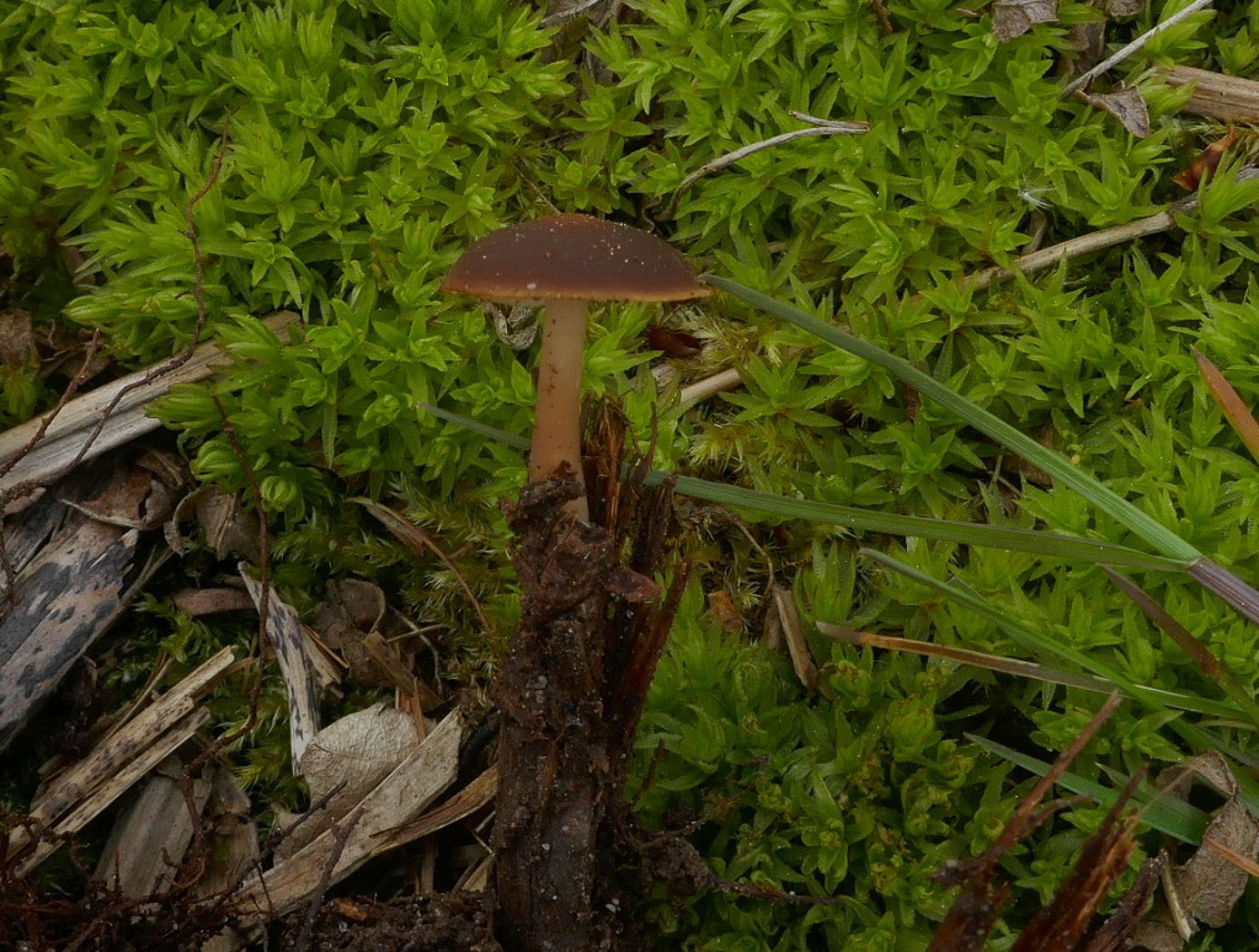
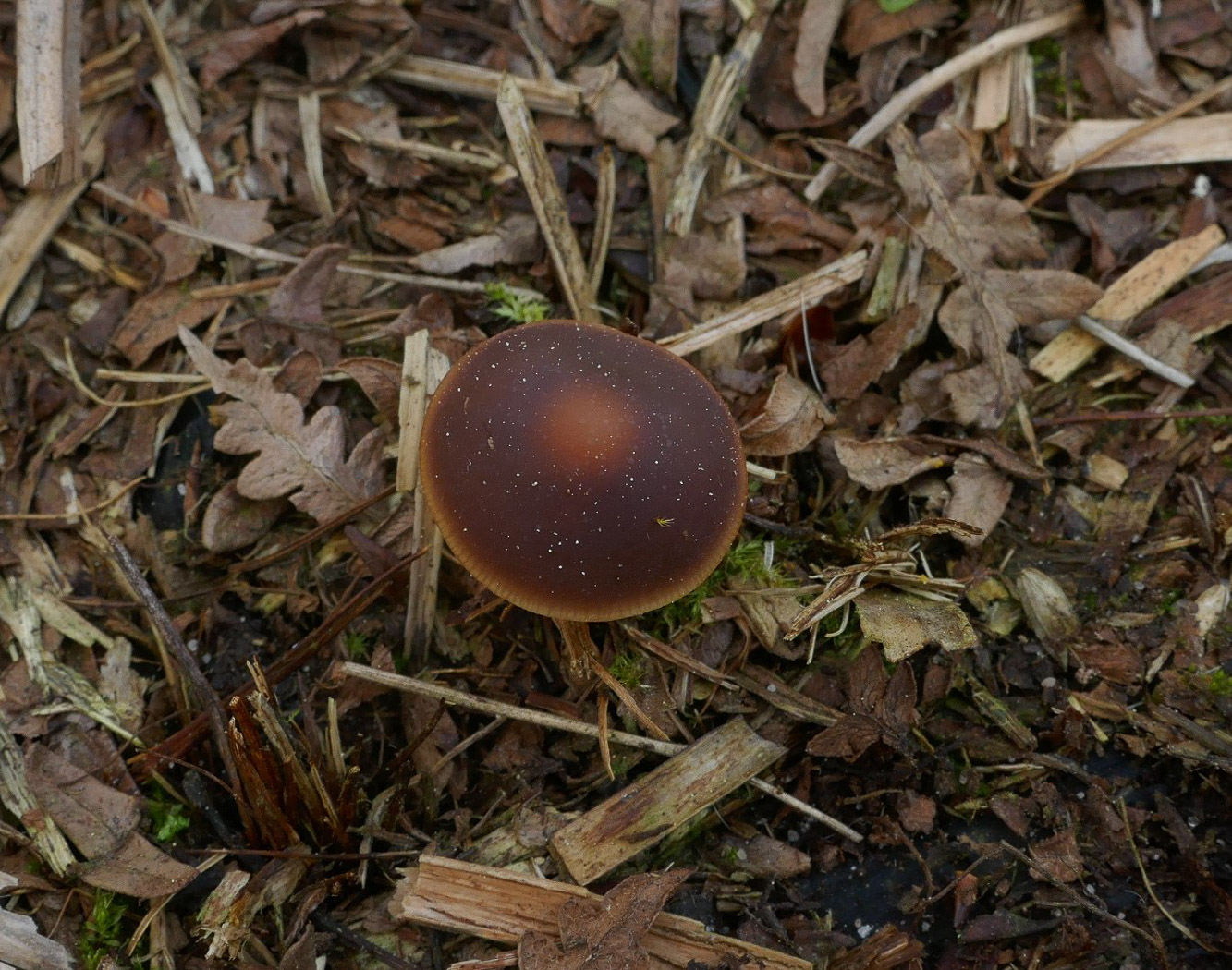
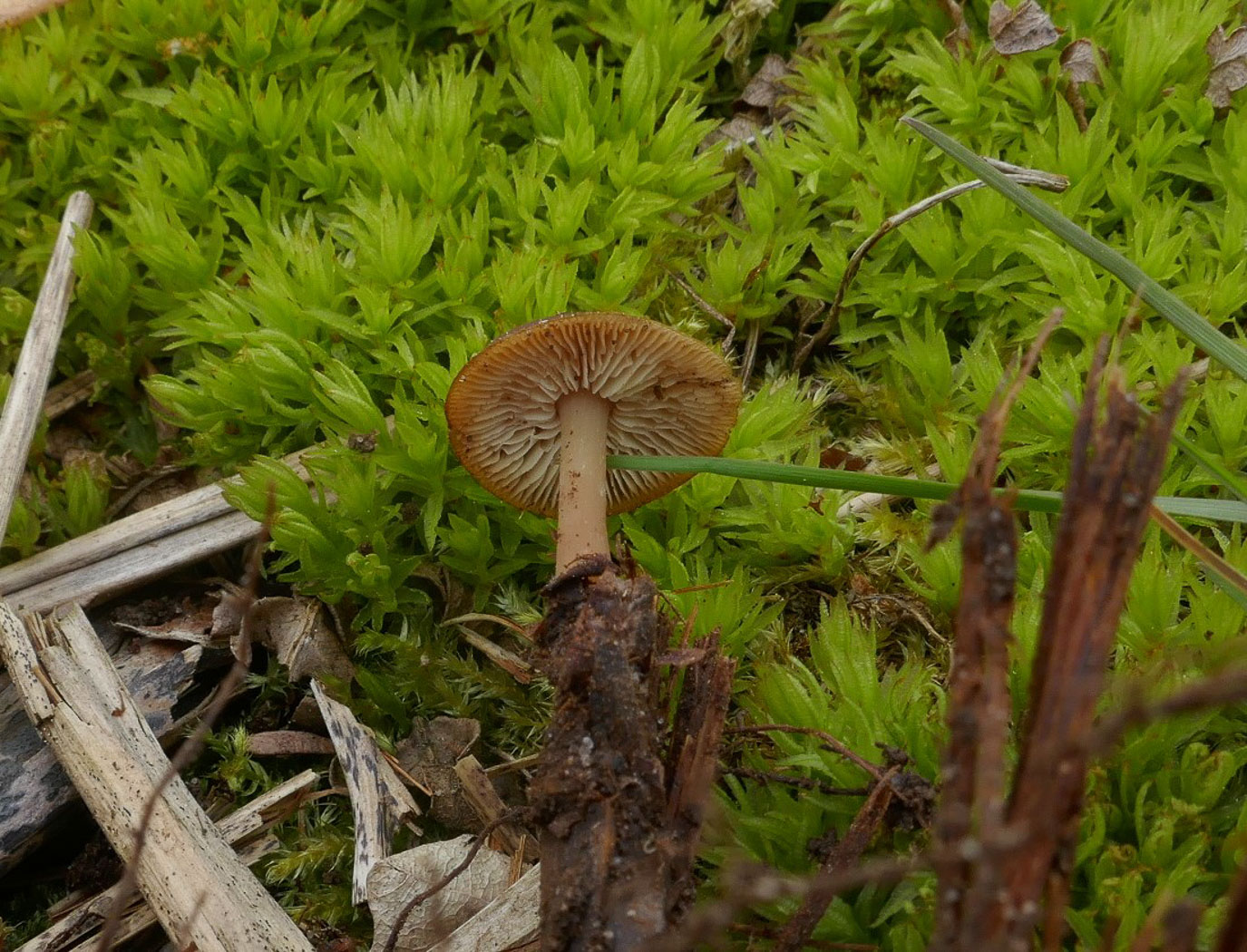 |
May 2nd Gymnopus ocior (Spring Toughshank) 
At Stampwell Farm Jackie Ewan found this rather unusual Toughshank growing amongst Bracken litter. Somewhat similar to G. dryophilus (Russet Toughshank) which is much more common but also tends to fruit early in the season, today's species had a much darker richer russet cap and the gills tend to have a yellow tint - sometimes markedly so but sometimes missing also as here. The two species are easily confused and unfortunately microscopic details are very similar and therefore not much help! See the Masterlist for images of both species for comparison.
|
 |
May 2nd Marasmius oreades (Fairy Ring Champignon)
In a sports field in Chesham Greg Douglas found this common summer grassland species just making an appearance - we also have an even earlier fruiting of this on April 14th. See the Masterlist for more examples and further comments.
|
April 29th 2023
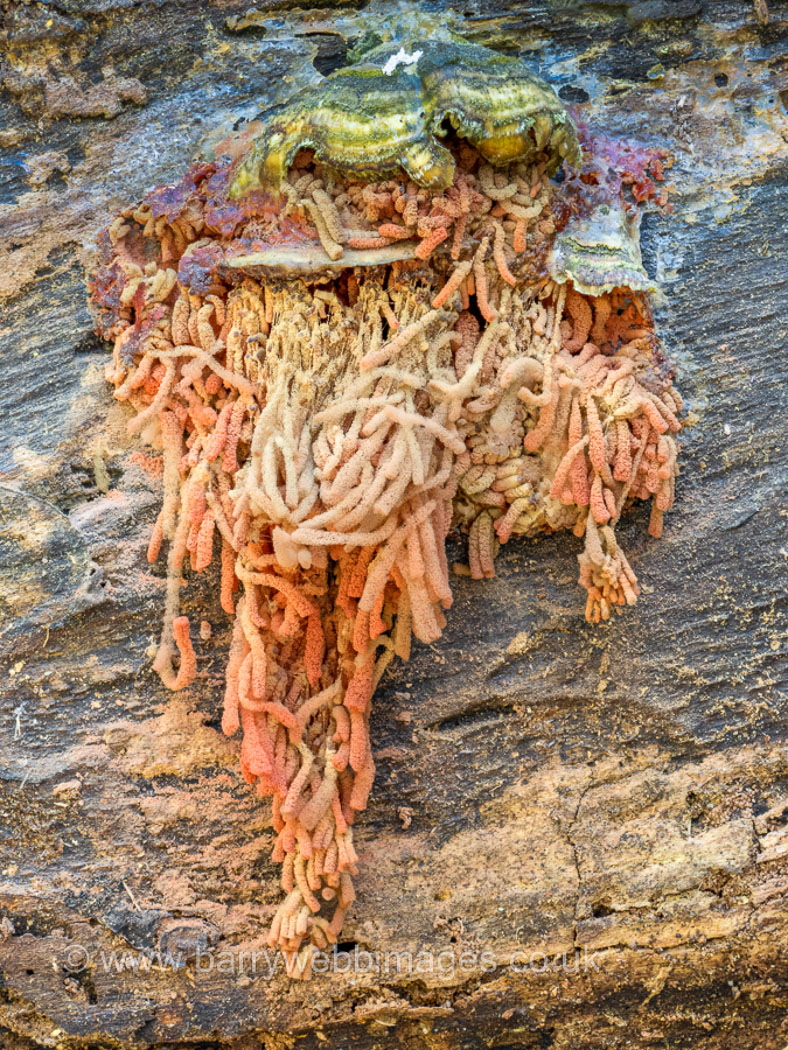 |
April 29th Arcyria oerstedii (a rare Slime Mould with no common name) 
At Burnham Beeches prior to our BFG Walk Barry Webb found this somewhat drooping species on some damp bare fallen wood. He suspected right away that it was unusual as the only other Arcyria known to droop, A. obvelata - a fairly common species he knows well, is yellow with no pink as seen here. Myxo guru Edvin Johanessen, when consulted and on seeing the photo, suggested it might be A. oerstedii which Barry then confirmed by checking the microscopic details. This is new to the county with only 60 UK records on FRDBI but was identified too late to make Penny's Burnham Beeches report, hence its inclusion here.
|
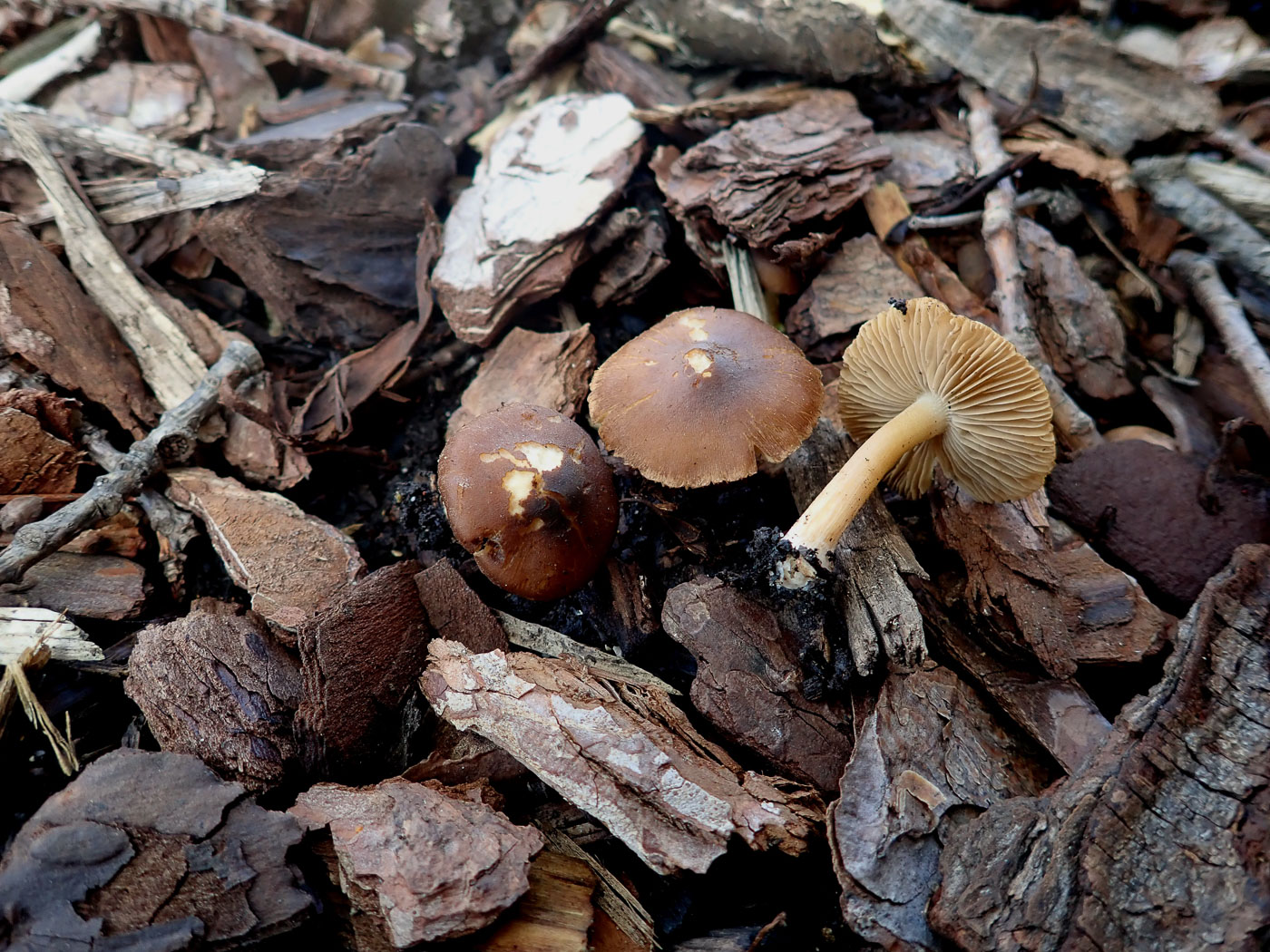 |
April 29th Inocybe cf tjallingiorum (a rare Fibrecap) 
After a tip-off from Jesper Launder that in Gerrards Cross under Oak he'd seen yet another large collection of Fibrecaps (see also the entry for April 26th), Penny went to collect some after our Burnham Beeches Walk - where we also found a Fibrecap (see her report for more). Inocybe is an autumn fruiting mycorrhizal genus and quite remarkable to be fruiting now! Today's collection keyed out to near I. tjallingiorum, a rare species and one which has not been confirmed with sequencing from this country as yet (hence the 'cf' in the title here). However, sequencing has now shown it to be clearly not that species and with no known matches, making it potentially new to science.
|
April 28th 2023
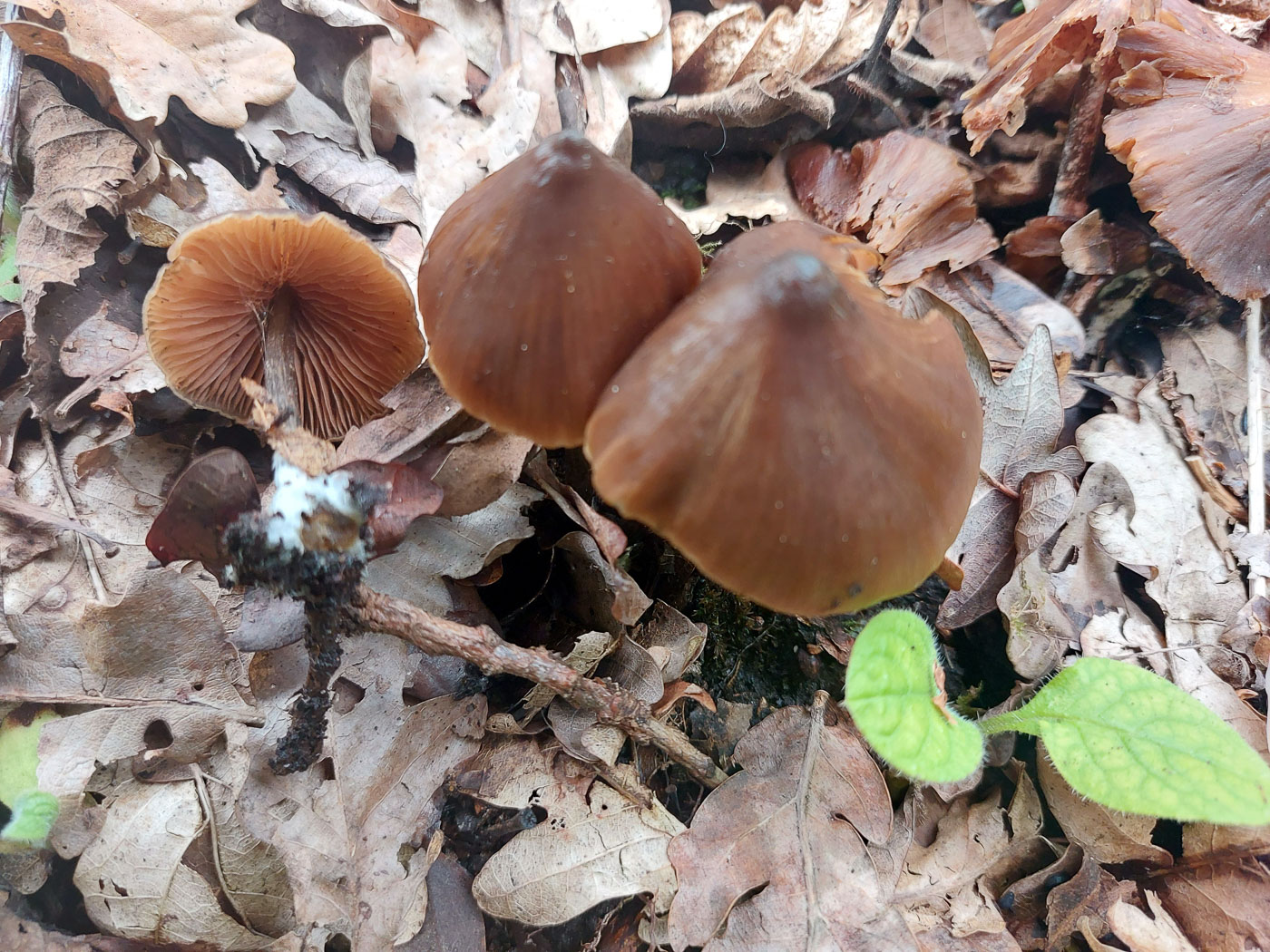
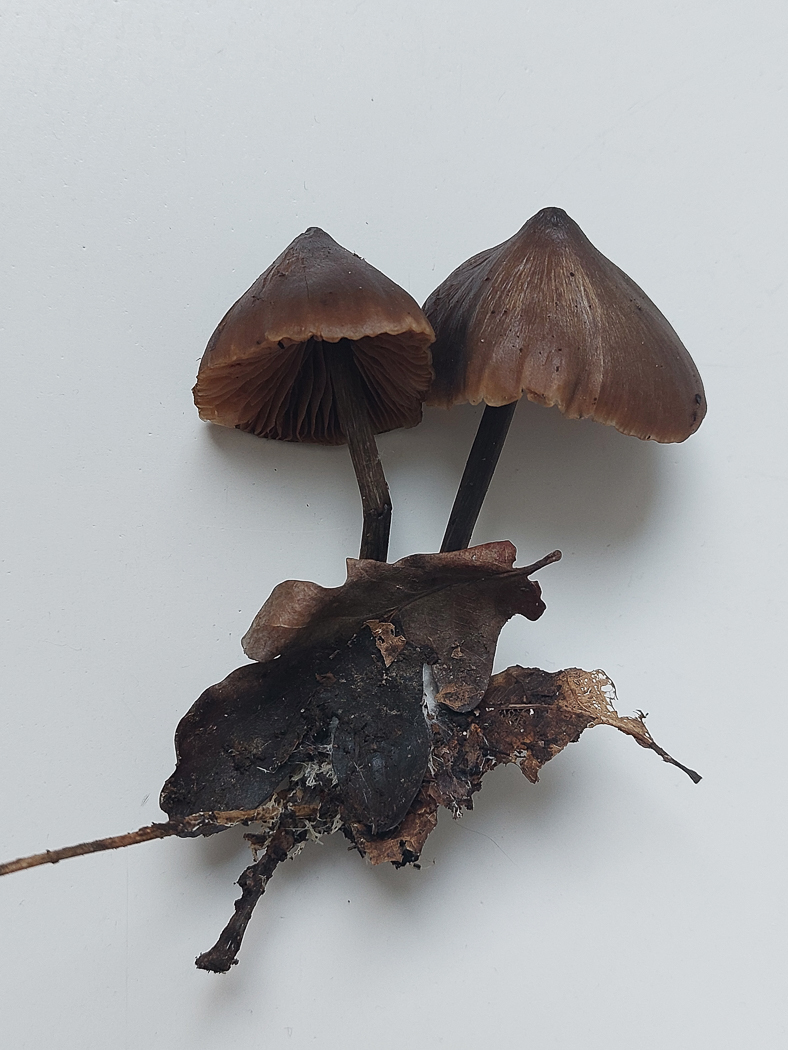 |
April 28th Entoloma hirtipes (an uncommon Pinkgill with no common name) 
In Gerrards Cross amongst well rotted leaf mulch near a footpath Jesper Launder noticed this small cluster of Pinkgills. The smell was intriguing and difficult to define so he took it home to work on. Microscopic details are essential for this genus and even with these many collections go unnamed. However, the dark brown colour, small umbo, occurrence often at this time of year plus the micro details all pointed to this species, confirmed by its smell described as strongly farinaceous-rancid to fishy! See also Finds 2021 December 30th.
|
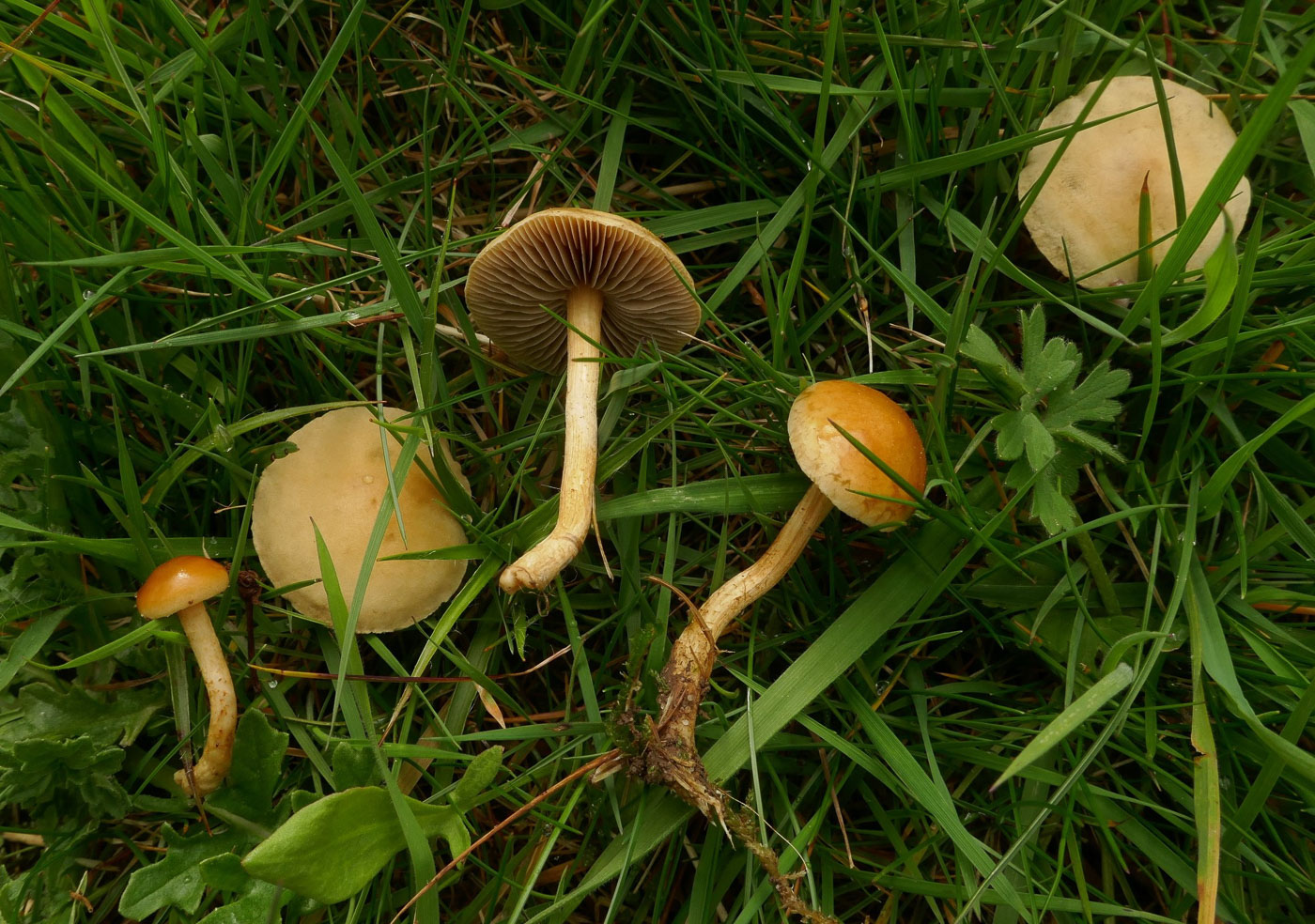 |
April 28th Agrocybe pediades  (Common Fieldcap) (Common Fieldcap)
At Stampwell Farm in an orchard Jackie Ewan found the first fruiting of this early summer season grassland species - one that she knows well and which is very common here. See the Masterlist for more examples and further comments.
|
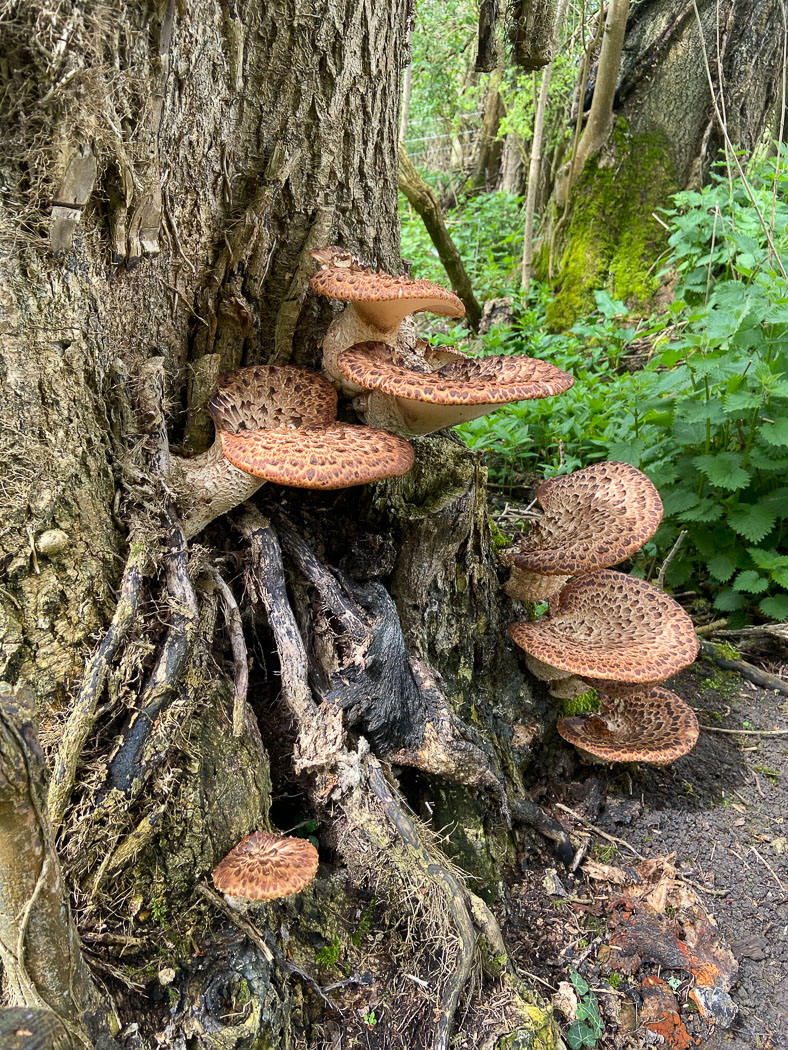
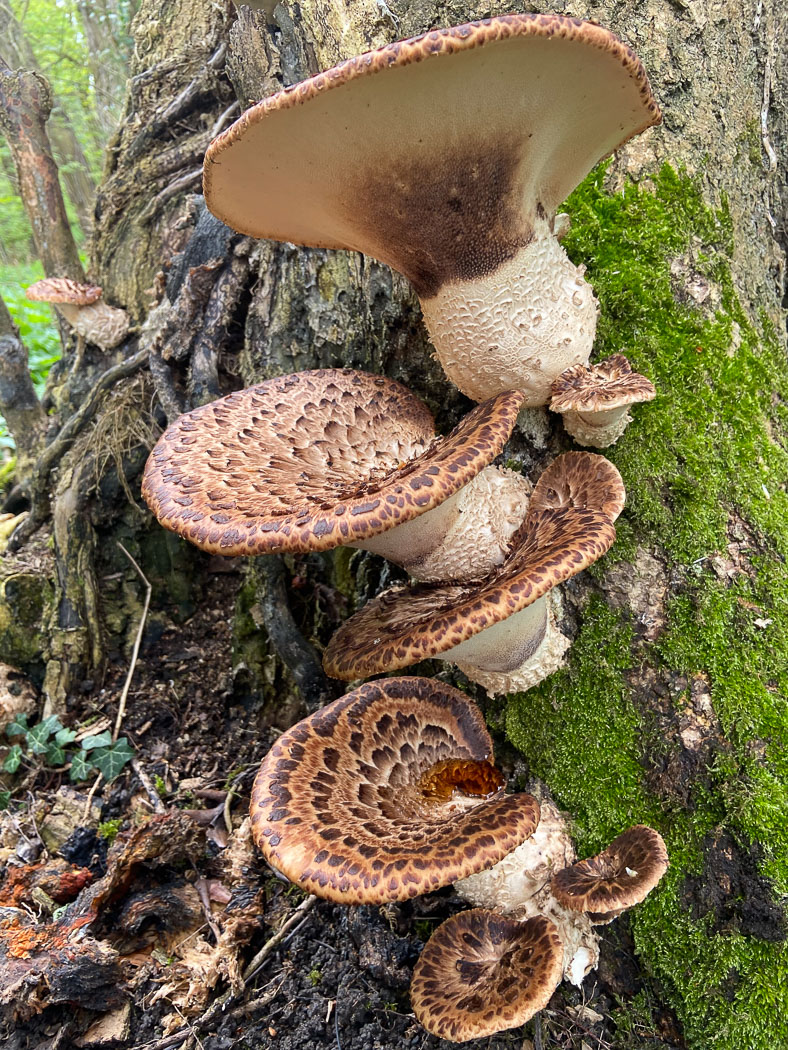 |
April 28th Cerioporus squamosus (Dryad's Saddle)
In Lowndes Park, Chesham, Sarah Ebdon saw this beautiful display at the base of a deciduous tree and just had to take these images! Better known under its previous genus name Polyporus, this is by far our largest Polypore and though immature and only about 15 cms across here, each 'saddle' can reach 2ft across or more - certainly big enough to sit on! It favours Ash but is not uncommon on other deciduous trees and is commonly found on the ground having fallen from its original fruiting place in the tree canopy.
|
April 26th 2023
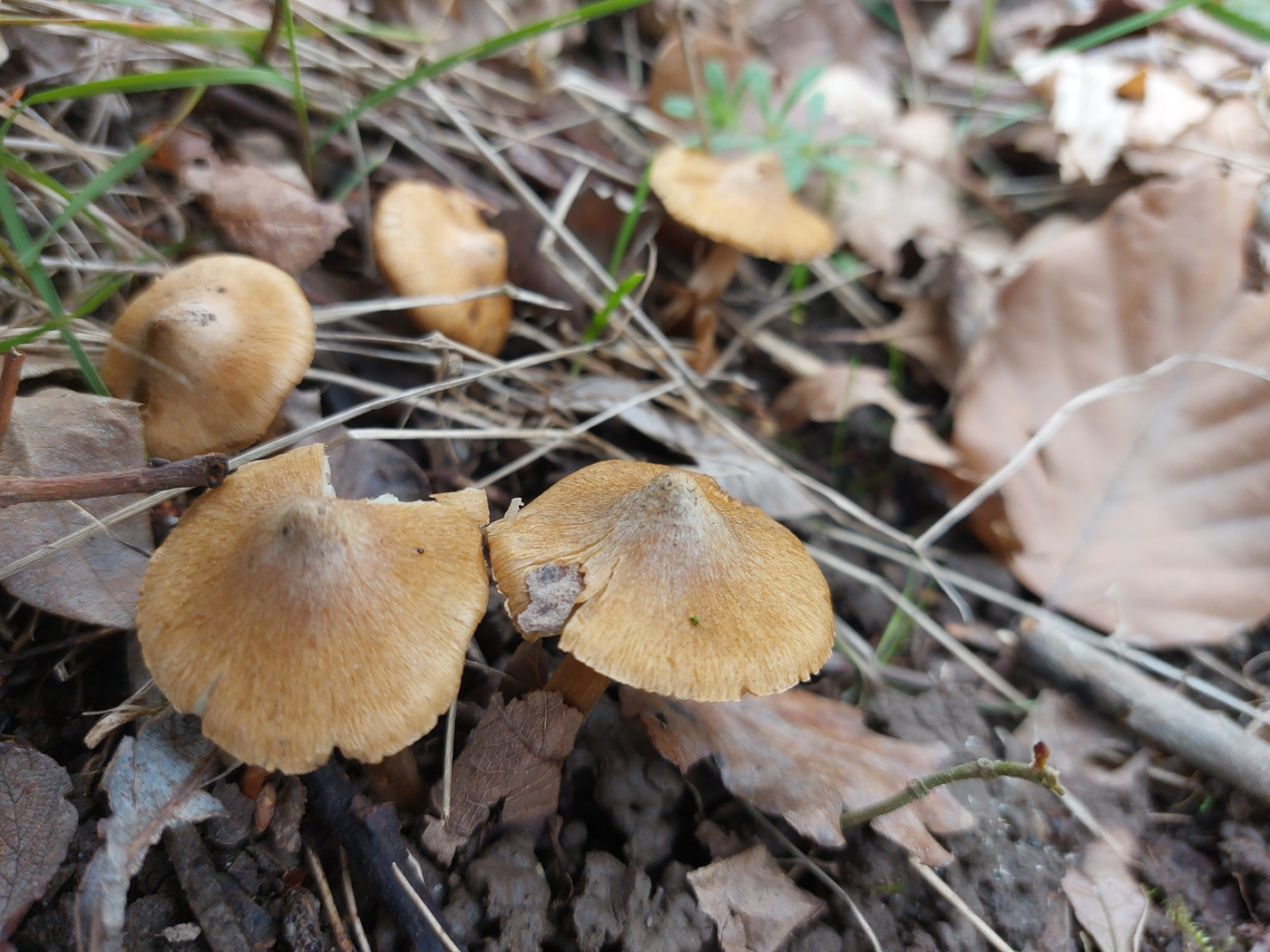 |
April 26th Pseudosperma flavellum sl. (a rare species of Fibrecap) 
Under Willow on the Oakland Park golf course, Chalfont St. Giles, Jesper Launder was astonished to find quantities of a Fibrecap fruiting at this time. Penny has never found Fibrecaps in April and obtained the material to attempt an ID. P. flavellum (previously in genus Inocybe) is a recognised complex of species (as indicated here by 'sl' - sensu lato, ie in the general sense) and still not fully sorted out even with DNA. It is doubtful if the species we find in the UK under Willow and Poplar is the genuine P. flavellum as originally assumed, and that name should possibly be assigned to the alpine species within the complex. Sequencing has now confirmed today's collection as matching that of 'Inocybe cfr flavella' - a member of the complex yet to have a separate name.
|
April 25th 2023
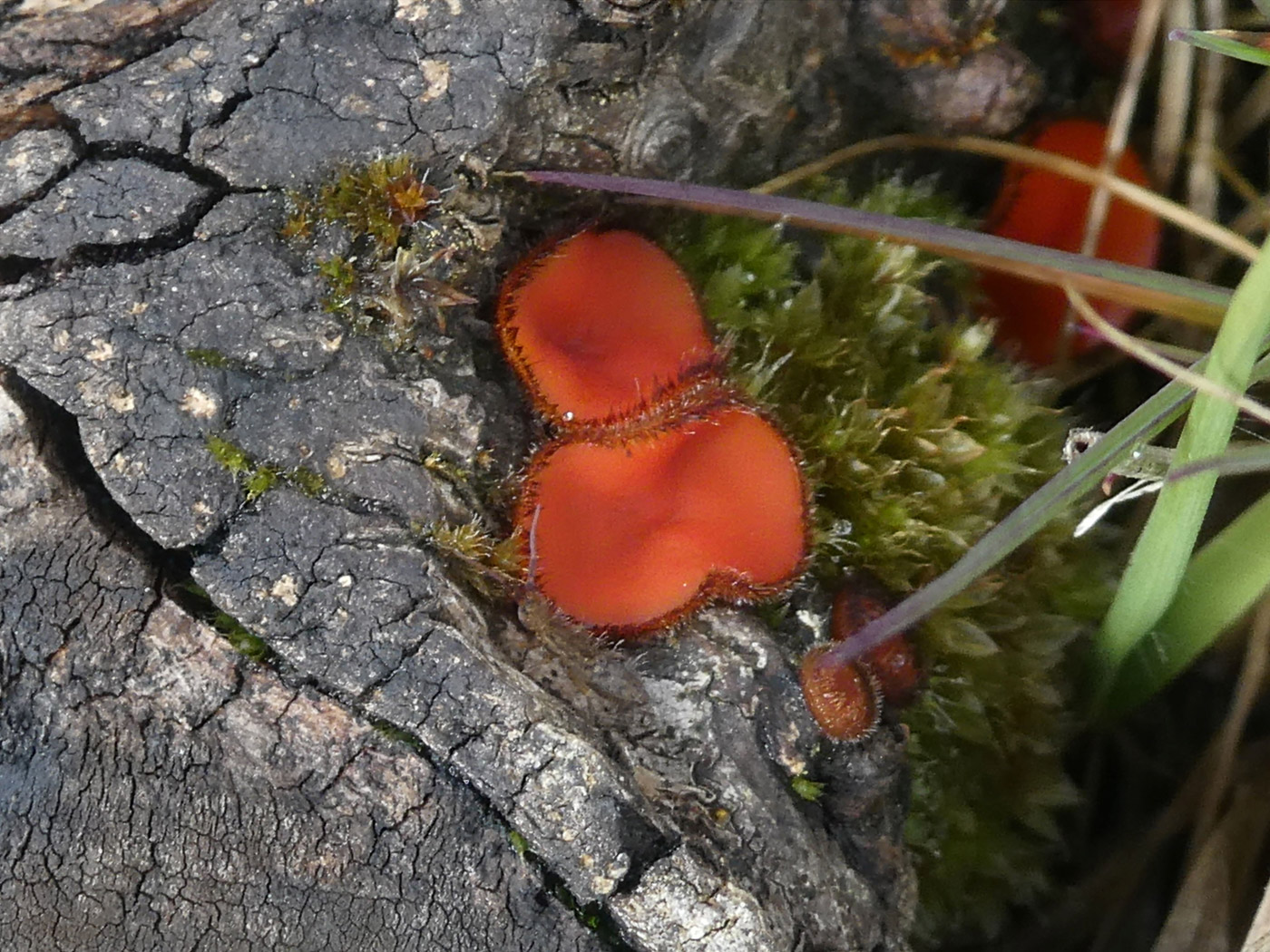
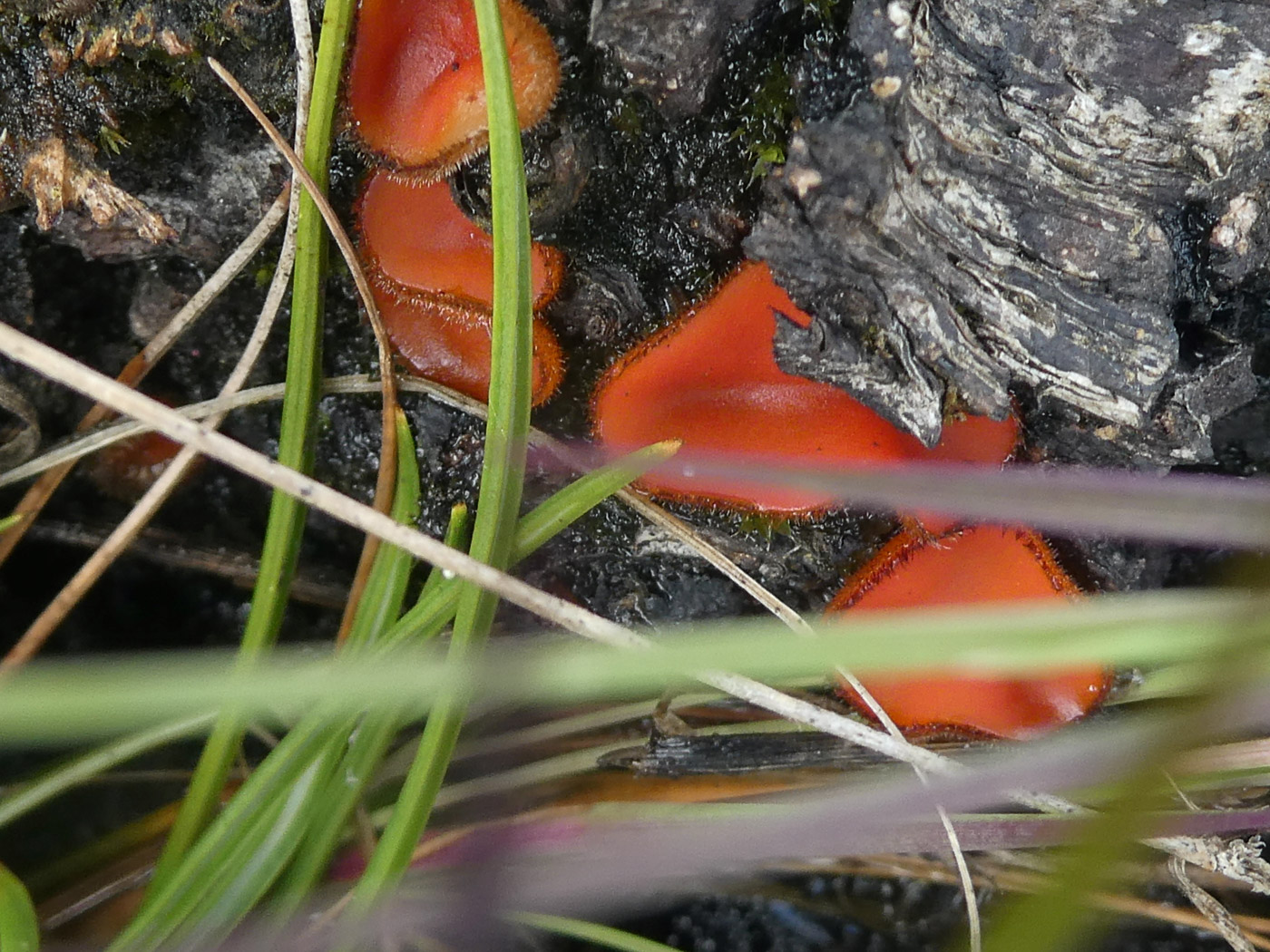
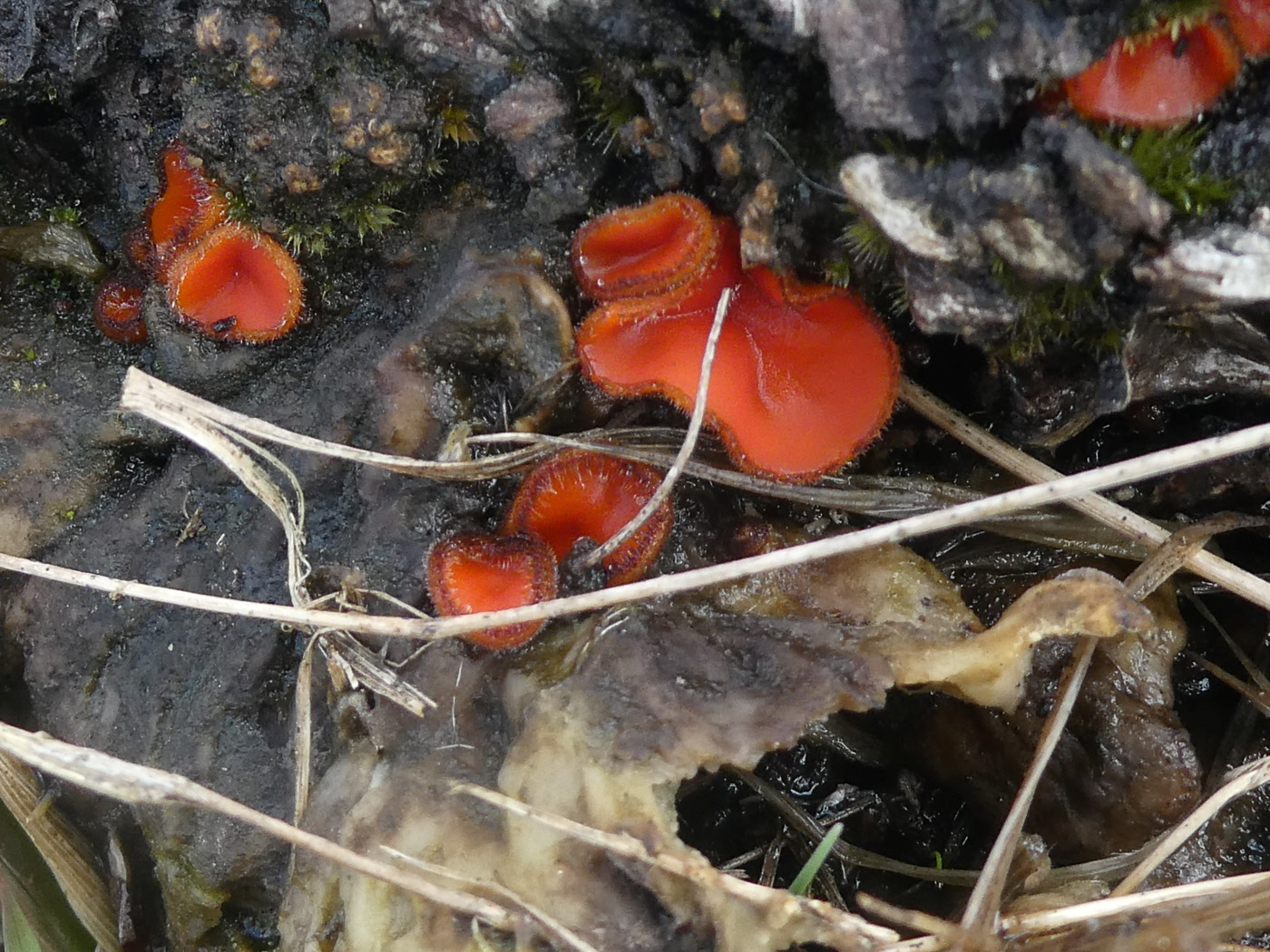 |
April 25th Scutellinia vitreola (a very rare Eyelash with no common name) 
In Stoke Common on some Birch stumps Jim Wills found these tiny Eyelash fungi, only 5mm across at most, and took them home to work on. Following any key for this genus is no easy task and he was very unsure despite finding the relevant features. Penny and Derek also failed to come up with anything definitive after consulting with expert Malcolm Greaves. The material was then dried and sent for sequencing with the result that this appears to be a new species for the UK (with no records in FRDBI under this name) though there still remains some confusing evidence in Unite and Genbank - the two sites which store all fungal sequences but which unfortunately also include many misidentifications. Sorting out the wheat from the chaff can be a complicated business!
|
April 24th 2023
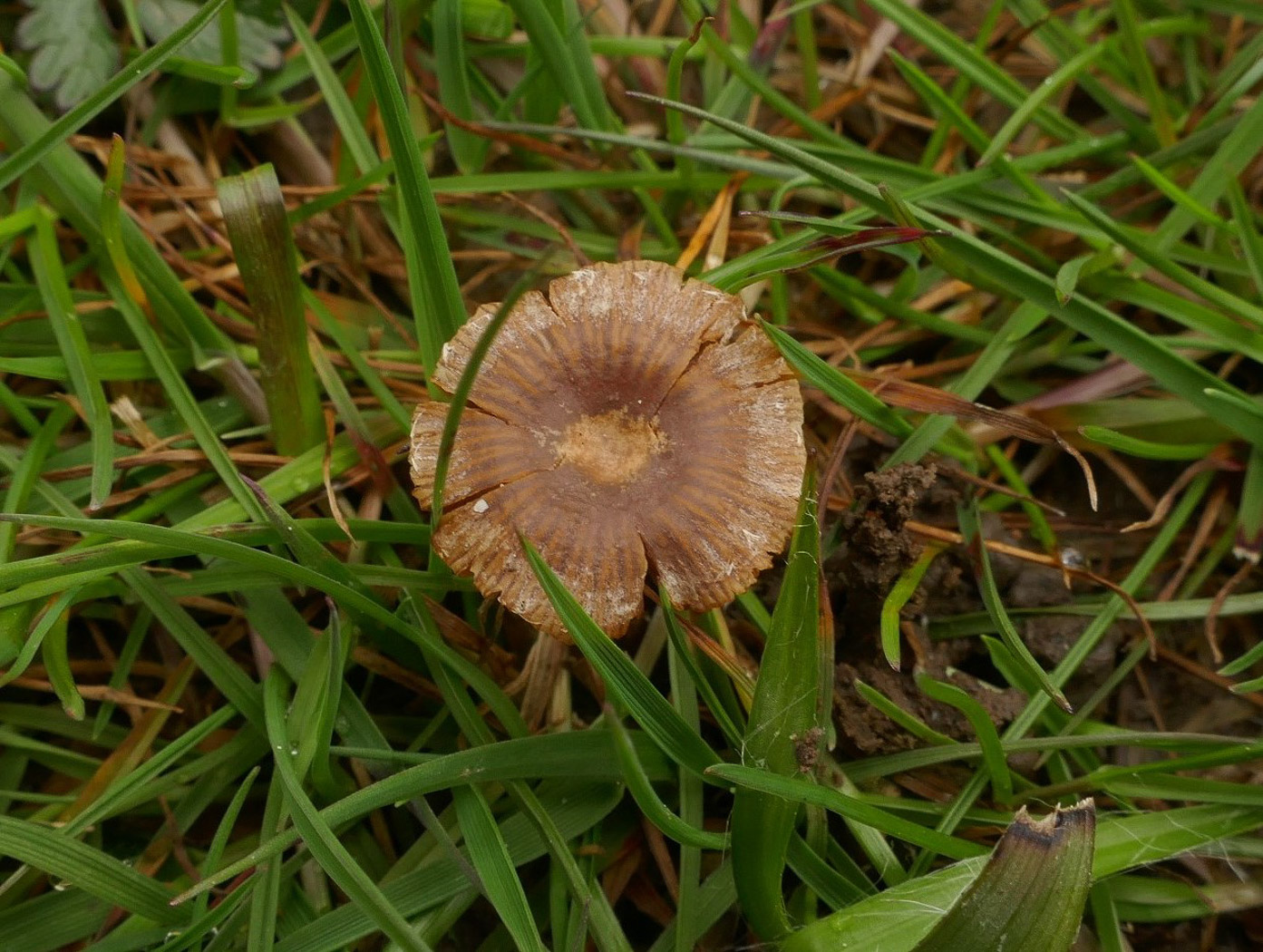
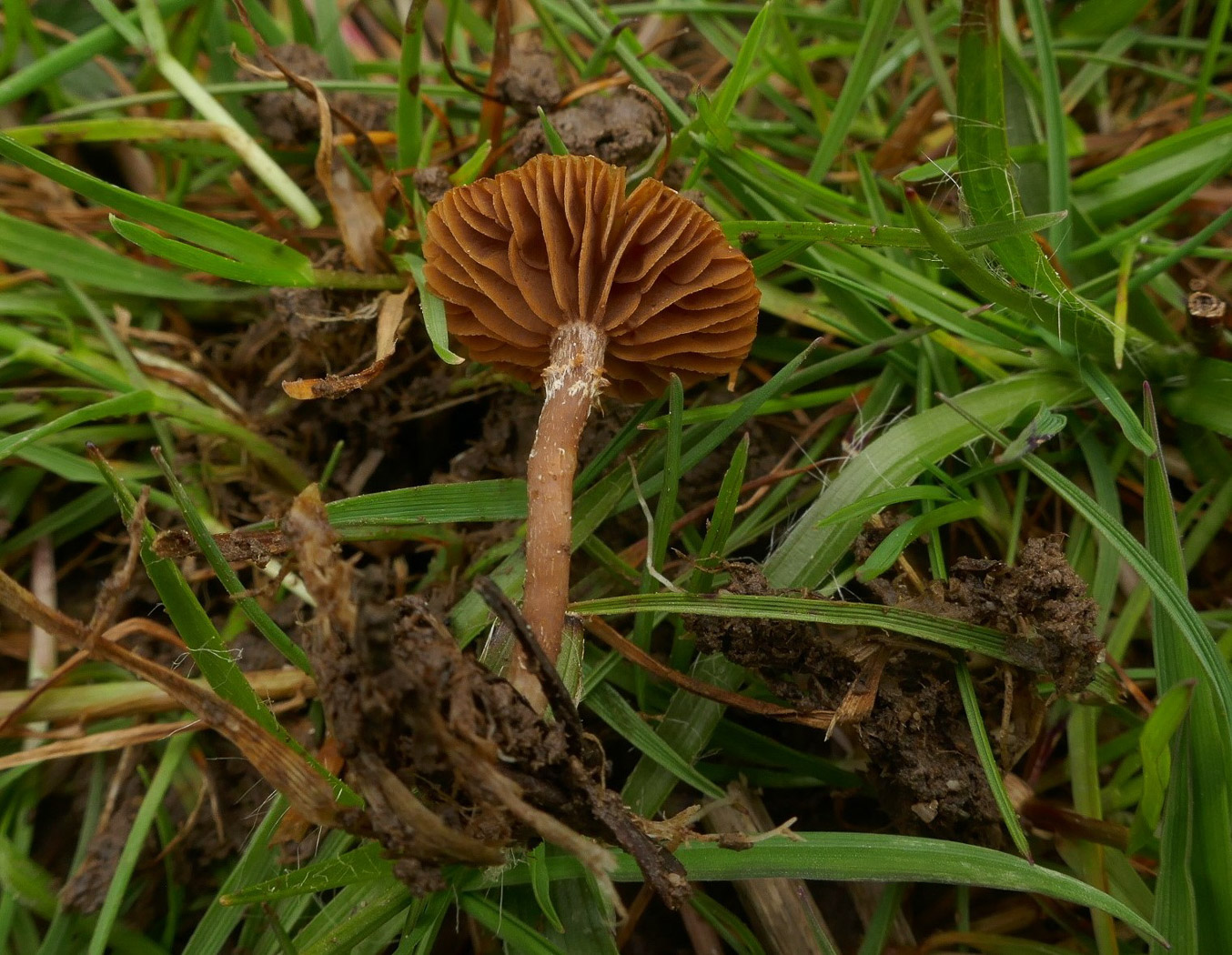 |
April 24th Tubaria conspersa (Felted Twiglet) 
At Stampwell Farm Jackie Ewan found this singleton LBJ in the same grassy spot where it occurred last year. Very similar to and possibly equally as common as T. furfuracea, also found on the same substrate with woody debris, the cap tends to have more white flecks of veil distributed over a wider area than in that species, these also on the stem as well.
|
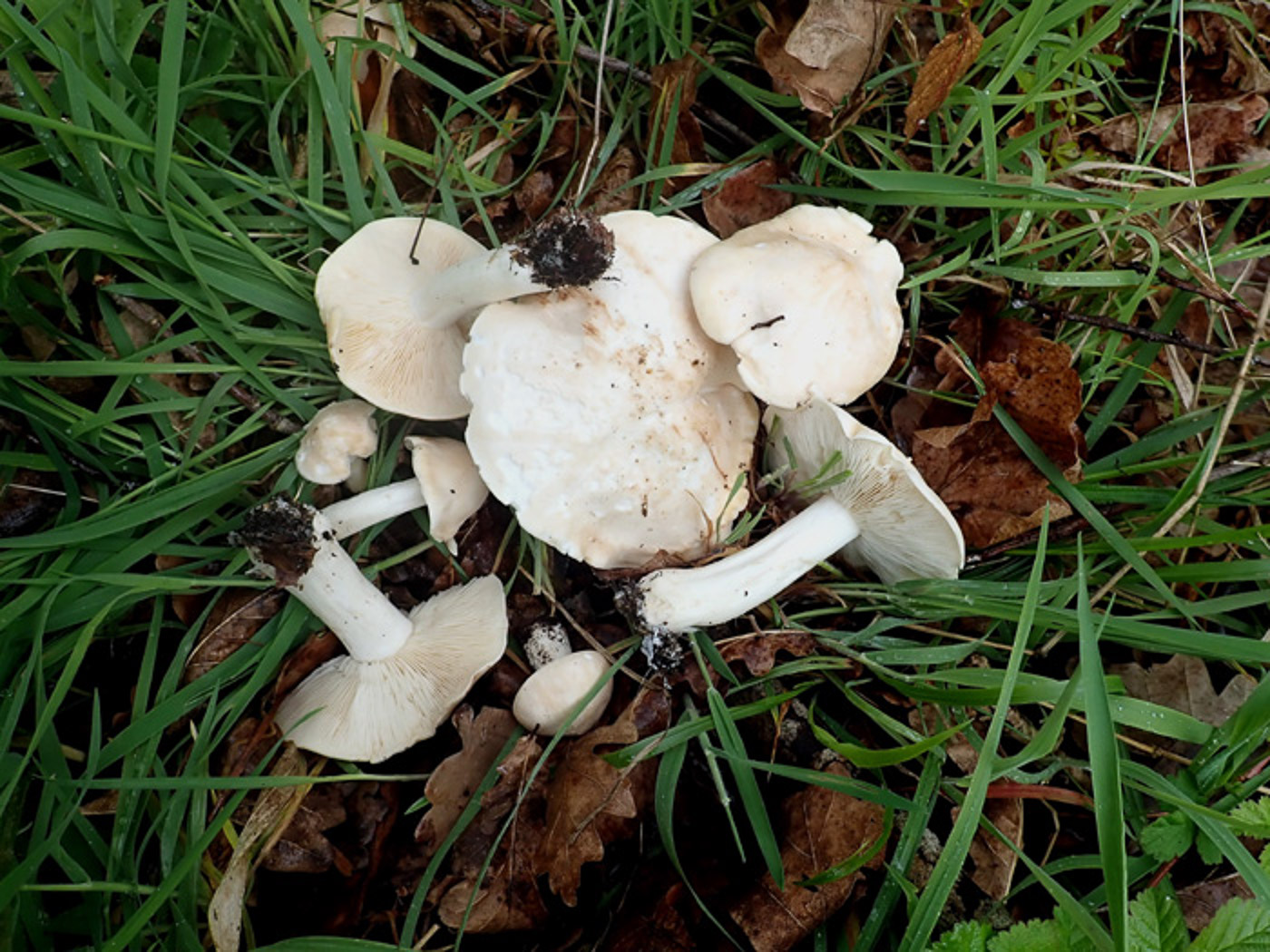 |
April 24th Calocybe gambosa (St. George's Mushroom)
True to form, this species was fruiting magnificently at Rushbeds Wood today - found by Penny just one day after St. George's Day! On our BFG visit here a few weeks ago it was only at the button stage but the caps today were up to 8-9 cms across and once a few were disturbed to arrange the photo there was a strong mealy smell in the air. Though some species recently have been a bit of a surprise to find fruiting now, this is one which can virtually always be relied on at this time - it is certainly well named. See also in Finds a few weeks ago on April 1st, also 2021 May 18th and 2022 April 7th.
|
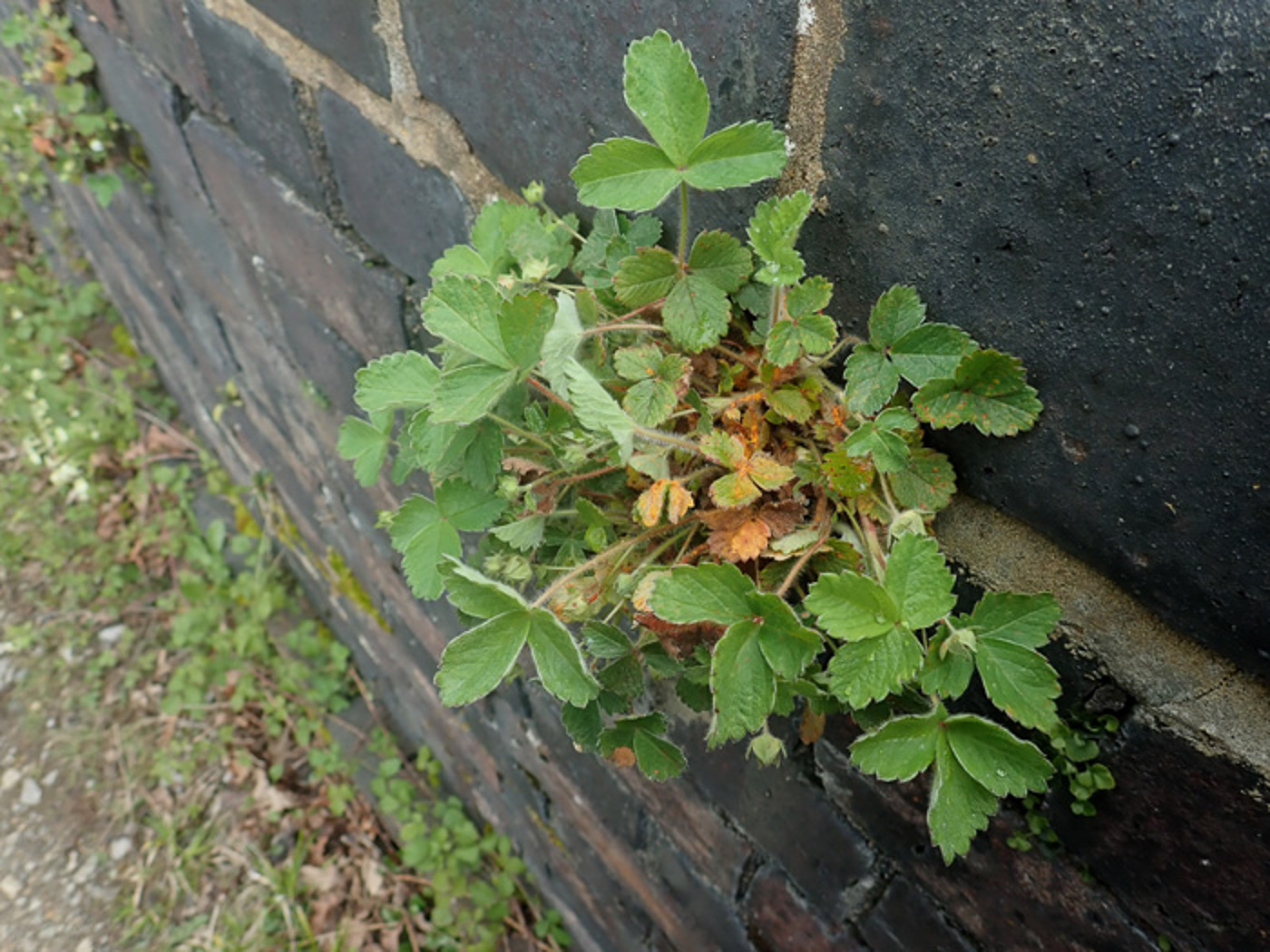
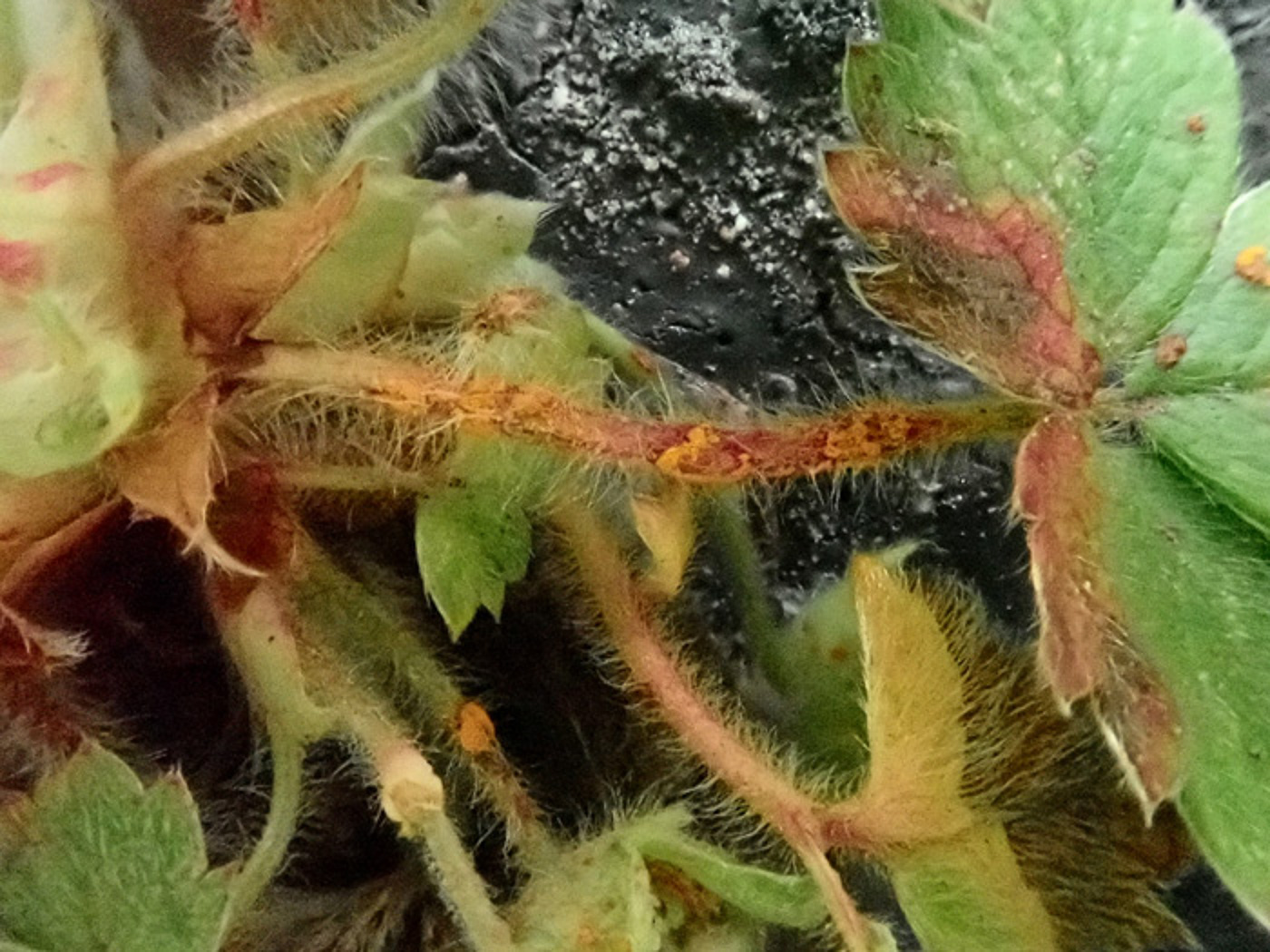 |
April 24th Phragmidium fragariae (a Rust species on Barren Strawberry)
At Rushbeds Wood Penny made a point of checking the wall of the railway bridge where this rust was found on our Springtime visit here last year. There is a story attached to this fungus at this site - see Penny's report for Rushbeds Wood April 16th 2022 for more. This a new entry for Finds - the previous 2022 April collection being on one of our walks therefore not eligible to be included. Though not rare we have only a handful of county records, the fungus be dependent on identification of the specific plant on which it occurs.
|
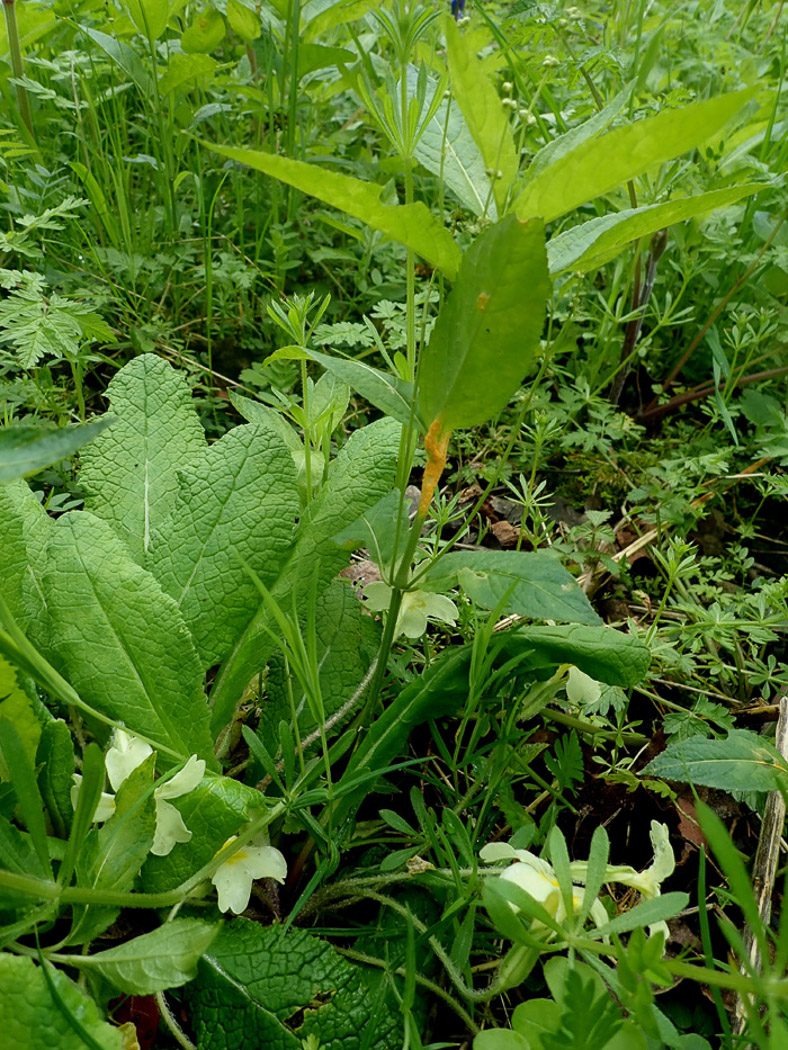
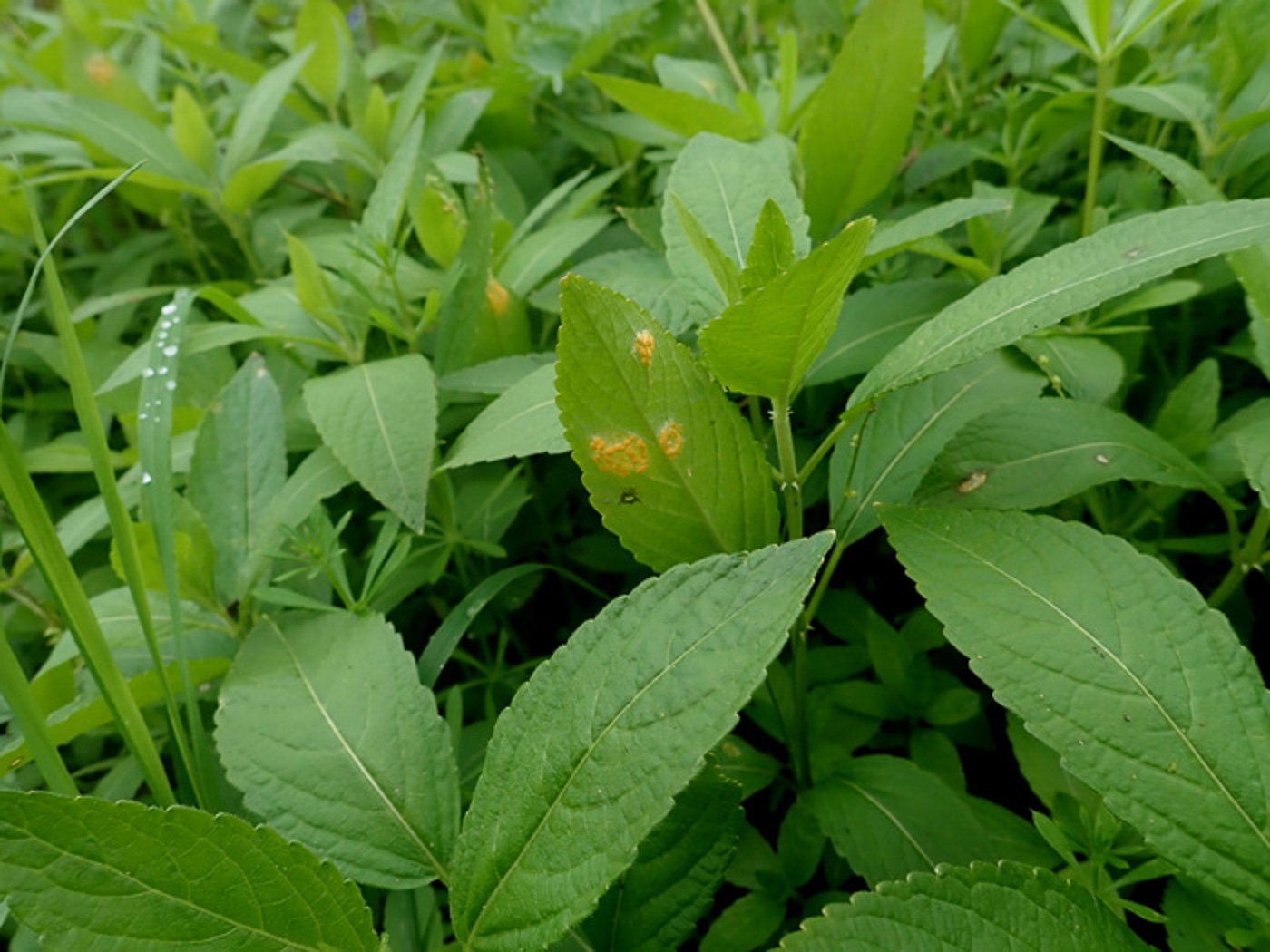
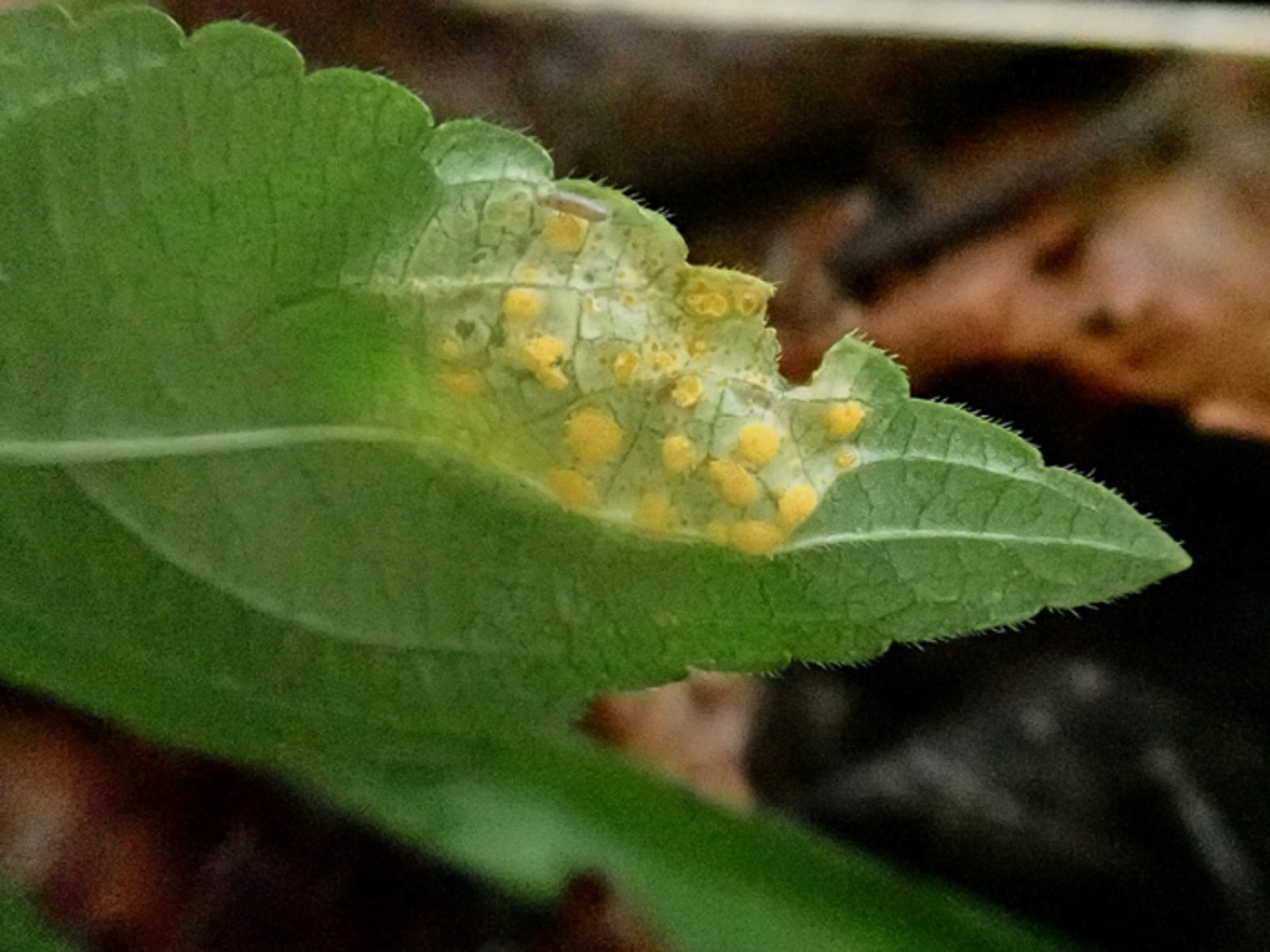
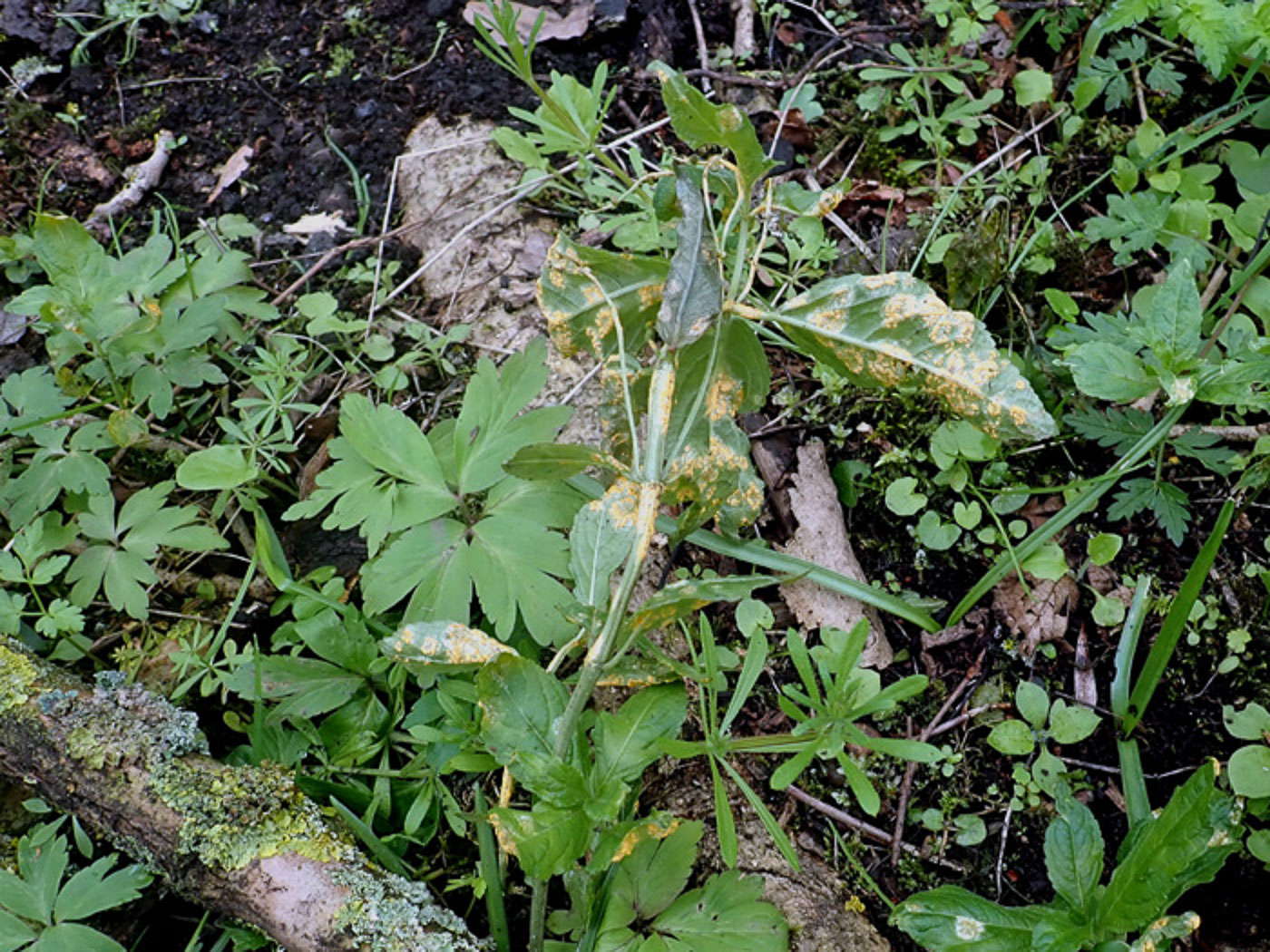 |
April 24th Melampsora rostrupii (Dog's Mercury Rust)
At Rushbeds Wood Penny found this common rust on many clumps of Dog's Mercury though it was not in evidence here when we visited a few weeks earlier. It affects both stem and leaves and eventually makes the plant look rather sick when it gets really established (photo 4) but plants seem to have no problem with reappearing the following year. Previously known as M. populnea, that name is now applied purely to the rust found on Poplar. See also Finds 2022 April 14th.
|
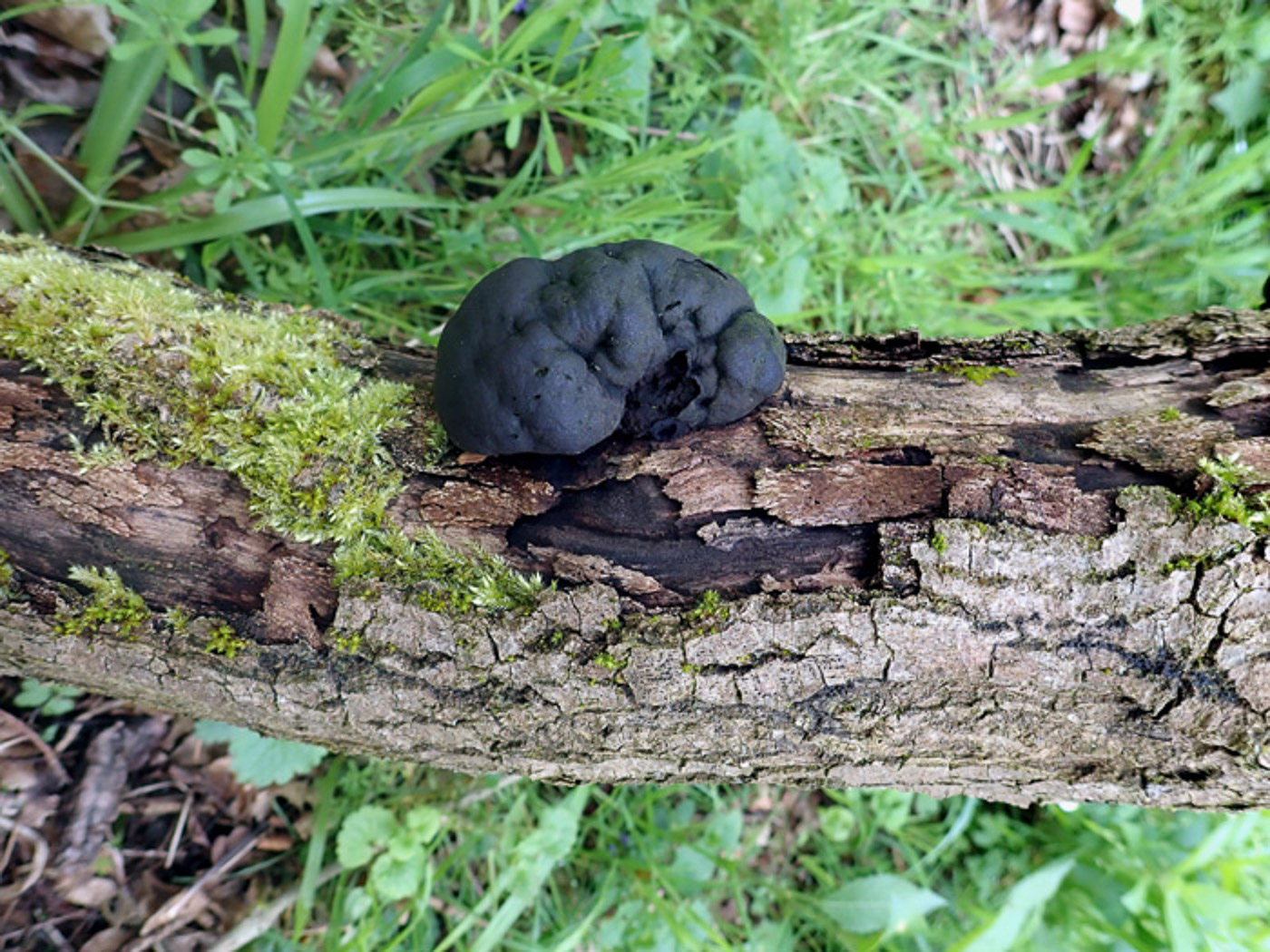
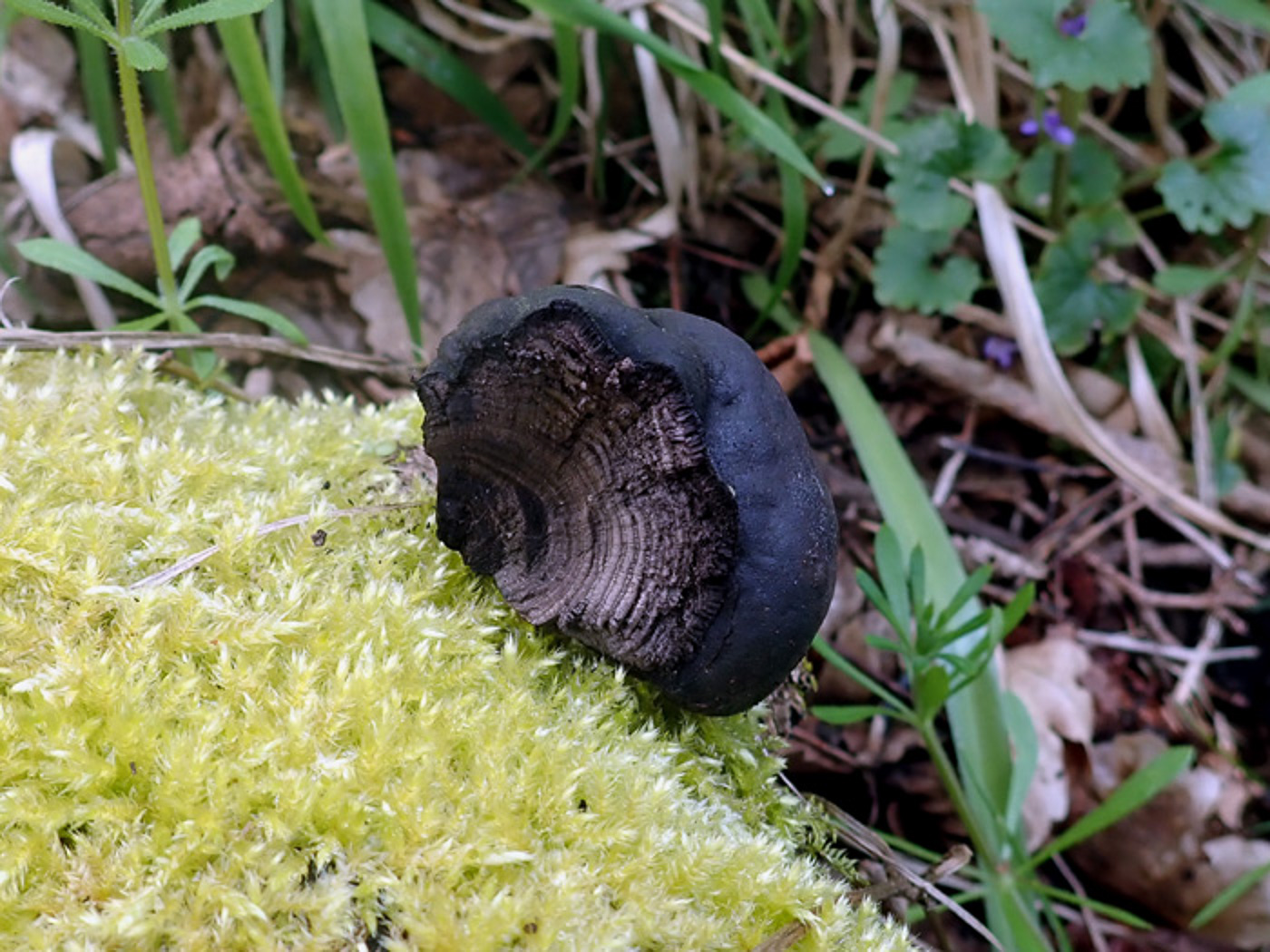 |
April 24th Daldinia concentrica (King Alfred's Cakes)
Penny noticed this very common species at Rushbeds Wood fruiting as it always does on fallen Ash. When fresh it is more cocoa brown, developing its 'burnt' appearance as here as it matures. Photo 2 shows the distinctive concentric rings within if one breaks a 'cake' open. See the Masterlist for more images.
|
April 19th 2023
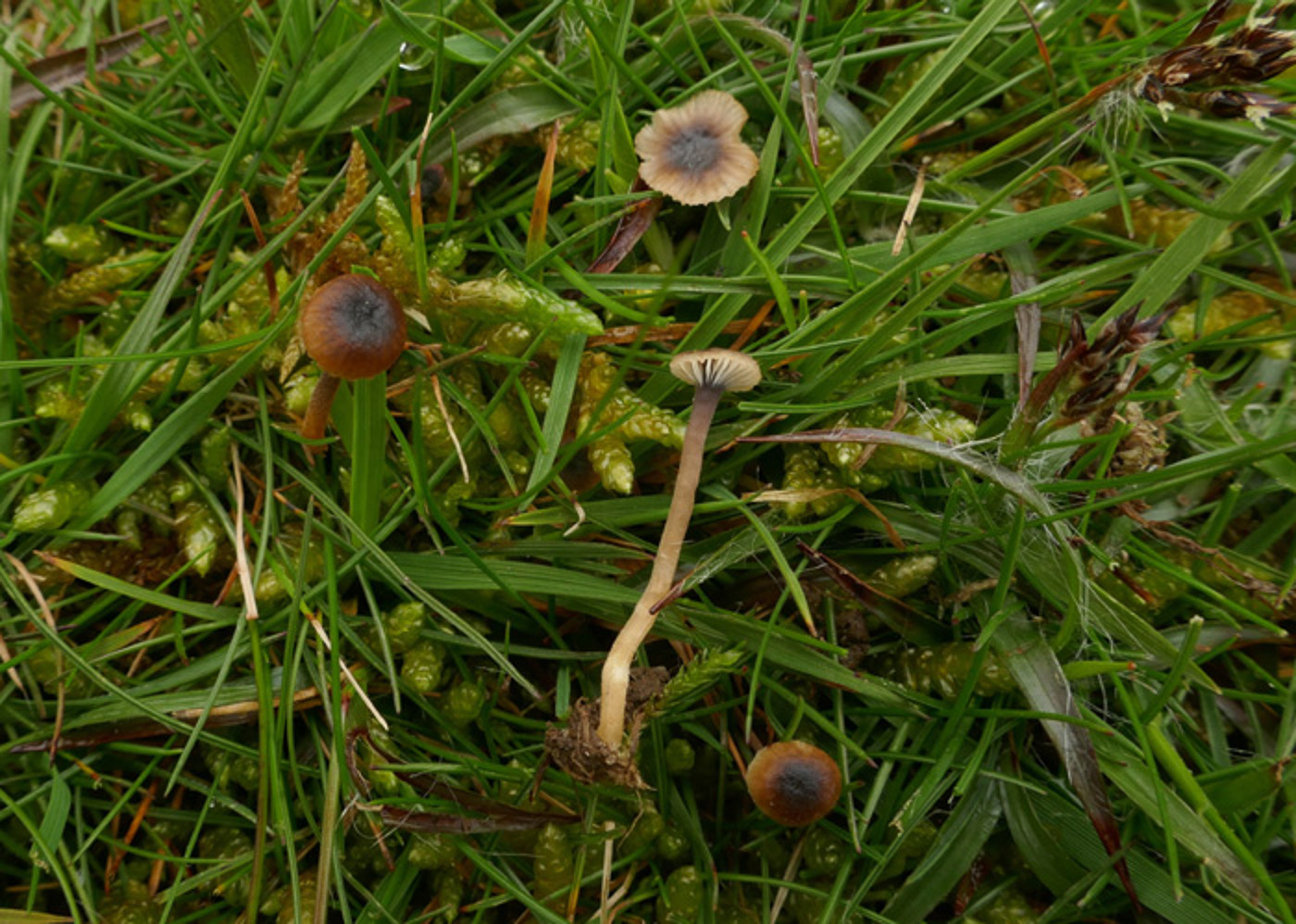
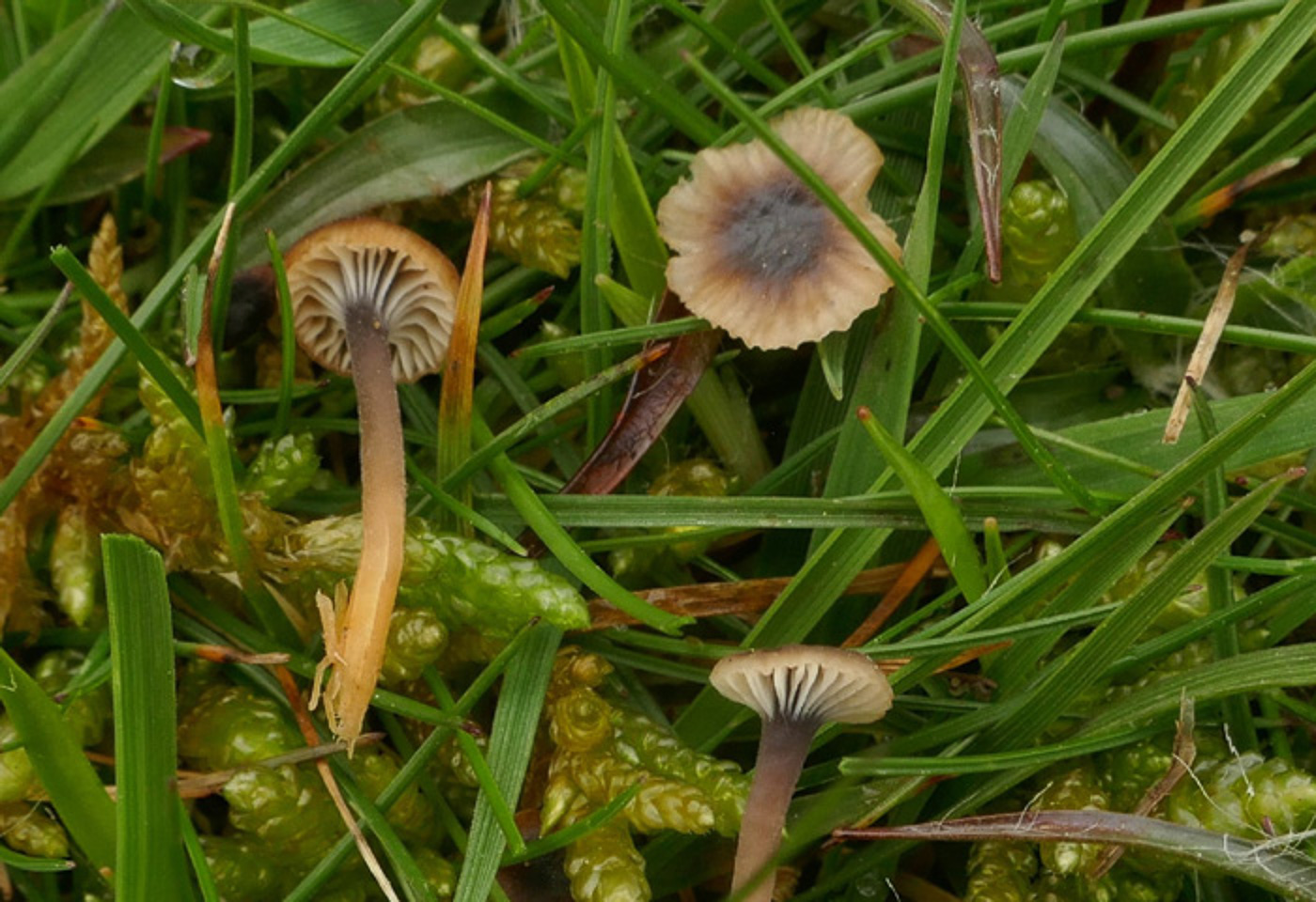 |
April 19th Rickenella swartzii (Collared Mosscap)
At Stampwell Farm in moss Jackie Ewan found these somewhat insignificant 'Mycenoid' mushrooms. The species could easily be mistaken for a small grassland Mycena and is far less common than the bright orange R. fibula (Orange Mosscap) but the decurrent gills together with the dark purplish area collaring the top of the stem make it an easy one to recognise once you're familiar with it. The caps are often not as brown as seen here, the paler specimens being more typical. This is BFG's first April record and we have just a few from June and January, the rest all from the Autumn months. See the Masterlist for more images.
|
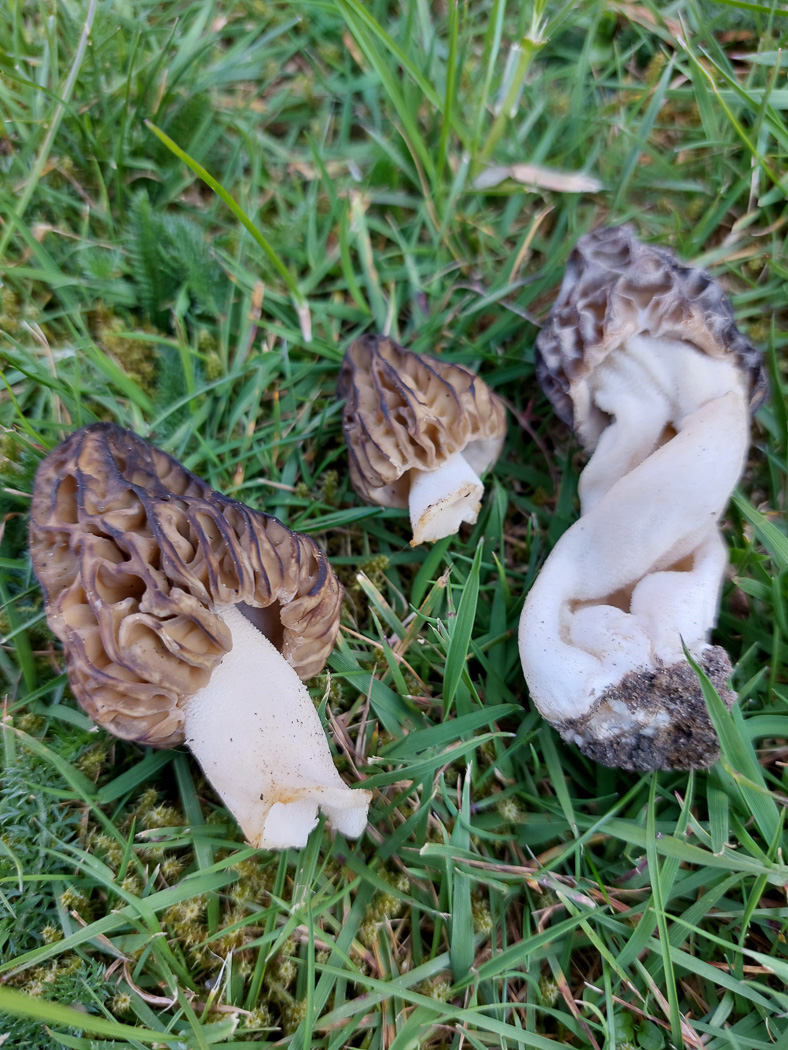
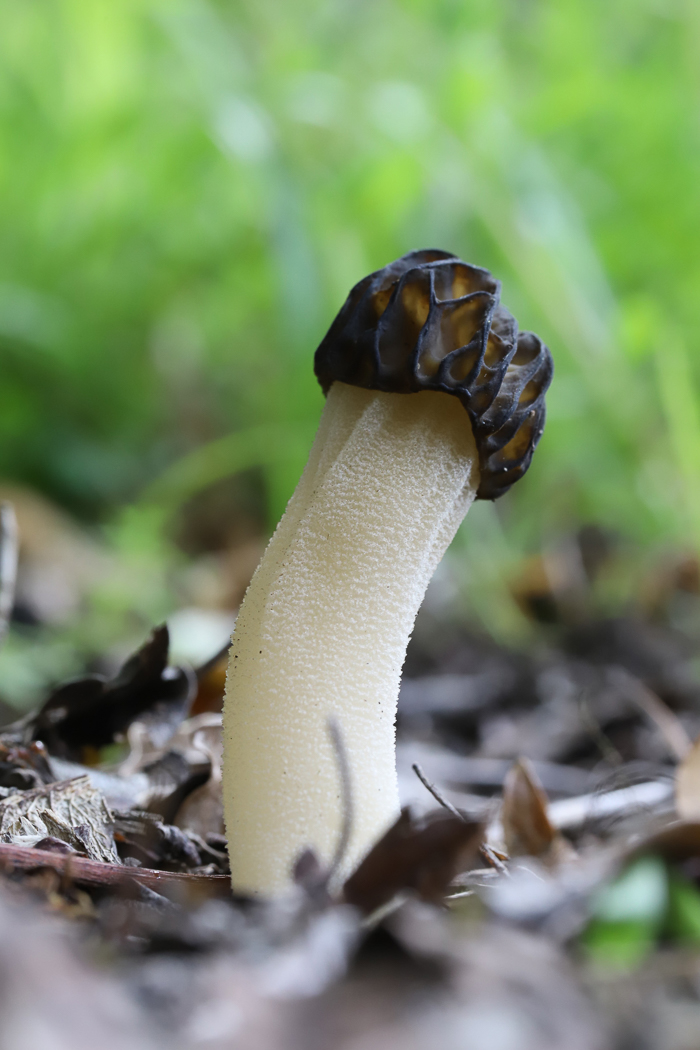 |
April 19th Morchella semilibera (Semifree Morel)
Jesper Launder and Sarah Ebdon went searching in the Aylesbury area and amongst some woodchip they found this species (previously in genus Mitrophora) - the last needed to complete our full house of Morel species found and featured in Finds during the last month! We have more county records of this species than any of the others though it is still by no means common - as a group Morels are generally considered some of the most unpredictable fruiters though all appear only in the Spring and this years seems to have been particularly prolific. Today's species is sort of half way between a 'true' Morel and Verpa conica. Like that species it tends to have a longer stem and smaller body than other Morels, i.e. different proportions, also the base of the body is not attached to the stem (hence 'semifree') whereas in other 'true' Morels the base folds under and is attached to the stem. It does, however, have the ridged body of other Morels in contrast to the merely wrinkled surface of V. conica. Previously in genus Mitrophora, this is a new species for Finds, but useful comparisons of the different Morel species can be made by browsing through our last few weeks of images. Photo 2 was taken by Philip Townsend 10 days later at Ragpits BBOWT Reserve.
|
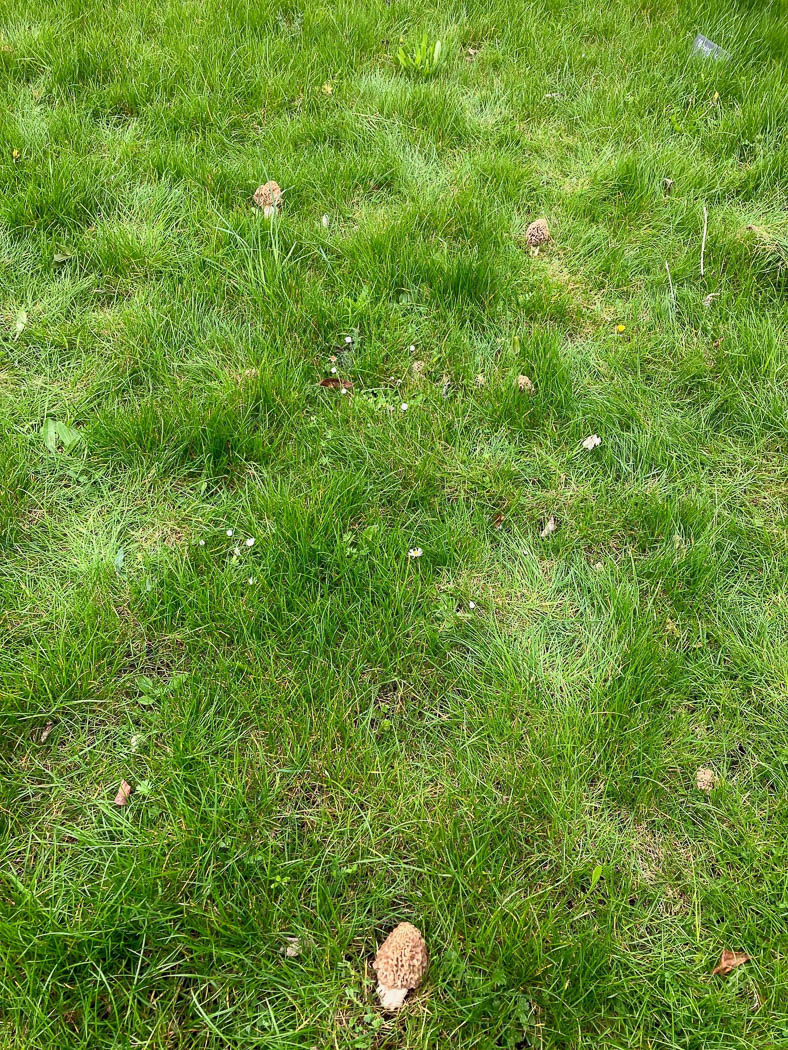
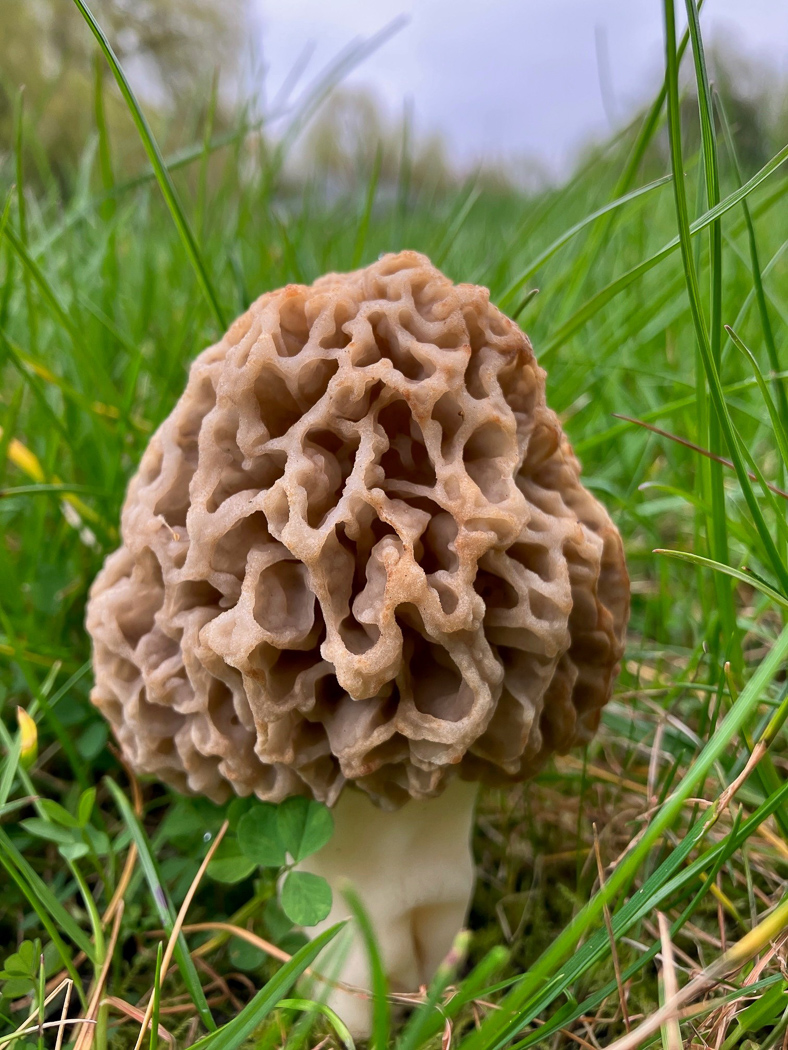
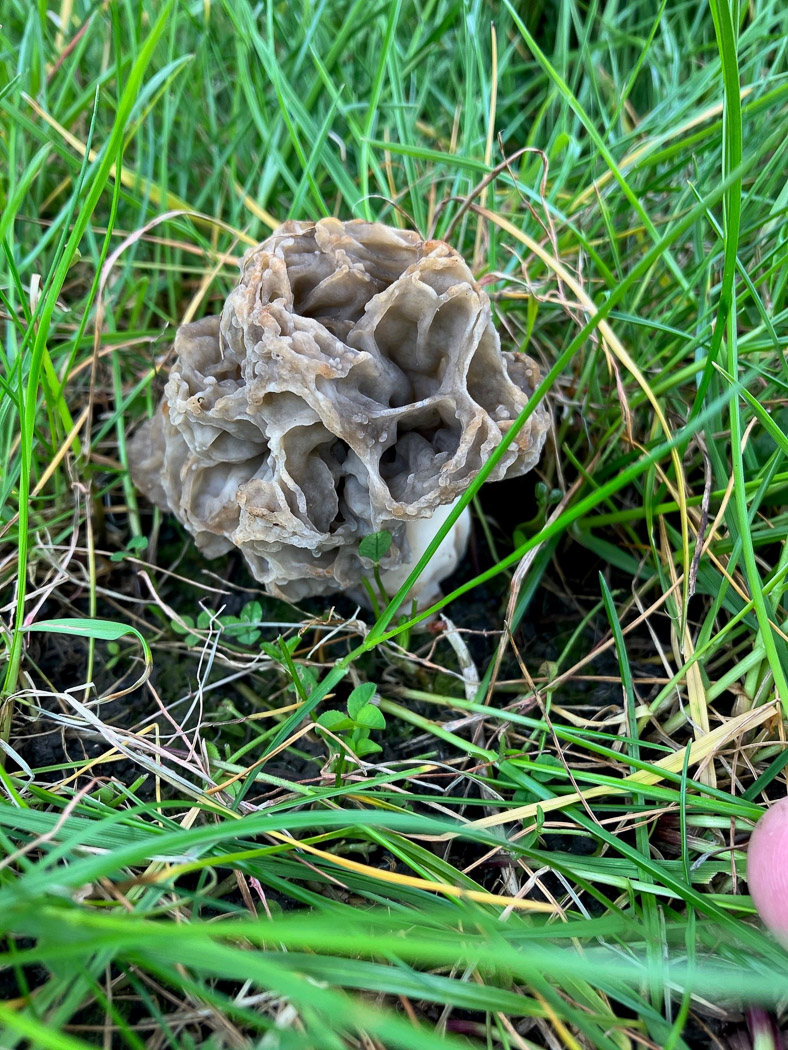
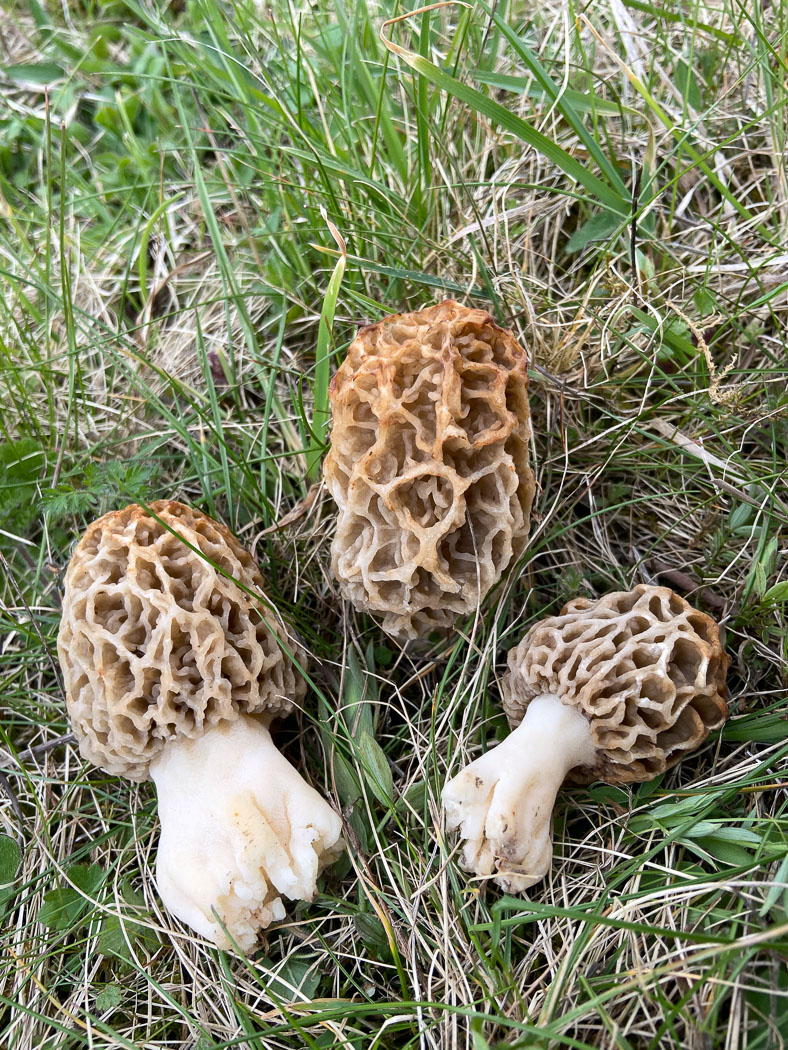
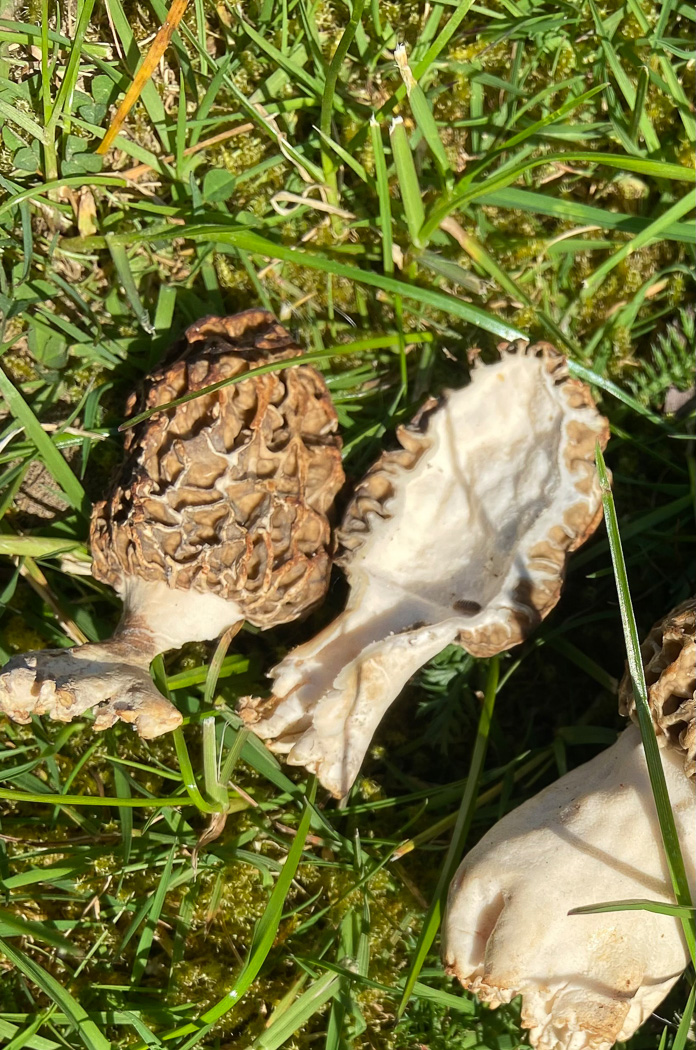 |
April 19th Morchella vulgaris (an unusual Morel with no common name) 
Justin Long received a tip off about a beautiful array of Morels fruiting now in Milton Keynes (site not specified for obvious reason). He found at least 20 specimens there though no trees nearby with which they could be associating, but he learnt later that there had previously been apple trees in the vicinity. Noticing the specimens had a distinct spermatic smell, he consulted Jesper Launder (who knows his Morels) and after sharing the photos they agreed that this was not the more common M. esculenta but the much more unusual M. vulgaris for which we have just one unsubstantiated county record from 1991! Photos 4 and 5 were sent in after Justin's and were found the previous day by Sarah Ebdon near Princes Risborough and also checked by Jesper. Penny is green with envy, never having found a collection of Morels like these! Justin's collection has now been sequenced and confirmed though only at 98.3 % which is less convincing than one would like - normally sequences come back at over 99% if a good match is accepted so there is an element of doubt here still.
|
April 18th 2023
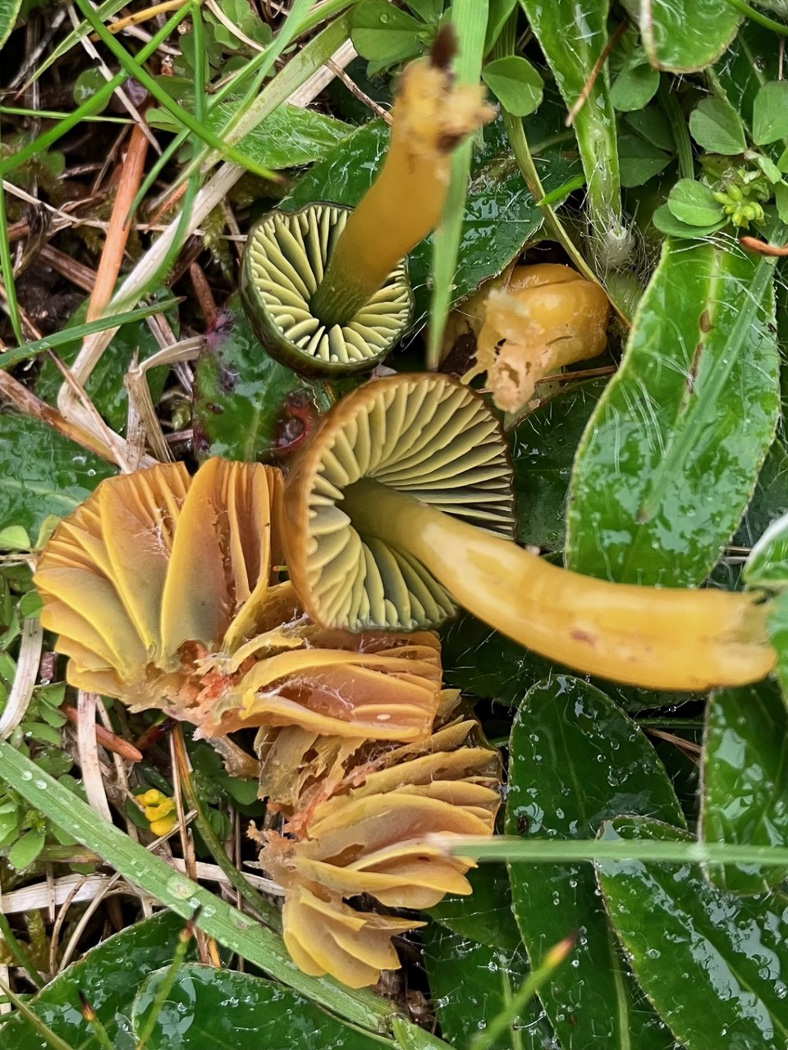
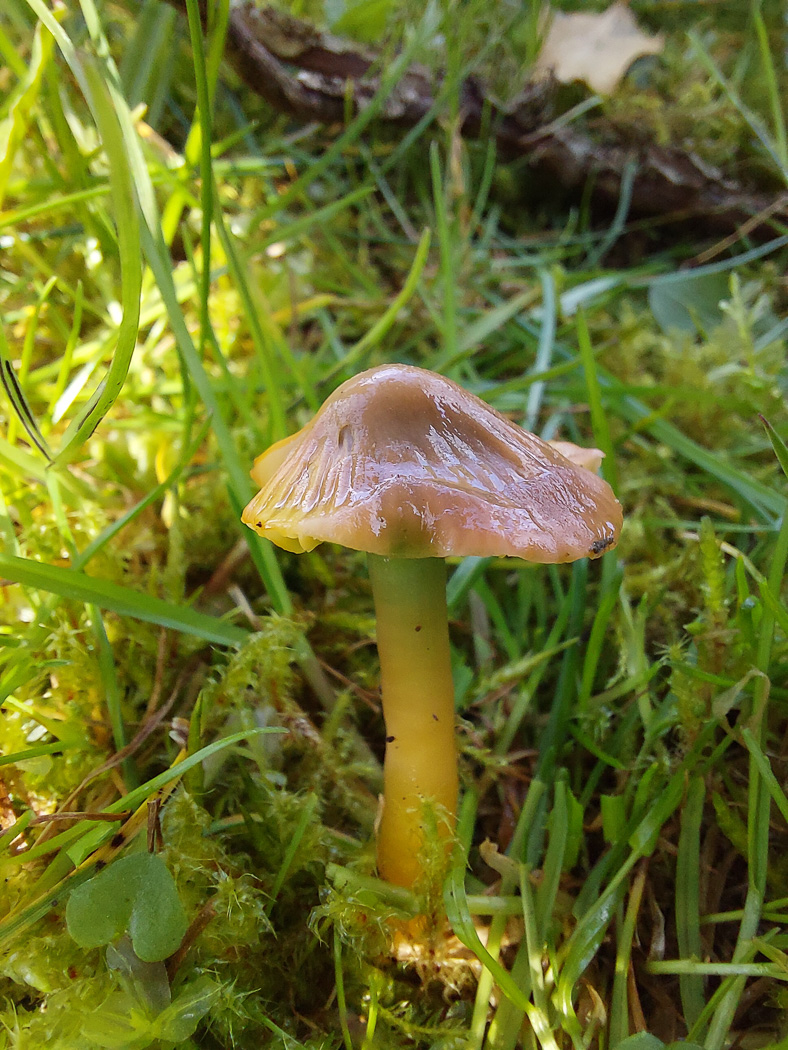 |
April 18th Gliophorus psittacinus (Parrot Waxcap)
Jesper Launder was somewhat surprised to come across this Waxcap in a damp grassy verge in Gerrards Cross - not what you'd expect to find at this time! We have the odd record for January (presumably hanging on from the end of the Autumn season), also one for July (presumably starting early for the next Autumn), but nothing for the intervening months. Photo 2 is of yet another collection made on May 8th at Gt. Brickhill Churchyard by Justin Long. We have quite a few nice images of this species (previously in Hygrocybe) in Finds - see the Masterlist. This is surely a sign of our seasons getting much more interchangeable and unpredictable with the resulting confusion amongst many organisms - we live in strange times ..................
|
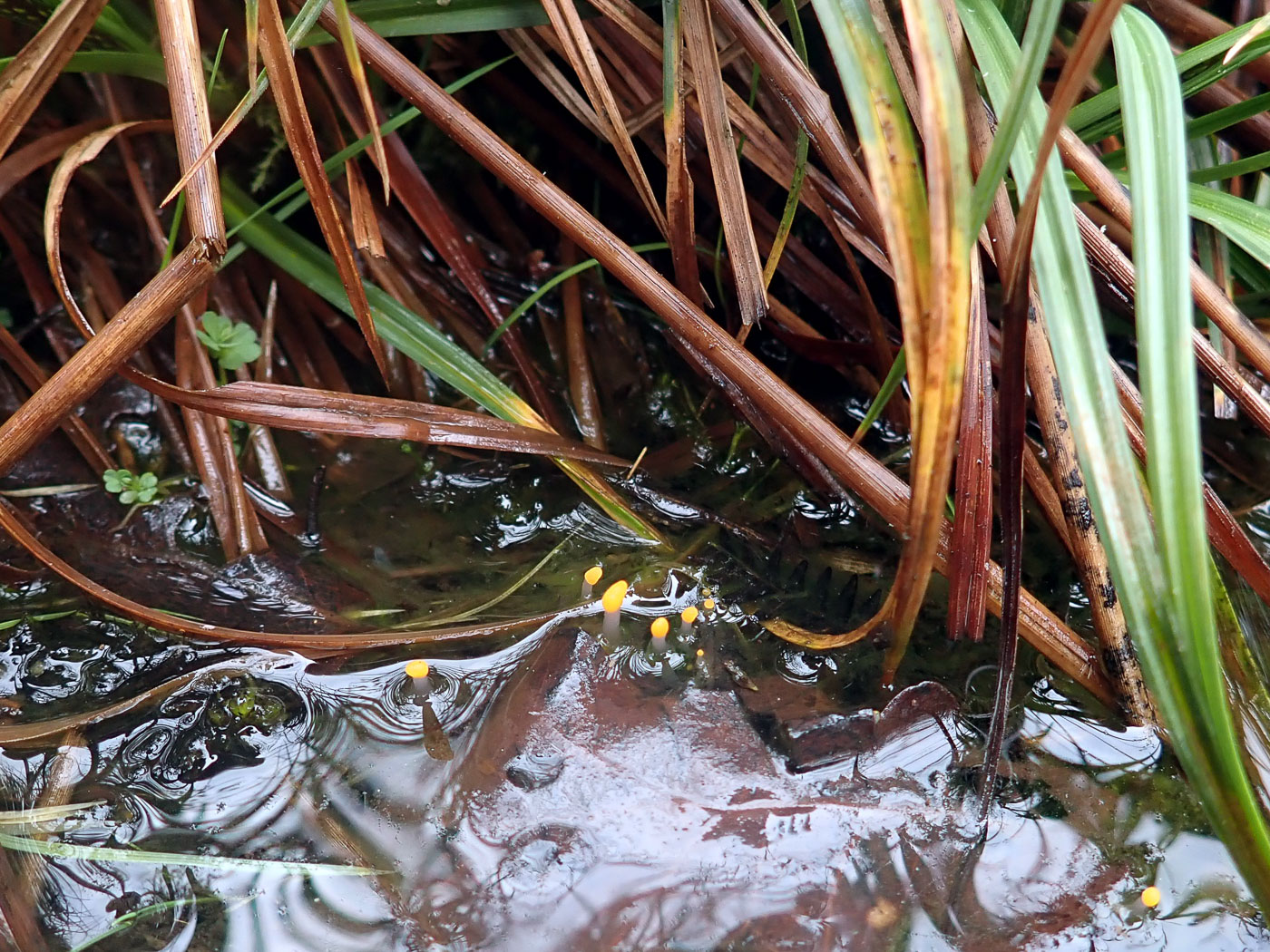
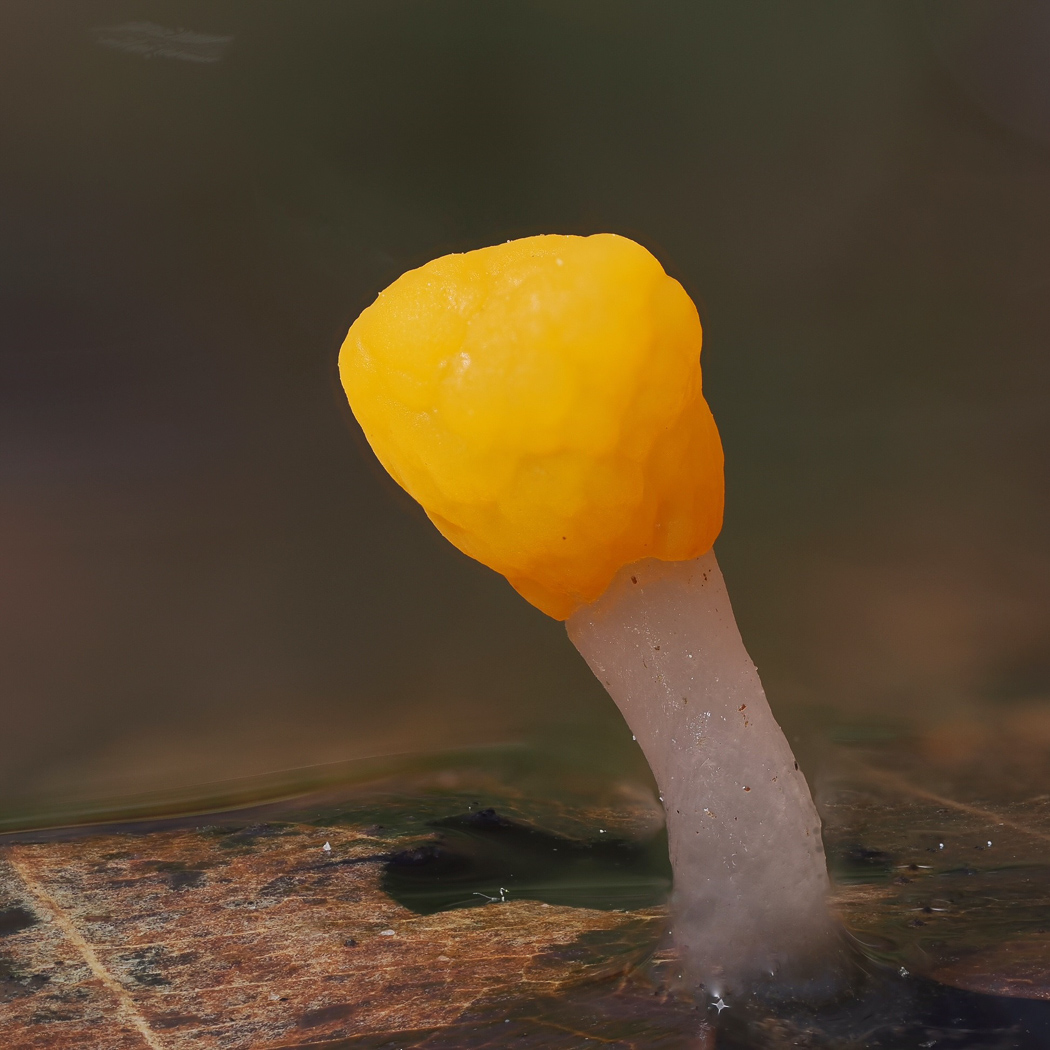
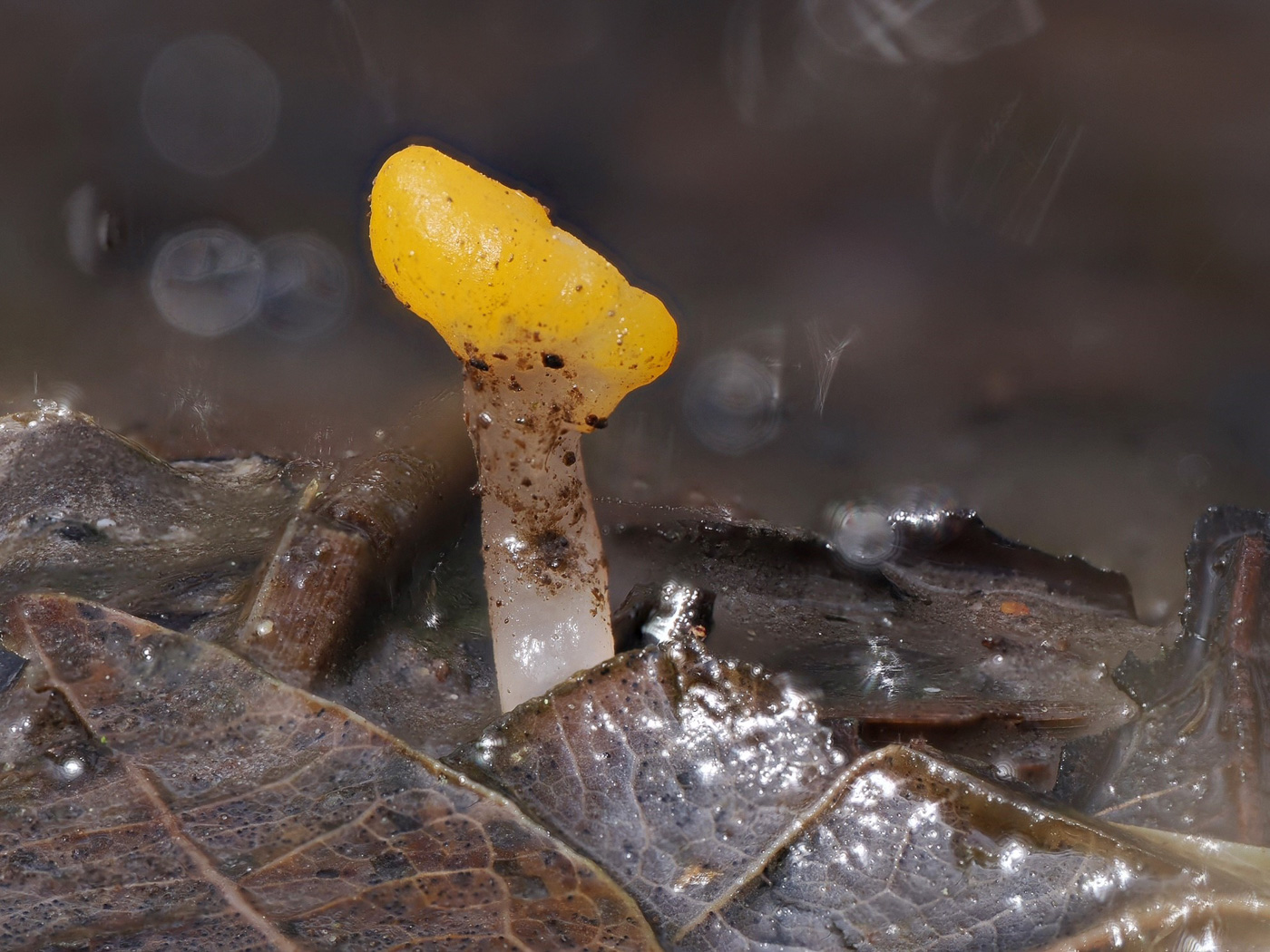 |
April 18th Mitrula paludosa (Bog Beacon)
By coincidence Penny and Claire Williams separately visited the Mire at Burnham Beeches today with the same objective! Both were rewarded though Penny could only find a very few really tiny specimens (still hiding their light under a bushel! - photo 1) whereas Claire looks to have found at least one decent sized Beacon! (photos 2 and 3). We still only have this site and Danesborough at the northern end of the county for this beautiful species which thrives on wet vegetation in really soggy sites, so it's surprising that it's not been found at Stoke Common, for instance. It should however, be on show when BFG visits the Beeches at the end of this month: all our records are from May bar one in June so it's only just beginning to fruit now.
|
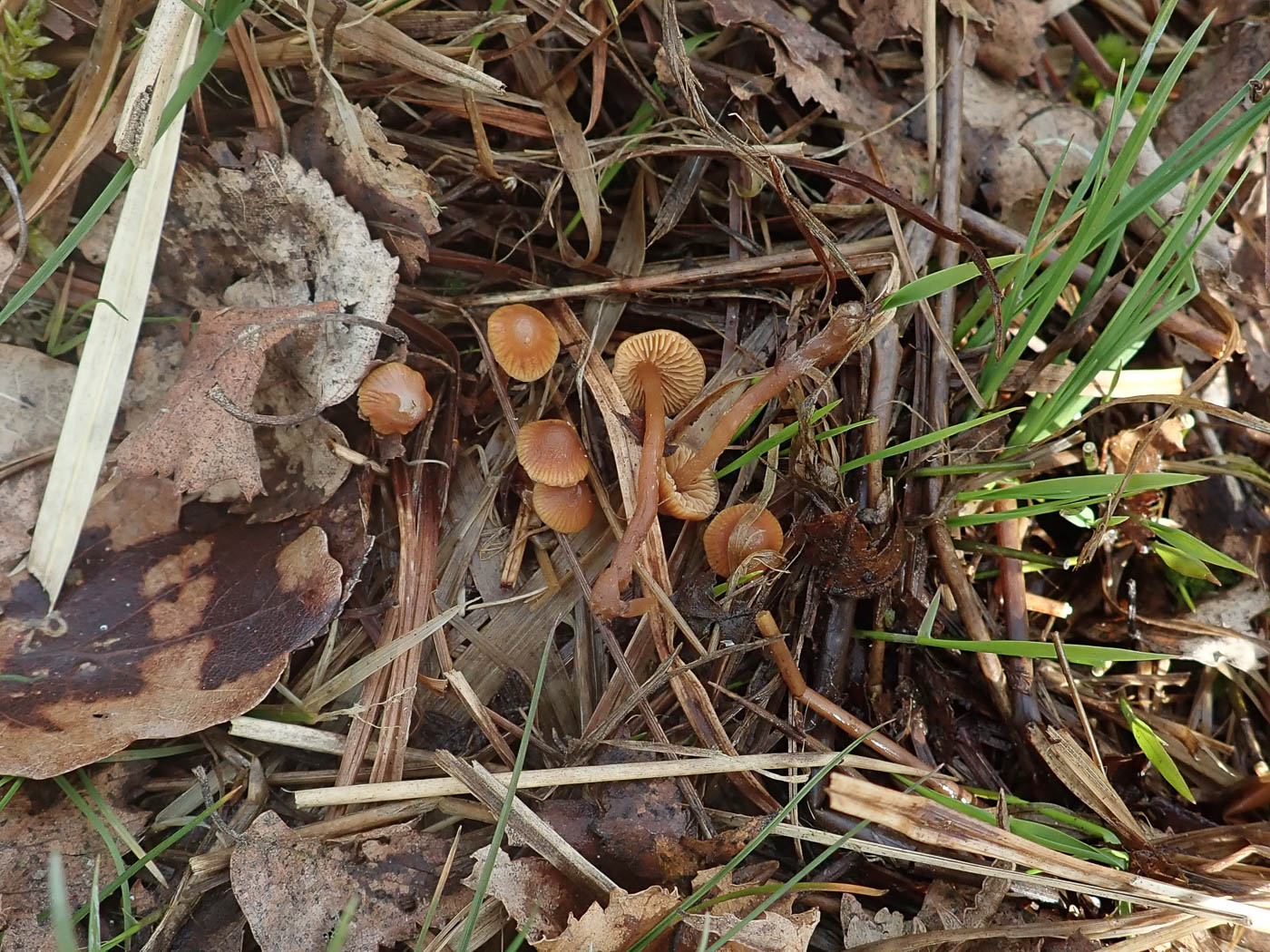 |
April 18th Galerina ampullaceocystis (a rare species of Bell) 
In a very soggy part of the Mire near to some Pines at Burnham Beeches Penny came across this cluster of LBJs, recognised the genus and correctly assessed that identifying to species would probably cause problems! Once having confirmed the genus and ascertained that it had almost smooth almond-shaped quite narrow spores, cystidia on the gill edge with long very thin necks and a small blob on top, she spent several frustrating hours poring over available keys and literature without conclusion. However, sequencing has now shown it to be G. ampullaceocystis - a species of boggy areas such as this and often associating with Pine litter. We have just one previous record from similar habitat at Stoke Common, and there appear to be only 35 UK records.
|
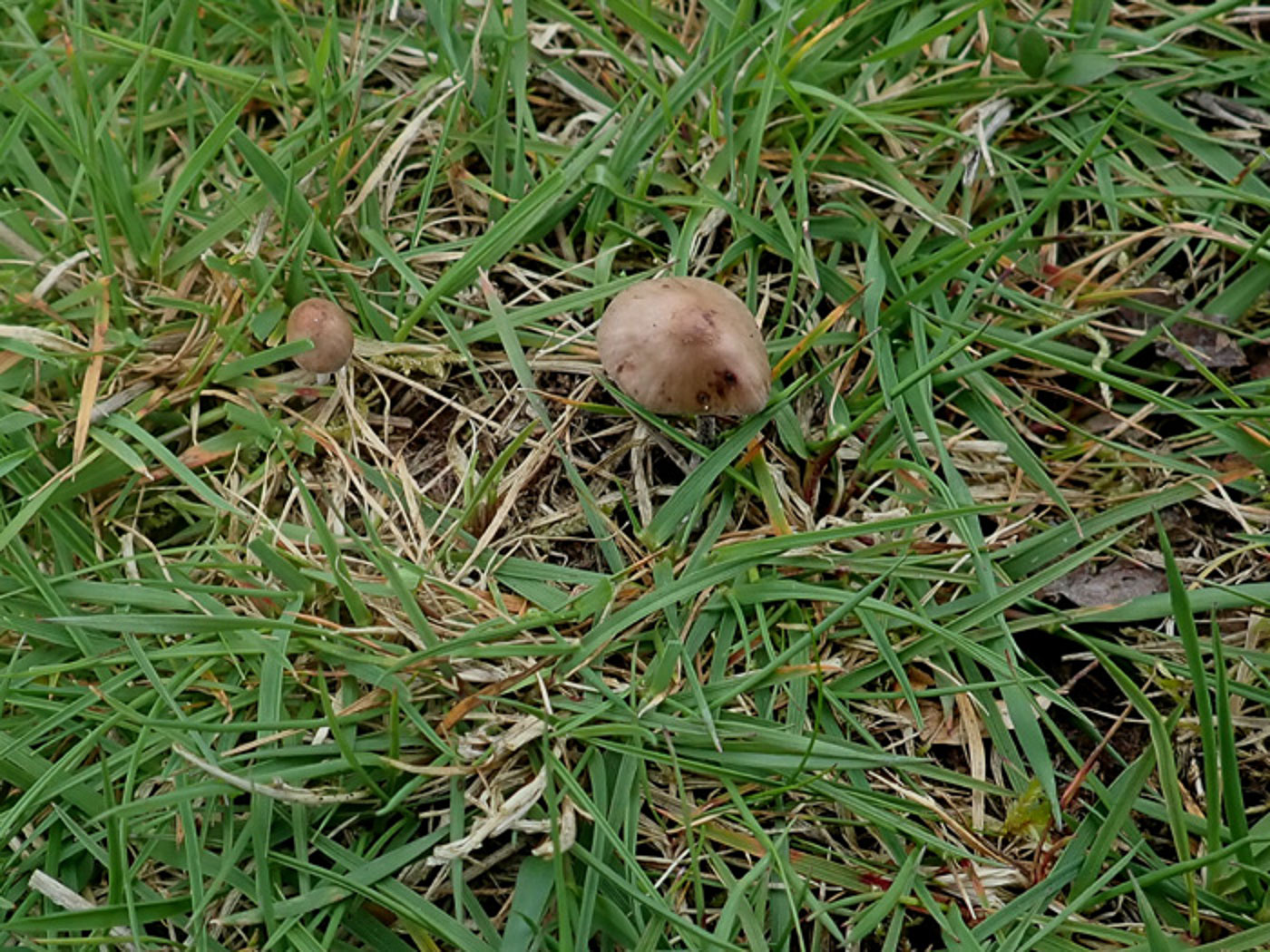
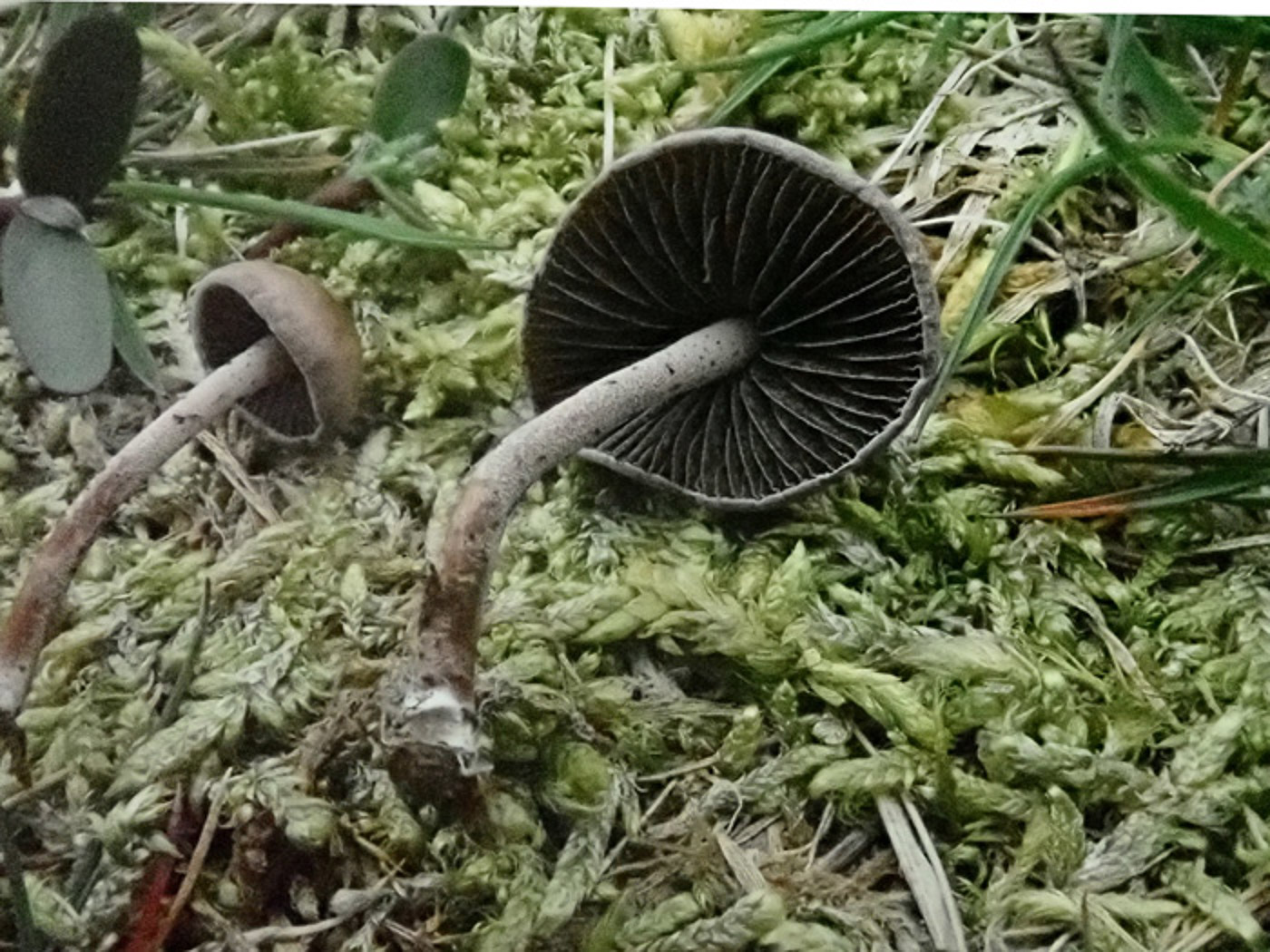 |
April 18th Deconica sp (an unidentified LBJ) 
At Burnham Beeches Penny spotted these two tiny LBJs in a grassy area of well manured soil at Burnham Beeches, the largest cap being well under 1 cm across. Having black but clearly mottled gills and a stem spotted with black spores suggested the genus (one fairly recently introduced for those species of Psilocybe which lack blue colours in the stem and have no Psilocybin). Keying it out at home proved confusing: though the spore size and shape and occurrence on dung pointed to D. coprophila or merdaria other features didn't fit either species very convincingly. (See a good photo of D. coprophila in Finds dated 2022 November 12th). It is hoped that sequencing will help, at which time this entry will be updated.
|
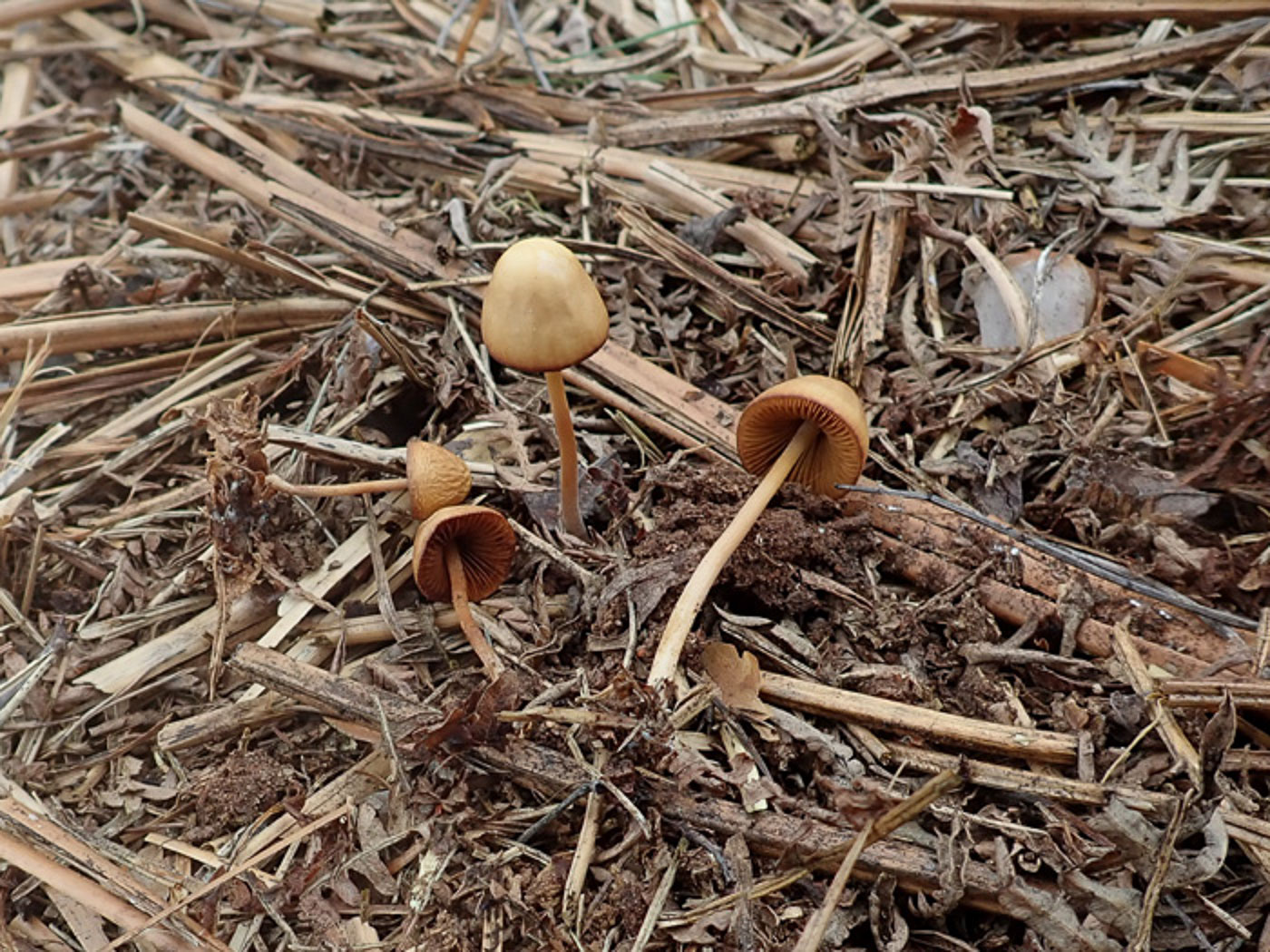
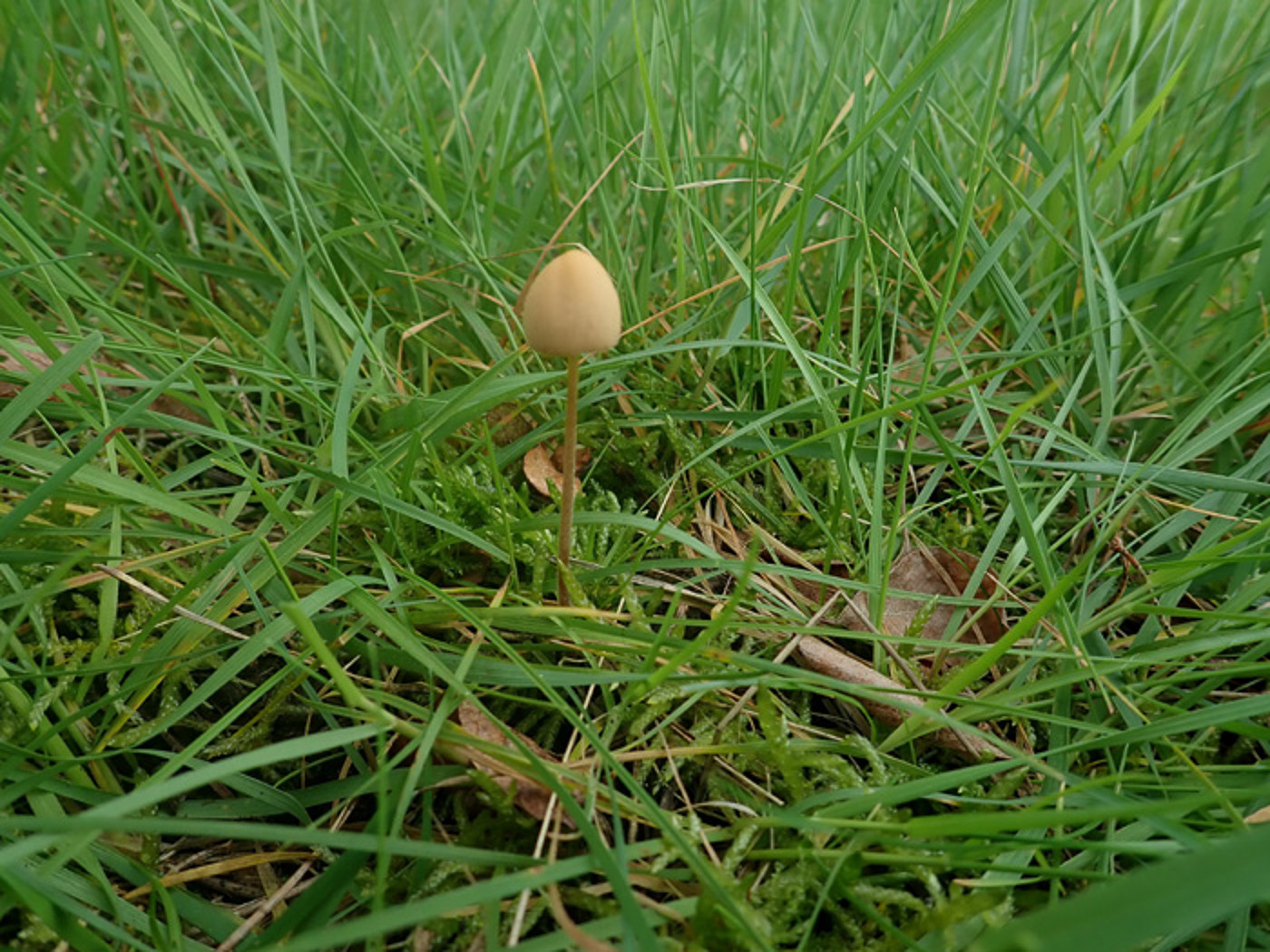
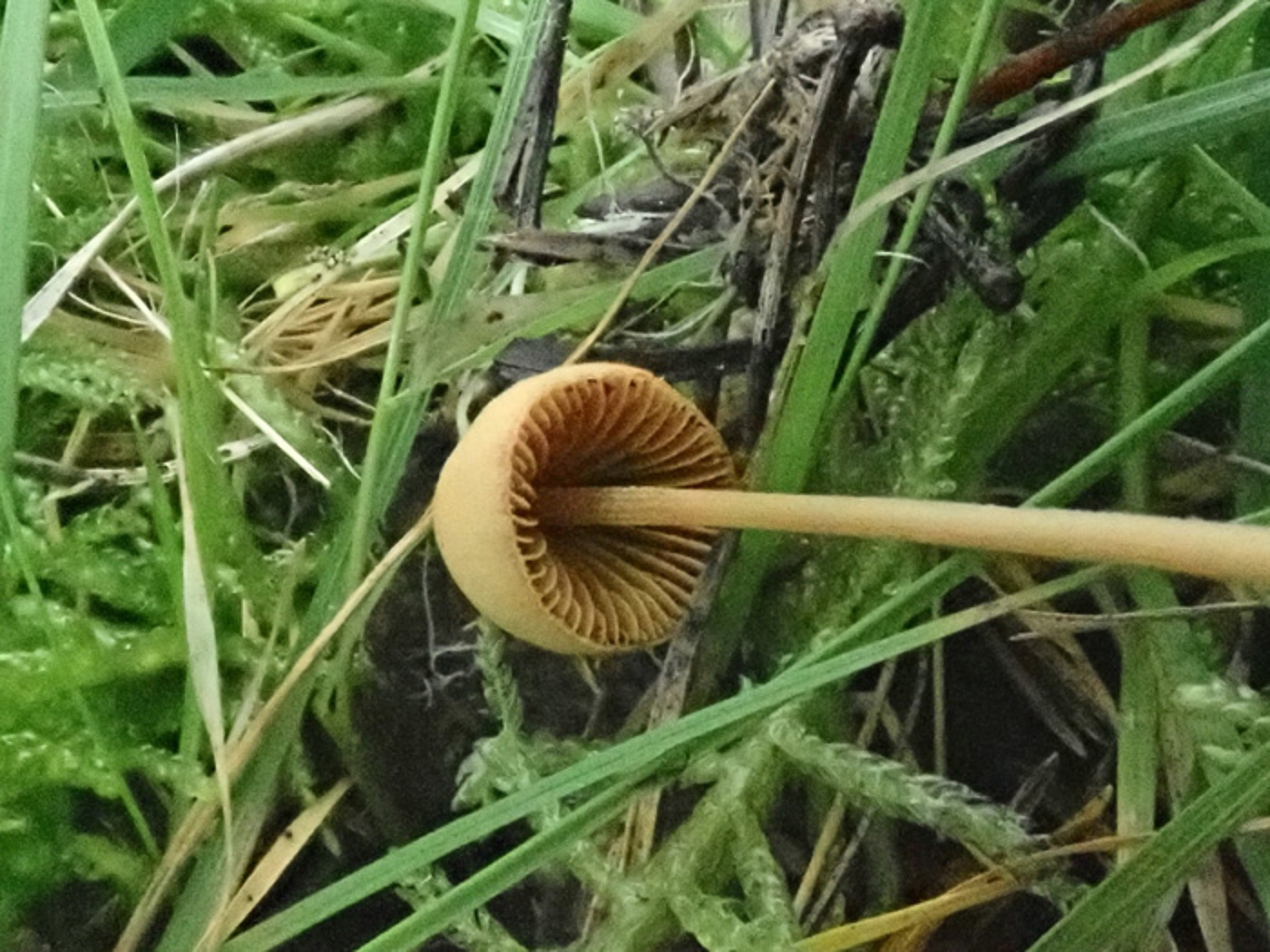 |
April 18th Conocybe pubescens (Downy Conecap) 
At Burnham Beeches in an area clearly frequented by ponies Penny found several examples of this quite common LBJ - one which occurs on well rotted dung of large herbivores. The largest cap was about 2 cm across, the rusty gills typical of the genus are somewhat crowded, and its common name is derived from its very finely downy stem (covered in both caulocystidia and fine hairs though best seen with a handlens (and just visible in photo 3). See the Masterlist for further examples.
|
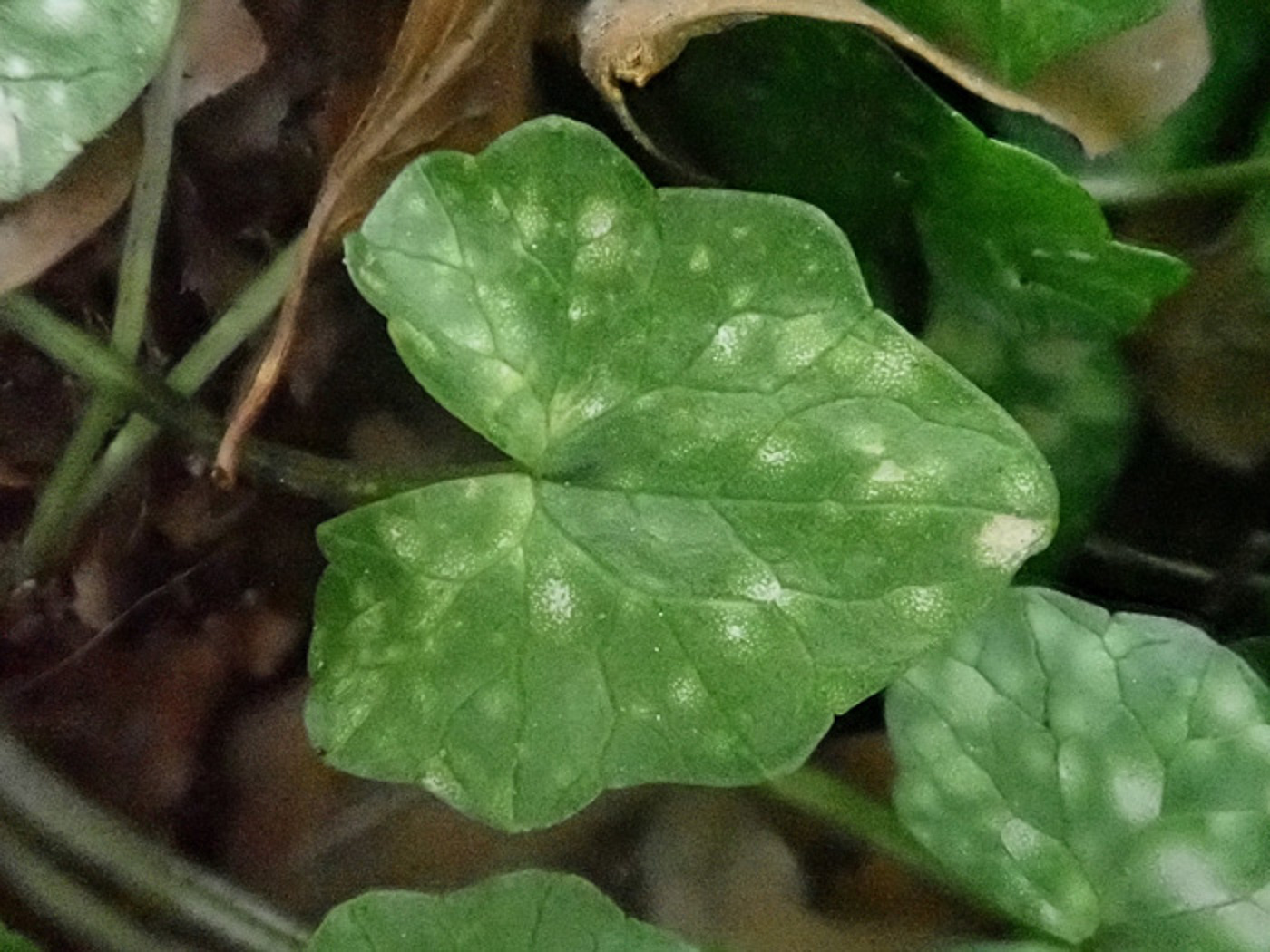
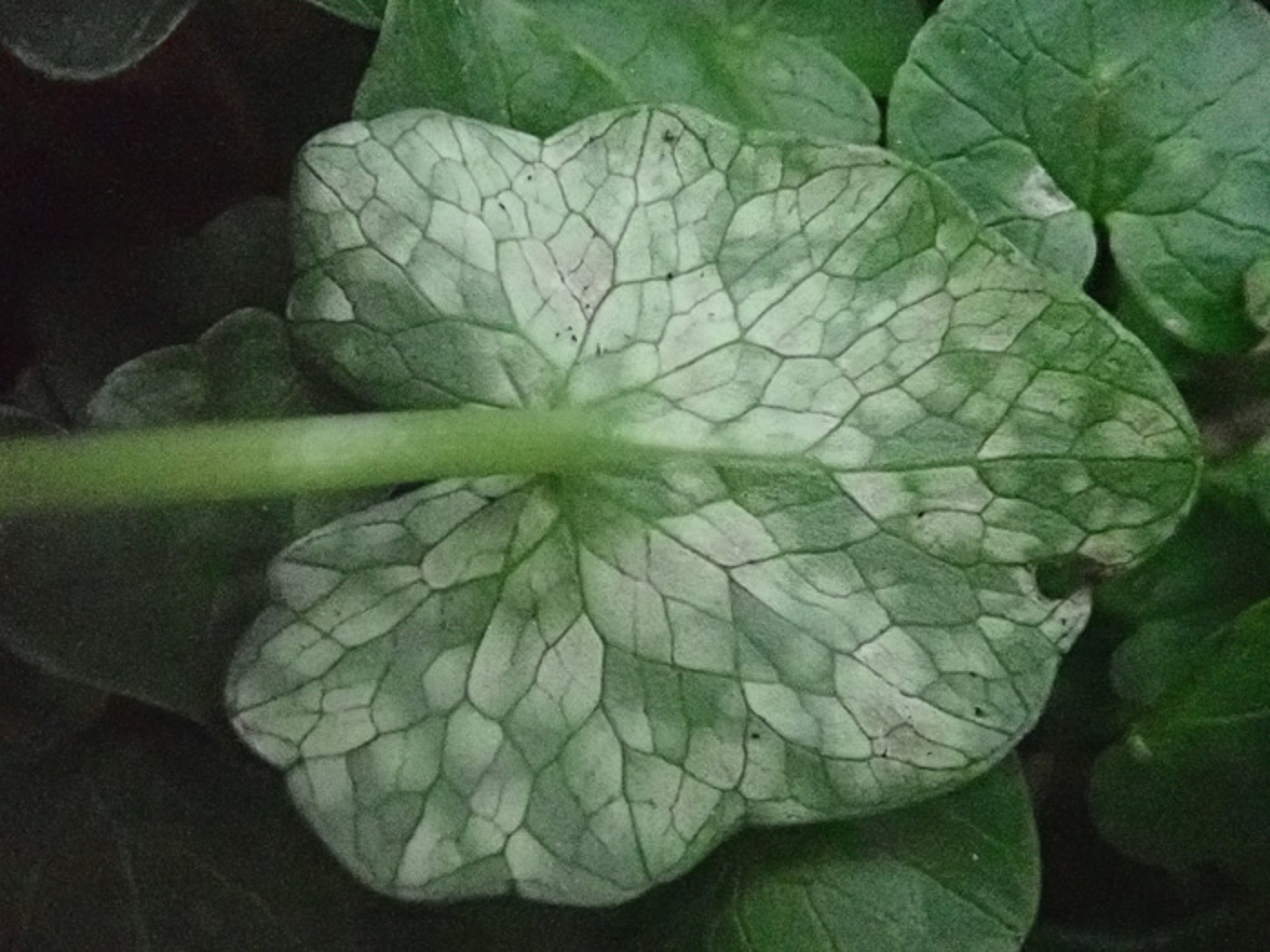 |
April 18th Entyloma ficariae (a very common Smut species with no common name)
At Burnham Beeches Penny was not surprised to see huge patches of Lesser Celandine leaves covered in the white patches caused by this fungus - there was hardly a leaf unaffected in some areas. Photo 2 shows the underside of a leaf. The fungus seems to have no adverse effect on the plant to which is it host specific. This is a new entry for Finds.
|
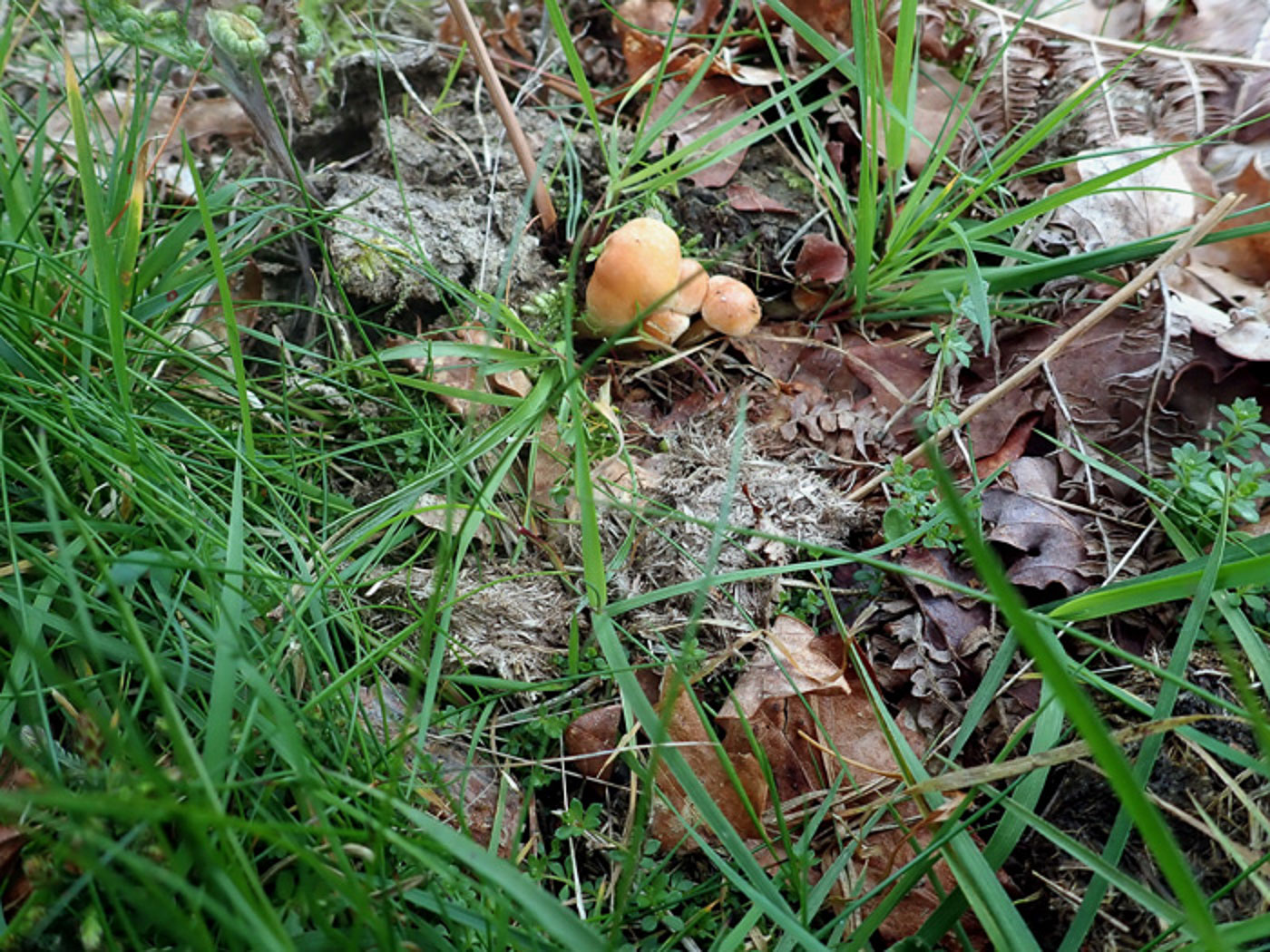
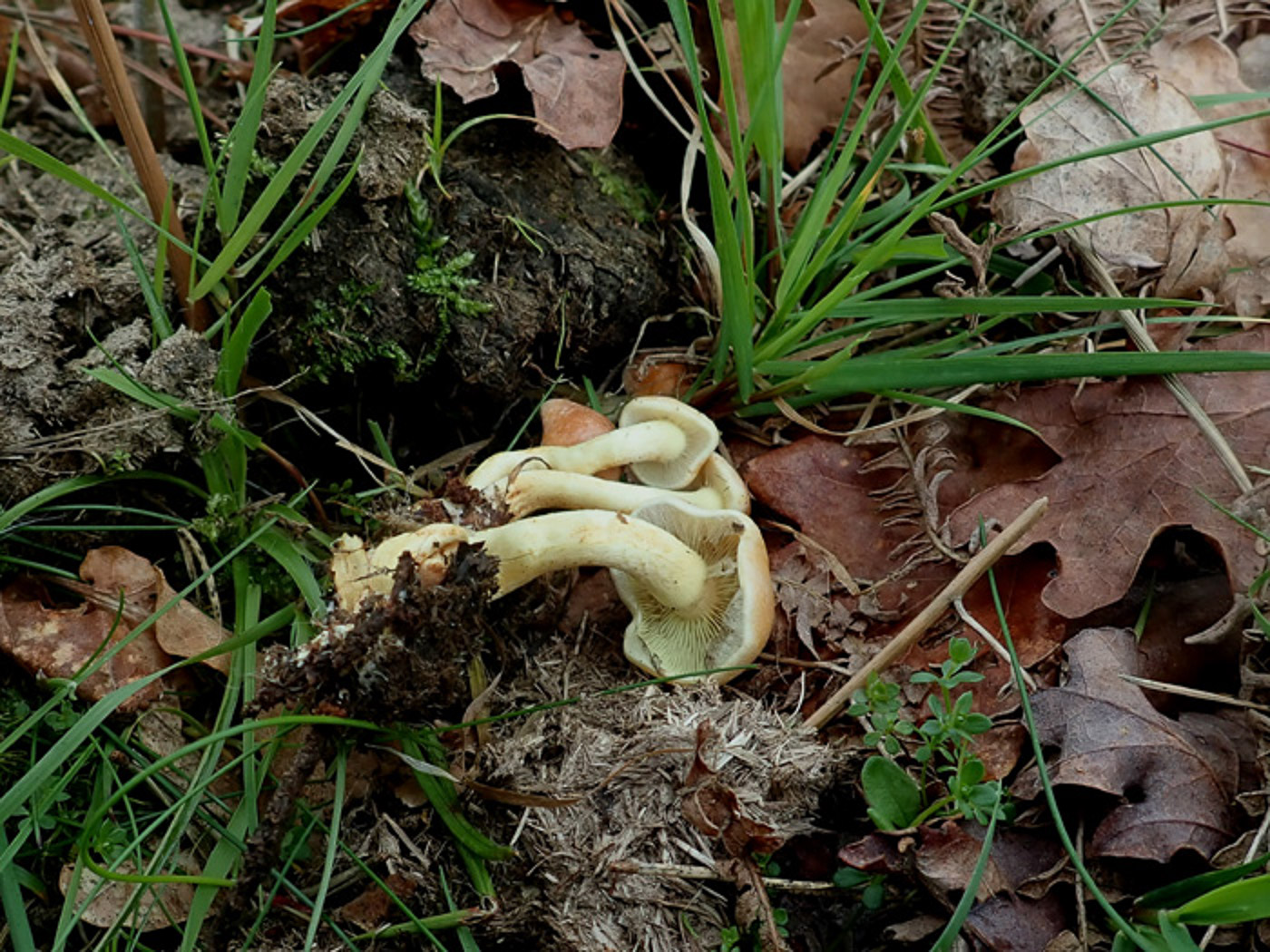 |
April 18th Hypholoma fasciculare (Sulphurtuft)
Penny was surprised to find these young fresh specimens of a common autumn species at Burnham Beeches today, especially as they appeared to be on pony dung! Further exploration revealed woody debris of Pine beneath, however. The BFG database shows finds from every month of the year though they are few and far between for February and April. See the Masterlist for more examples - this is a species in which the young and mature examples are remarkably different.
|
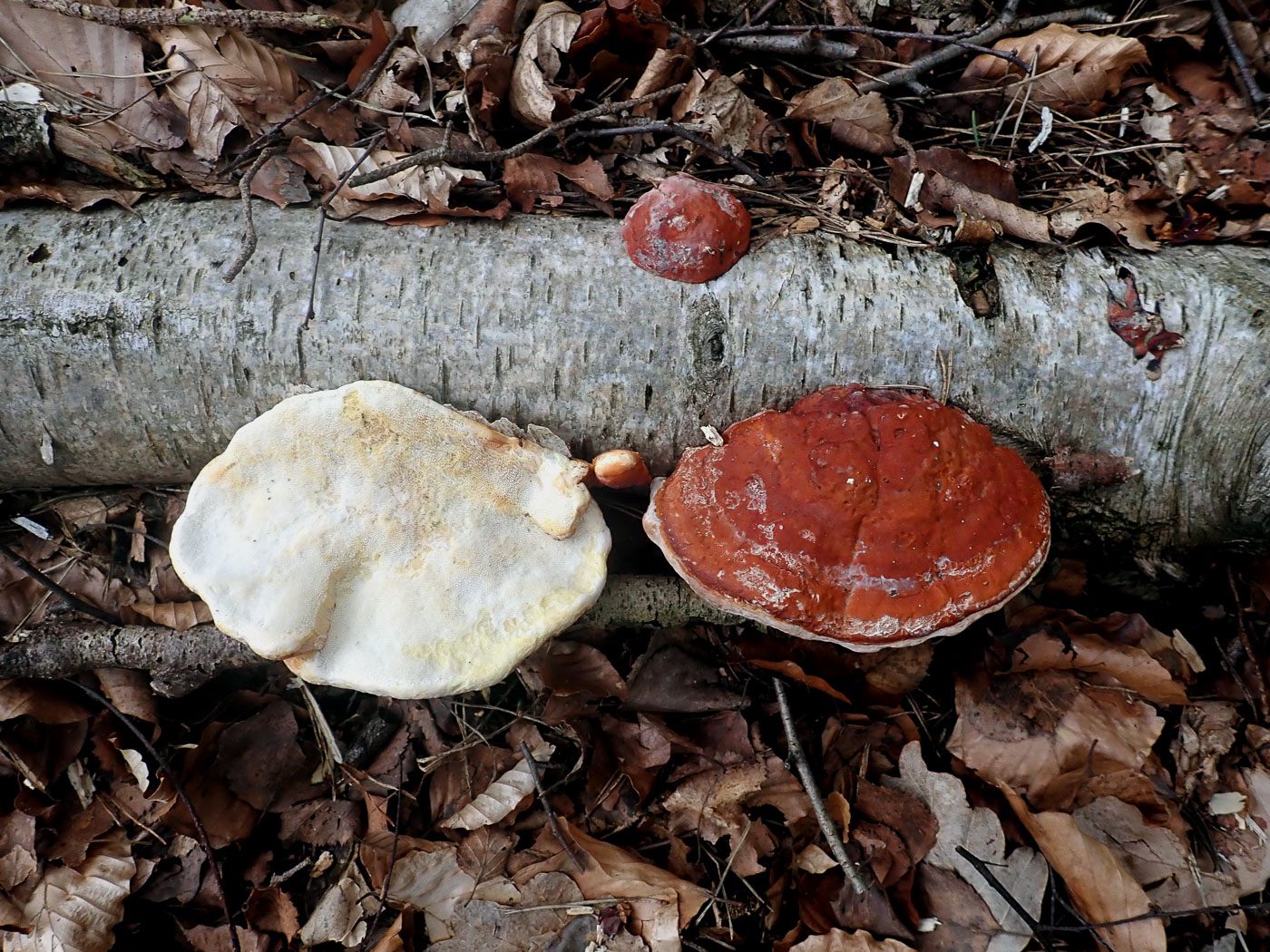 |
April 18th Fomitopsis pinicola (Red-belted Bracket)
On a fallen Birch trunk at Burnham Beeches Penny spotted this mature bracket belonging to a species which a few years ago was considered a real rarity in this area but is fast becoming quite common, especially at this site together with Fomes fomentarius (Hoof Fungus). Though its species name implies its occurrence on Pine we are now regularly finding it on both Birch and Beech. See the Masterlist for the growing number of examples showing it a different stages of development.
|
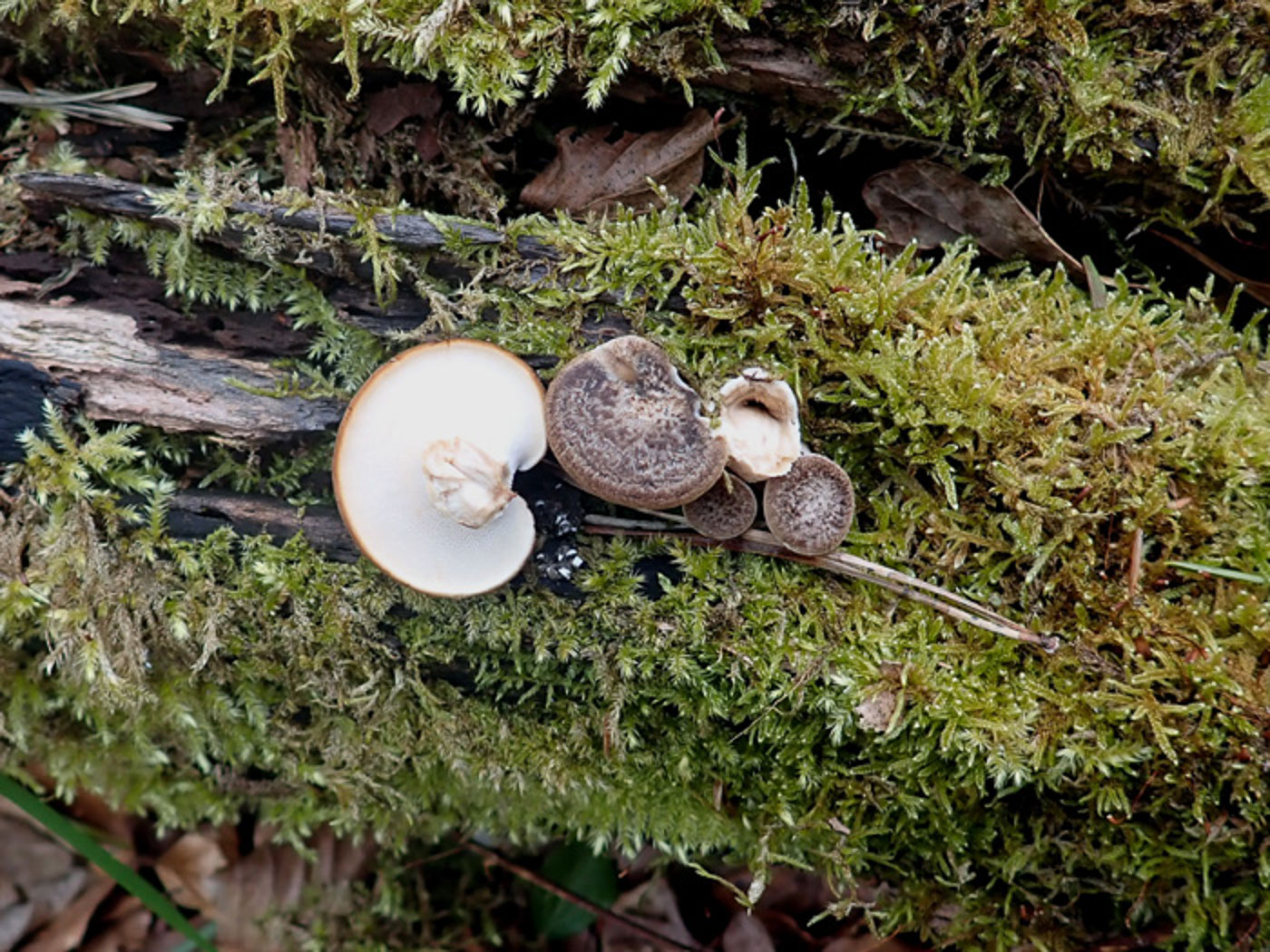
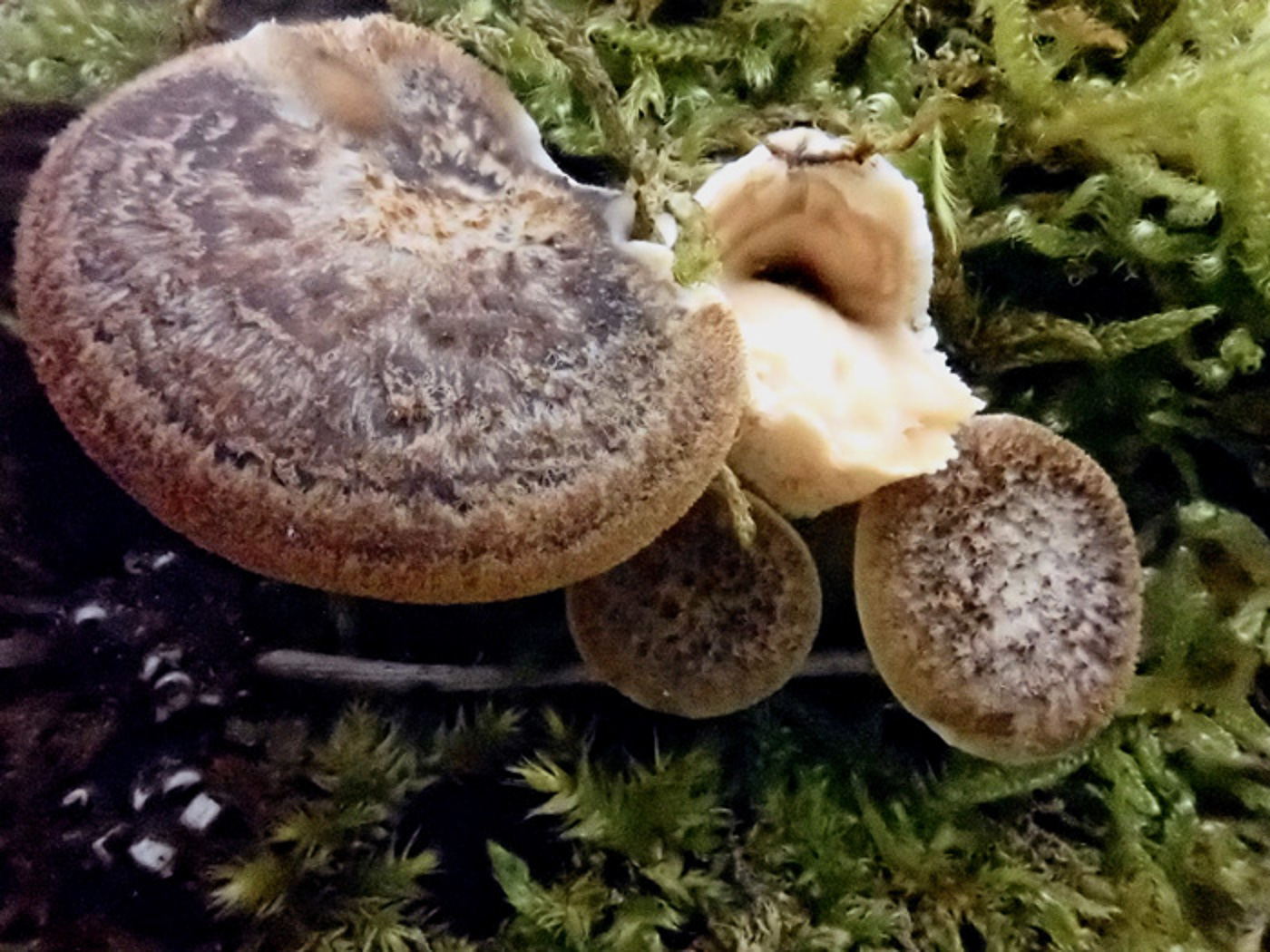
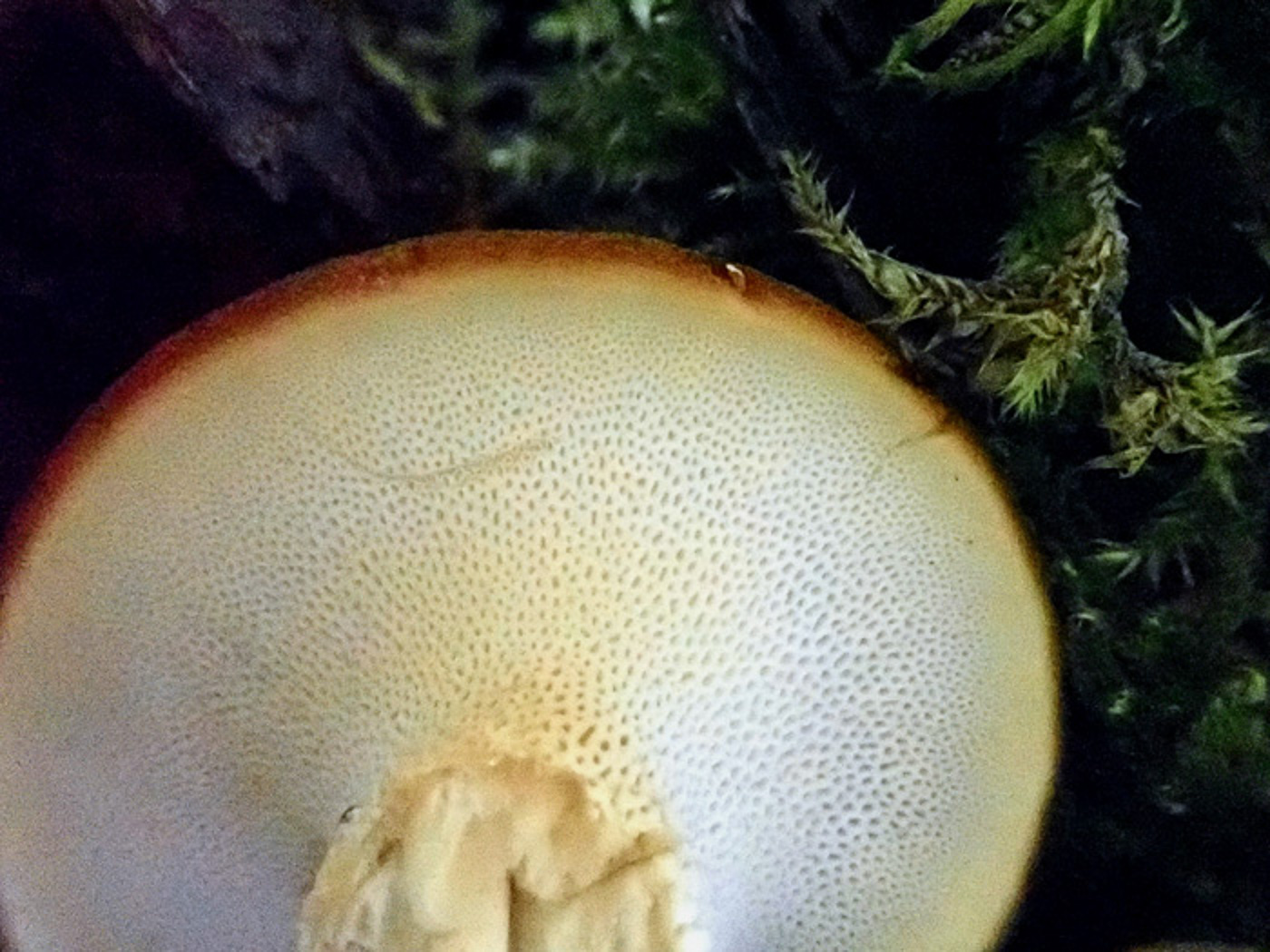 |
April 18th Lentinus brumalis (Winter Polypore)
On a fallen mossy Birch trunk at Burnham Beeches Penny spotted a small cluster of caps, the largest 3 cm's across. Recognising the species she turned the largest one over to reveal the quite large angular pores and relatively smooth margin, these clues together with the darkish brown cap were enough to confirm its separation from the similar L. ciliatus (Fringed Polypore -now confusingly named L. substrictus!). Both these two species, previously in genus Polyporus, are not as common as P. leptocephalus (Blackfoot Polypore - now confusingly moved to genus Cerioporus together with the much larger P. squamosus - Dryad's Saddle.) We have several Finds entries for L. brumalis, all from November - February reflecting its common name.
|
April 16th 2023
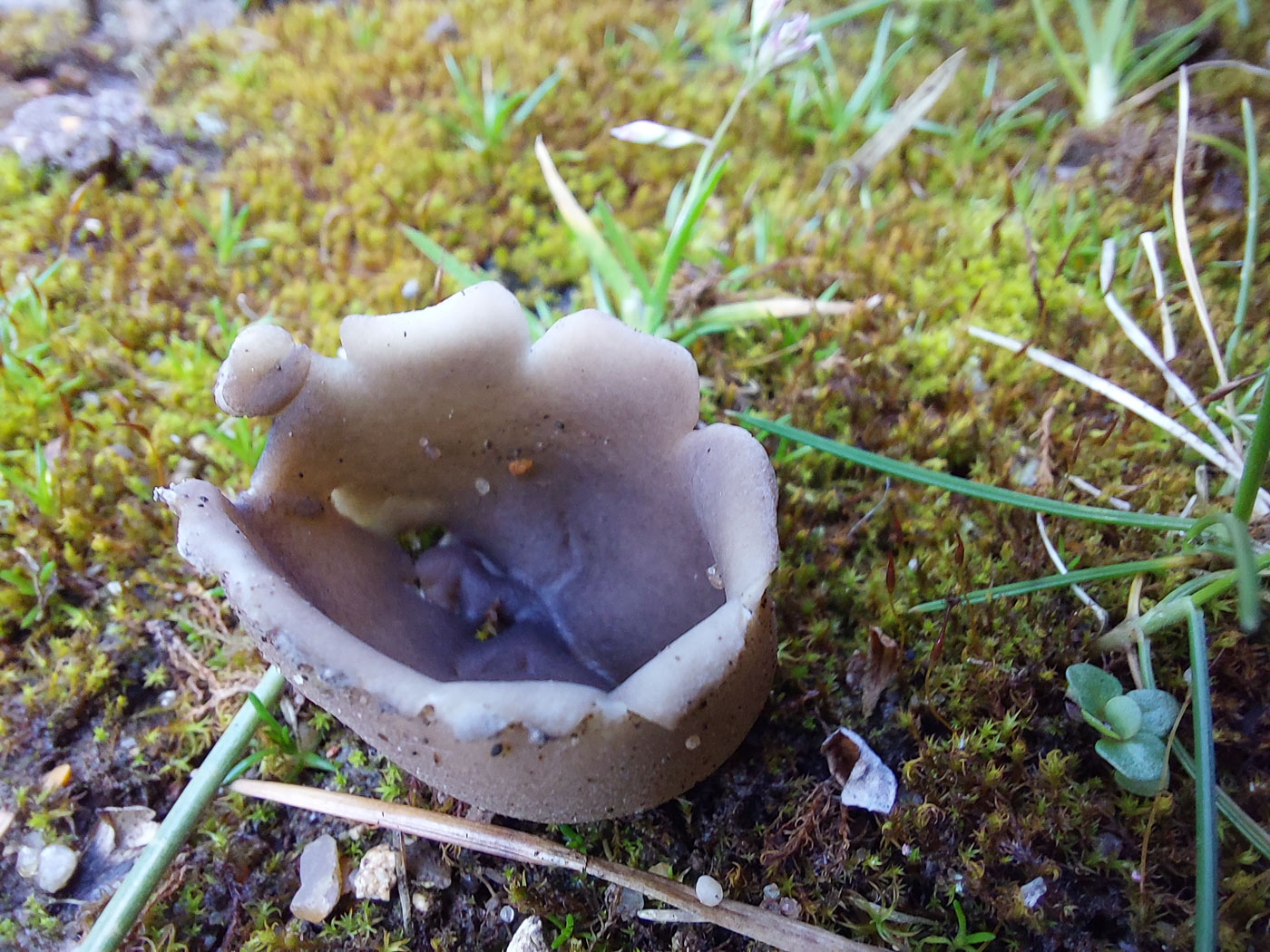
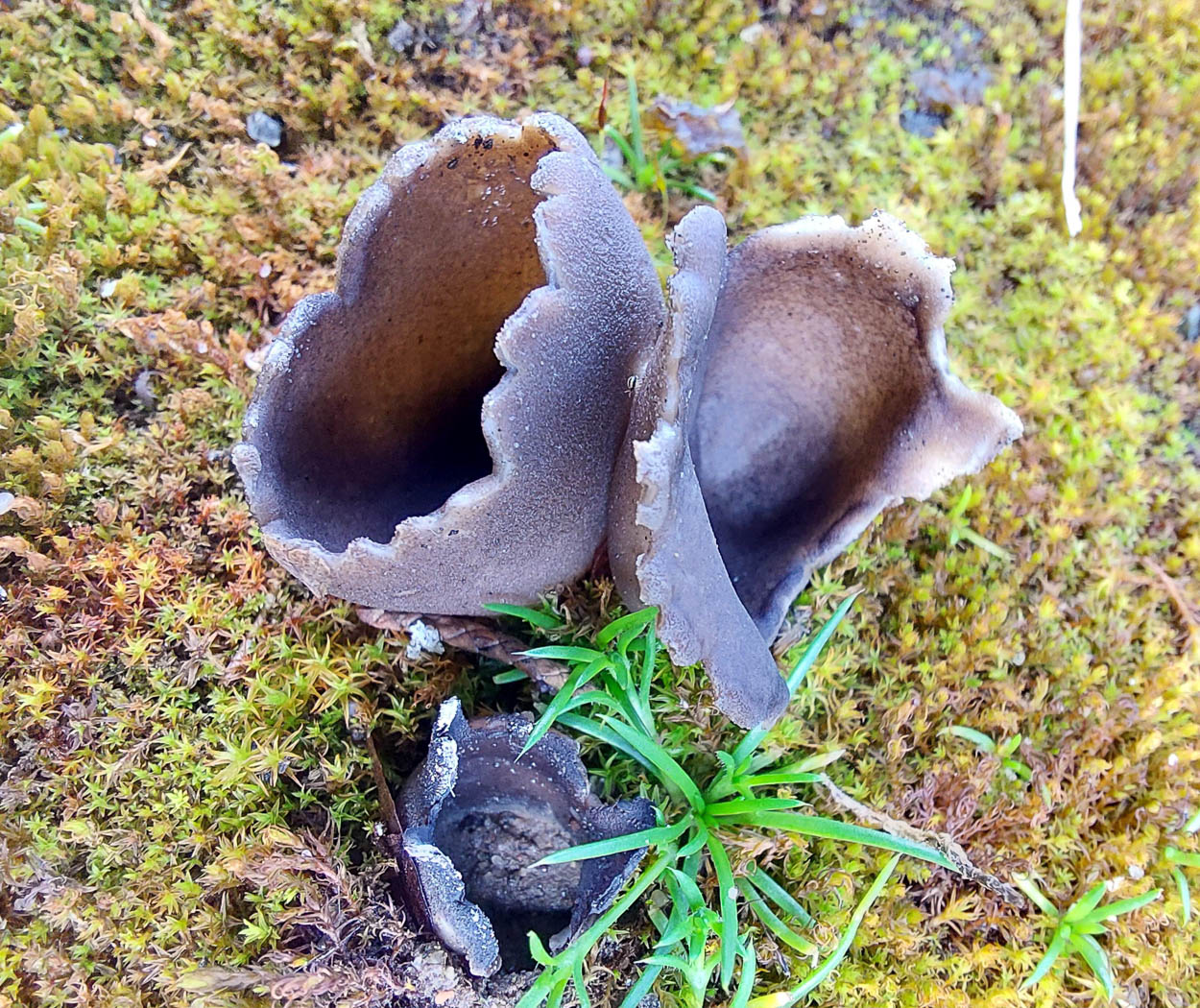 |
April 16th Helvella leucomelaena (Sooty Cup) 
At the edge of a path under Pine in Gerrards Cross Jesper Launder found this rare and interesting species - new to the county. It is thought to be host specific to Pine, occurring in Spring in calcareous soil and has previously been in genus Paxina (as also has the similar H. acetabulum - see the April 8th entry); in fact it remains unclear whether its present name should be Helvella or Dissingia leucomelaena. Its darkish grey-brown to blackish colour, downy outer-surface, short pale slightly ribbed stem which is well embedded into the ground are its notable features.
|
April 15th 2023
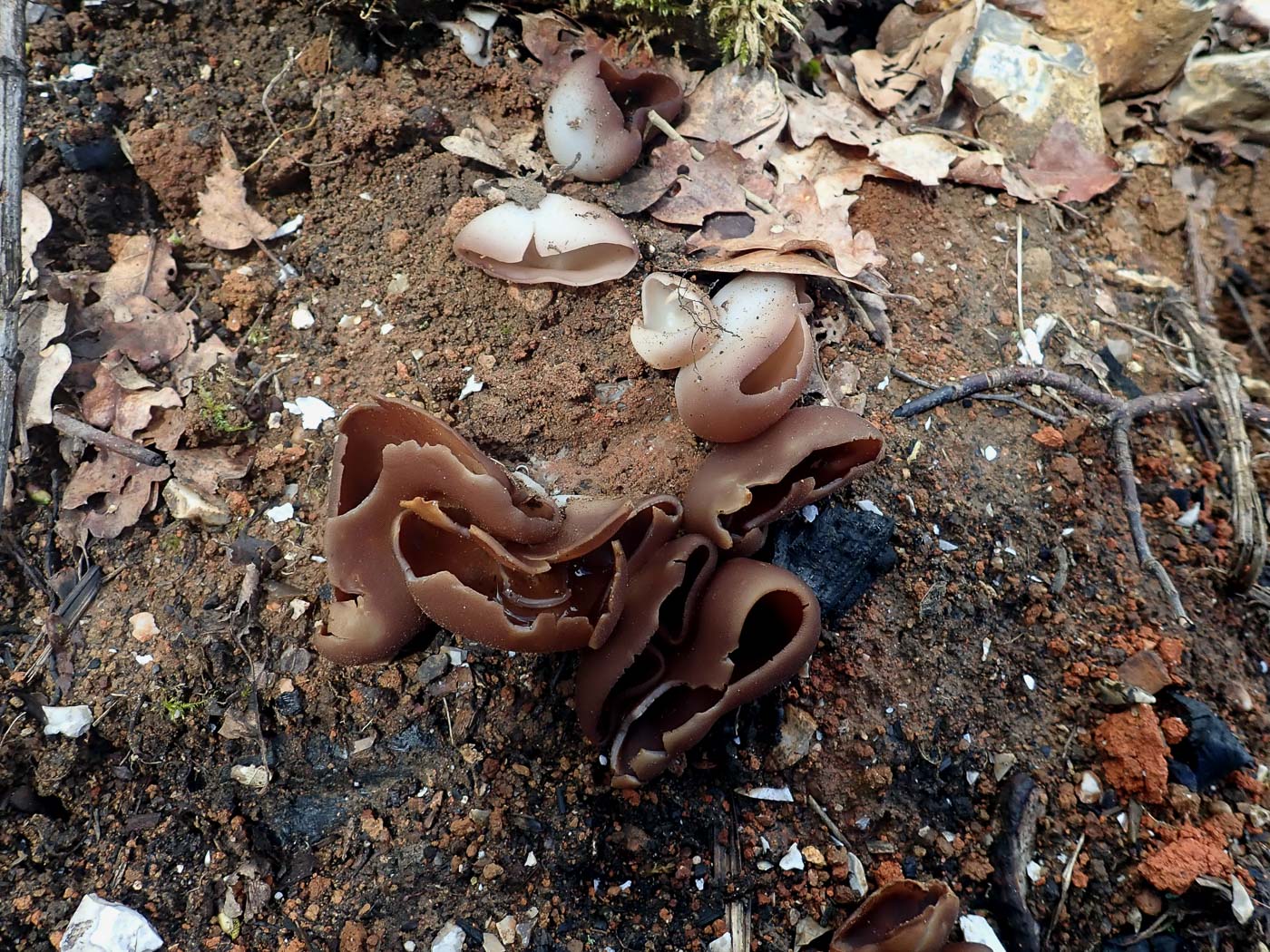
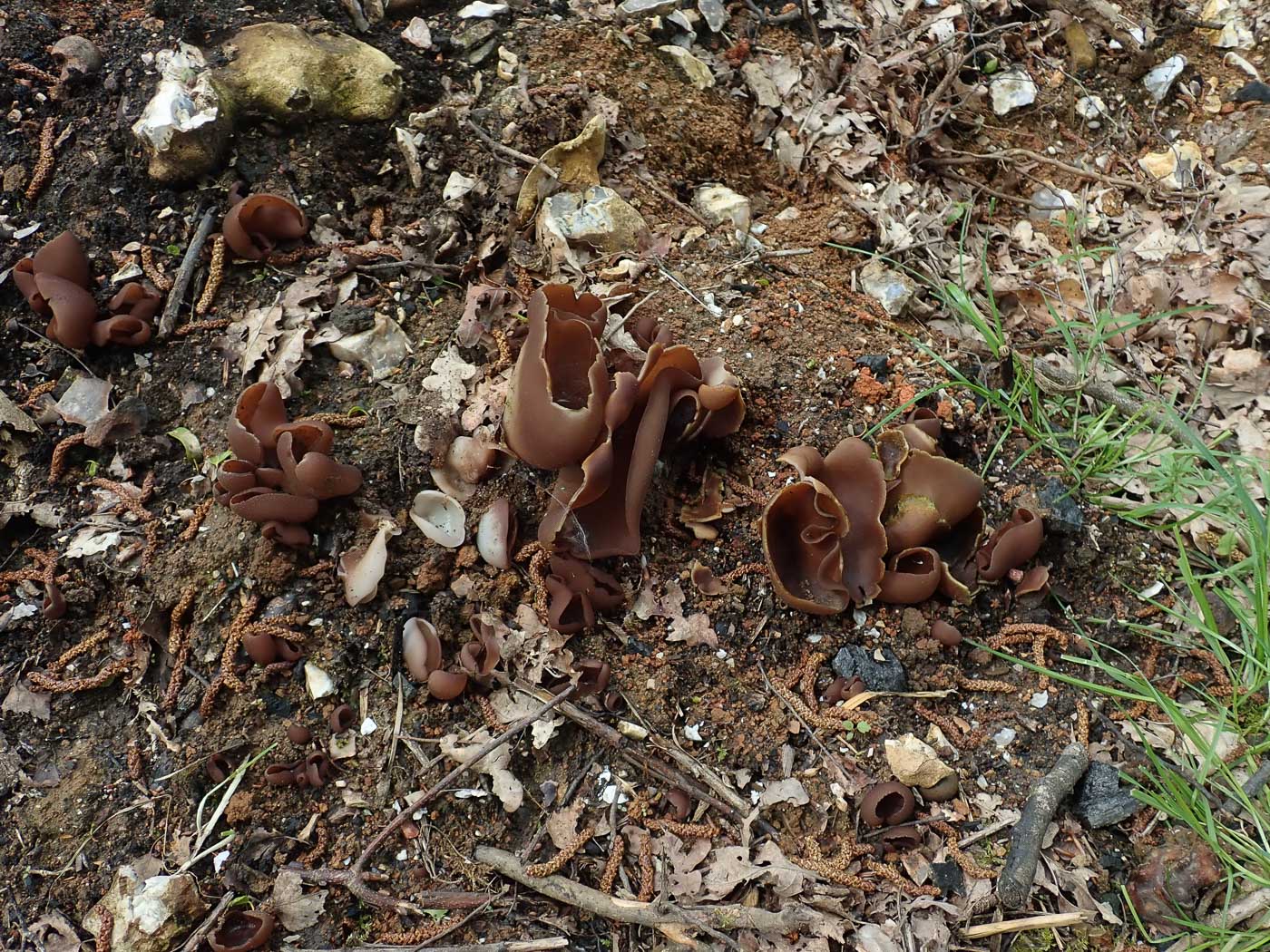 |
April 15th Peziza petersii (a Cup with no common name) 
In a large area of burnt ground at Turville Heath this was the most interesting of three Peziza species found by Penny at this spot today. She was able to recognise it through a combination of features: the dark rich brown colour and clustered habit together with the fact that the species only occurs on burnt ground. The microscopic features confirmed the ID later. (The paler cups in the photo were underneath a log which she had removed for the shot.) We have just a handful of county records and this is a new species for Finds. This was also the first time Penny had found three different Peziza species all in one place! Photo 2 is of the same collection but taken some three weeks later when they were twice the size.
|
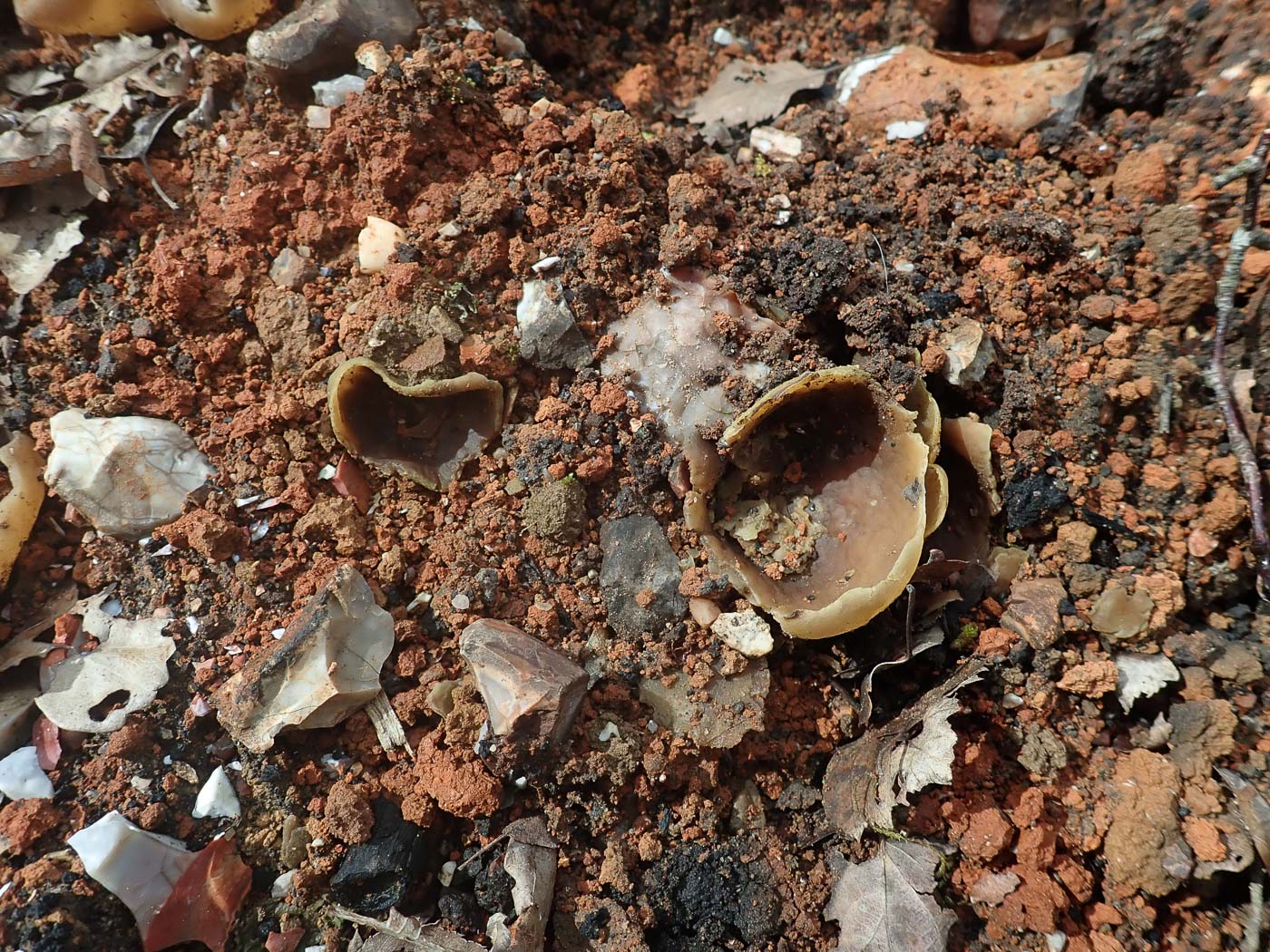 |
April 15th Peziza repanda (Palomino Cup) 
In a large area of burnt ground at Turville Heath this was the second of three species of Peziza Penny found fruiting at this spot today. Though similar in colour to P. arvernensis (see the entry below) it was not only smaller - about 4 cm across - but also a more regular shape hence she suspected it would be different when examined under the scope. This was indeed the case: the spores were clearly different and when viewed in Melzers reagent the asci tips were startlingly blue - another feature of this particular Peziza. It is an occasional species and occurs in soil and on burnt ground but not on wood. This is a first for Finds.
|
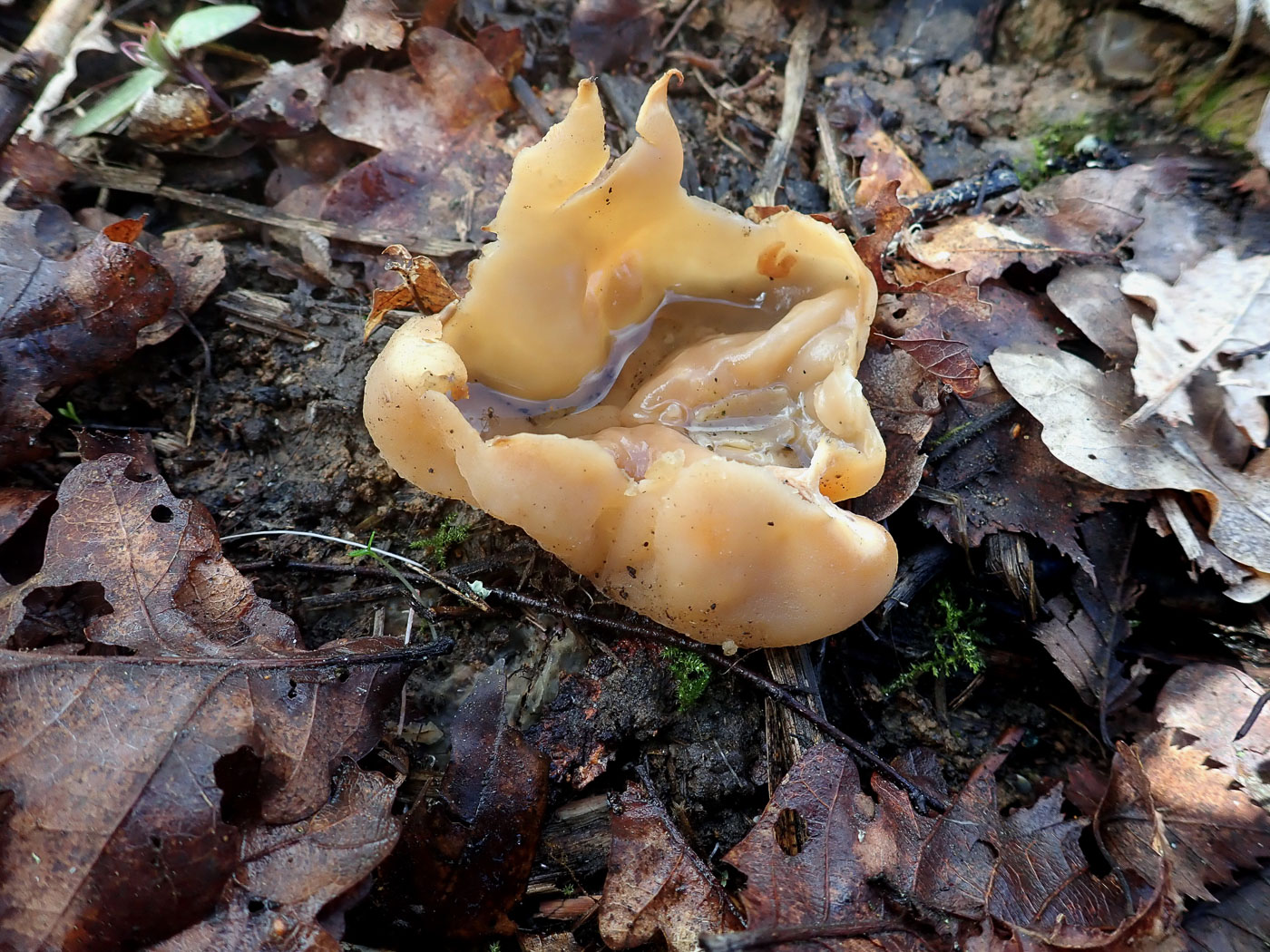
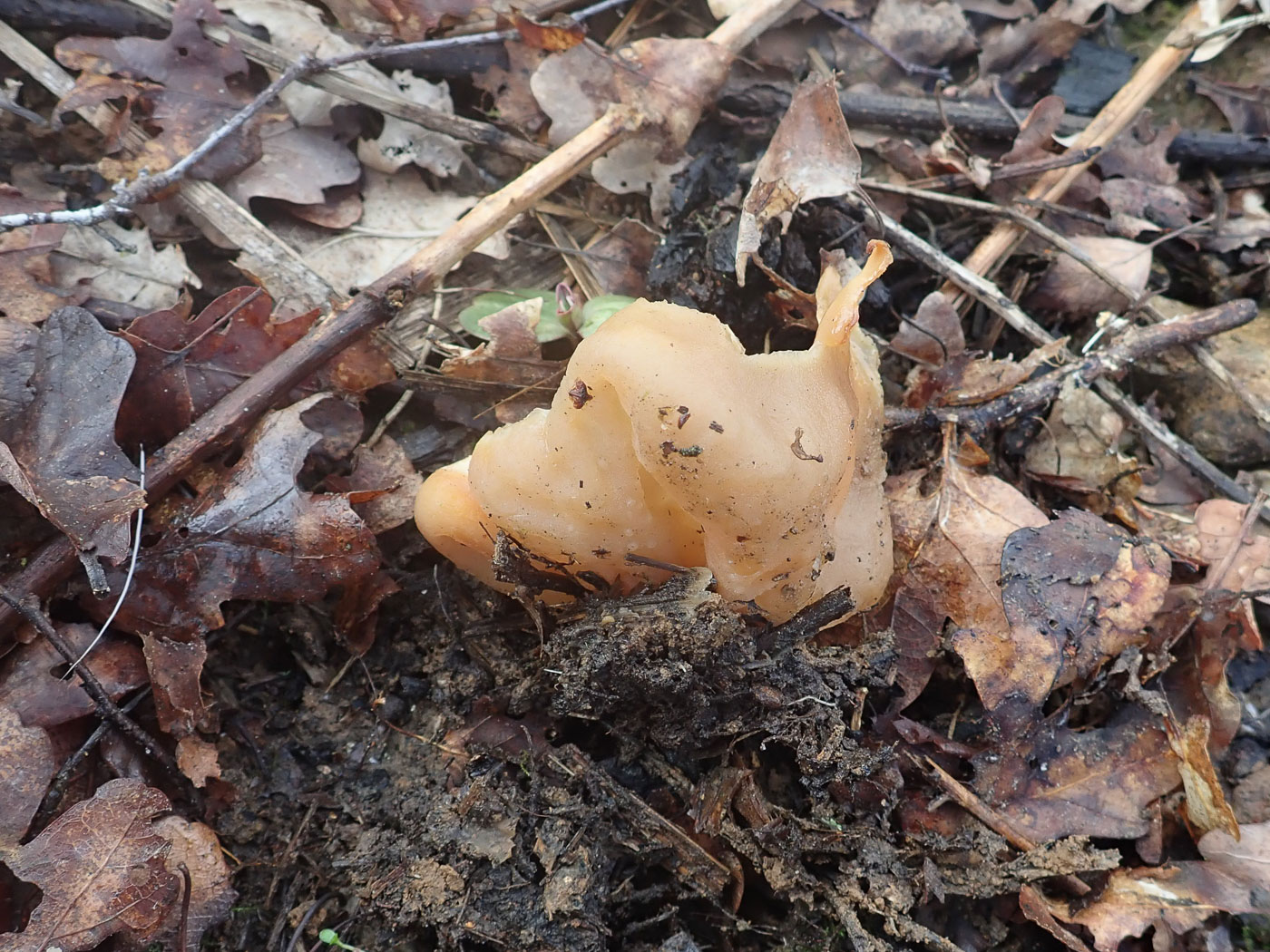 |
April 15th Peziza arvernensis (a Cup Fungus with no common name) 
In soil around the edge of a large burnt site at Turville Heath this was one of three species of Peziza Penny found at this spot today (see above also). This is quite a large Peziza - it was about 8cm across - one of several species which are this soft hazel brown colour, so as well as noting the substrate checking the spores for size, droplets within, also ornamentation is essential in order to separate them. P. arvernensis is an occasional species and occurs in soil and deciduous litter as well as on burnt sites; it tends to become misshapen and undulating as here. See the Masterlist for other examples.
|
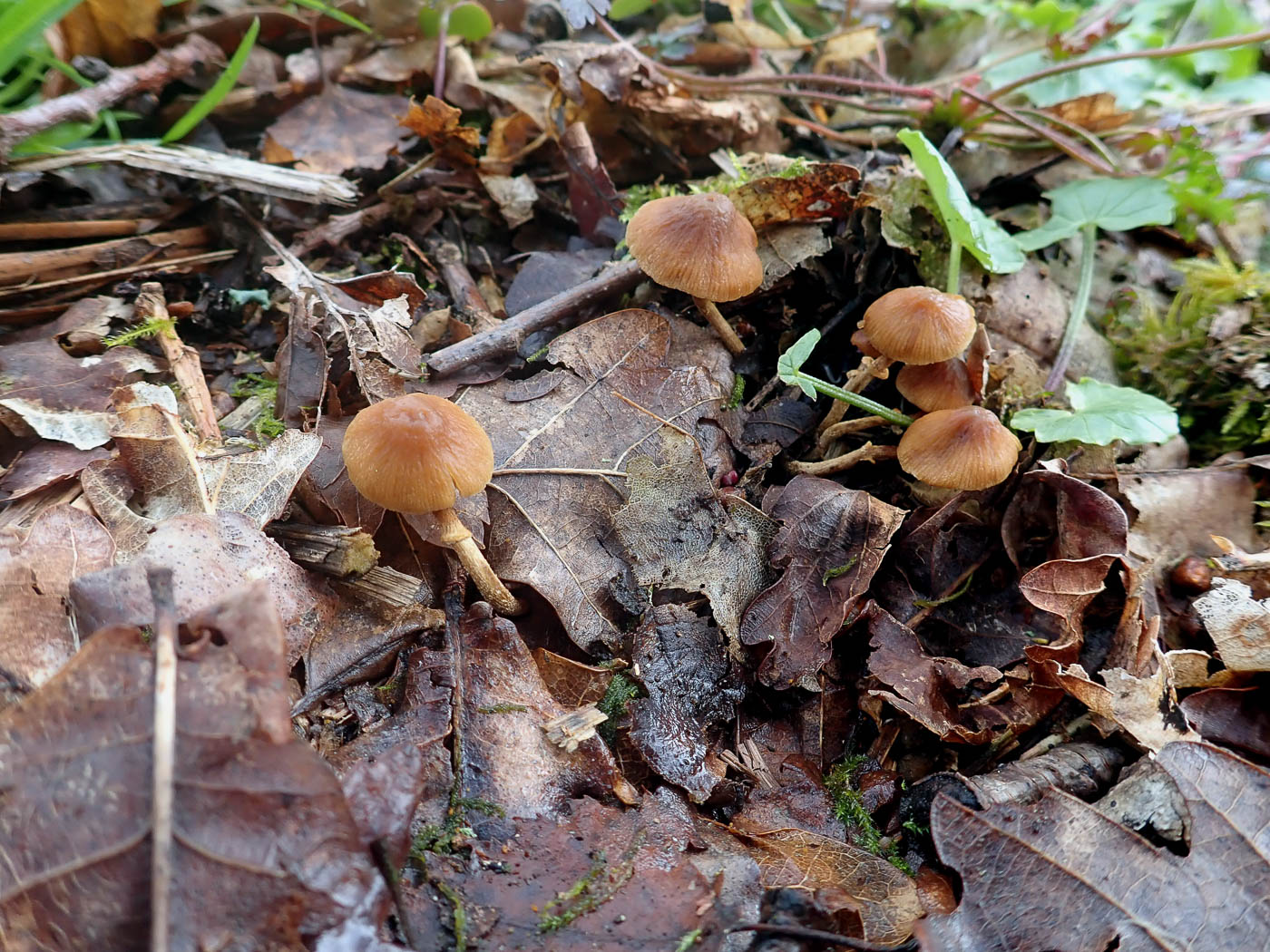
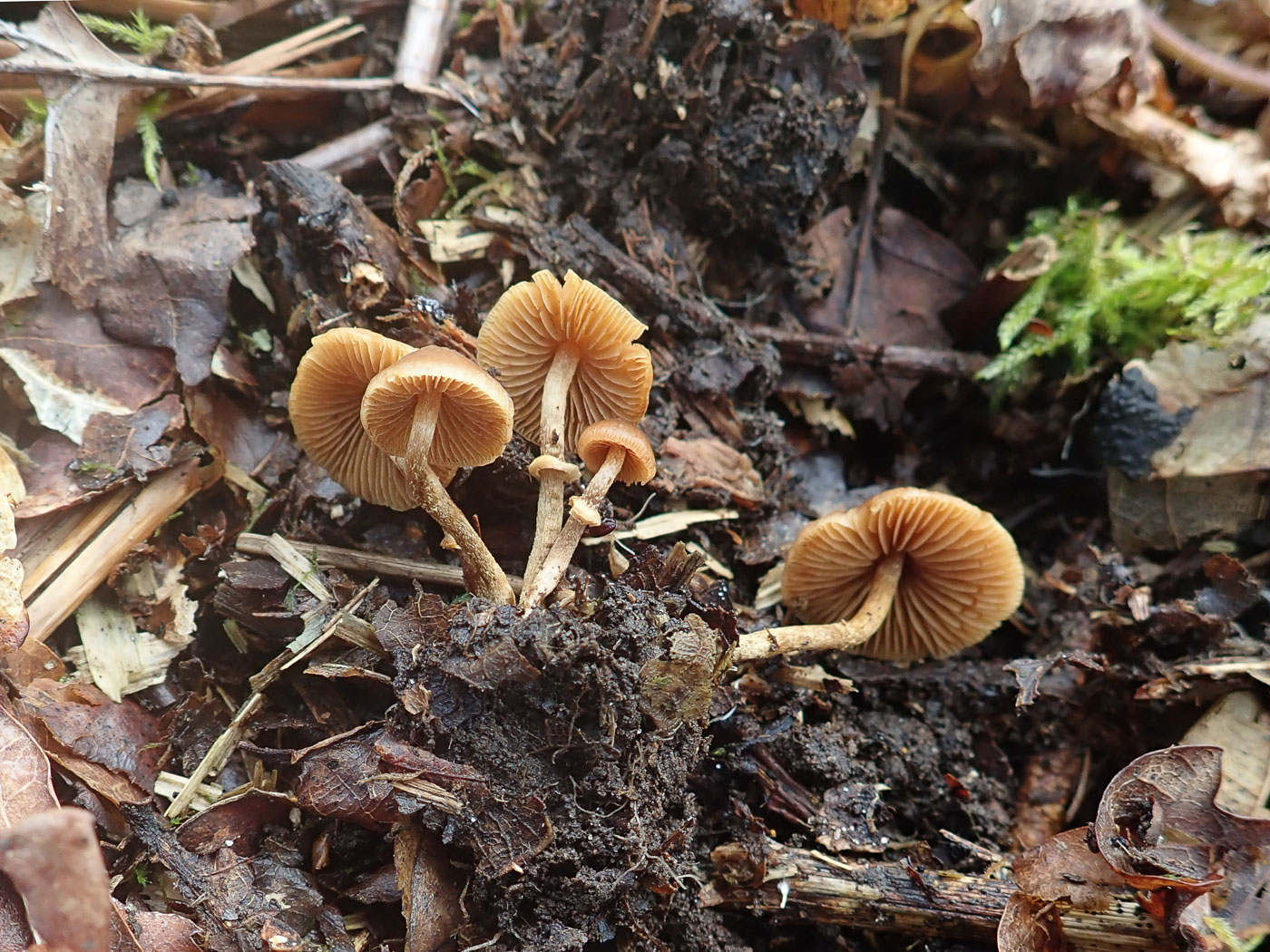
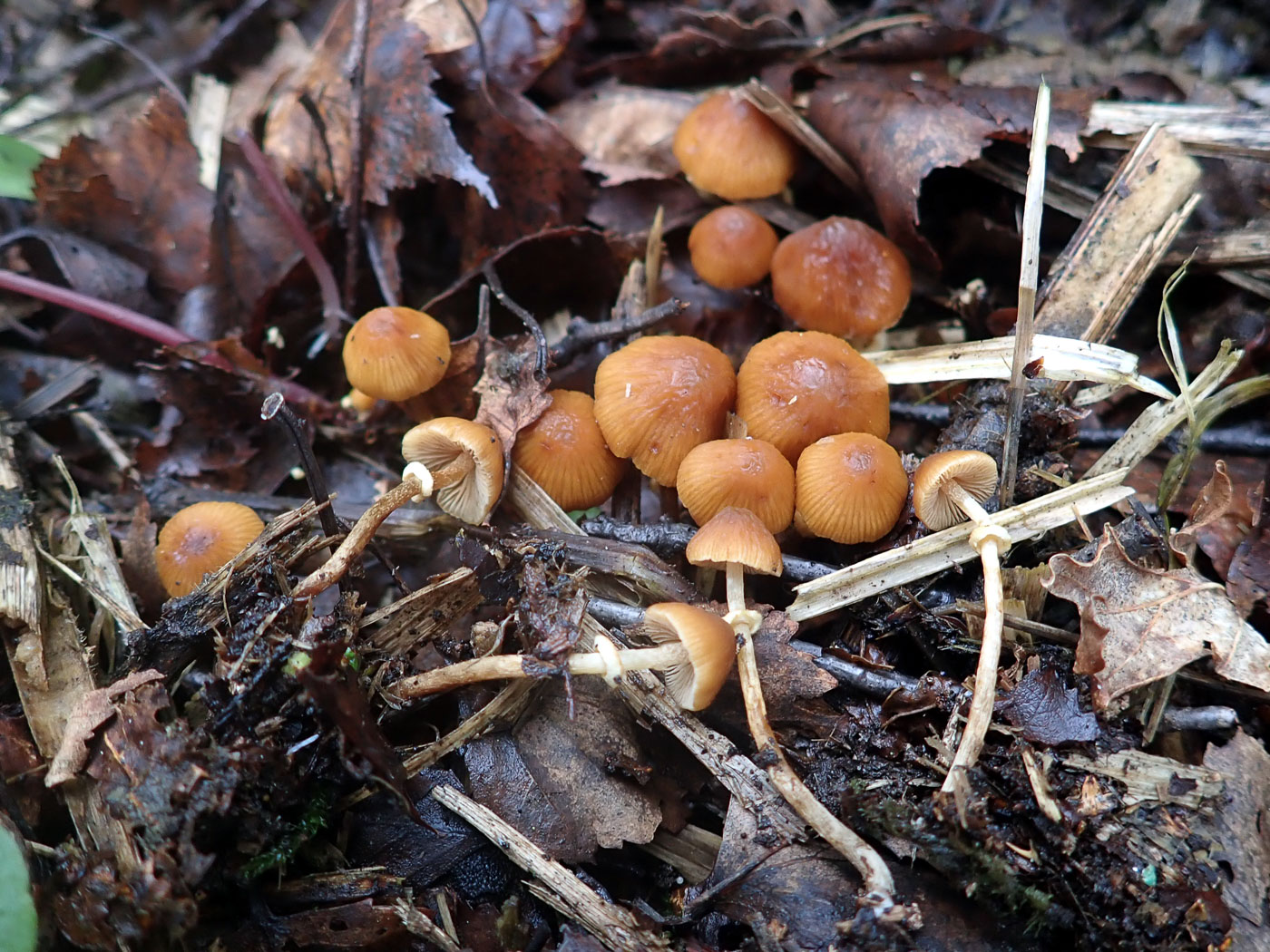 |
April 15th Pholiotina rugosa (a Conecap with no common name) 
At Turville Heath Penny found several clusters of this species in various areas, particularly on the edge of burnt sites where there were woody remains. There is a group of species previously included in the genus Conocybe - those having a stem with a distinct ring or a ring zone as here - which are often moved from that genus to Pholiotina though this is not universally accepted as yet. Recourse to a scope is essential to name them to species as there are a handful which look pretty well identical. The largest cap was only 15mm across, so these are 'Mycenoid' mushrooms but with rusty caps, gills and stems and the ring though distinct when young often disappears with age. Penny has never seen so many specimens in close proximity as they were today. Photos 1 and 2 are of the same collection; photo 3 was a further collection. See the Masterlist for several other examples.
|
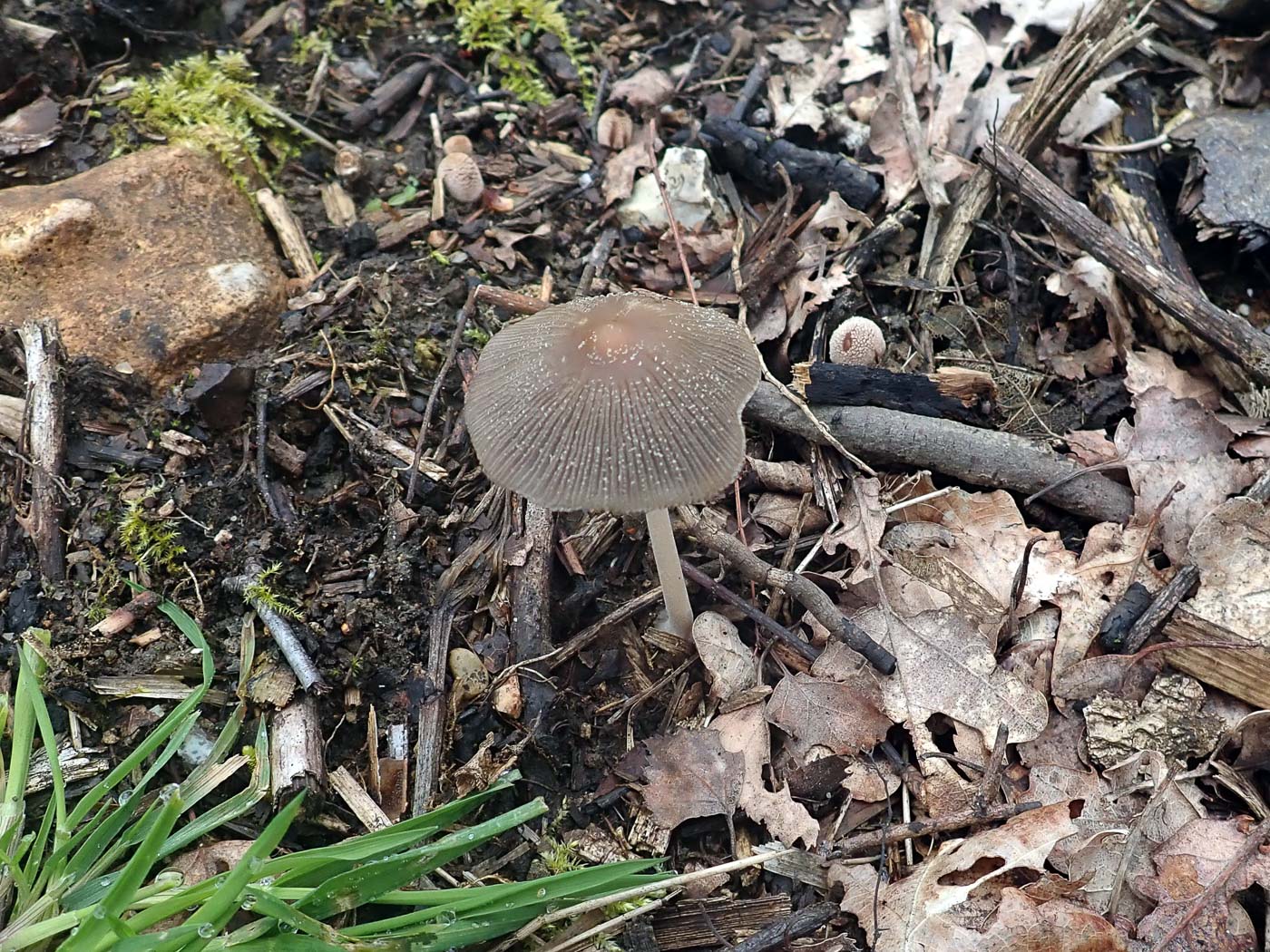
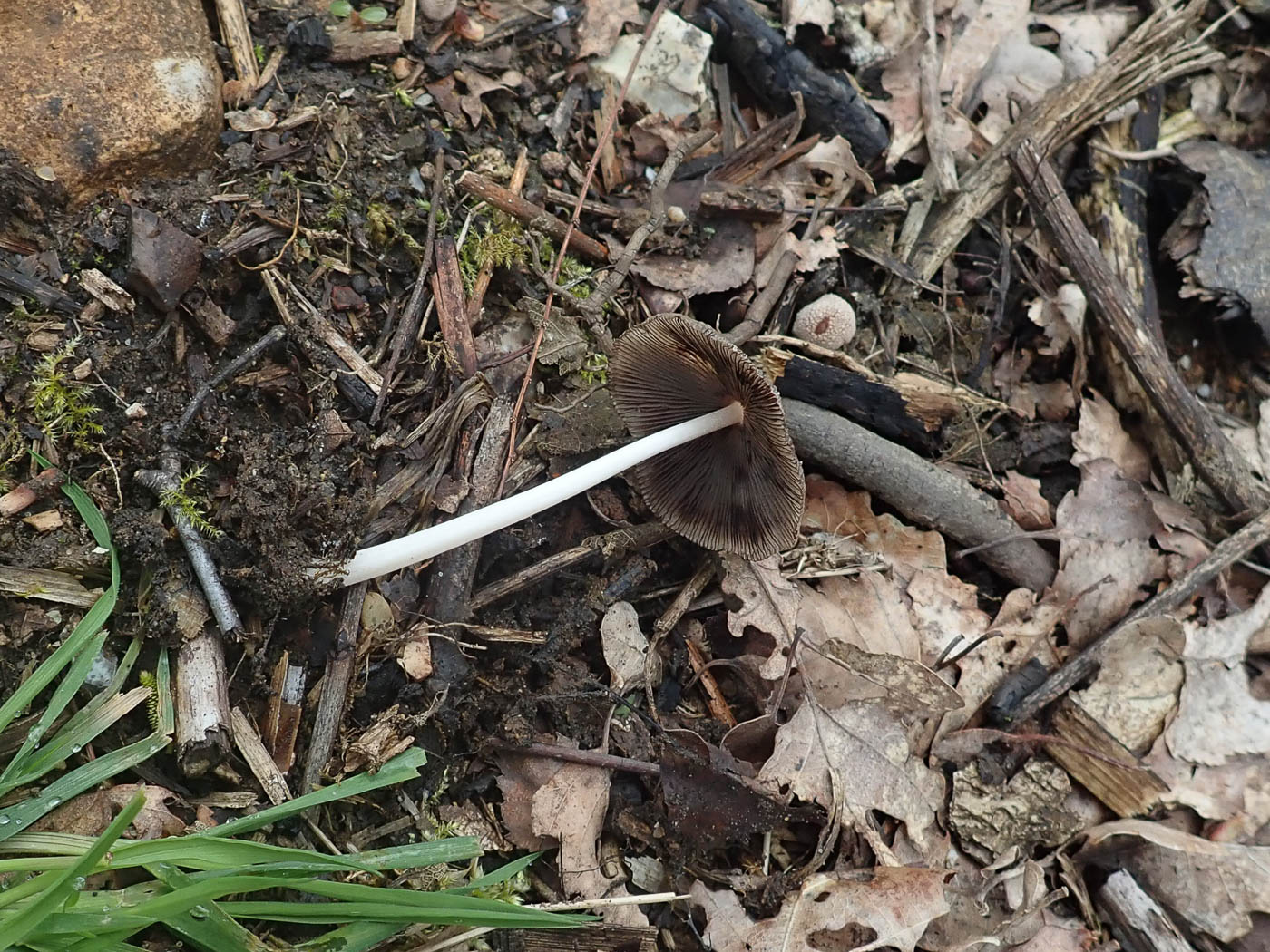 |
April 15th Coprinellus xanthothrix (an Inkcap with no common name) 
At Turville Heath on the edge of a large burnt site Penny found this Inkcap in woody debris. Noting the clear veil remnants on the cap and recalling that this species was found recently on our Rushbeds Wood Walk when identified by Derek, Penny suspected it was the same and the micro-details confirmed it though it was already showing signs of deliquescing by the time she got home! Though not at all rare, this is a new entry for Finds; see the Rushbeds Wood Report (April 2nd) for a much younger specimen.
|
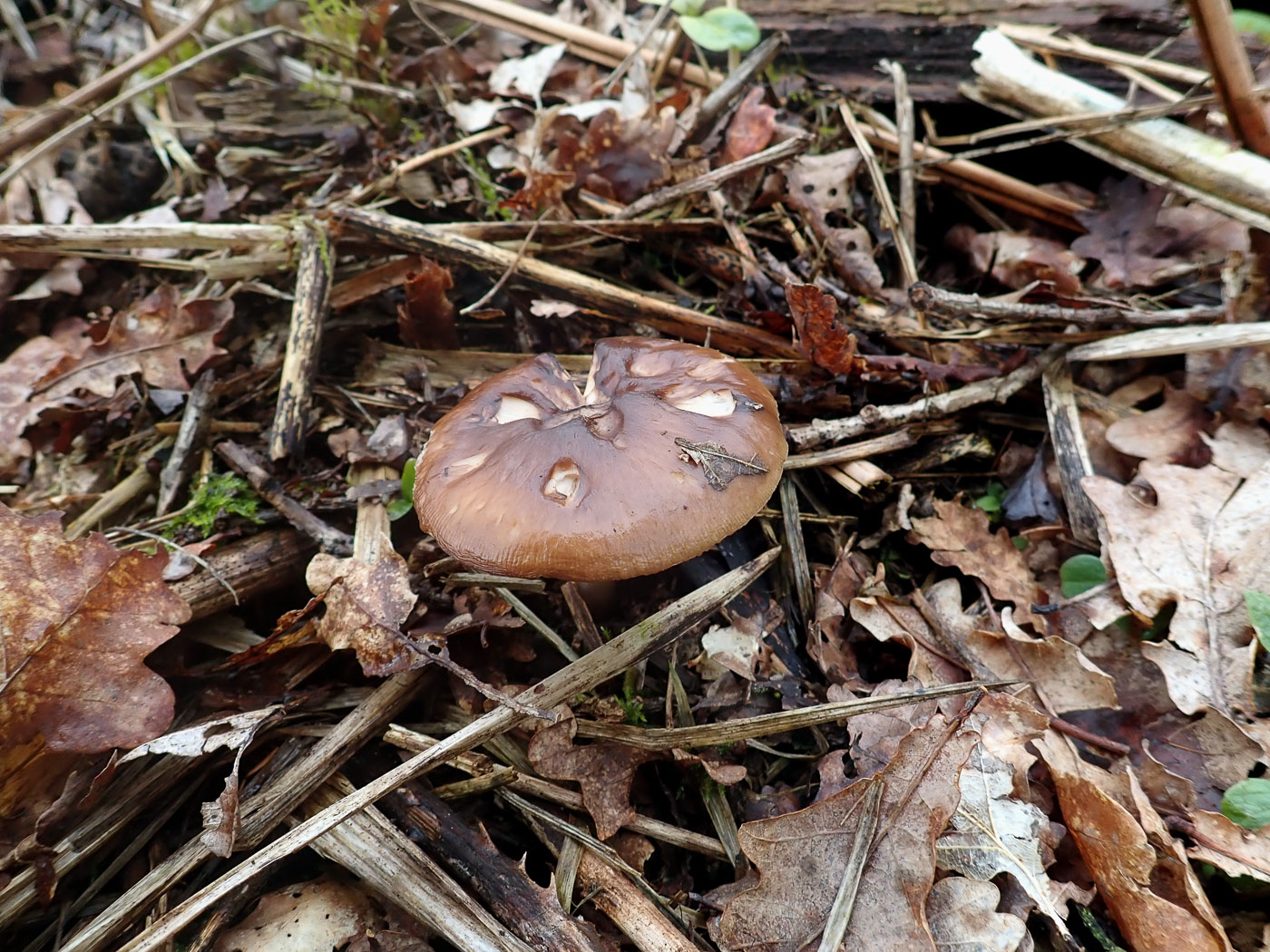
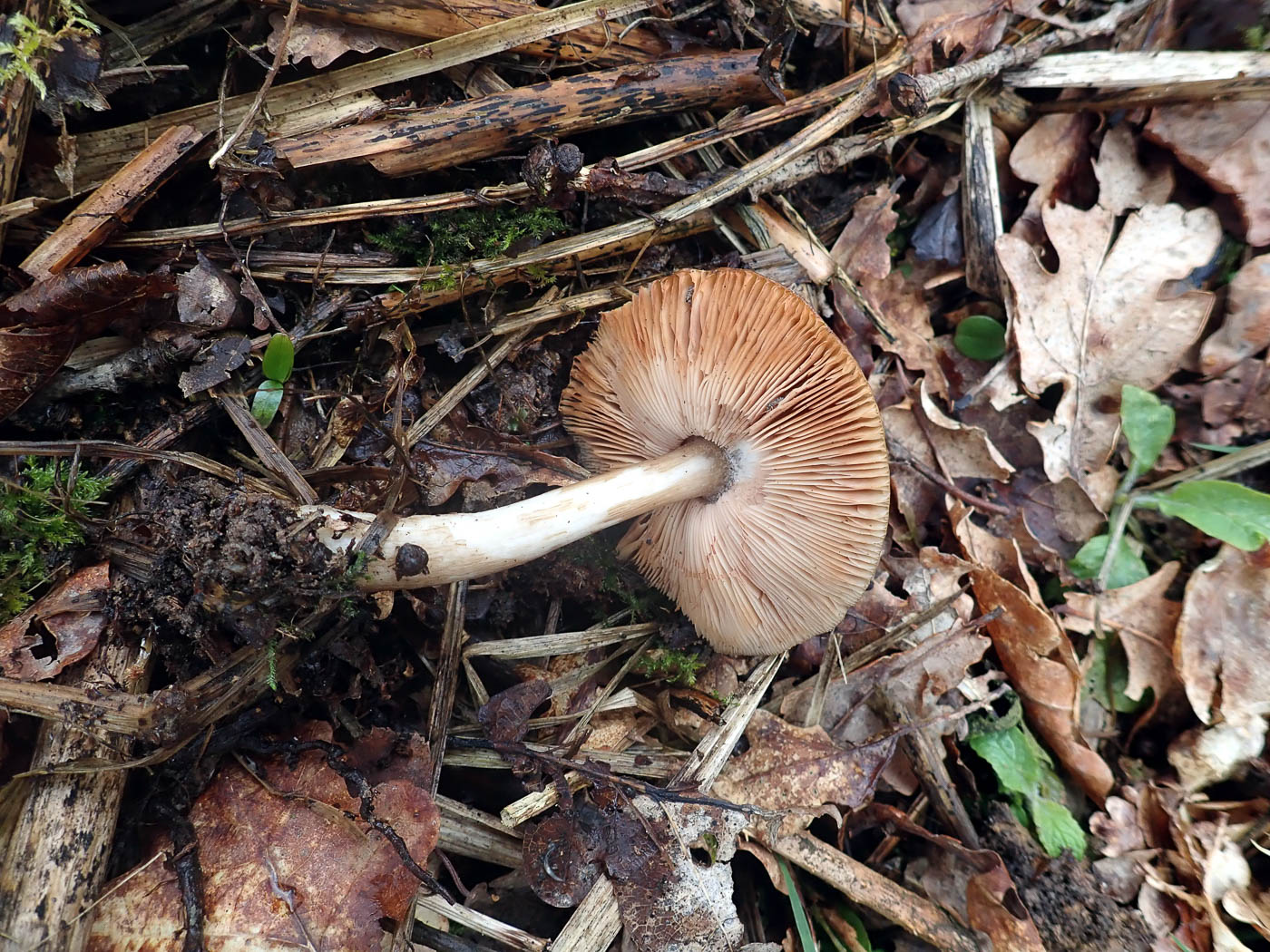 |
April 15th Pluteus cervinus (Deer Shield) 
At Turville Heath Penny found this singleton (cap about 4 cm across) in a pile of felled mixed deciduous logs. A common autumn species found on fallen wood and typically with pink 'free' gills as seen here, it is quite unusual though not unheard of to find it fruiting in April. Of our 350 odd county records the vast majority are autumn finds but we have a handful from April and also from May. See the Masterlist for more examples.
|
April 14th 2023
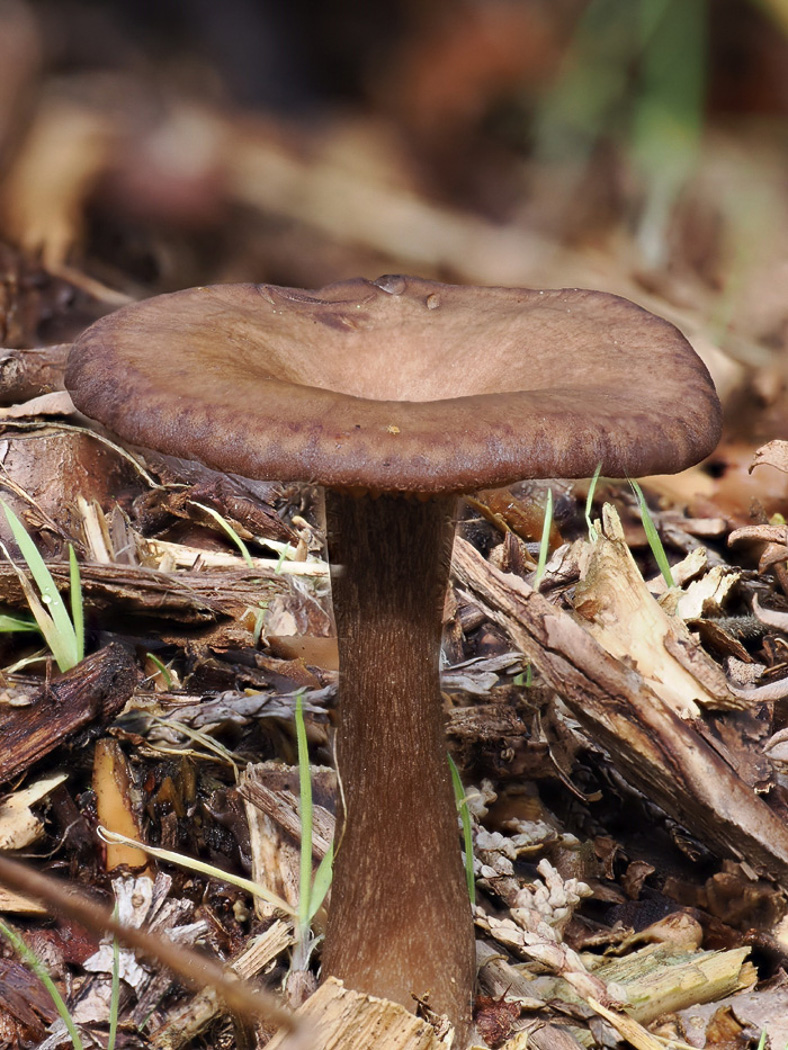 |
April 14th Pseudoclitocybe cyathiformis (Goblet)
In Naphill Common Claire Williams has been noticing this species fruiting on and off in the same woodchip pile for the last year or so. This is quite a common mushroom, its main fruiting season being late Autumn / early Winter, often in grassy places, this reflected by the 60 odd records in our database, none of which are later than February however. So maybe climate change is at play here? Time will tell.
|
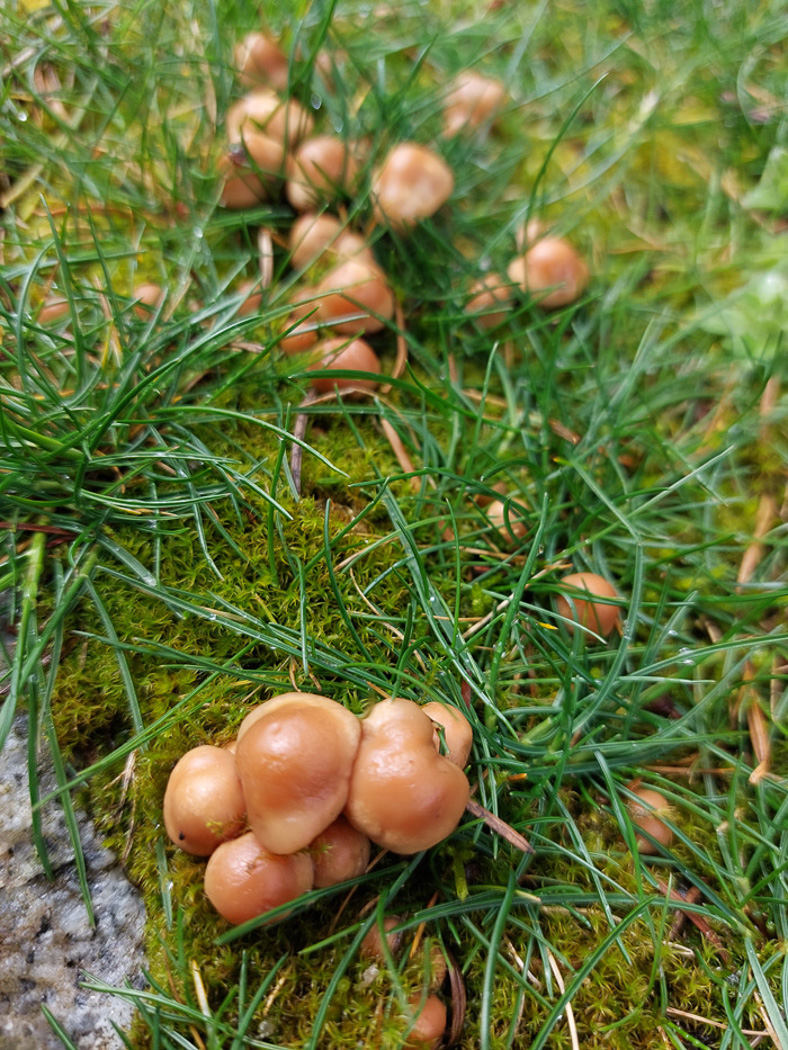 |
April 14th Marasmius oreades (Fairy Ring Champignon)
This is a common species which favours short grass (lawns, sports grounds etc) in summer where it causes 'Fairy Rings', but today's find in Gerrards Cross by Jesper Launder is the earliest of our many records by several weeks. (In fact our only other April record was Penny's from her Amersham garden in 2001!) See the Masterlist for more examples: one from June and two from September.
|
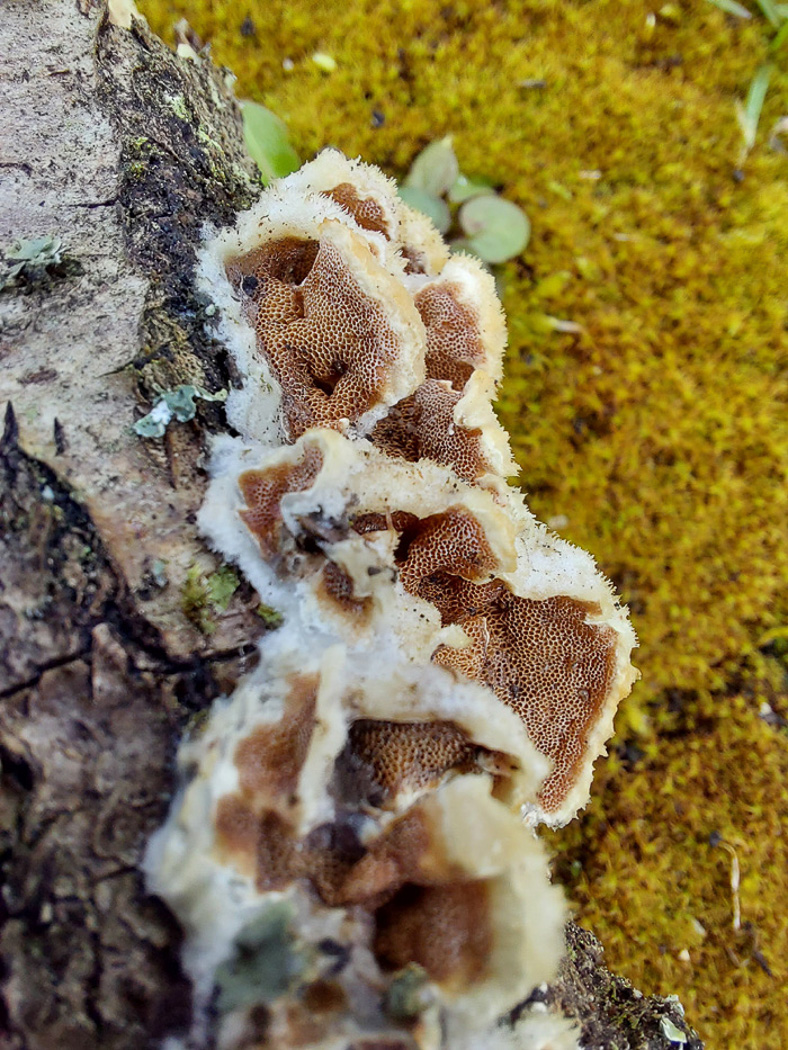
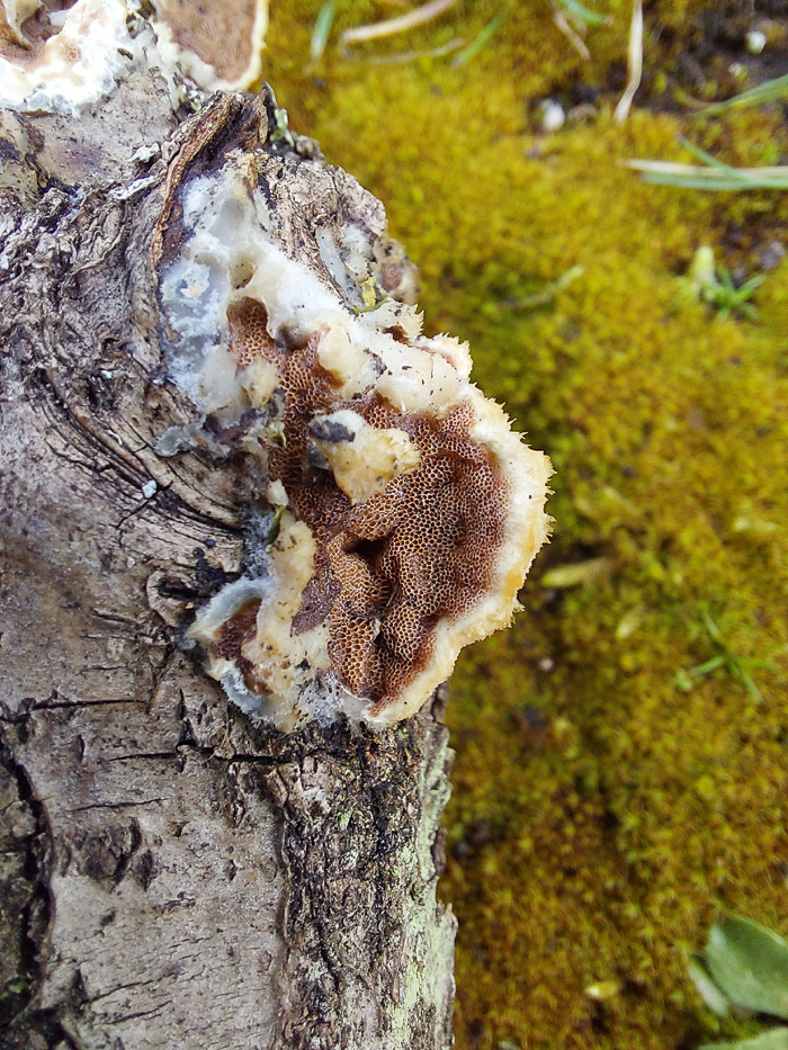 |
April 14th Gloeoporus dichrous (Bicoloured Bracket)
In Gerrards Cross Jesper Launder spotted fresh material of this unusual 'semicorticioid' species, reportedly here on rotting Oak (though to Penny the photos look like Birch?). See also Finds 2023 January 17th for more notes on the species which is unusual in having a rubbery tube layer which can be loosened from the flesh. (Both photos show the distinctive underside of the species.) We have just a handful of sites in the county where it's been recorded previously though it's not rare and is known to occur on both Oak and Birch.
|
April 13th 2023
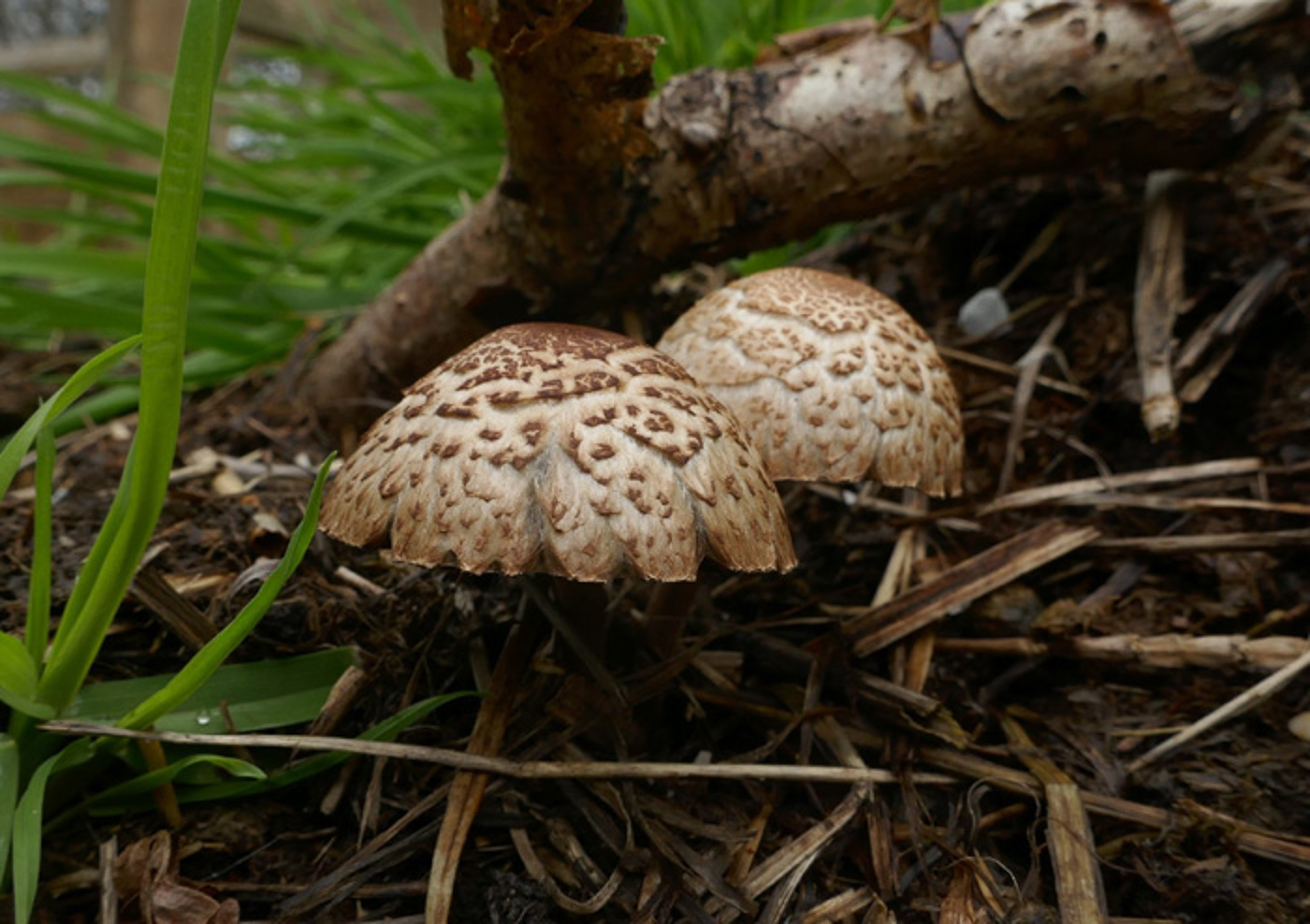
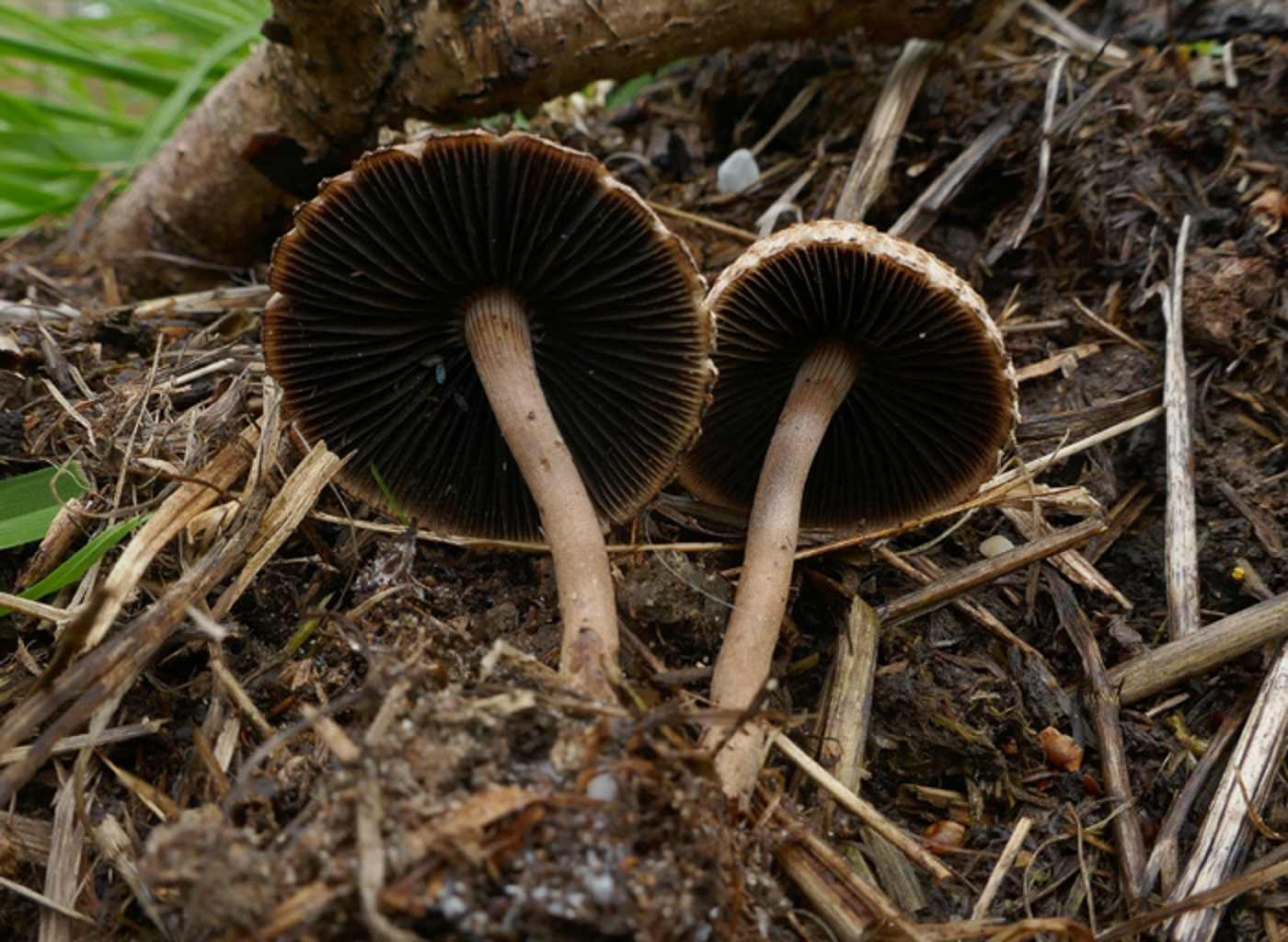
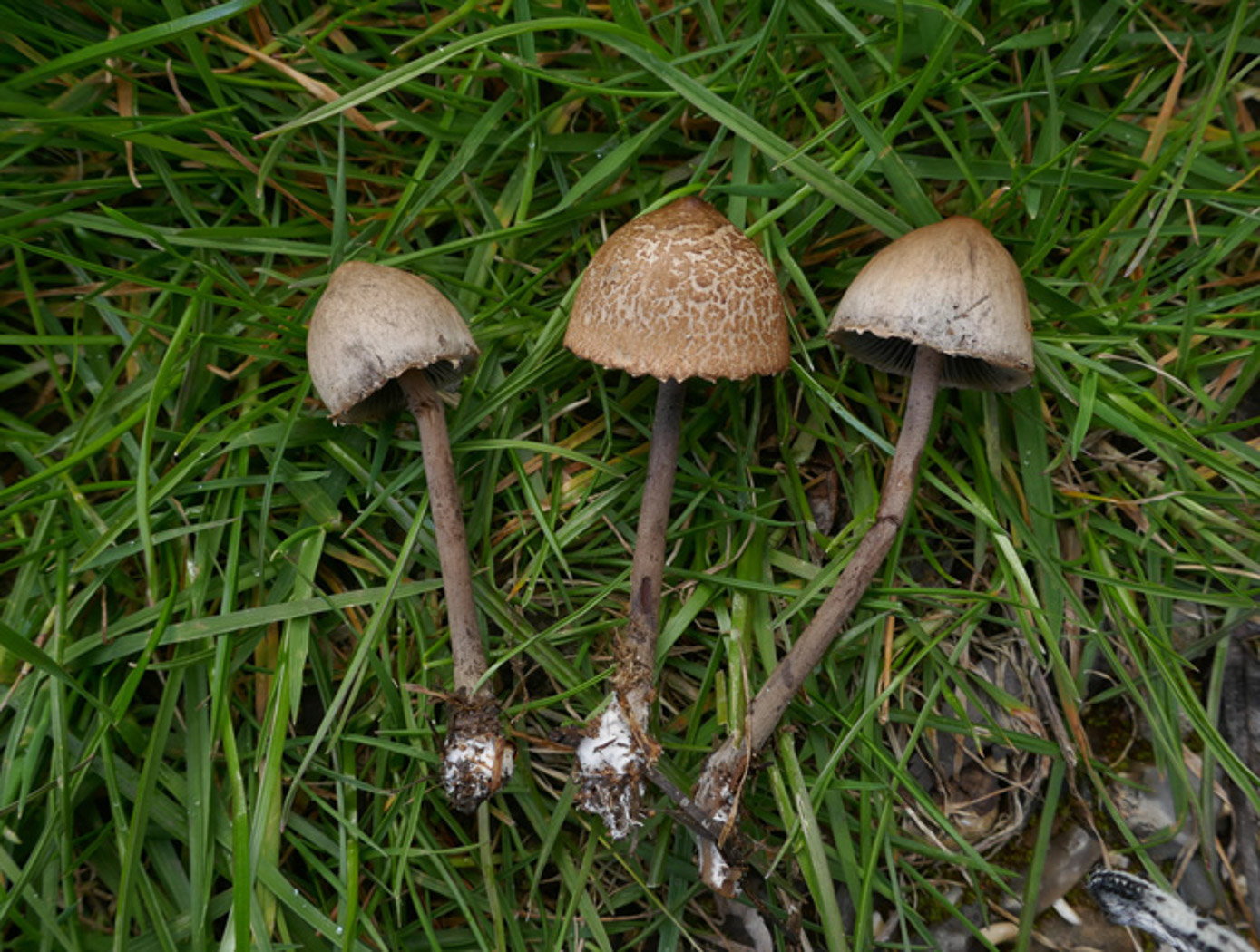 |
April 13th Panaeolus papilionaceus (Petticoat Mottlegill) 
At Stampwell Farm in the same dung heap where Jackie Ewan found this species last month (see March 27th) she found some rather different examples having a cracked darker brown cap surface - seen here - which at first she thought must belong to a different species. Microscopic details were much the same, however, and the caps had the same frilly petticoat edge of this species, so she asked Penny for a second opinion. In fact there is mention in several texts of the cap surface cracking as here in sunny dry conditions, also several online images show this feature, furthermore Jackie noticed the following day a cluster with both smooth and cracked caps together (photo 3). This illustrates the disadvantage of following any one handbook with space for only a single illustration which can never do justice to the variety of guises one species of fungus can display. So these images are a useful addition to those in our Masterlist.
|
April 8th 2023
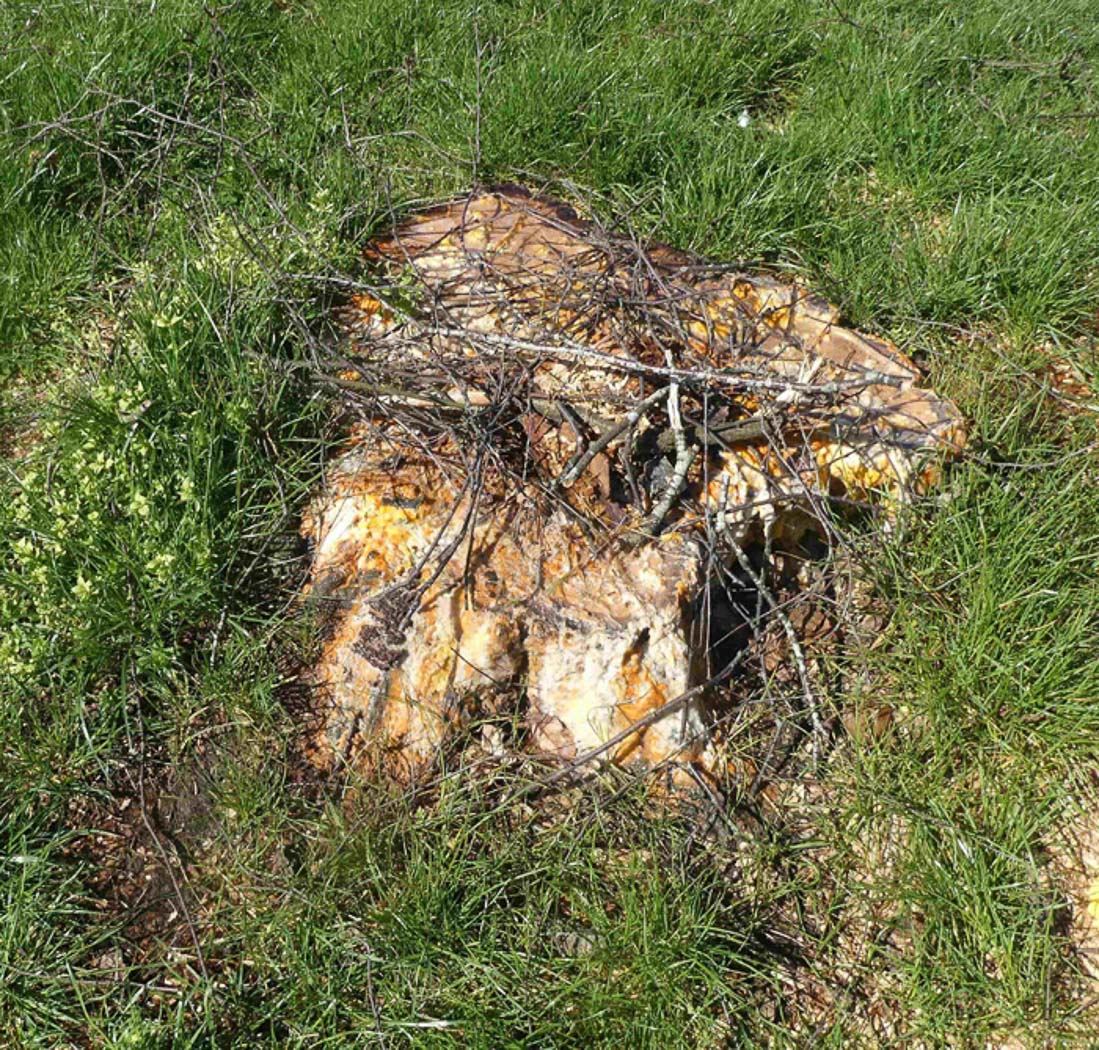
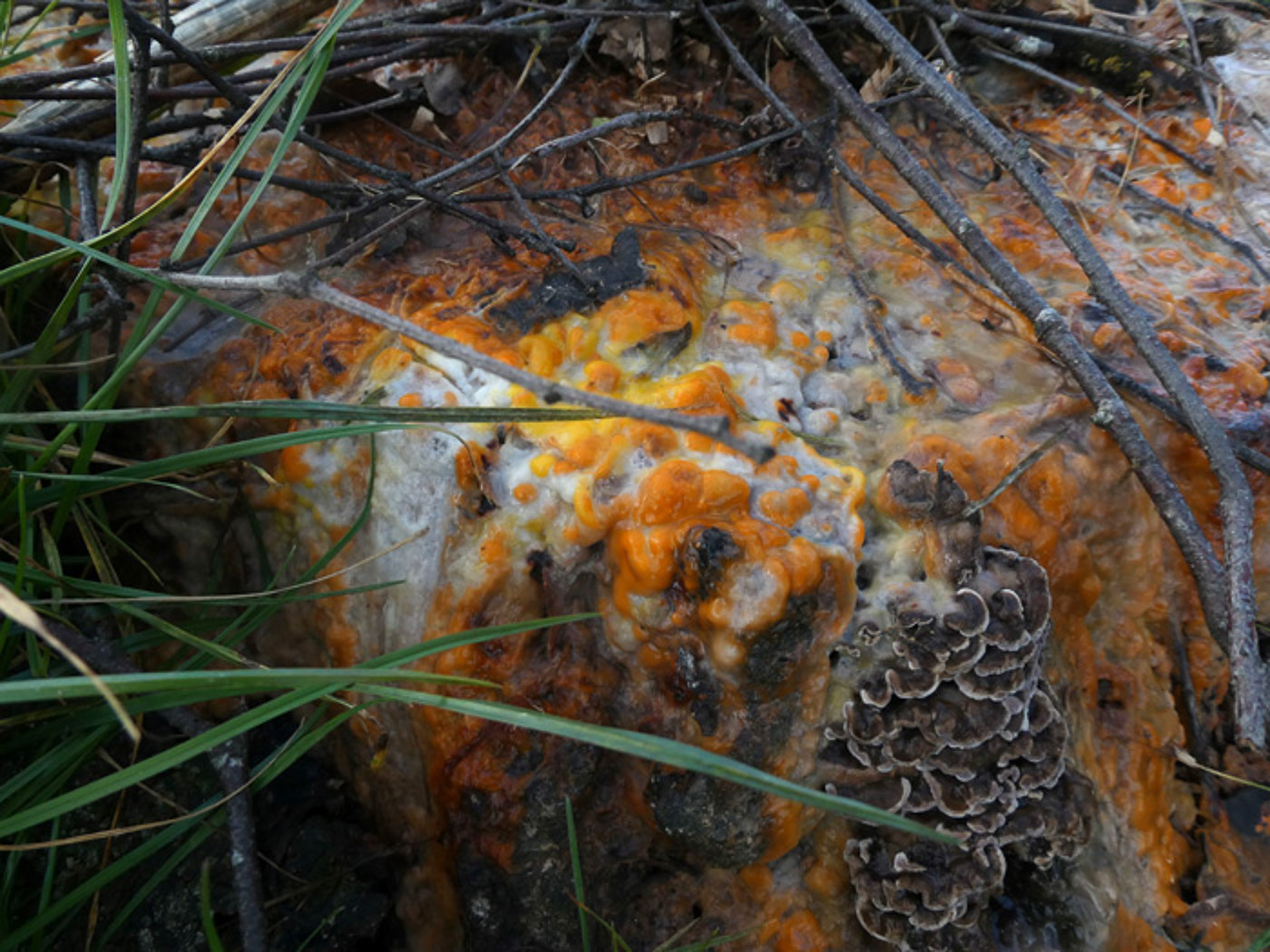
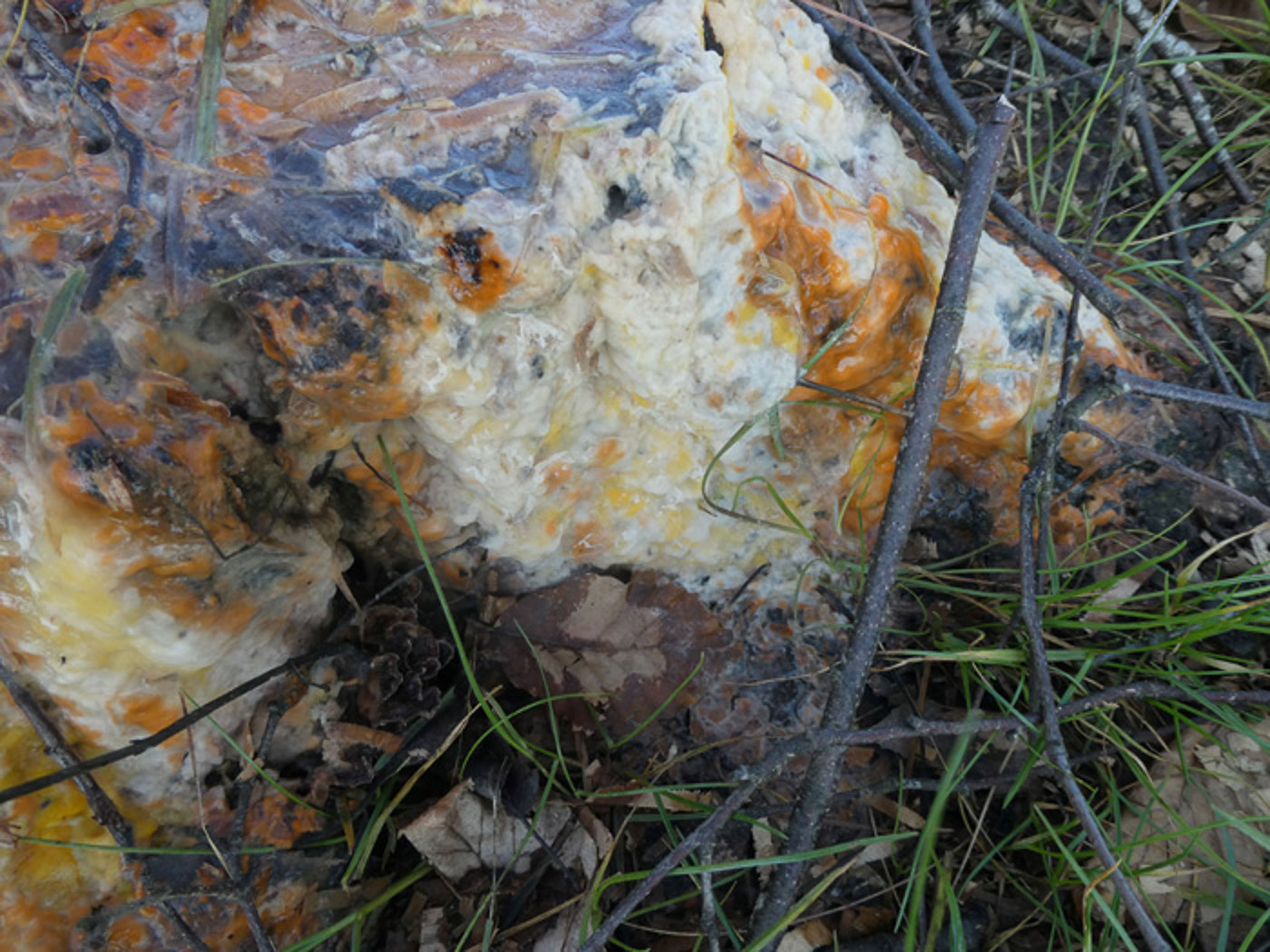 |
April 8th Fusicolla merismoides (Slime Flux / Deer Vomit)
In Gold Hill Common (Gerrards Cross) Jim Wills was intrigued by this large patch of 'slimy mess' spreading all over the top and sides of a deciduous stump (photo 1). A few days later he returned to see how it was developing (photos 2 and 3), then searched online and discovered about this strange fungal phenomenon (not a Slime Mould). It starts out as a bacterial infection of the tree sap which as it grows and breaks out of the wood gets infected by a 'potpourri' of fungal species thought to be related to Nectria (as in Coral Spot), also possibly some Yeast species which result in its sweet smell. It apparently occurs in Spring and is yet to be fully understood. Jim says in fact it was not slimy or sticky but just appeared wet even on warm dry days. (The bracket seen in photo 2 is in fact Chondrostereum purpureum (Silverleaf Fungus) and not connected to the Fusicolla.) The common names given here are taken from the web and are not included in the official list of common names. For further information explore the web. This is a first for Bucks and for Finds though no doubt has been seen here before but not researched and named as done by Jim.
|
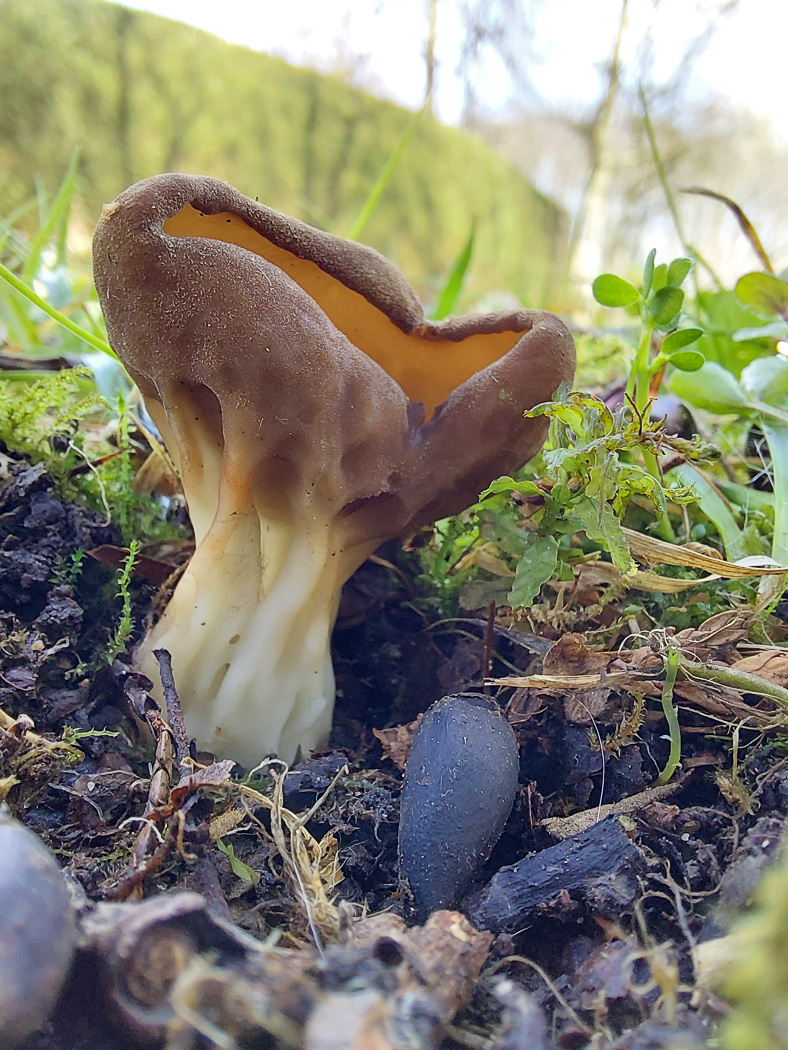
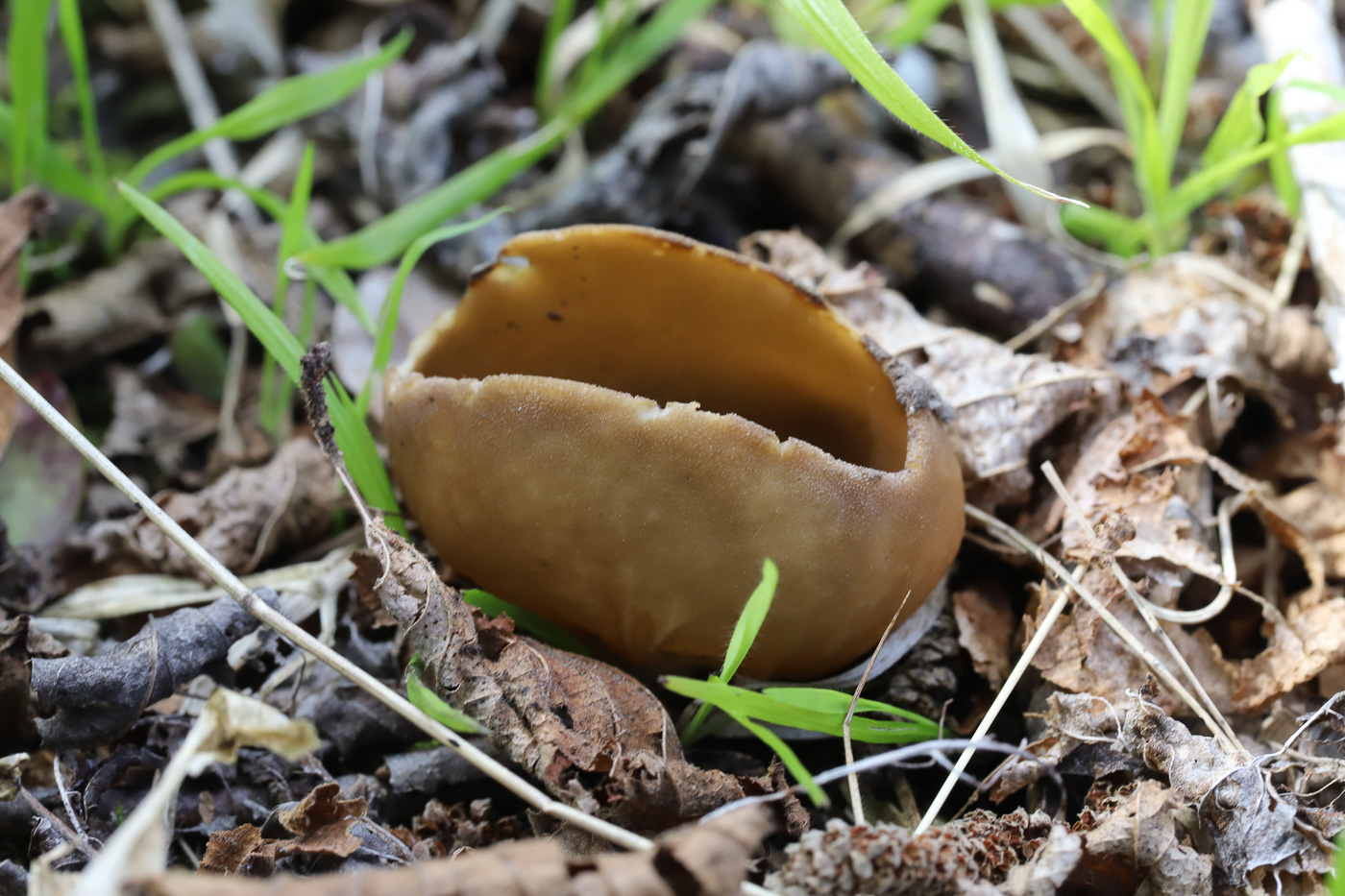 |
April 8th Helvella acetabulum (Vinegar Cup)
In Jordans Village Jesper Launder was pleased to spot this unusual springtime fruiter - one he's not seen in the village before despite his regular forays around the area. (The Latin species name indicates a vessel used to store vinegar in the distant past.) The species could possibly be confused with the similar Disciotis venosa (Bleach Cup) which also fruits now and is another large brown cup growing in soil in grassy areas, also under trees. The main distinguishing features: the Helvella has a smooth inner surface and a prominent cream stem having marked sometimes forking ribs, whereas the Disciotis develops a wrinkled inner surface and has hardly any stem; furthermore the Helvella lacks a distinct smell but the Disciotis has a strong smell of bleach when damaged. We appear to have just three previous county records of today's species; see also in Finds 2021 May 13th. Photo 2 was taken by Philip Townsend 3 weeks later at Ragpits BBOWT Reserve.
|
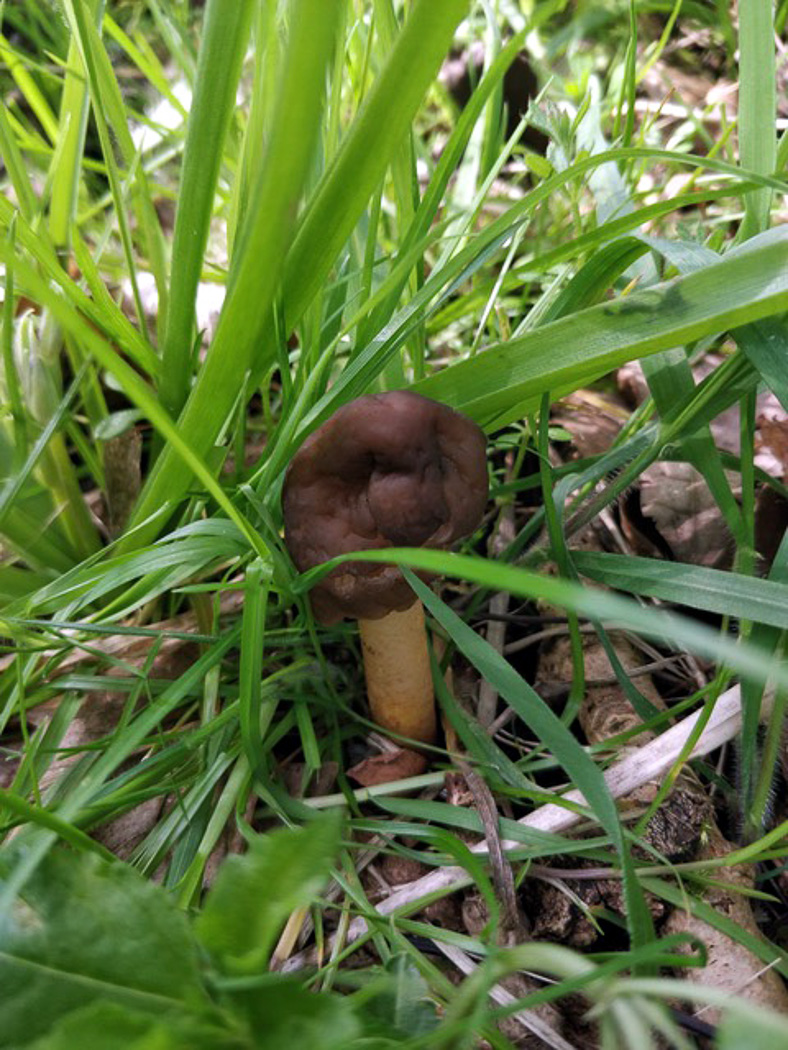
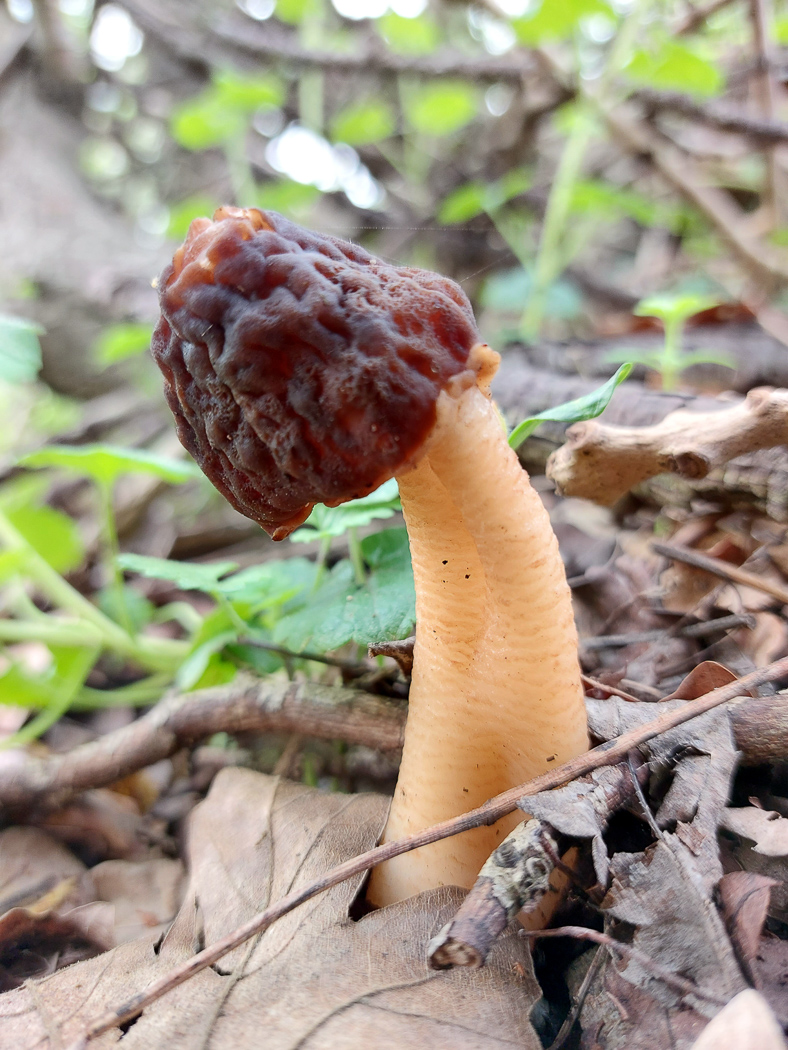
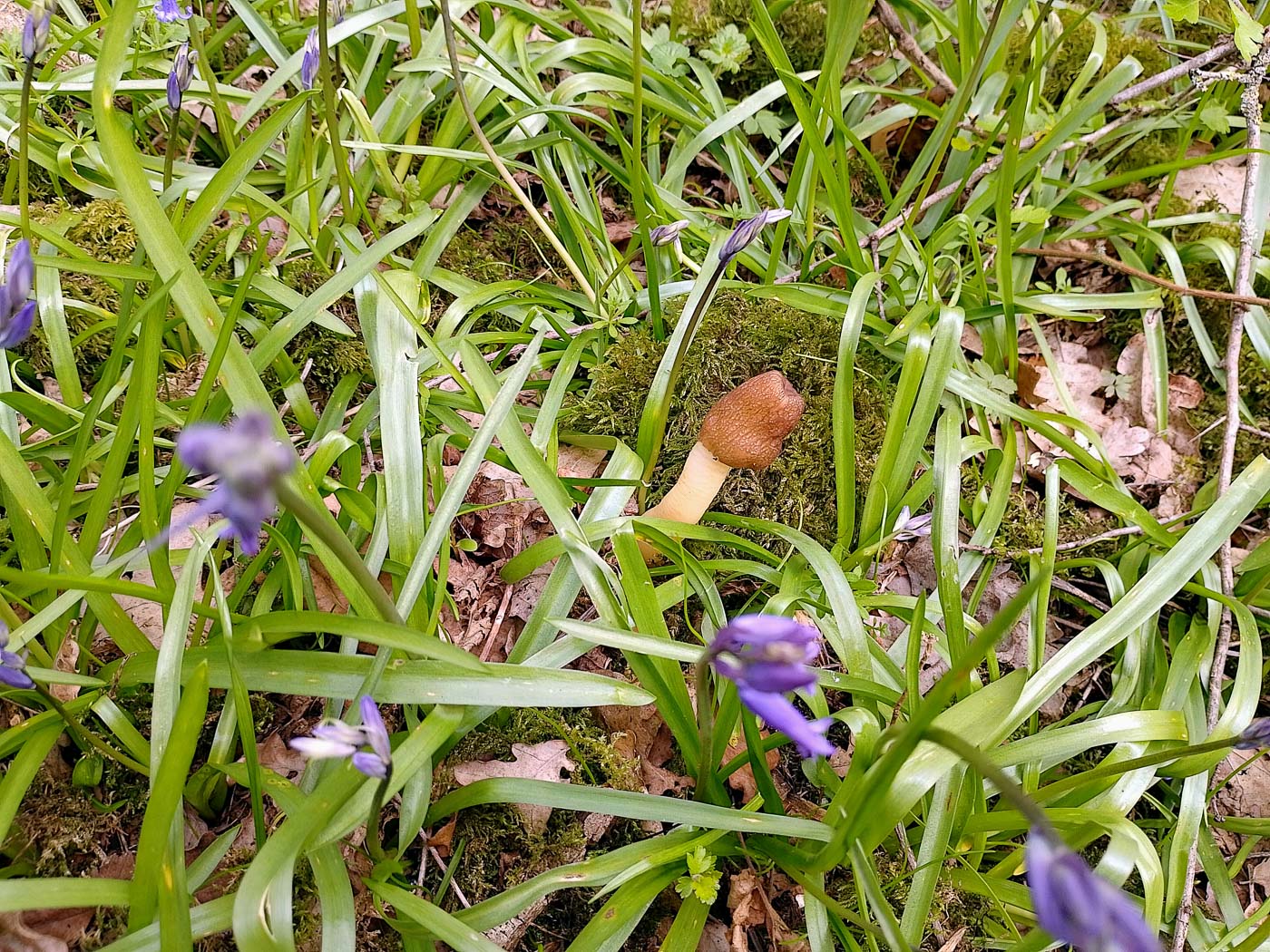
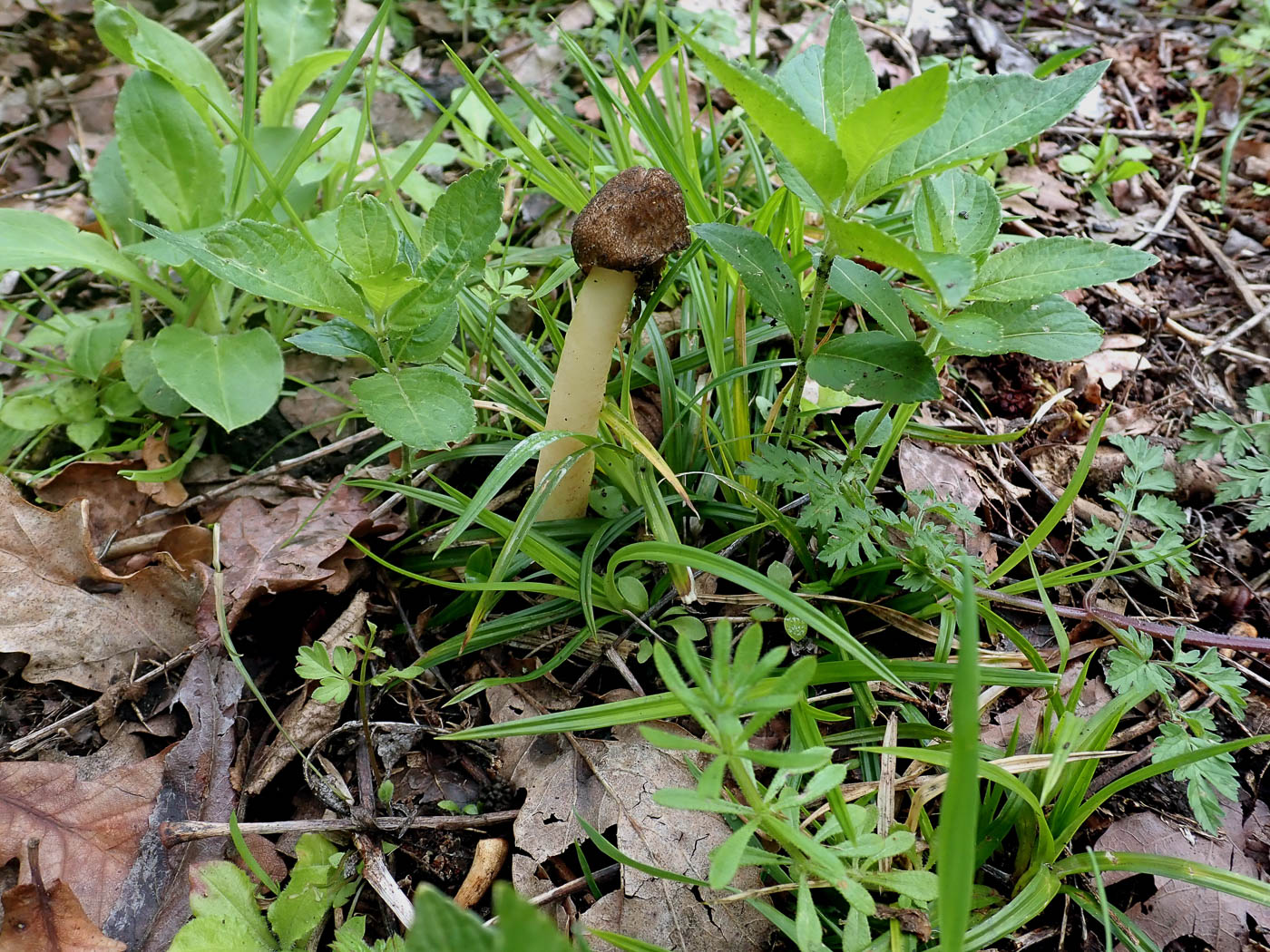
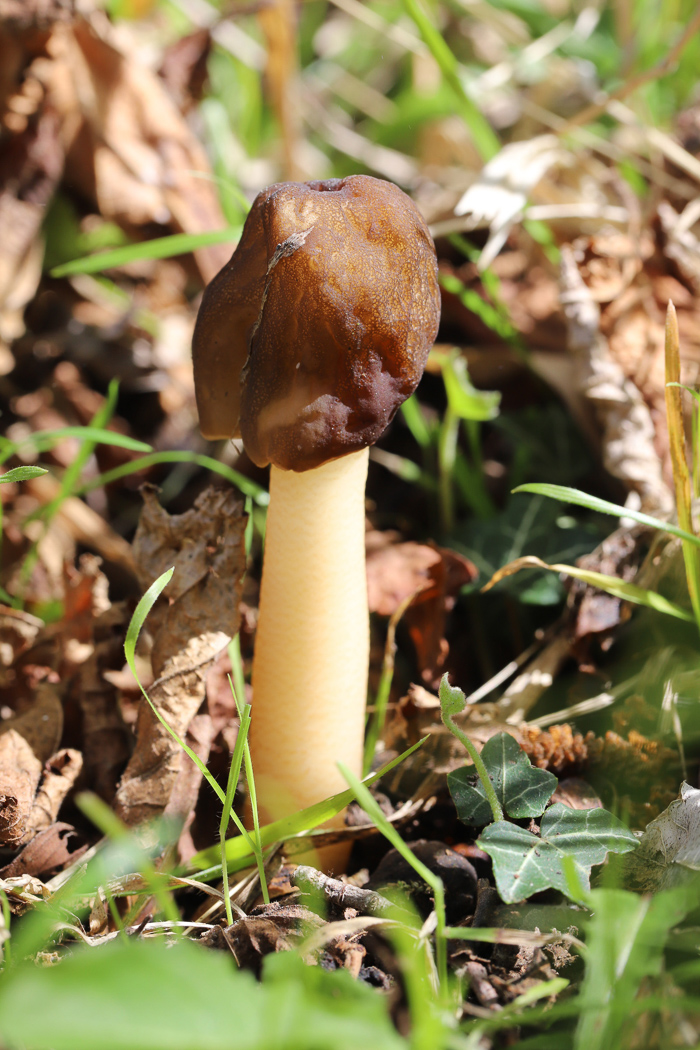 |
April 8th Verpa conica (Thimble Morel)
In Salden Wood under Hawthorn Bob came across this singleton, a species we also found at Rushbeds Wood on April 2nd and one which seems to be appearing in quite a few place now. Though a species of Morel, it lacks the typical honeycomb cavities of the Morchella genus having instead a rather wrinkled outer surface, hence its different genus. We have a handful of county sites where it's been found, and though not rare this is a first for Finds. Photo 2 shows a fully mature specimen and was found 9 days later in Gerrards Cross by Jesper Launder. Photo 3, taken 10 days later, was sent to Penny by BBOWT Ecology Officer Andy Coulson-Phillips for identification and was found amongst the bluebells at Finemere Woods. He said there were a dozen or so within a few meters square. Photo 4 was a singleton found by Penny at Rushbeds Wood on April 24th. Photo 5 was taken by Philip Townsend on April 29th at Ragpits BBOWT Reserve.
|
April 7th 2023
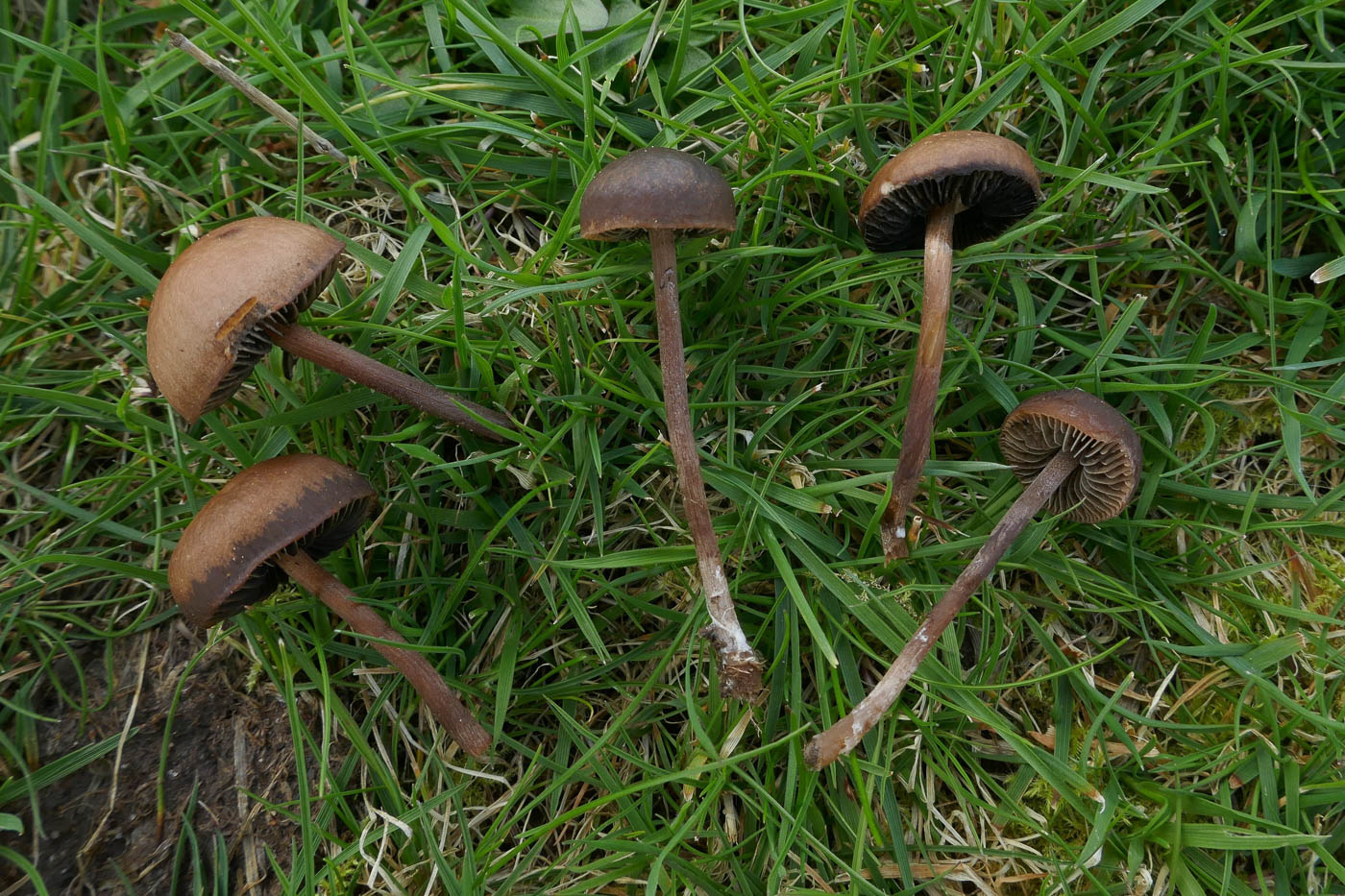 |
April 7th Panaeolus fimicola (Turf Mottlegill) 
At Stampwell Farm Jackie Ewan spotted this in grass in a cherry orchard. This LBJ has a red-brown cap which fades somewhat, a brown stem which lacks the moisture droplets of P. papilionaceus - another common member of the genus - and the usual crowded dark rather mottled gills shared by all members. (Despite is Latin species name it does not require dung as a substrate.) See also in Finds in 2021 April 4th and November 11th.
|
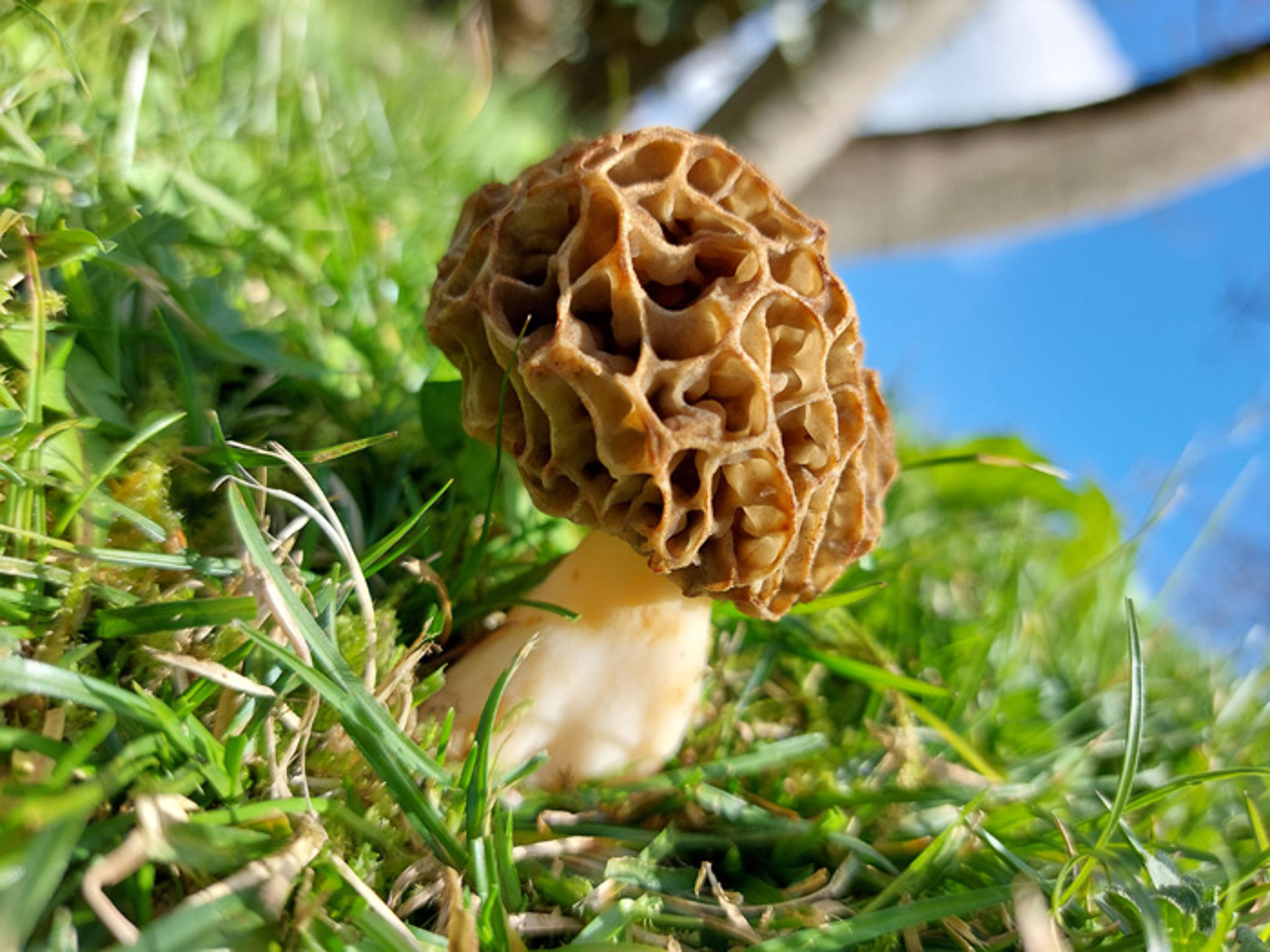
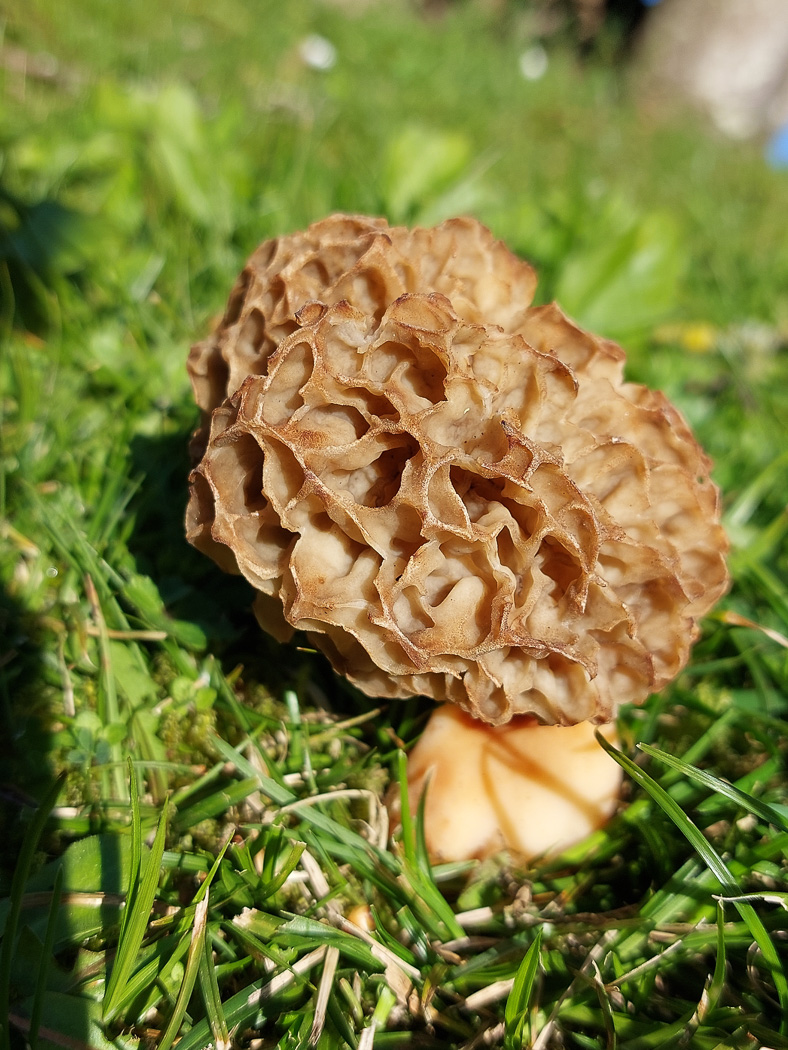 |
April 7th Morcella esculenta (Morel)
In Gerrards Cross Jesper Launder came across this beauty growing under Acer. After some doubts as to which species to name it and returning a few days later to take a sample for possible sequencing (photo 2), he is now confident that this is M. esculenta and not one of the rarer species as he initially suspected. The members of this distinctive spring genus of Ascos are often surprisingly tricky to name to species and microscopic details do not help that much. Though this is by no means a rare species we seem to have only one previous county record this century which is rather a surprise. So this is another new entry for Finds
|
April 5th 2023
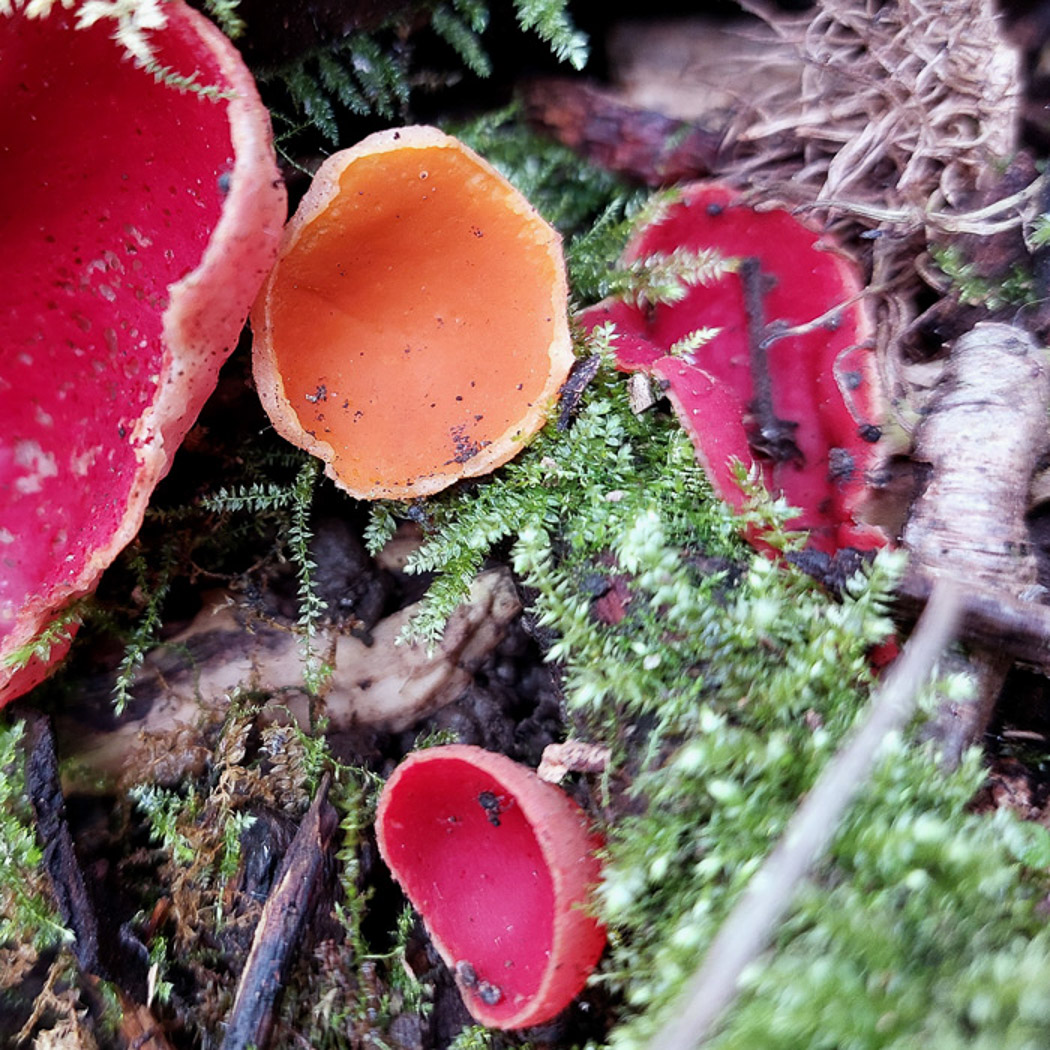 |
April 5th Sarcoscypha austriaca var. lutea (a very rare variety of Scarlet Elfcup)
In Seer Green Jesper Launder noticed that amongst the bright red cups of this collection was one which was a notably different colour. This had to be the elusive variety lutea though its colour is more peachy orange than yellow. It was first discovered in the UK in Wales, (2005 - see the Field Mycology article in vol 8(1) describing this) and there are only a handful of records in FRDBI, all from Wales bar one from Yorkshire though interestingly one of these was from January this year. More images can be seen online, but this was an exciting find.
|
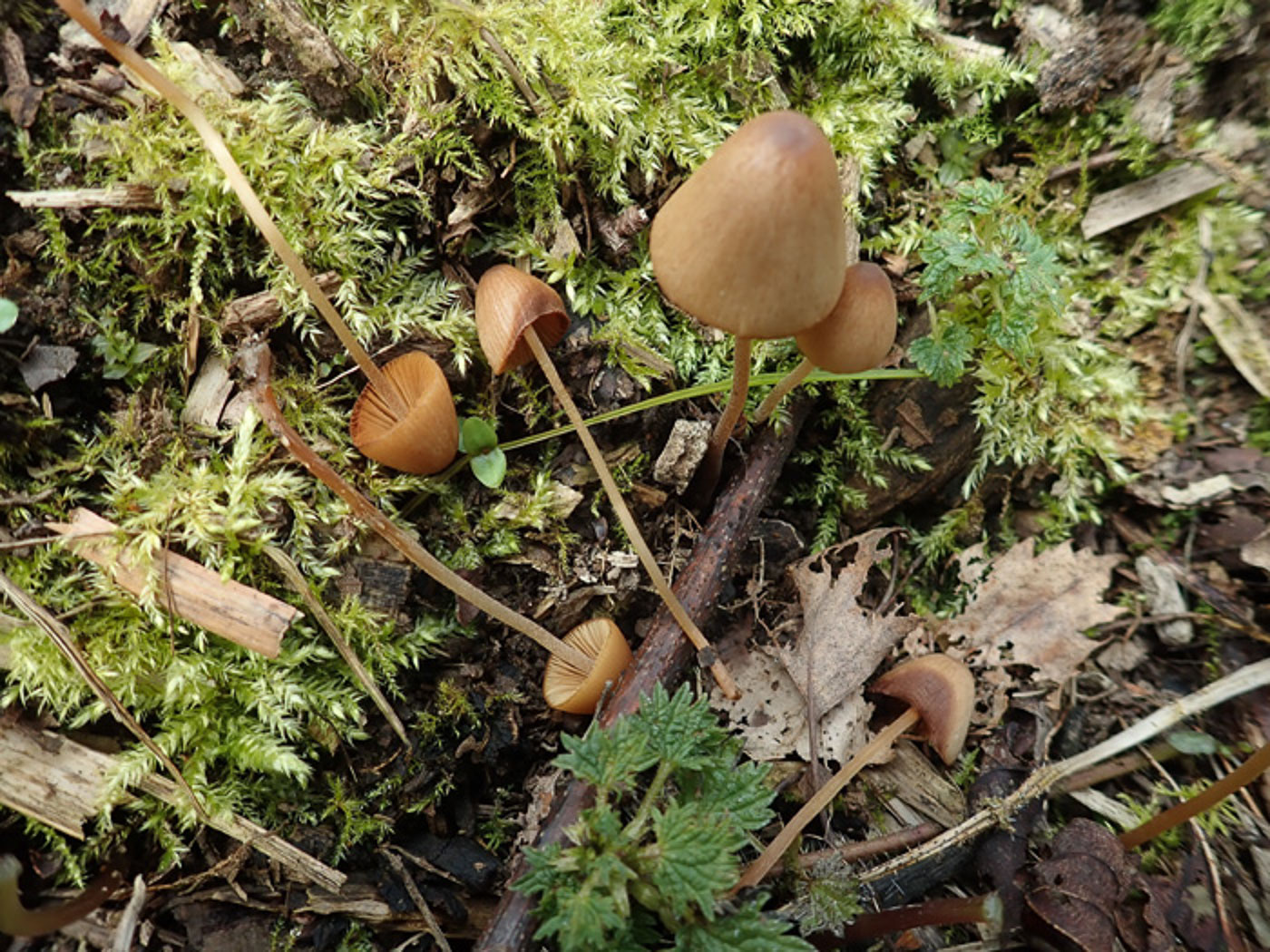
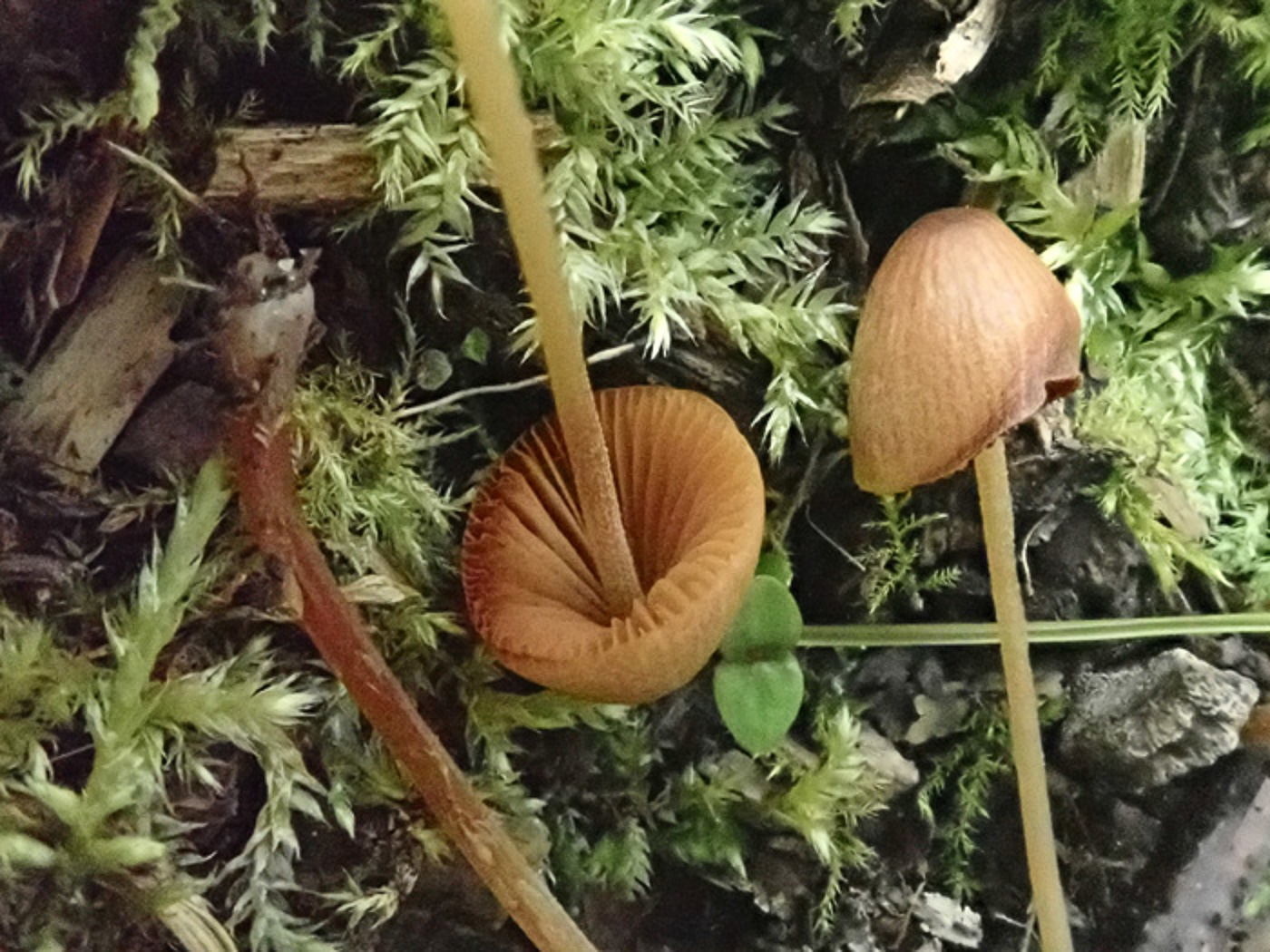 |
April 5th Conocybe cf. fuscimarginata (a rare species of Conecap with no common name) 
In woody debris, possibly old burnt ground, at Turville Heath Penny found this nice cluster of a rather pale LBJ and took them home to work on. The details found under the scope revealed this was a Conocybe as suspected and keying it out led to C. fuscimarginata though, as with the species below, it was not an exact fit and will be dried for sequencing. (Conocybe and Galerina are two genera often difficult to identify to species with any certainty.) We have just one previous county record of this species from 2007.
|
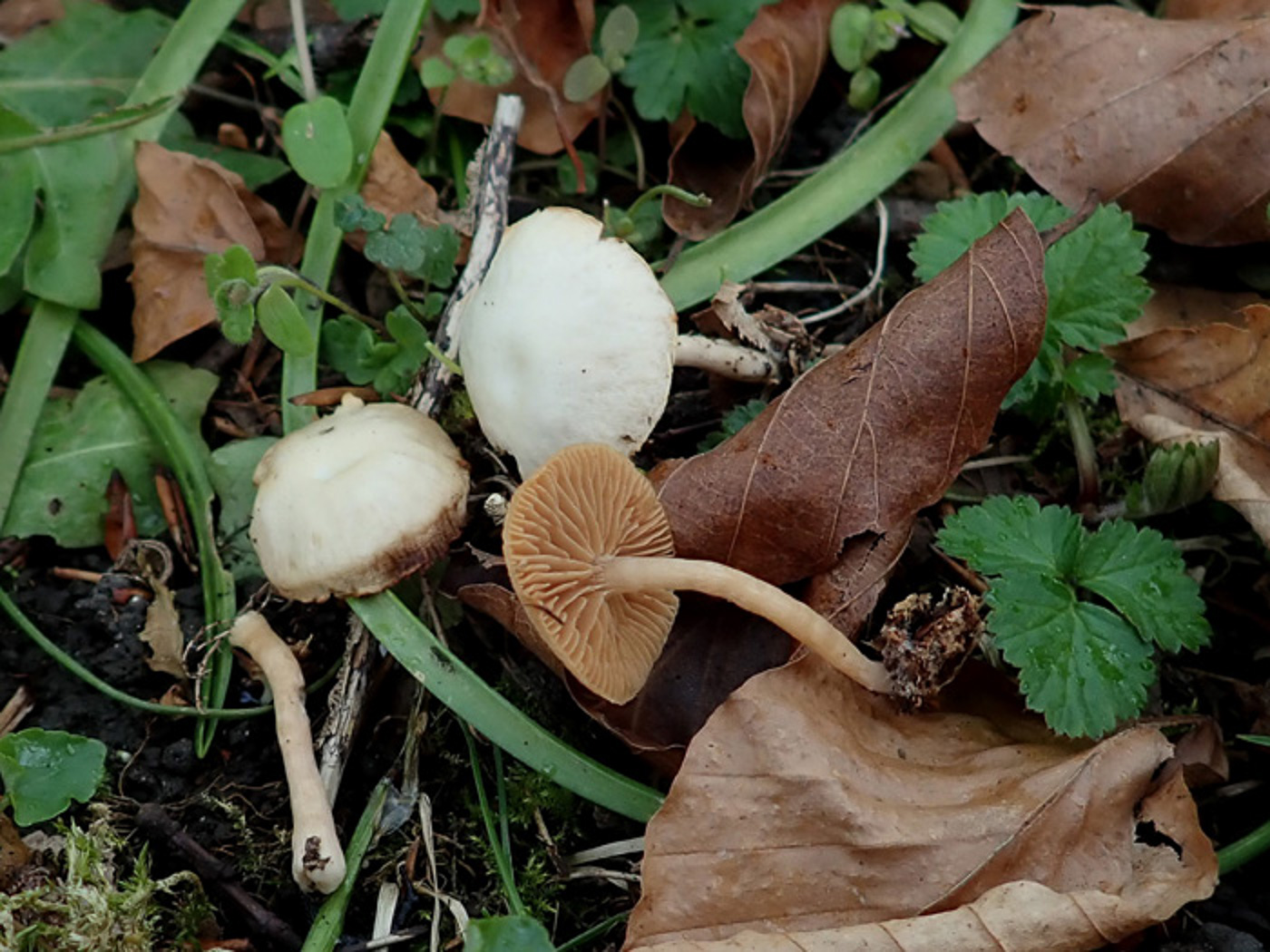 |
April 5th Galerina cf pallida (a rare species of Bell with no common name) 
In Beech litter at Turville Heath Penny found these three very pale capped LBJs and took them home to work on. The details found under the scope revealed this was not a Conocybe as suspected but a Galerina with very pale rather small spores for the genus and a significantly hygrophanous cap. Keying out lead her to G. pallida - one with very few UK records, none from Bucks - but was not an exact fit, hence the doubt and the 'cf' here indicating close to but with some doubts. The collection will be dried for sequencing.
|
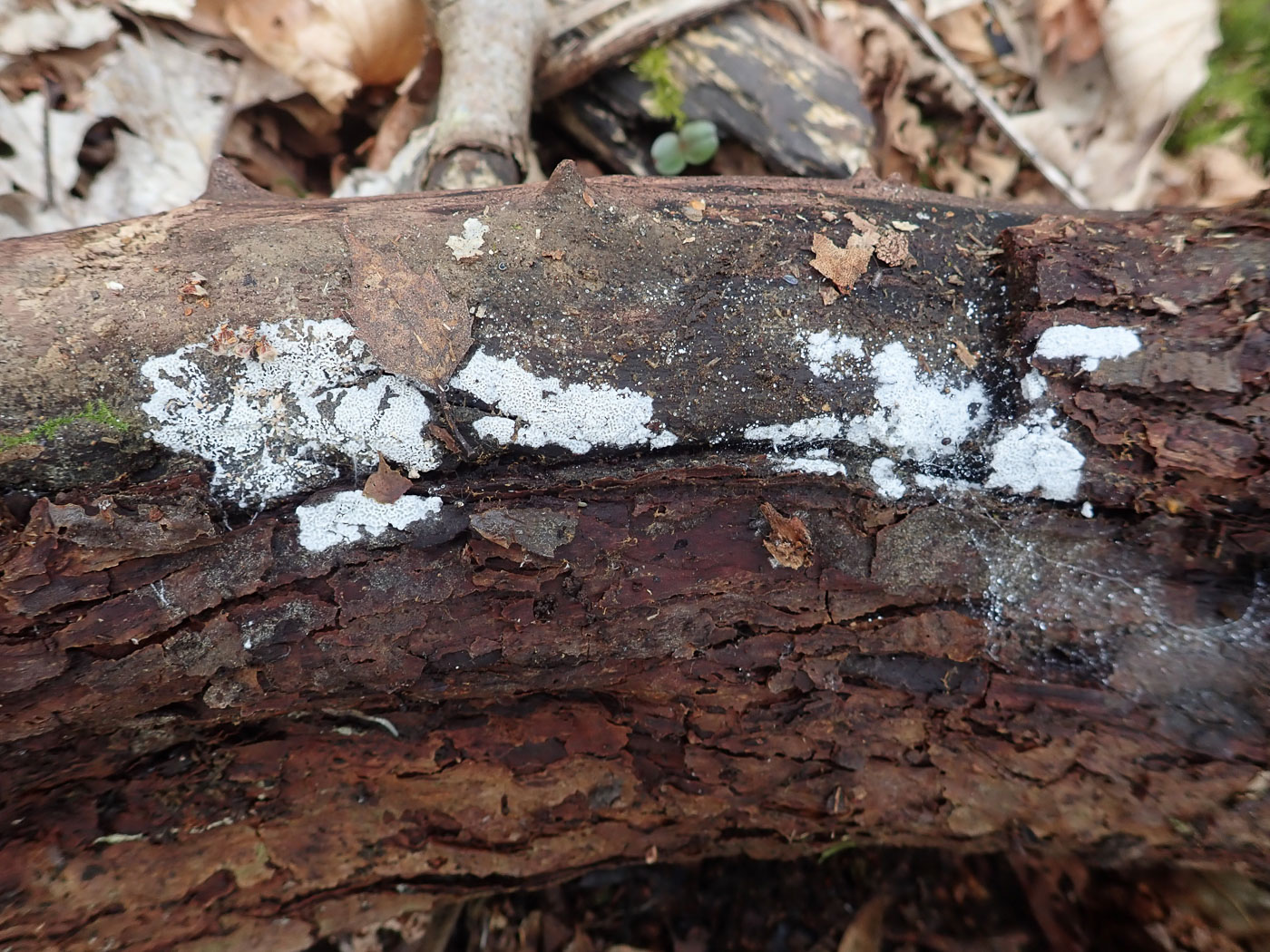
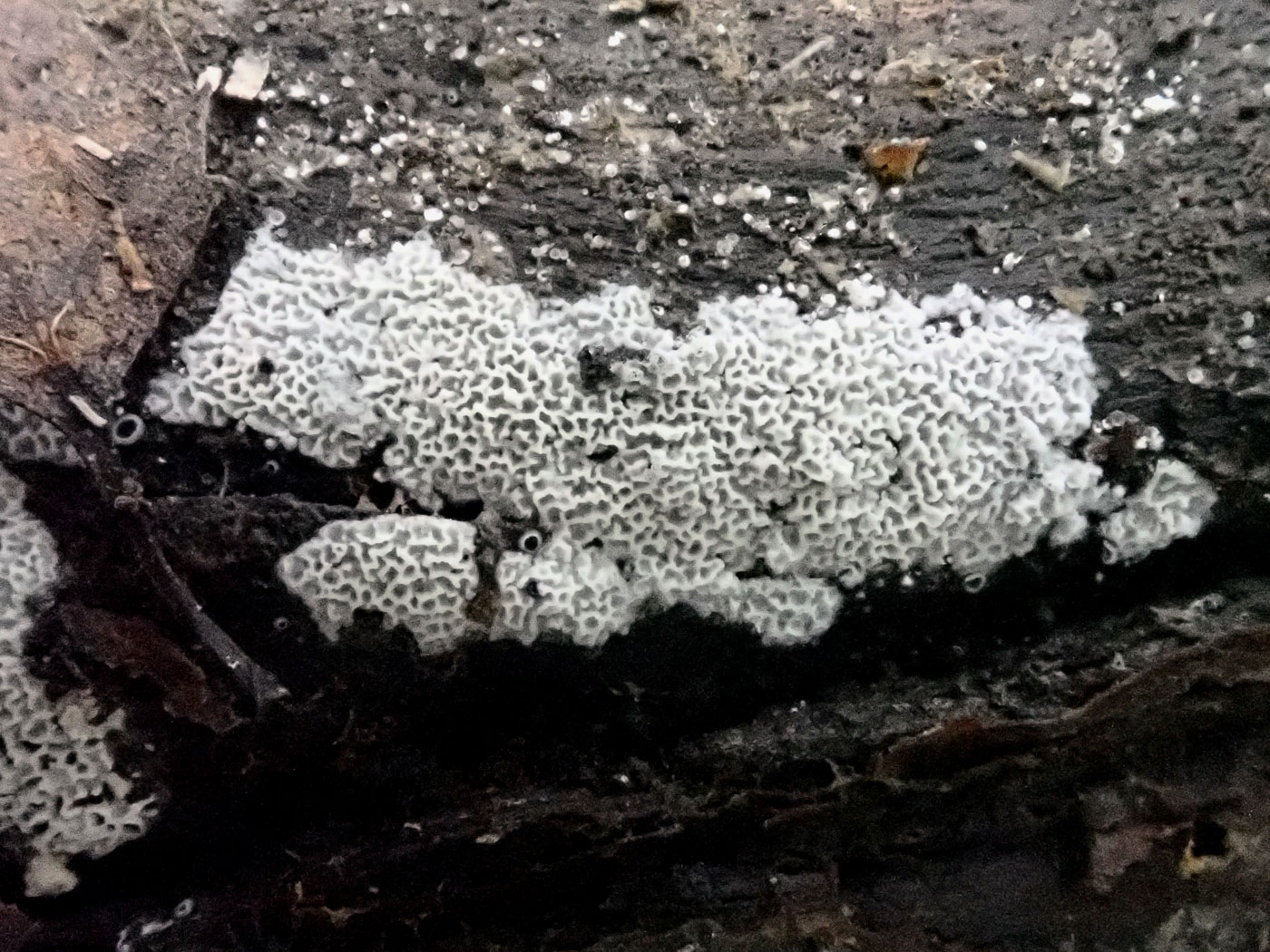
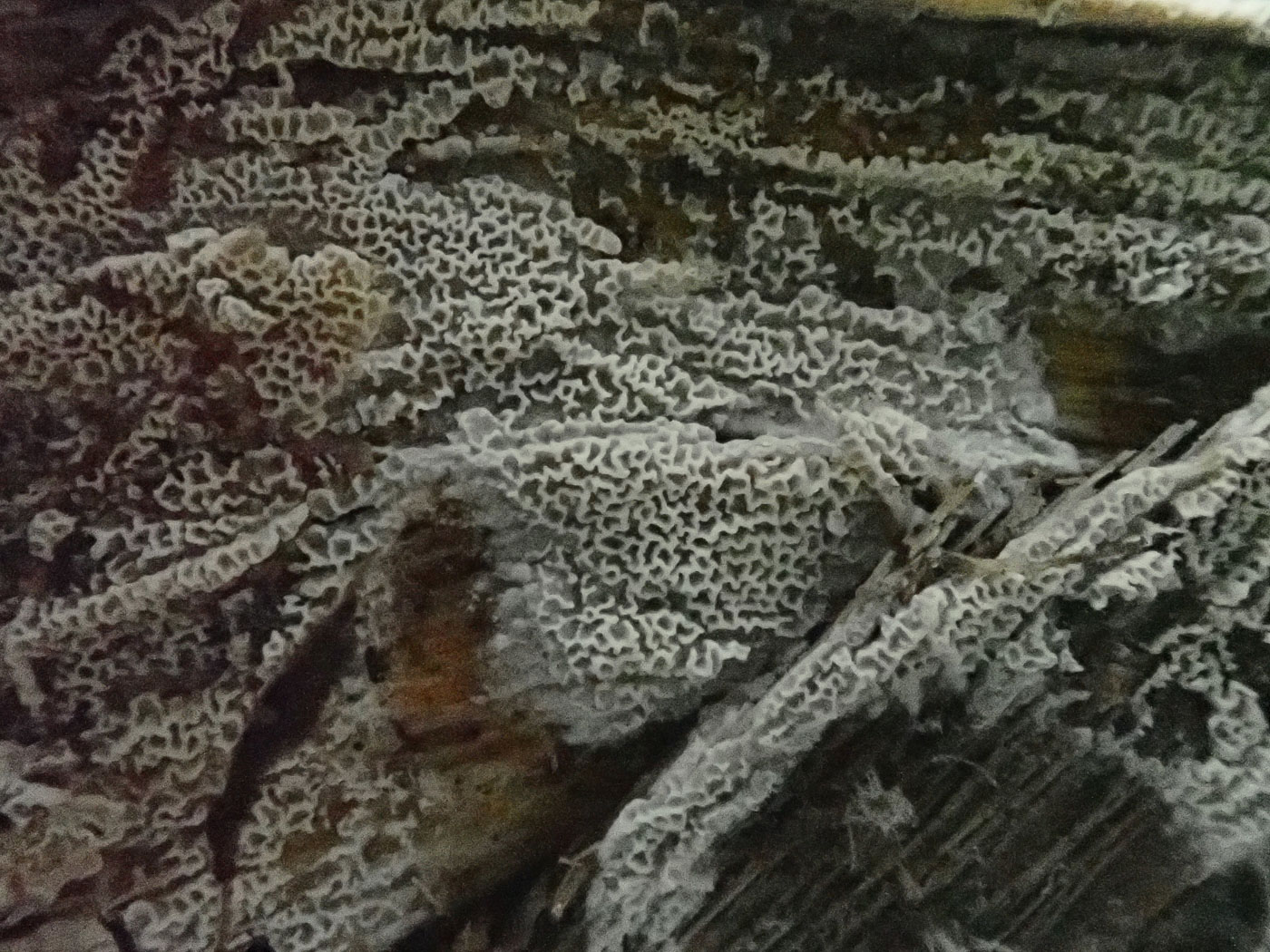 |
April 5th Ceriporia reticulata (a Corticioid with no common name)
On the underside of several pieces of fallen deciduous wood Penny found this quite common species. At first glance it looks like many other white corticioids (photo 1) but with a handlens it is quite distinctively marked with a labyrinthine poroid surface making it fairly safely recognisable in the field (photos 2 and 3). It tends to occur fresh in late Spring - early Summer. See also in Finds 2021 June 30th.
|
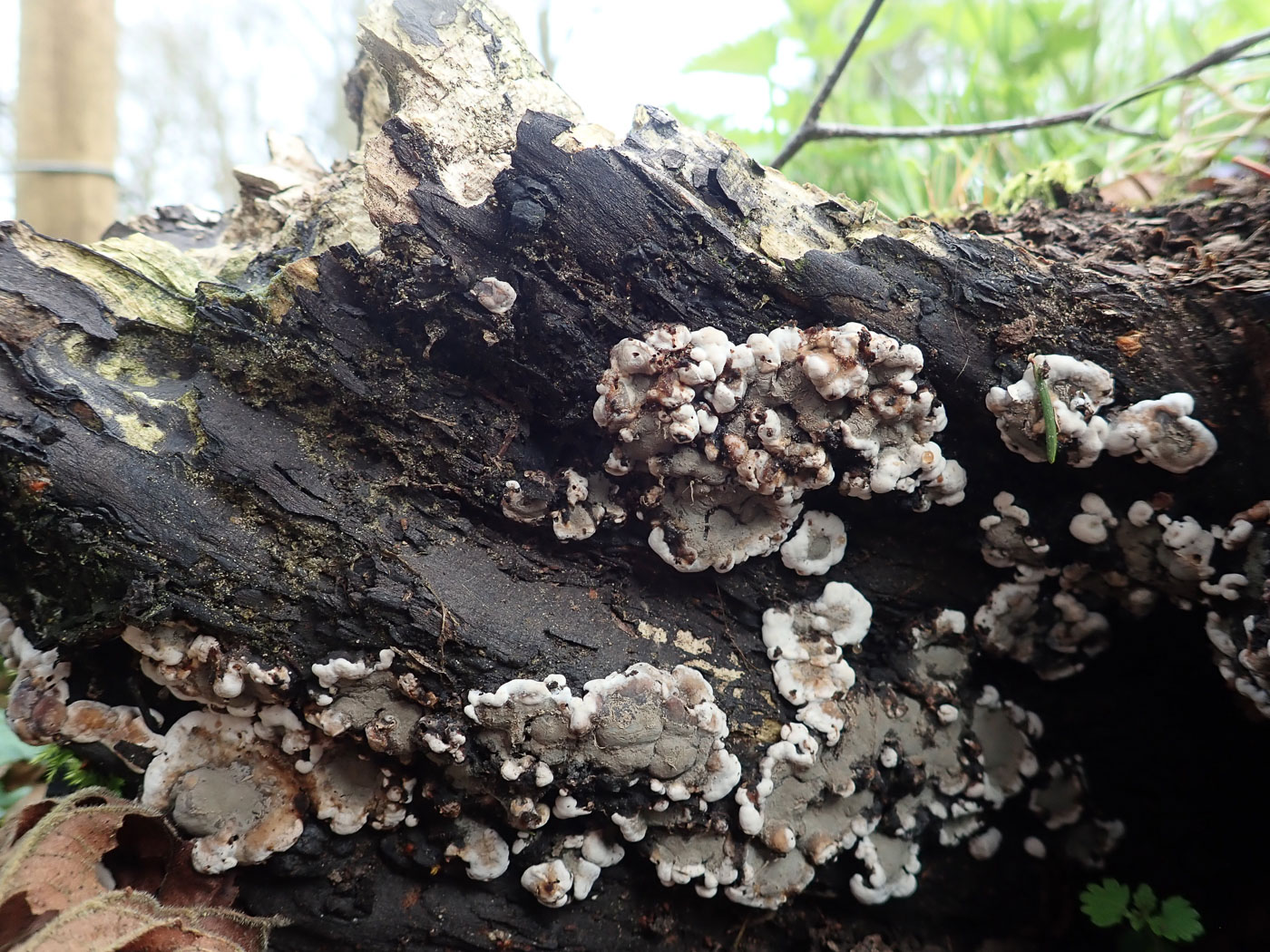 |
April 5th Kretzschmaria deusta (Brittle Cinder)
At Turville Heath on the base of a rotting deciduous stump Penny noticed this Pyrenomycete species, one that when fresh as here produces grey bumpy rather erratic areas with a white fringe, sometimes covering quite a wide area. It later looses these colours and become somewhat crumbly and black when much harder to recognise. This is a common species. See also in Finds 2021 June 21st and 2022 June 13th.
|
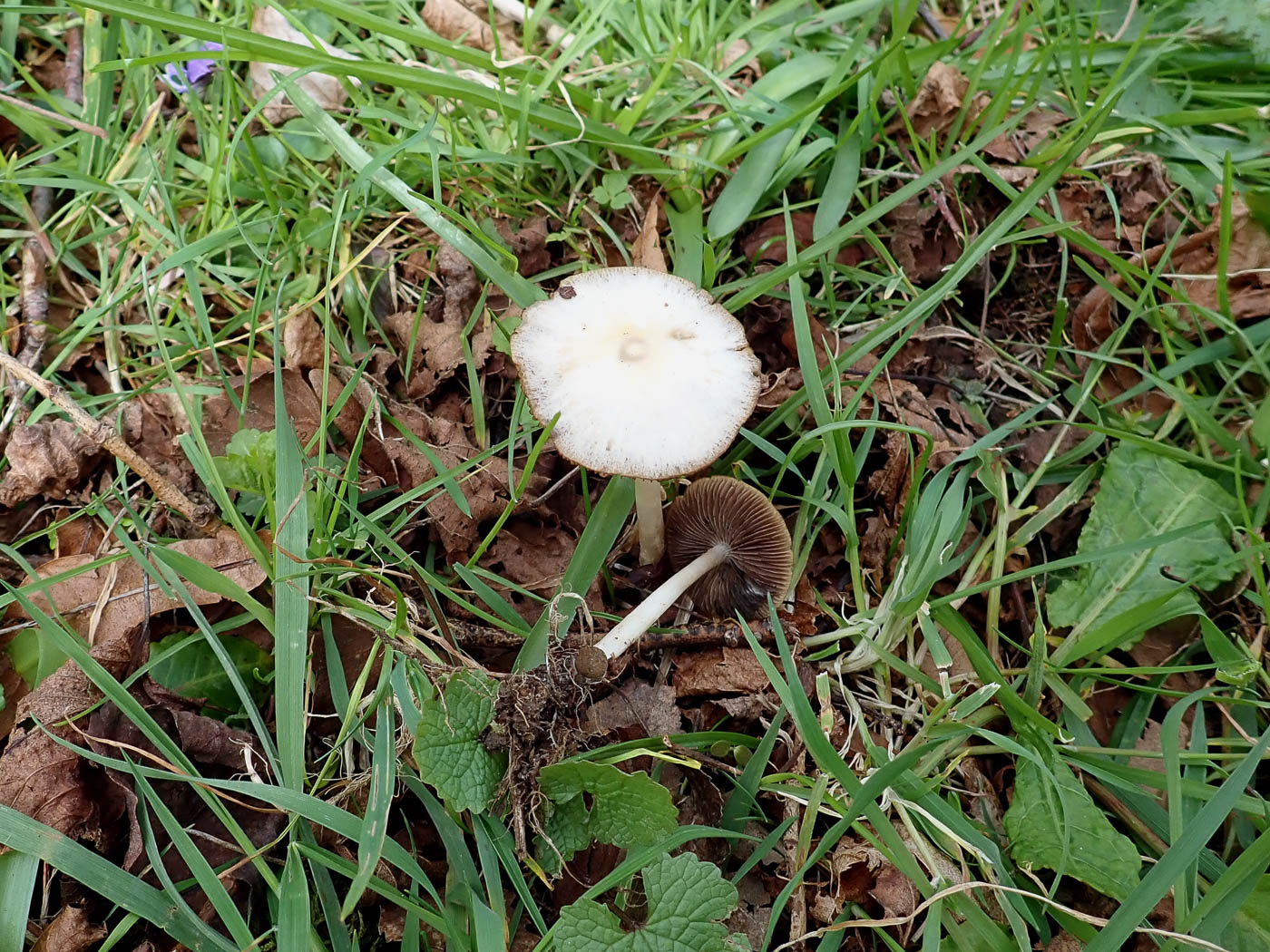
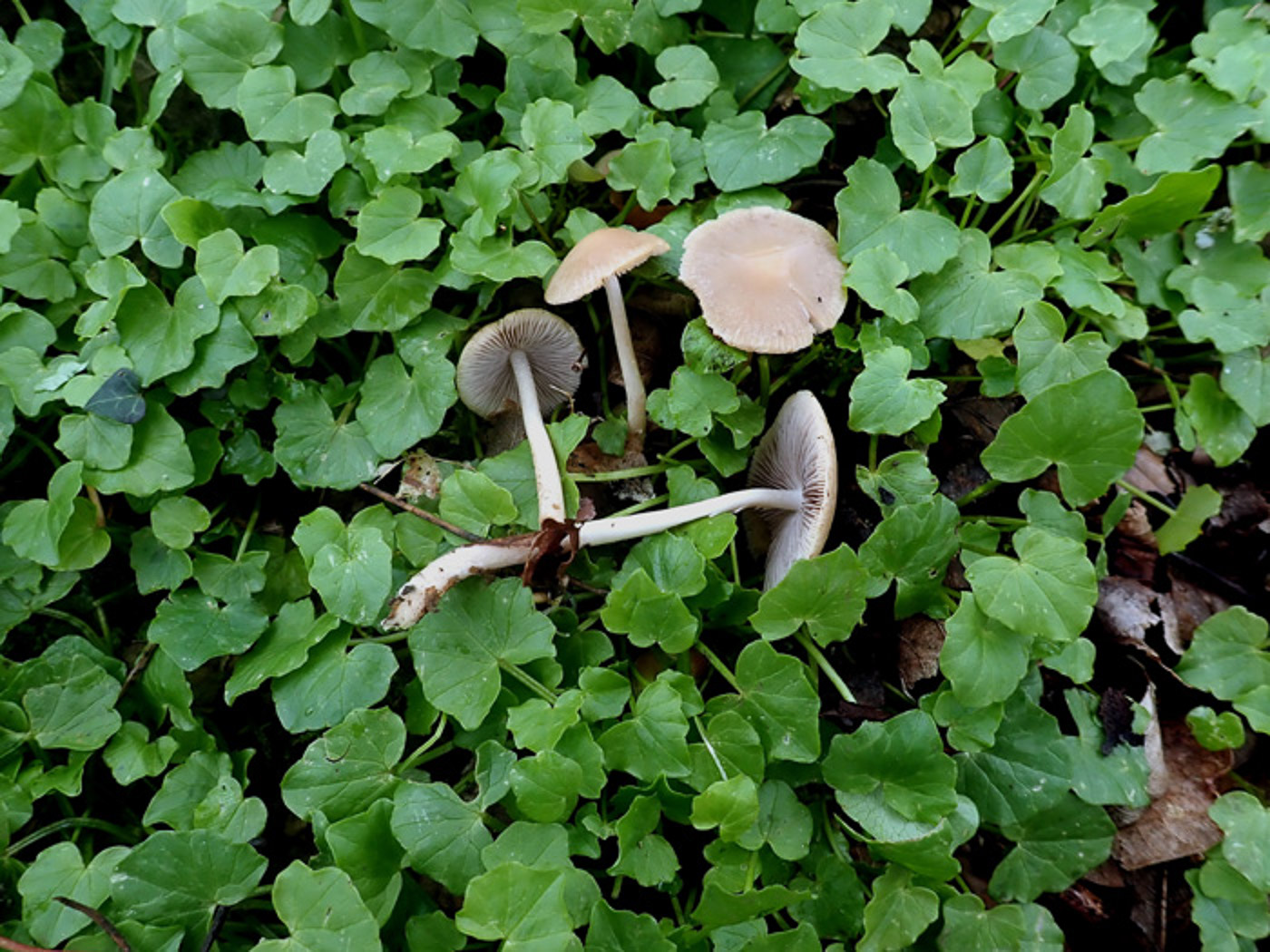 |
April 5th Psathyrella spadiceogrisea (Spring Brittlestem)
At Turville Heath in woody deciduous litter Penny found this pair - a common woodland springtime species and one we also found at Rushbeds Wood a couple of days earlier. The species starts out with a rich brown cap but is highly hygrophanous (rather like Laccaria laccata) and here had completely lost all colour. All members of this genus need checking with a scope. At Rushbeds we made three collections, two were this species but one defied identity and will be sequenced. See also in Finds 2021 May 12th and 2022 September 7th. Photo 2 is from the same site but taken ten days later and showing less faded caps. See the Masterlist for more examples.
|
April 4th 2023
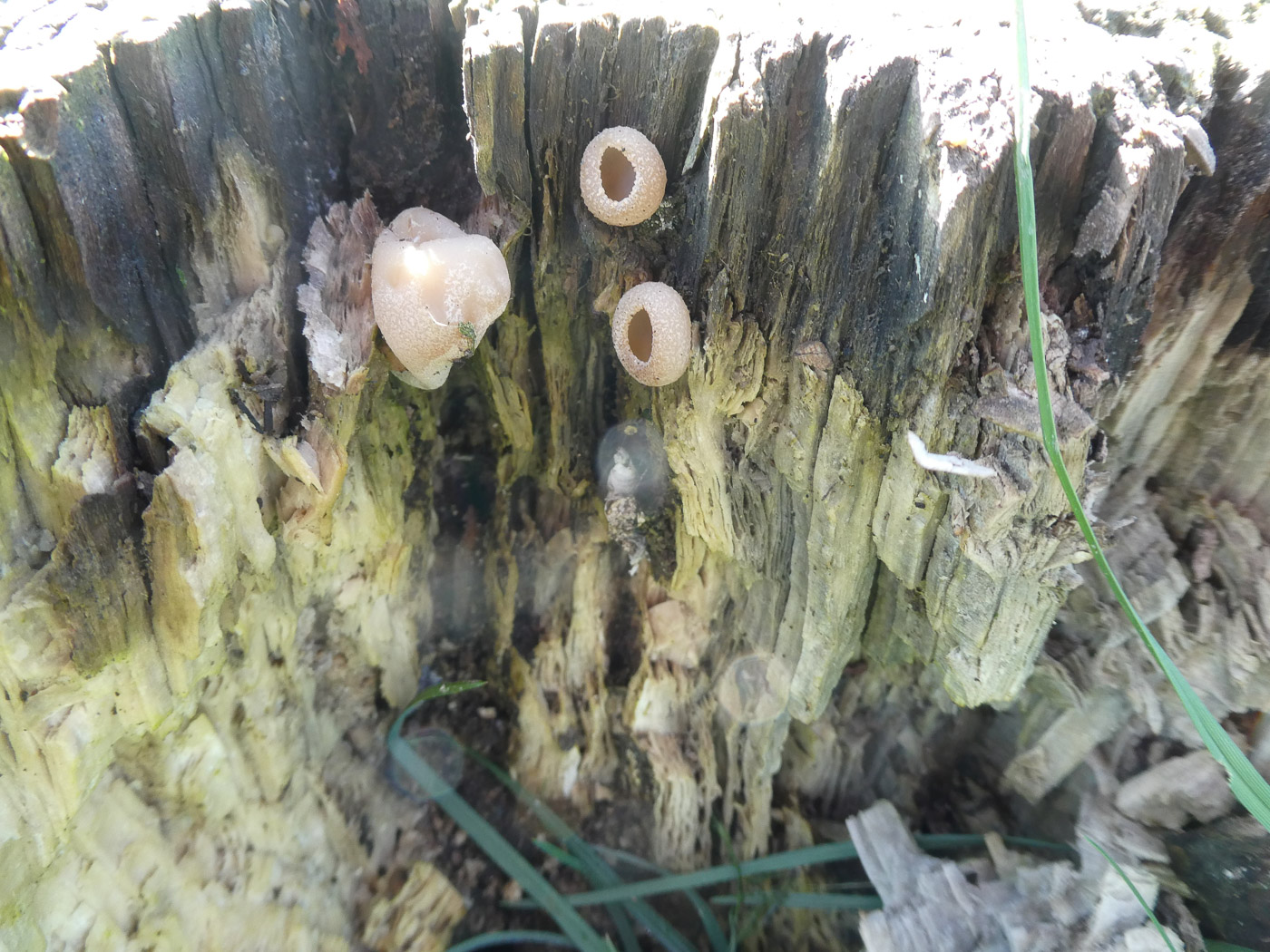
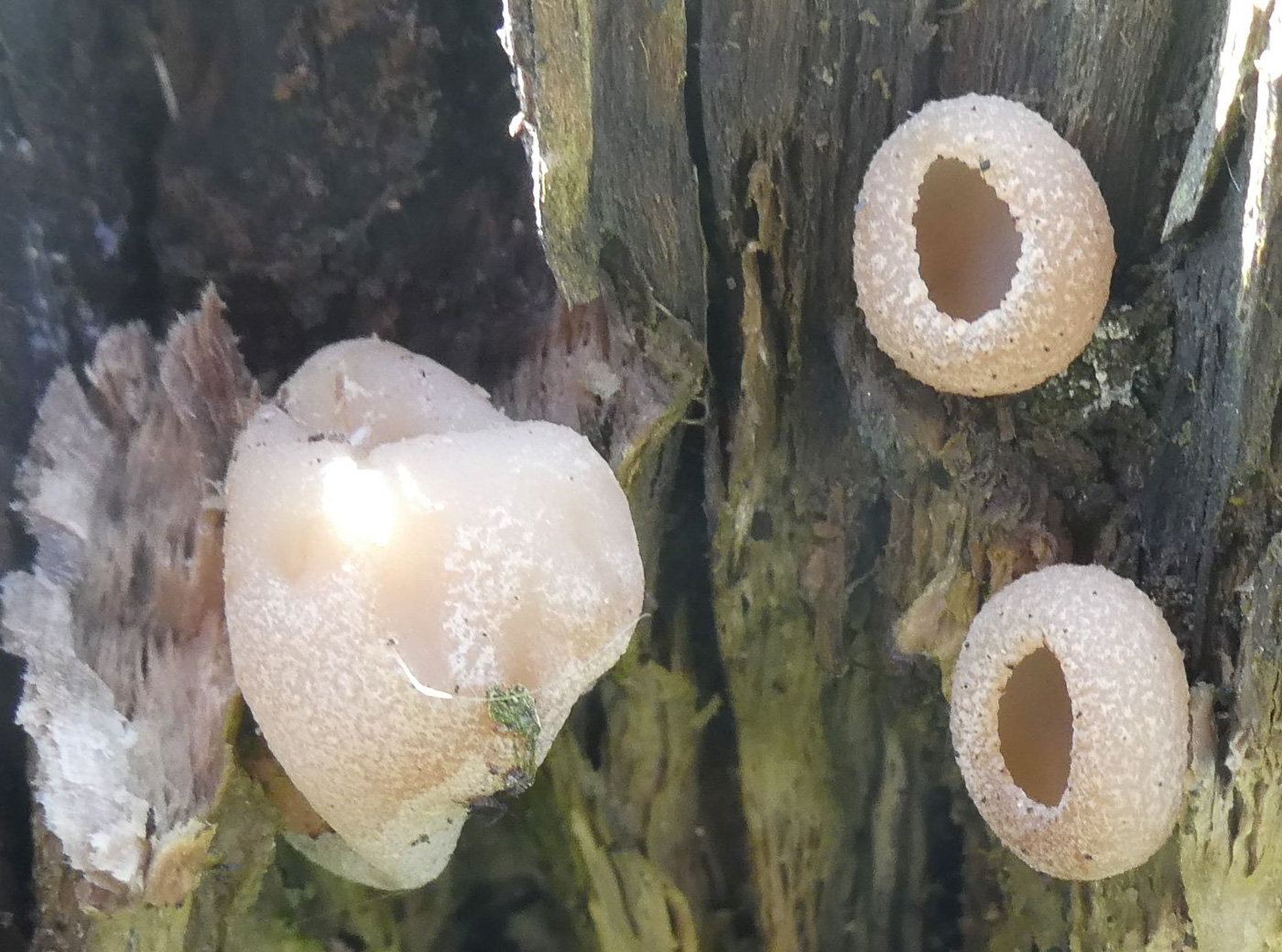
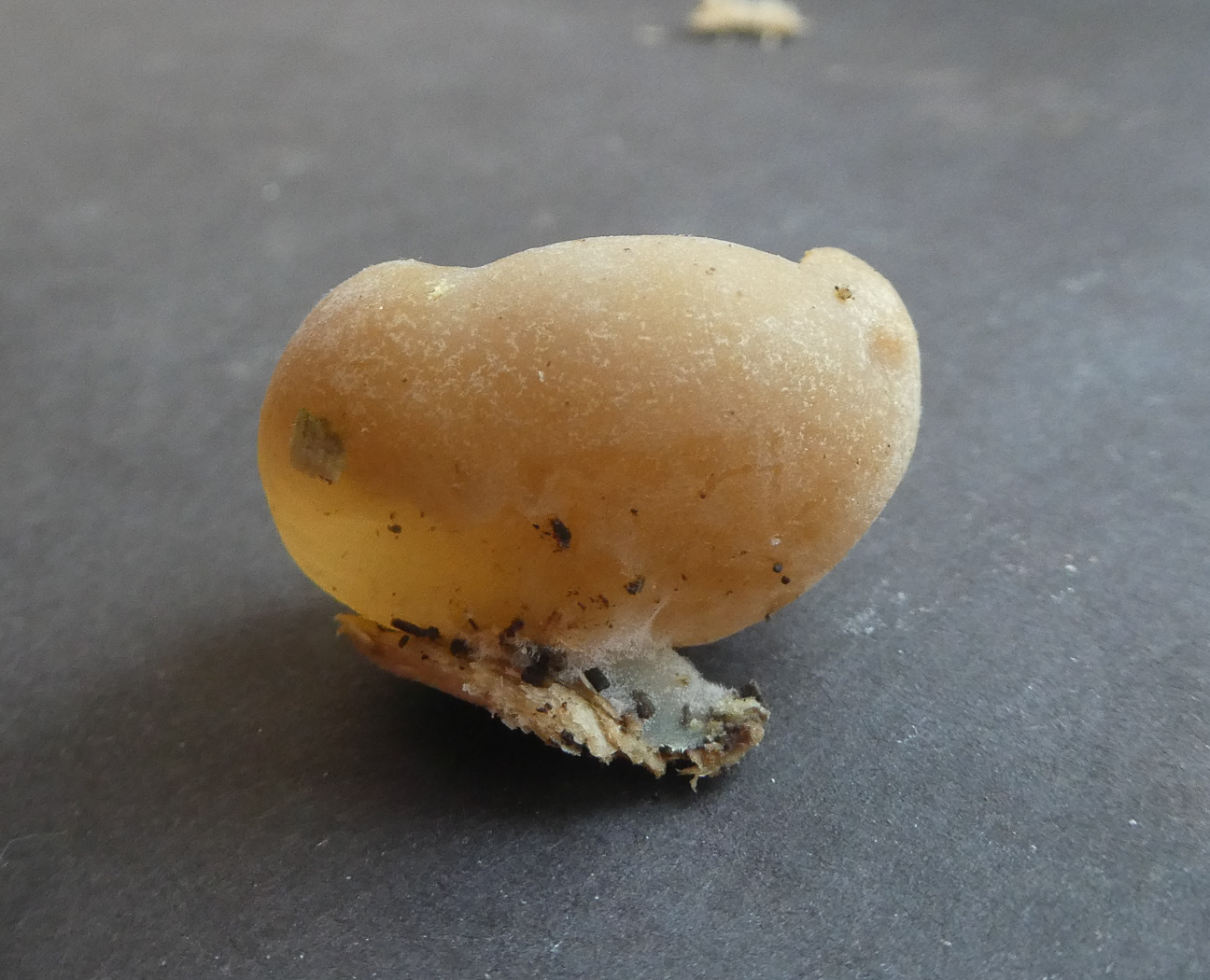 |
April 4th Peziza micropus (Pedicel Cup Fungus) 
On a rotten soggy deciduous stump in Goldhill Common Jim Wills spotted these two cup fungi and took them home to work on - a new venture for him. Consulting with Penny by email as to how to go about identifying such species (a bit like the blind leading the even blinder!) he achieved photos of all salient features and we were able to establish this was definitely a Peziza and one having relatively small smooth spores and a minimal stem underneath (photo 3). The substrate - rotting deciduous wood - is typical of this quite common species and we have one previous Finds entry: 2020 November 11th. (The common name given here is mentioned several times online but is not on the official list as yet.)
|
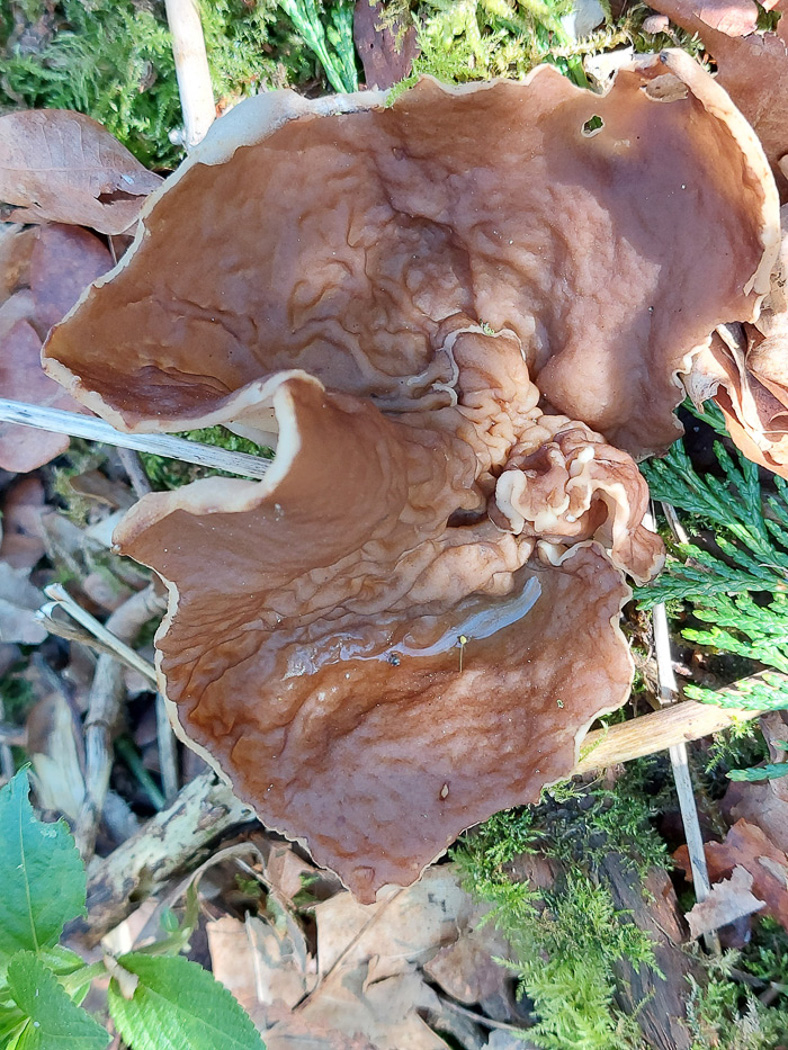 |
April 4th Disciotis venosa (Bleach Cup)
In Seer Green Jesper Launder spotted this springtime cup - one that appears very similar to a large Peziza but has a distinctive wrinkled inner surface, a short thick stem, very fragile flesh and a marked bleachy smell. It occurs in soil often in lawns at this time. See also in Finds 2022 March 17th.
|
April 3rd 2023
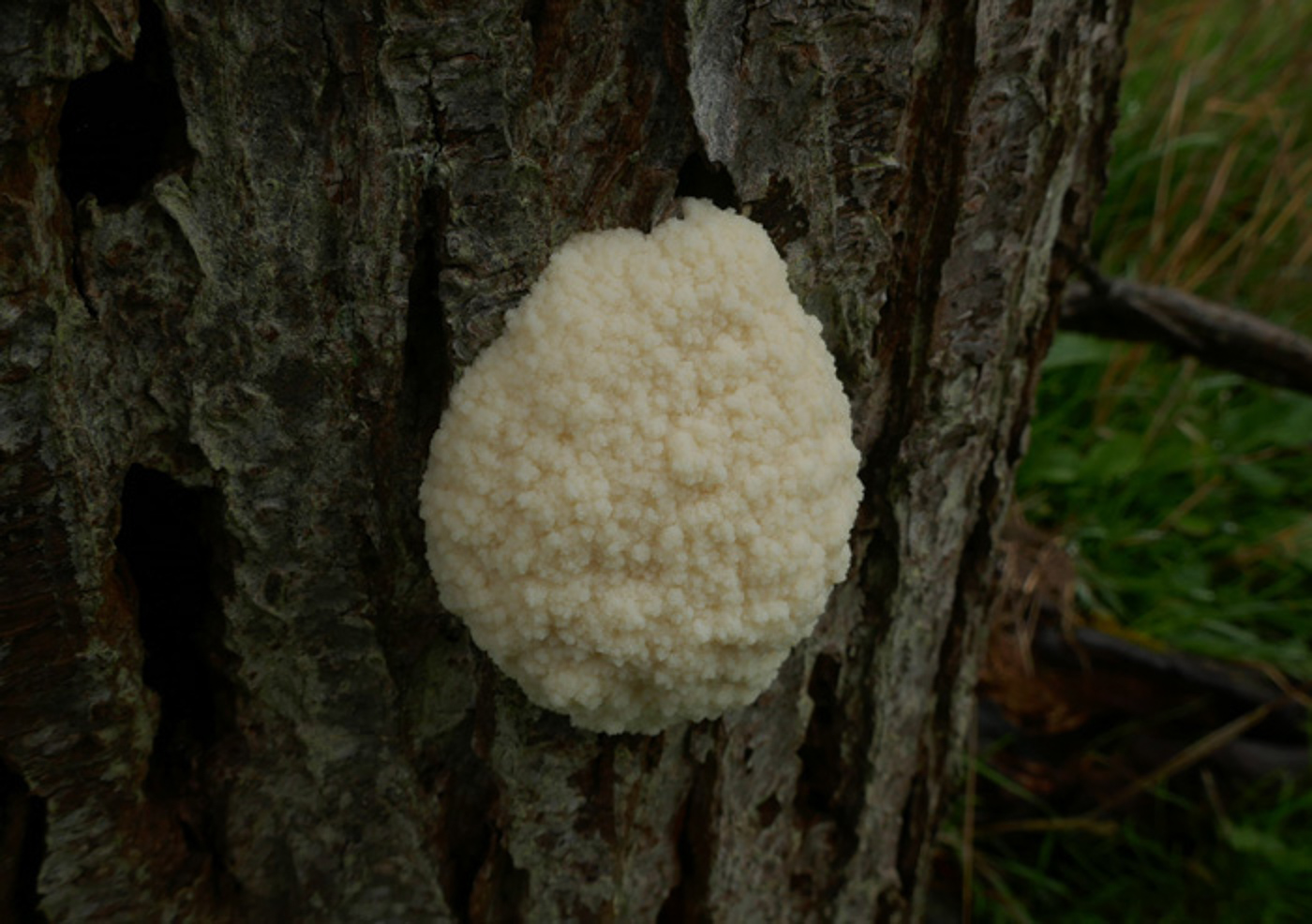
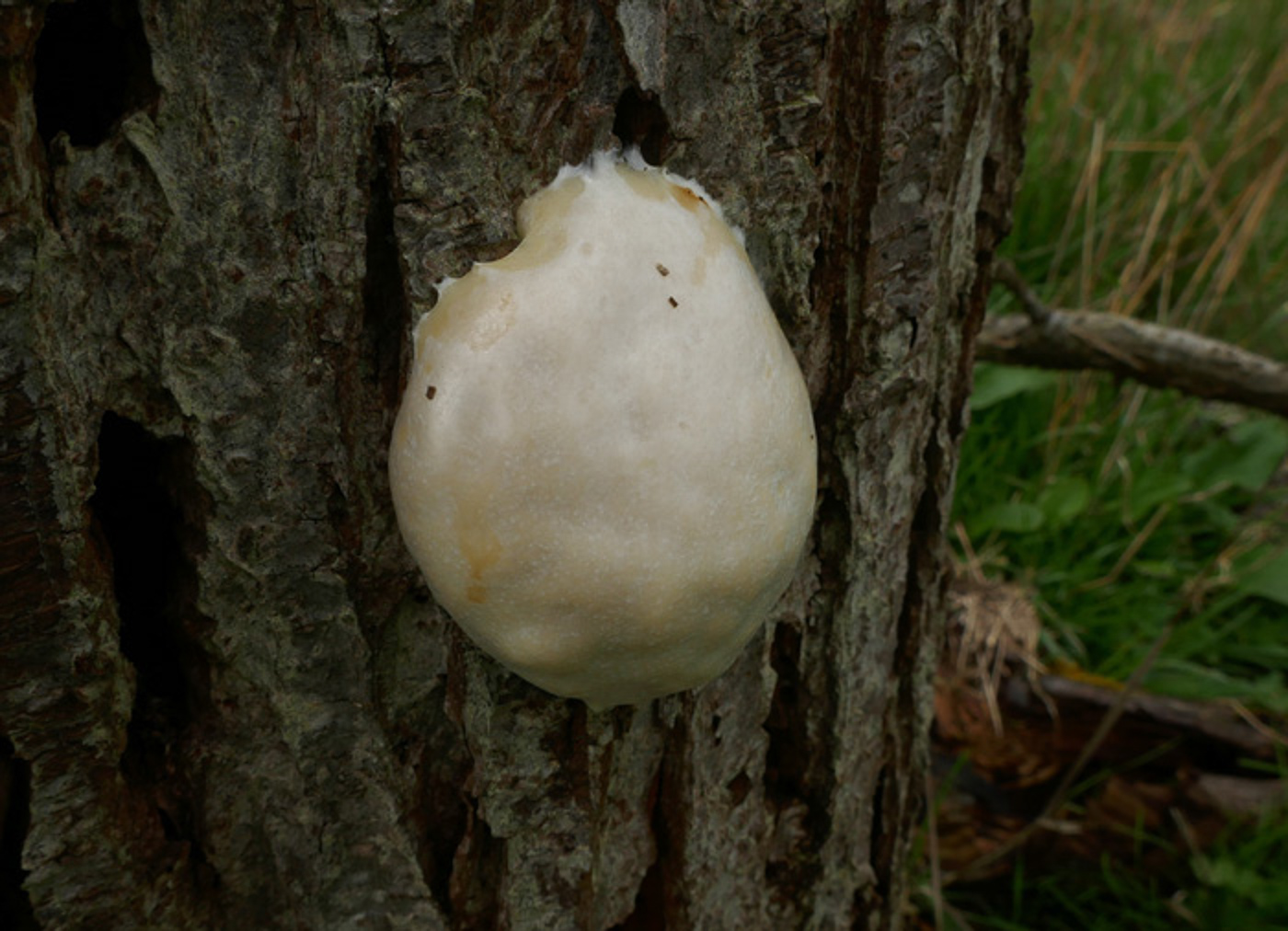
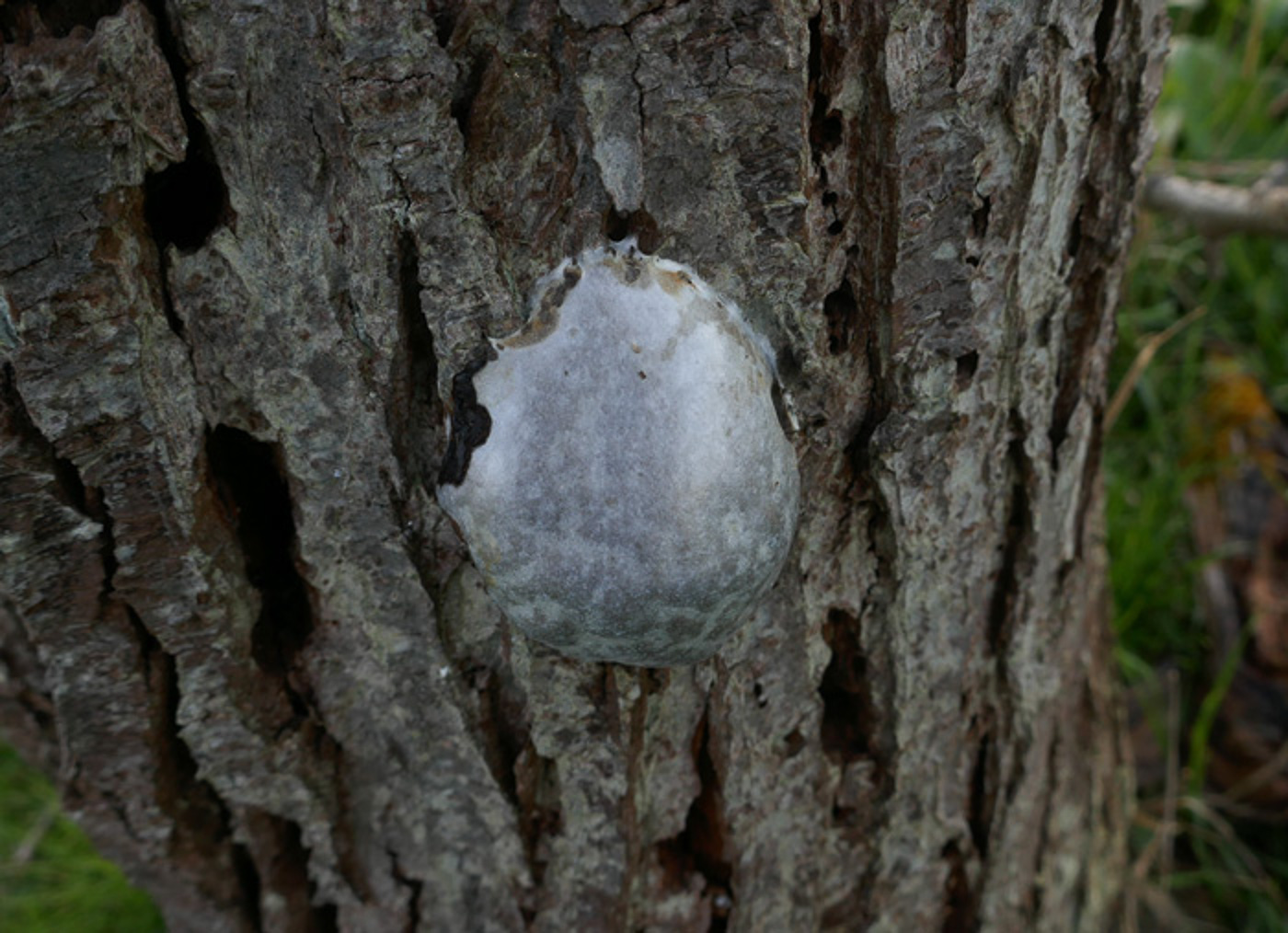 |
April 3rd Reticularia lycoperdon (Moon Poo)
At Stampwell Farm Jackie Ewan spotted this large Slime Mould on the trunk of an old Plum tree, taking a series of photos over the space of three days to show its development. Photo 1 is of an early still very soft and slimy plasmodium stage, followed by photo 2 at the 'eyeball' stage having dried off when its similarity to a puffball gives rise to is species name, and finally photo 3 as the outer skin starts to disrupt revealing the cocoa brown spore mass beneath. See also in Finds 2020 September 20th and 2021 April 2nd.
|
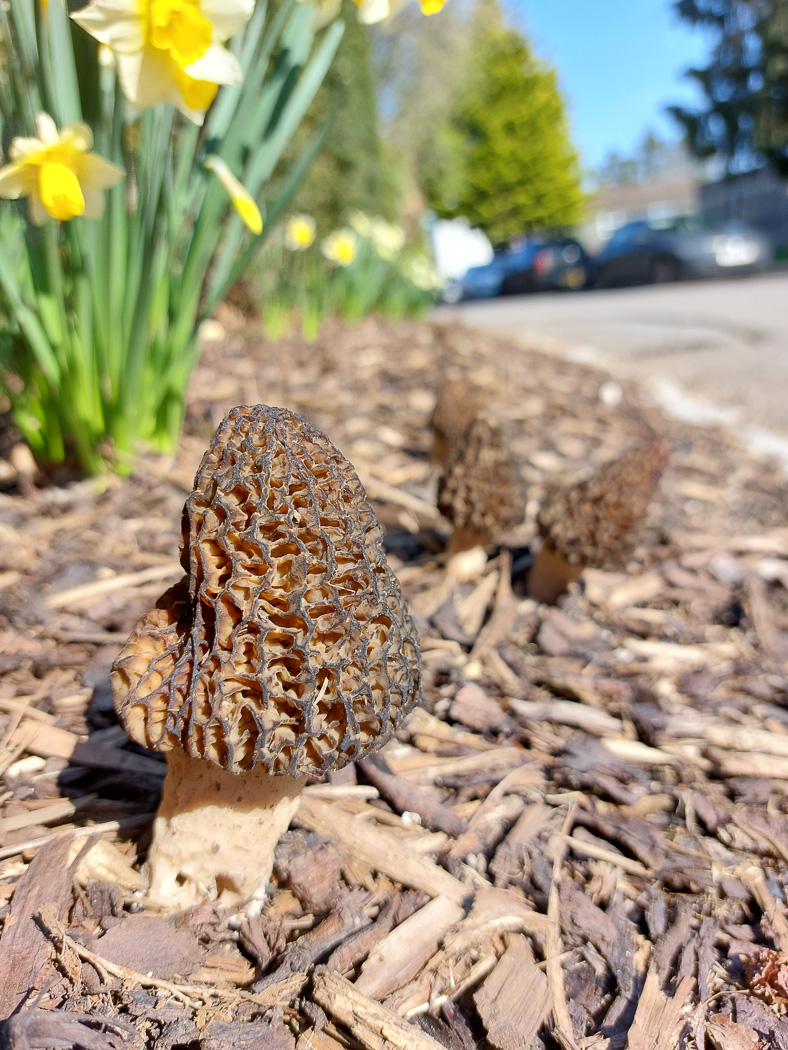 |
April 3rd Morchella elata (Black Morel)
In Seer Green Jesper Launder spotted these beautiful springtime specialities in woodchip - presumably Pine. This is a member of one of the most unpredictable genera, also one which is distinctive in appearance making it basically easy to recognise but determining to species is not at all easy. Microscopic characters vary very little but M. elata is one of the easier to name: it favours Pine woodchip, has a marked conical shape and the outer edges of the chambers tend to be black. (It appears, however, that this is a species complex and collections made on urban Pine woodchip may well be M. importuna - this is yet to be resolved.) See also in Finds 2021 April 1st.
|
April 1st 2023
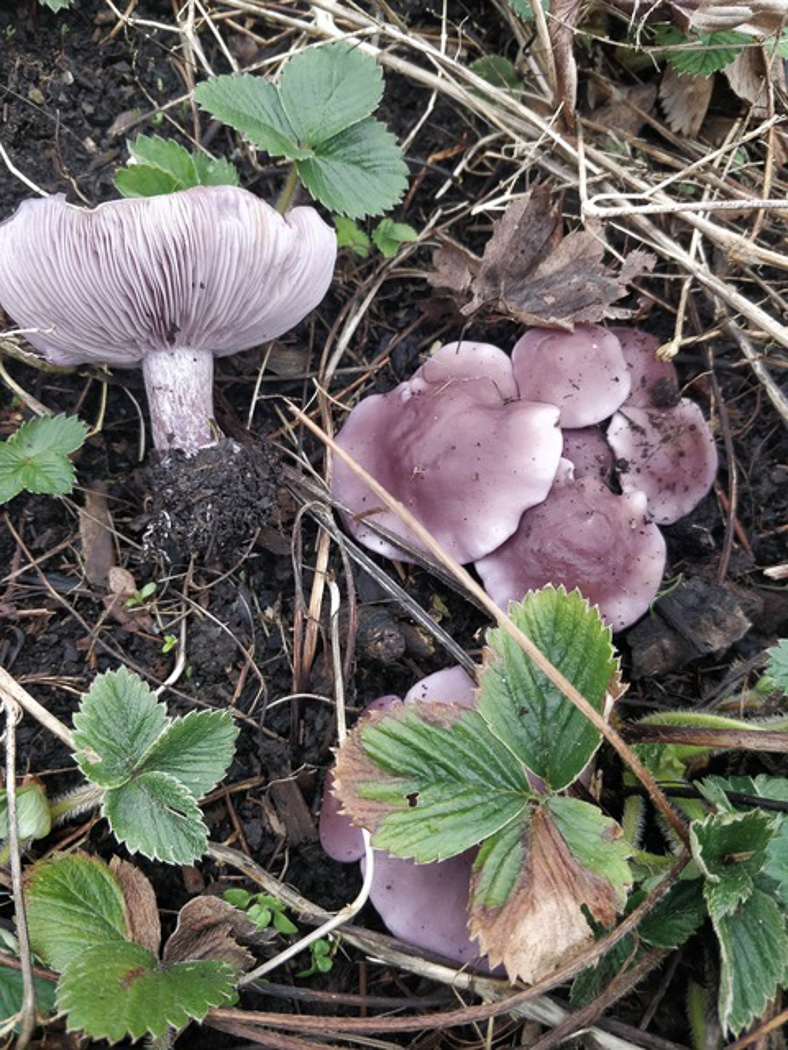
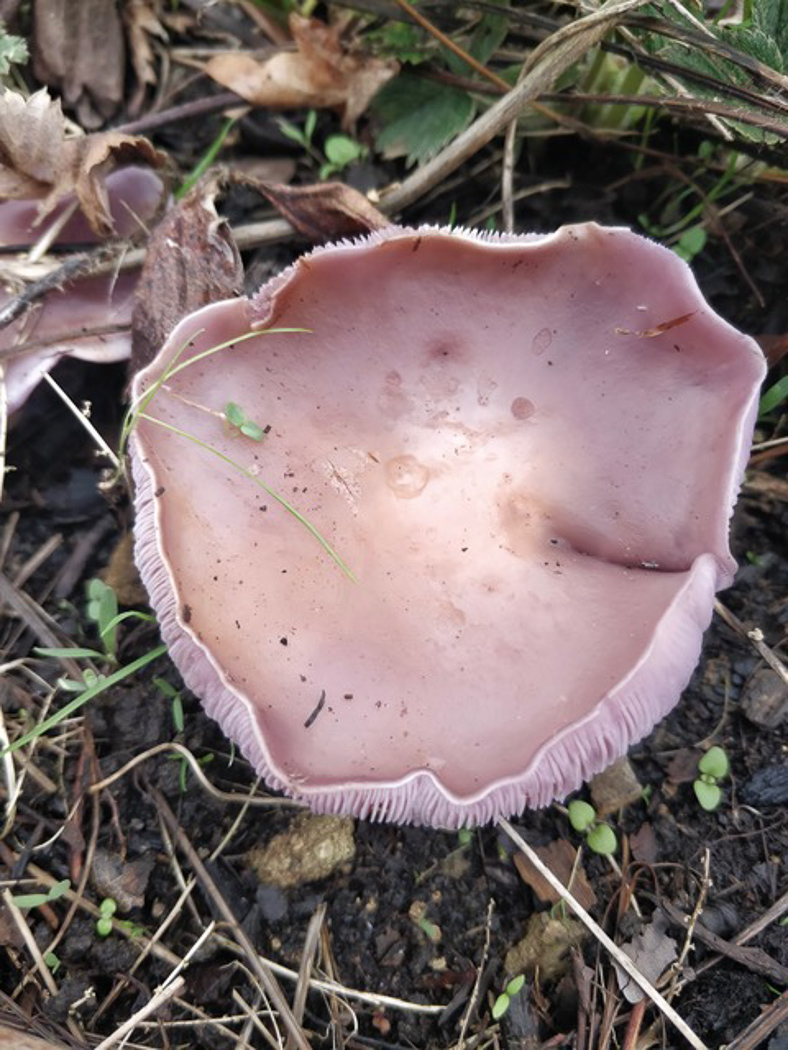 |
April 1st Lepista nuda (Wood Blewit)
Bob Simpson found these unseasonal mushrooms in his strawberrry bed at Salden Wood - we also found them at Rushbeds Wood the next day in rotting vegetation and which I commented in my report was unusual to find at this time. Of our 200 odd records for the species we now have just 3 for April, the rest found in Autumn except for the odd few in January. See the Masterlist for many other examples.
|
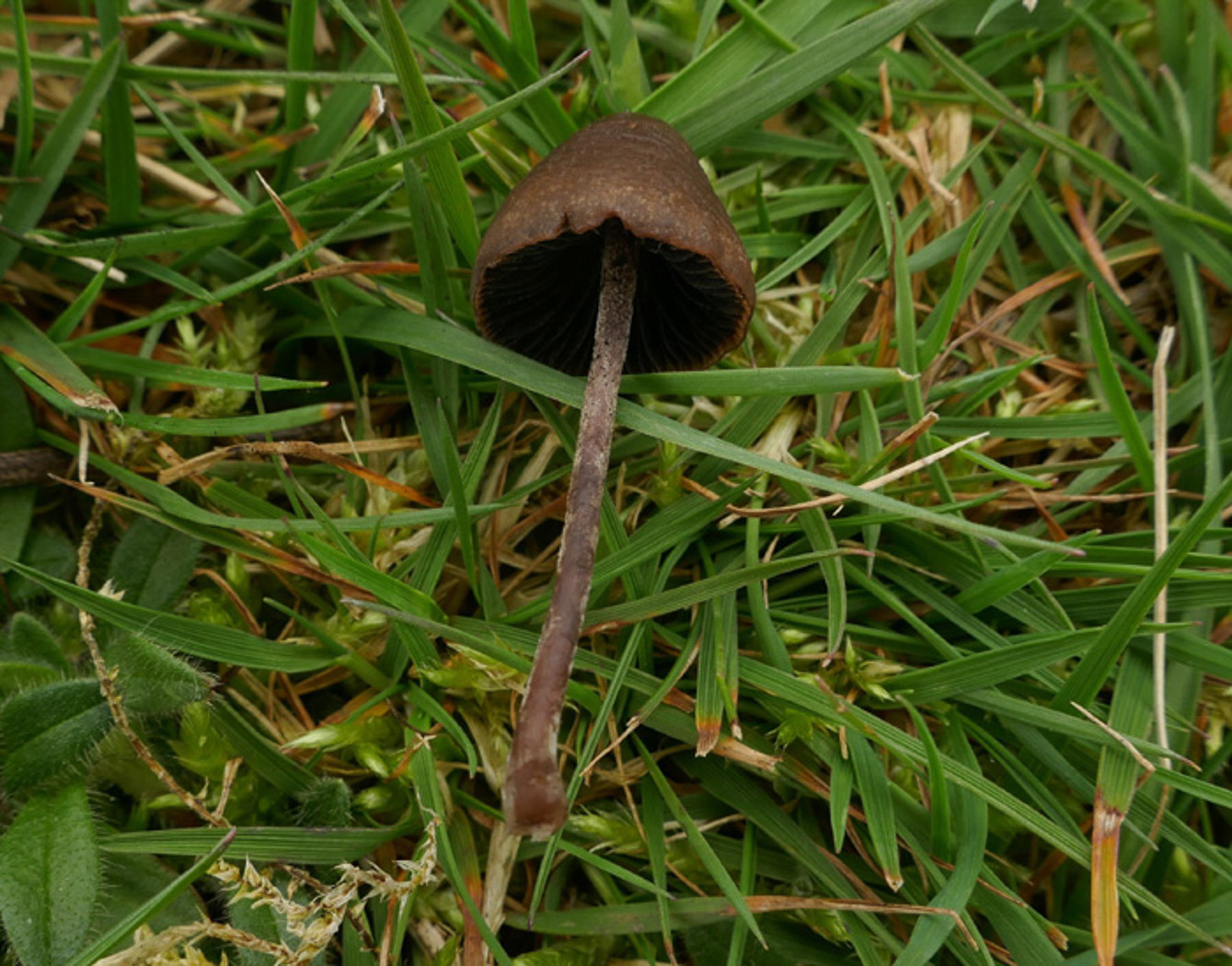 |
April 1st Panaeolus acuminatus (Dewdrop Mottlegill) 
At Stampwell Farm Jackie Ewan found this singleton in a sheep paddock. The dewdrop in its name refers to small moisture droplets which form on the upper stem - just visible here. With its habit of growing in soil in longish grass, having the typical dark mottled gills of the genus, also the droplets on the stem, this species together with P. papilionaceus (found on March 27th) are perhaps two of the easiest Panaeolus species to recognise in the field. Both a common too. We have two previous Finds entries: 2020 November 23rd and 2021 November 13th.
|
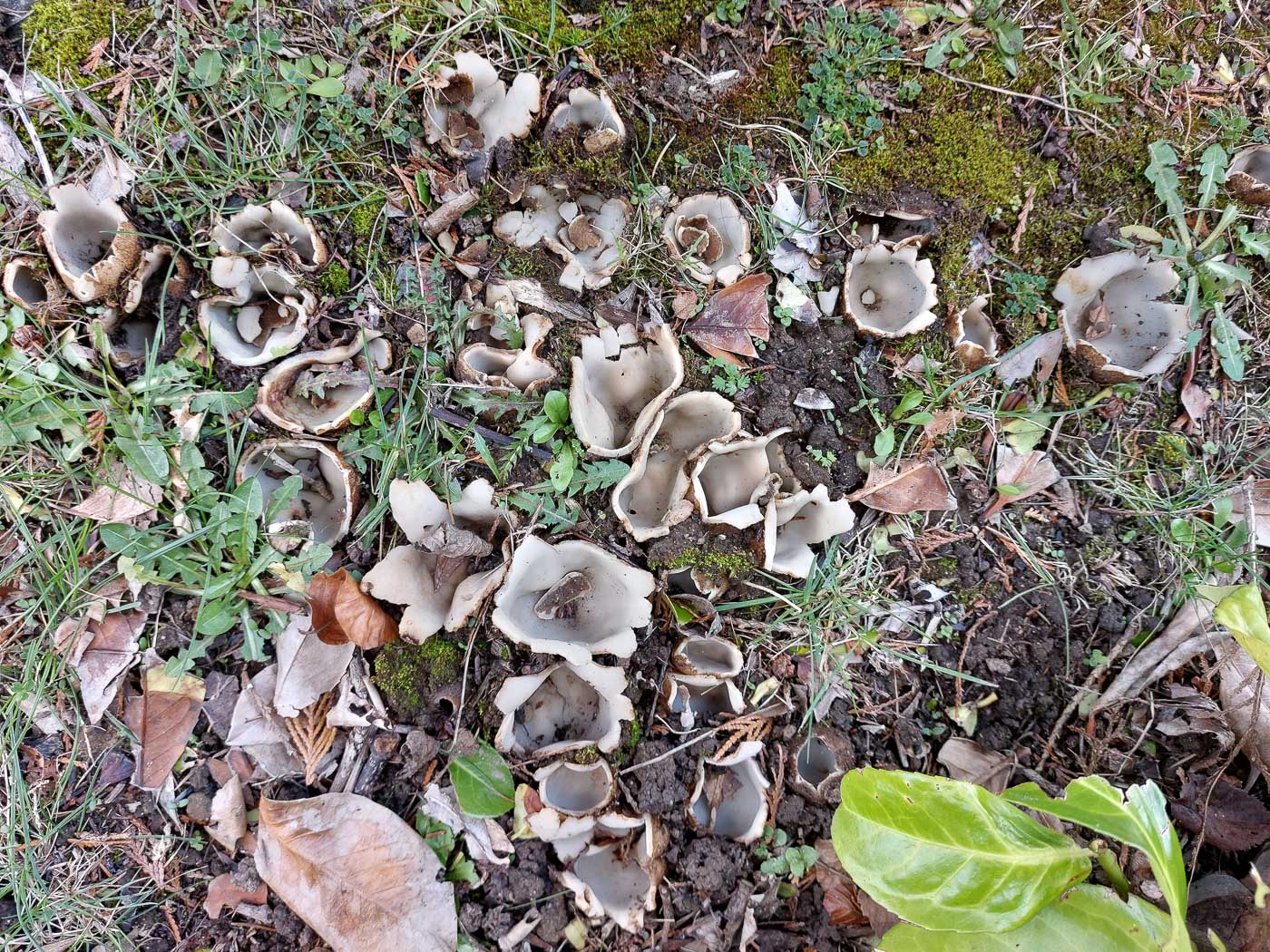
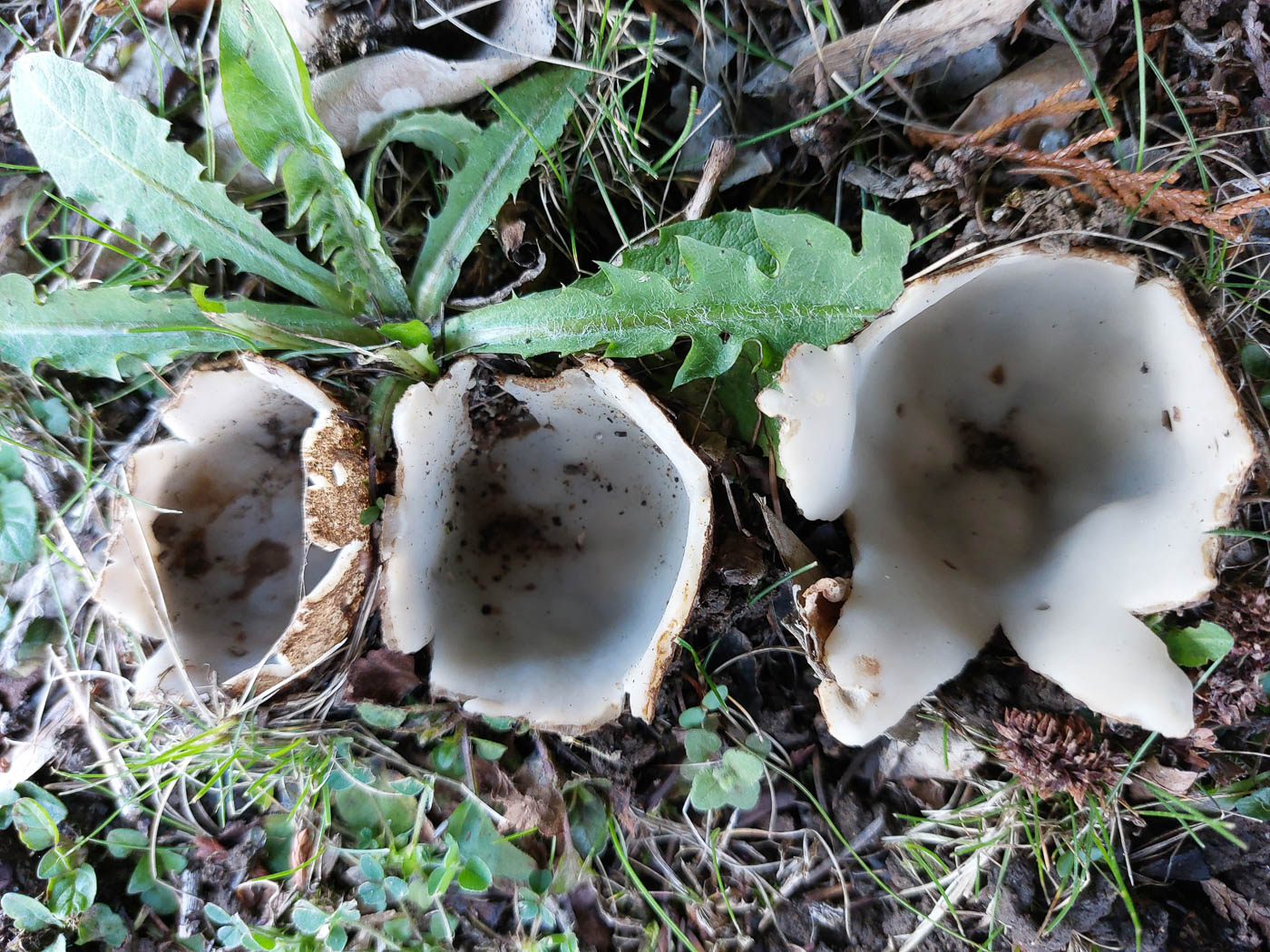 |
April 1st Geopora sumneriana (Cedar Cup)
In Jordans Village Jesper Launder found this unusual springtime species 'going nuts' - his description! - under Cedar. These cups, distantly related to Peziza, are only found under Cedar, always partly submerged in soil, have a hairy exterior to which debris attaches and can get to as much as 7 cm across. They tend to split starlike as they expand. We only have a handful of county sites reported but it is likely to be much more common than this would indicate. It is clearly fruiting prolifically at the moment. See also in Finds 2021 March 21st.
|
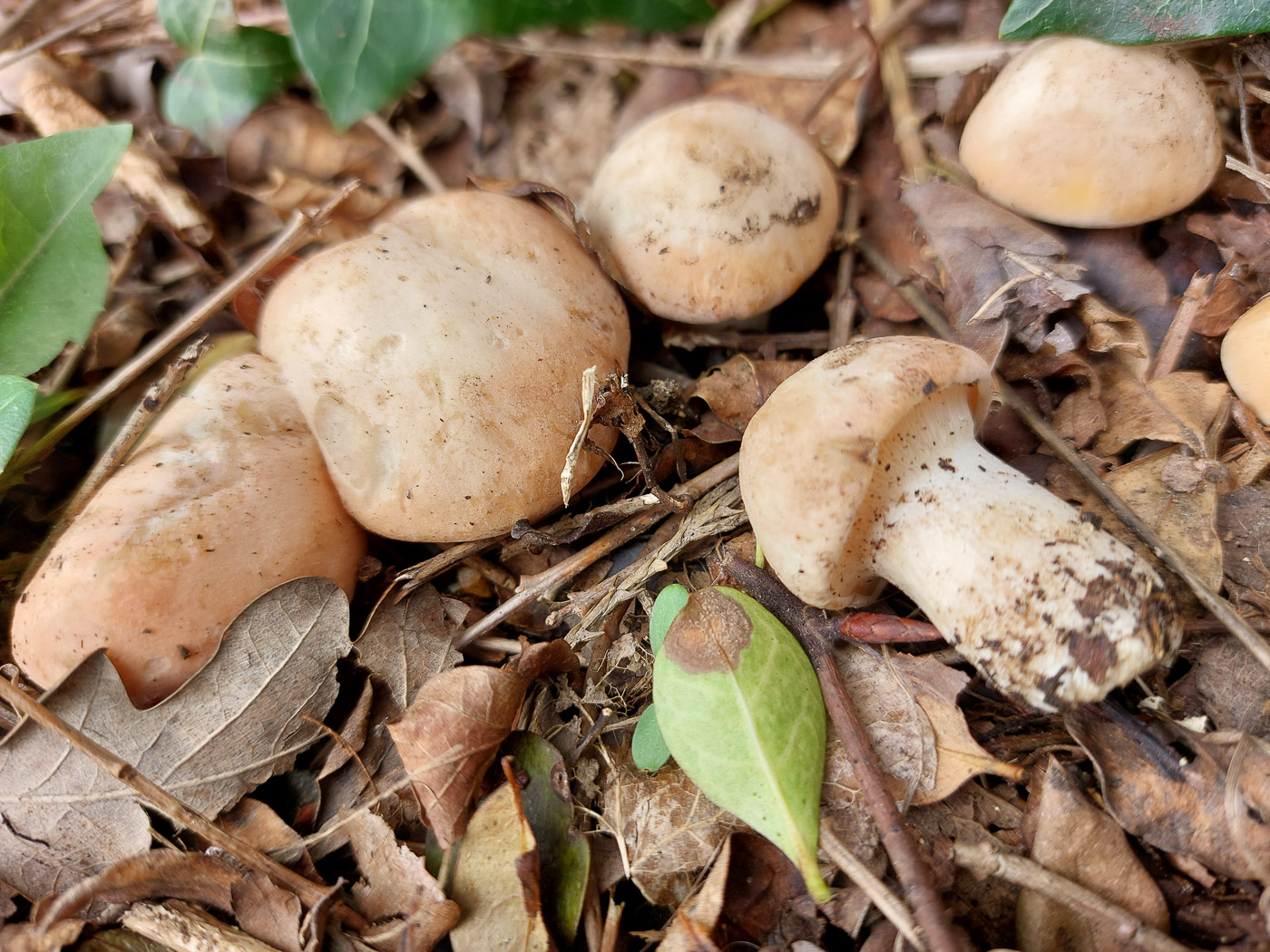
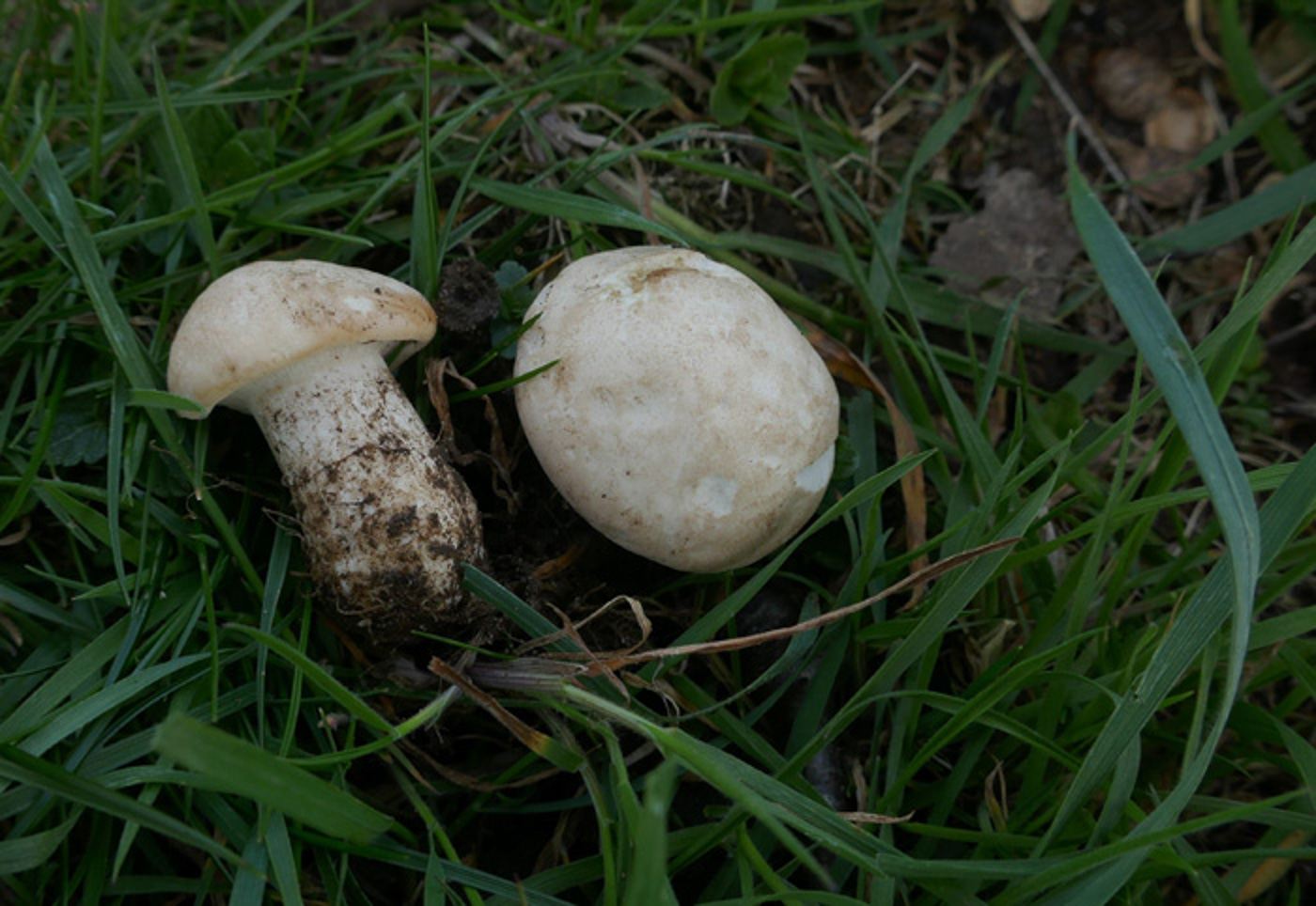 |
April 1st Calocybe gambosa (St. George's Mushroom)
In Jordans village Jesper Launder found an early fruiting of this distinctive springtime species which regularly appears around St. George's Day though is often earlier (as here) and also often later, even well into May. It likes grassy verges and is one of the easiest to recognise, being the only sizeable white-capped and white gilled mushroom to fruit at this time. For confirmation, one sniff at the underside will reveal its strong mealy smell. Photo 2 came from Stampwell Farm a day later, sent in by Jackie Ewan, and we also found very small buttons of it just emerging at Rushbeds Wood on our walk there on the same day. (See my report for more.) See the Masterlist for two previous entries.
|
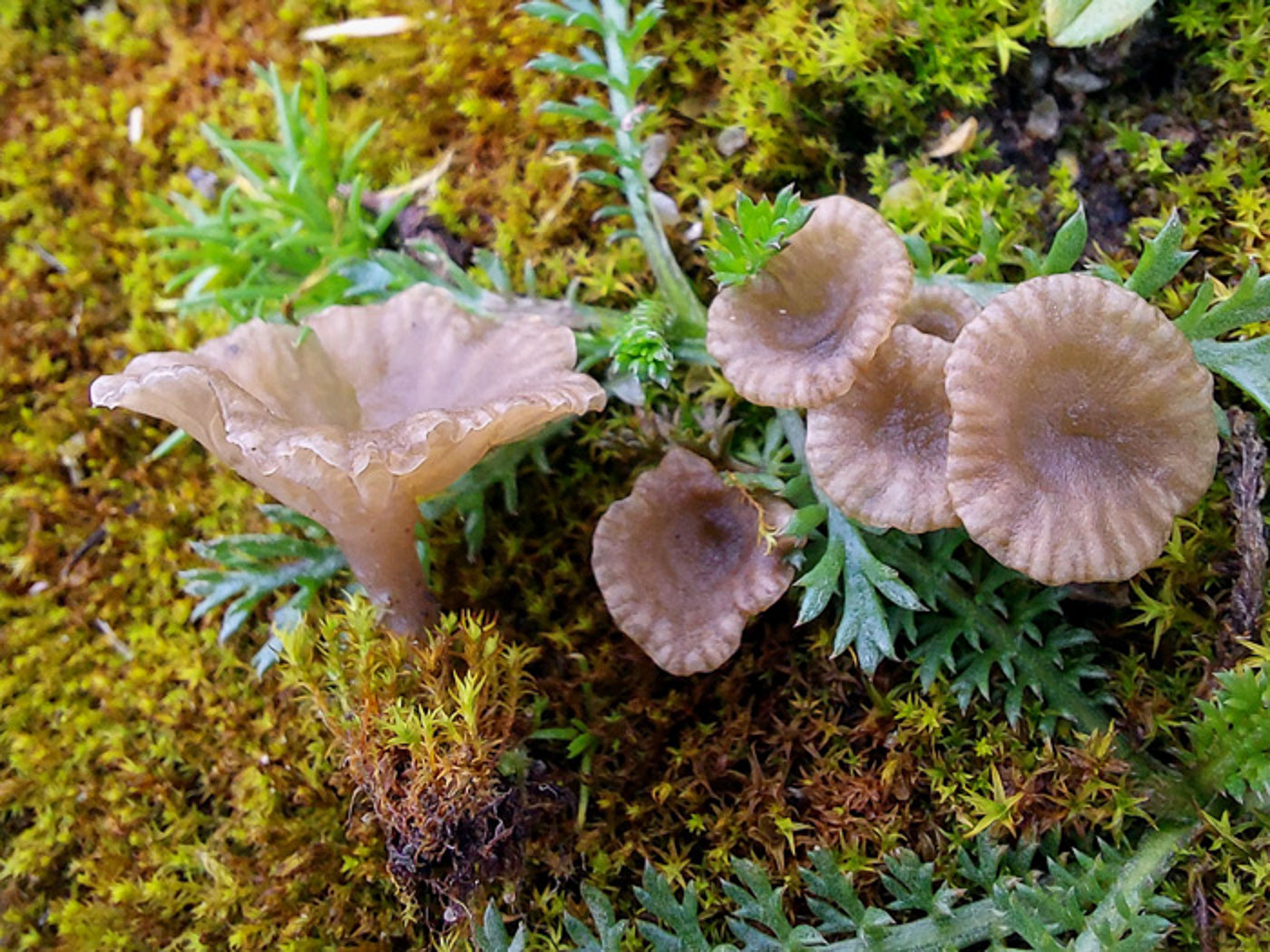 |
April 1st Arrhenia rickenii (Moss Navel) 
In the grounds of the Bull Hotel, Gerrards Cross, Jesper Launder noticed this crop of little beauties growing in a patch of moss. The caps can get to about 2 cm across and their funnel shape with widely spaced decurrent gills are typical. We have just two previous county record, both on Finds: 2020 November 30th and 2022 November 26th.
|
March 27th 2023
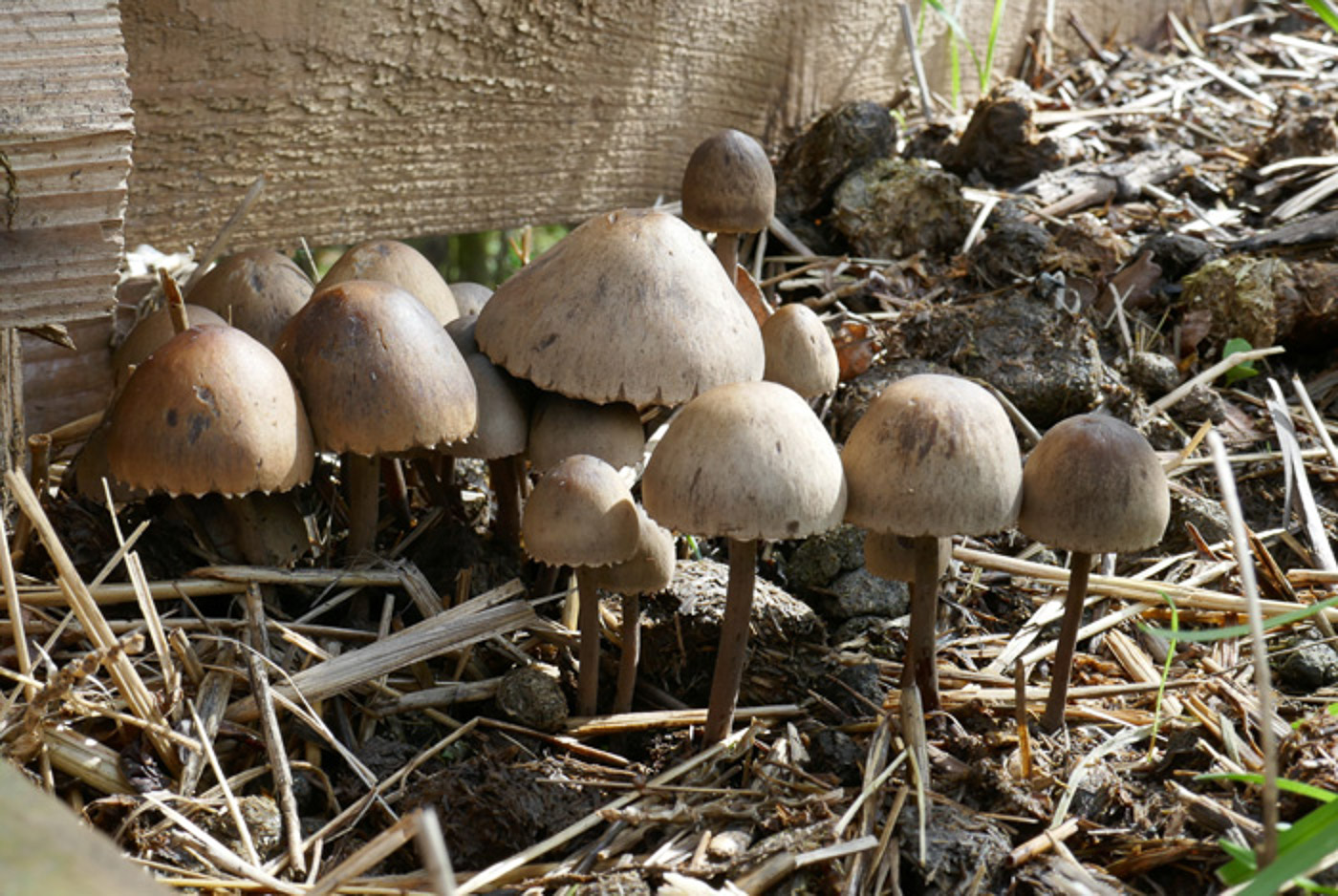 |
March 27th Panaeolus papilionaceus (Petticoat Mottlegill) 
In a dung heap at Stampwell Farm Jackie Ewan found this nicely typical clump of Panaeolus displaying its white frilly cap margin of veil - hence its common name. It can be found on dung of all sorts and is common in fields frequented by animals. See further examples in Finds 2021 July 13th, also 2022 June 13th.
|
March 25th 2023
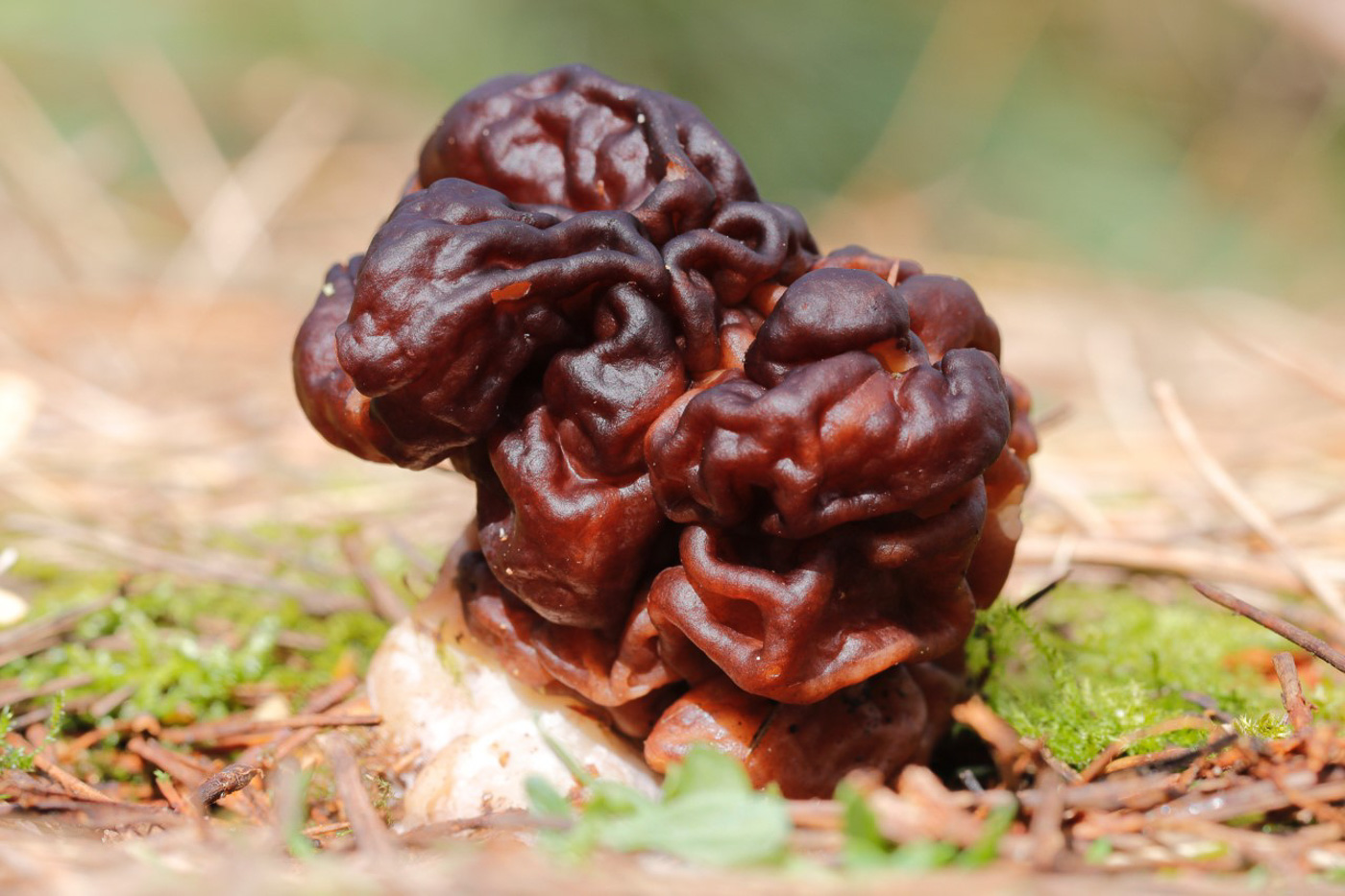 |
March 25th Gyromitra esculenta (False Morel)
Justin Long paid a visit to Wavenden Heath where he's found this rare and interesting ascomycete before. This appears to be our only county site for the species which occurs in Spring in woody debris close to conifers. Despite its species name implying good edibility this is not the case and anyone on the lookout for Morels at this time should beware of collecting it in error the pot! This is another new entry for Finds where we now have photos of over 900 different species!
|
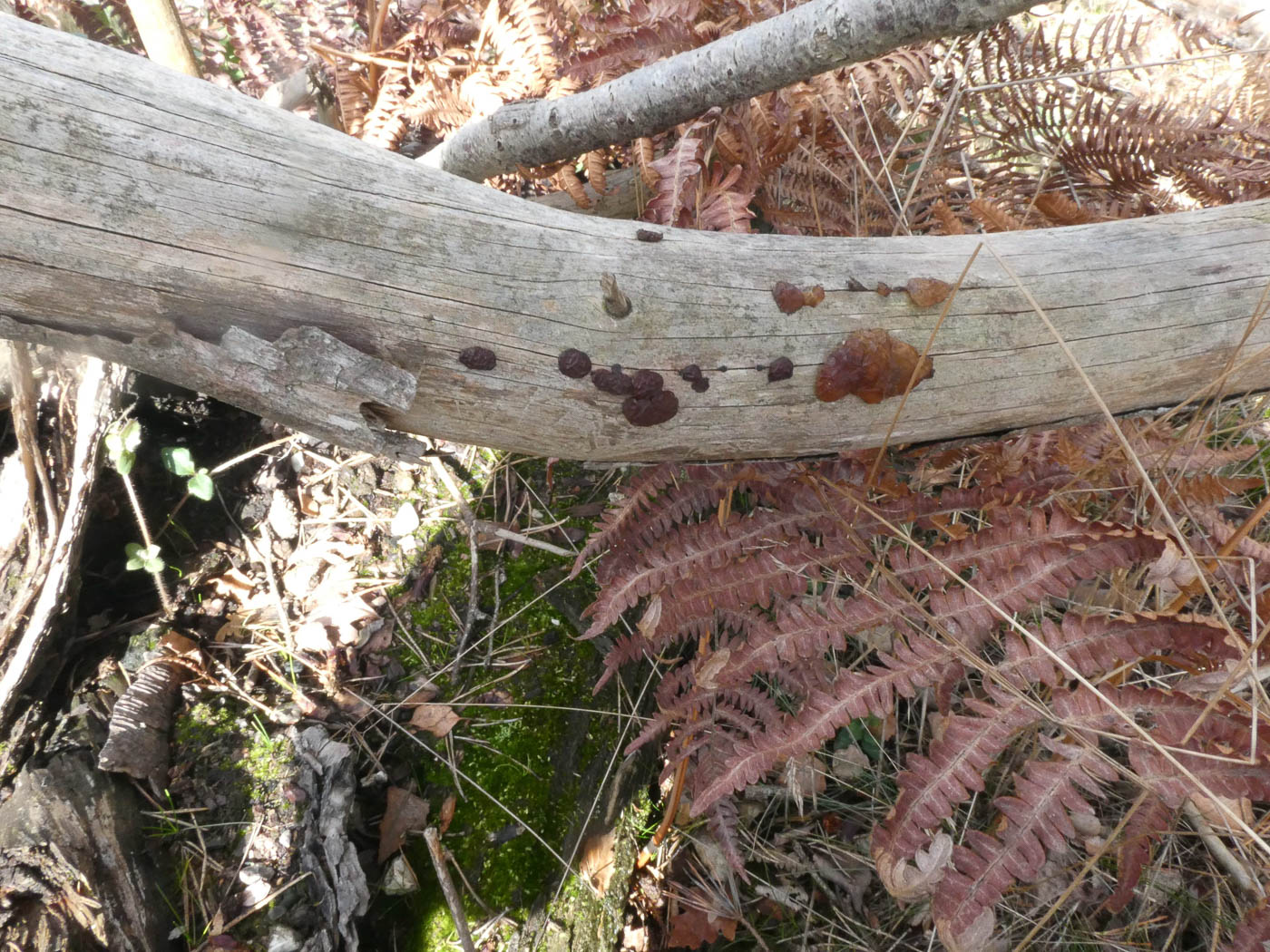
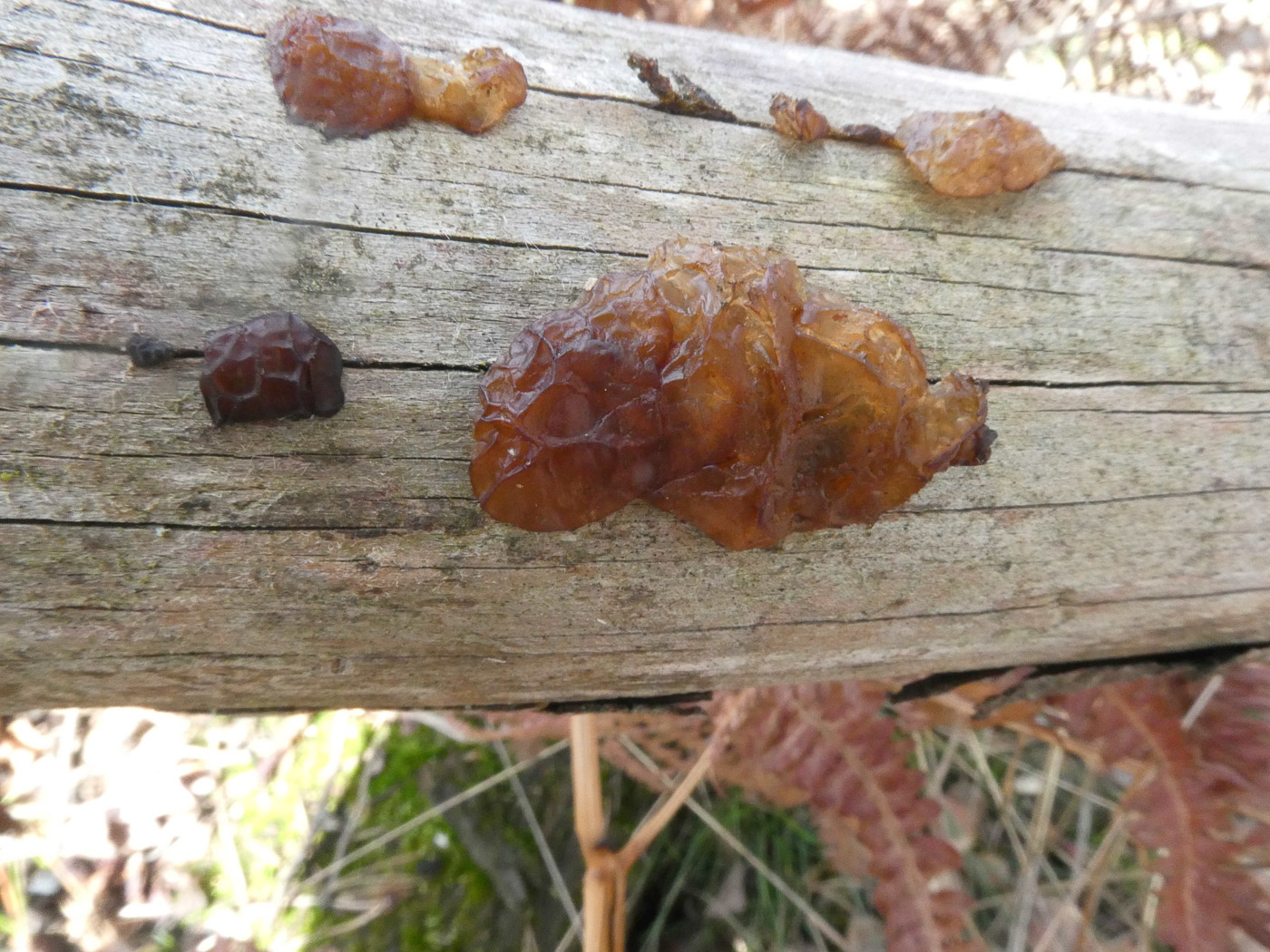
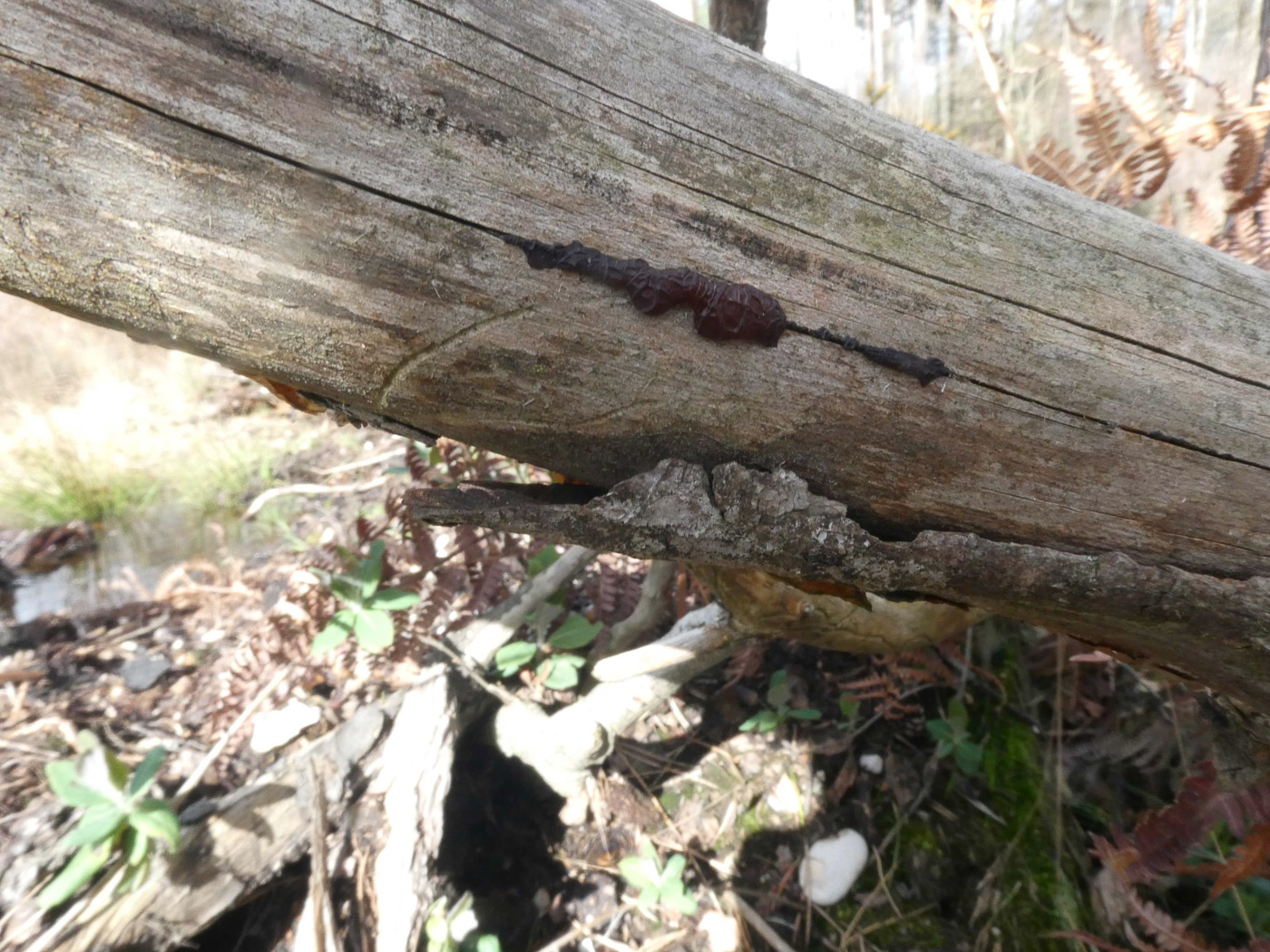 |
March 25th Exidia subsaccharina (a newly described jelly fungus from France) 
In Stoke Common Jim Wills noticed this jelly fungus on fallen bare Pine and guessed that on this substrate it was going to be something interesting and unusual. Checking the spores he found they were too big for E. saccharina (Pine Jelly), in itself a rare species and not recorded in Bucks since a single record in 1988, then found a recent paper (March 2023) describing this new species found on Pine in France - similar to E. saccharina but with larger spores. A sample has now been sequenced and does indeed match that for E. subsaccharina. Congratulations to Jim for both finding and researching this species which is new to the UK - impressive!
|
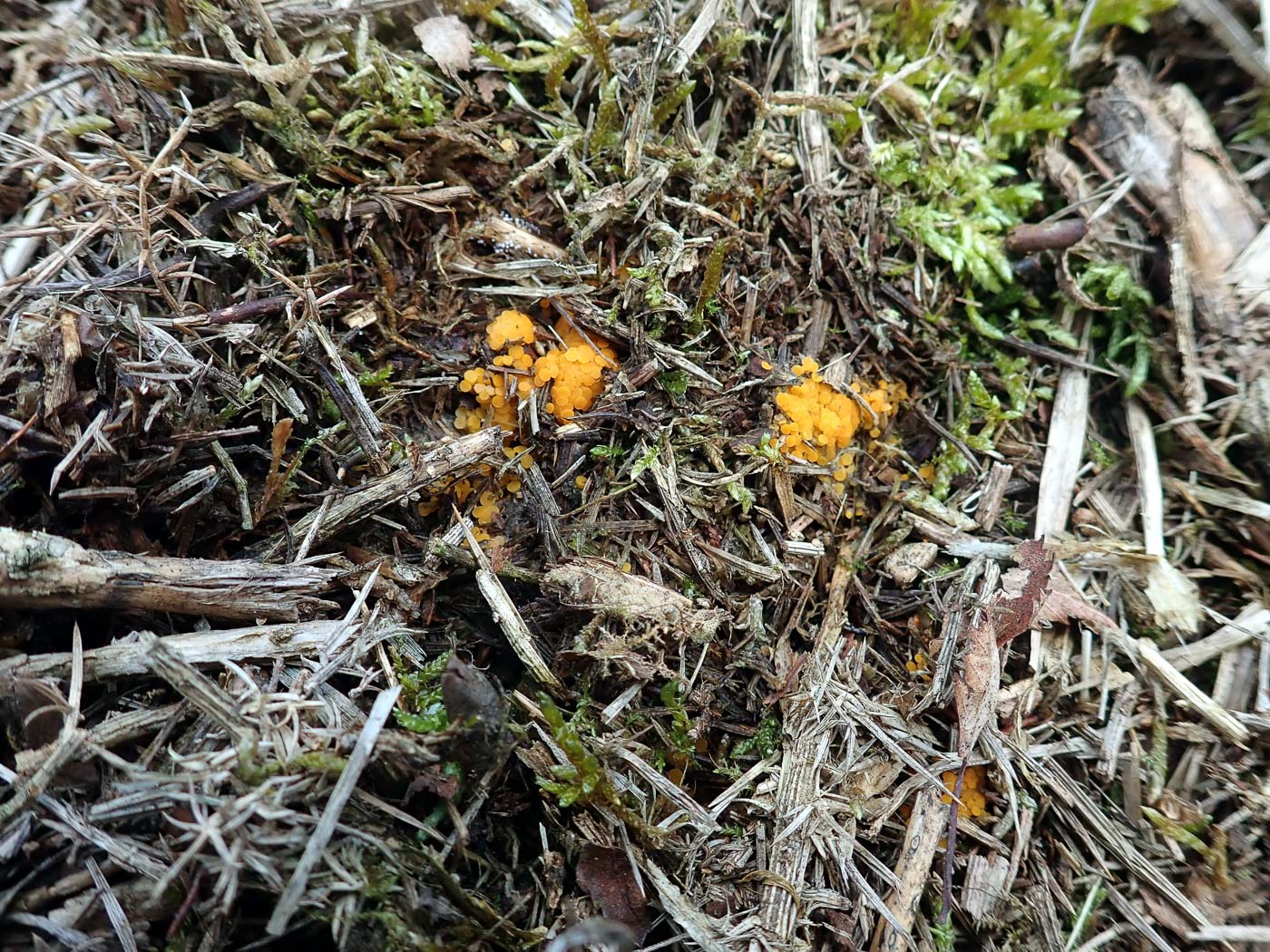
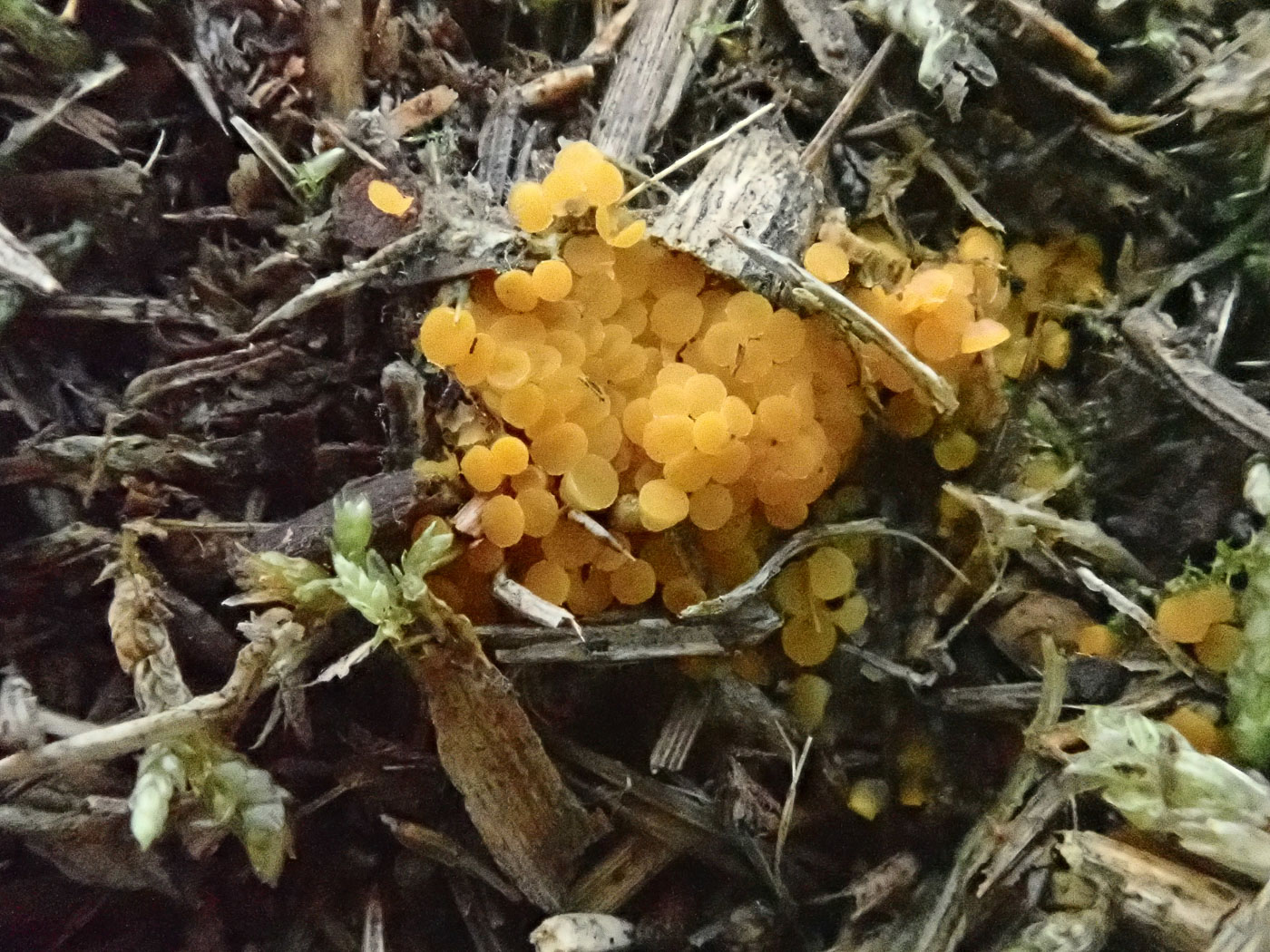 |
March 25th Byssonectria terrestris (a rare ascomycete with no common name) 
At Stoke Common in a heathy patch of rotting mossy vegetation Penny caught her eye in this bright orange colony of tiny discs and immediately wondered if she'd found the very similar Aleuria congrex - new to the UK from here in 2010 and with several subsequent collections. However, a scope revealed this was very different but she was unable to identify it. Sending the details plus microphotos to expert Paul Cannon produced the answer, however. This is new to the county with only six previous UK records on FRDBI though there are only two species in this genus known in the UK and Paul explained that it is likely they have been confused with each other in the past. Sequencing has now confirmed this identification.
|
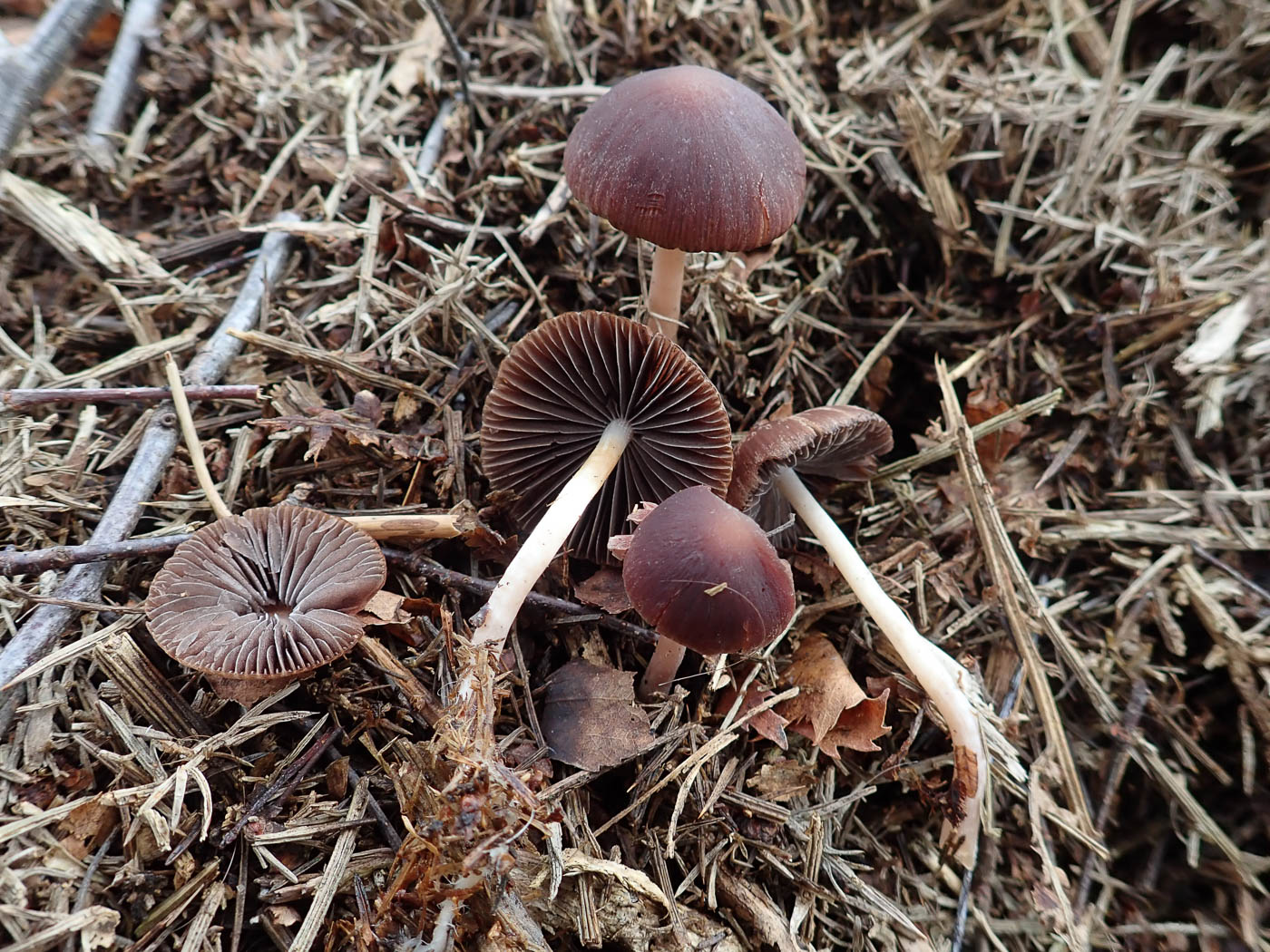 |
March 25th Psathyrella bipellis (an unusual Brittlestem with no common name) 
At Stoke Common in a large heap of rotting vegetation - a mix of Bracken and Gorse - Penny was pleased to notice this little collection of Brittlestems coming up and in good condition. The species is not renowned for fruiting at this time but is quite a distinctive one in the field, having a cap tinged a rich purple brown before it fades as it dries out. Having recognised it from its colour and shape, she was able to confirm the ID from spore size and the abundance of correctly shaped cells all over the gills. We have records from a handful of other county sites but this was a first for Stoke Common and for this time of year. See also in Finds 2020 October 11th and 2022 November 20th.
|
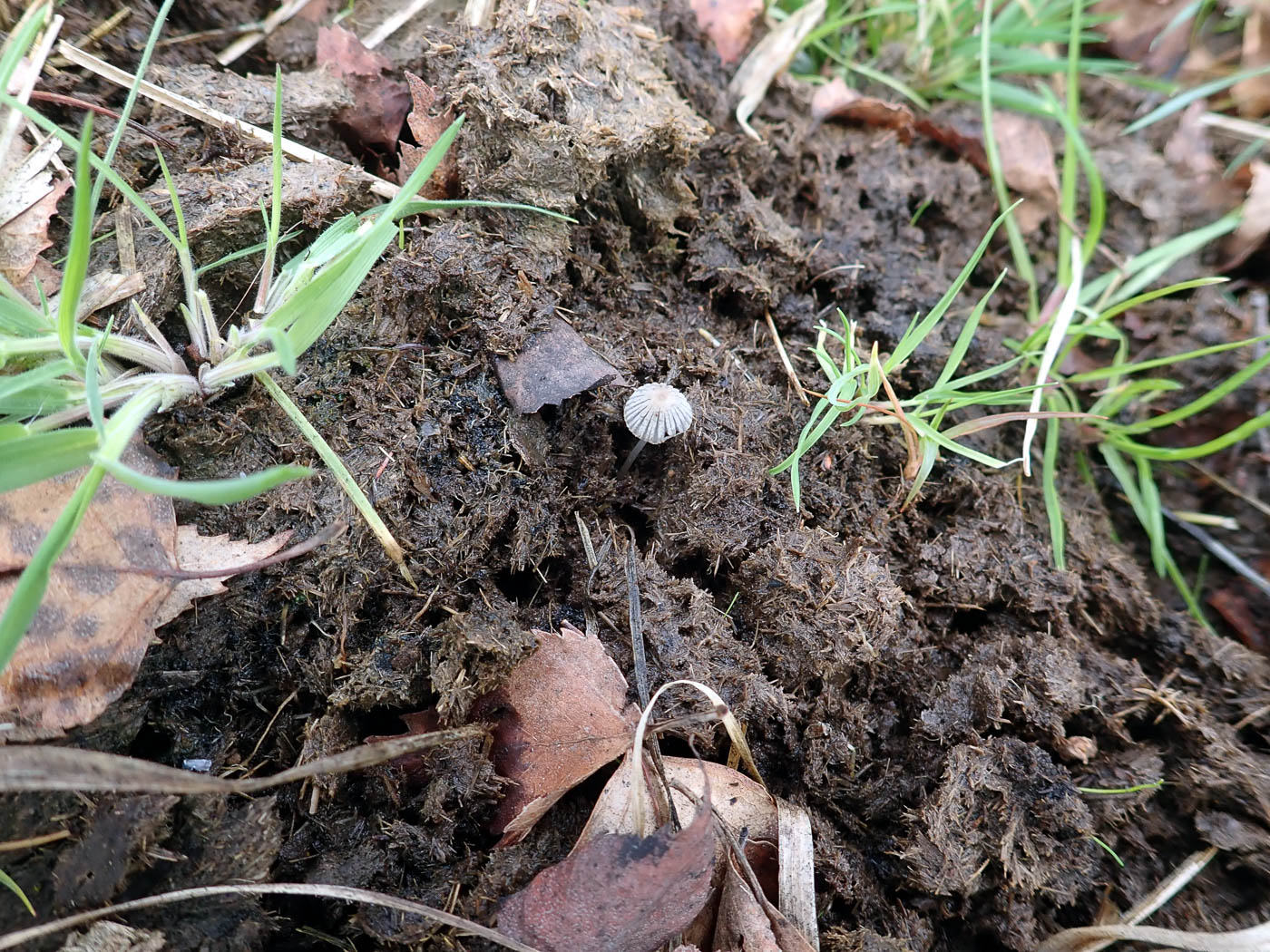
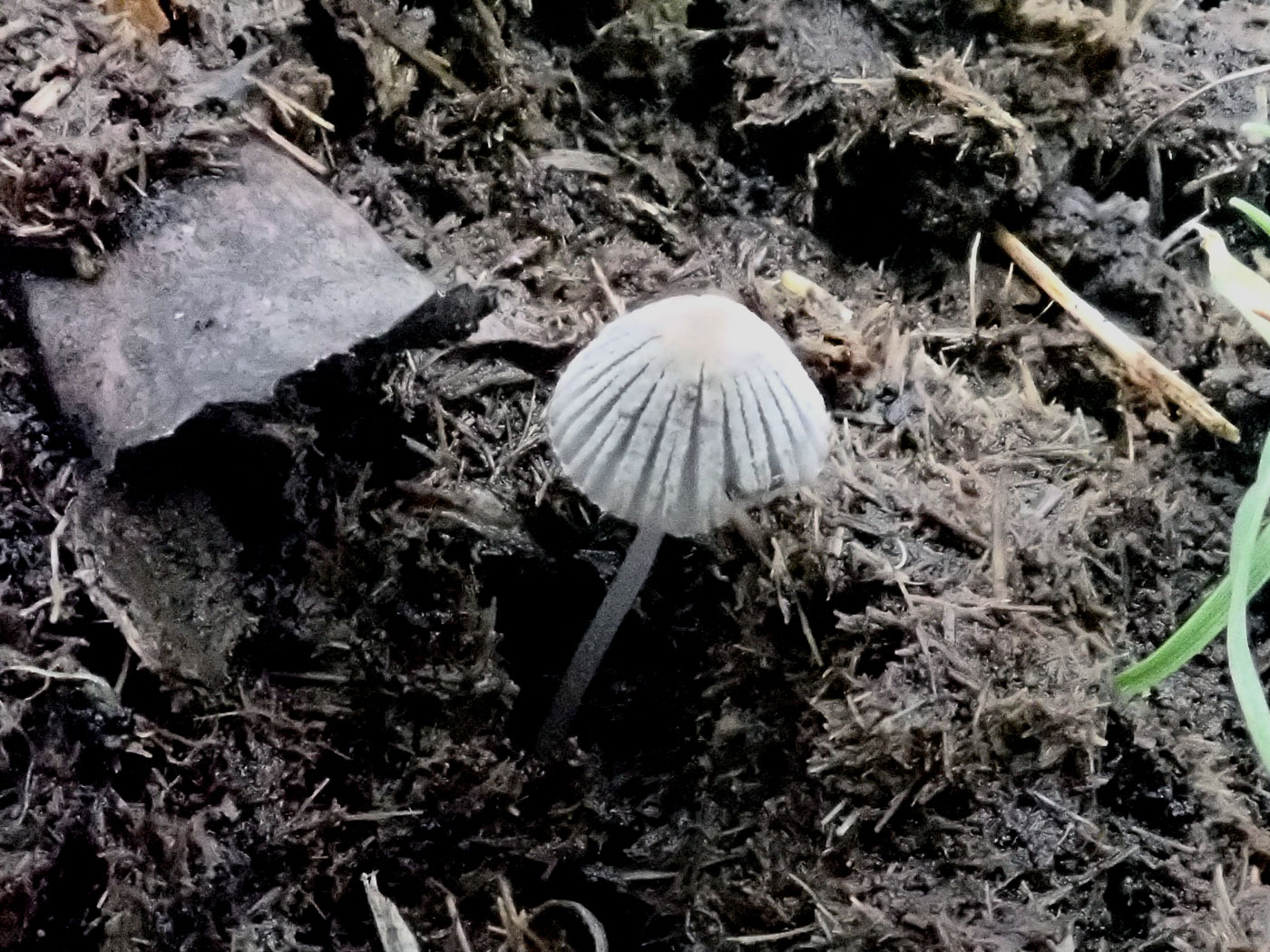
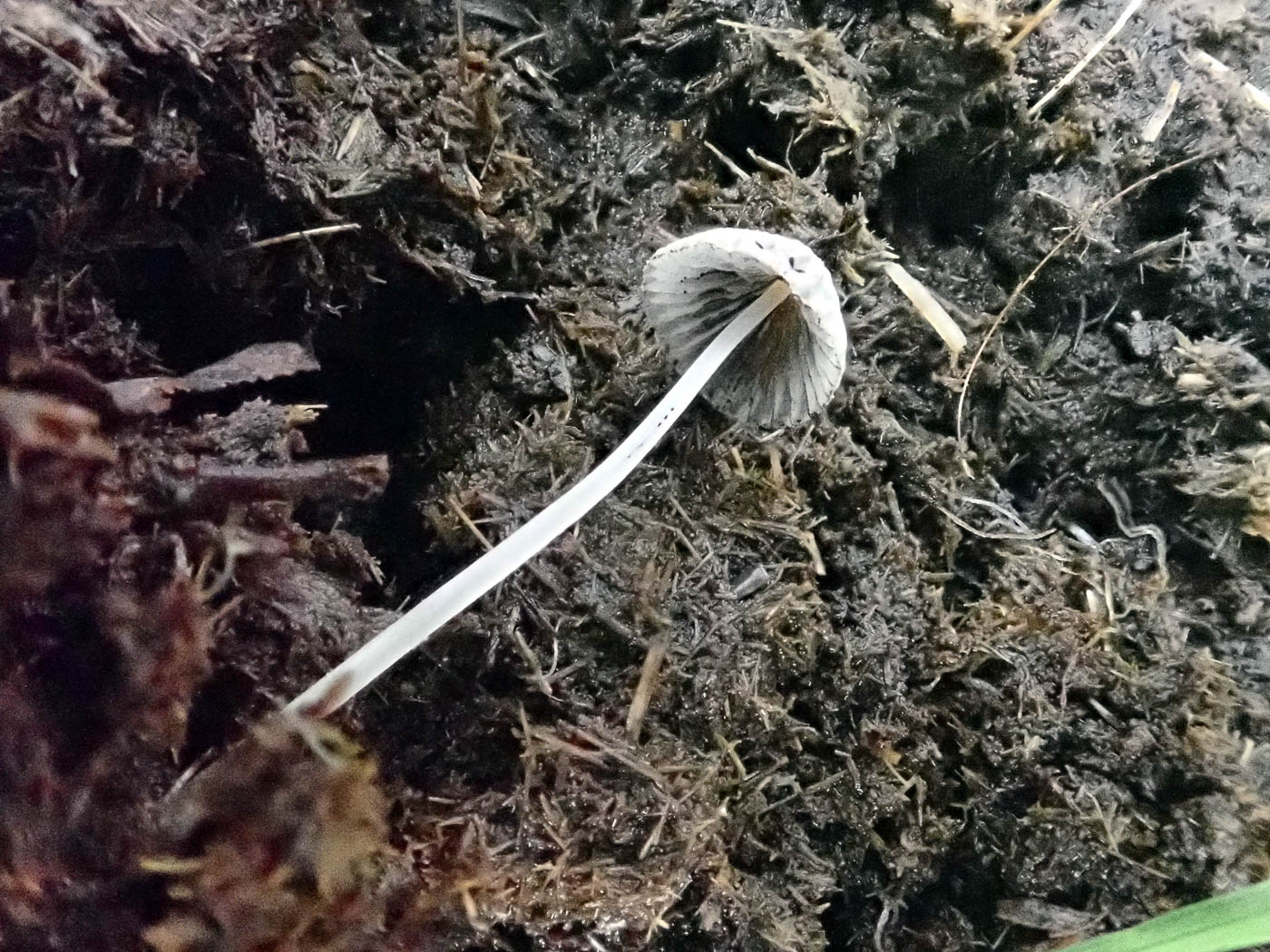 |
March 25th Parasola misera (Least Inkcap) 
On pony dung at Stoke Common Penny found this tiny Parasol - the smallest in this particular genus of Inkcaps. Less than 5mm across at most and often much smaller than that, it occurs quite commonly on dung of various sorts but is easily overlooked for obvious reasons. There are several other Inkcaps - different genera - equally small on this substrate so a scope is necessary to confirm identification to species level. We have just one other Finds example: 2020 November 24th.
|
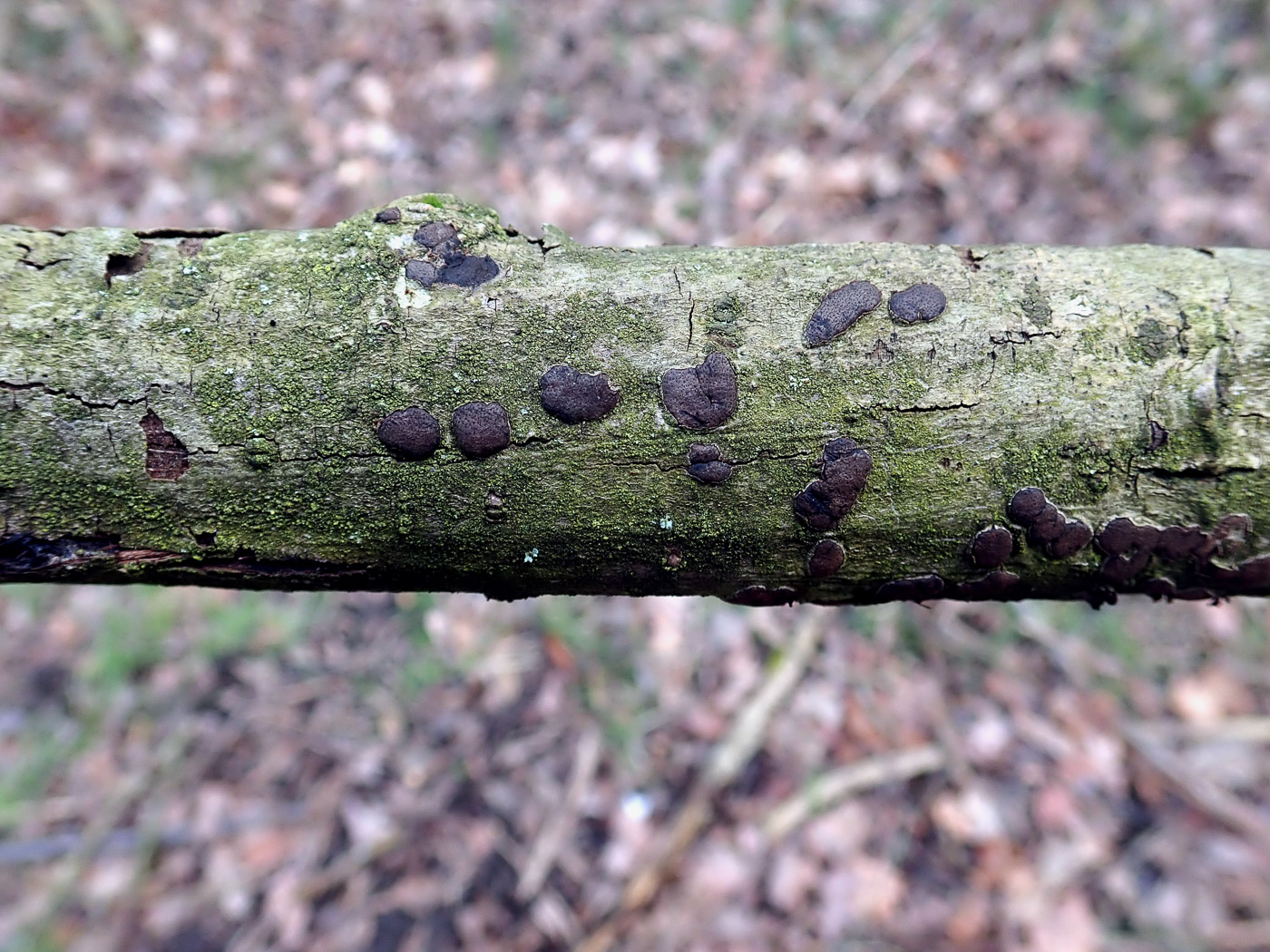
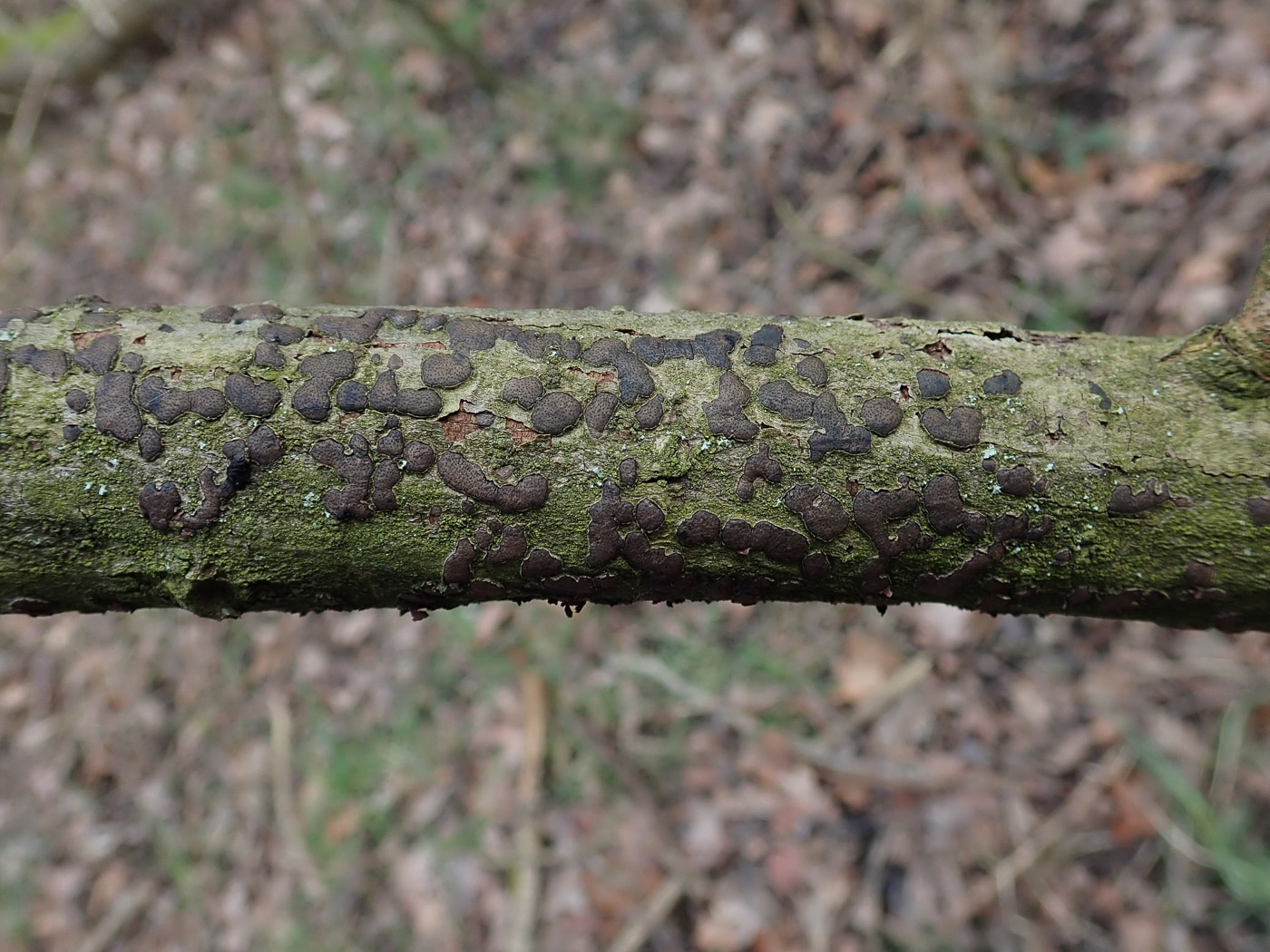
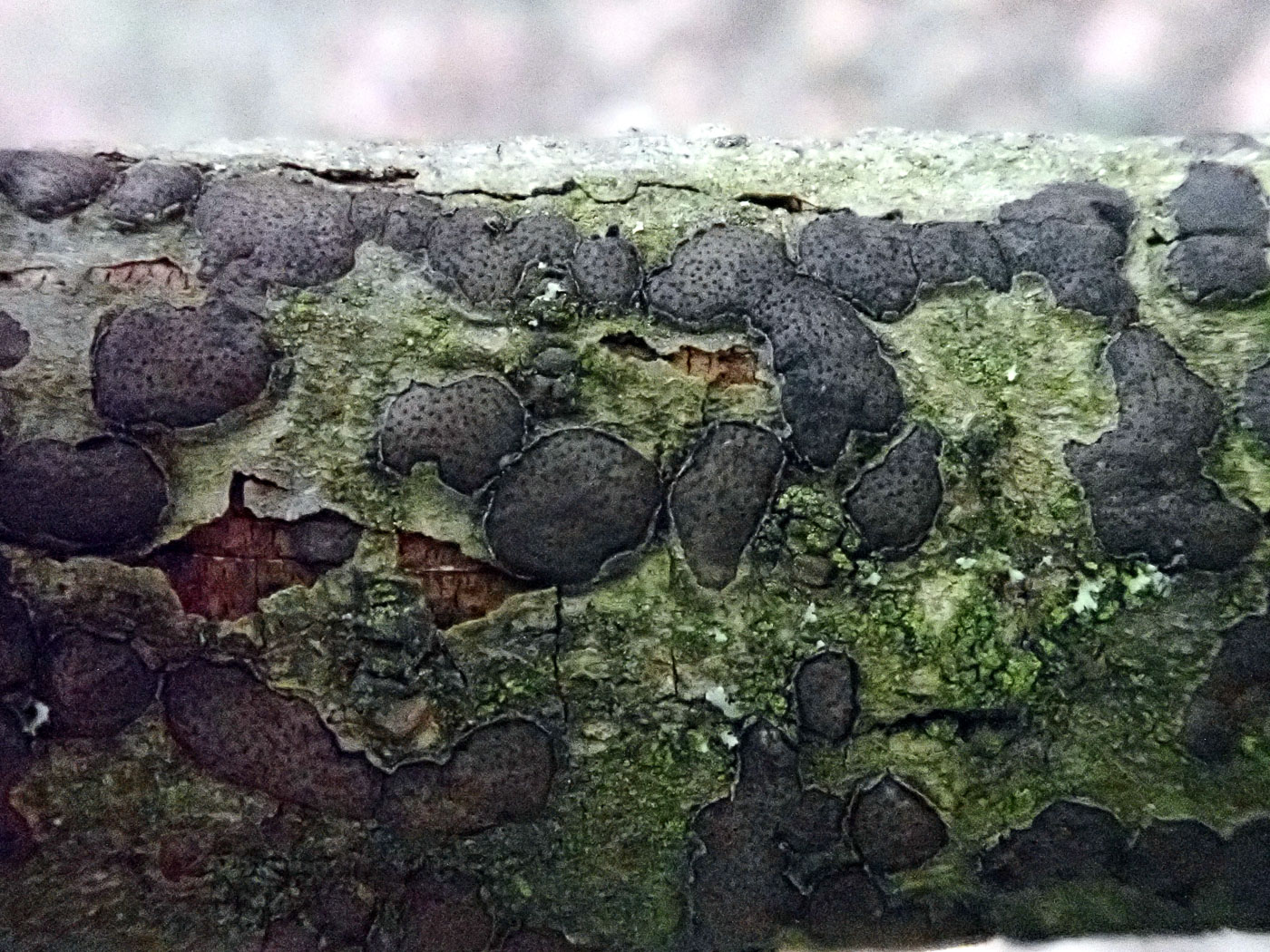 |
March 25th Diatrype bullata (Willow Barkspot)
Searching amongst the many Willows at Stoke Common Penny eventually found good material of this fairly common Pyrenomycete which occurs on dead attached branches of Willow, also Alder and Poplar. Very similar to some Hypoxylon species (Woodwarts) it can be recognised in the field not only by its host tree but also its rather flat shape rather than rounded and its tendency for fruiting bodies to fuse together. The species is not rare though this is our first Finds entry.
|
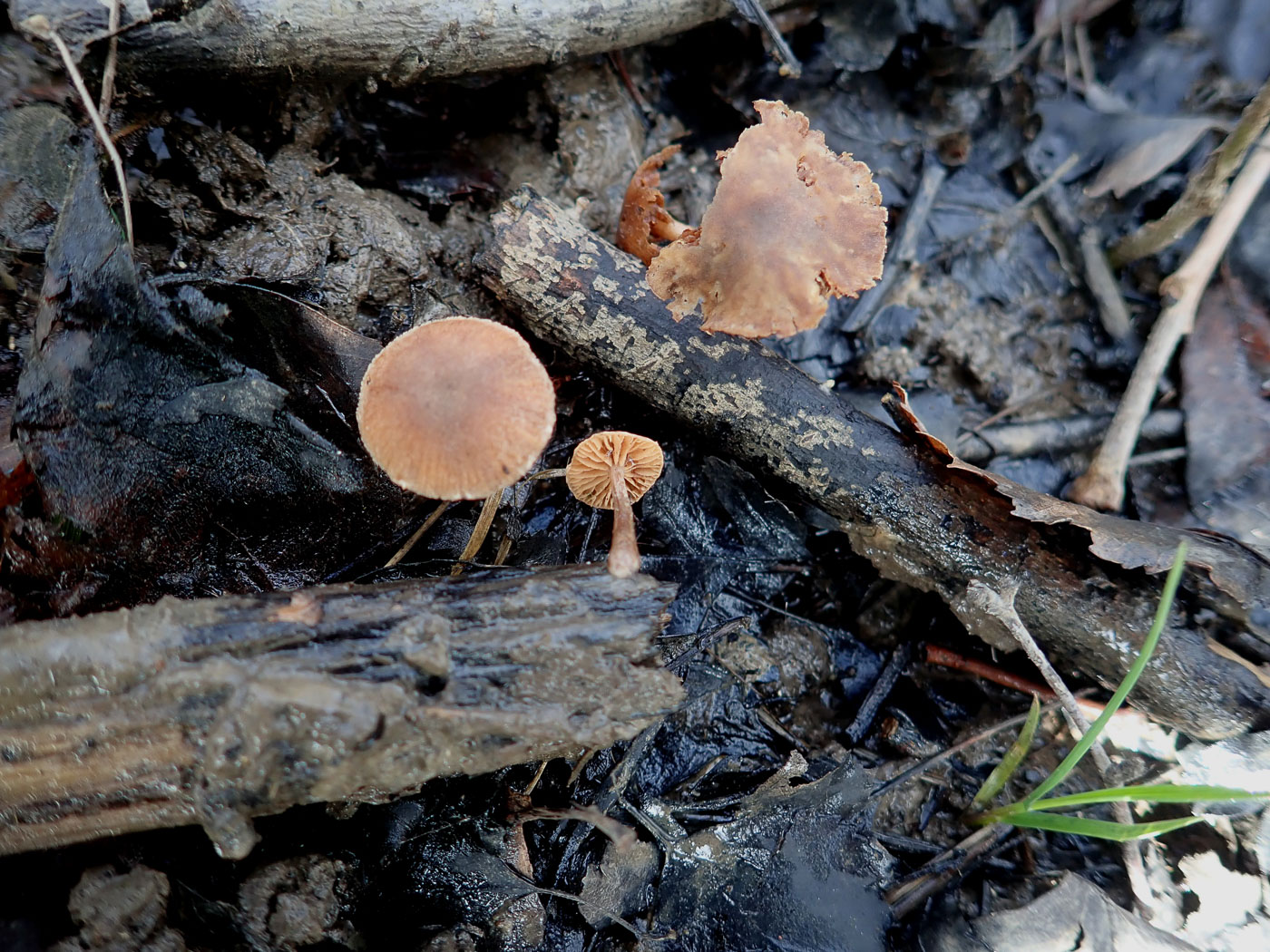
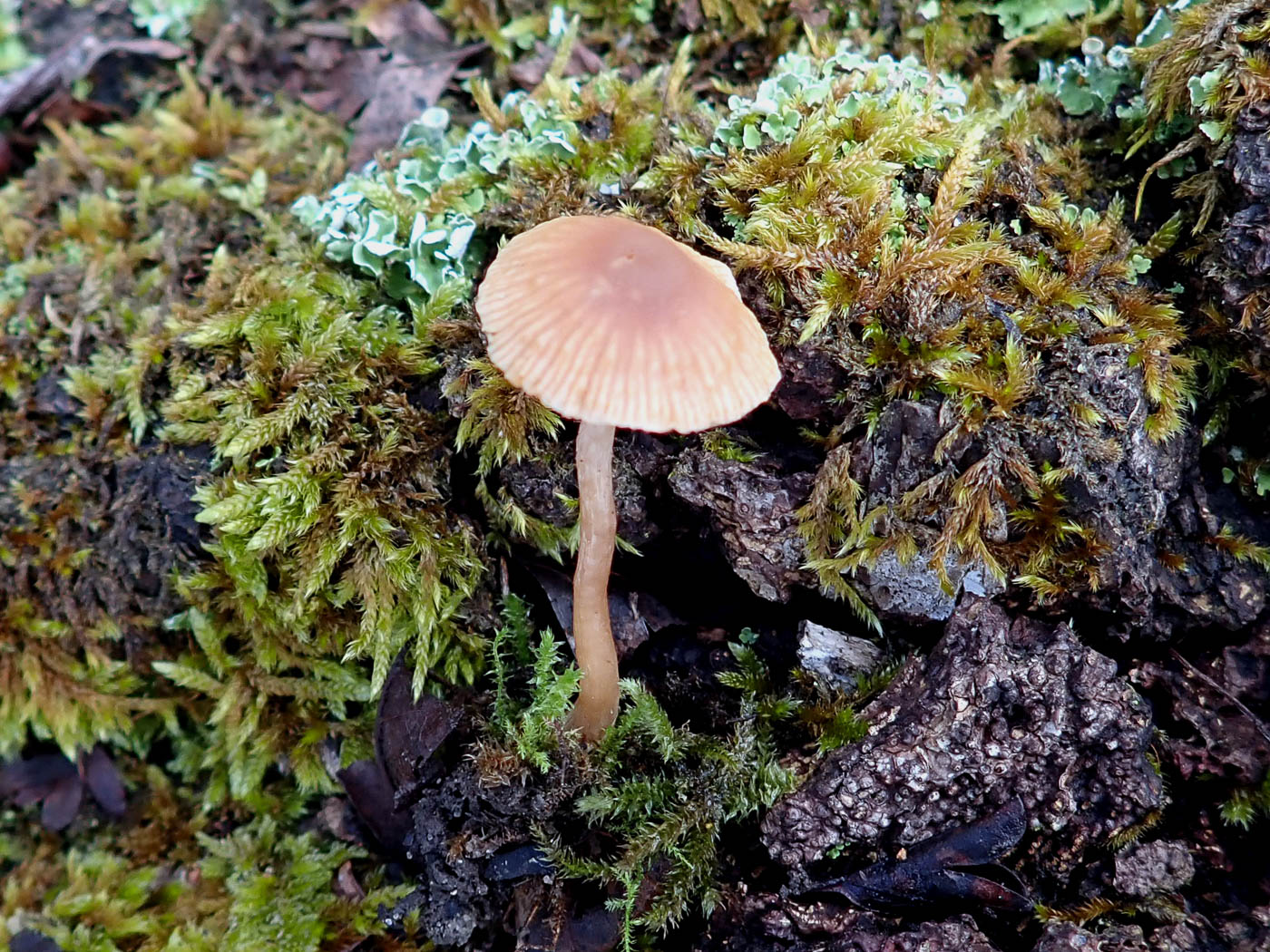
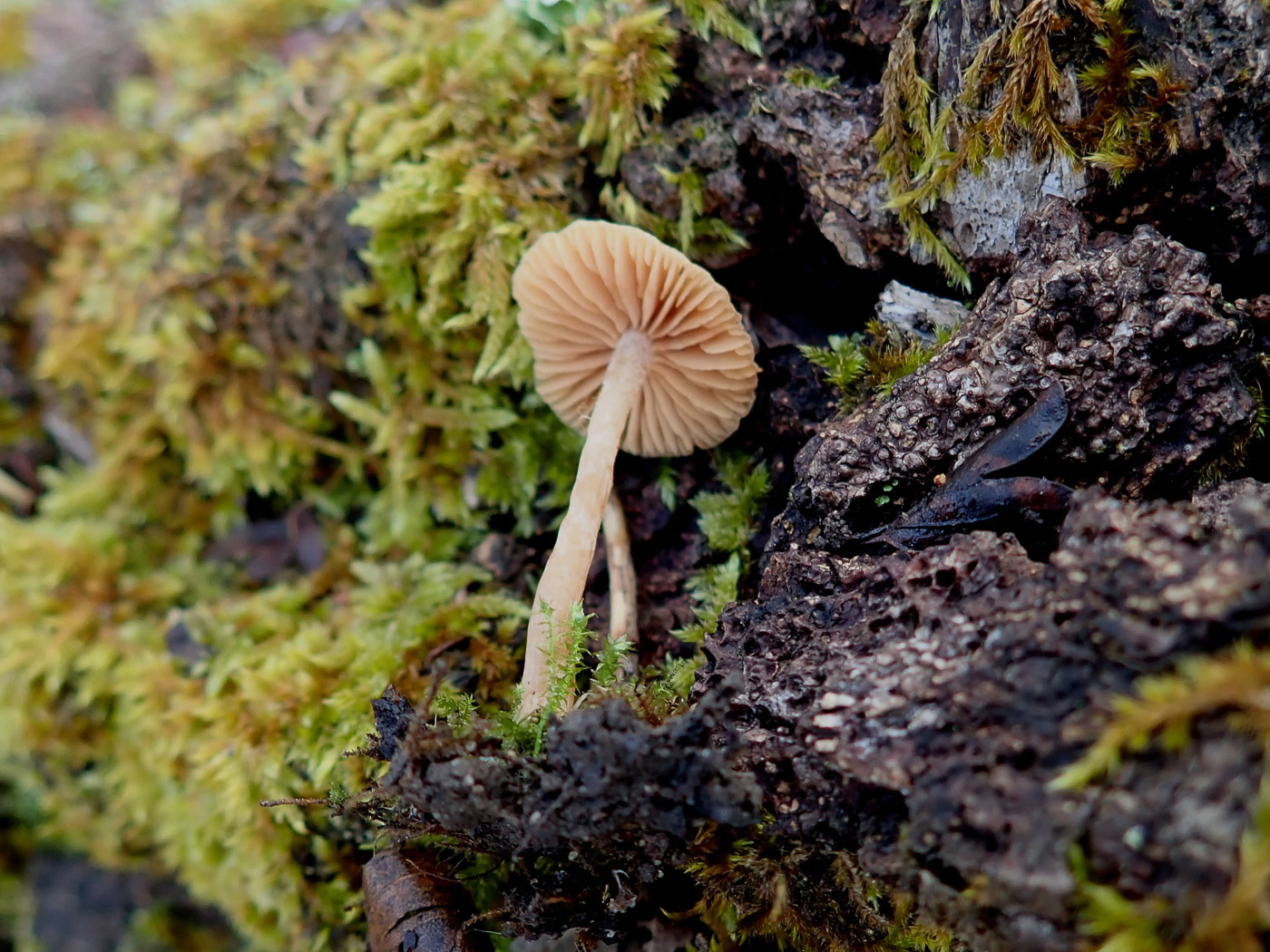 |
March 25th Tubaria furfuracea (Scurfy Twiglet)
At Stoke Common Penny found several examples of this very common species on fallen wood or in woody debris.The identity of this typical LBJ tends to cause confusion and doubt being in appearance very like several other genera such as Galerina and Conocybe. It is much the commonest species, however, fruiting at all times in woody litter and sometimes in abundance, that it's worth making oneself really familiar with it in order to be able to eliminate it when something different turns up. See the Masterlist for further examples.
|
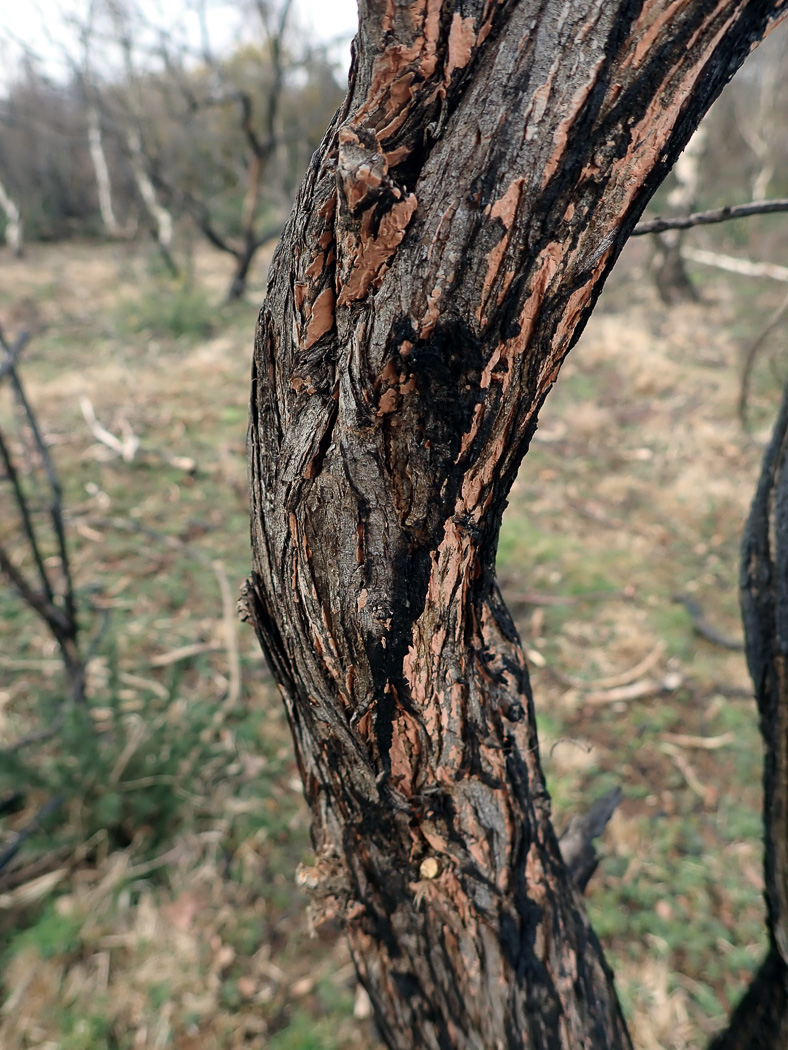 |
March 25th Peniophora incarnata (Rosy Crust)
At Stoke Common in a large patch of burnt Gorse Penny went searching for an interesting small Daldinia species (King Alfred's Cakes) found only on that substrate. No luck, though several other things were found on the scorched stems: As well as Nectria cinnabarina (Coral Spot) and Schizophyllum commune (Split Gill) there were plentiful examples of P. incarnata - a strikingly peachy pink corticioid host specific to Gorse though not necessarily burnt! See more examples found at this site by Russell Ness on February 11th.
|
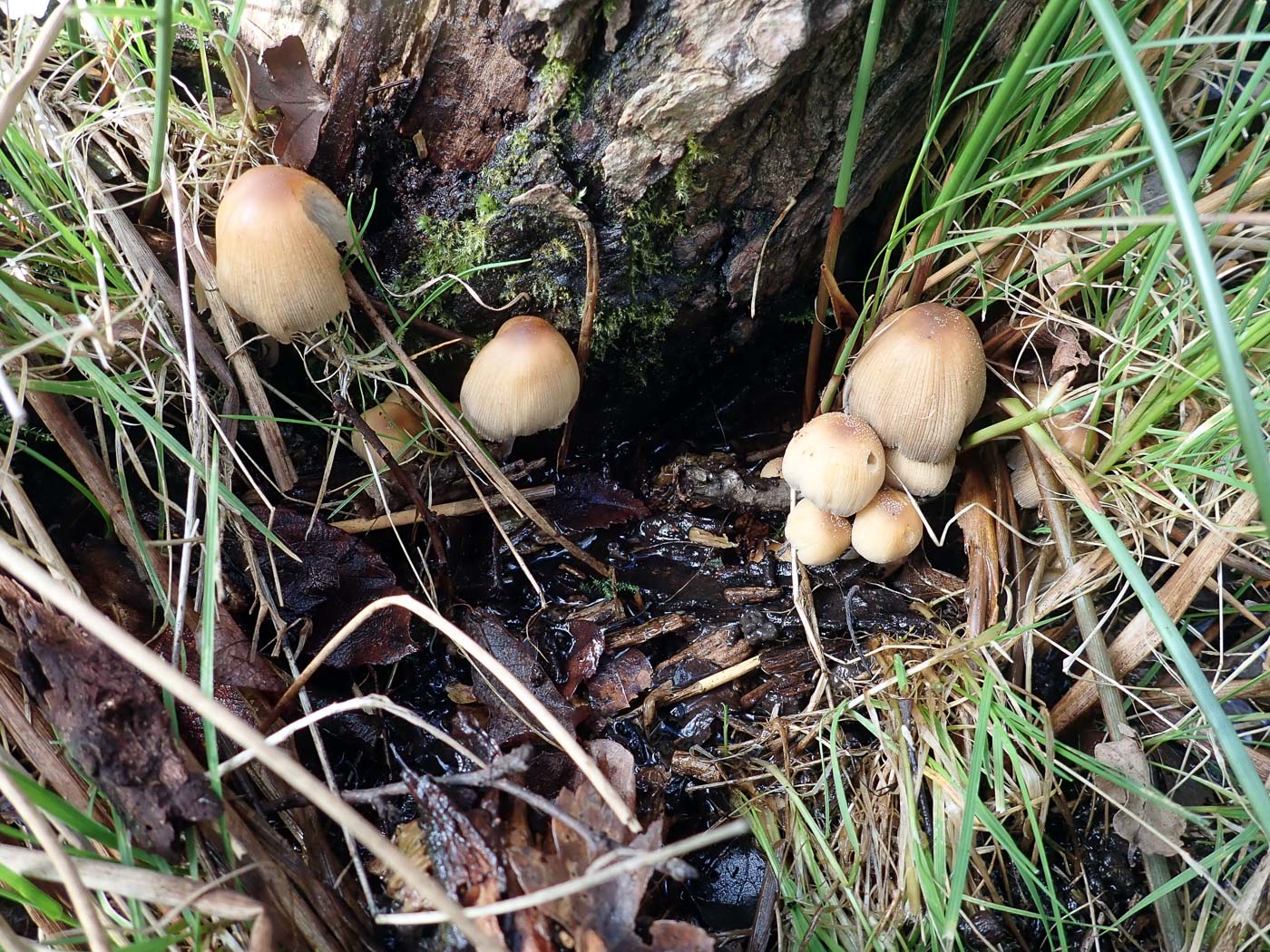
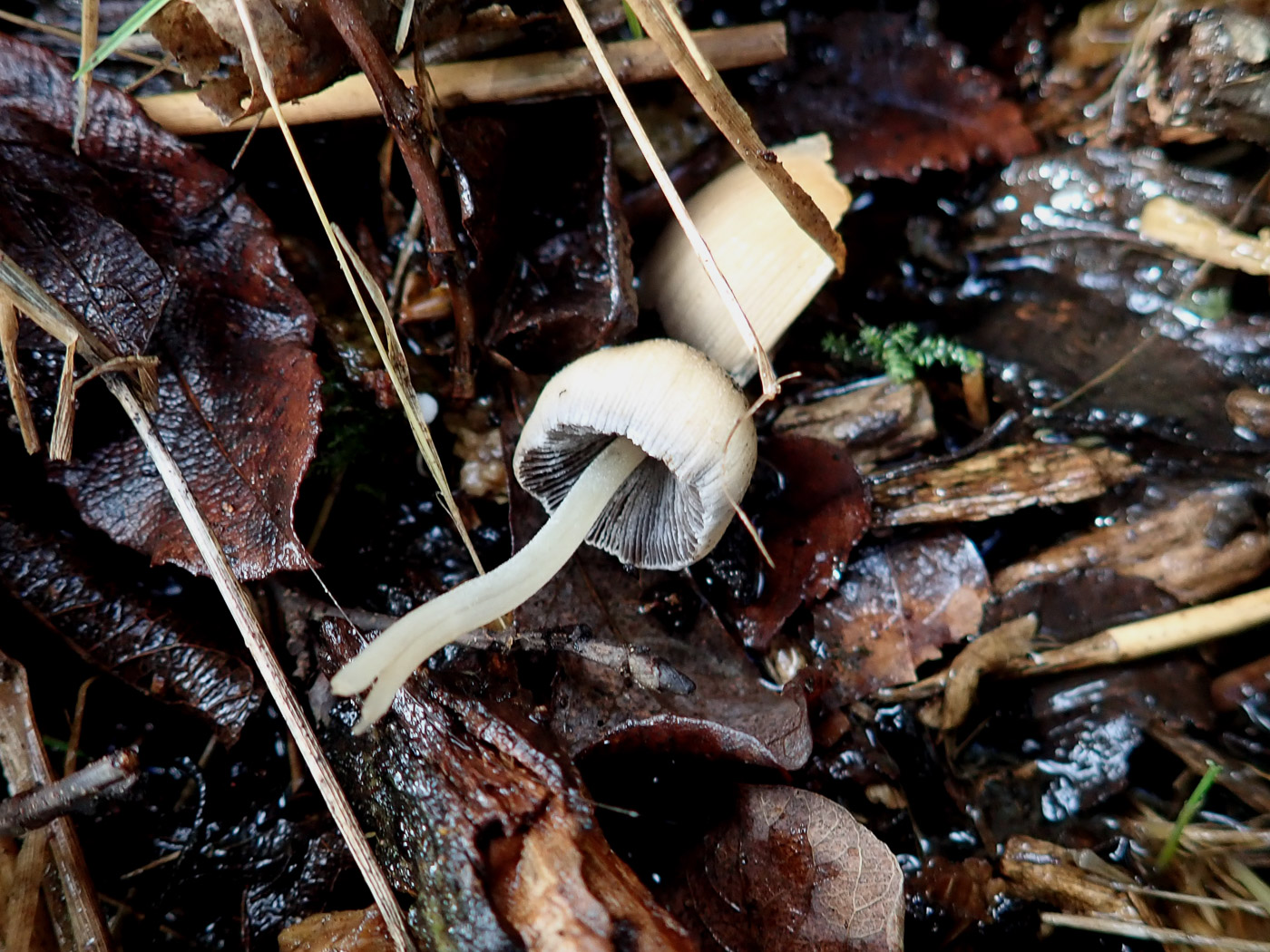 |
March 25th Coprinellus micaceus (Glistening Inkcap) 
On a Birch stump in a flooded area of Stoke Common Penny was quite surprised to find this species freshly fruiting though recent rains had removed signs of the 'glistening' veil often visible on the cap and from which the species derives its common name. See the Masterlist for further examples.
|
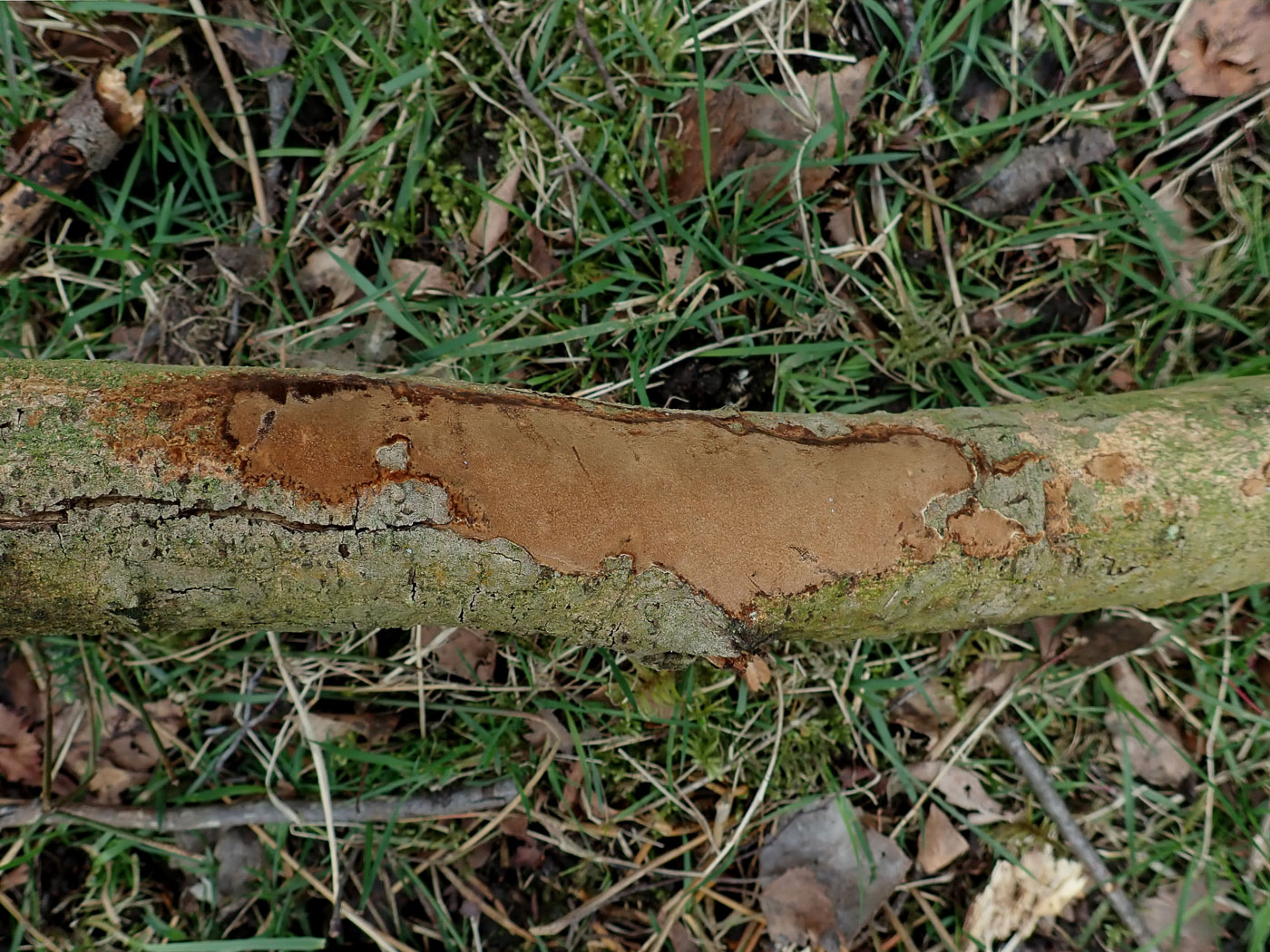
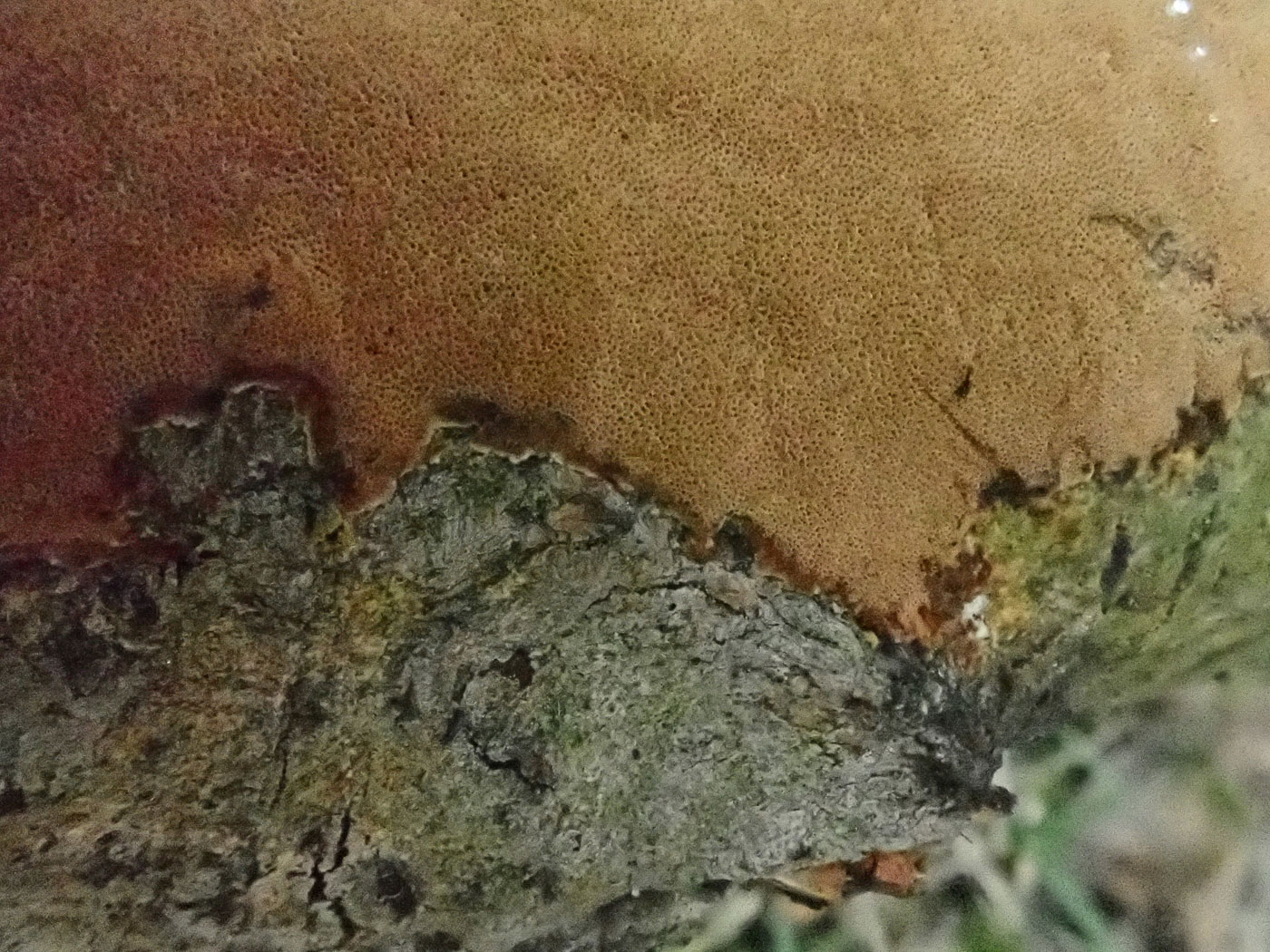 |
March 25th Fuscoporia ferrea (Iron Porecrust)
On fallen Ash at Stoke Common Penny noticed this patch of a common species, about 6 inches in length, smooth, felty and typically cinnamon in colour. It is much the commoner of two similar species, both previously in genus Phellinus - the rarer (F. ferruginosa) best separated from it through microscopy though generally a darker shade of brown. Both occur on fallen deciduous woods and surprisingly this seems to be a new entry for Finds.
|
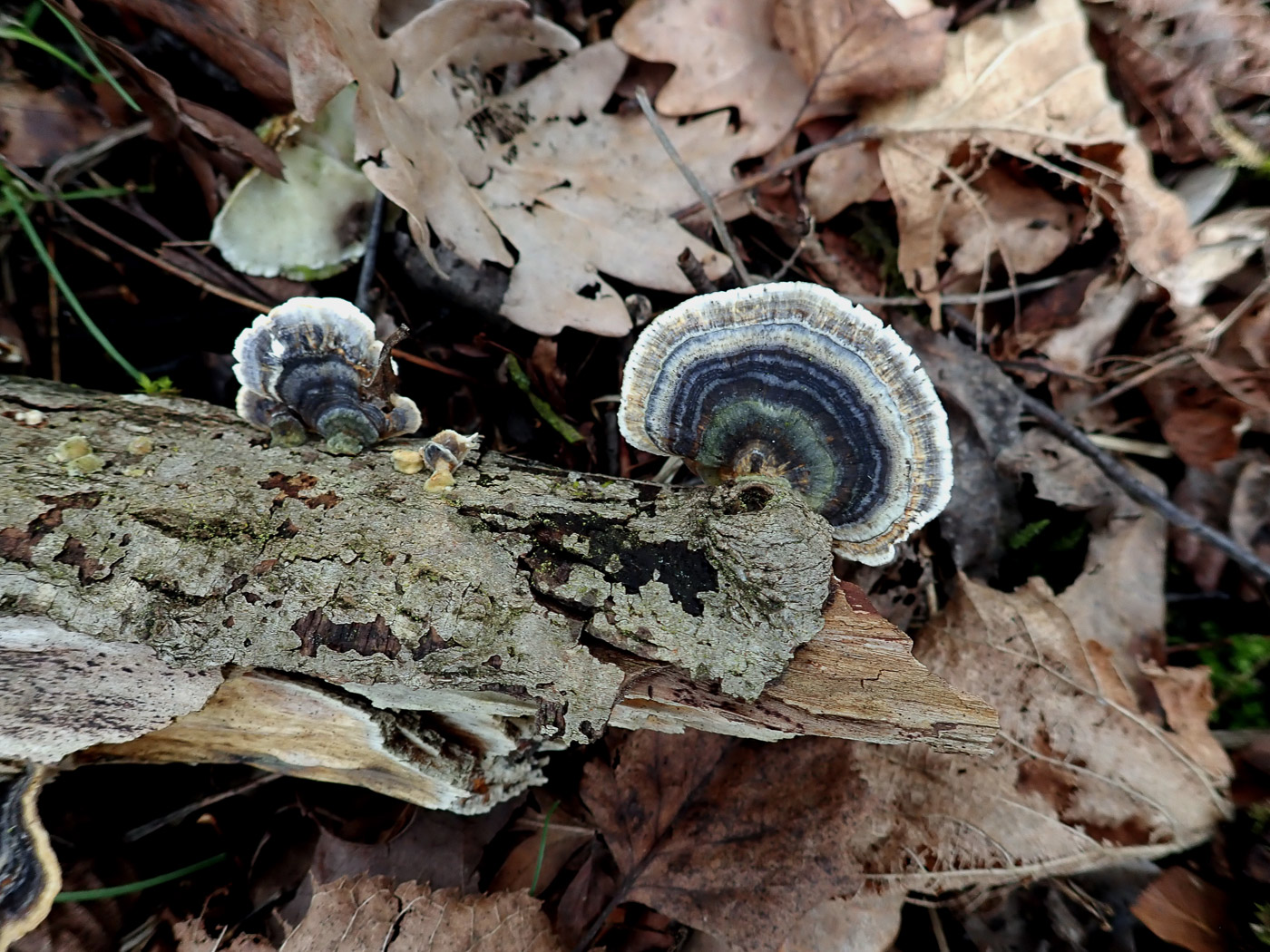
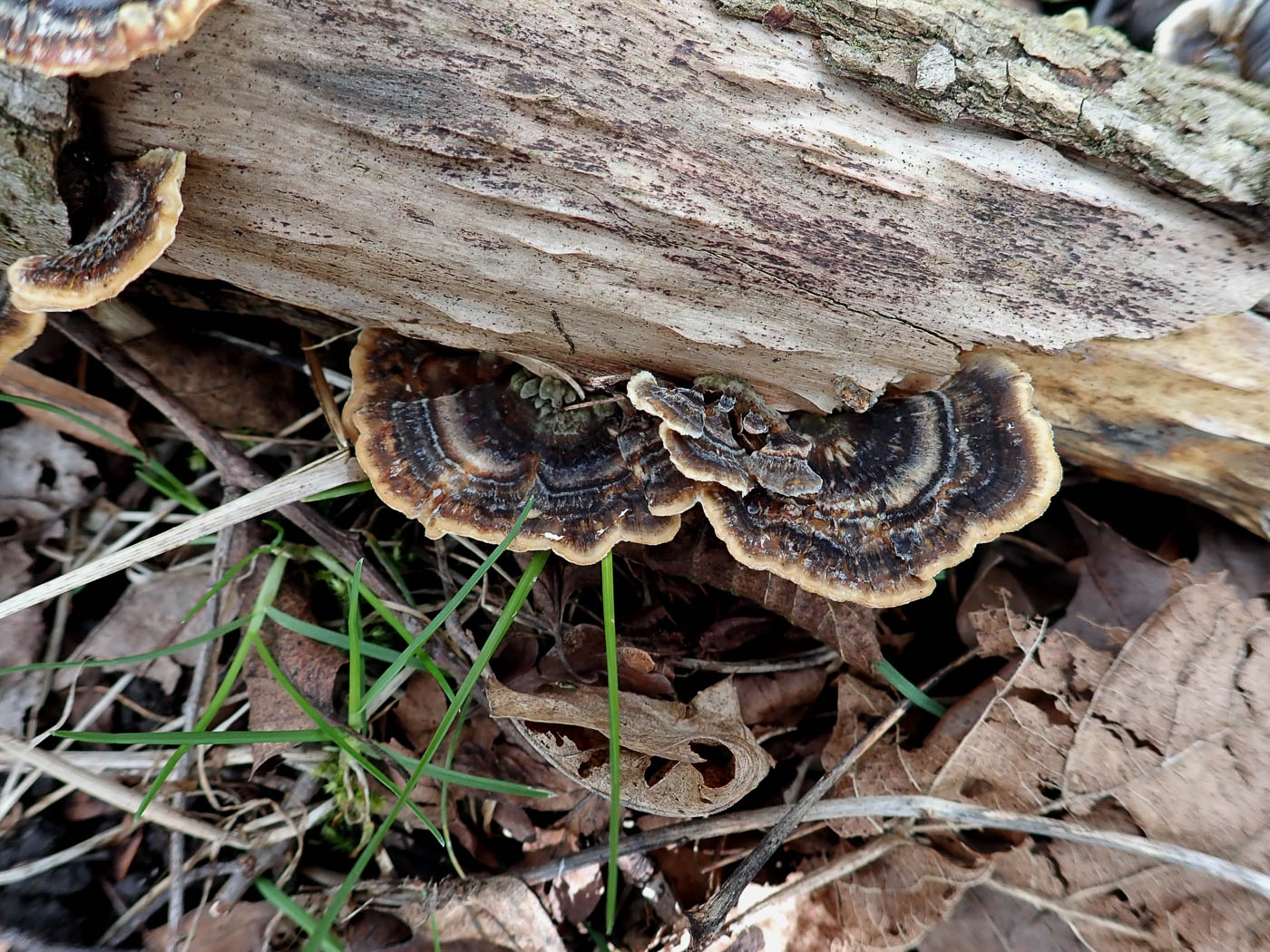
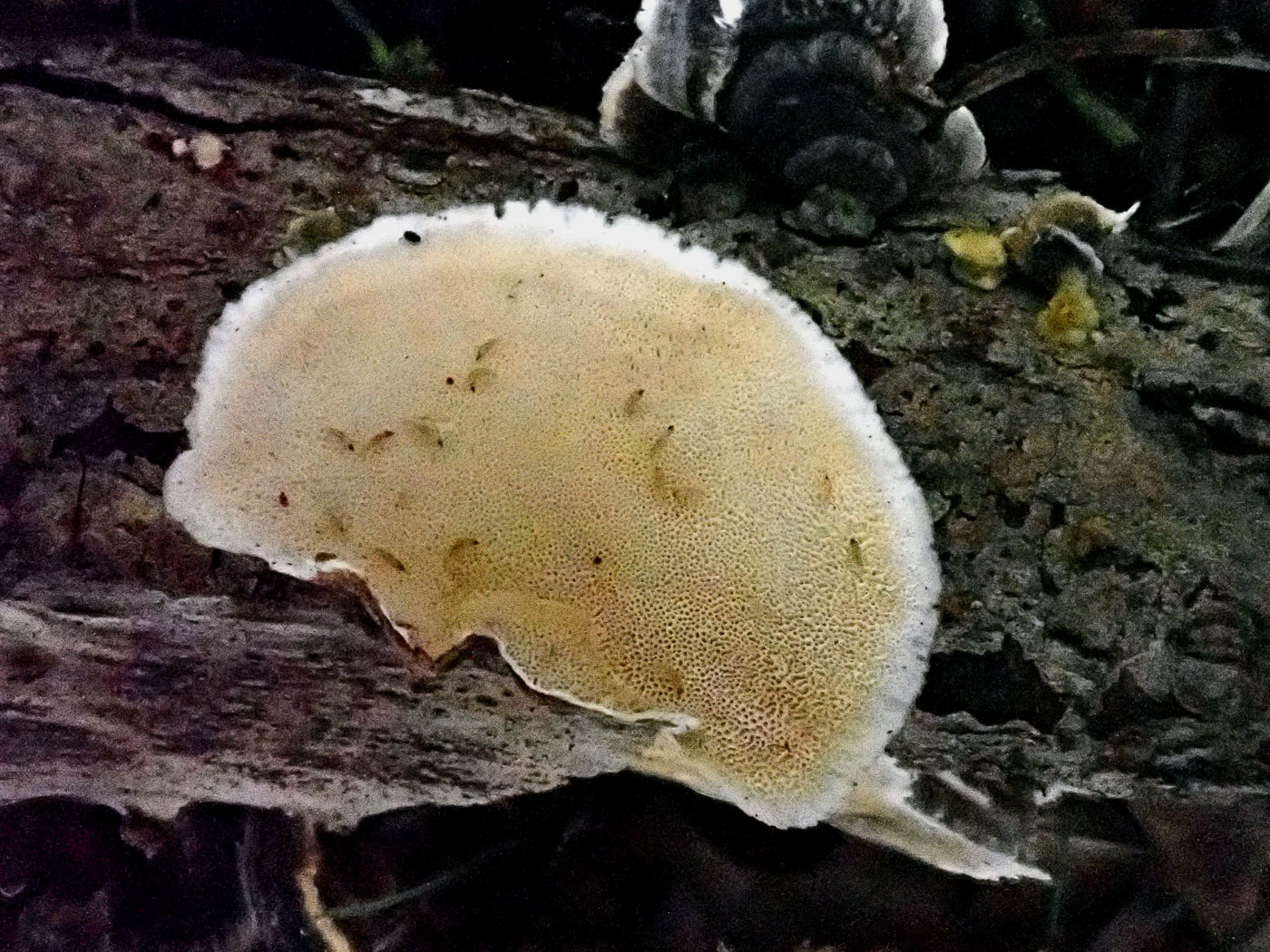 |
March 25th Trametes versicolor (Turkeytail)
At Stoke Common Penny found a fresh example of this common bracket showing some of the many varied colours it can display. Photos 1 and 2 were part of the same colony on fallen deciduous wood only a few inches apart though sporting different shades of grey / brown. Photo 3 shows the pale cream clearly pored undersurface which separates the species from other equally similar thin-fleshed brackets. See the Masterlist for a further range.
|
March 19th 2023
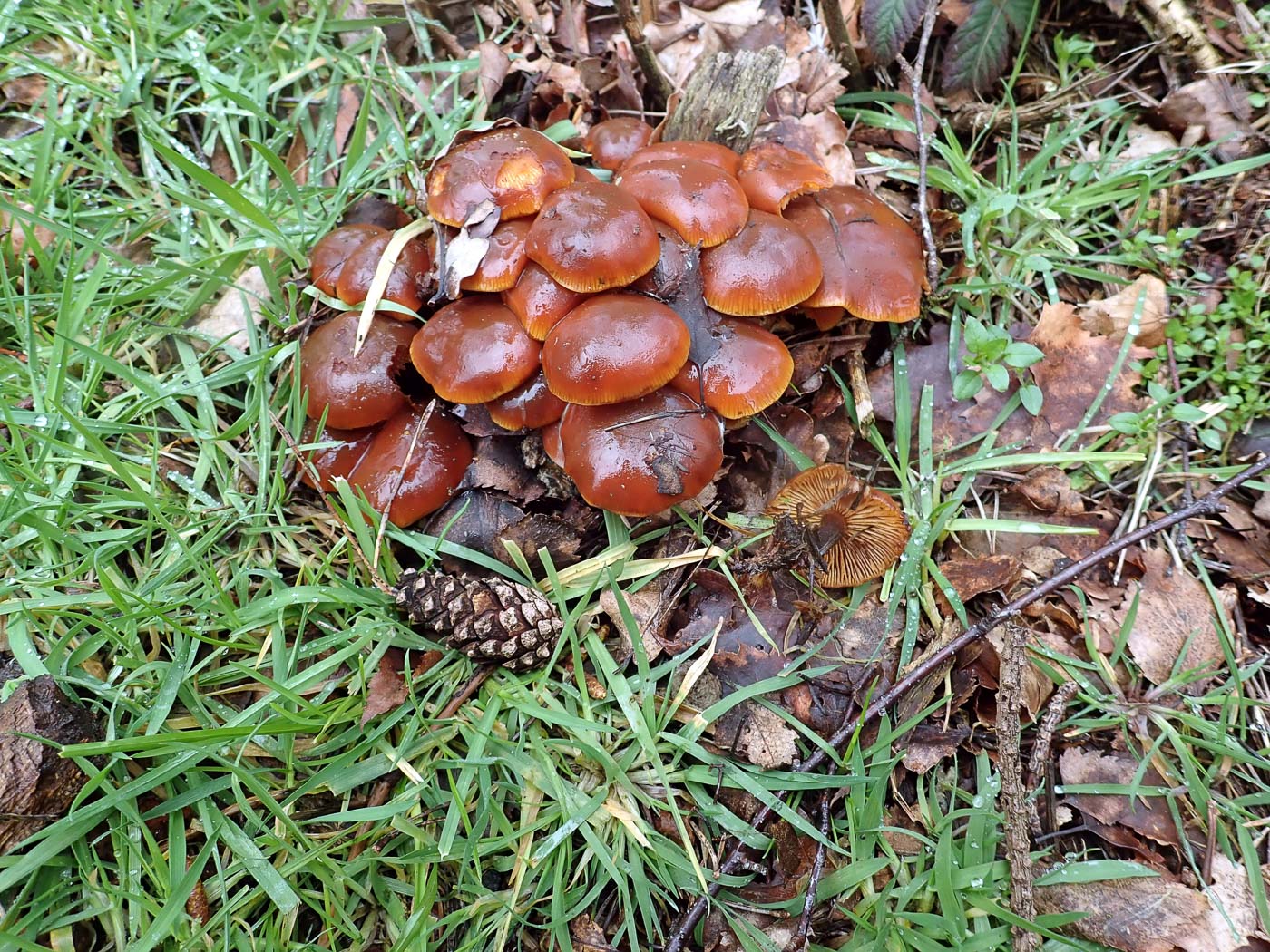
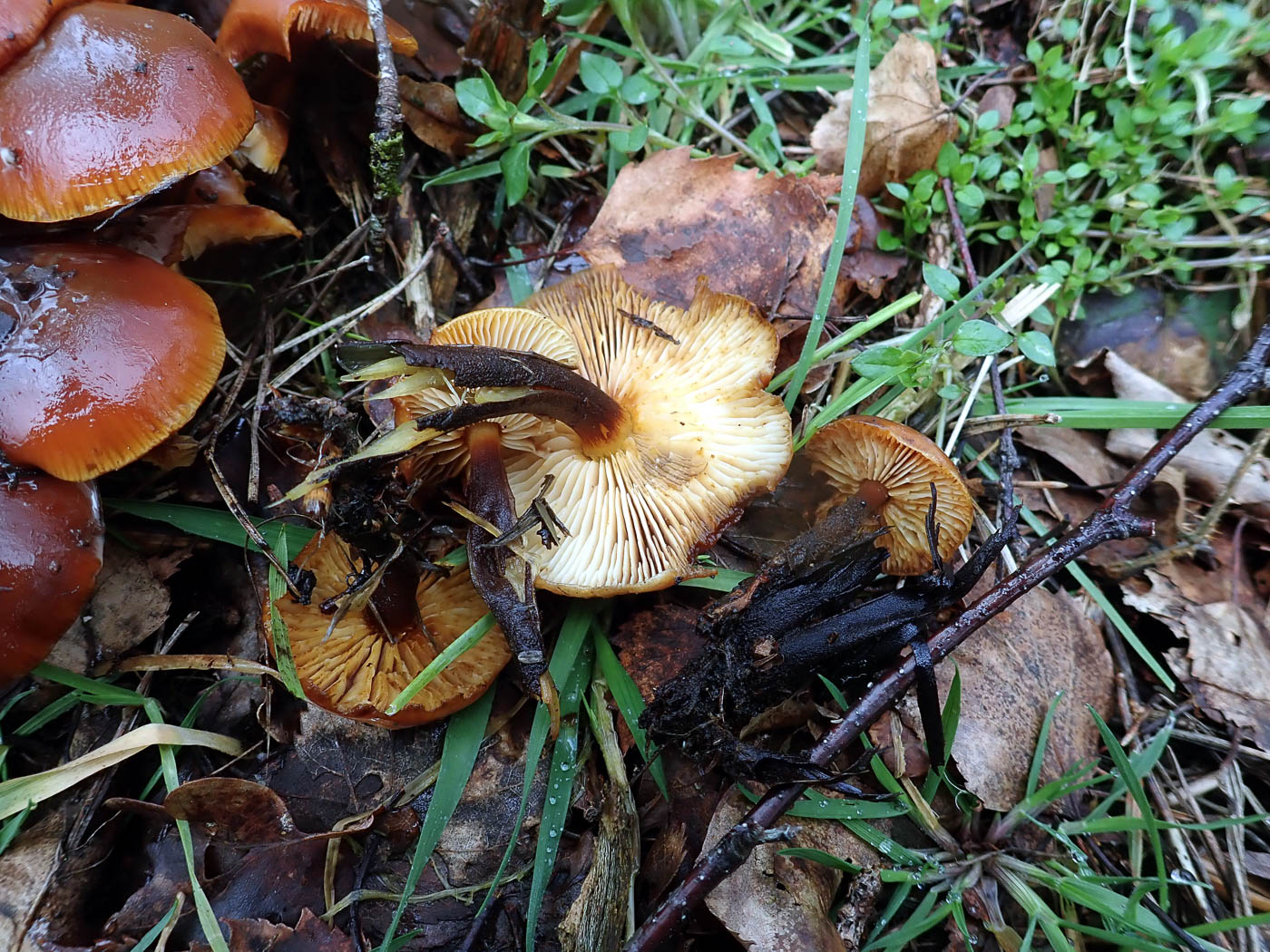 |
March 19th Flammulina velutipes (Velvet Shank)
At Turville Heath Penny was suitably surprised to find that the mild damp recent spell had stirred quite a few species into action, the first being this sizeable clump which she nearly missed - peering around for much smaller fry amongst the woody litter under a large Pine. This is a Winter fruiter, often on wood but here was around the trunk base looking not unlike a tight clump of Gymnopus fusipes (Spindle Toughshank)! It is commonly found on a wide range of deciduous trees and shrubs, also on Gorse, but it seems is very rarely recorded with conifer as here. See the Masterlist for a range of examples.
|
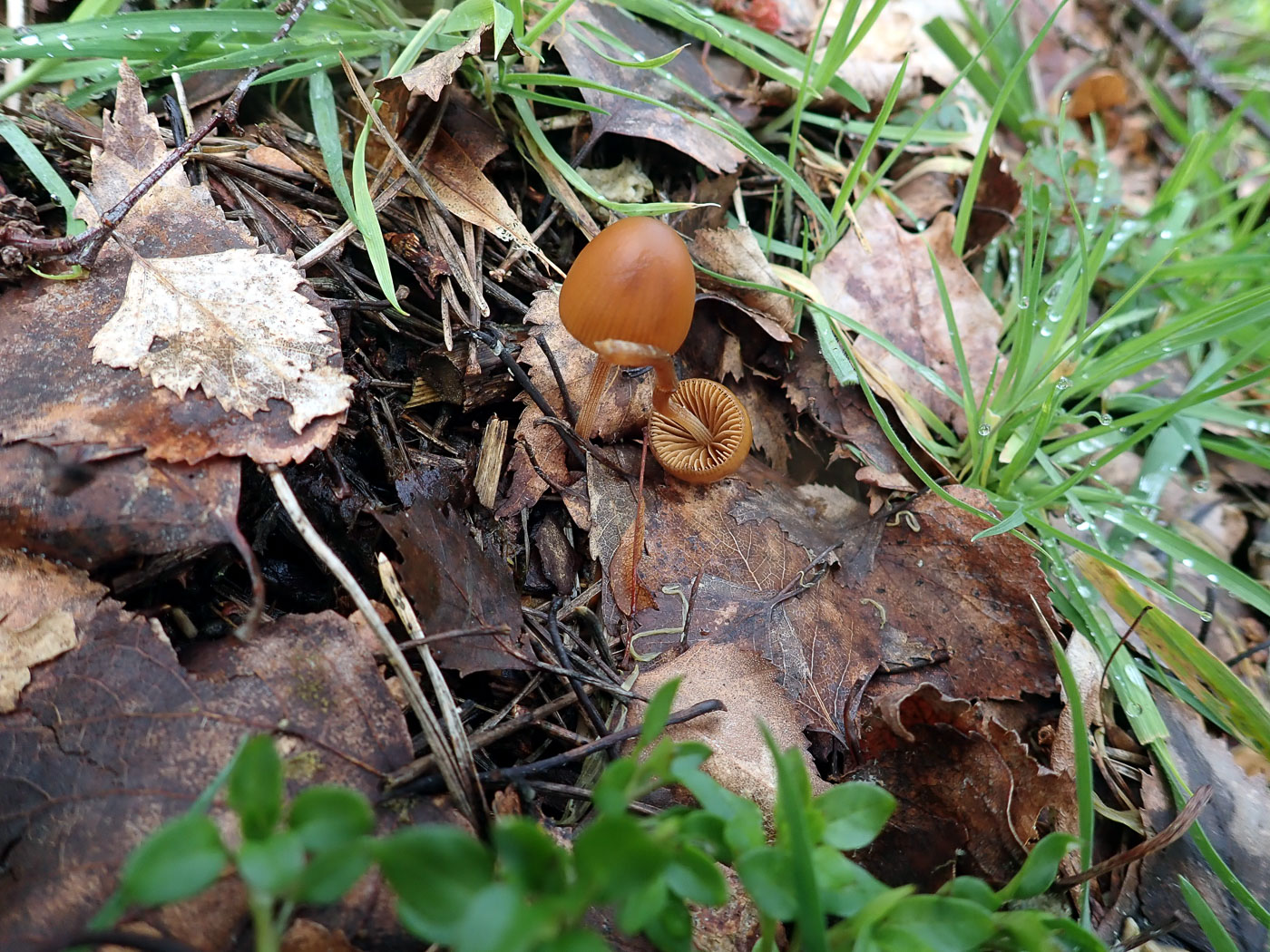 |
March 19th Conocybe semiglobata (a Conecap with no common name) 
In woody debris under a large Pine at Turville Heath Penny found this small pair of LBJs and took them home to work on (this is not a genus one can identify in the field and often defies species identification even at home with a scope!). It keyed out to quite an unusual species (found from Spring to Autumn) and one for which we have just a single previous county record from 2009, hence the material is being dried and will be sequenced.
|
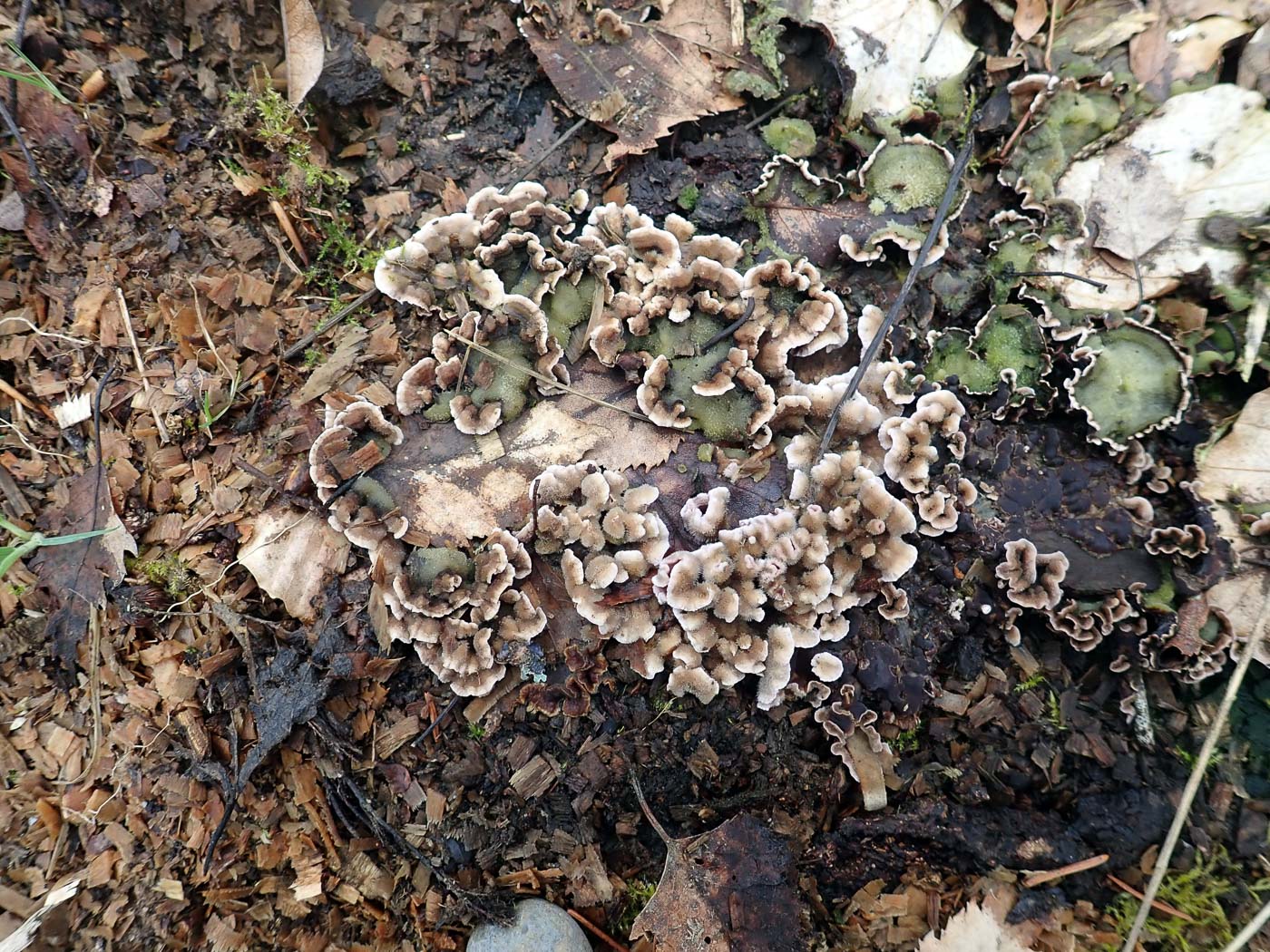
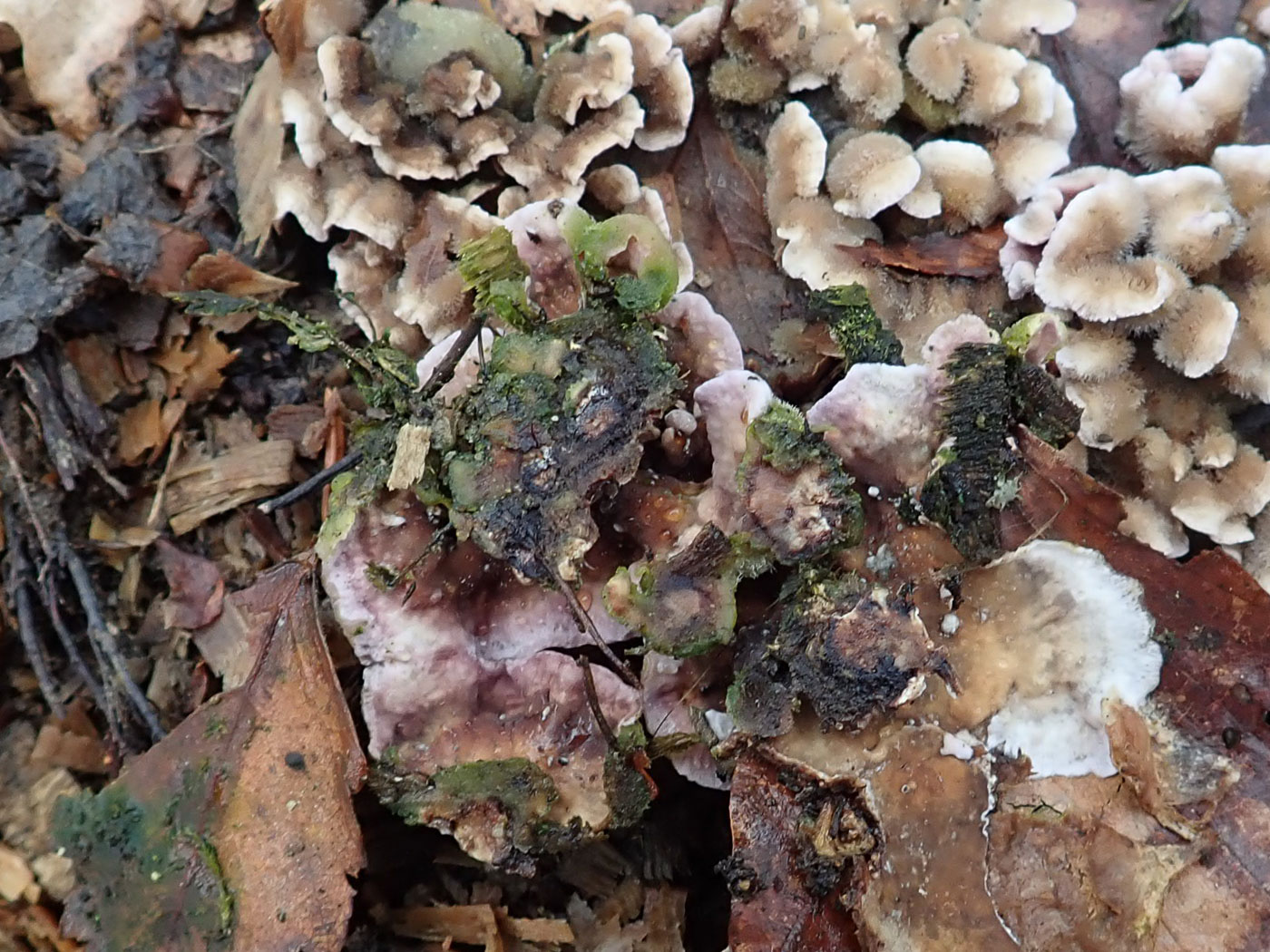 |
March 19th Chondrostereum purpureum (Silverleaf Fungus)
On a deciduous stump at Turville Heath Penny found a fresh patch of this bracket fungus just developing though it was not until turning a sample over (photo 2) that the telltale violet/mauve colour made it obviously this species rather than maybe a species of Stereum or Trametes. (The green parts visible in the photo were some sort of algi.) See also in Finds 2022 September 13th and 2020 November 6th and 7th.
|
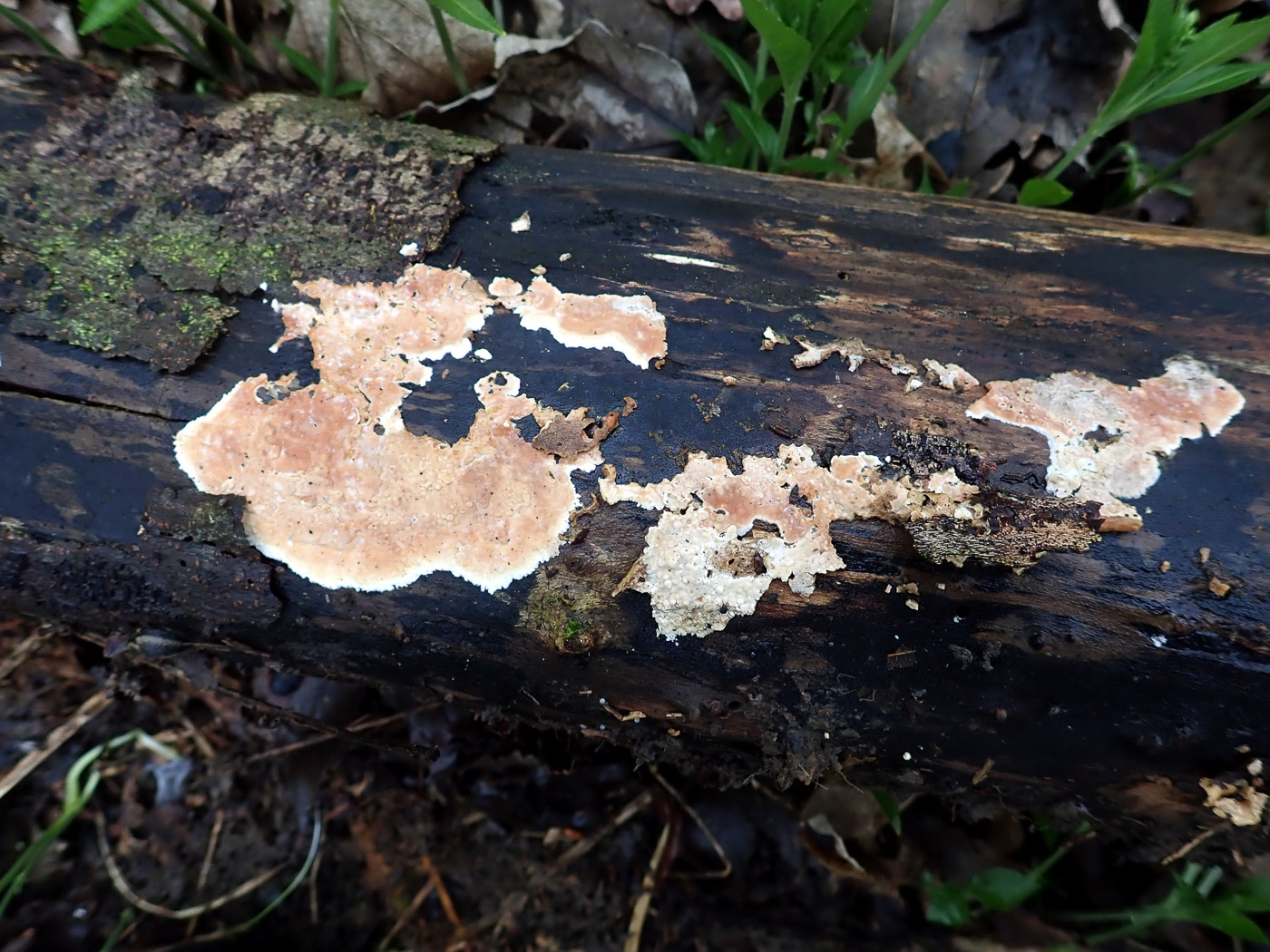
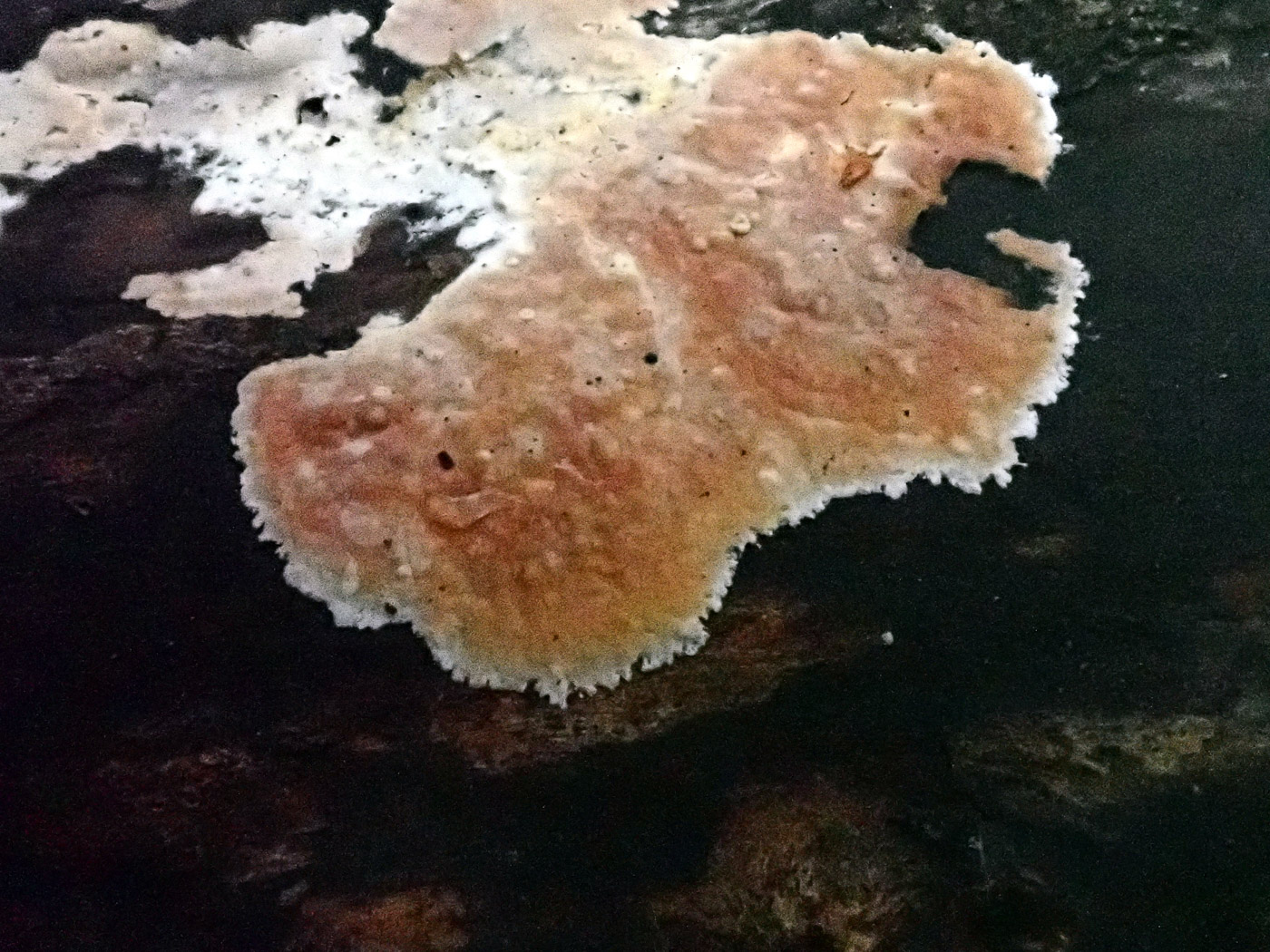 |
March 19th Byssomerulius corium (Netted Crust)
On fallen deciduous wood at Turville Heath Penny noticed several patches of this corticioid - one which can be recognised by its pinkish buff colour with white fringe. However, do not confuse in the field with Steccherinum ochraceum and fimbreatum which can looks quite similar at first glance but - viewed with a handlens - the Steccherinum upper surface is covered in fine 'teeth' rather than being smooth to wrinkled / rubbery as here. See the Masterlist for examples of all these species.
|
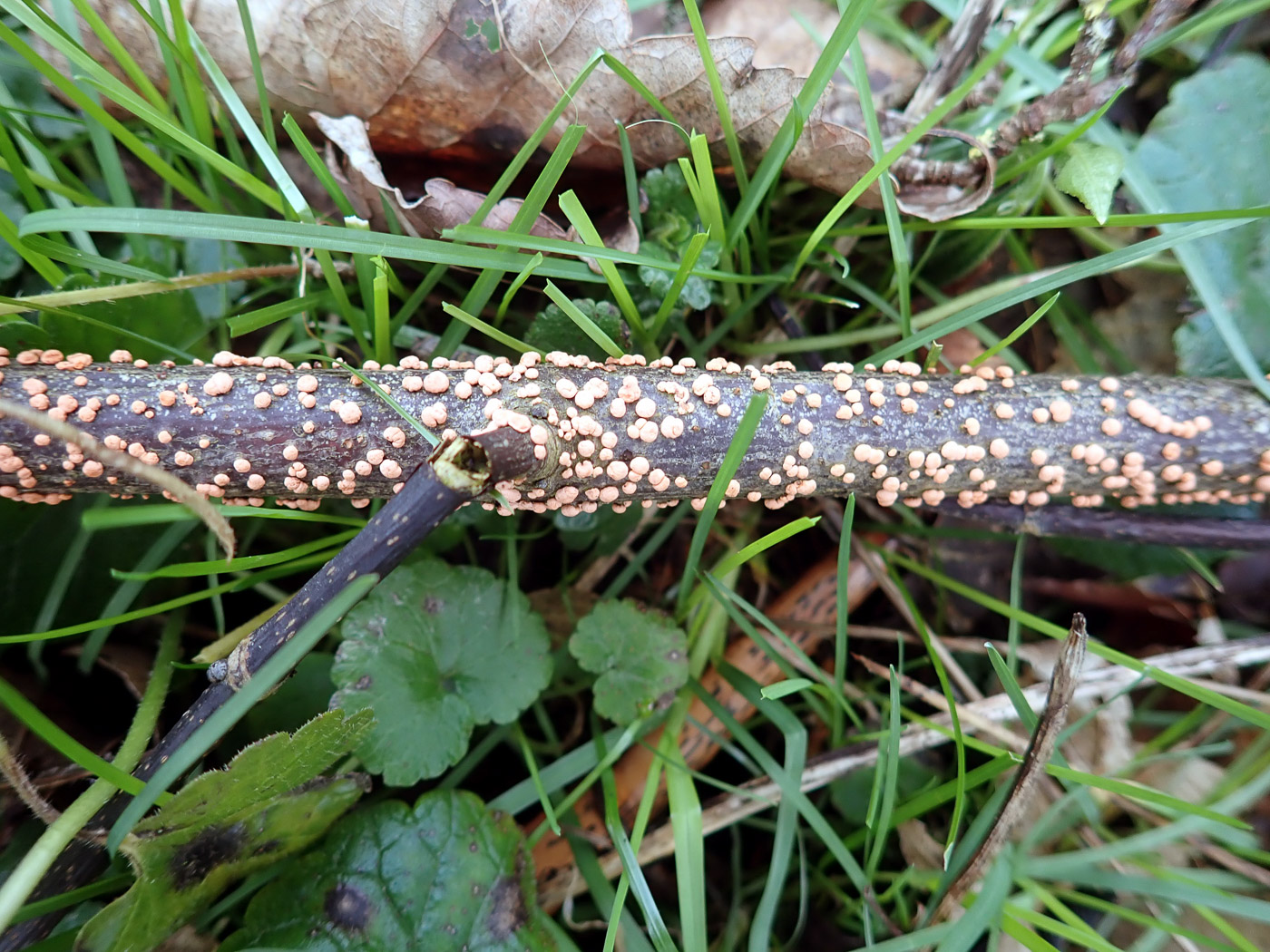
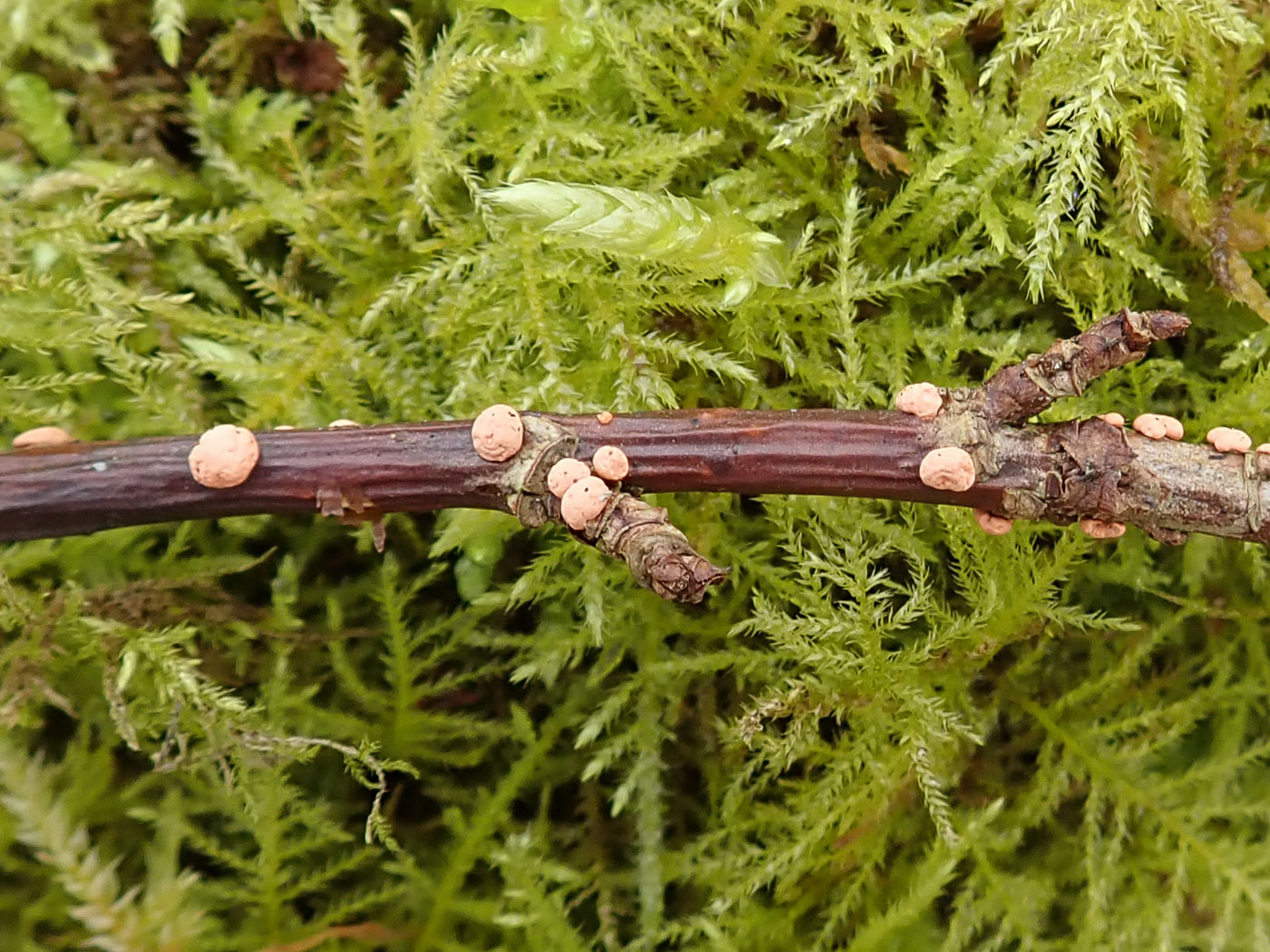 |
March 19th Nectria cinnabarina (Coral Spot)
In Turville Heath Penny found several patches of this common Ascomycete on piles of deciduous twigs, presumably stirred into action by the warmer damp conditions recently. We have two previous entries: 2022 September 7th, also 2020 October 8th, so this seems to be the first found in Springtime.
|
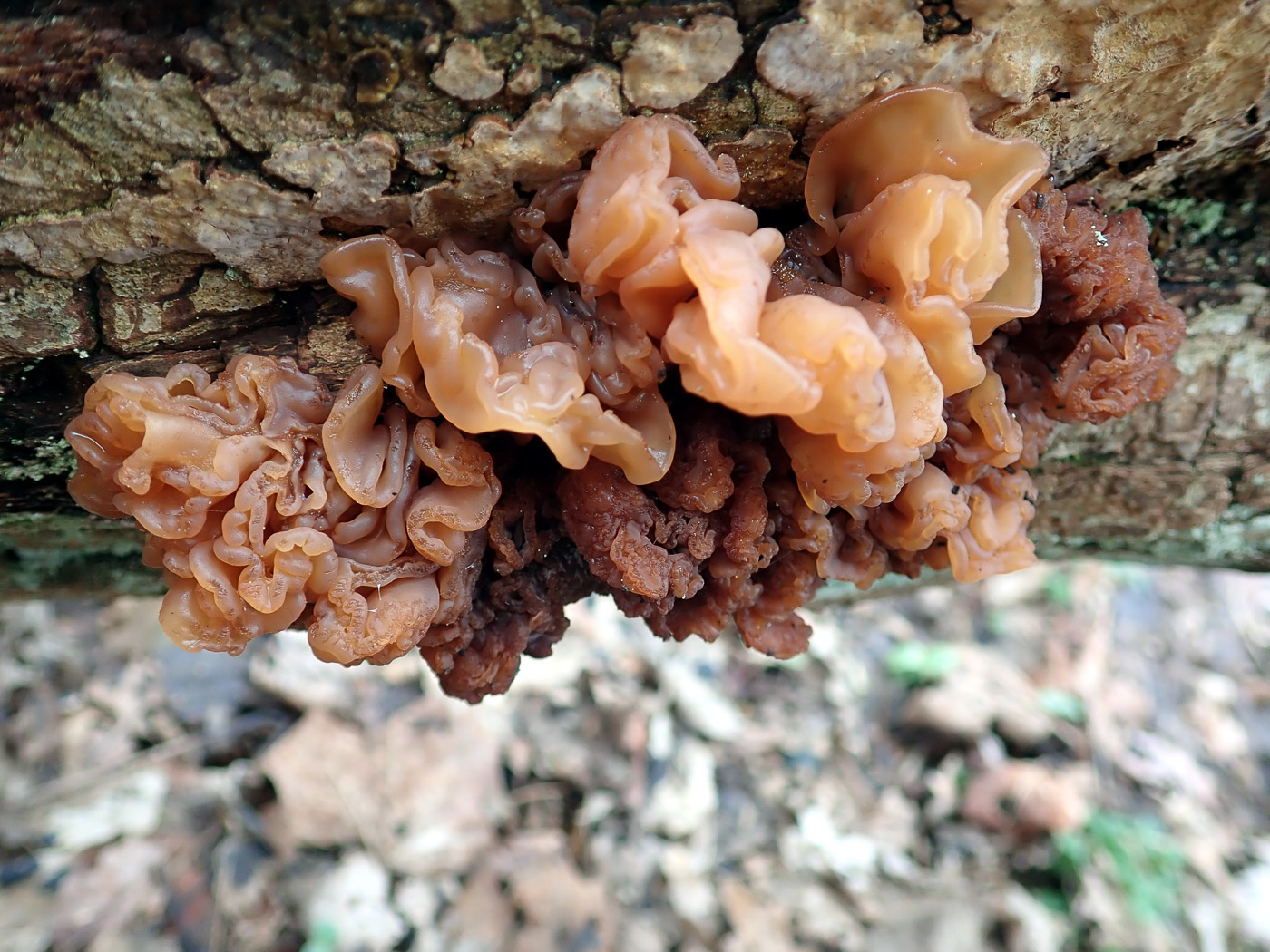
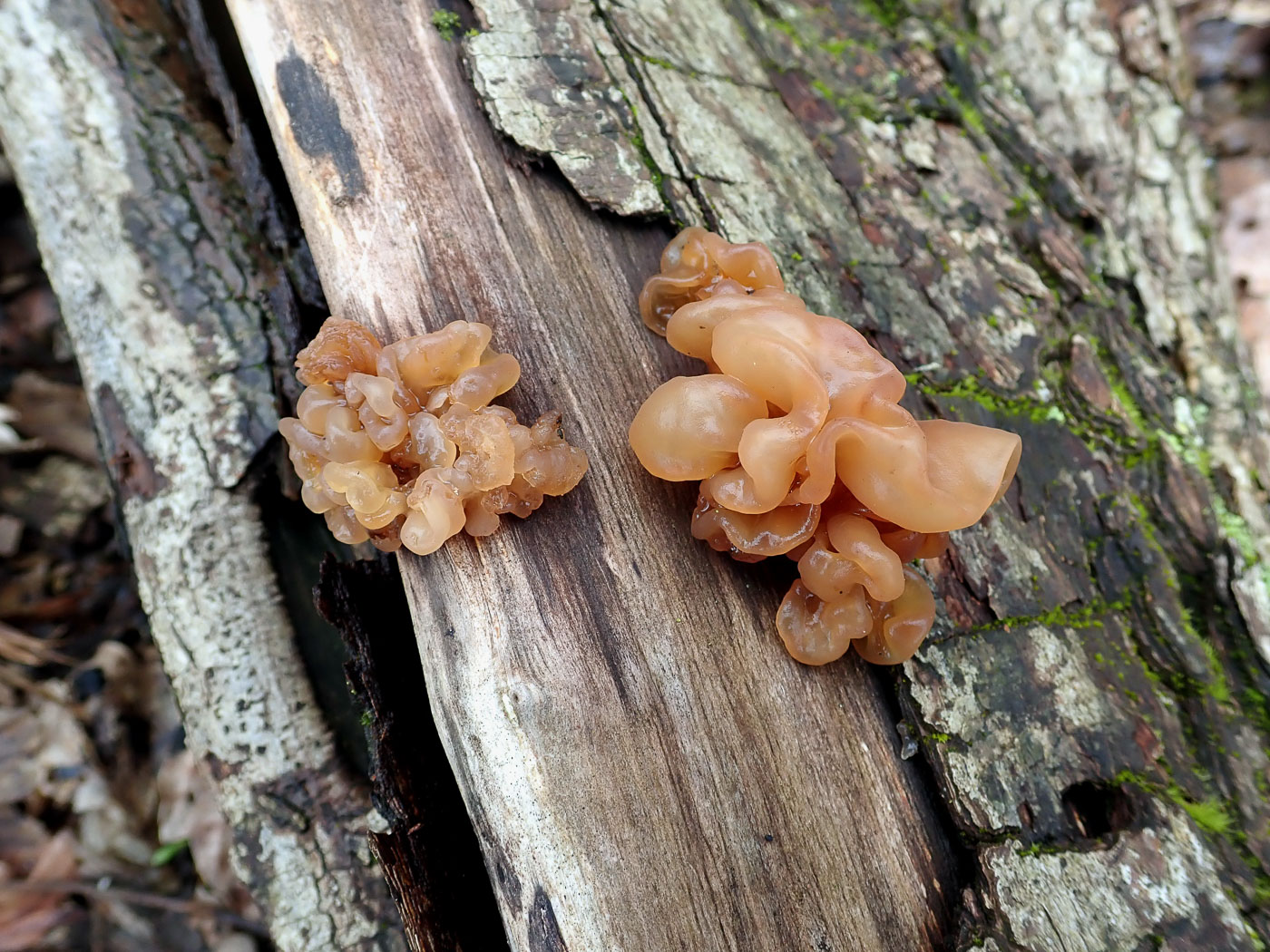
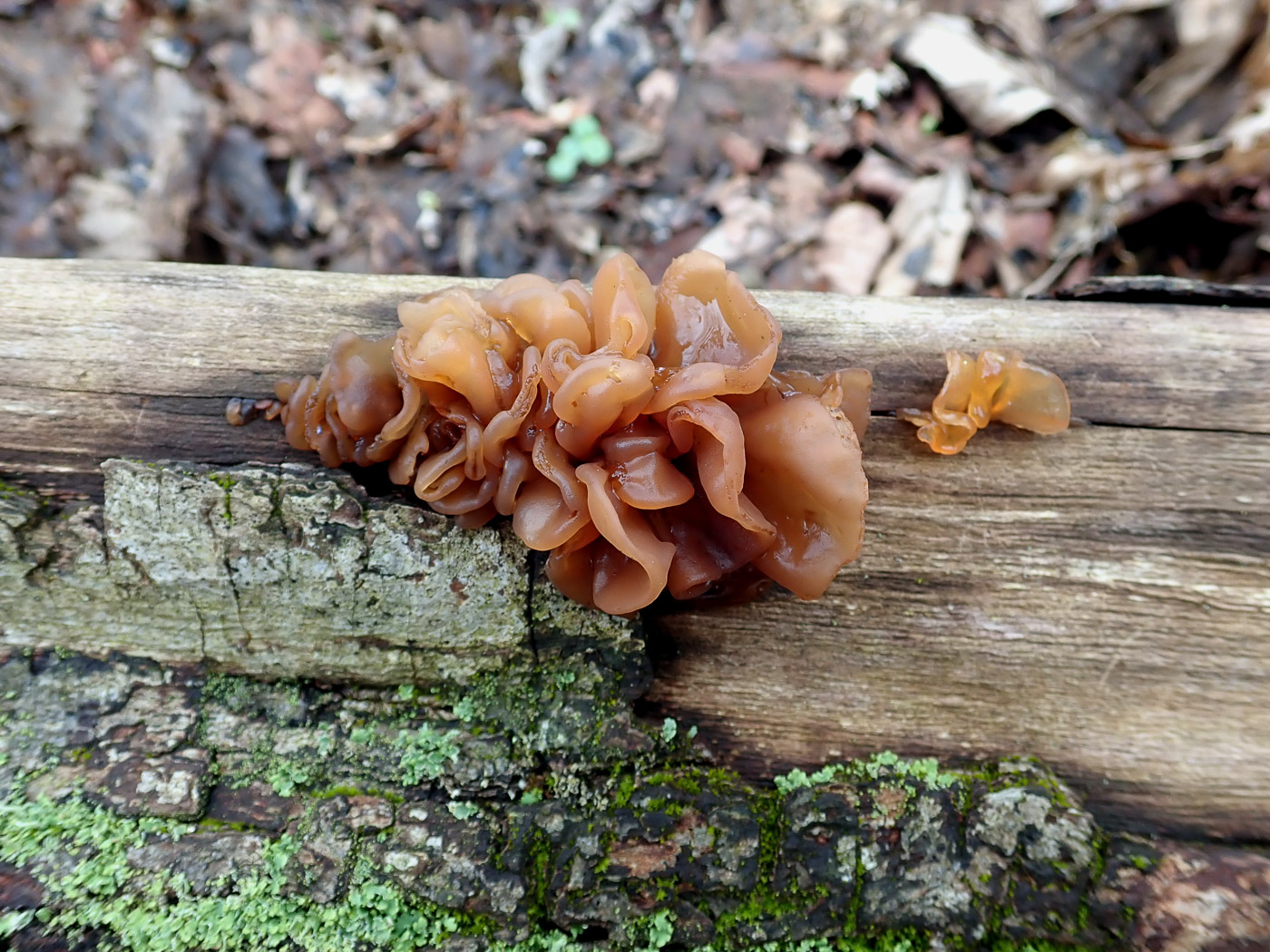 |
March 19th Tremella foliacea (Leafy Brain) 
In Turville Heath Penny came across a fallen branch, possibly Hawthorn, with several fresh clumps of this jelly fungus - similar to Exidia in texture but forming a wider gelatinous mass than that genus (the spores are a very different shape also). See Finds 2022 January 13th, also 2020 October 11th for further examples.
|
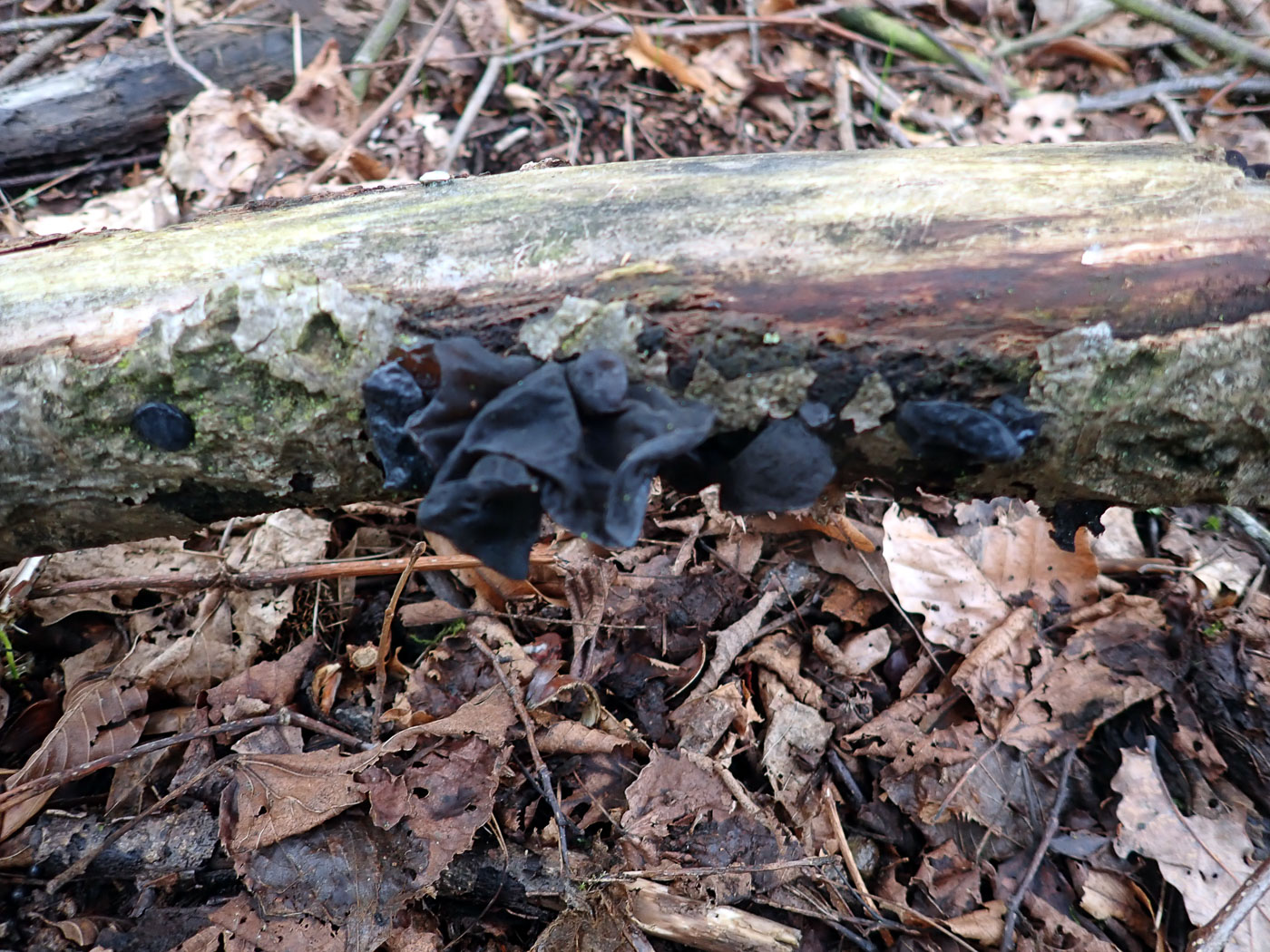
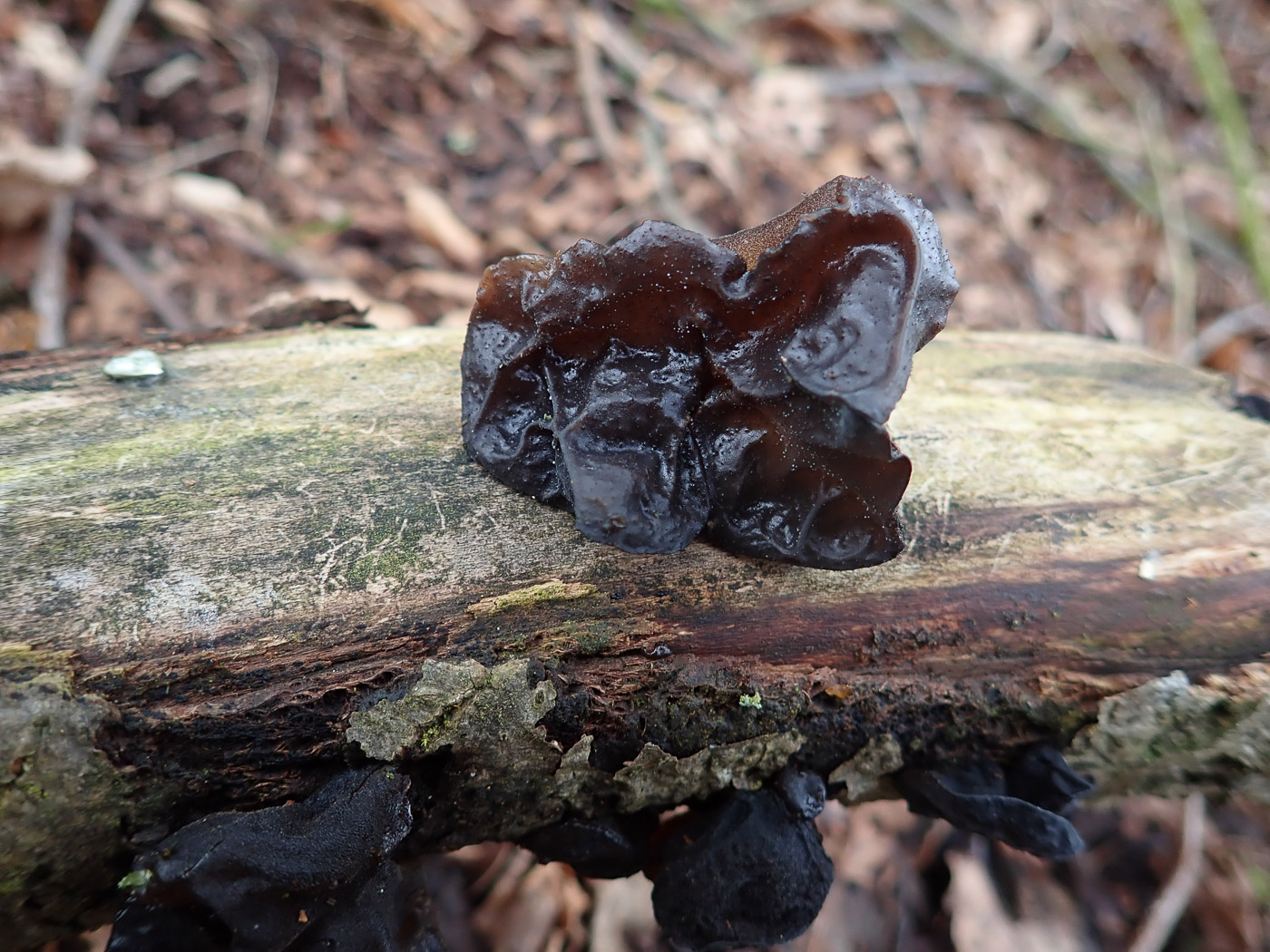 |
March 19th Exidia glandulosa (Witches' Butter) 
In Turville Heath Penny found several examples of this jelly fungus on fallen Lime, noted the cushionlike shape and bumpy undersurface, then later checked a few spores to confirm. Compare with E. nigricans, entered two days ago, also with other Finds entries via the Masterlist.
|
March 18th 2023

 |
March 18th Junghuhnia nitida (a Corticioid with no common name) 
In Burnham Beeches Russell Ness found this fresh example on fallen deciduous wood. This is a further species which at first glance is quite similar to Byssomerulius corium and Steccherinum ochraceum (compare with the former on March 19th above) in that it is flat, buff pinky orange and with a white fringe. The surface texture, however, is very different and distinctly poroid rather than smooth to wrinkled (as in B. corium) or finely toothed (as in S. ochraceum) - a hand lens is best here. All three occur on fallen deciduous woods though today's is probably the least often recorded. We have three previous examples in Finds - see the Masterlist.
|
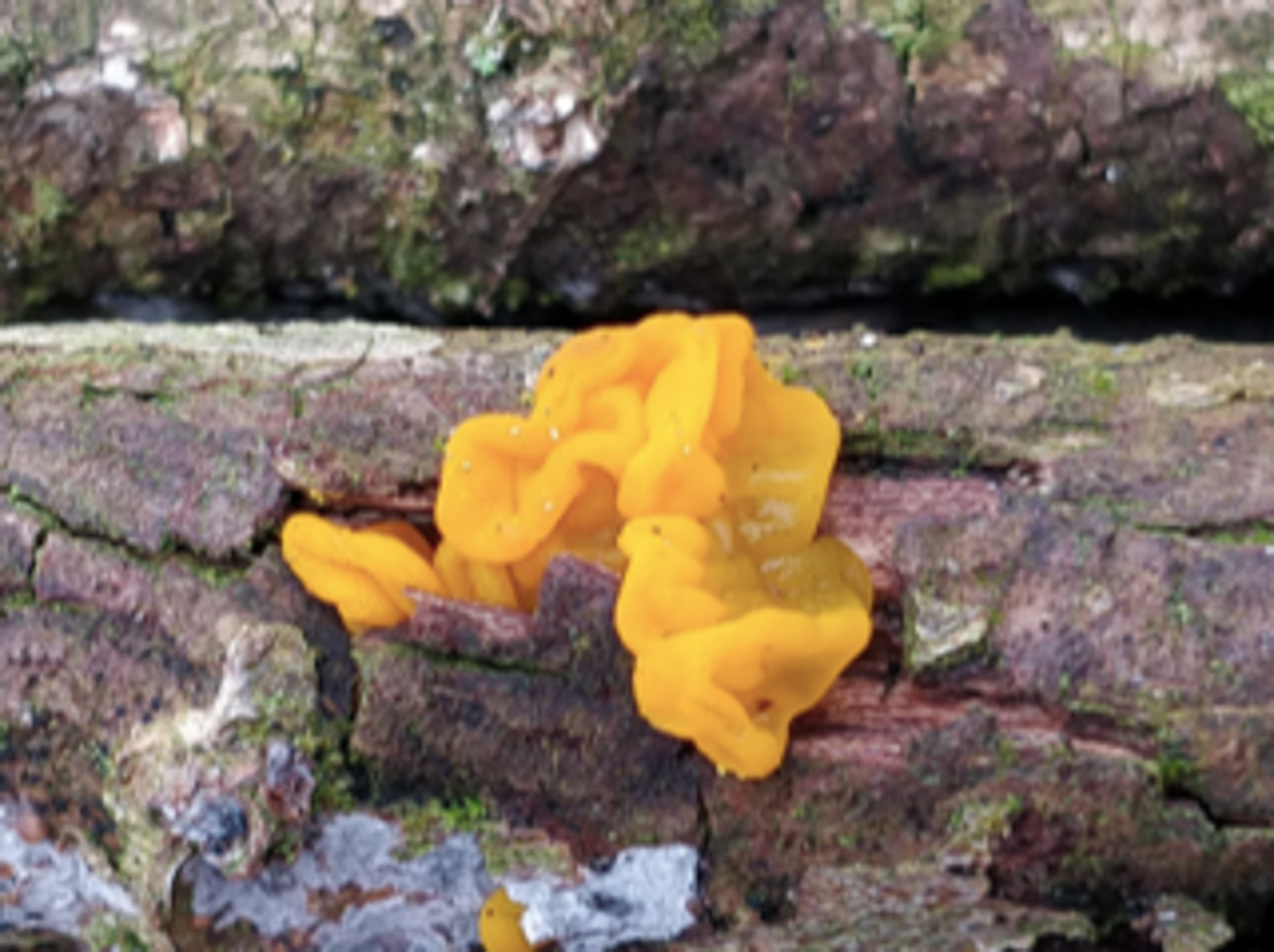
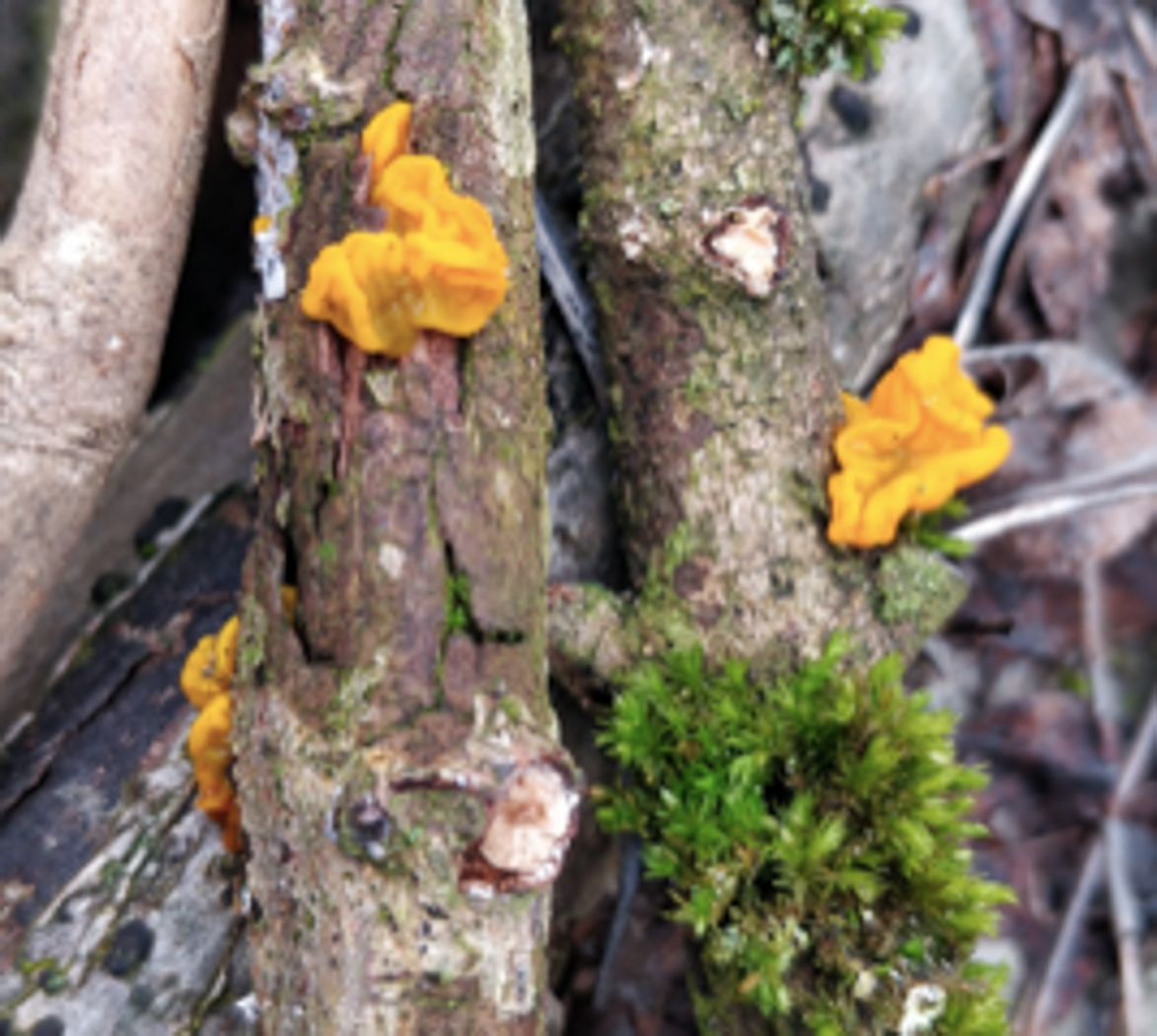 |
March 18th Tremella mesenterica (Yellow Brain)
We've had a spate of jelly fungi photos in the last week or so. Here's another one, found by Bob Simpson in Salden Wood fruiting on fallen Hazel twigs. Compare with T. foliacea and with species of Exidia - all found recently and with further images available via the Masterlist.
|
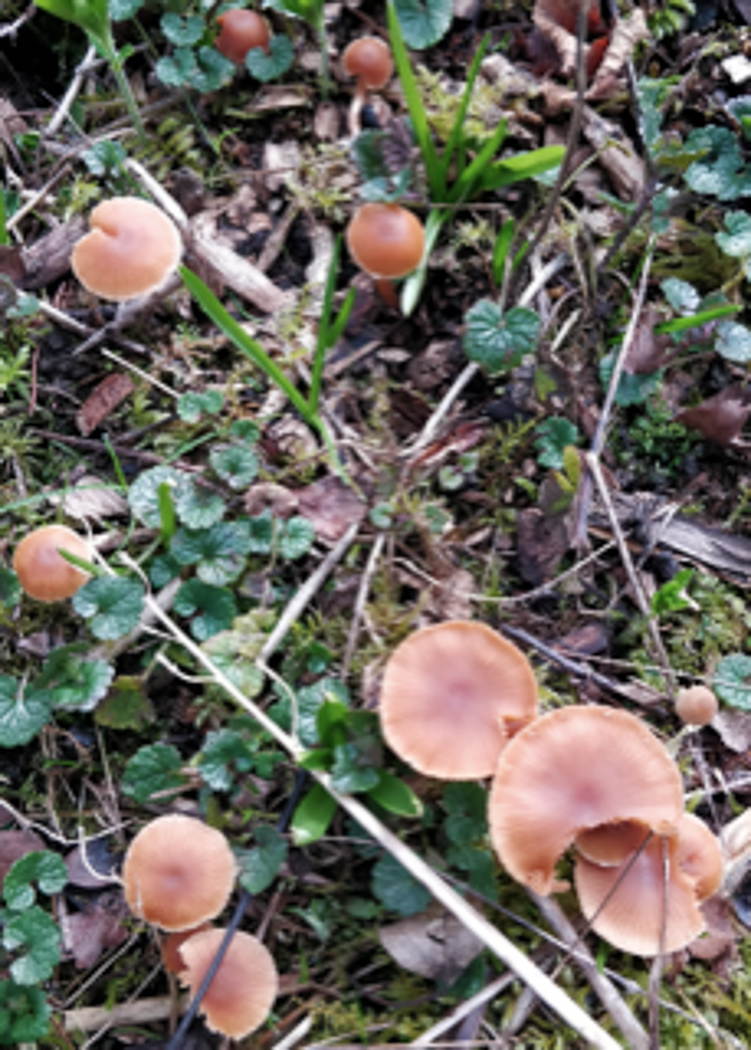
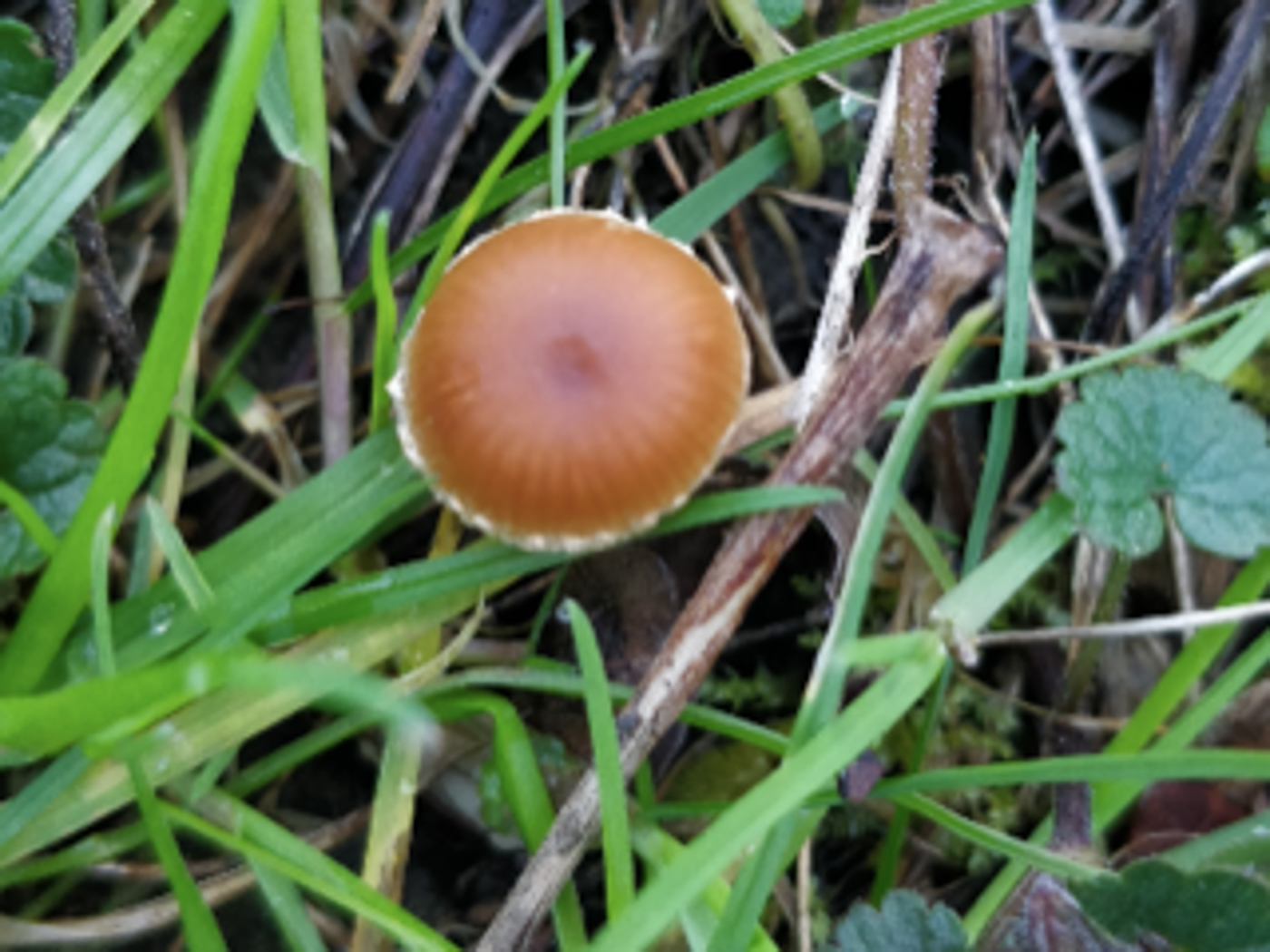
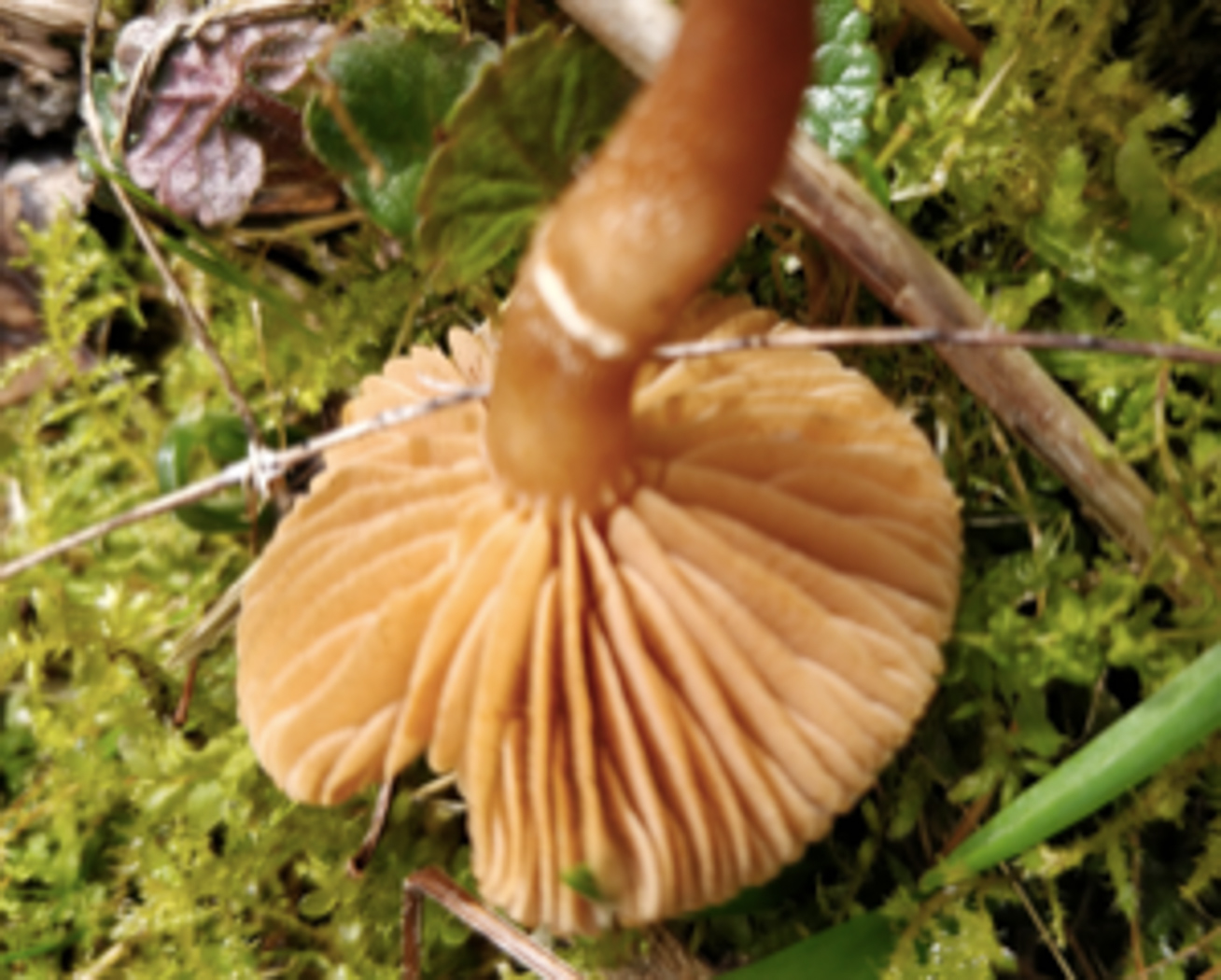 |
March 18th Tubaria furfuracea (Scurfy twiglet)
In Salden Wood Bob Simpson noticed these LBJs in some woody litter and was unsure as to their identity. Penny has named them purely from these photos so there's no guarantee on the ID but it is a common species which often confuses, looking similar to both Conocybe and Galerina but with much less distinctive micro-characters. It can be found at most times of the year, can sometimes have slightly decurrent gills and sometimes signs of a ring zone as can be seen here. See the Masterlist for our four other examples.
|
March 17th 2023
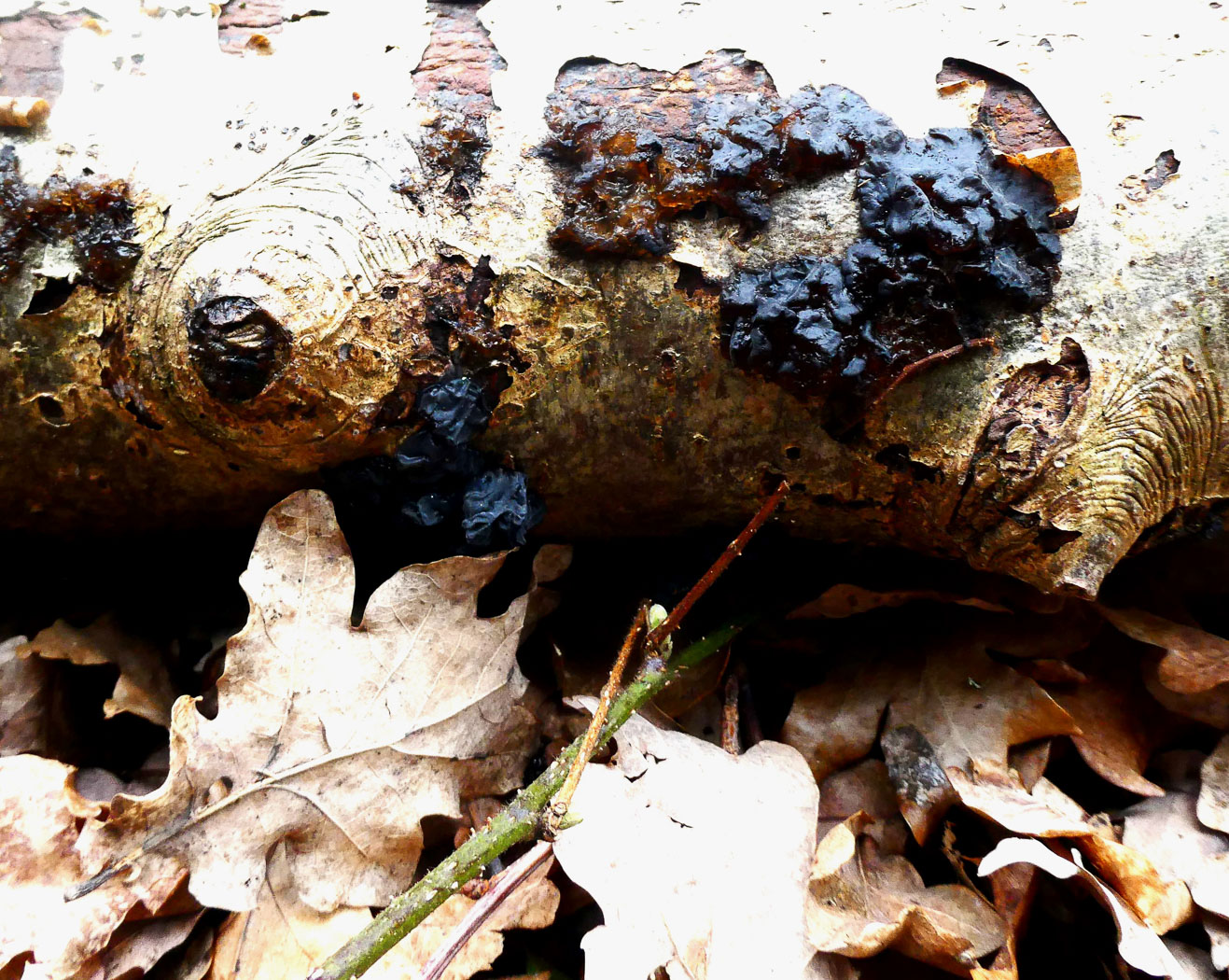
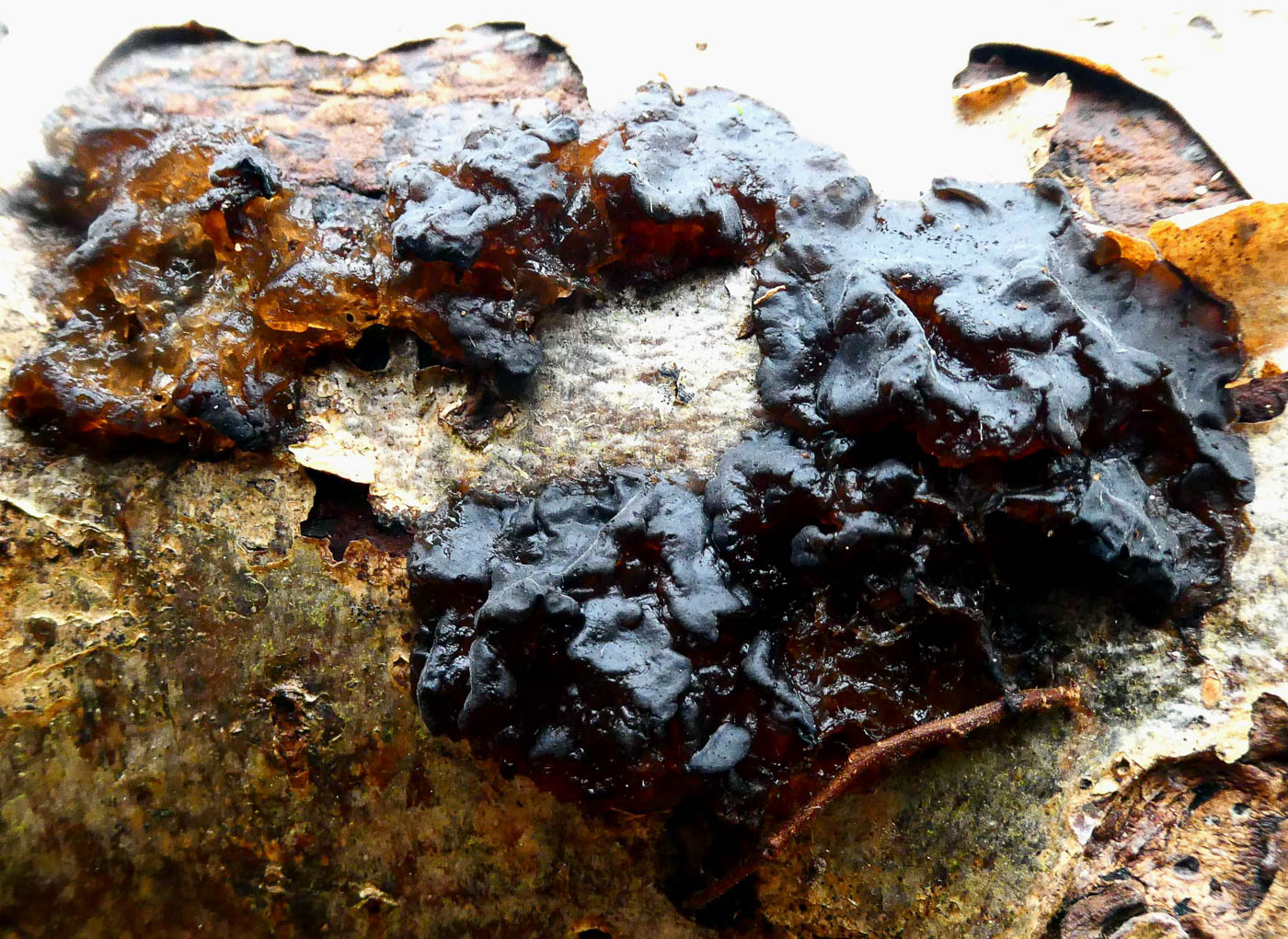
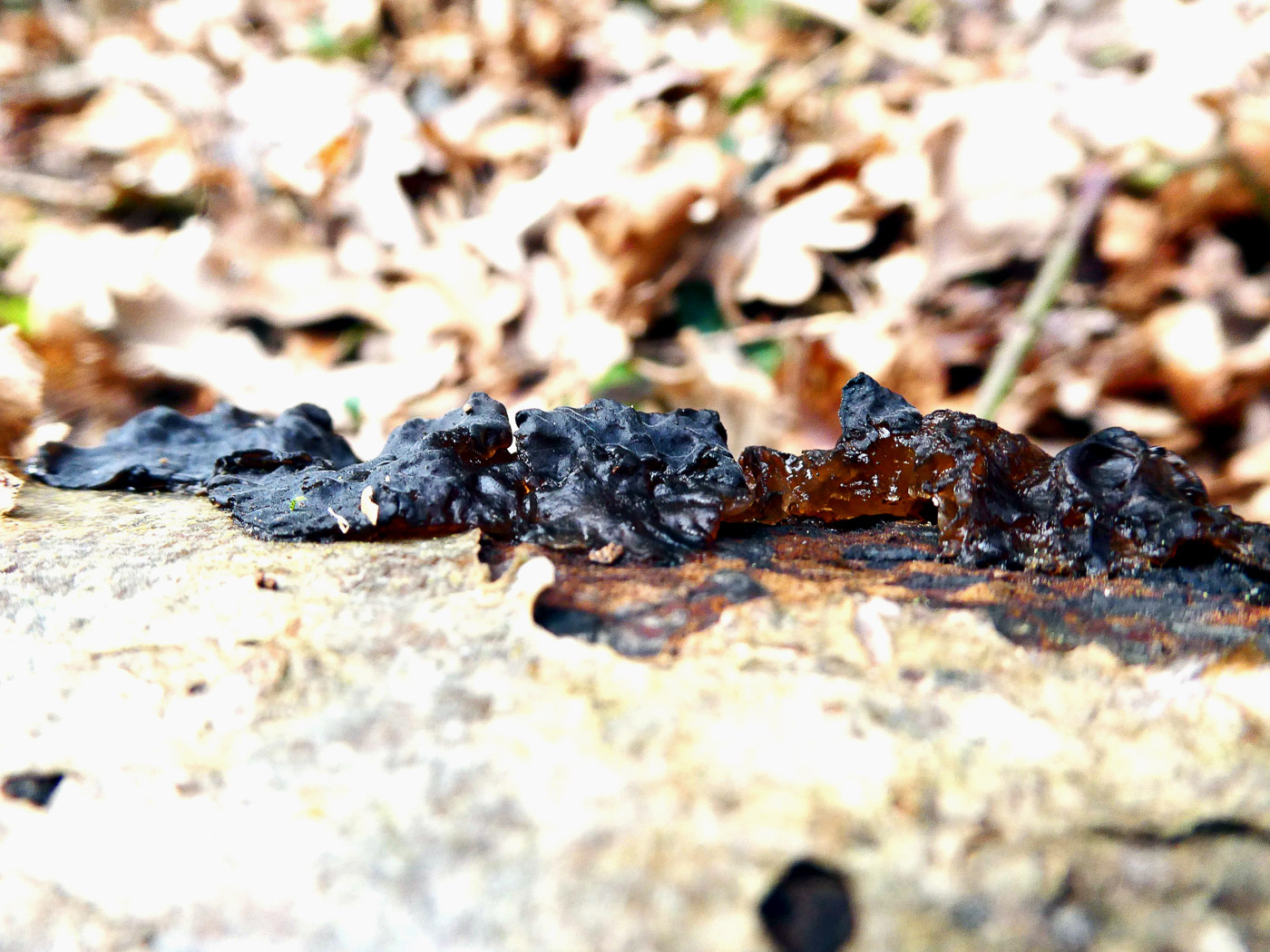
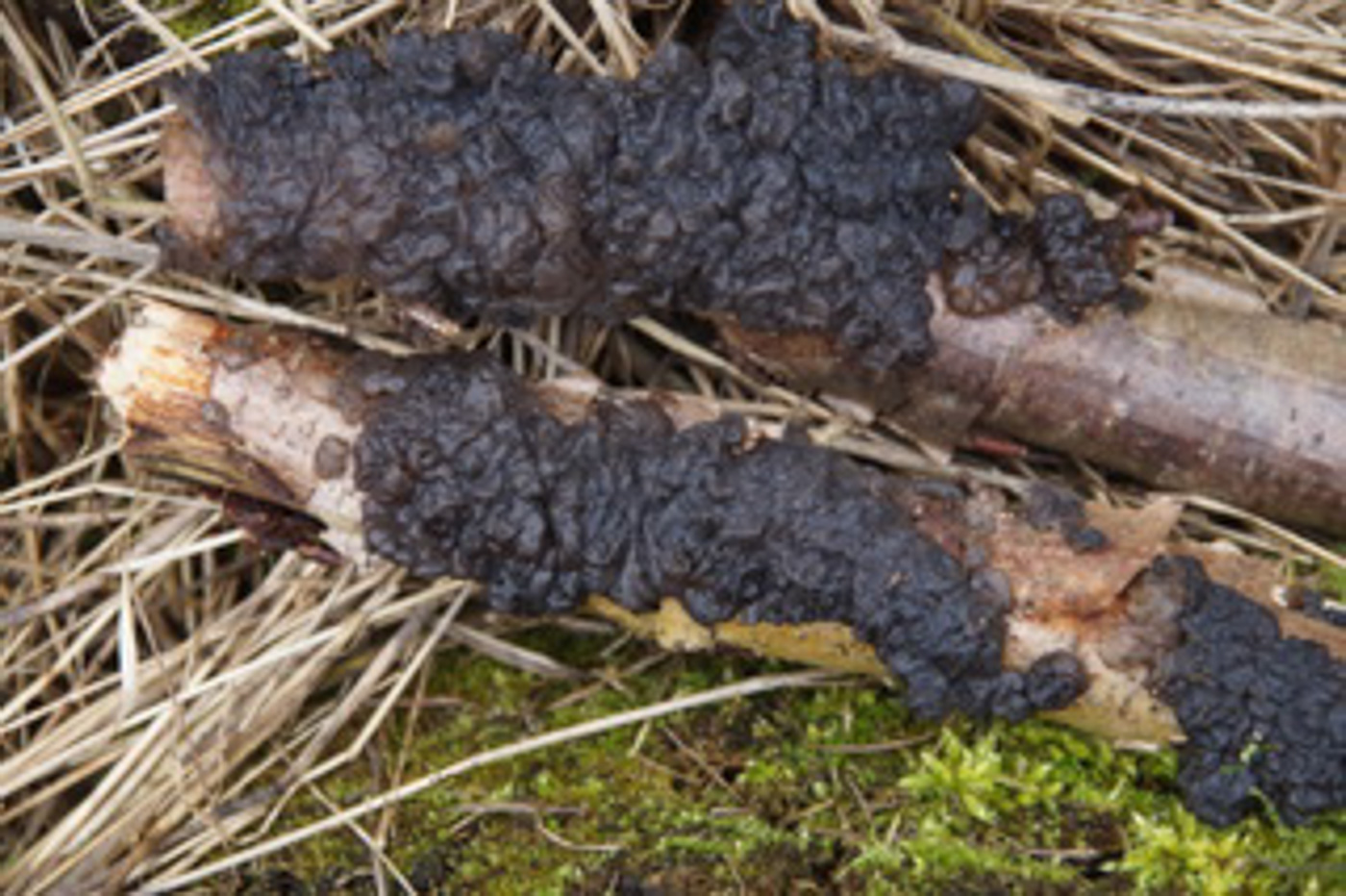 |
March 17th Exidia nigricans (Warlock's Butter)
In Austenwood Common Jim Wills spotted these patches of blackish brainlike jelly fungus on recently felled deciduous wood, then checked the spore size to confirm his ID. Penny's comments on her collection (see Finds 2022 Jan 17th) explain fully the confusing situation around the names of the 'black' Exidia species and how to separate them, but she took a closer look at Jim's photos before including them here because they are clearly not plain black but in places translucent and/or brownish, hence raising some doubts as there are other purely brown species within the genus. However, checking other available images and various texts set her mind at rest: this species is not necessarily entirely black and fuller descriptions include translucence, also brown / grey colours, furthermore the flattish rather shapeless smallish folds are typical whereas other species tend to be more formed and 'turbinate' (cushionlike). If in doubt, checking the spore size is very useful; if on conifer rather than deciduous wood you will have one of the more unusual Exidia species. (The final photo was taken by Bob Simpson in his Salden Wood three days earlier and is in fact more typical.)
|
March 15th 2023

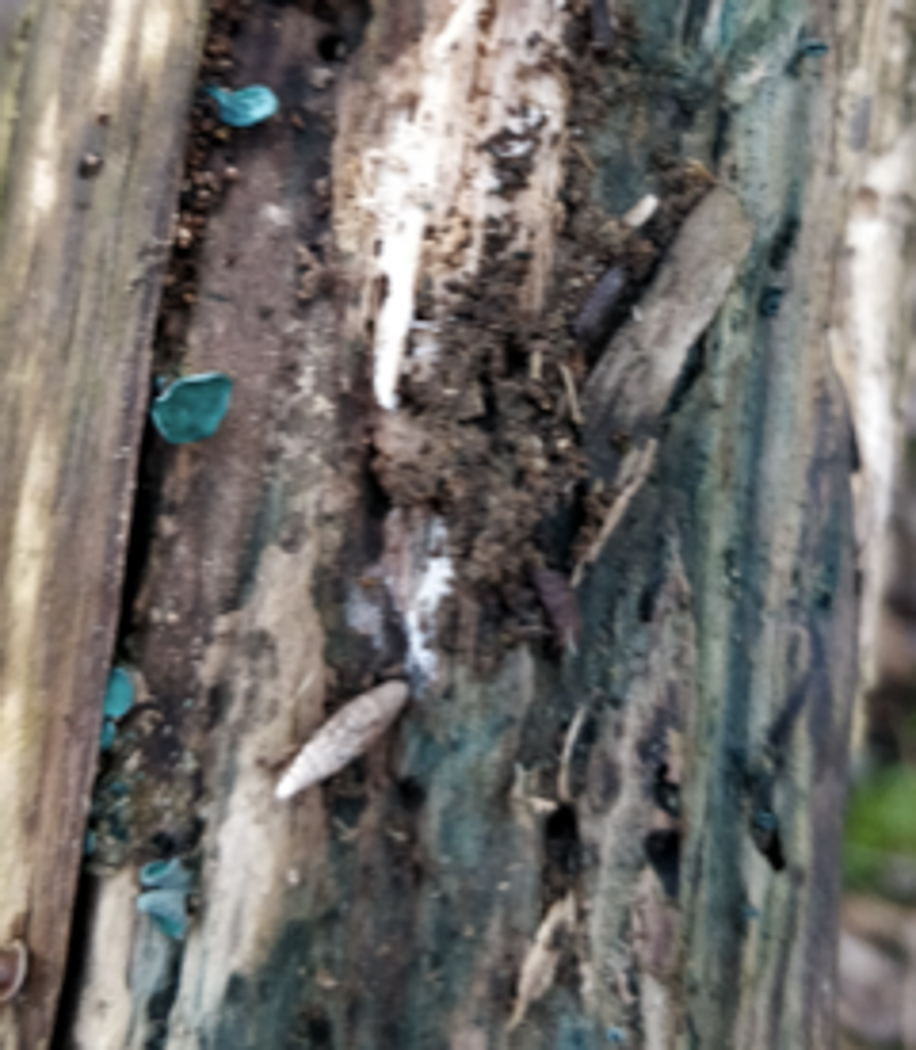 |
March 15th Chlorociboria aeruginascens (Green Elfcup)
At Burnham Beeches Claire Williams noticed this colourful species on damp fallen deciduous wood, so another Elfcup to go with her previous Scarlet species though the two are not related in any way and belong to different genera. Today's species is far smaller despite her close-up photo here which makes it appear possibly similar in size. Photo 2 gives an impression of perspective and was taken by Bob Simpson at his Salden Wood three days later. See the Masterlist for our many other examples of both species.
|
March 12th 2023
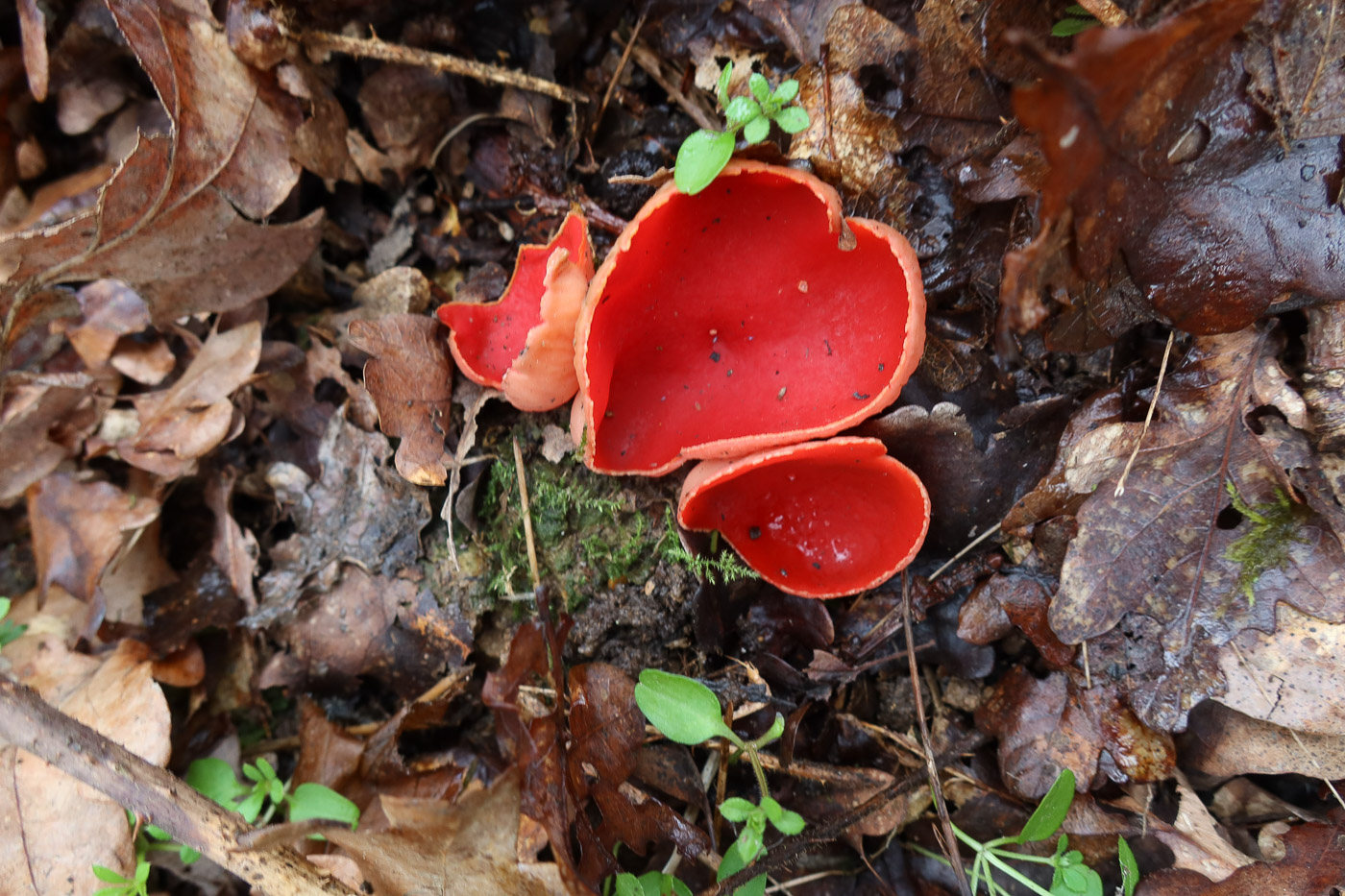
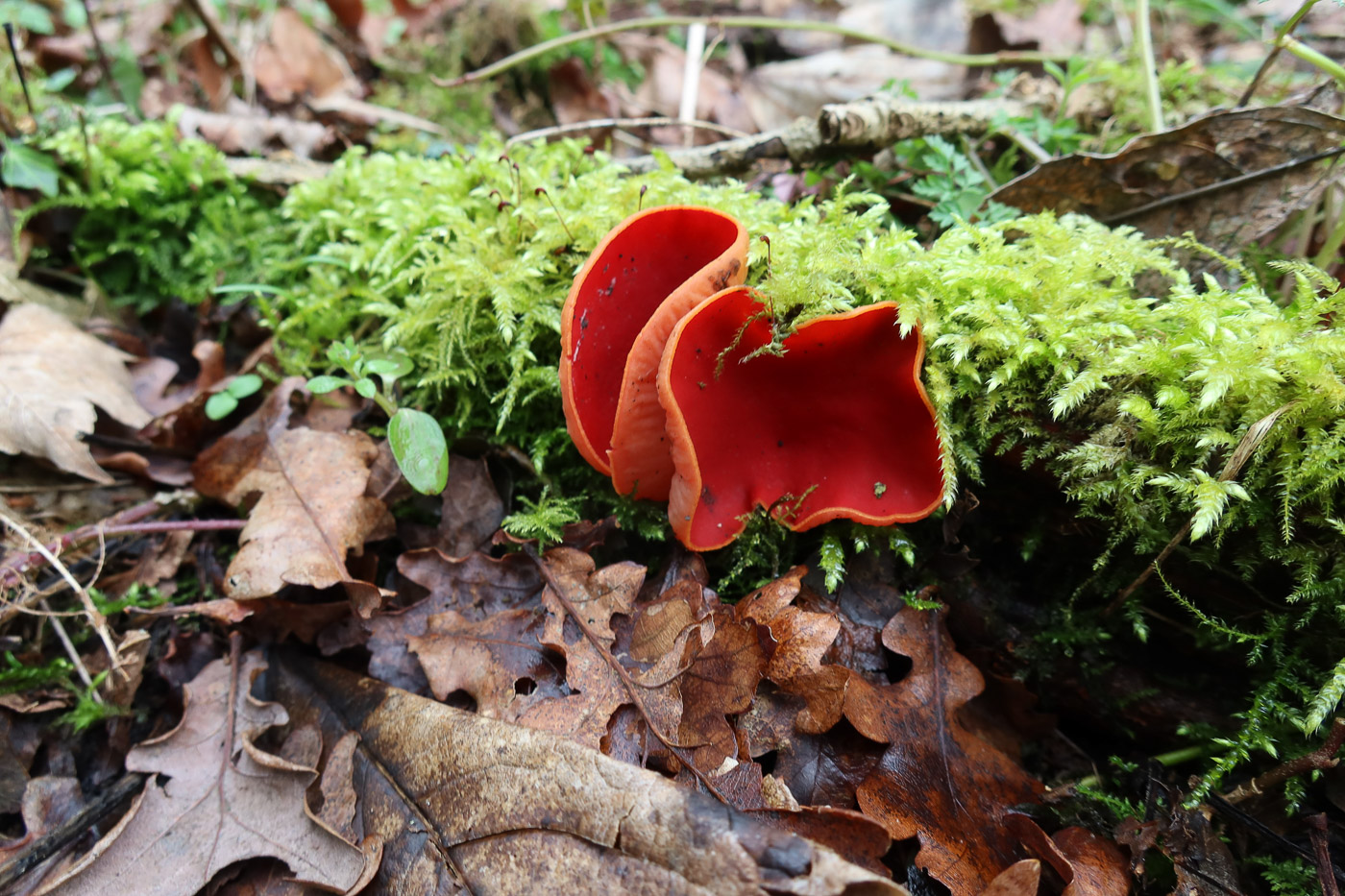
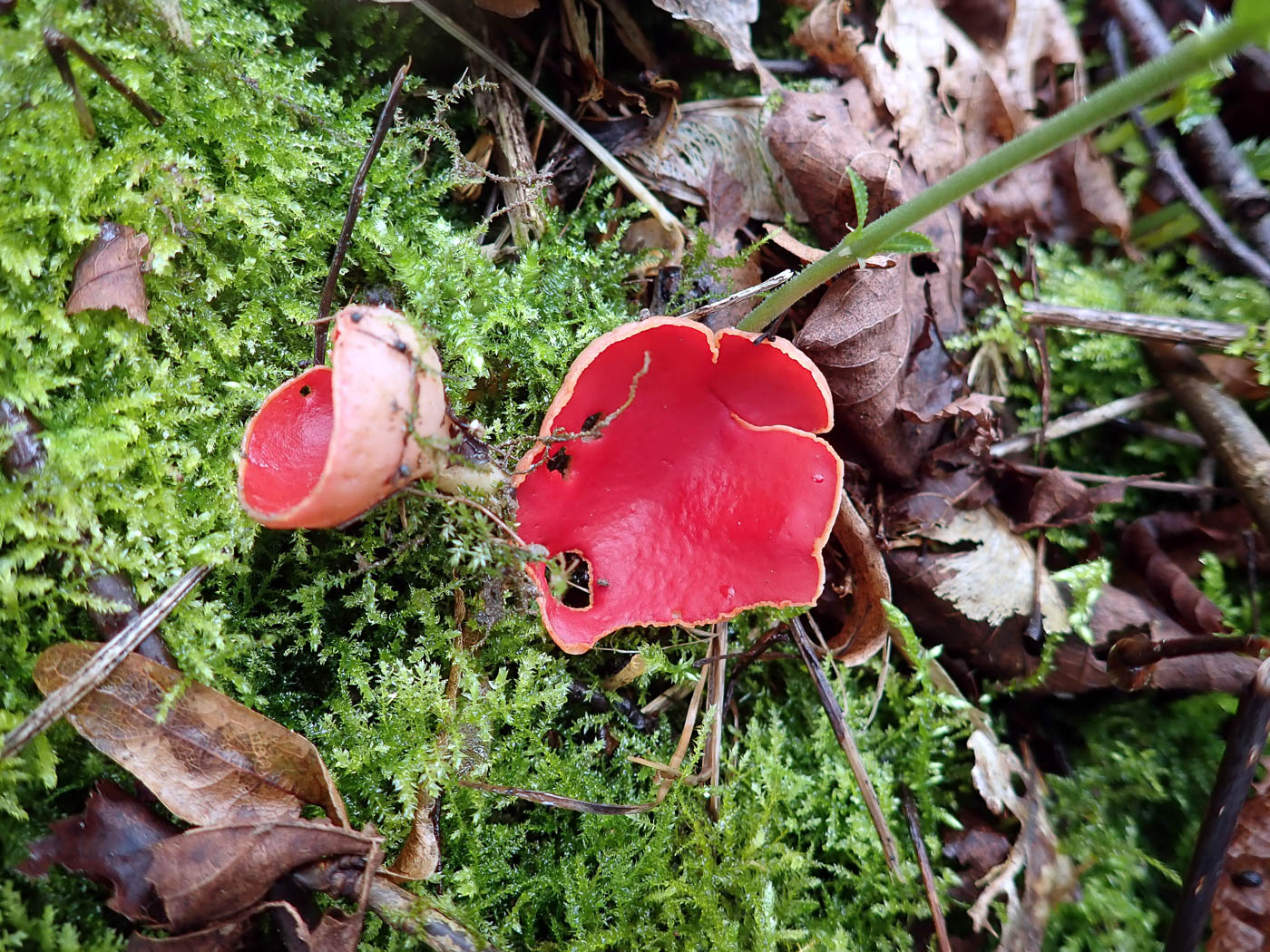 |
March 12th Sarcoscypha austriaca (Scarlet Elfcup)
Now the weather has warmed up a bit, Claire Williams noticed this attractive species fruiting again in two different sites: photo 1 was at Naphill Common and photo 2 at Downley Common - both found on fallen soggy deciduous wood which is (typically for the species) in contact with the soil. Photo 3 was found a week later at Turville Heath by Penny, and we have an earlier example from January 9th, also several others in the Masterlist. We hope it will still be fruiting on our Rushbeds Wood walk on April 2nd where it is a regular at this time.
|
March 7th 2023
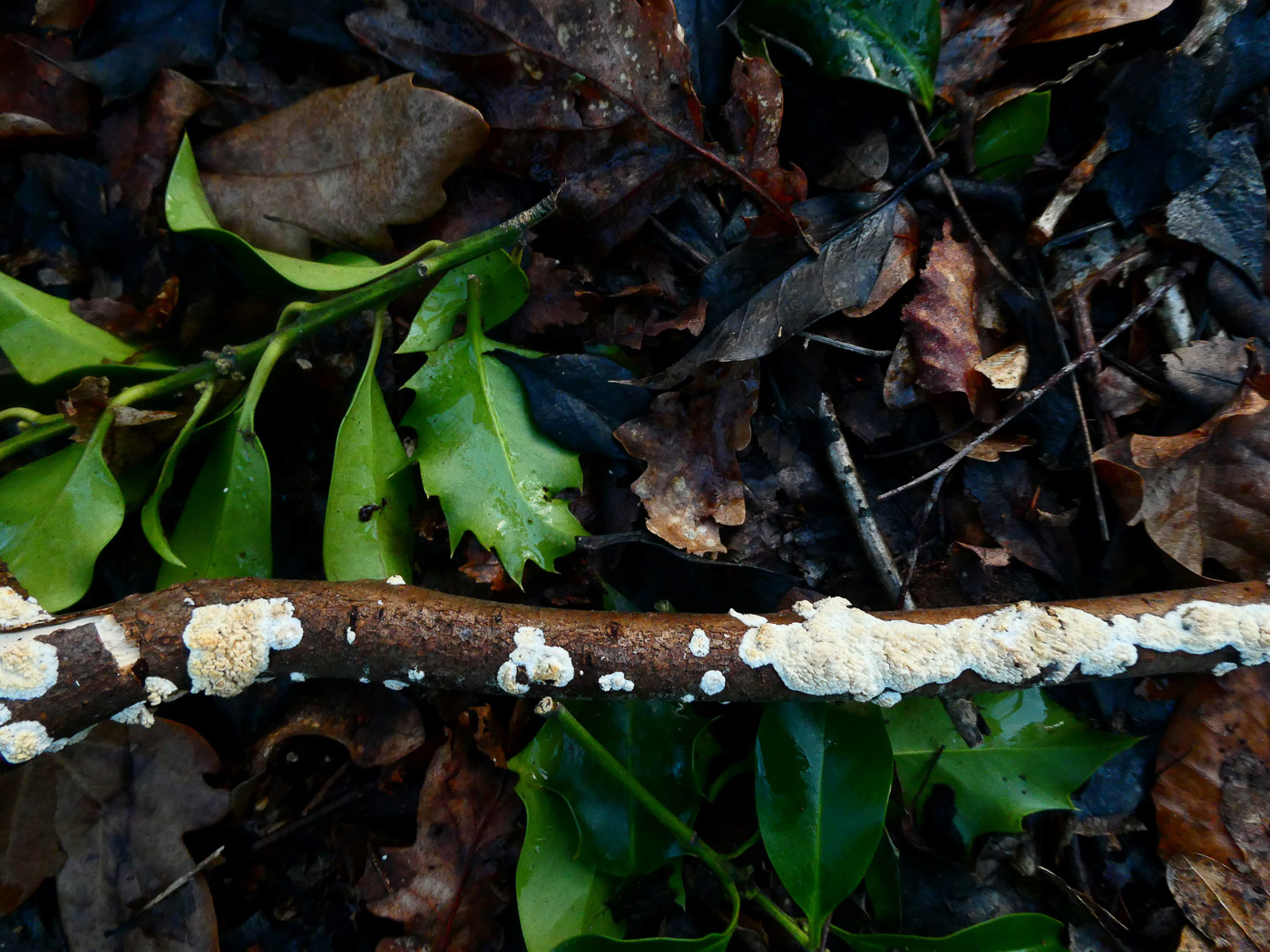
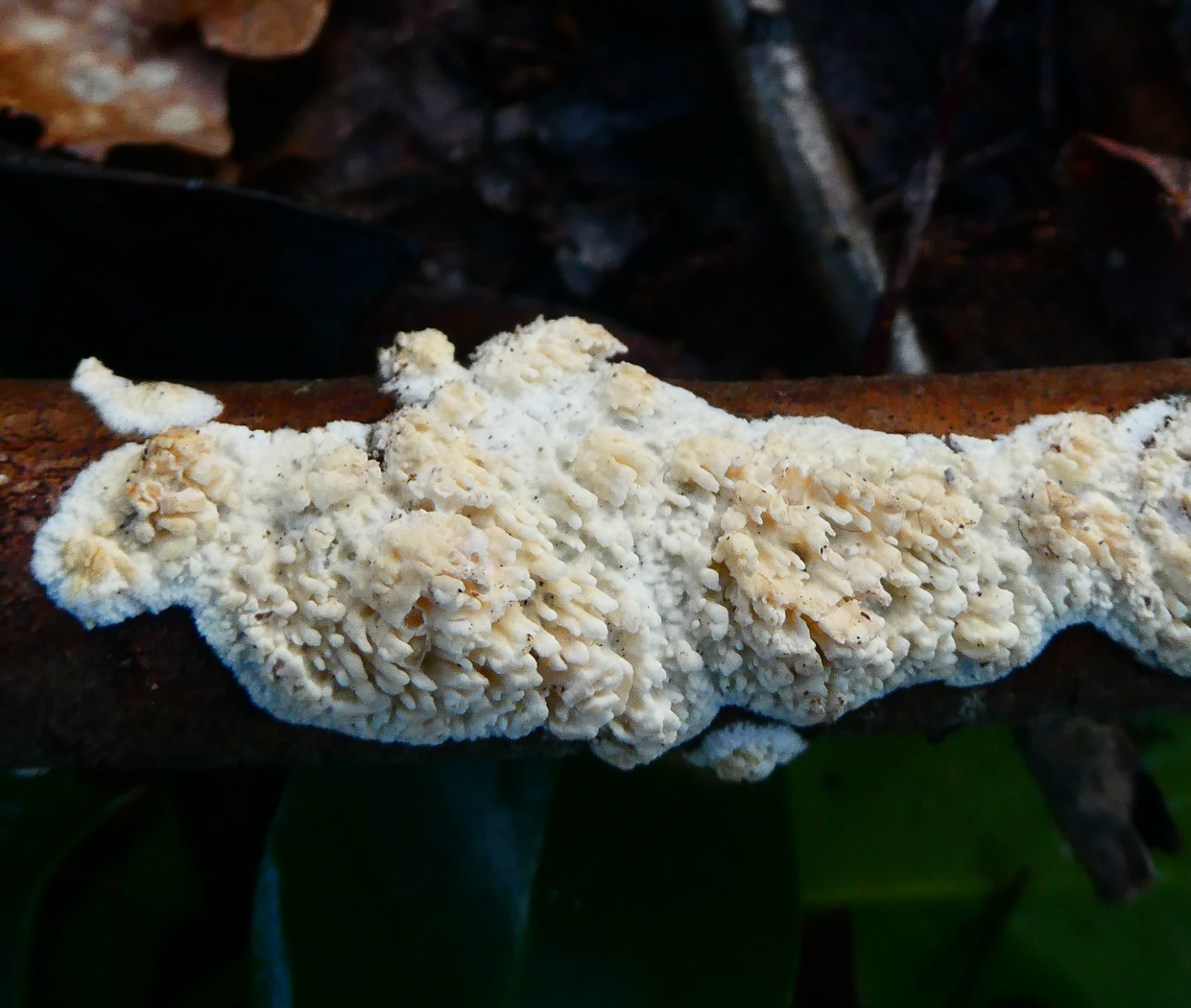 |
March 7th Basidioradulum radula (Toothed Crust) 
On a twig, possibly Cherry, on Austenwood Common (Gerrards Cross) Jim Wills noticed this species - a nice example of a common corticioid. It starts out as small roundish patches with a white rim and a cream 'toothed' centre, the patches gradually coalescing into larger longer patches as can be seen in both photos here. We have several previous examples on Finds - located from the Masterlist.
|
March 6th 2023
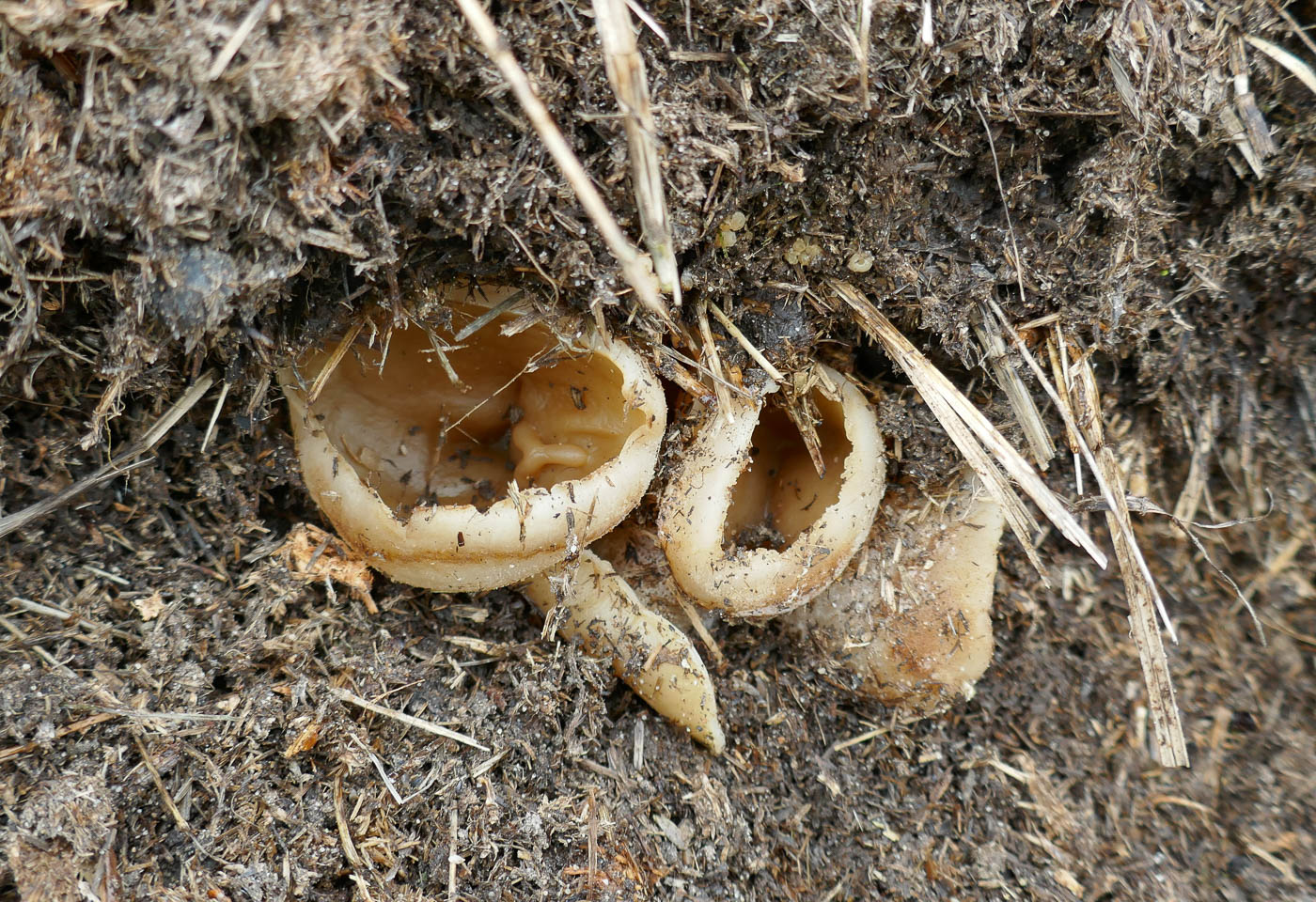
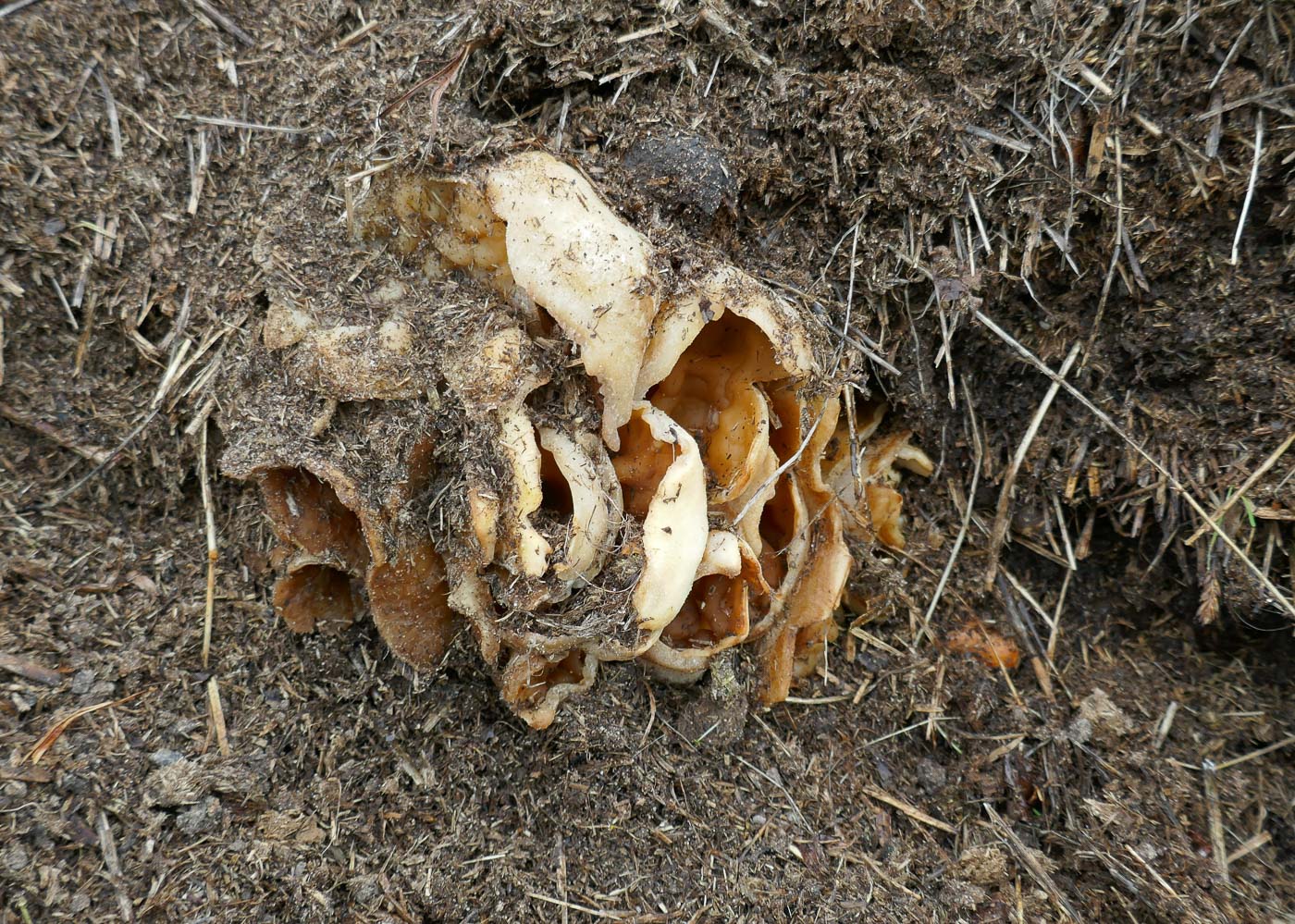 |
March 6th Peziza vesiculosa (Blistered Cup) 
At Stampwell Farm Jackie Ewan noticed this little crop of cups emerging from straw in a dung heap, kept her eye on them and when big enough took one home to check. (Cups need to be mature so that at least a few spores are floating free of the asci - the containing sausage-like sacs - in order to examine them for both size and ornamentation for an accurate ID.) The species is an occasional one, nearly always on straw / hay in bales or loose, though one of our Finds entries was on woodchip (sequenced to confirm). See Finds 2022 Jan 3rd and May 16th.
|
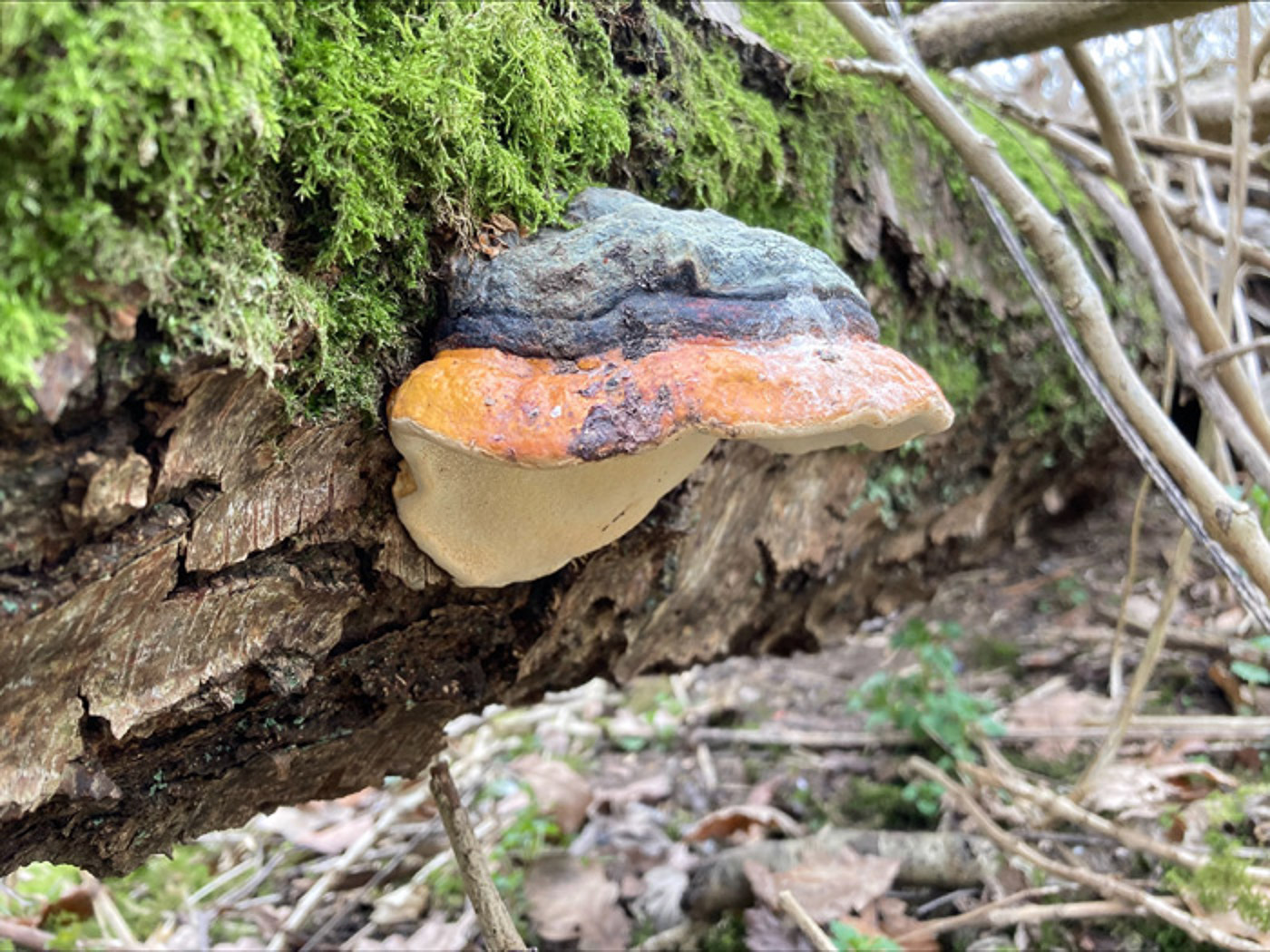
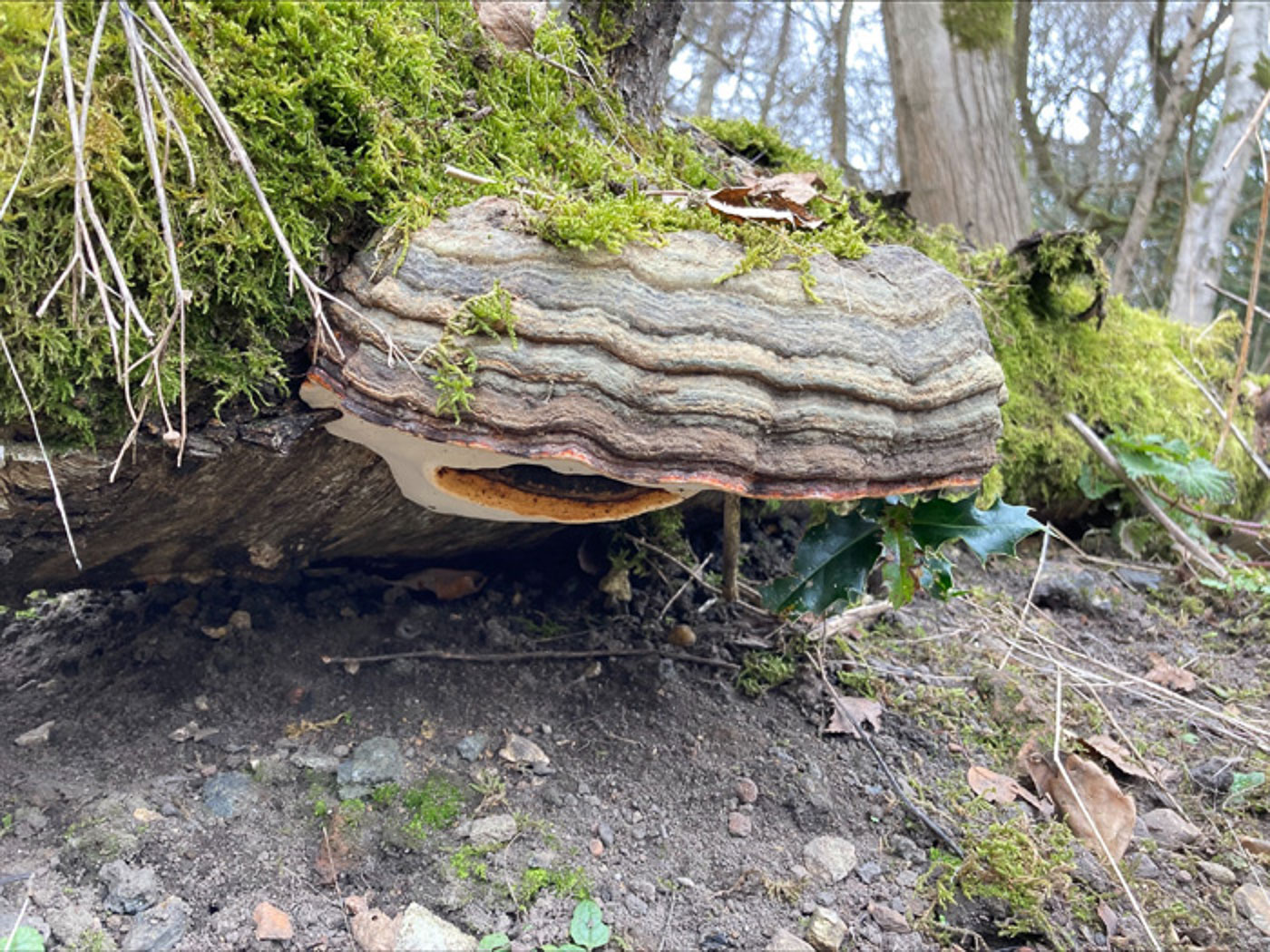
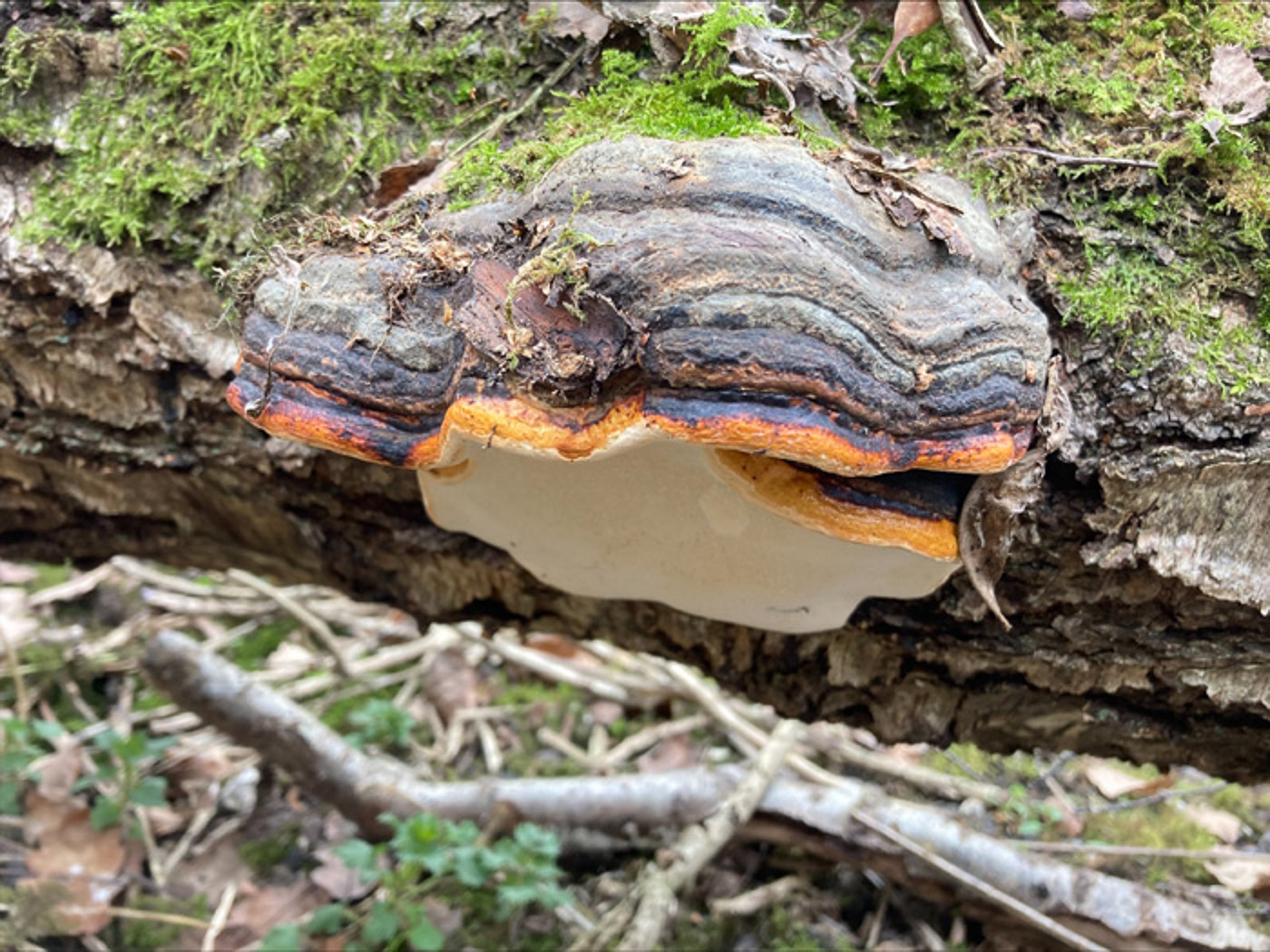
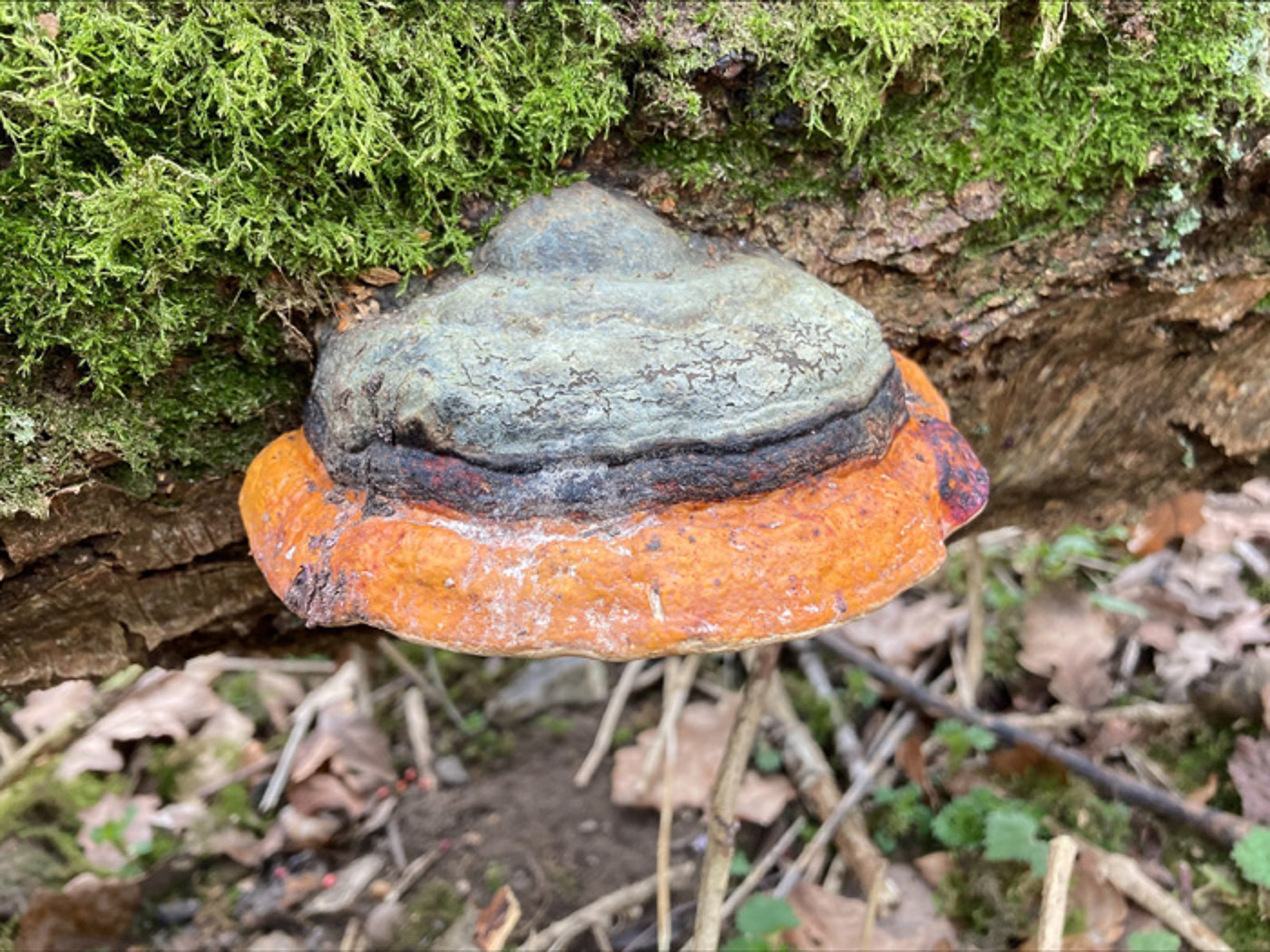 |
March 6th Fomitopsis pinicola (Red-belted Bracket)
On fallen Birch at Burnham Beeches Russell Ness came across some really nice mature examples of this species - one now becoming quite common locally though we've been puzzled by younger specimens which have yet to develop the 'red belt' seen so convincingly here. Compared to our various other examples in Finds (see the Masterlist for details), these four images show the species in its typical mature form.
|
March 4th 2023
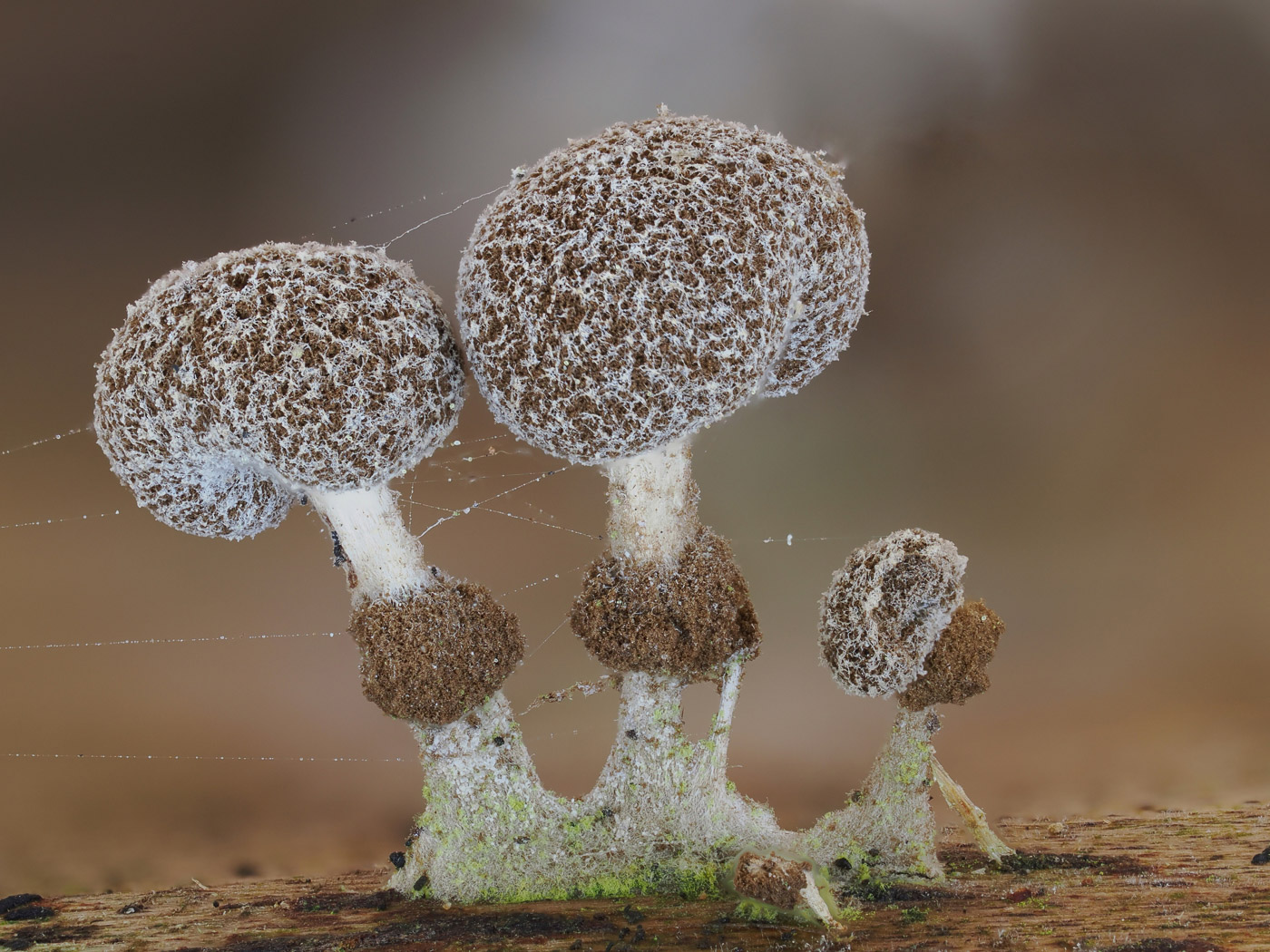 |
March 4th Phleogena faginea (Fenugreek Stalkball)
At Burnham Beeches on fallen Beech Barry Webb found this unusual tiny species - one that on first glance looks much like a small Slime Mould. It is a Basidiomycete, however, and as such never goes through the slimy Plasmodium stage despite its final appearance being so similar to many 'Myxos'. (Incidentally it also has a penetrating smell of Fenugreek which helps to confirm its ID in the field if in doubt.) The photo is Claire Williams's and she comments that she saw the species in Downley Common as well as at the Beeches, so it appears happy fruiting through this cold spell of weather. See the Masterlist for more examples, though this one seems unusual in apparently having formed spores half way up the stem as well as in the conventional 'head' at the top - a feature Barry noticed in many of the specimens he saw here.
|
February 23rd 2023
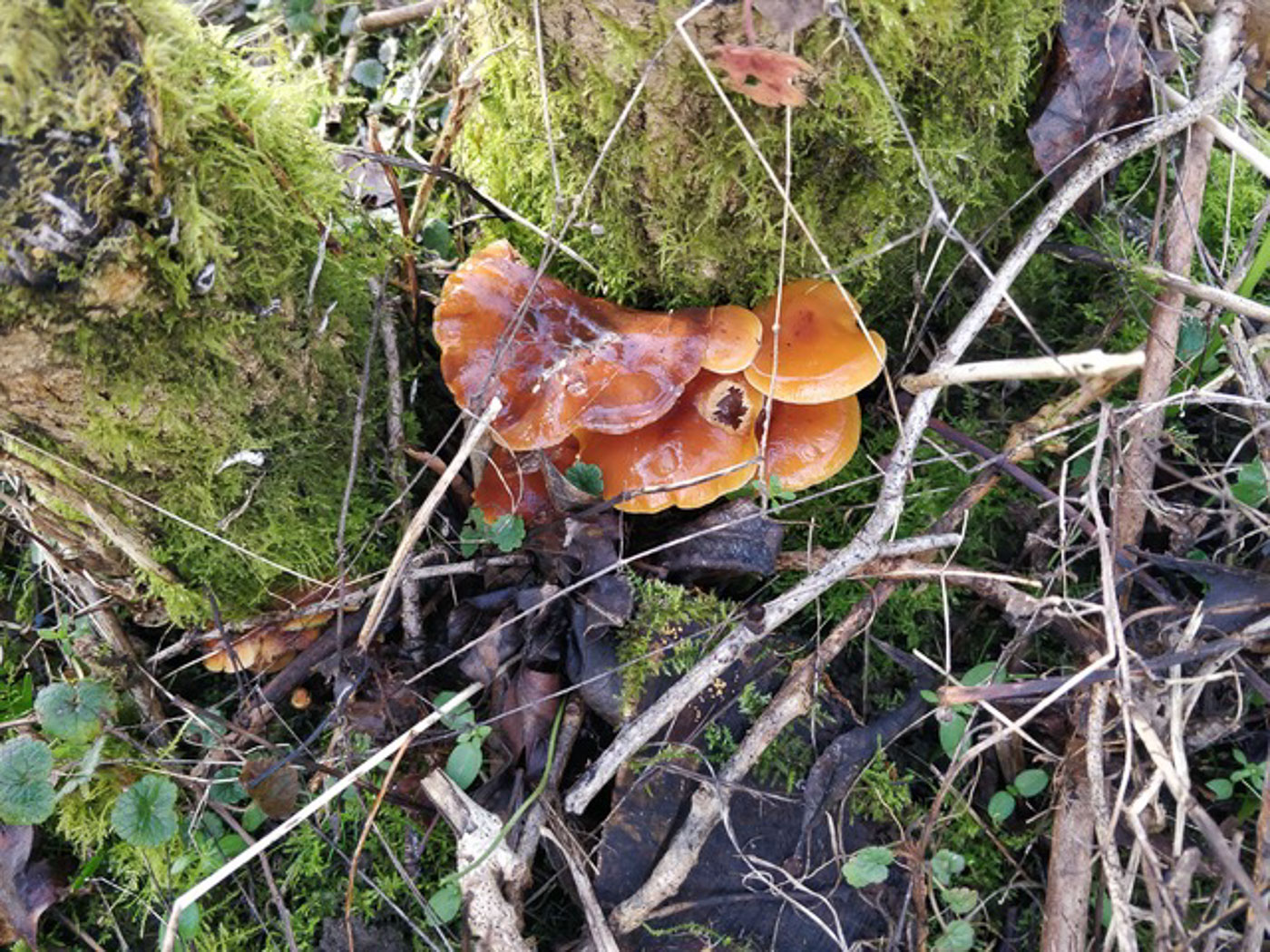
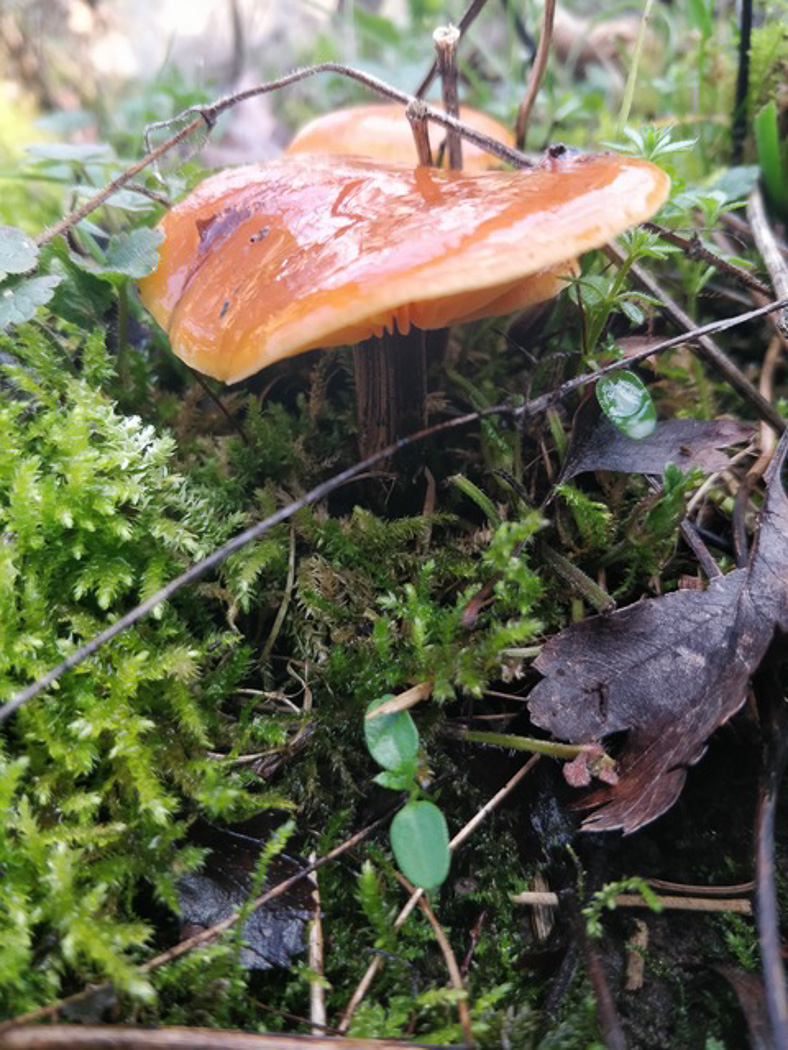 |
February 23rd Flammulina velutipes (Velvet Shank)
In Salden Wood (owned by Bob Simpson) Bob found this winter fruiting species on various hardwood stumps. We have a previous entry this year on January 2nd (though just into Berkshire!) and it's always nice to see any fresh mushroom at this time, especially one which grows in impressive clusters as this often does, whatever the weather. See the Masterlist for more examples.
|
February 11th 2023
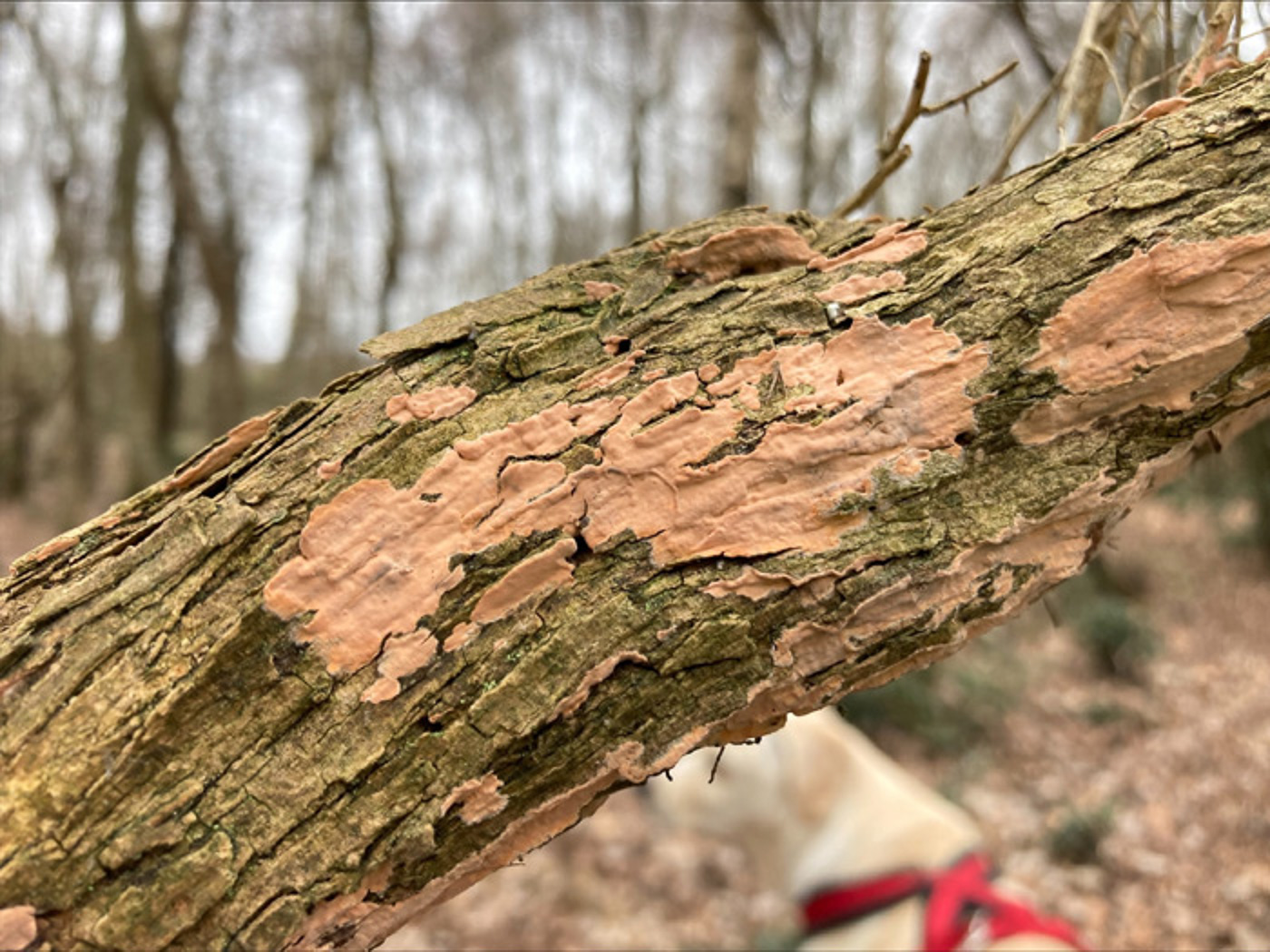
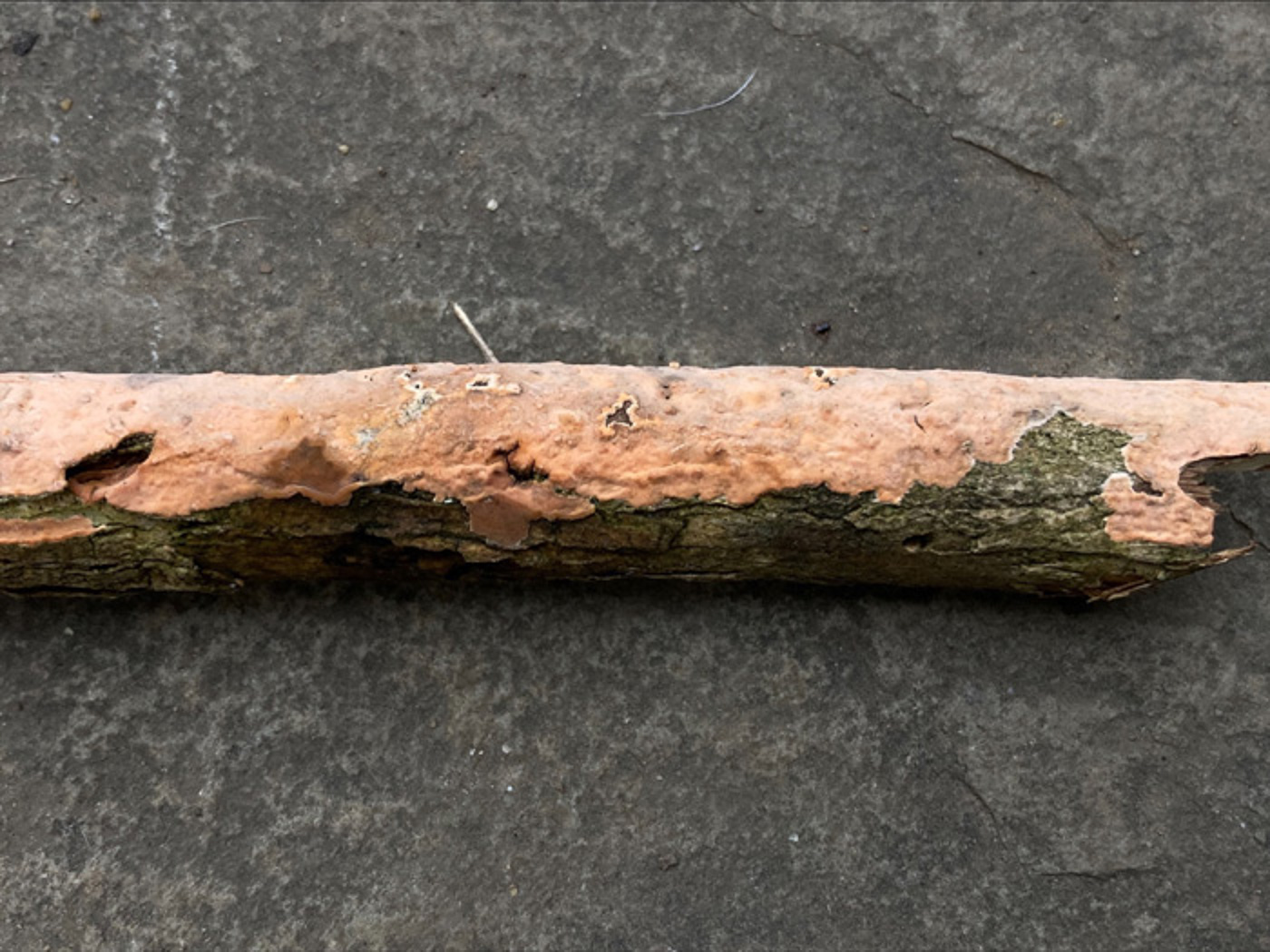
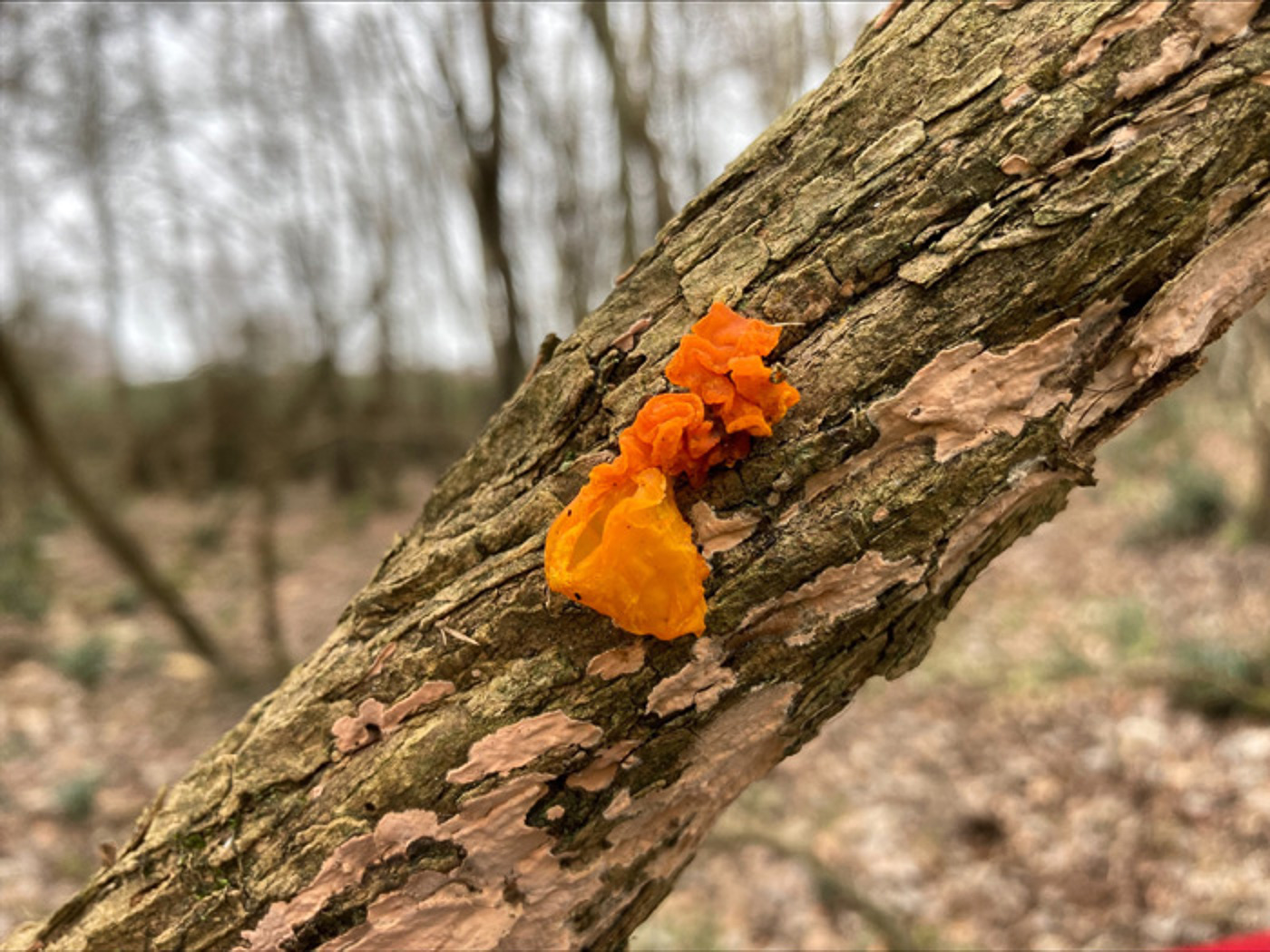 |
February 11th Peniophora incarnata (Rosy Crust) 
At Stoke Common Russell Ness noticed some distinctive creamy pink corticioid patches on stems of Gorse, collected some to check with a scope and was able to confirm his ID. Though not rare, the species occurs on various hosts but is commonest on Gorse and Ivy. We have just four previous county records - all on Gorse and two of these from exactly the same area at this site and one other in Finds 2021 March 27th. Photo 3 here shows the species together with the bright yellow jelly fungus, Tremella mesenterica (Yellow Brain) - another species found on various hosts, most commonly on fallen Oak but often also on Gorse.
|
February 1st 2023
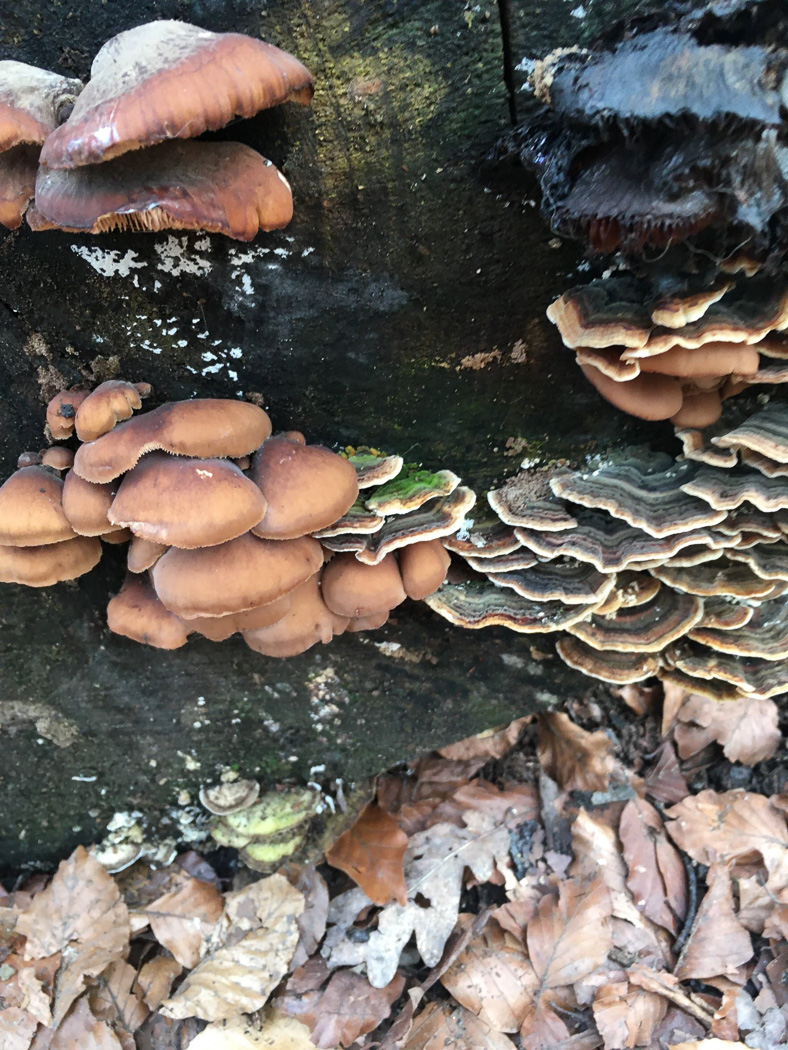
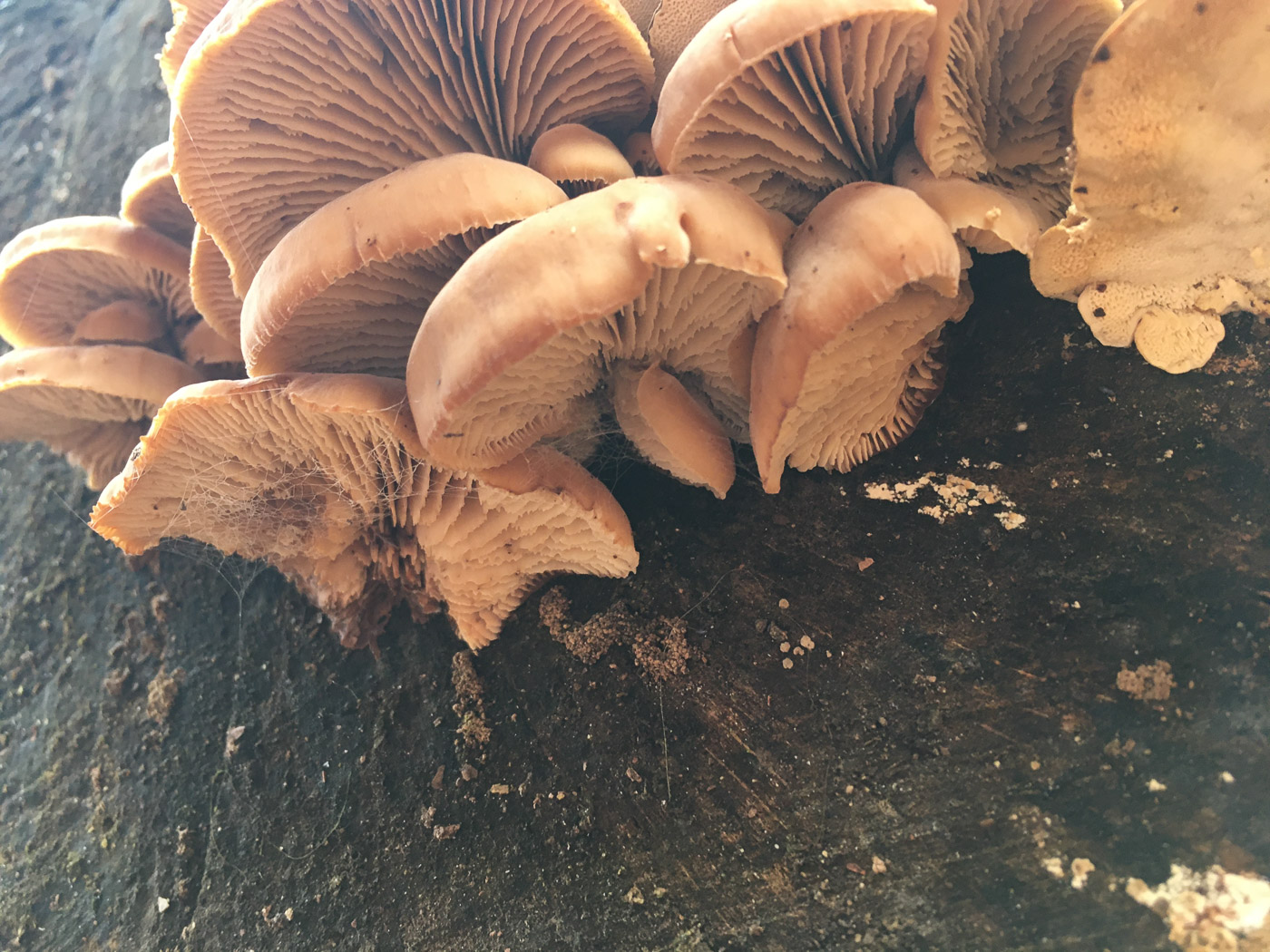
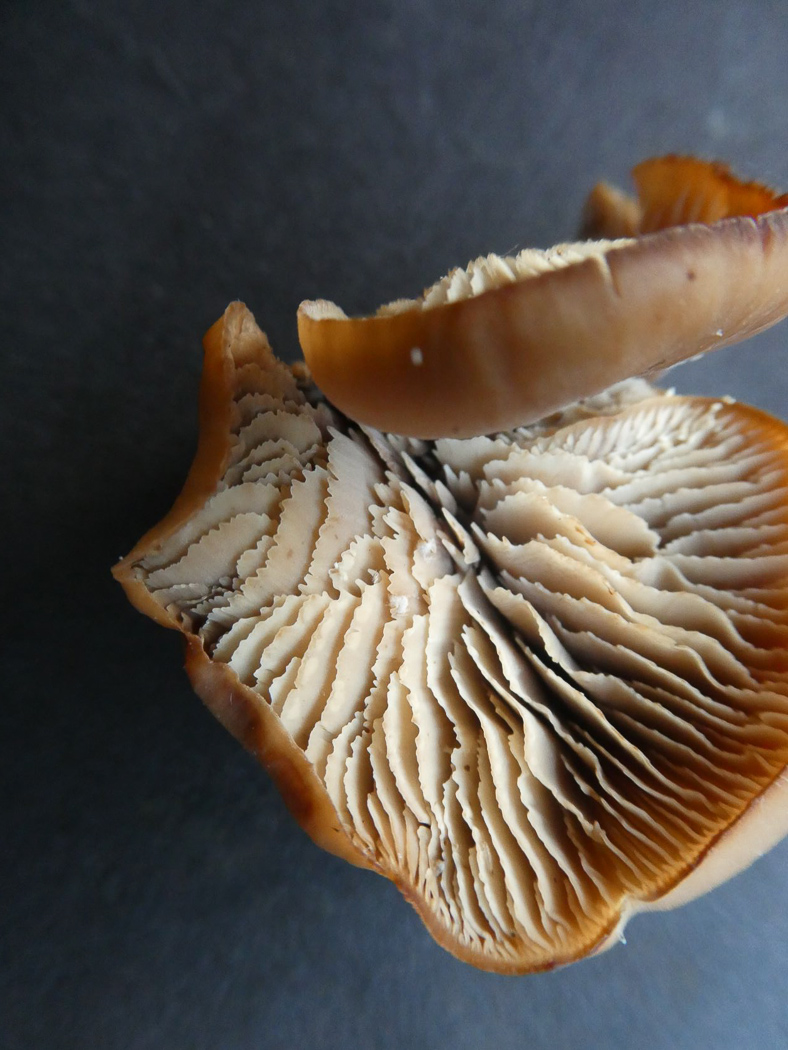 |
February 1st Lentinellus ursinus (Bear Cockleshell)  
In Chalfont St. Peter Jim Wills found this fungus fruiting on the sawn end of a large felled Beech trunk and took some home to work on. The Pleurotoid habit (photo 2) and markedly saw-edge gills (photo 3) led him straight to the genus Lentinellus, the commonest species of which - L. cochleatus - has a strong aniseed smell and weakly amyloid spores. Finding the spores strongly amyloid - also other parts of the fruitbody - and noting the lack of aniseed smell, he clearly had something different, then discovered that splitting the two likely species fitting these features - L. ursinus and L. vulpinus, both rare - was no easy task. However, further research pointed strongly to L. ursinus in this case and DNA sequencing has now proved Jim correct. The collection will be sent to Kew Fungarium. See also in Finds 2022 November 13th. We have extremely few county records of this species. (Please note the common name given here is unofficial but logical, also used online, so will presumably be officially adopted at some stage.)
|
January 31st 2023
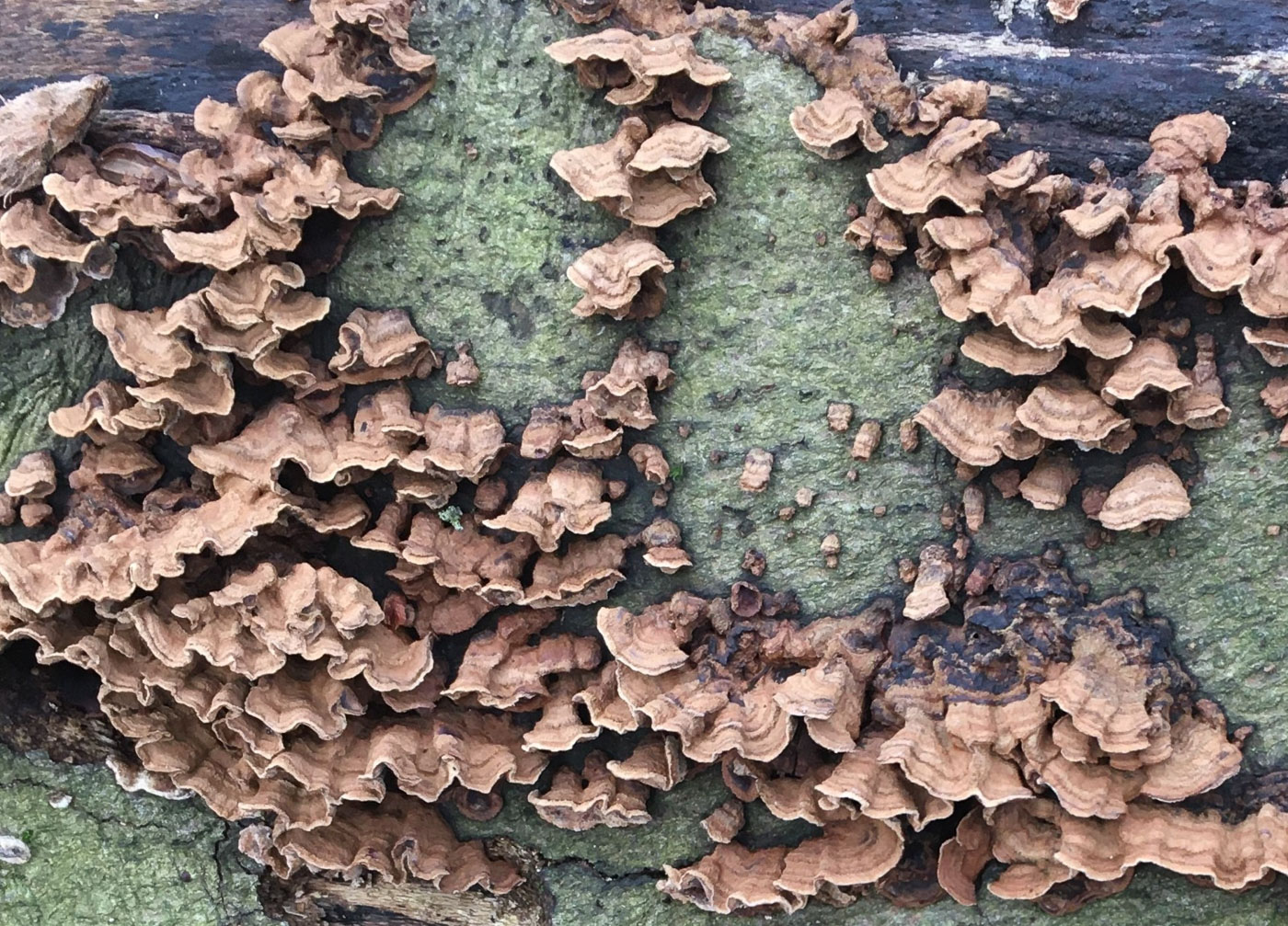
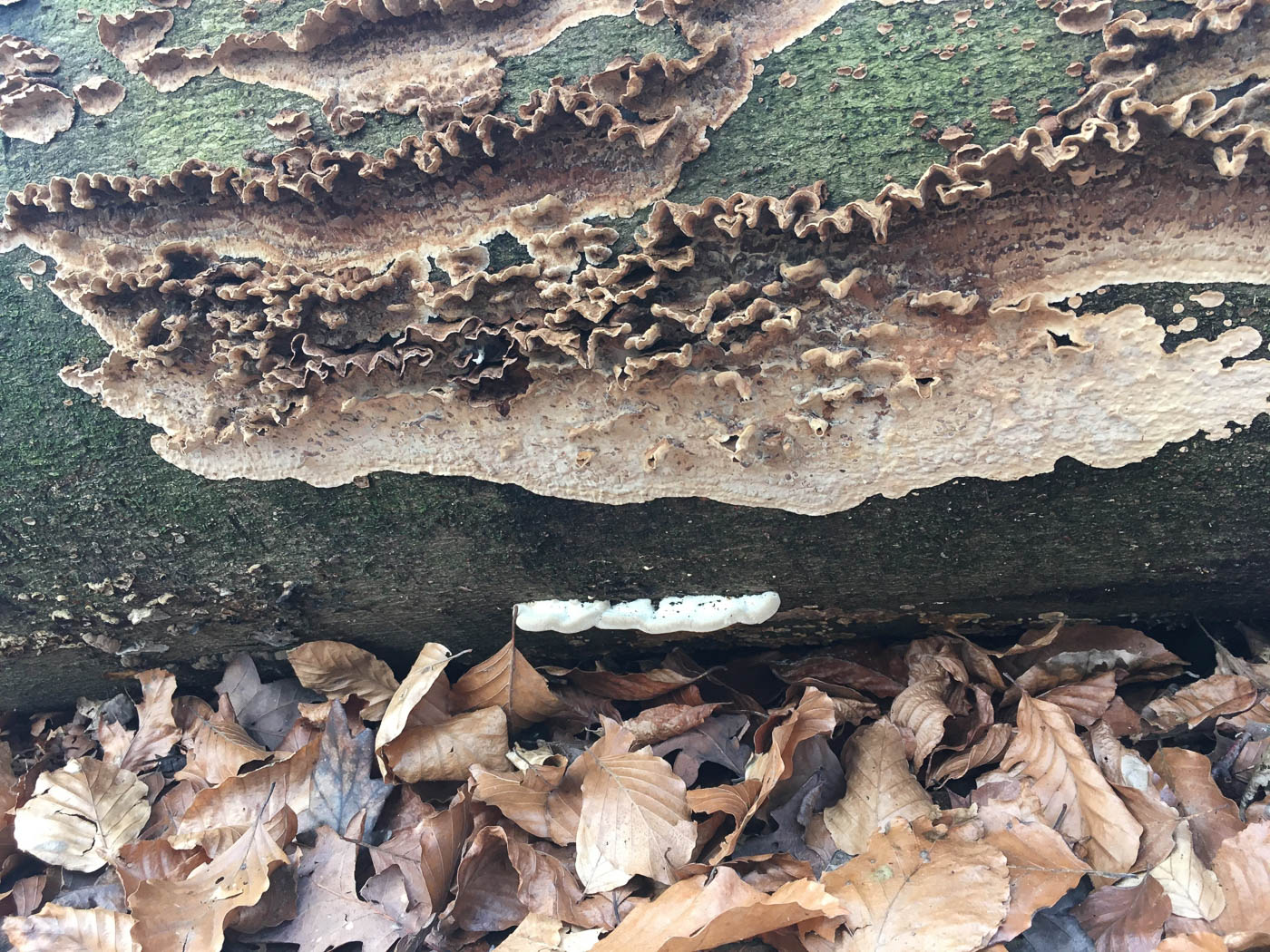 |
January 31st Laxitextum bicolor (an unusual part bracket / part corticioid with no common name) 
In Chalfont St. Peter Jim Wills noticed this fungus on a large felled Beech trunk, recognised it as quite similar to the very common Stereum hirsutum but significantly different enough to prompt him to take it home to work on. He then discovered it had amyloid ornamented spores which suggested Laxitextum bicolor - a species at one stage placed in the genus Stereum but with softer flesh and a whitish to grey undersurface. He then consulted Claudi Soler who was able to confirm his ID. This is not a common species and we have only a few county records though it may possibly be overlooked or thought to be a species of Stereum in the field. It favours fallen Beech but is not excusively found on Beech. See also in Finds 2021 October 26th.
|
January 27th 2023
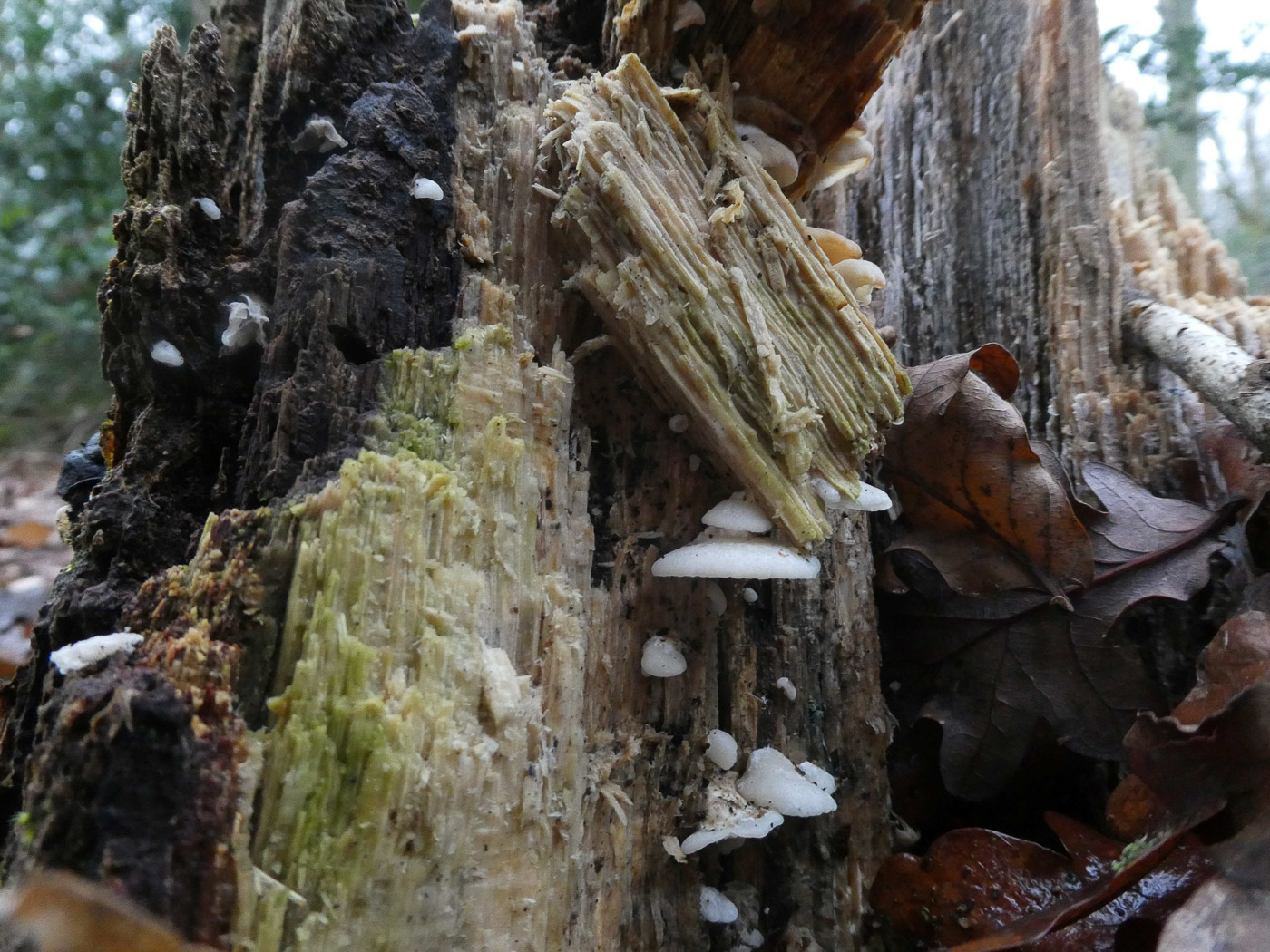
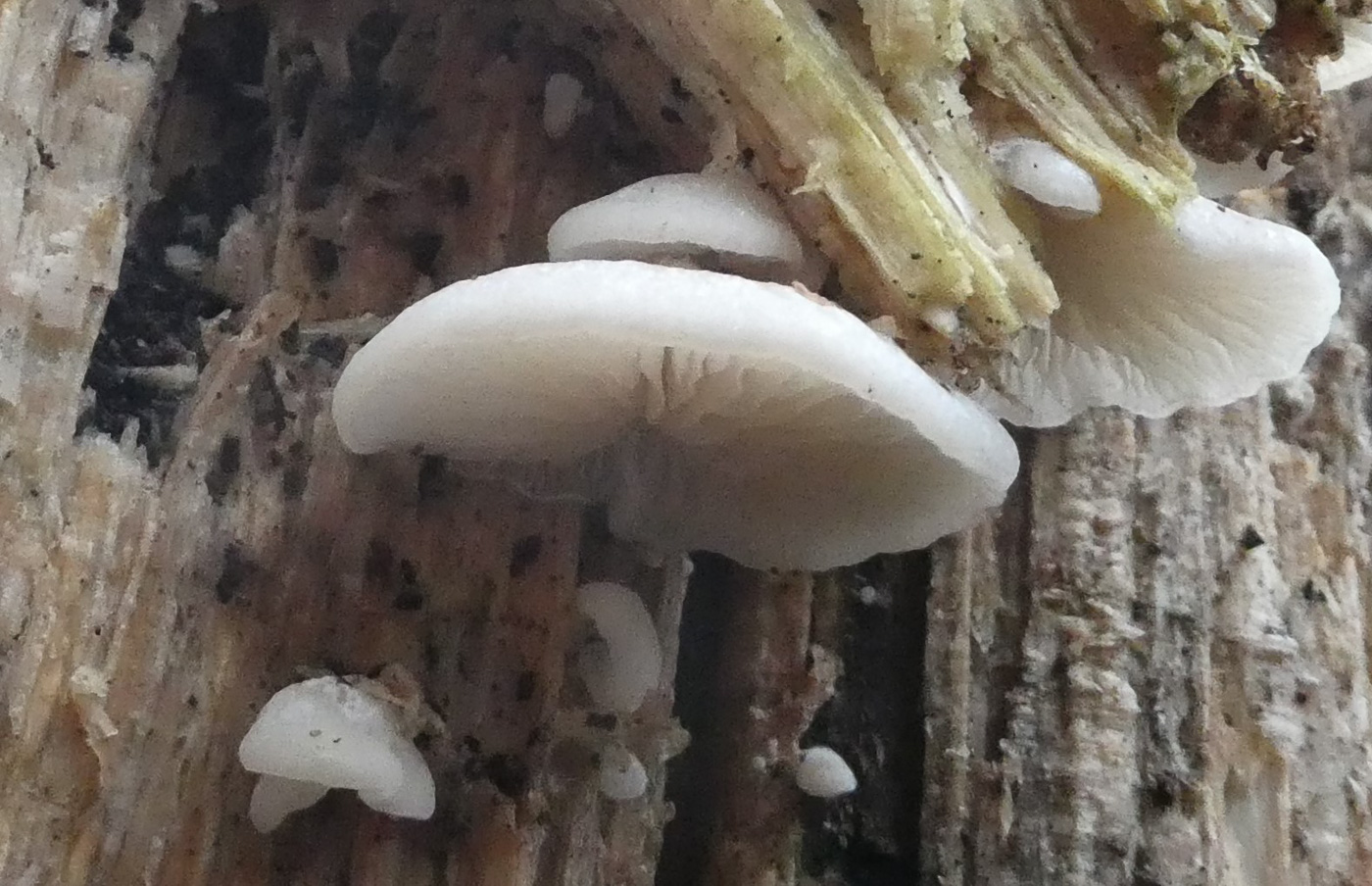 |
January 27th Clitopilus hobsonii (Miller's Oysterling) 
In Austenwood Common, Gerrards Cross, Jim Wills noticed this stump with good numbers of a small white 'pleurotoid' species very similar to the genus Crepidotus. Checking with a scope is essential for ID to species with careful observation of spore size, shape and ornamentation because there are other possibilites as well as that genus, one of these being Clitopilus hobsonii which has spores lacking ornamentation but with longditudinal ridges which can often be tricky to see and easily missed by the unwary. Note also the gills long remaining white (though the genus Clitopilus has a pink-brown sporeprint (see photo 2)) - Crepidotus gills tend to start turning brownish before full maturity. Today's species is quite possibly much more common than generally realised though regularly mistaken for a species of Crepidotus unless properly checked as here.
|
January 19th 2023
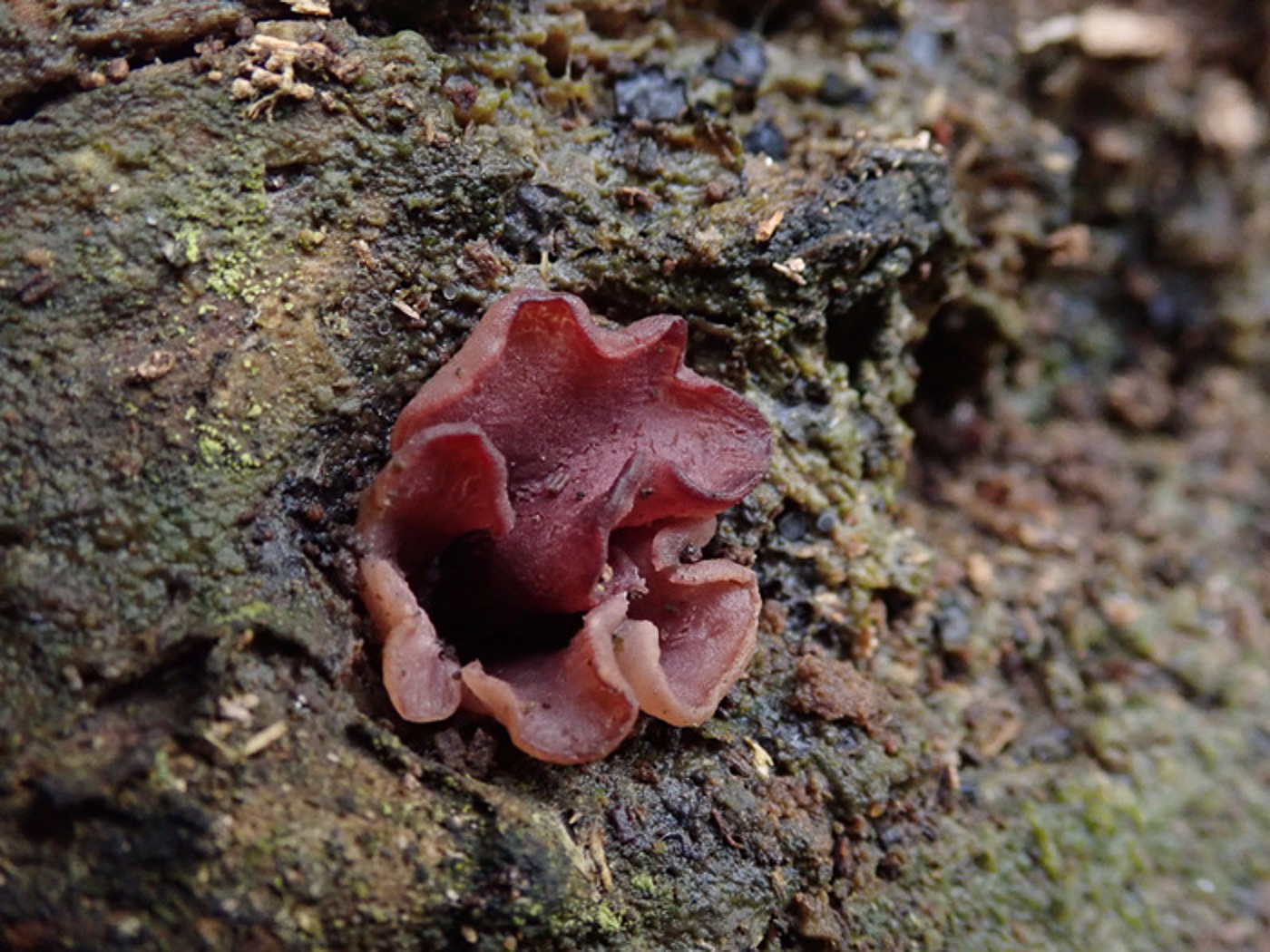 |
January 19th Ascocoryne cylichnium (a species of Purple Jellydisc)
On very decomposed wet Willow in Hughenden Park Sarah Ebdon spotted this small gelatinous 'piece of bacon' - her description, recognised it as similar to the common A. sarcoides but it looked rather different. Though only 13mm across it was clearly flatter and and less 'lumpy', more disc-like than the commoner species, so Sarah took it home where the spore size - considerably larger in this species than in A. sarcoides - confirmed her suspicions. Both species are common though this one is far less often recorded because it is all too easy to make the assumption in the field that it is the better known species of the two. See the Masterlist for further images of both species for comparison.
|
January 17th 2023
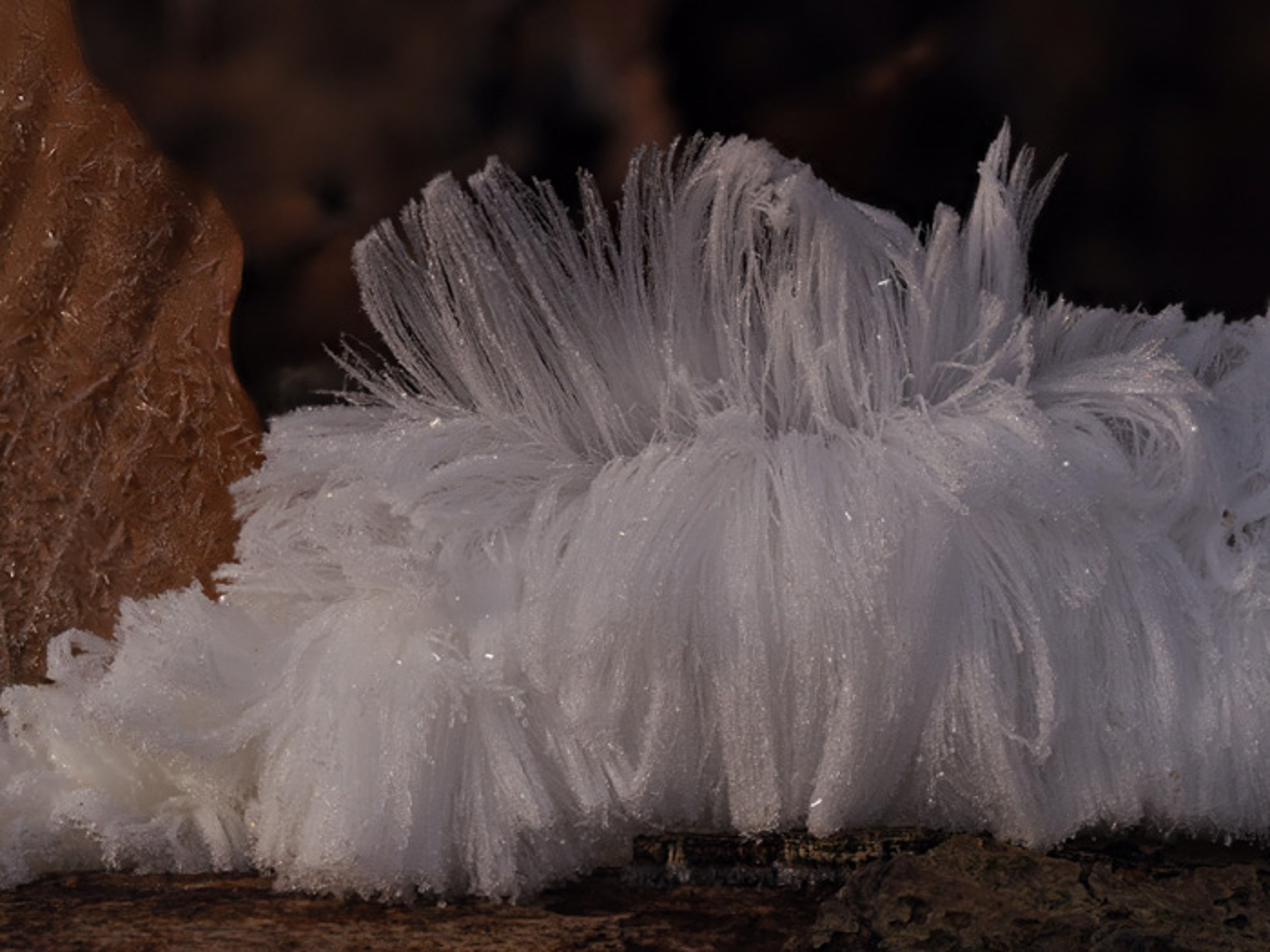
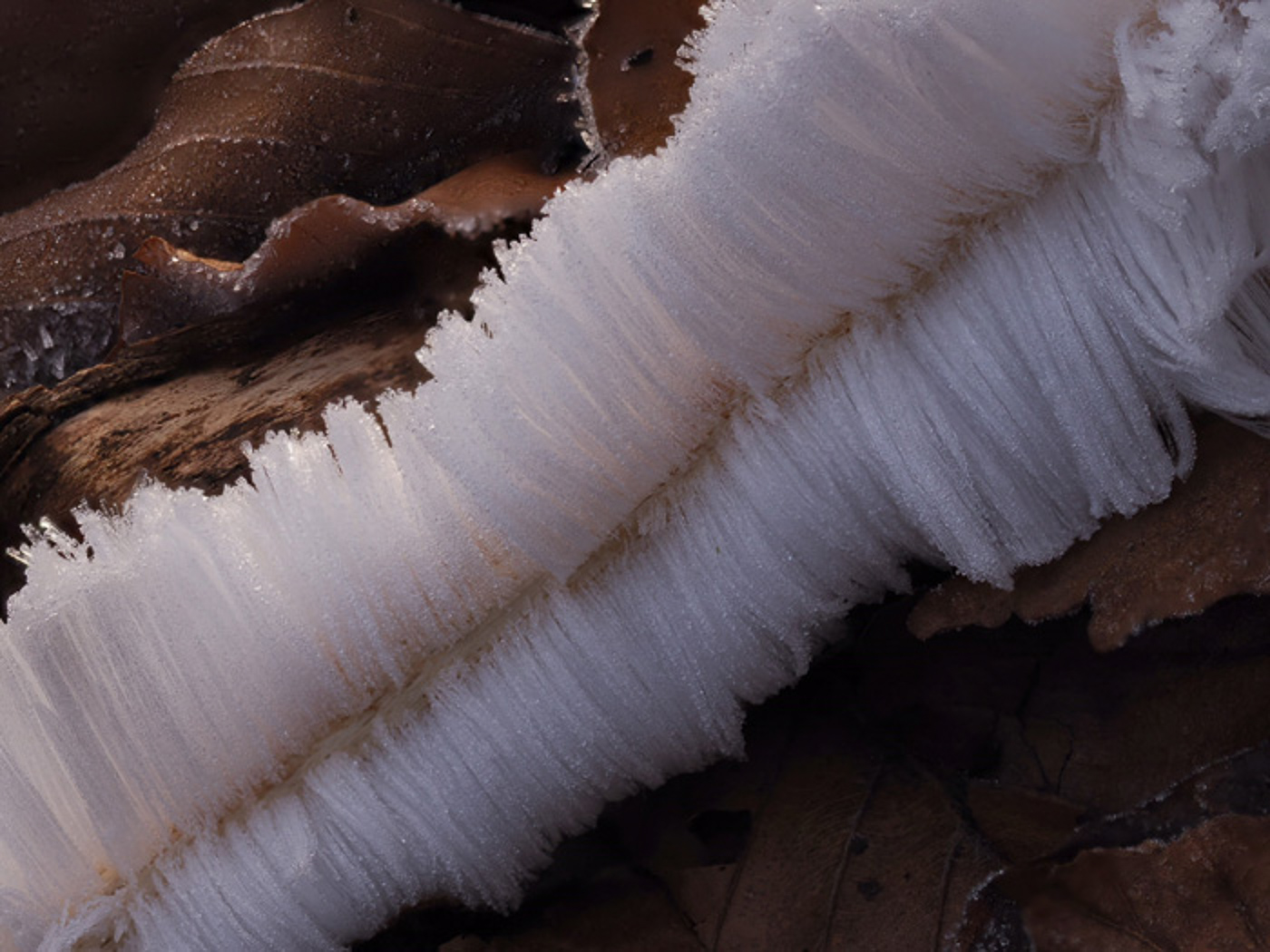 |
January 17th Exidiopsis effusa (Hair Ice)
After several very frosty nights, Sarah Ebdon and Claire Williams felt it was worth a visit to a site near Lane End where this remarkable phenomenon is known to occur given the correct conditions. They were rewarded with plenty of examples and were spoilt for choice! The full explanation for this remarkable formation has only been uncovered in recent years when it was realised after extensive study that it only forms on frosty damp days on fallen dead wood which has this fungus on or within it. (If you'd like a fuller explanation Penny has a short article she can email you.) See also in Finds 2020 January 8th and 2021 January 6th. (Photo 1 is Claire's, photo 2 is Sarah's.)
|
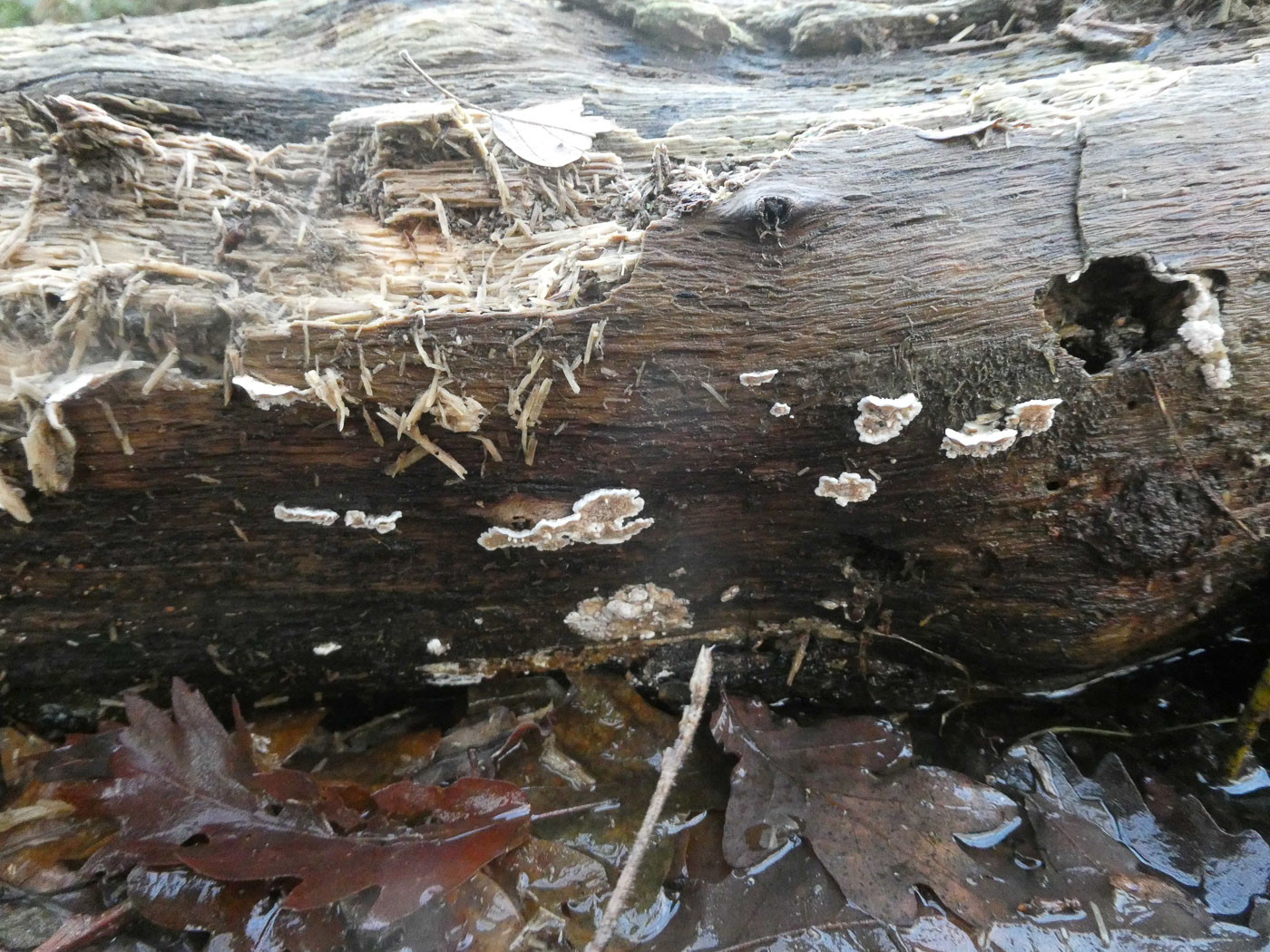
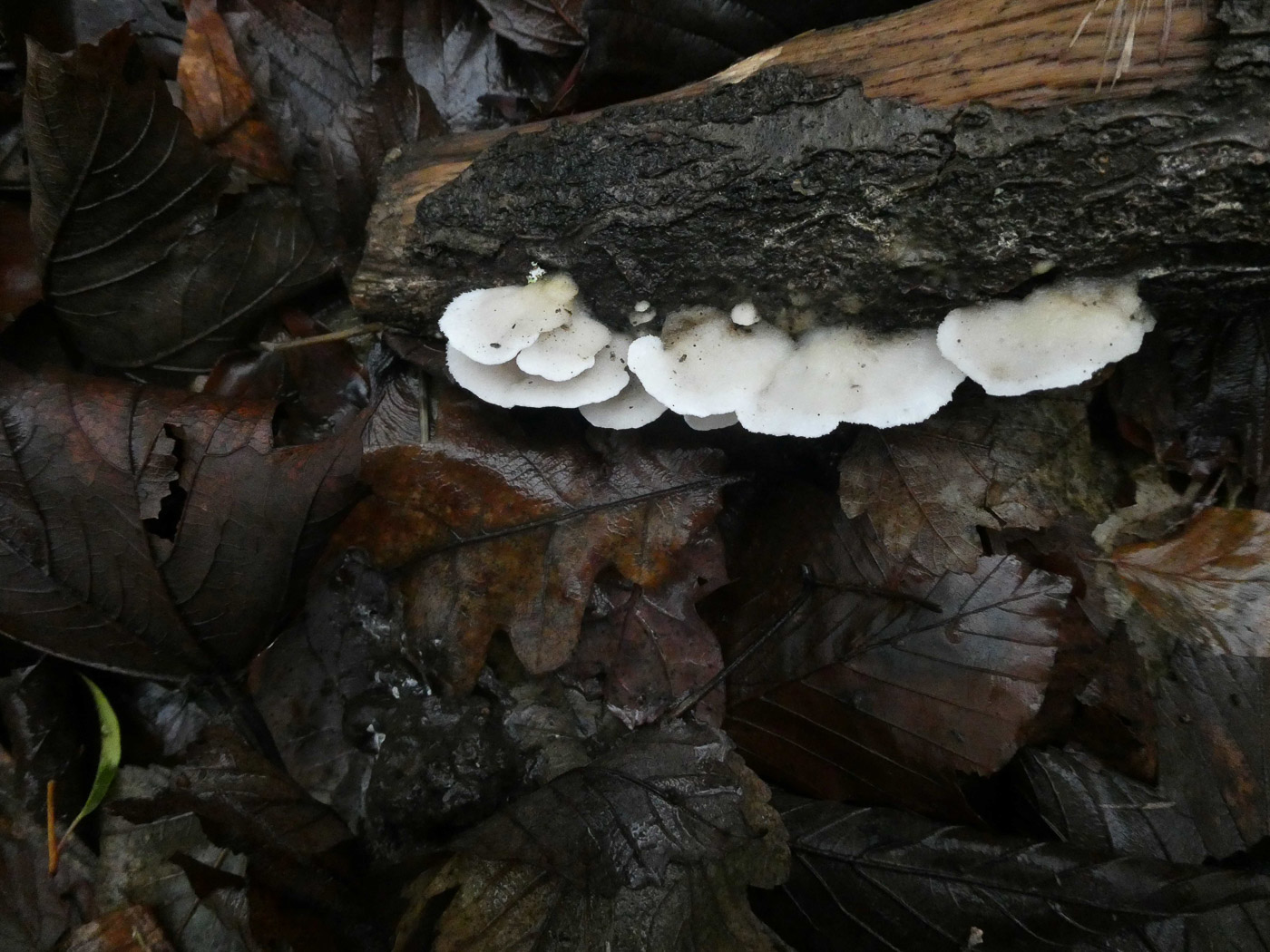
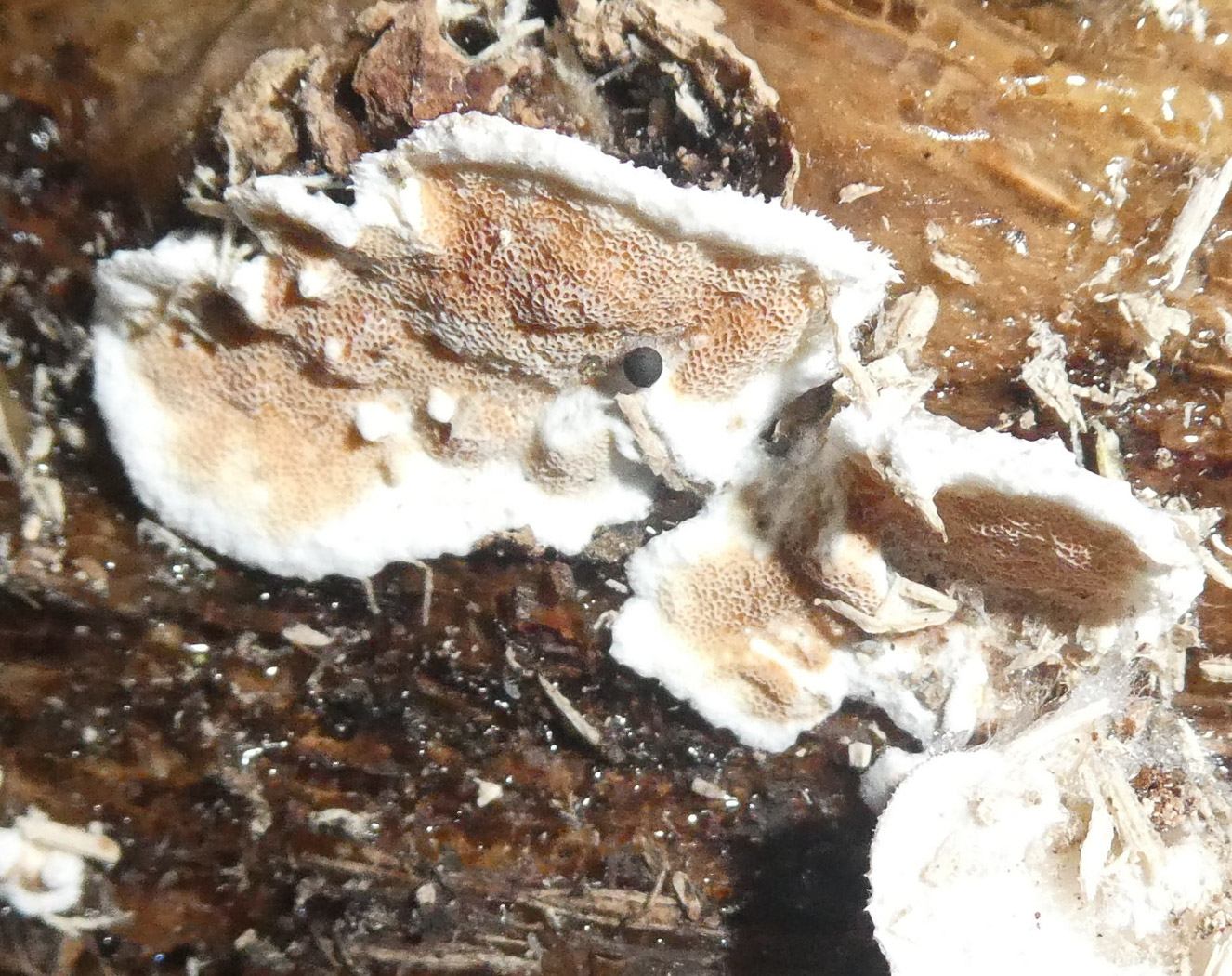 |
January 17th Gloeoporus dichrous (Bicoloured Bracket) 
During several visits to Stoke Common spread over a week or so Jim Wills noticed this unusual 'semi-corticioid' species fruiting on various bits of fallen Oak, recognising it from his find in Gerrards Cross (see Finds 2022 September 28th). A fairly unobtrusive species and therefore probably overlooked, it is quite soft, the tube layer being removable from the flesh - an unusual feature. The 'bicolour' in the common name refers to the apricot pores contrasting with white rim and white top surface, though this combination also occurs in the similar Skeletocutis amorpha which, however, occurs on fallen Pine and remains fully resupinate thus unlike today's species which forms part brackets.
|
January 15th 2023
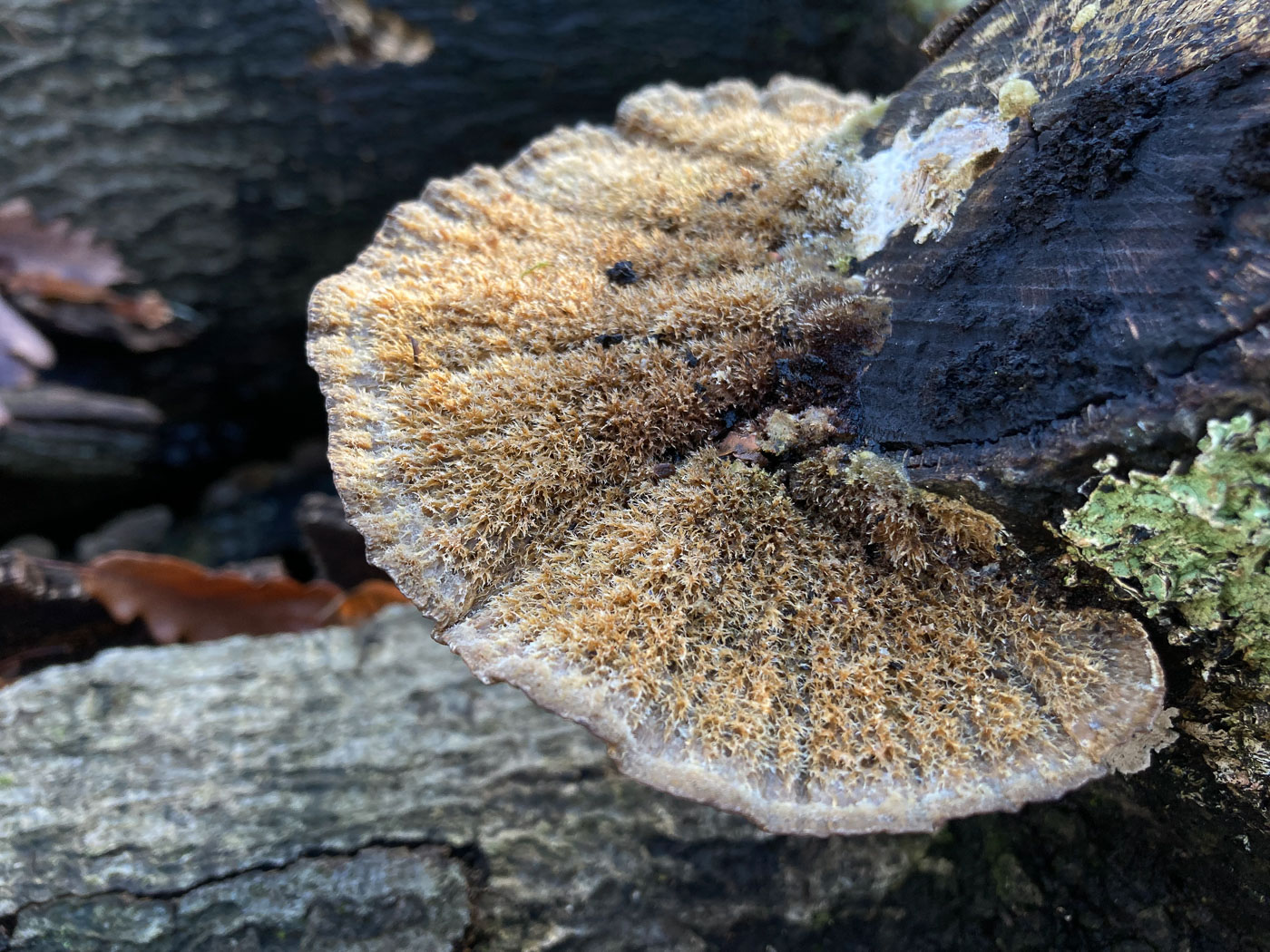
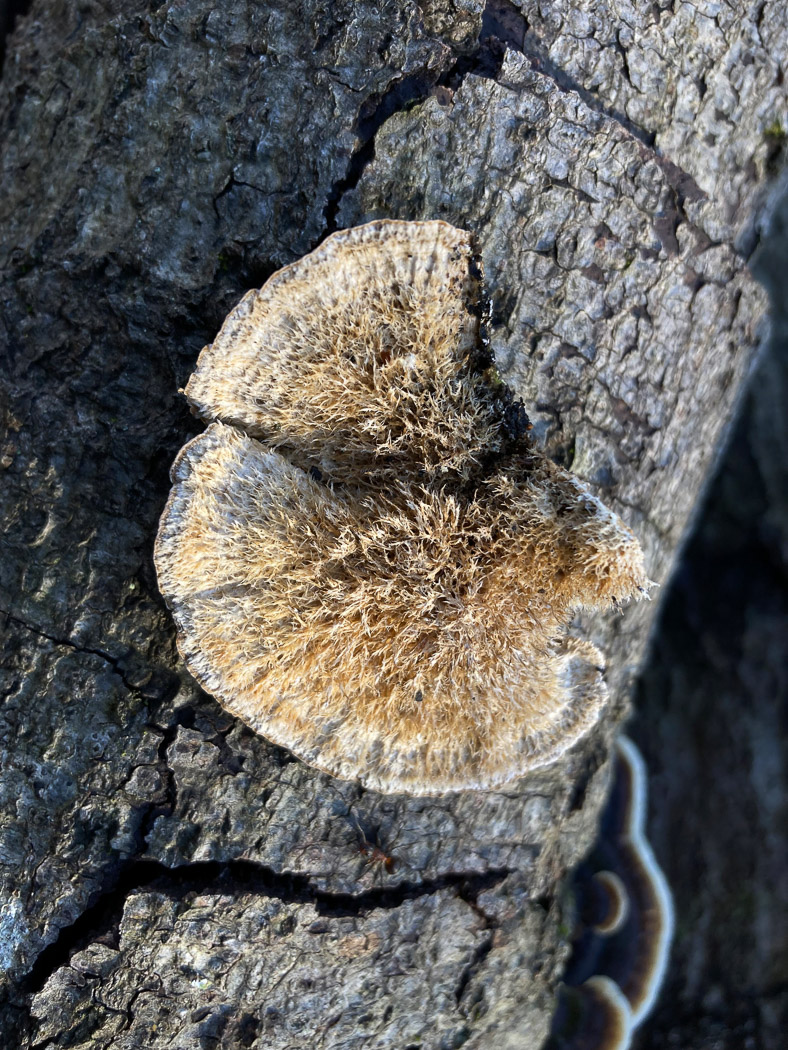
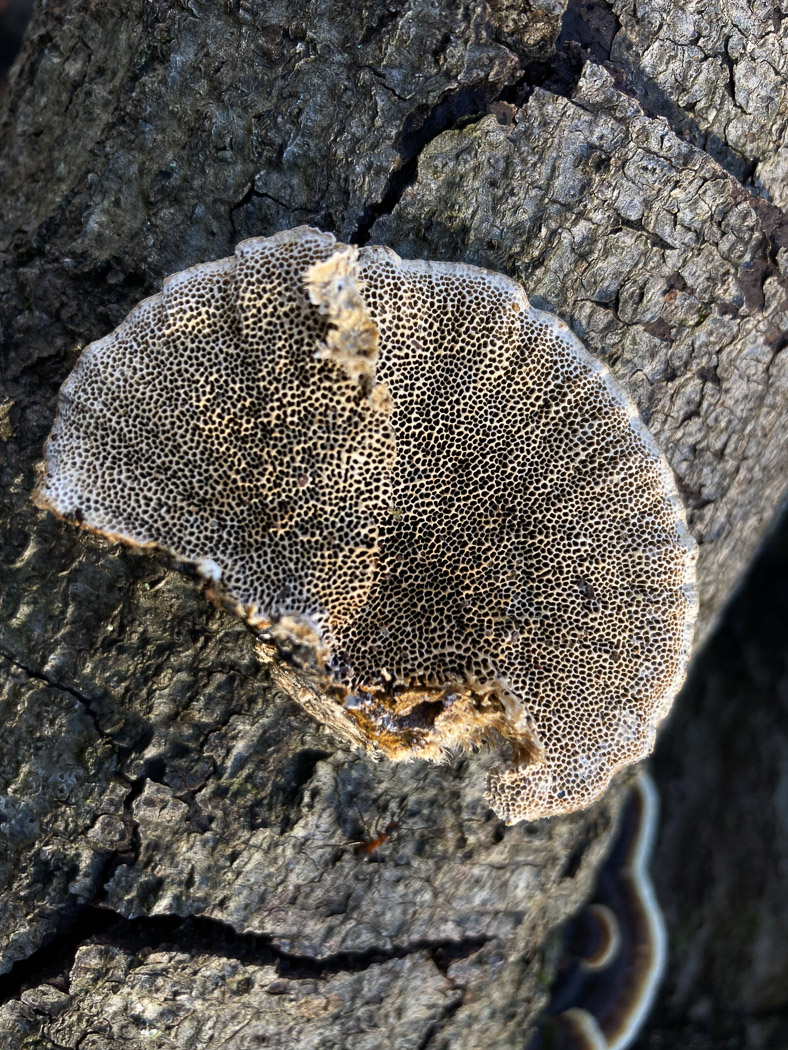 |
January 15th Trametes hirsuta (Hairy Bracket) 
On a Beech log in Burnham Beeches Russell Ness found this bracket and by process of elimination suggested this name to Penny though was unsure. Penny, however, feels fairly happy that this is correct: it is clearly different from the two common and more familiar Trametes species and favours Beech whereas the quite similar T. pubescens favours Birch and is downy rather than hairy. Please note this ID is not definite but likely!
|
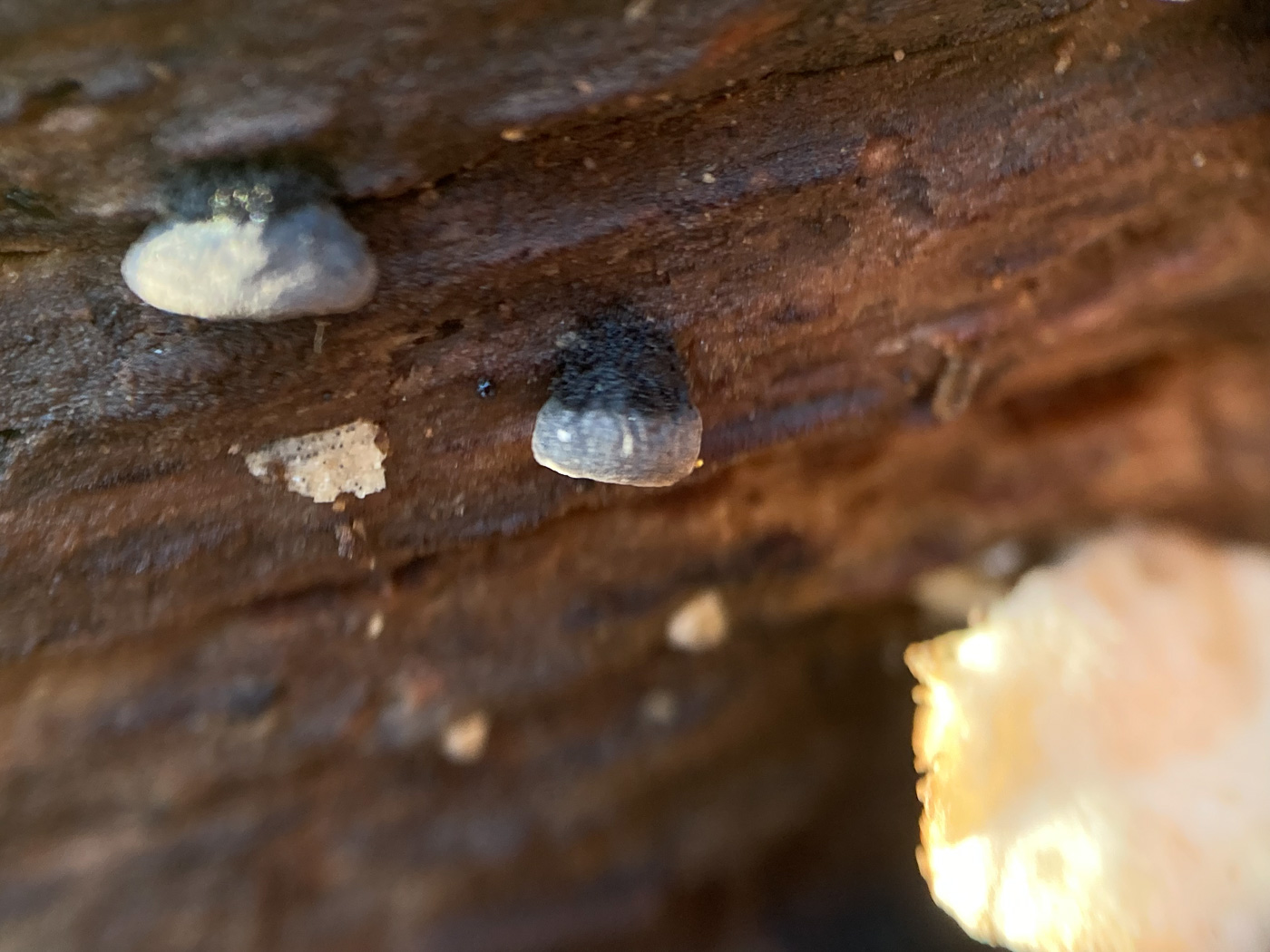
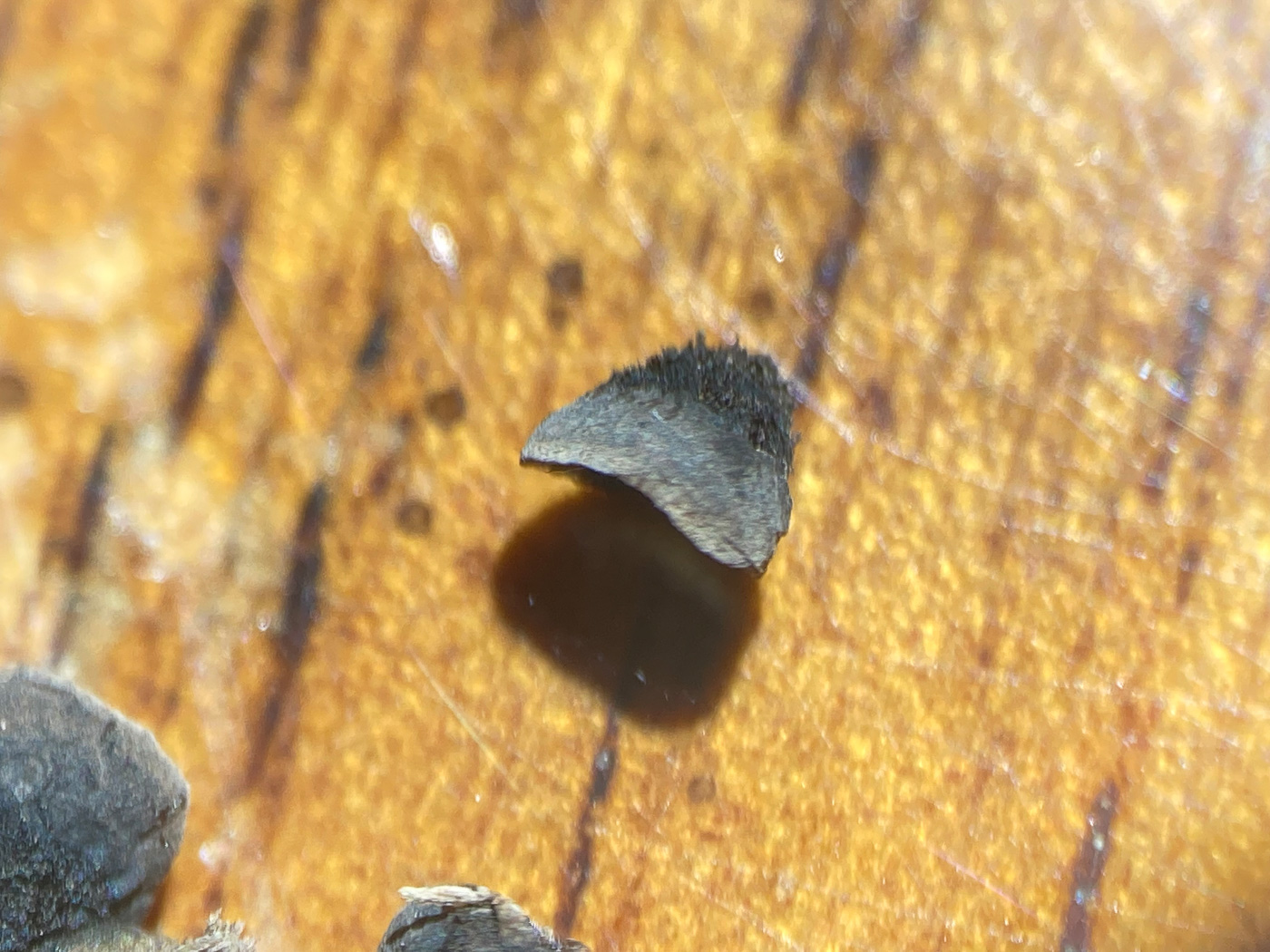
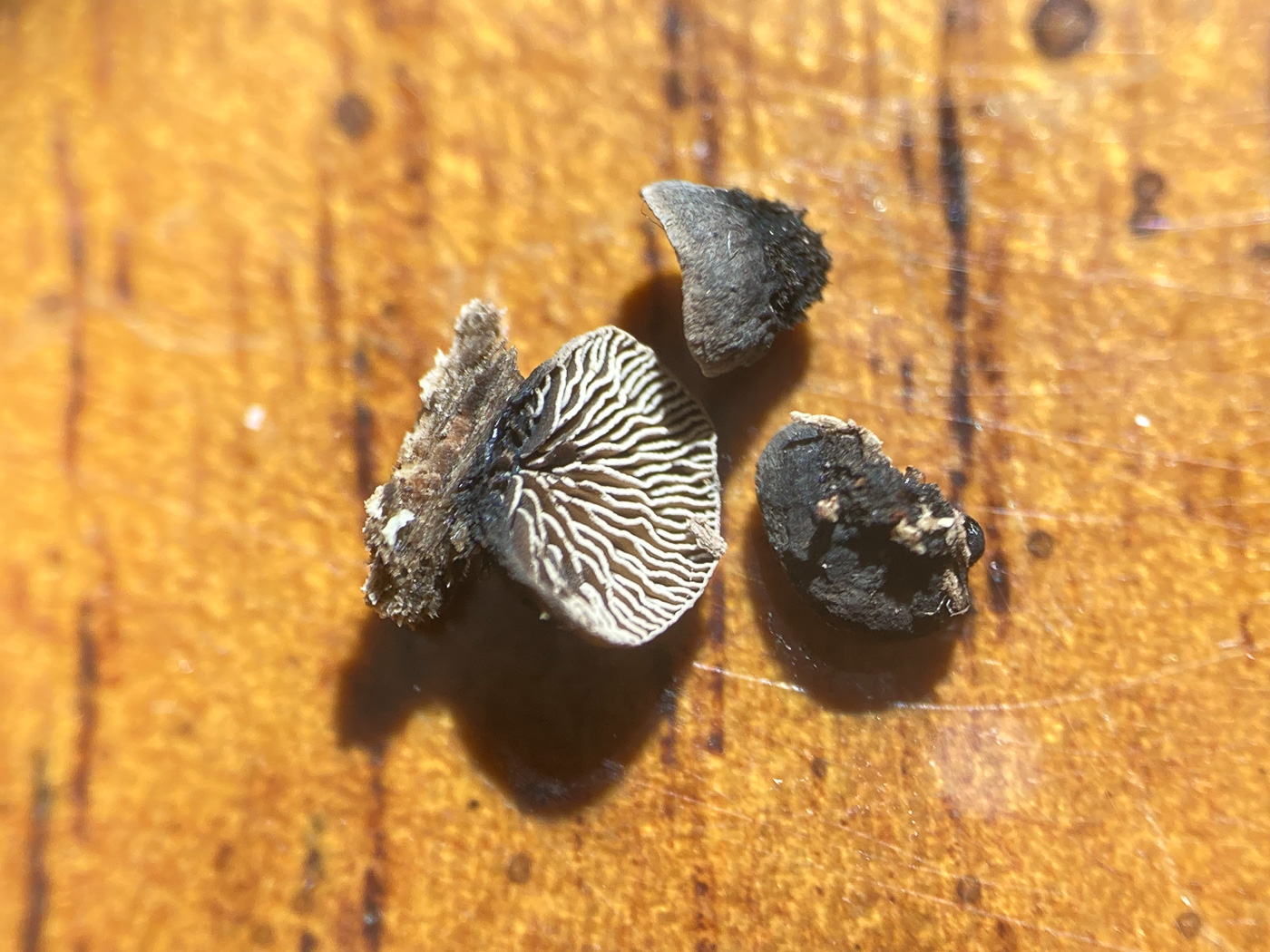 |
January 15th Resupinatus trichotis (an Oysterling with no common name) 
In Burnham Beeches on a fallen rotting Beech log Russell Ness noticed these tiny greyish fungi and took them home to work on. Similar to the genus Crepidotus in both size and shape, Resupinatus is a small genus with grey rather than white fbs, under 1 cm across, with two species which occur on deciduous woods - today's being much less commonly recorded than R. applicatus. Note the hairy black area near where it joins the substrate - this being indicative of the species and lacking in the commoner species though the two can be hard to separate and both have similar sized spores. To compare, see Finds 2020 Feb 3rd for an earlier collection of this species, also 2021 November 7th for R. applicatus.
|
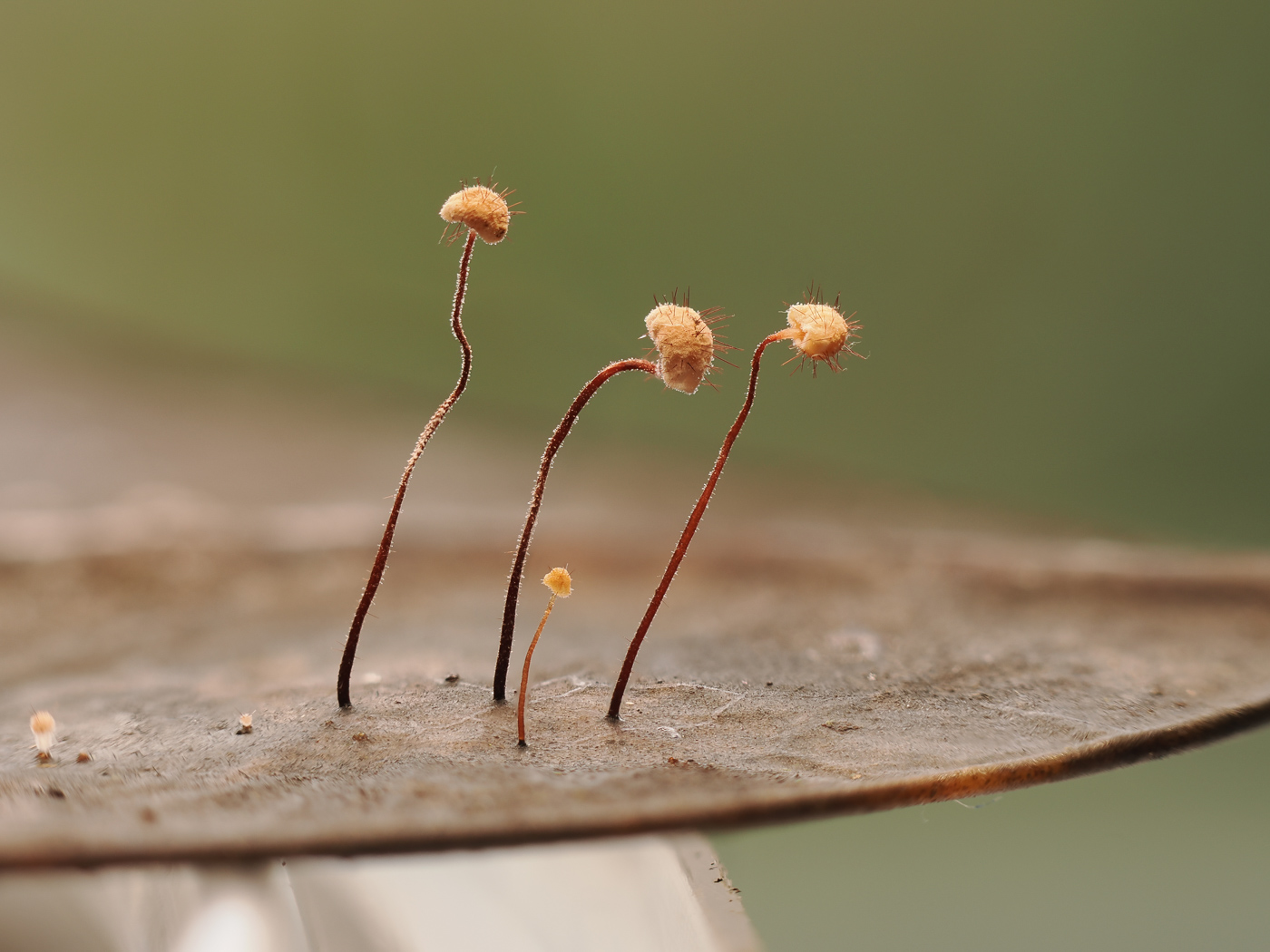
 |
January 15th Marasmius hudsonii (Holly Parachute)
After all our recent rain Penny was not surprised to hear reports of this quite rare species fruiting in abundance at Naphill Common, found by Sarah Ebdon and Claire Williams. It only grows on rotting soggy Holly leaves - often in ditches and wet places - but now seems to be spreading in our area where it was new to the county from Naphill only few years ago. The species is tiny therefore easily missed but searching under Holly bushes now might well reap rewards; if viewed with a x10 lens it is unmistakeable with its unique reddish spines covering the cap. The photos here are Claire's. See the Masterlist for other wonderful images.
|
January 13th 2023
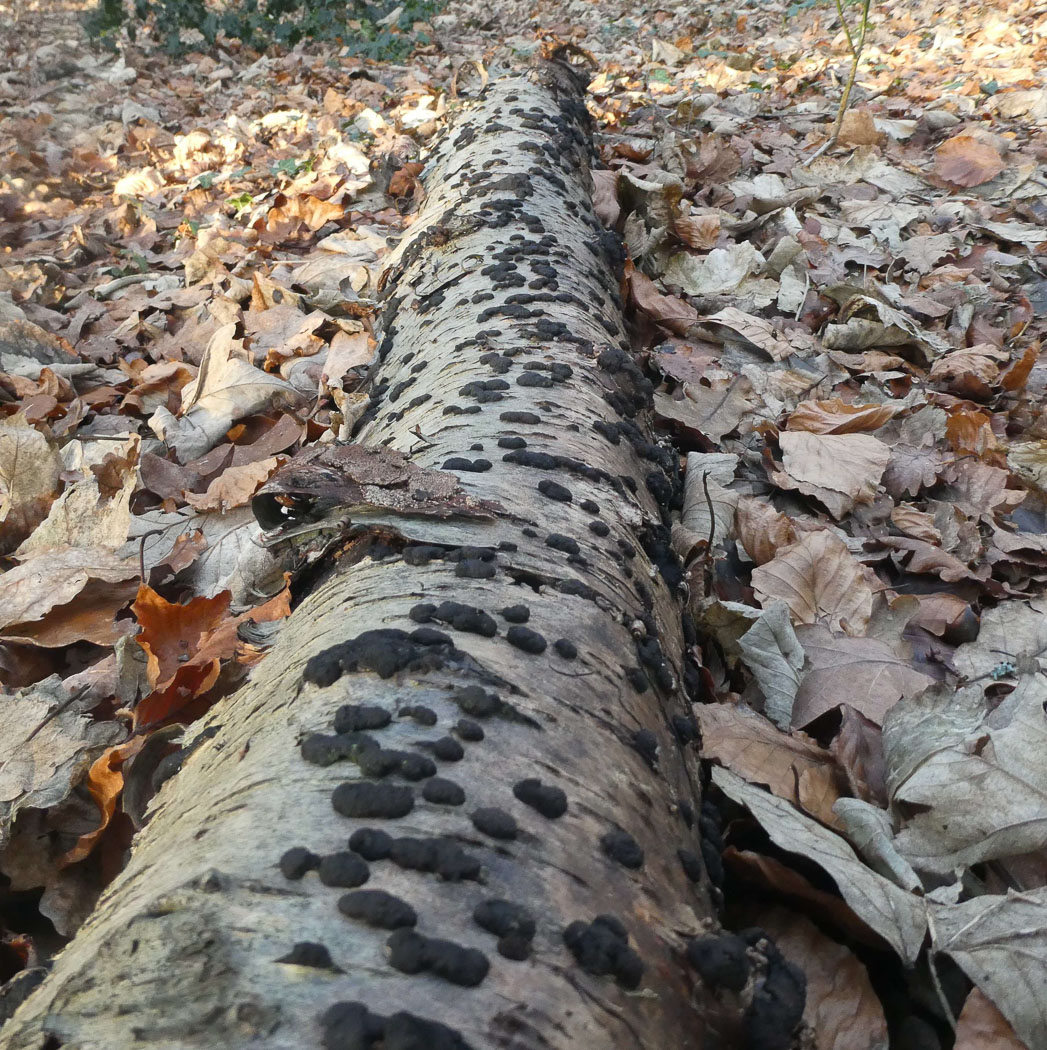
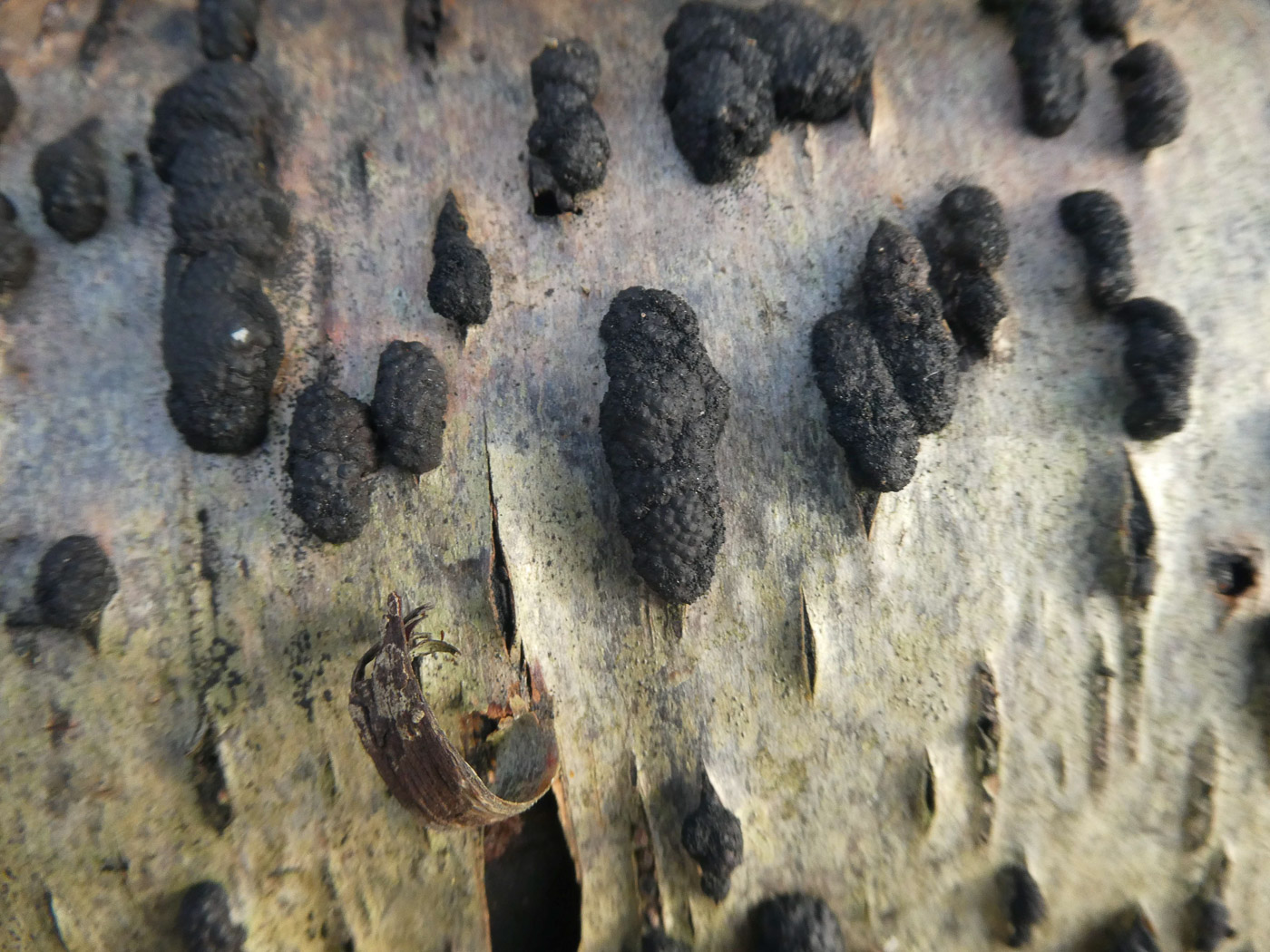
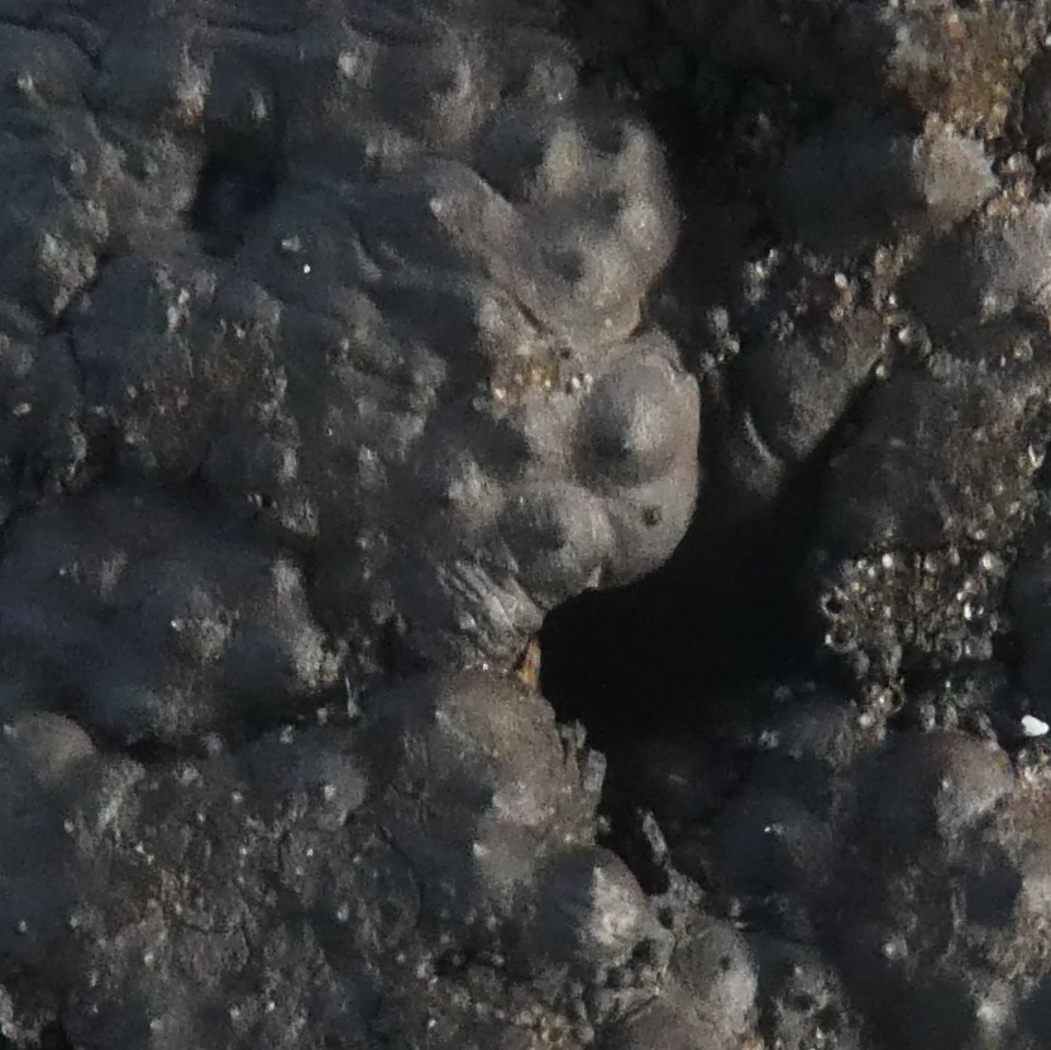 |
January 13th Jackrogersella multiformis (Birch Woodwart)
In woodland near Chalfont St. Peter Jim Wills noticed this common Pyrenomycete on fallen Birch. Recently split from the genus Hypoxylon - where the equally familiar H. fragiforme (Beech Woodwart) and H. fuscum (Hazel Woodwart) remain - it is easily separated from them in the field by its different shape seen clearly in photo 2: more elongated rather than round and in places merging together. Each species is host specific as described in their common names which also helps with ID. See also in Finds 2020 November 30th and 2022 January 17th.
|
January 11th 2023
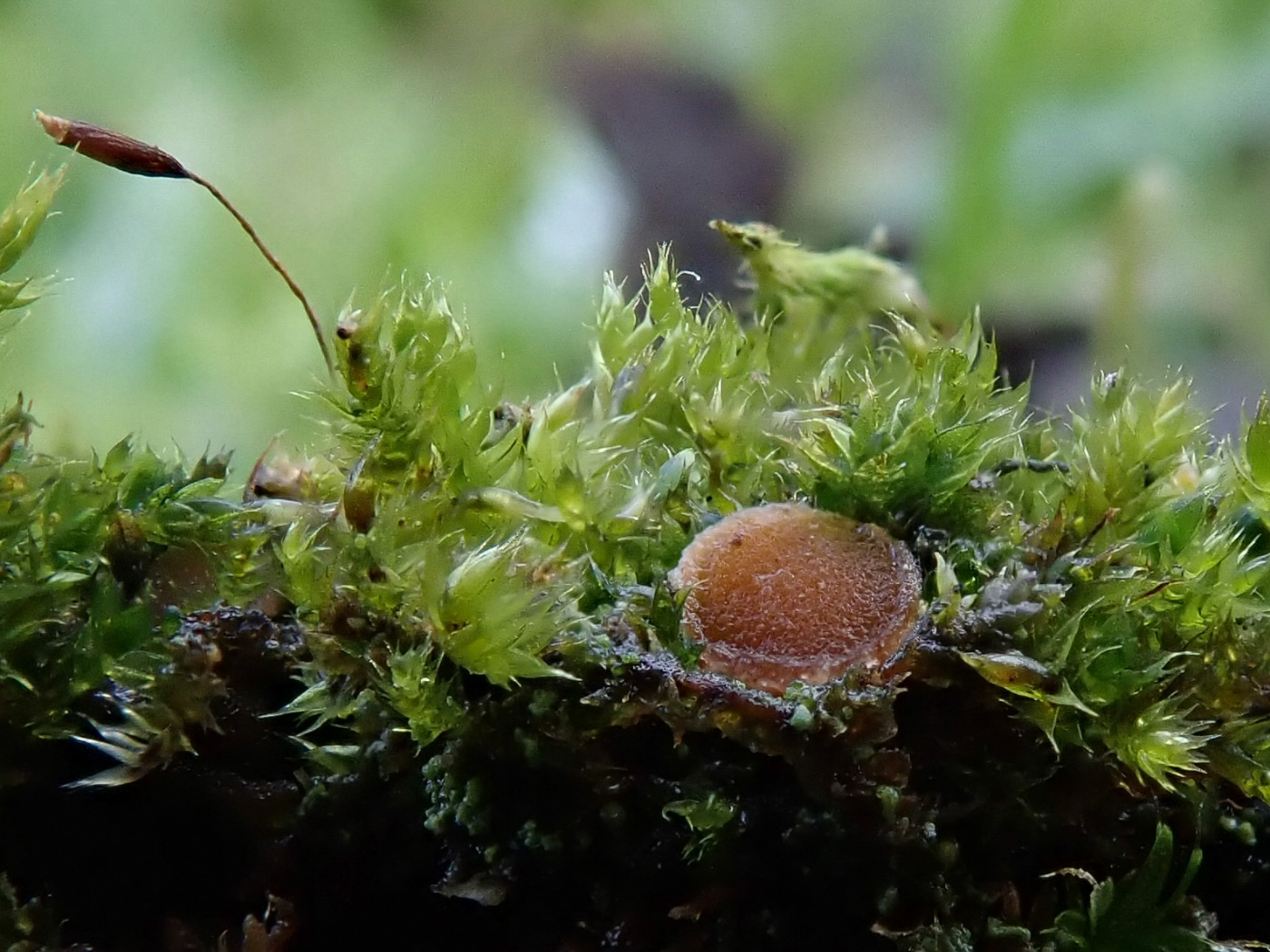
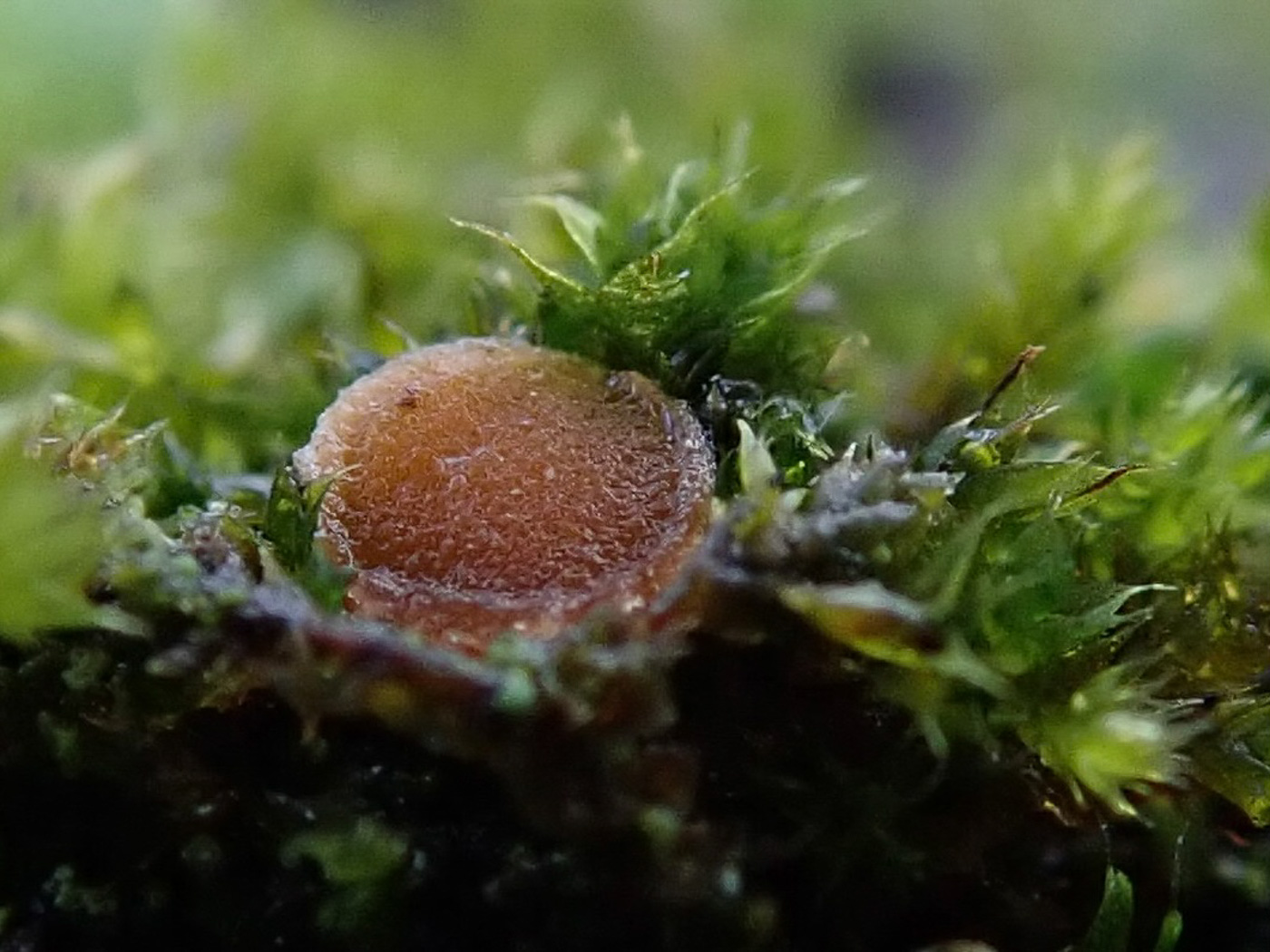 |
January 11th Octospora sp. bryum-capillare (an as yet undescribed Ascomycete) 
In Lacey Green Churchyard Sarah Ebdon spotted this tiny cup fungus - only 3mm across - lurking in moss on a tombstone. Having taken advice and help from various sources to identify both it and the moss species - critical with this often host-specific genus - it turns out to be an unnamed species of Octospora, close to O. coccinea which is known to be a species complex yet to be fully resolved. It is apparently quite frequent in Europe wherever the moss Bryum capillare is found - hence suspected of being host specific with it - and is known from the UK where expert George Greiff (who Sarah contacted) is familiar with it. This is a significant find and we hope to get a sample sequenced.
|
January 9th 2023

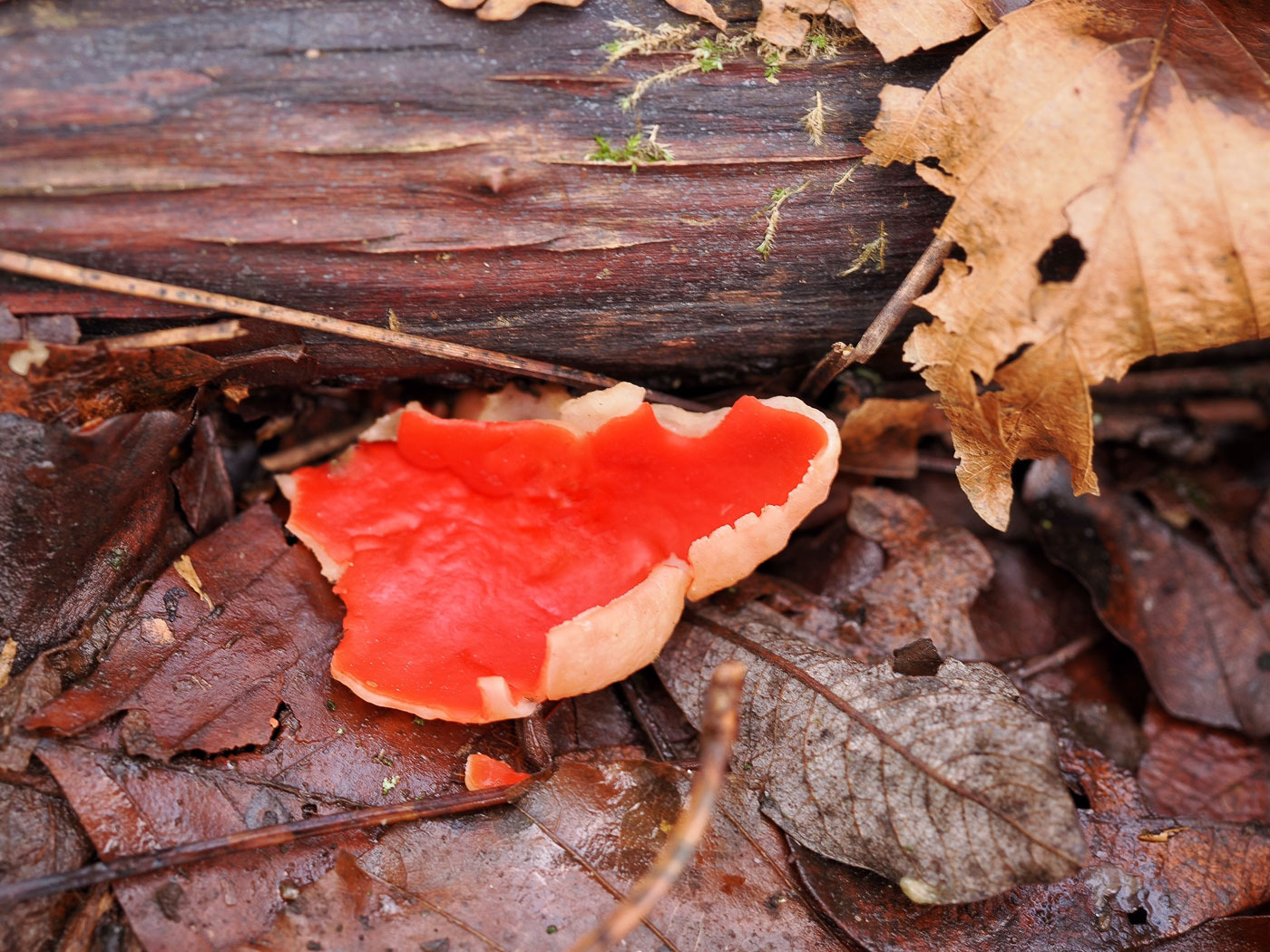 |
January 9th Sarcoscypha austriaca (Scarlet Elfcup)
Penny's been waiting for someone to find this early springtime species and send it in: here it is from Dancersend, found by Paul Goby - something to brighten these dingy soggy days which seem to be endless at the moment. We have quite a few previous entries (see the Masterlist) but you can never have too many and these are particularly splendid. Photo 2 is of a slightly damaged fruitbody found by Claire Williams just a week later in Downley Common.
|
January 8th 2023
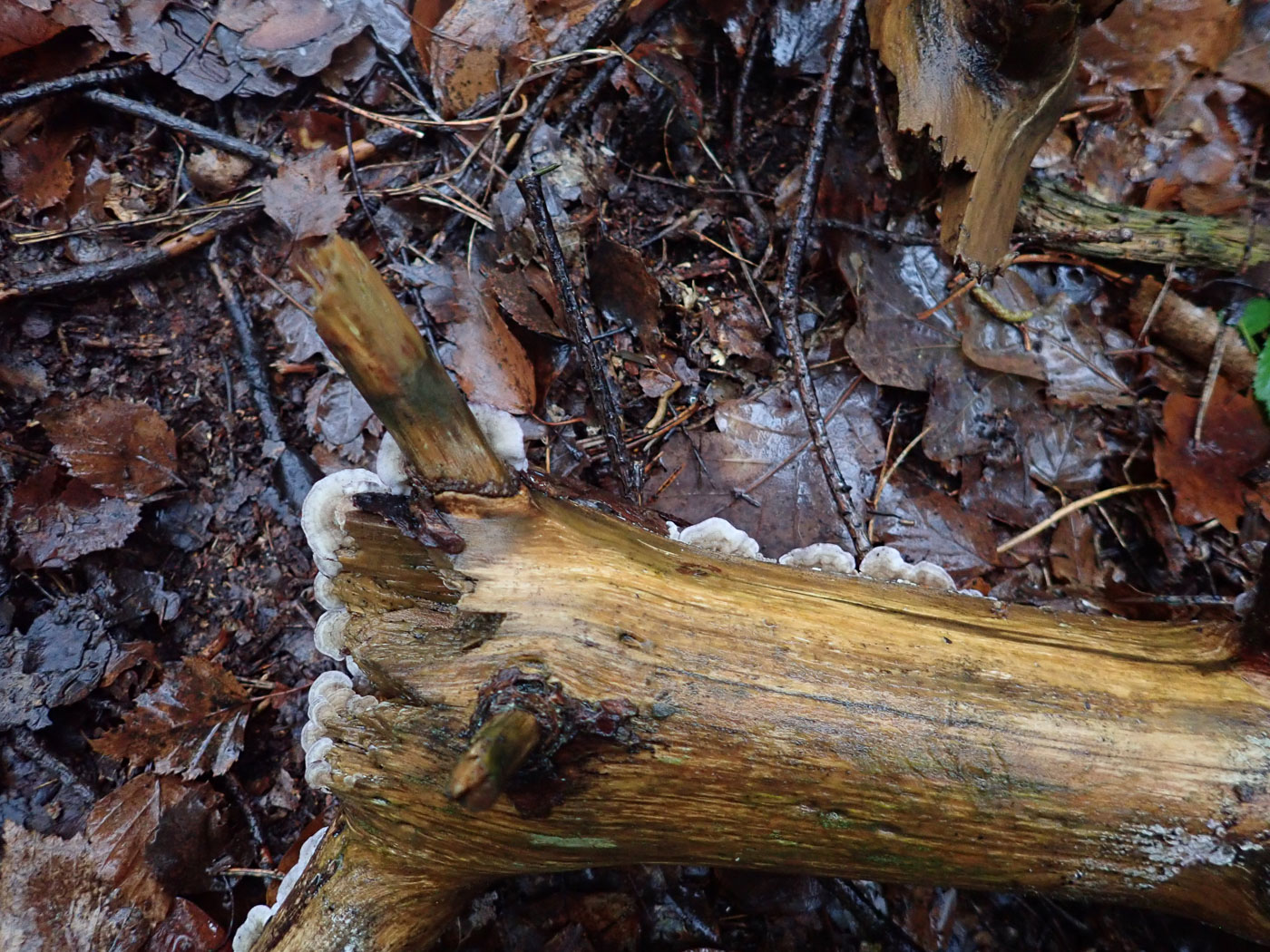
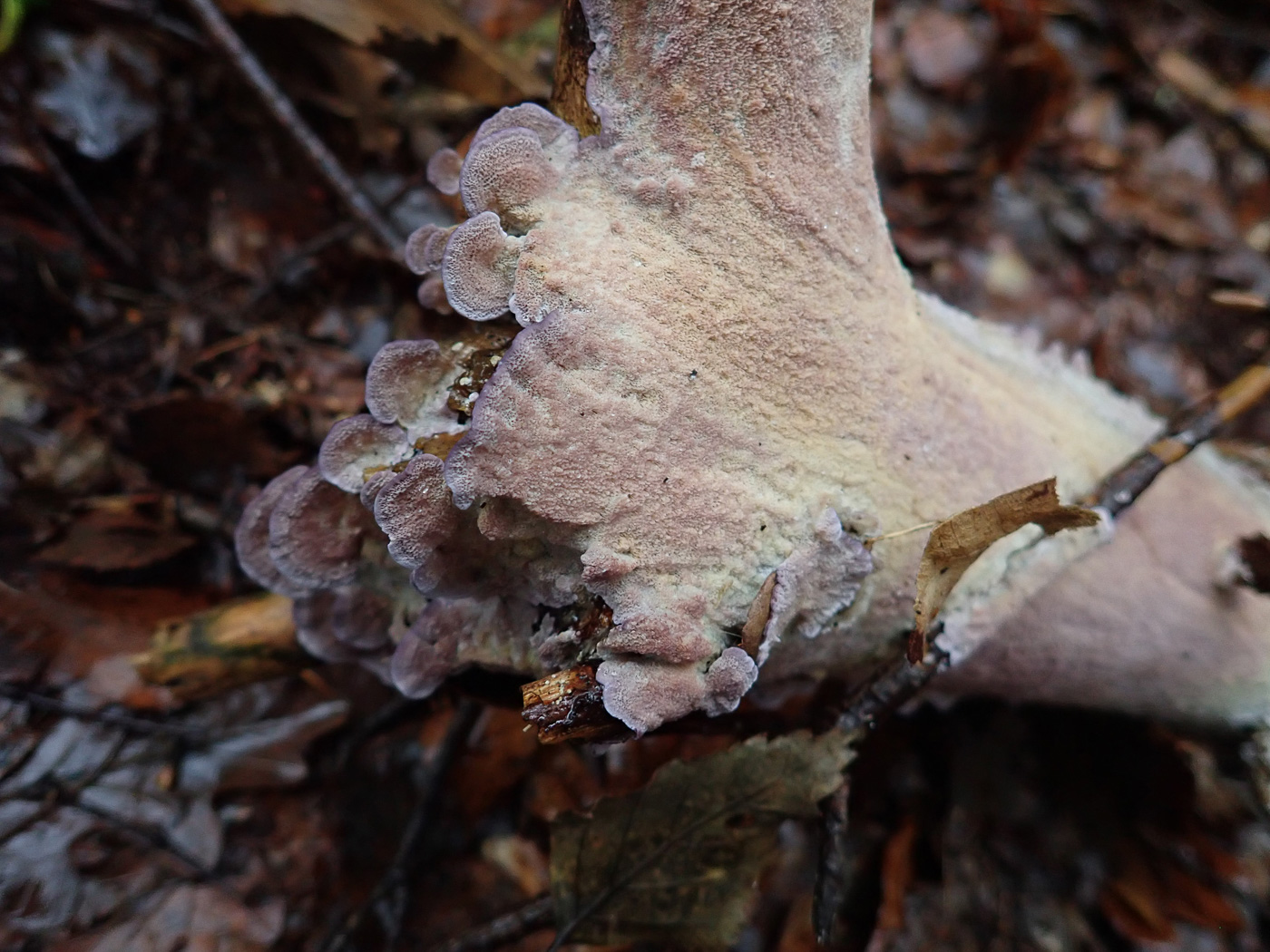 |
January 8th Trichaptum abietinum (Purplepore Bracket)
At Burnham Beeches Penny spotted some small brackets at the base of a bare Pine log (photo 1) and turned it over to confirm the purple tinged underside of this common conifer species. It was spreading partly resupinate along the log (including over the deciduous stick crossing it), and the typical small brackets had developed right at the end. Despite its name suggesting an association specifically with Fir, it is in fact equally common on any dying or fallen conifer. We appear to have only one previous Finds entry: 2020 November 7th.
|
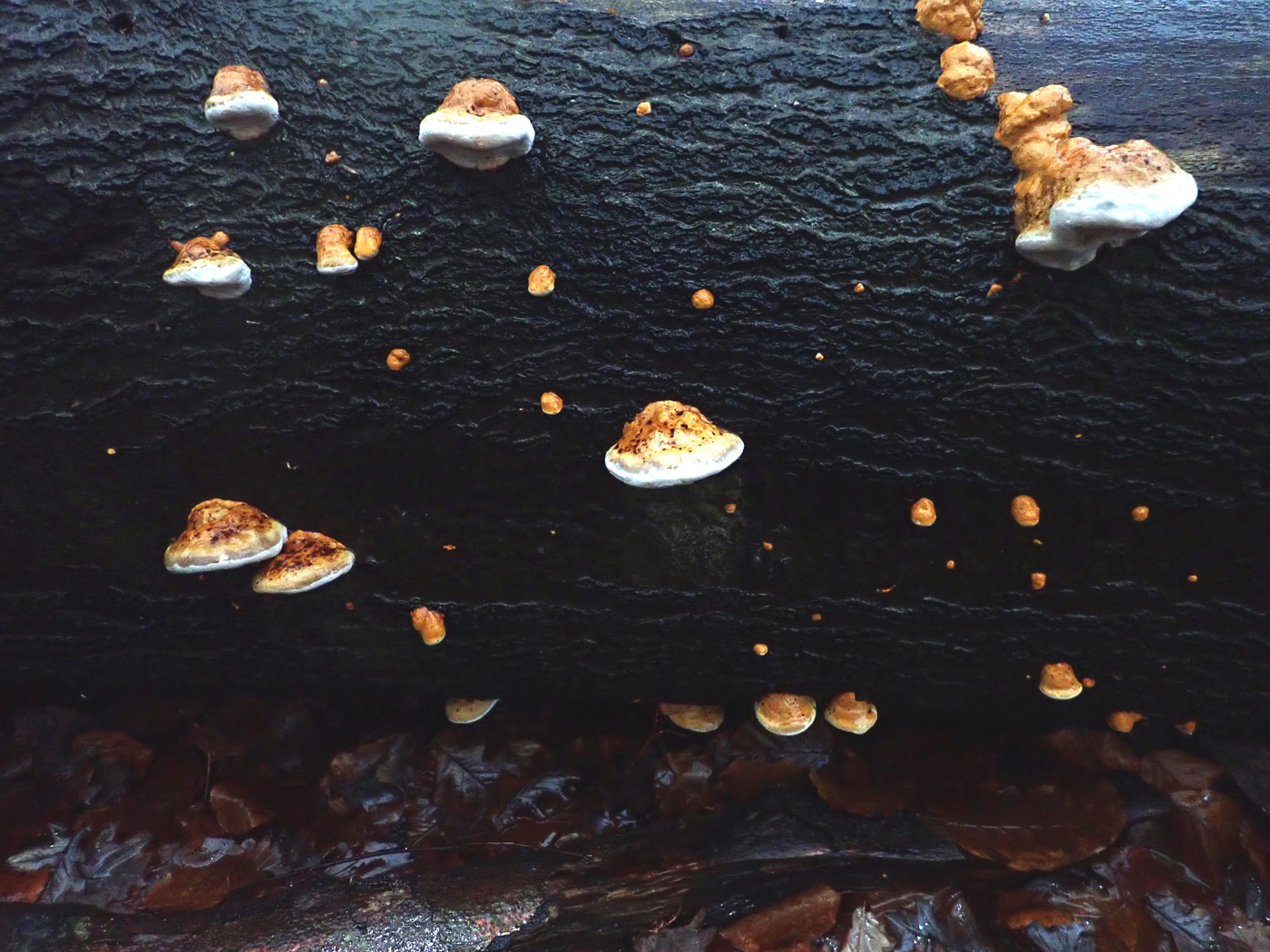
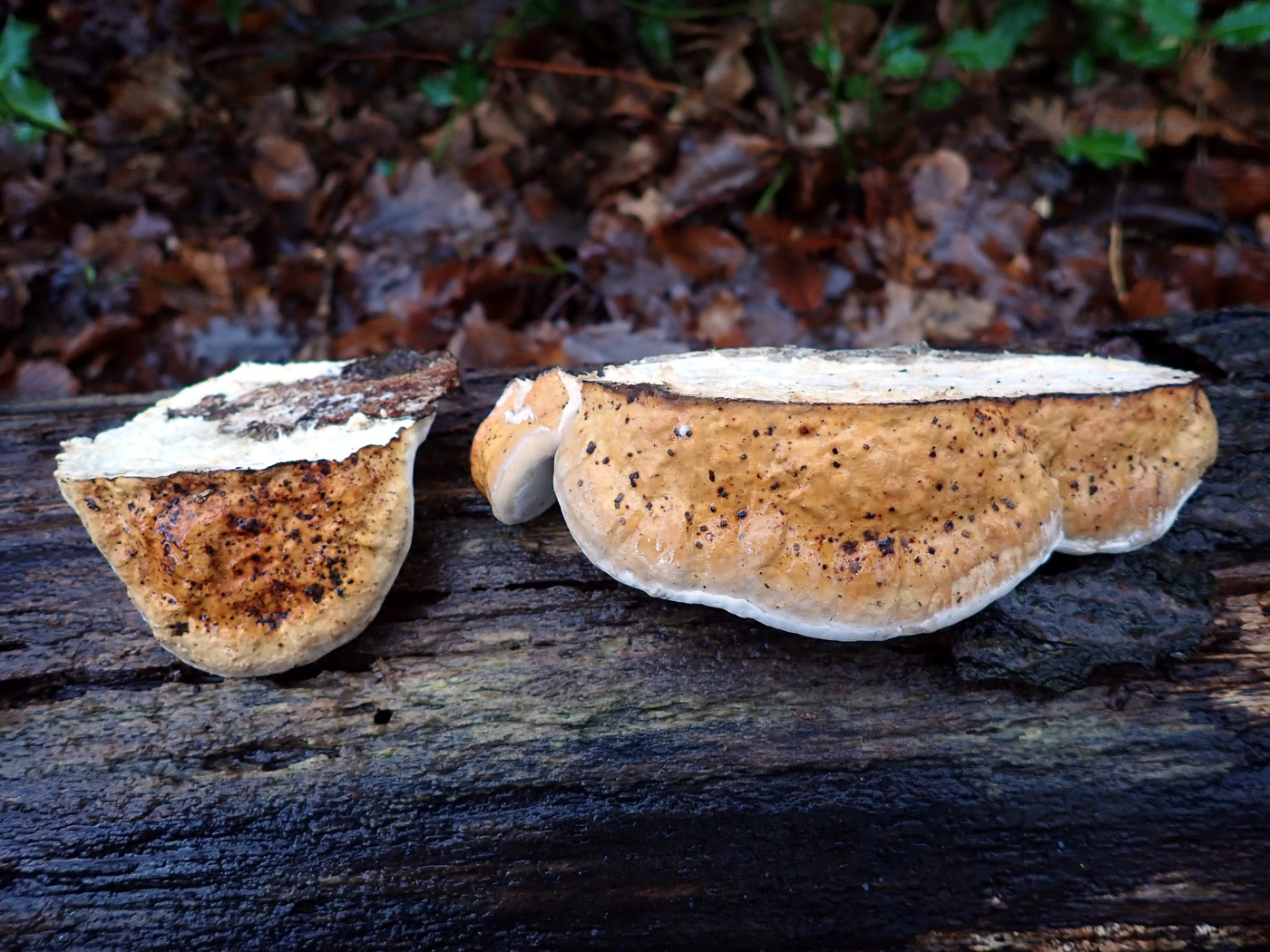
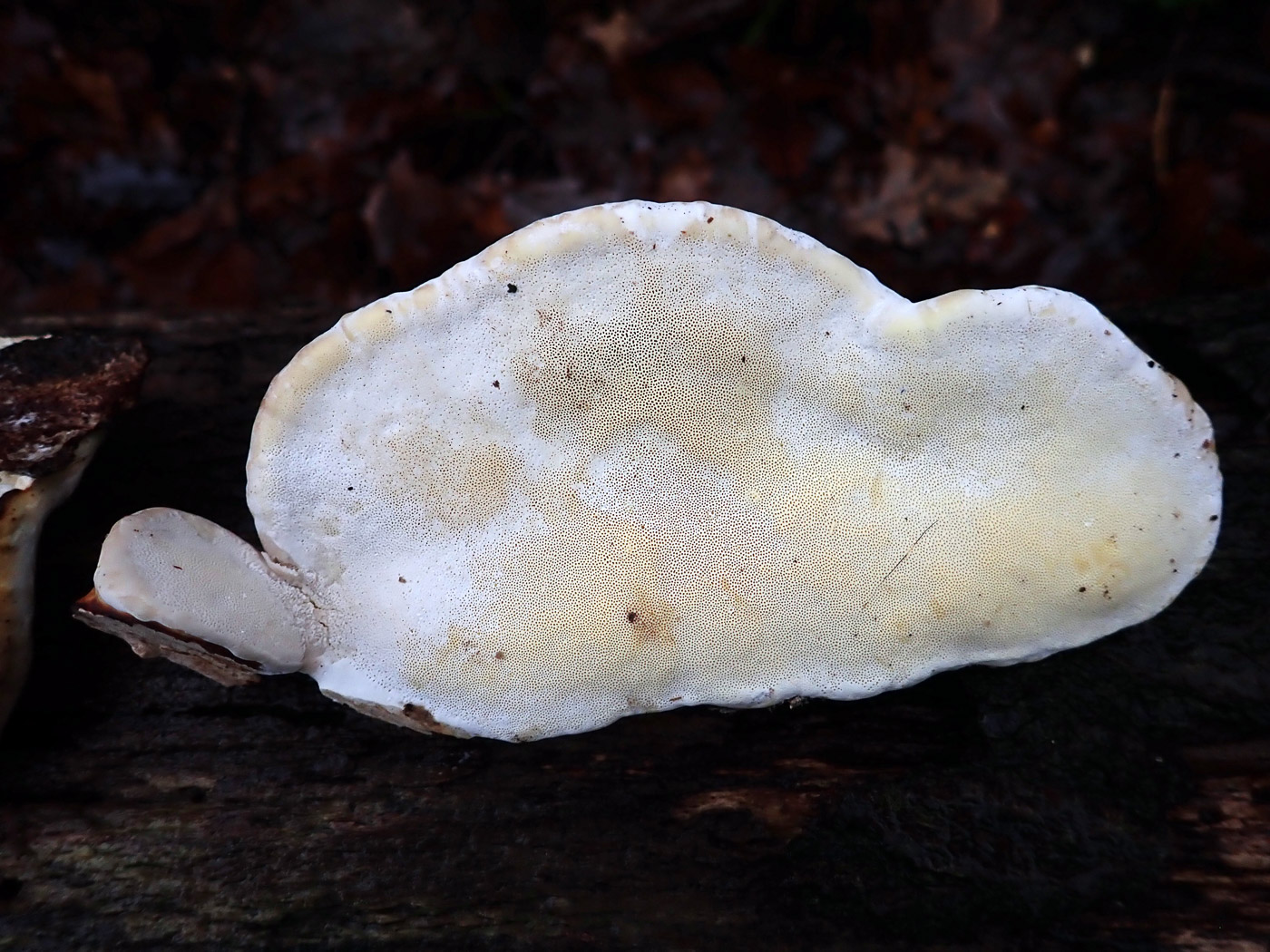
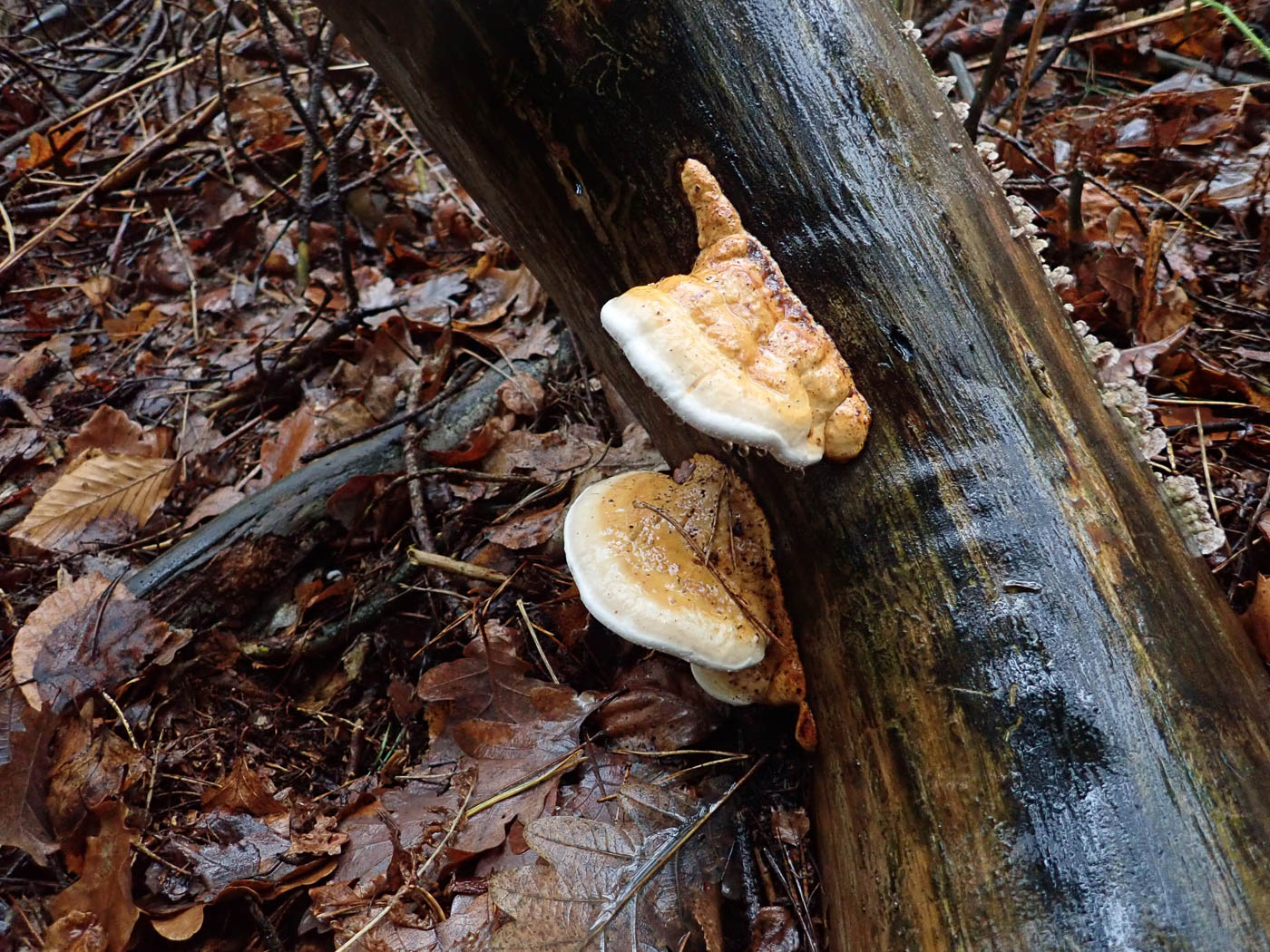 |
January 8th Fomitopsis pinicola (Red-belted Bracket)
Our entry for this species a few days earlier prompted Penny to go and inspect the large Beech trunk in Burnham Beeches where we'd found rather strange-looking examples of it quite recently (see Finds 2022 November 20th). She found it still fruiting profusely, showing a mix of immature brown blobs, smallish hoof-shaped brackets and a couple of larger ones which had been broken off and which served to show the pale yellowish underside (photos 2 and 3). None, however, had as yet developed the characteristic reddish band around the rim, all in fact had a white outer band. Later she came across some fallen Pine sporting the same species yet again (photo 4). Clearly this is a bracket we're going to come across commonly so need to become familiar with all its different stages.
|
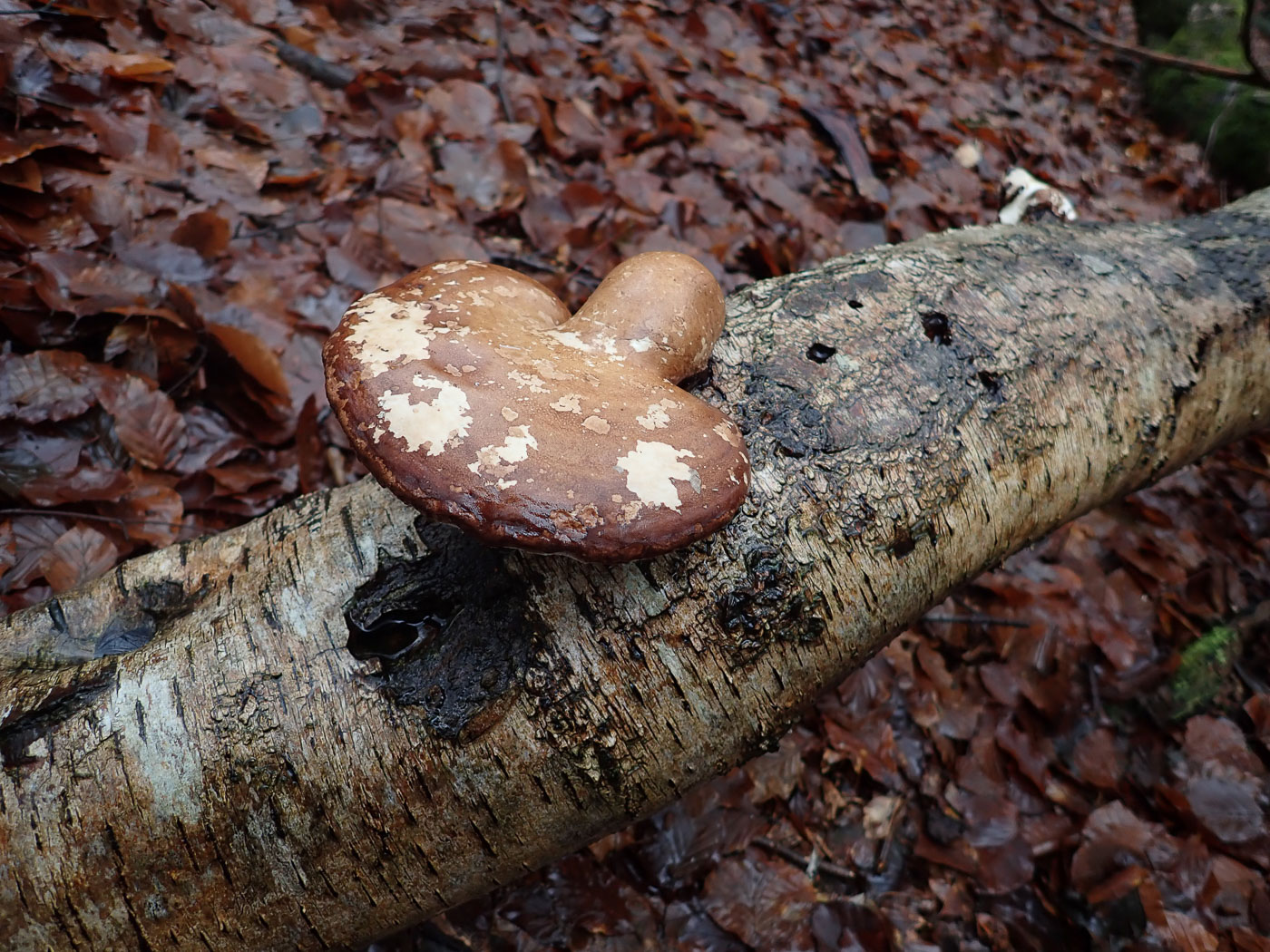
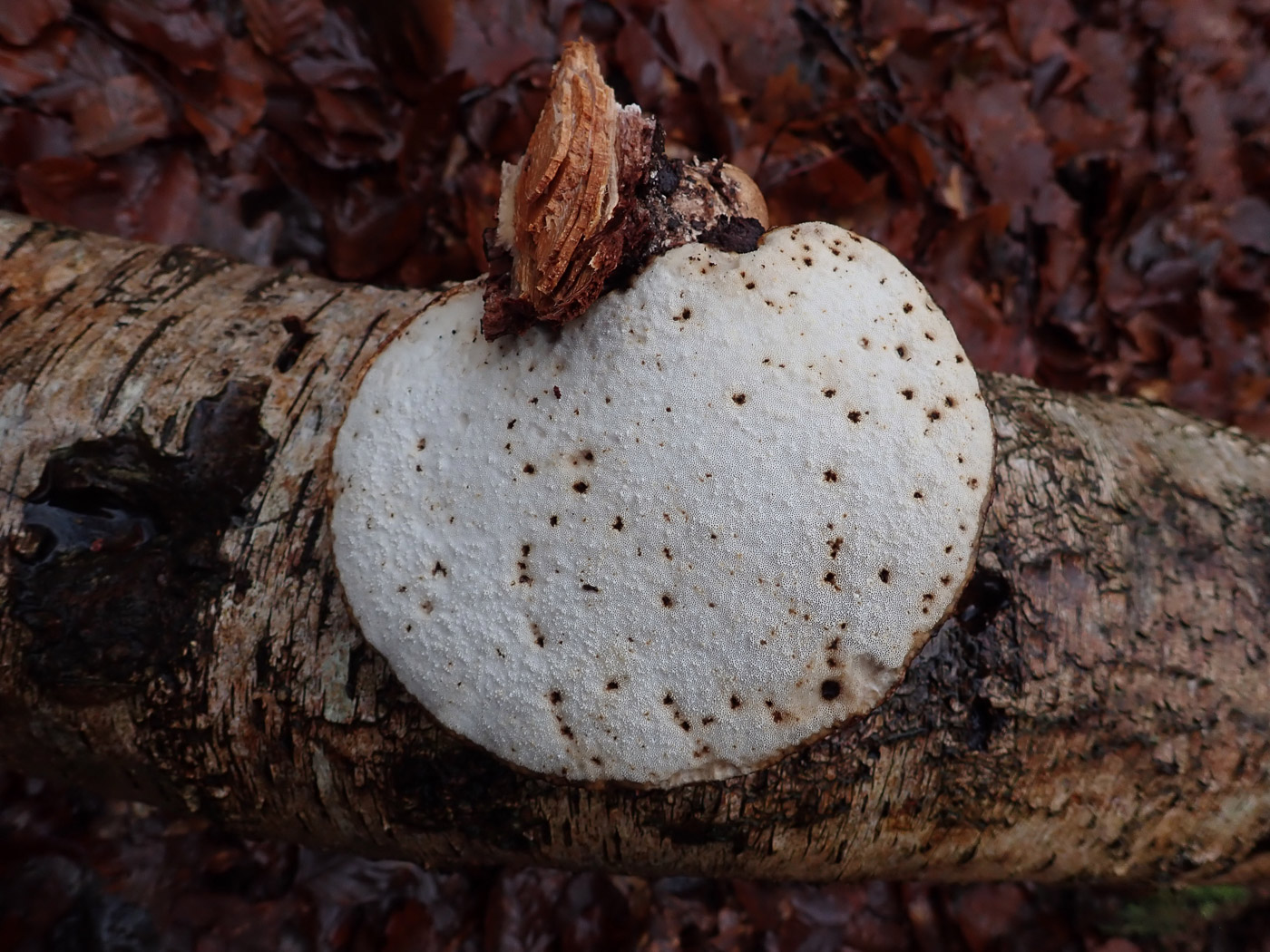
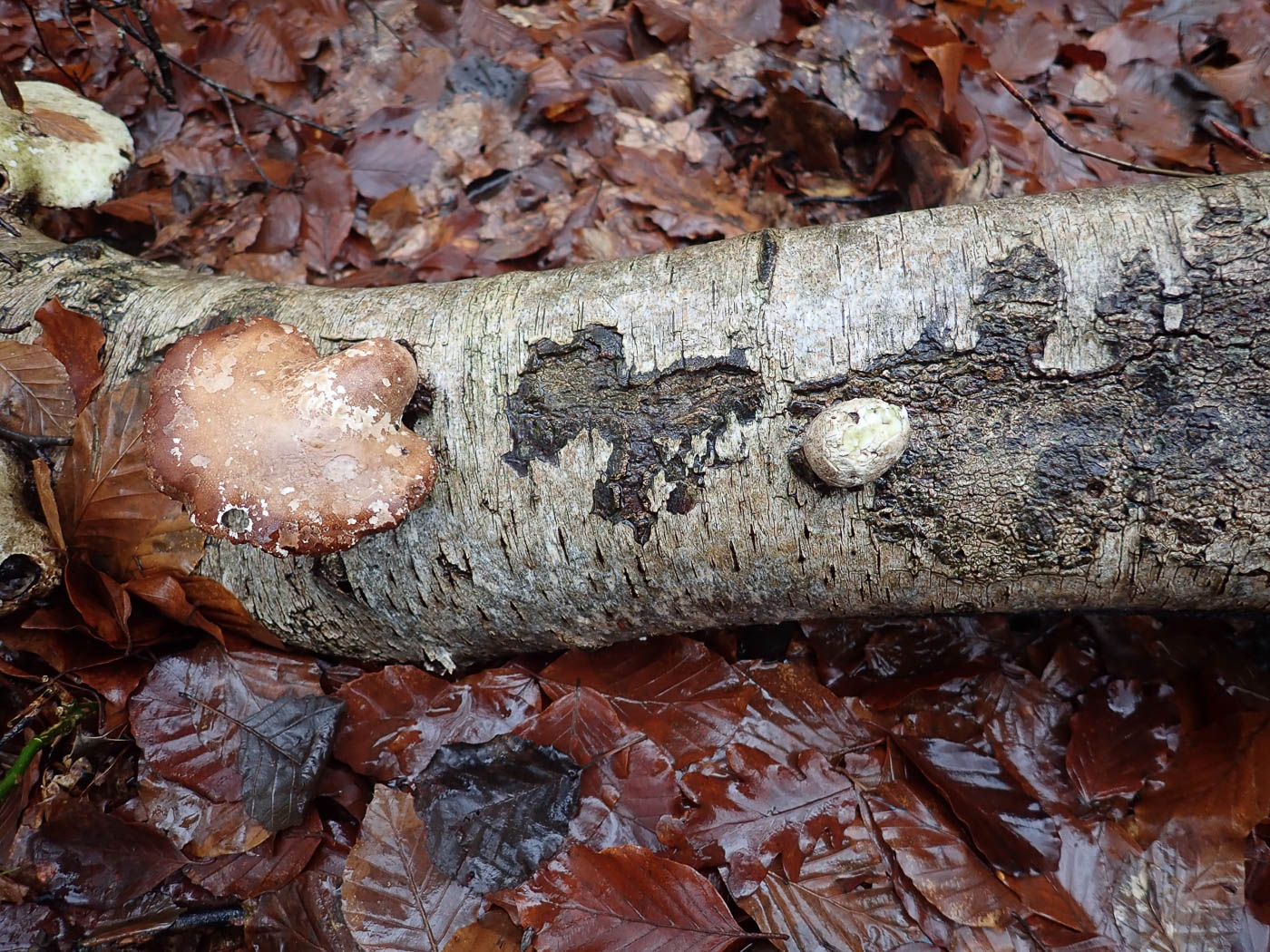 |
January 8th Fomitopsis betulina (Birch Bracket)
On fallen Birch at Burnham Beeches Penny saw many examples of this species - one of our commonest brackets though one which seems to get confused in the field with Ganoderma or (when just developing) even Lycoperdon (Puffball)! Previously in genus Piptoporus, its mature shape seen here (photo 1) is typical, also slightly spongy to the touch unlike the somewhat hard Ganoderma, also the very fine pores underneath (photo 2) remain pale when damaged / scratched unlike the instant brown staining of Ganoderma - the marking seen here are insect damage. Photo 3 shows another smaller bracket, also a much smaller white undeveloped 'button' - still the same species and not a Puffball! See the Masterlist for several other entries.
|
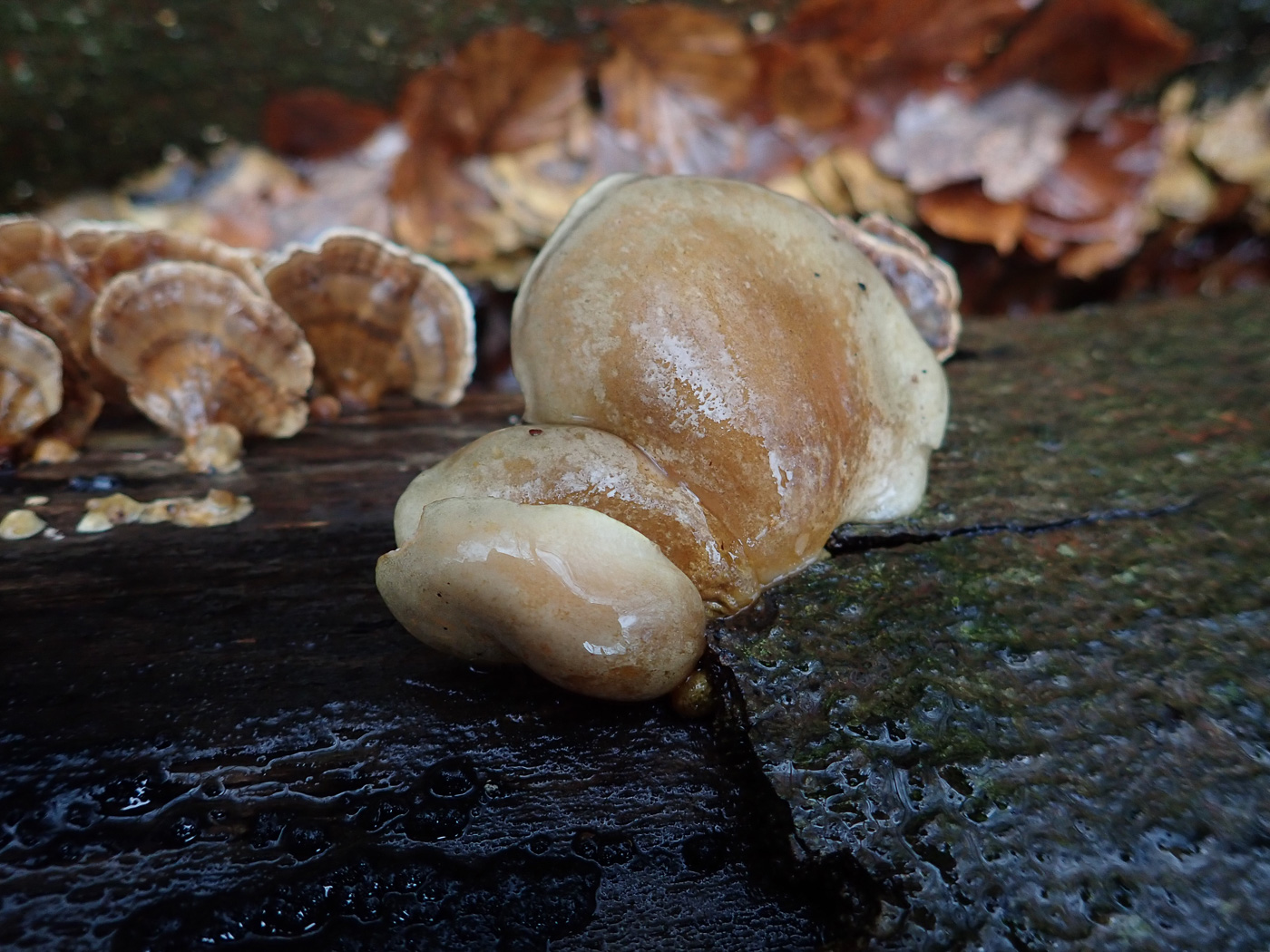
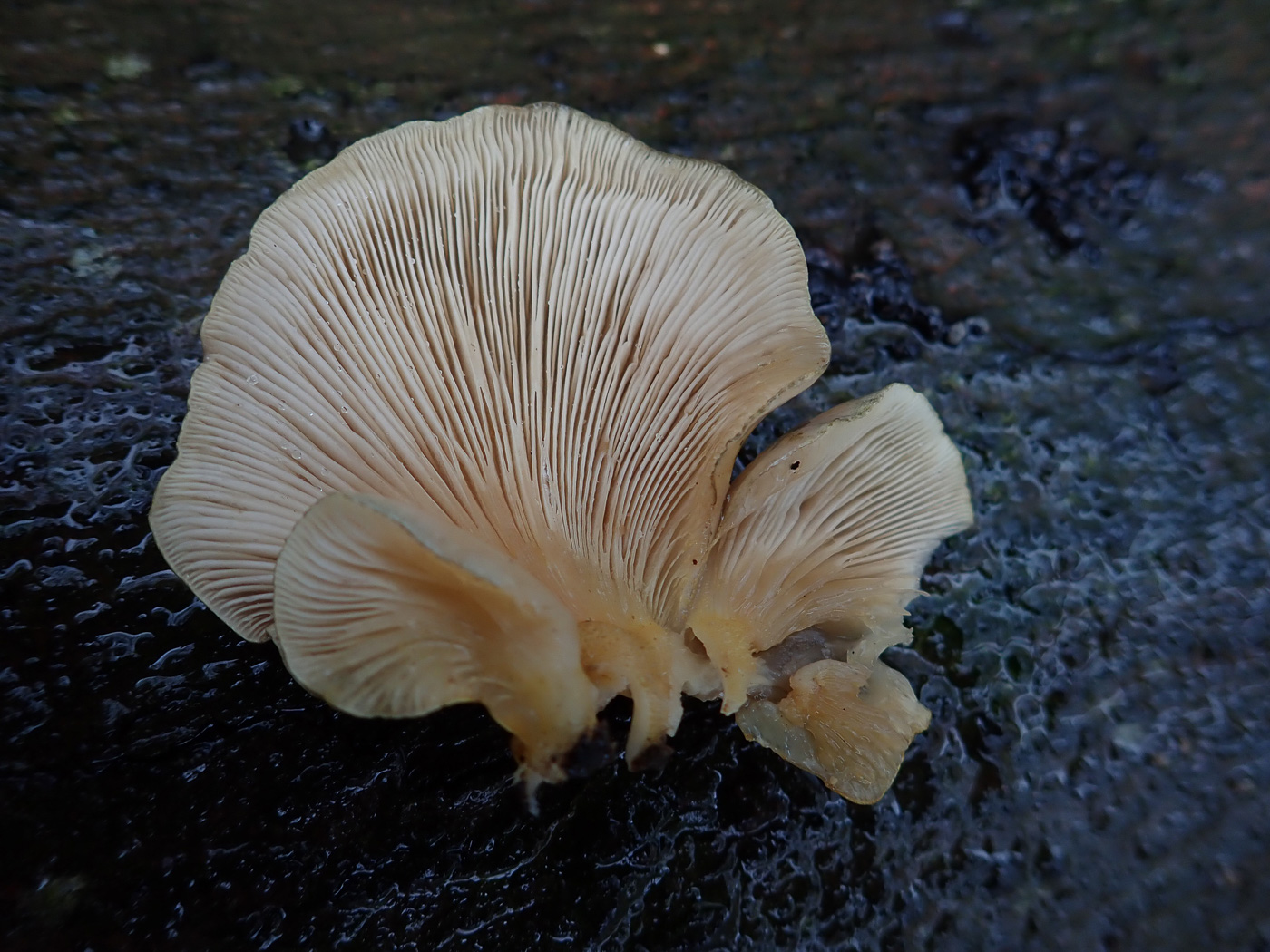 |
January 8th Sarcomyxa serotina (Olive Oysterling)
On a rain-drenched fallen Beech trunk at Burnham Beeches Penny noticed a single cluster of this typically late season species amongst other brackets - seen here just above a line of rather pale Trametes versicolor (Turkeytail). Previously in genus Panellus, when somewhat washed out and having lost much of its greenish olive tints as here it is easy to mistake for Pleurotus ostreatus, being about the same size and shape, though the underside (photo 2) is more pinkish ochre beige which helps to distinguish it. We only find it occasionally, usually in wintertime, and when fresh and in good condition the upper surface can be a beautiful shade of green. See also in Finds 2020 October 30th and 2022 January 3rd.
|
January 7th 2023
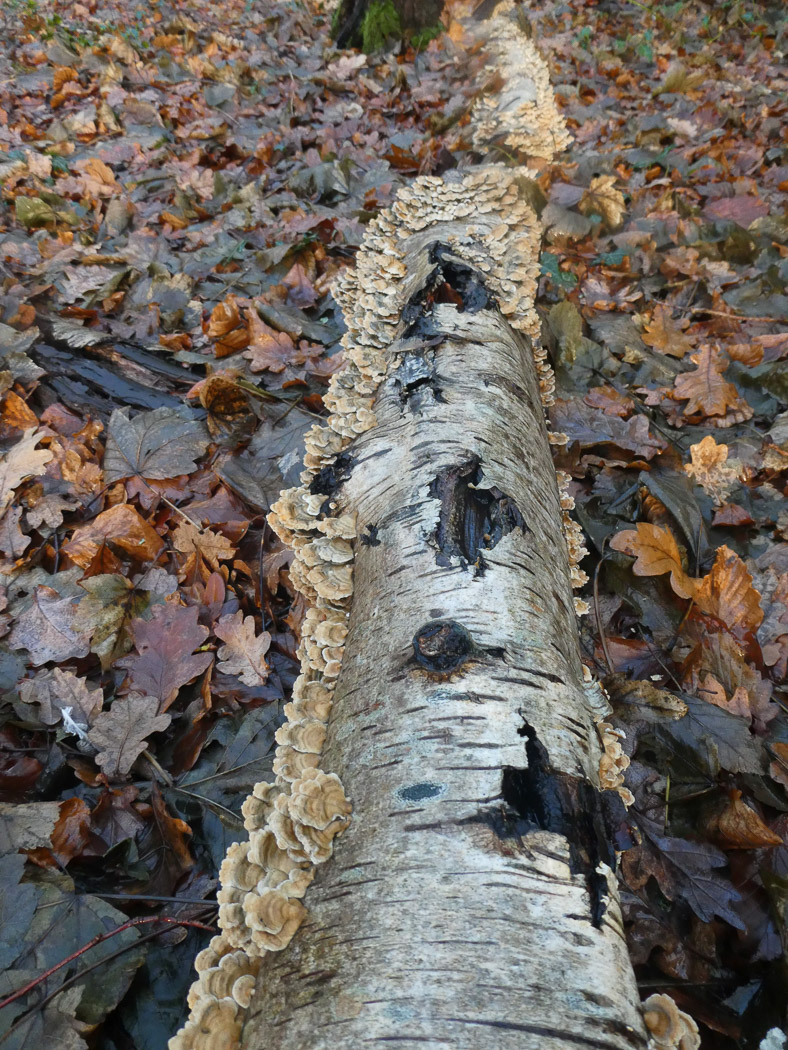
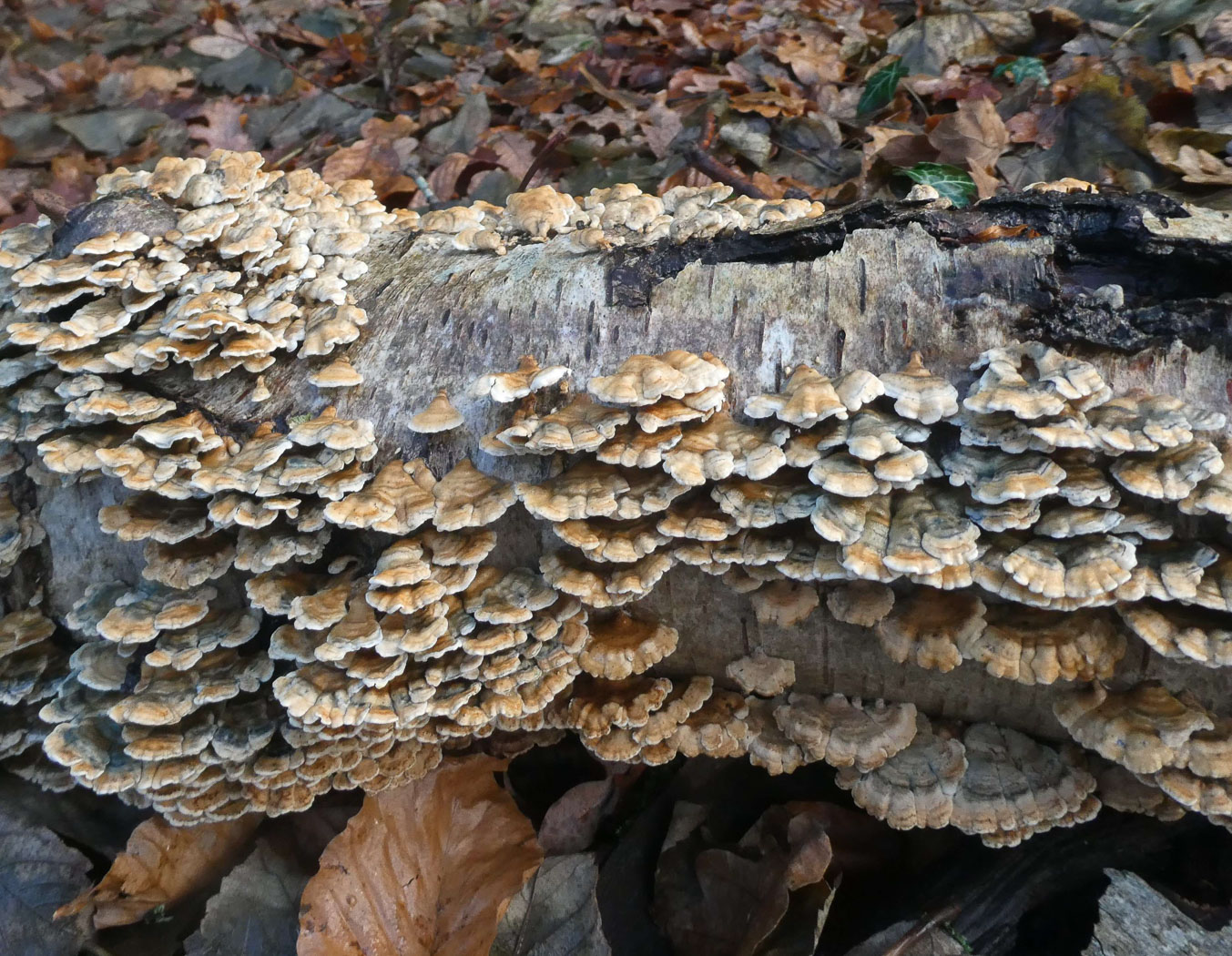
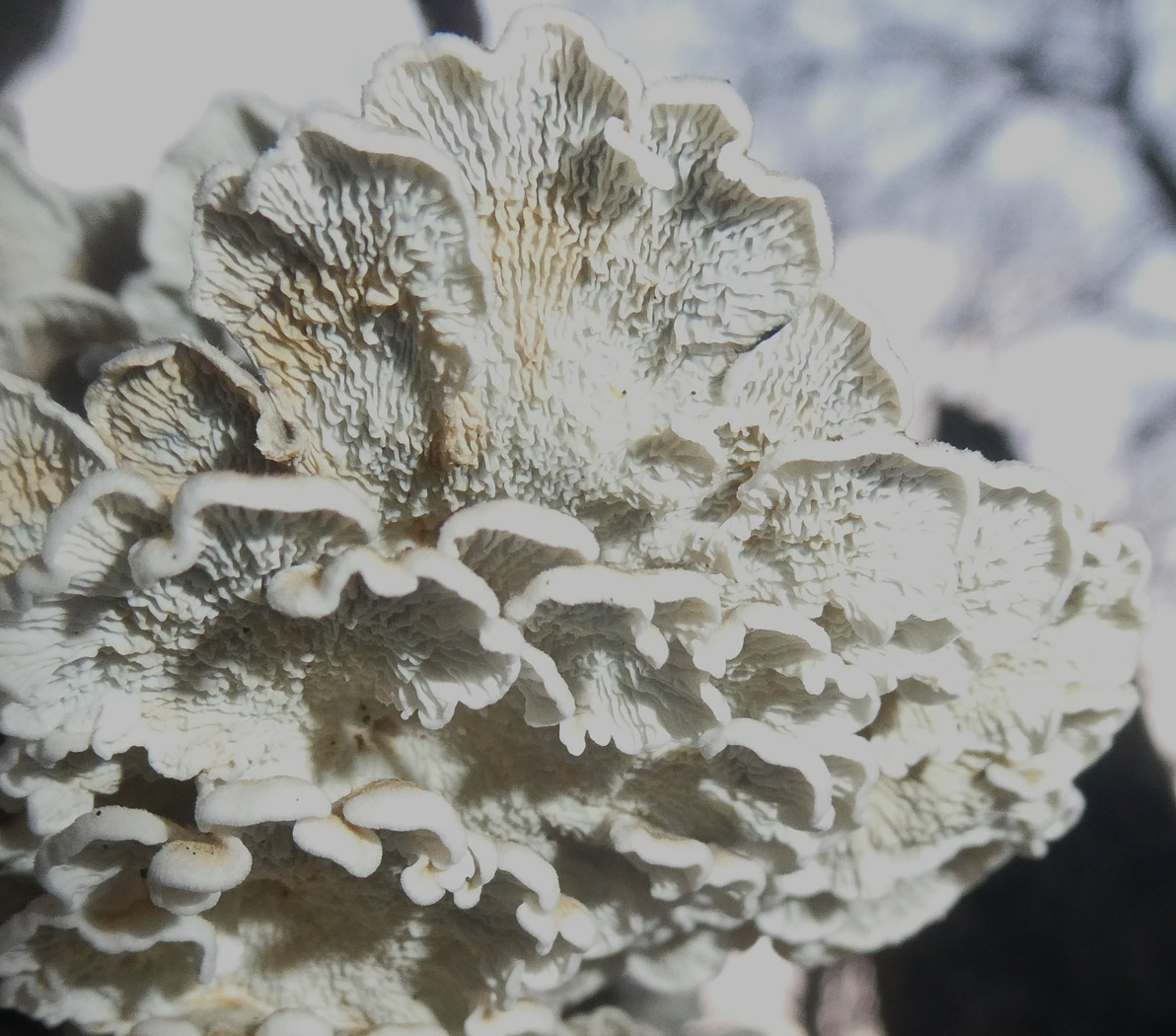
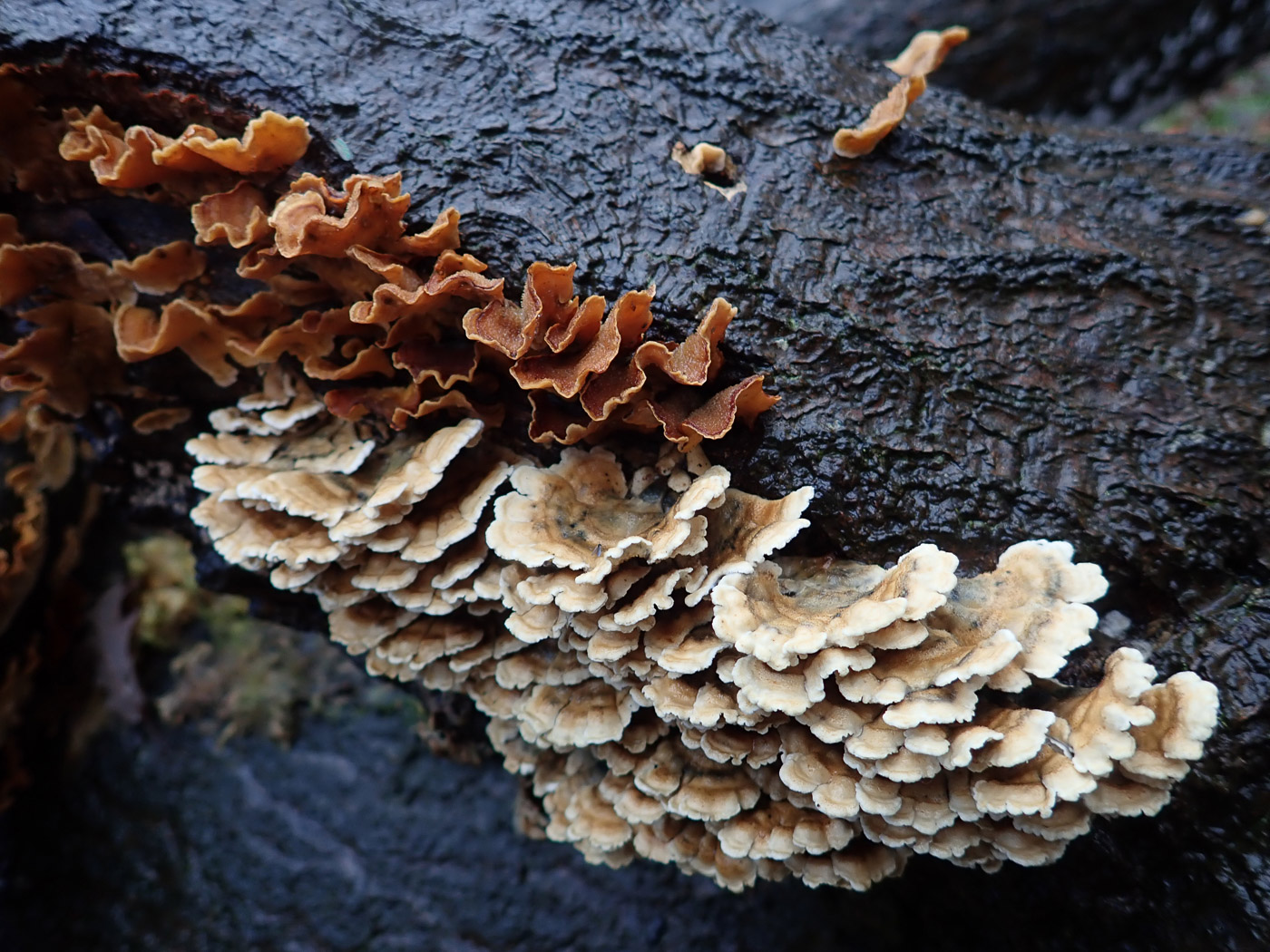 |
January 7th Plicaturopsis crispa (Crimped Gill)
More evidence here that this species is on the march and spreading fast. Found by Jim Wills in Chalfont St. Peter on Birch - which now appears to be its commonest host - he comments that the species seems to be 'colonising a good proportion of the fallen Birch trunks' in this area. It's an easy one to recognise and well illustrated here, the upper surface being similar to a small Stereum but the unusual gill-like under-surface (giving rise to its common name and seen in photo 3) is unlike anything else. See the Masterlist for several other entries. As an afterthought Penny has added photo 4 taken by her the following day at Burnham Beeches and showing the species fruiting alongside Stereum (either hirsutum or subtomentosum) on fallen Beech, giving the opportunity to compare the two species. The paler specimens are the Plicaturopsis.
|
January 6th 2023
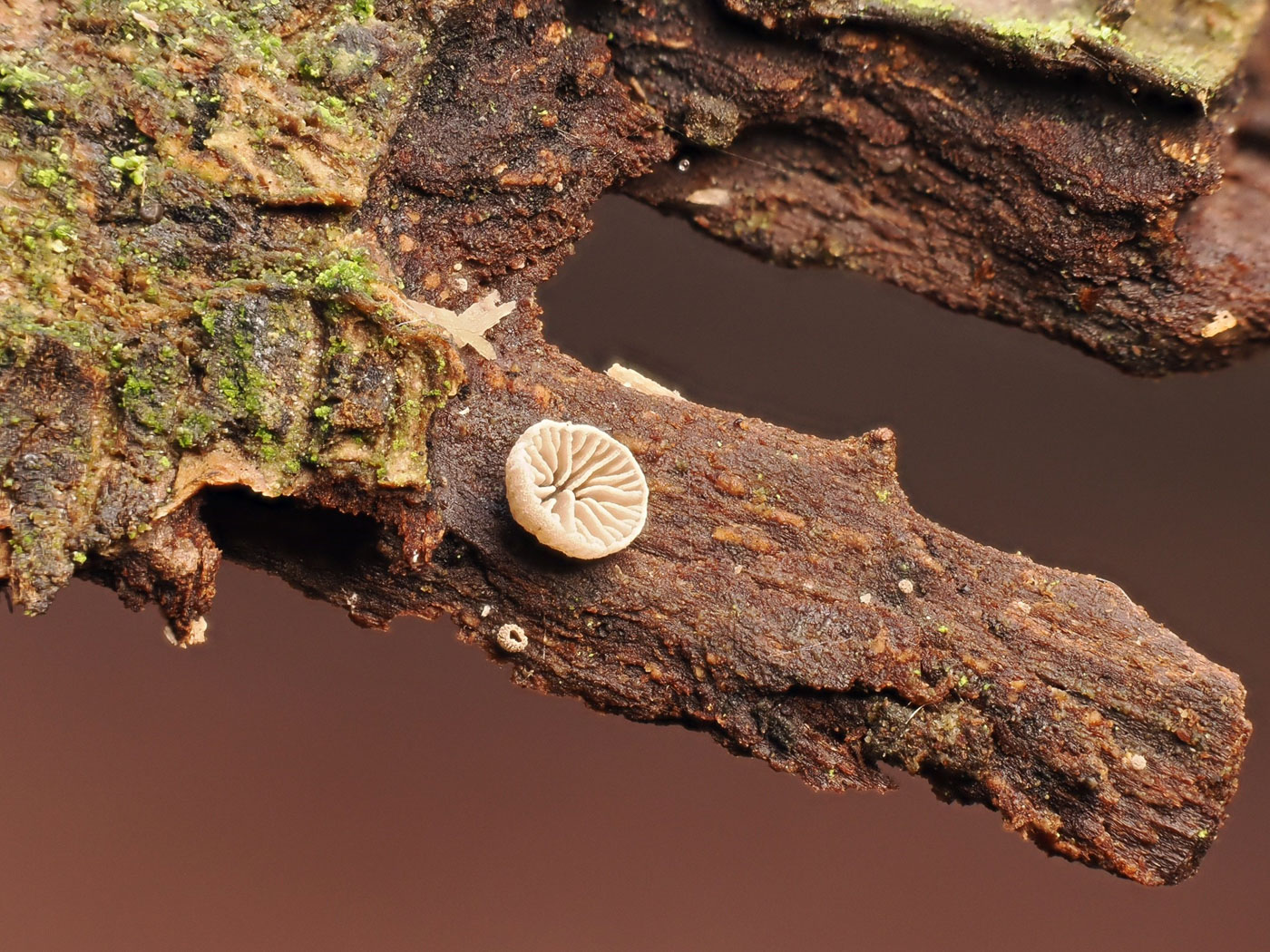
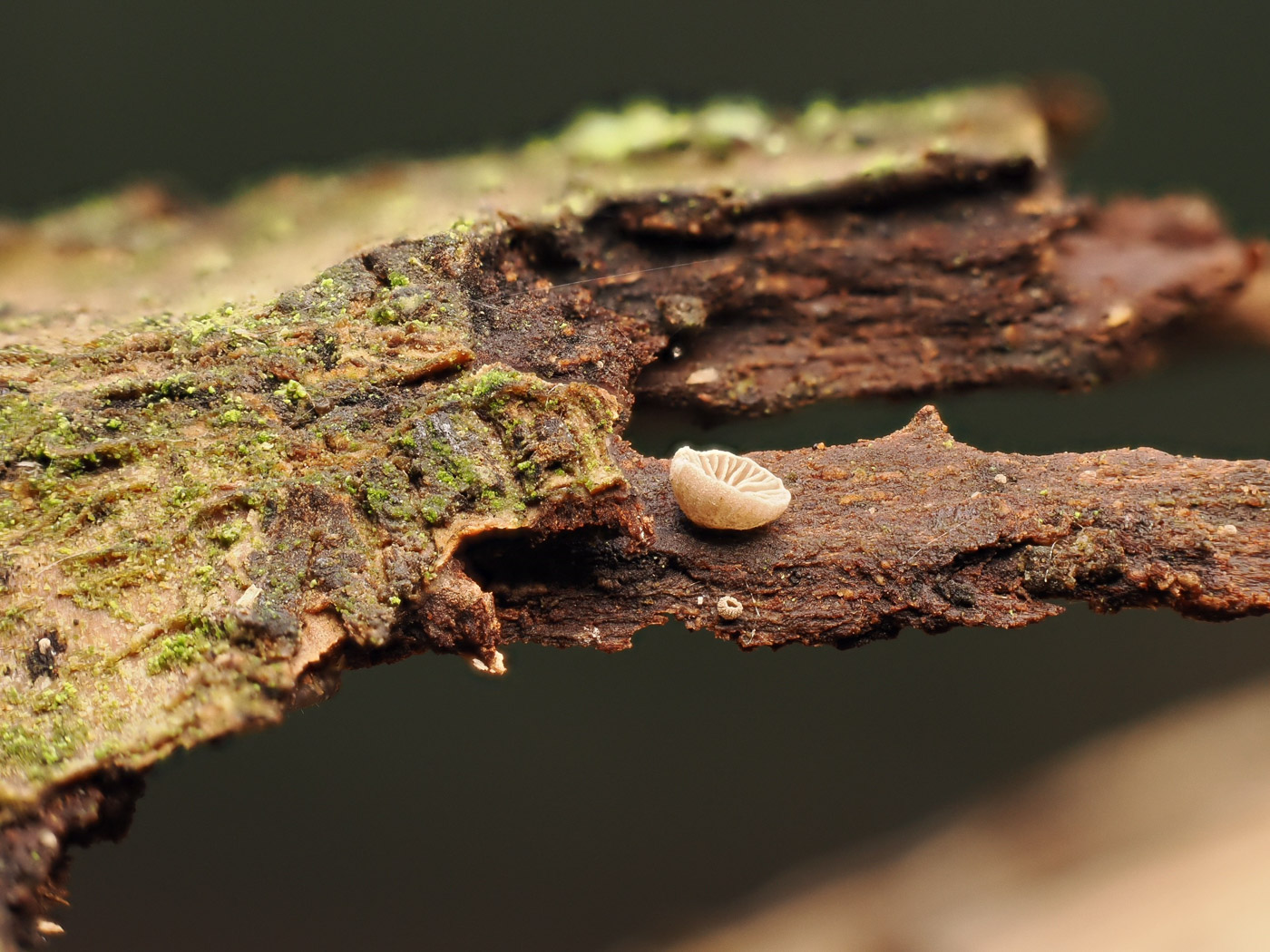 |
January 6th Resupinatus applicatus (Smoked Oysterling)
On rotting fallen deciduous wood at Burnham Beeches Claire Williams spotted this tiny 'pleurotoid' fungus though it was not a species she recognised. Obviously similar to genus Crepidotus, of which there a quite a few different species - all also named Oysterlings, this was a different shape with no sign of a stem and with gills radiating from a central rather than an eccentric point as in that genus. It was only about 5mm across with another even tinier example beginning to develop and visible just underneath it in both her photos. When mature the species tends to turn greyish - hence its common name, but when fresh as here it is typically this beige colour. See also on Finds 2022 November 7th.
|
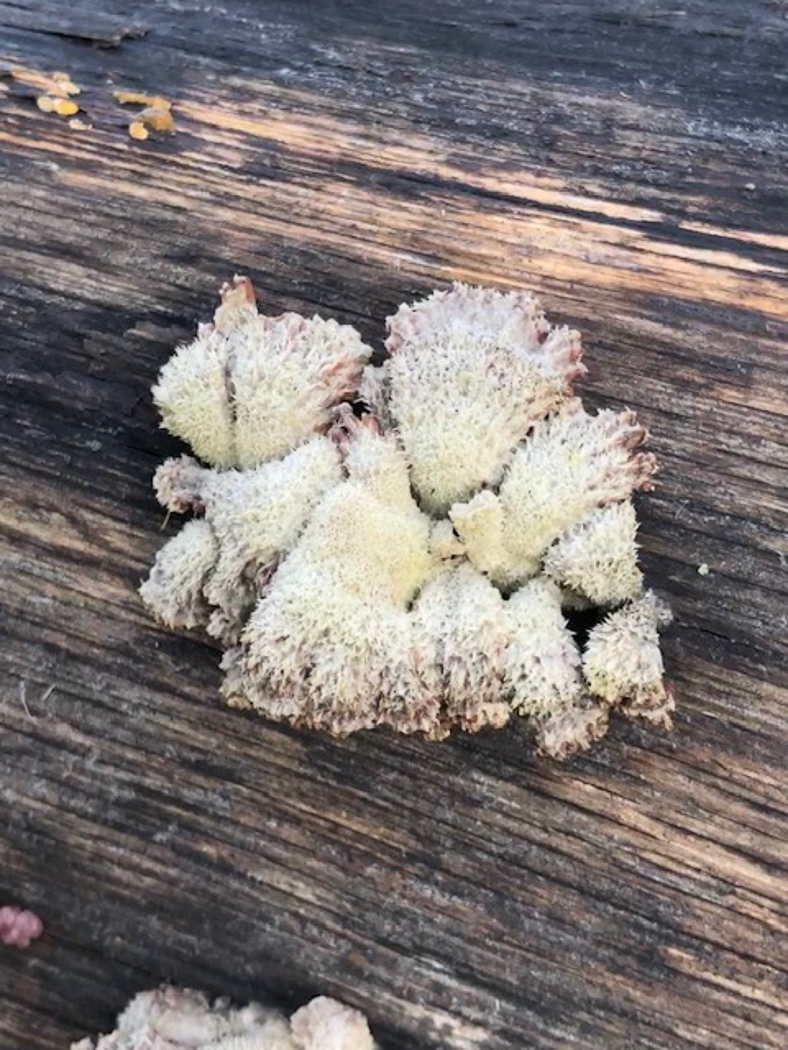
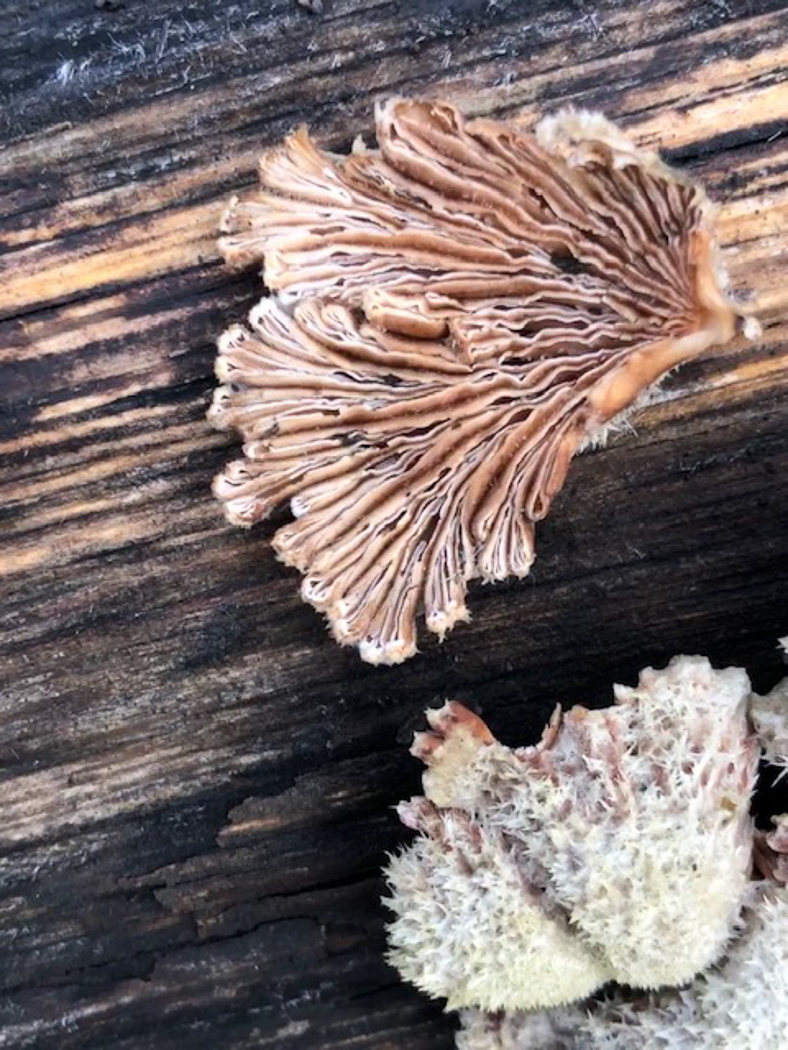 |
January 6th Schizophyllum commune (Splitgill)
On an unidentified log in Ivinghoe Paul Goby noticed this cluster and sent the photos off to Penny, correctly named. See other entries in Finds: 2020 October 29th and 2022 February 23rd, illustrating that the species can occur at any time and is quite common - an easy one to recognise once you turn it over: the fan shape is very distinctive.
|
January 2nd 2023
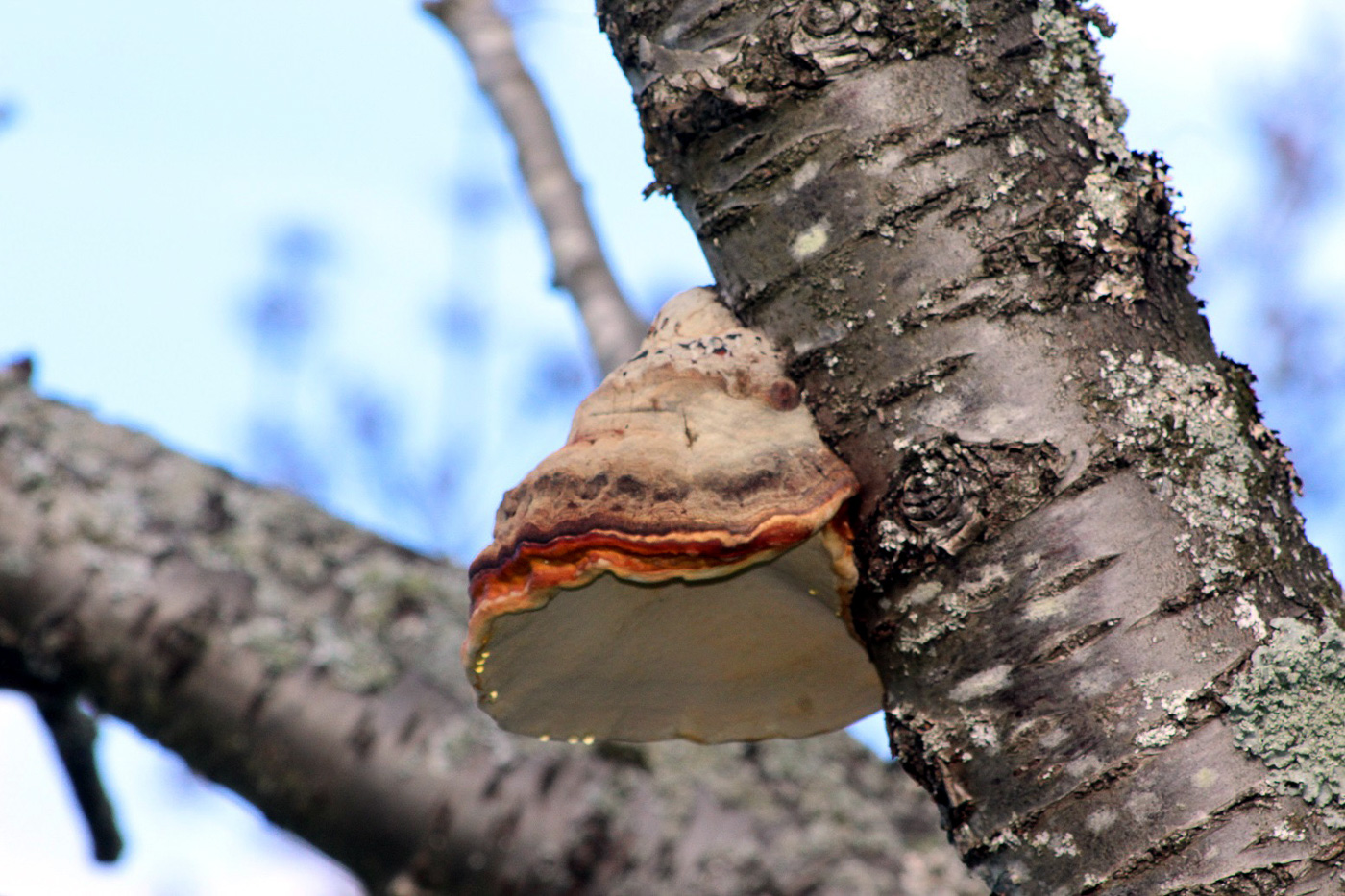 |
January 2nd Fomitopsis pinicola (Red-belted Bracket)
In Wycombe Rye Andrew and Lisa Dodd spotted this bracket on standing Cherry in the murky late afternoon light on Jan 1st, sent the photo to Penny who suspected it was this species, then returned today in much better light for this photo which definitely helps to confirms it! The species is following the trend of the quite similar Fomes fomentarius (Hoof Bracket) in now becoming much more common in the south of the country, but that species is restricted to Birch whereas this one seems to be able to flourish on a wide range of deciduous and coniferous woods though originally is was known as a Pine species. First found in the county in 2019, we've had several sightings in 2022, this being the first on Cherry, however. See the Masterlist for more examples.
|
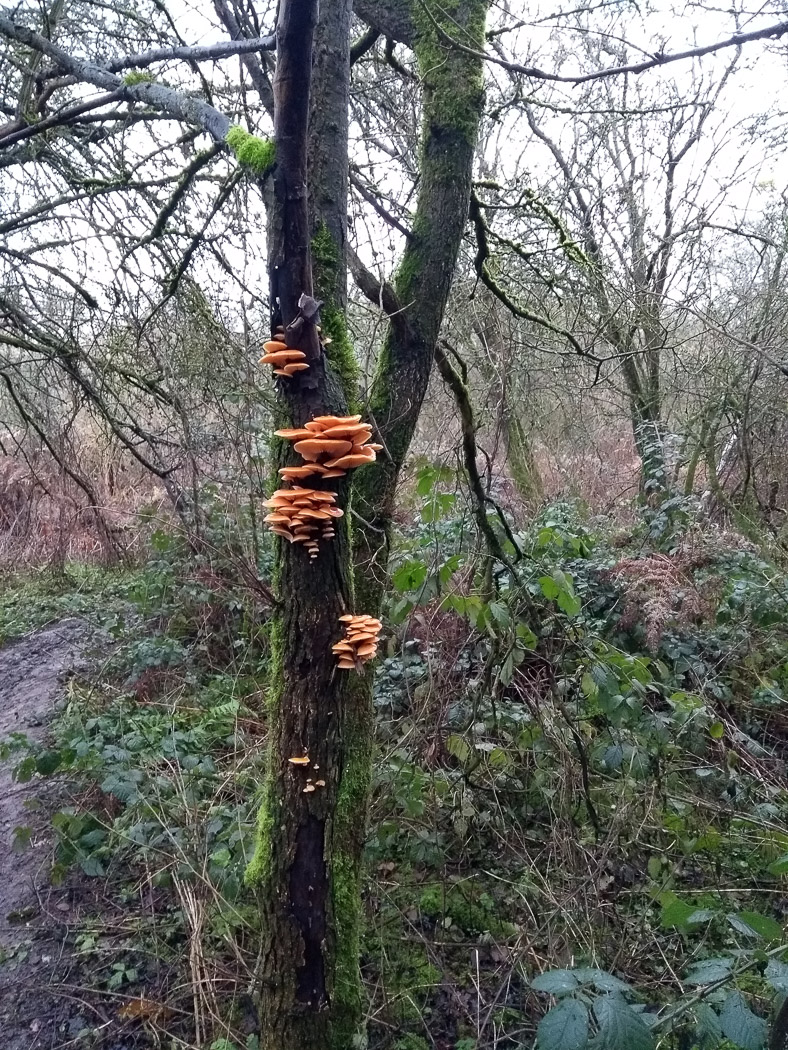
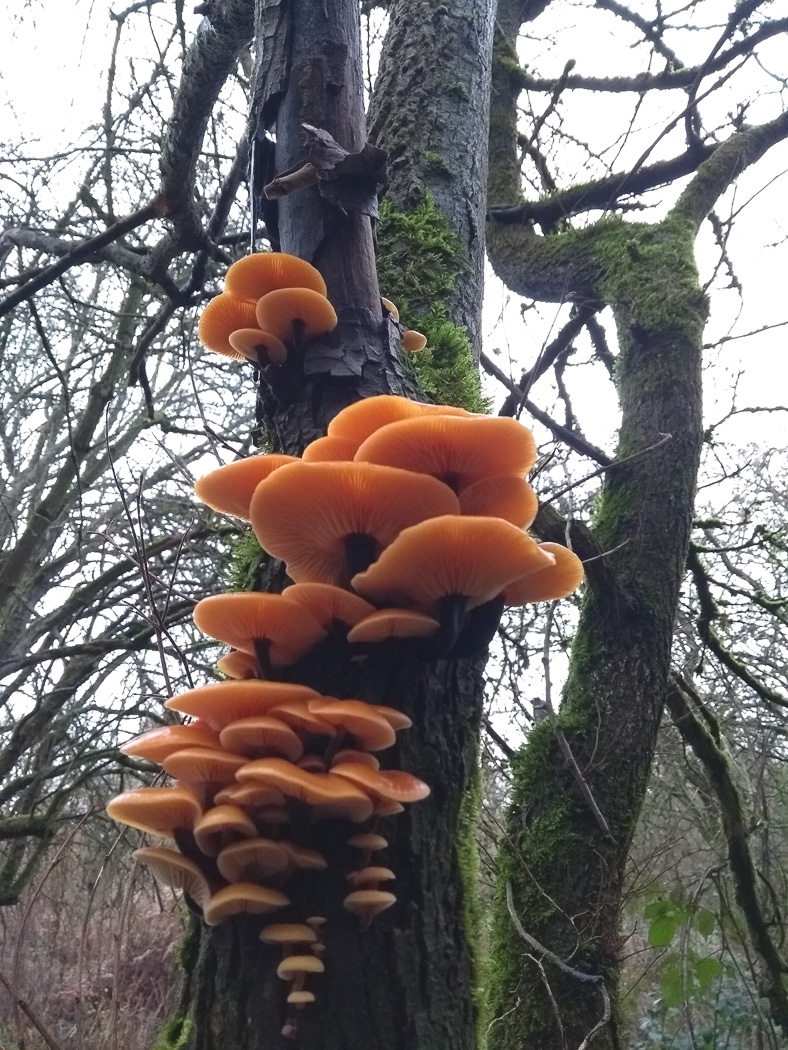 |
January 2nd Flammulina velutipes (Velvet Shank)
Penny is breaking the county rule here because her husband Paul found and photoed this impressive display just over the border into Berkshire! The species is common in winter, often found in frosty and snowy conditions fruiting on a wide variety of deciduous trees, so is definitely one to look out for as conditions are clearly favourable just now. Note the dark finely velvety stem which is a good field character.
|
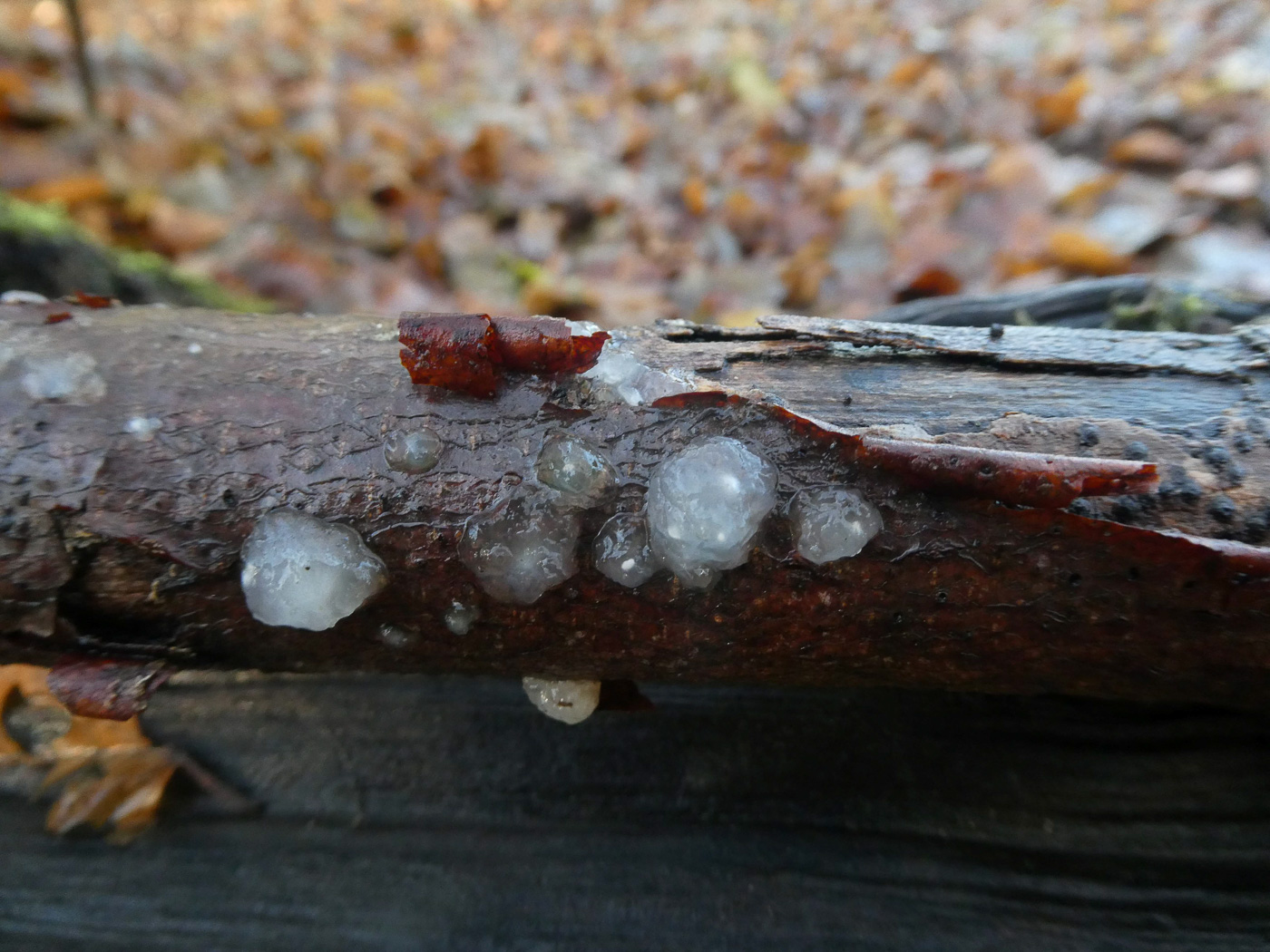
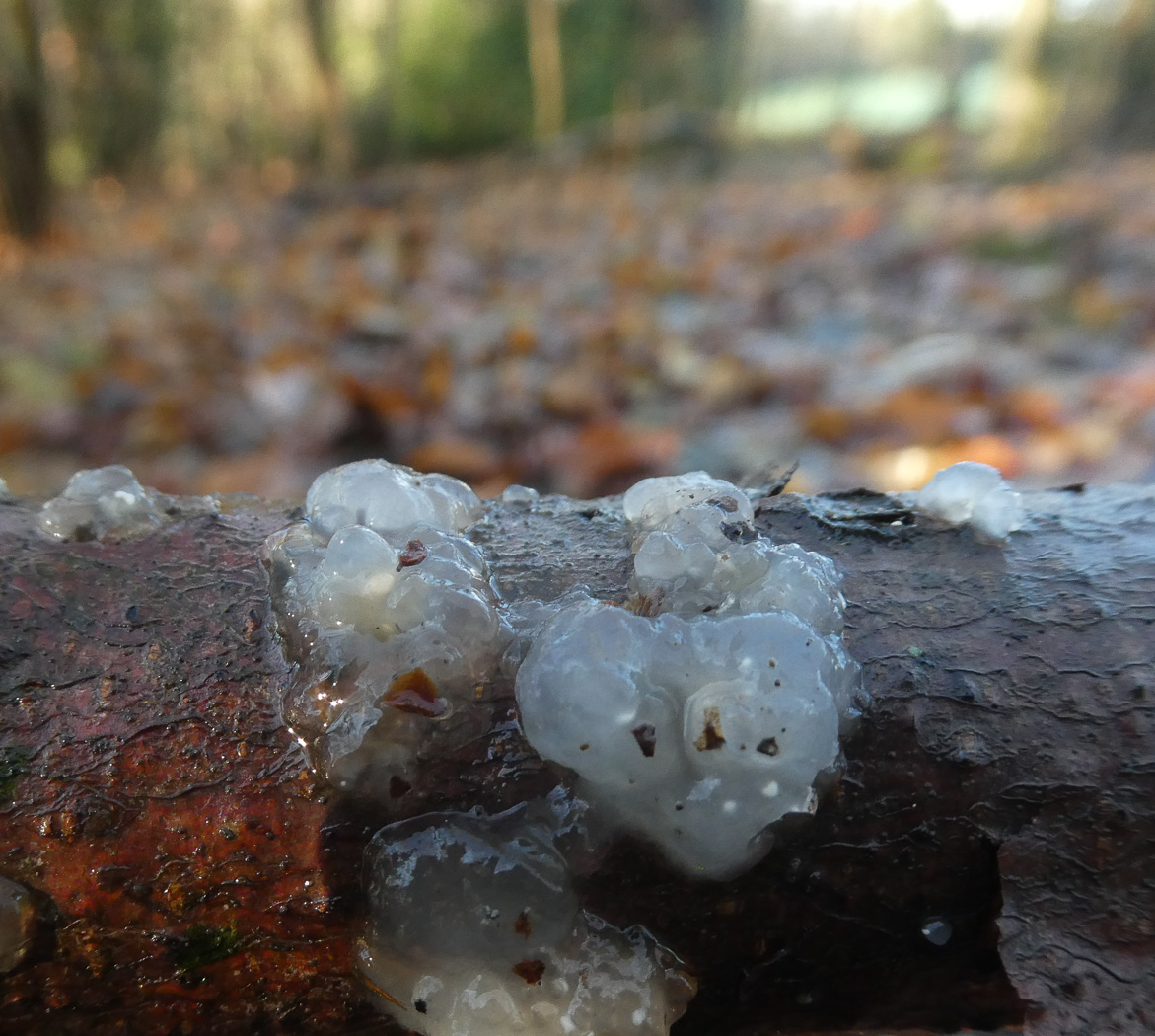 |
January 2nd Myxarium nucleatum (Crystal Brain)
On fallen wood near Chalfont St Peter Jim Wills came across a good cluster of this species of Jelly Fungus, more familiar under its previous genus name of Exidia. Note the central tiny white 'cores' nicely visible in both photos - this a useful field character to help separate the species from other possible jelly-like contenders.
|
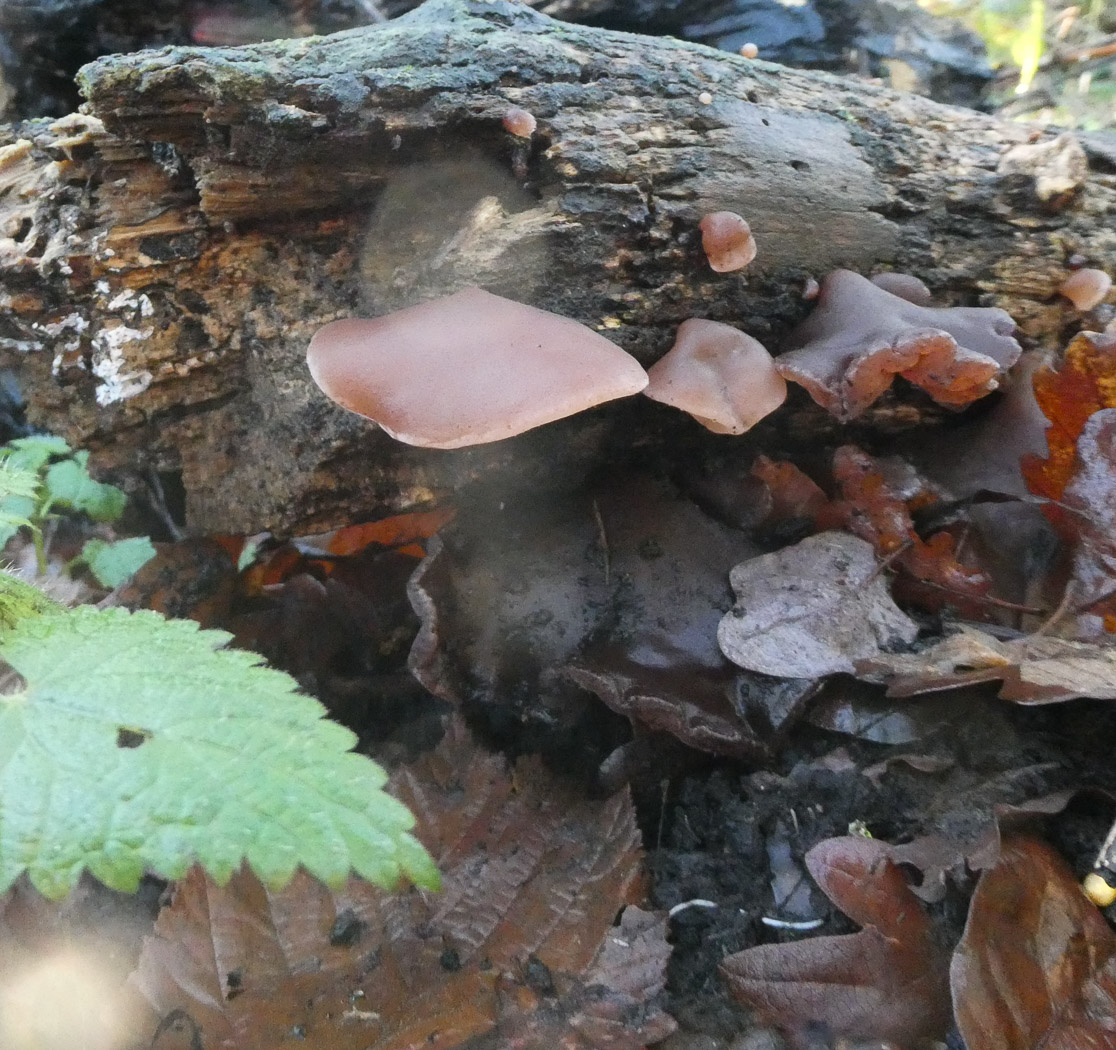
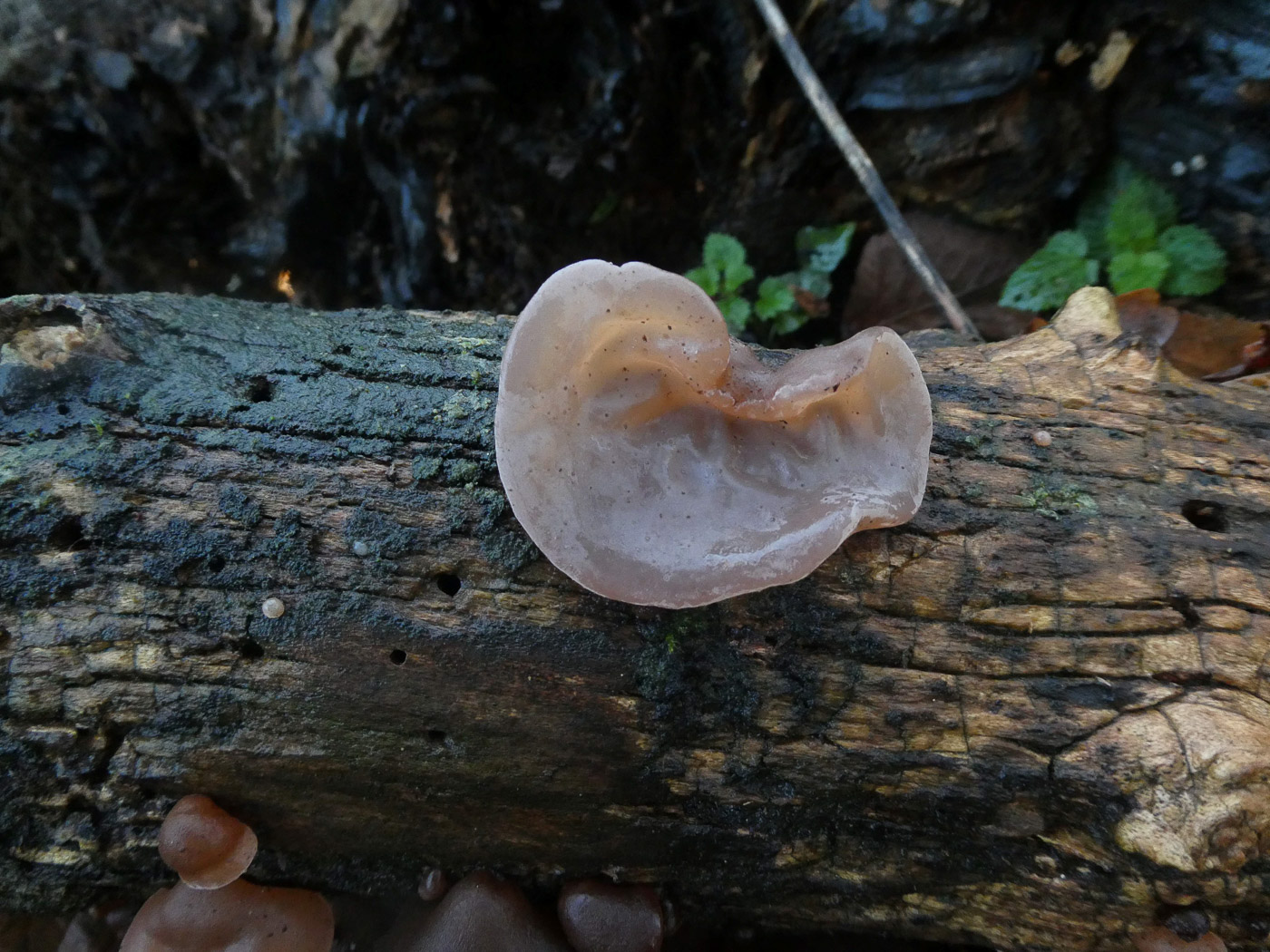 |
January 2nd Auricularia auricula-judae (Jelly Ear)
In woods near Chalfont St Peter Jim Wills noticed this fresh collection of 'ears' on a fallen trunk - probably Elder but the species does occur on other deciduous woods. Clearly the recent mild damp spell in encouraging a new round of fungal fruiting, particularly of the 'Jelly' Fungi.
|
Jan 1st 2023
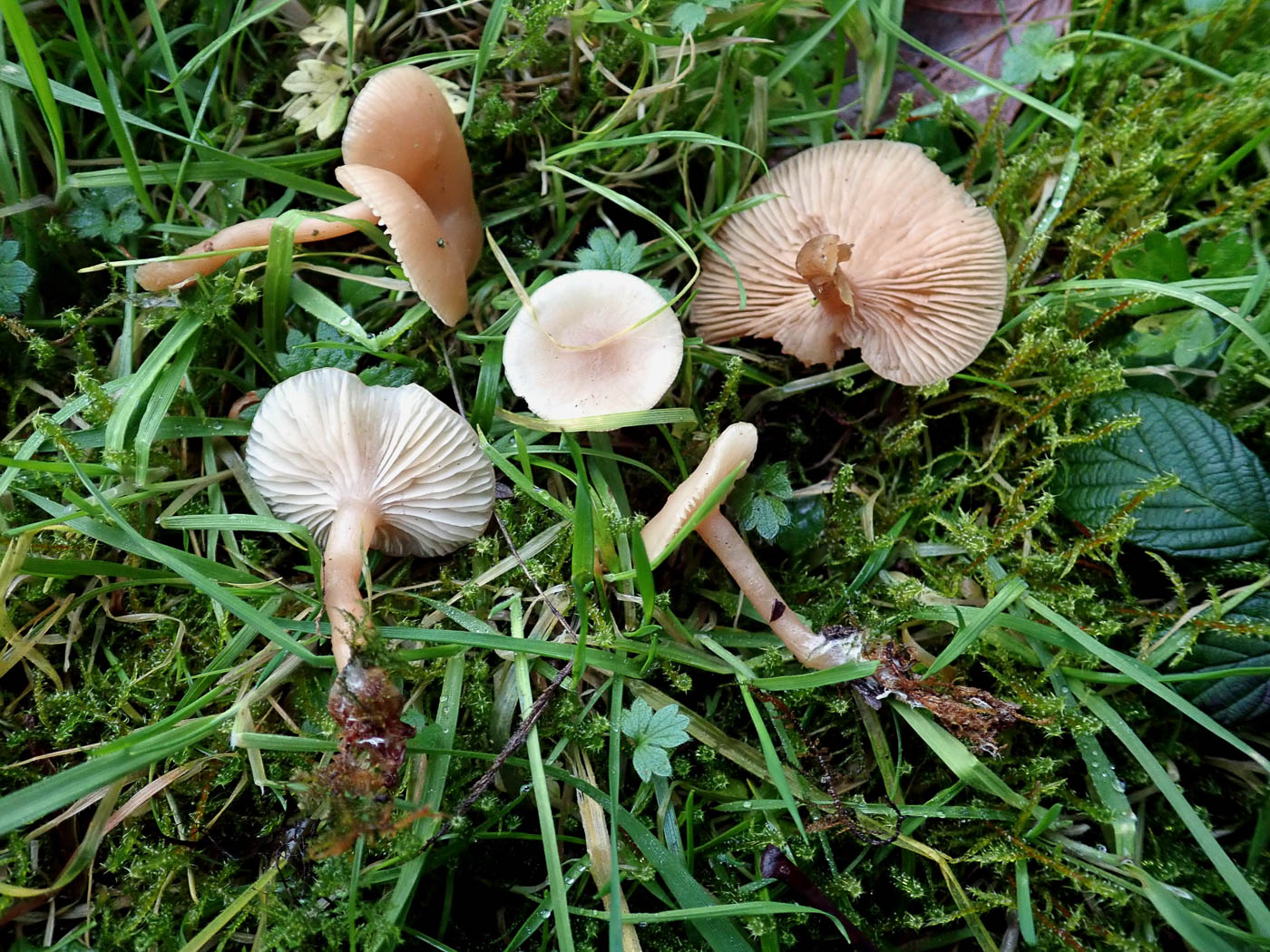 |
January 1st Clitocybe fragrans (Fragrant Funnel)
In Prestwood Churchyard Penny was hopeful of finding something exciting to start the new year off, but not so! This collection was the only fungi she could find, but at least the delicious sweet aniseed smell was present to confirm the ID. Otherwise this is a fairly drab nondescript little species, very similar to other pale funnels and often very common though apparently in short supply in recent months. Its smell is its one redeeming feature. See the Masterlist for more examples.
|
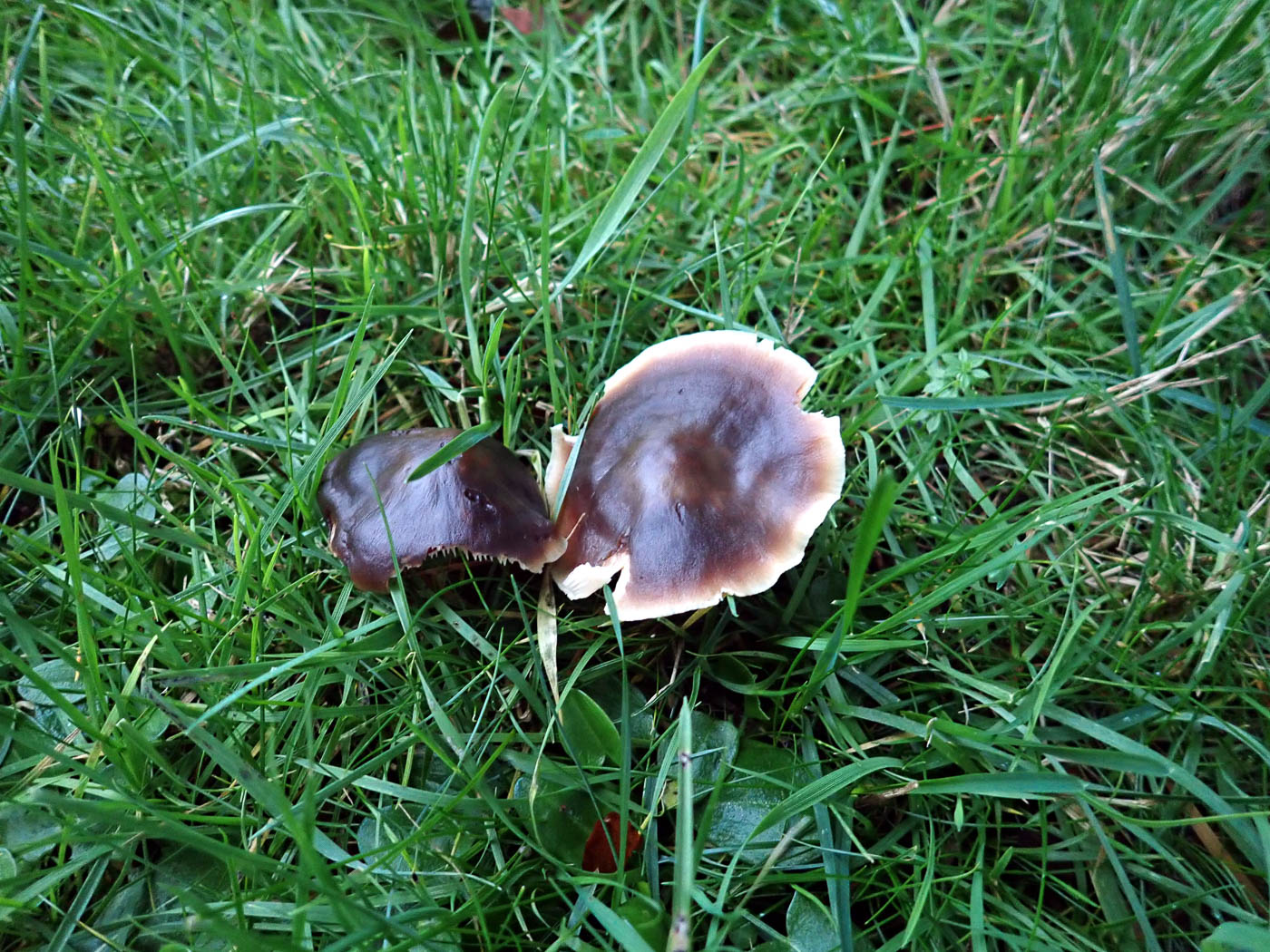
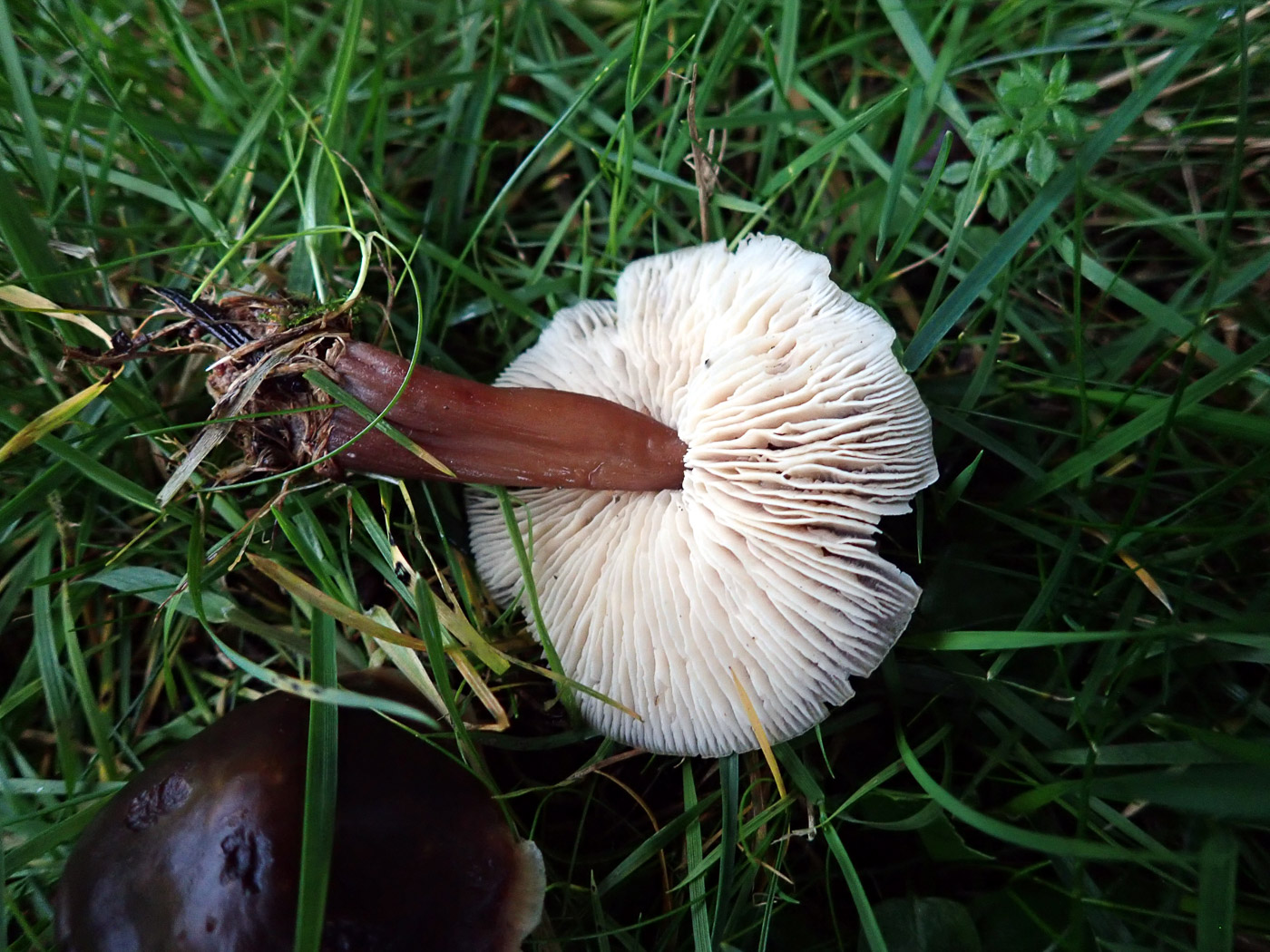 |
January 1st Rhodocollybia butyracea (Butter Cap)
In Bradenham Churchyard there was surprisingly little fungi about: only a few Fragrant Funnels (as seen also above) and this pair of very dark capped Butter Caps. Turning the larger cap over revealed the expected hollow rather swollen stem with purple tendencies which contrasted with the very pale gills - enough to confirm the ID. See the Masterlist for more examples - the cap colour is very variable in this species.
|
![]() have been examined microscopically (either by the collector or by Penny later). No guarantee can therefore be given on identifications which lack the symbol
have been examined microscopically (either by the collector or by Penny later). No guarantee can therefore be given on identifications which lack the symbol ![]() though all photos are checked and selected by Penny to the best of her ability. Basic accompanying notes are also Penny's.
though all photos are checked and selected by Penny to the best of her ability. Basic accompanying notes are also Penny's. 
